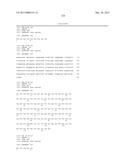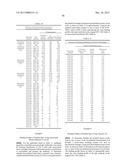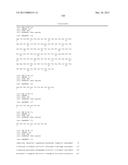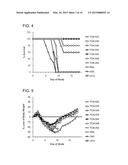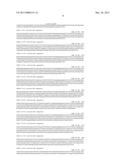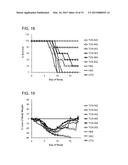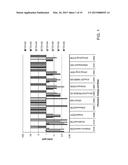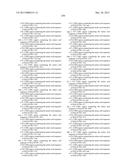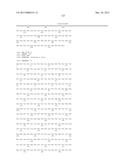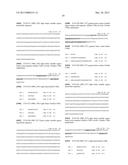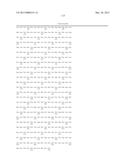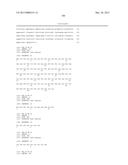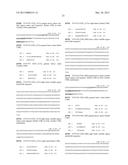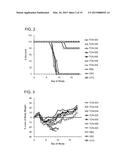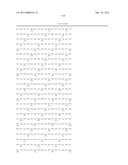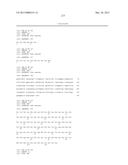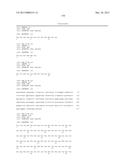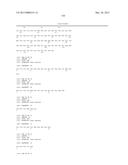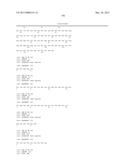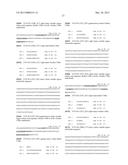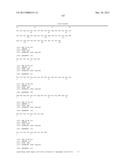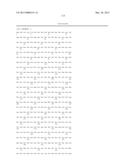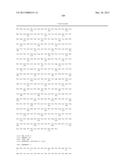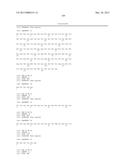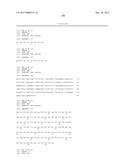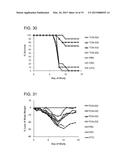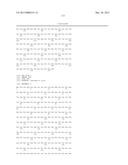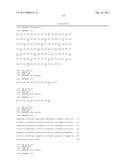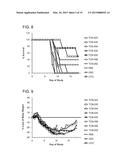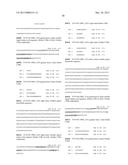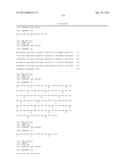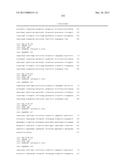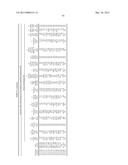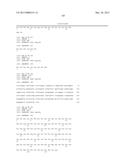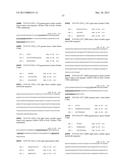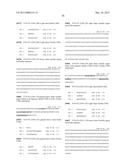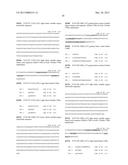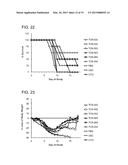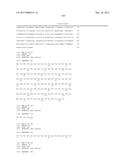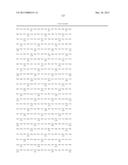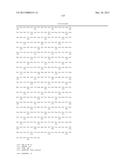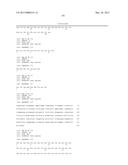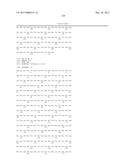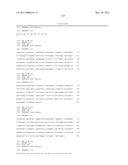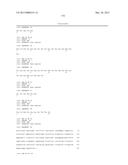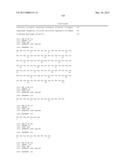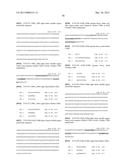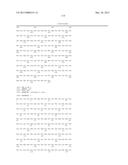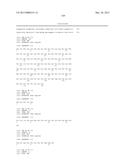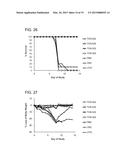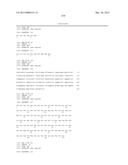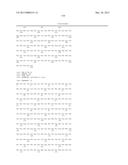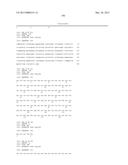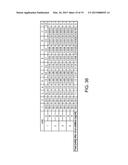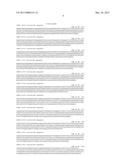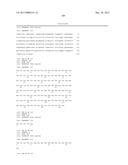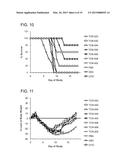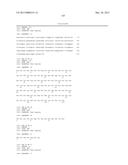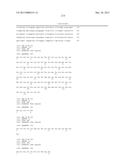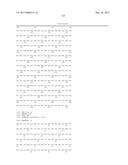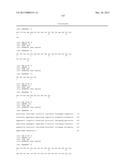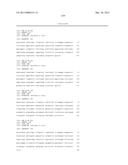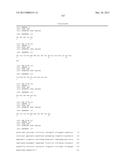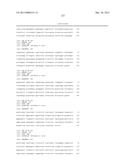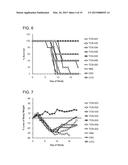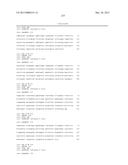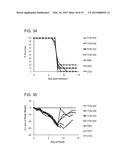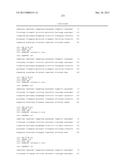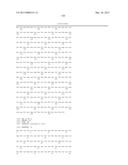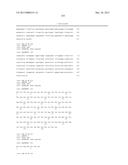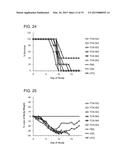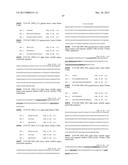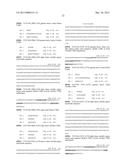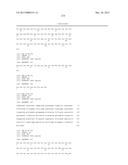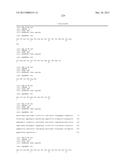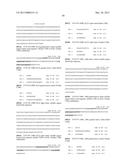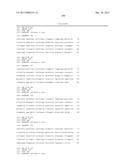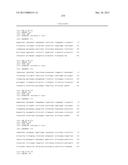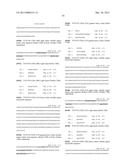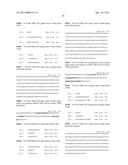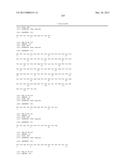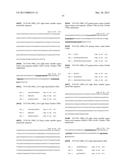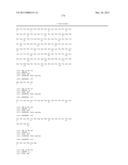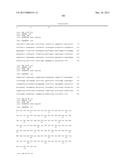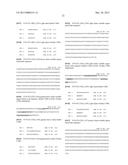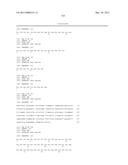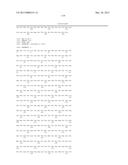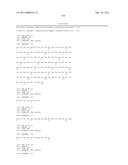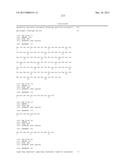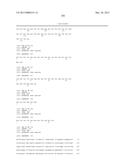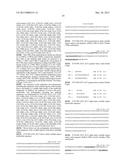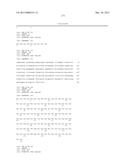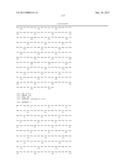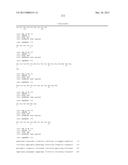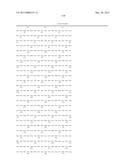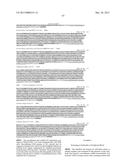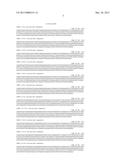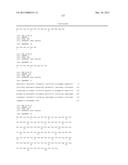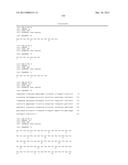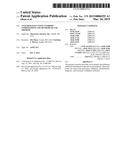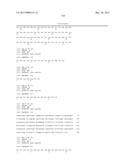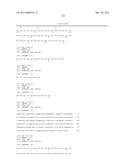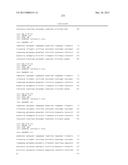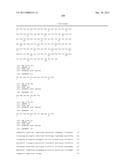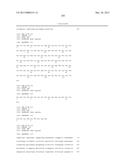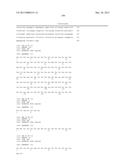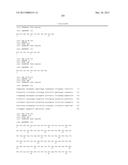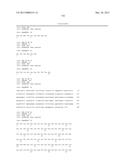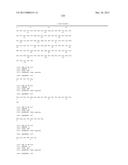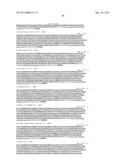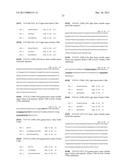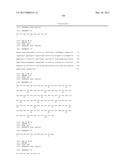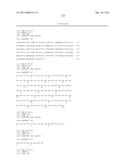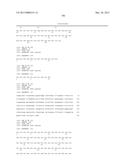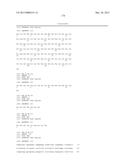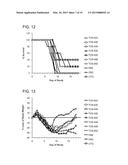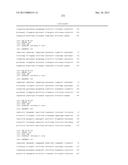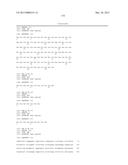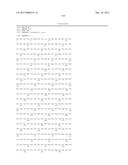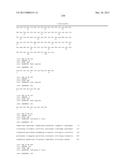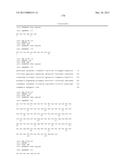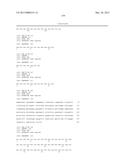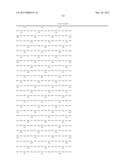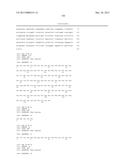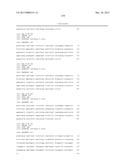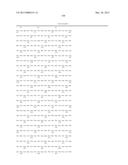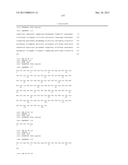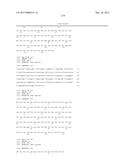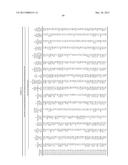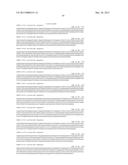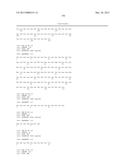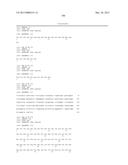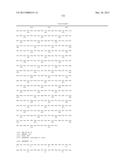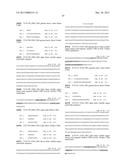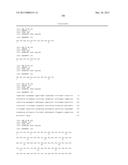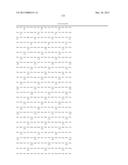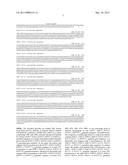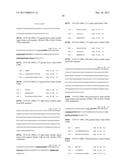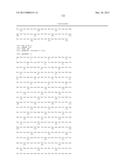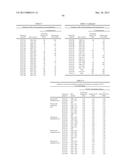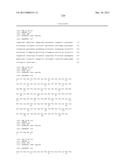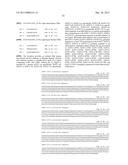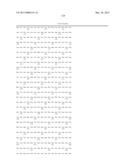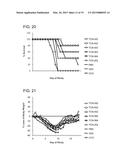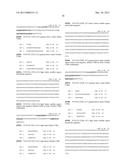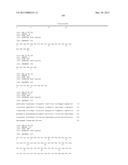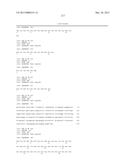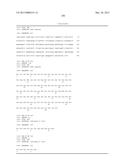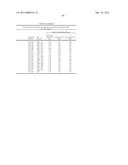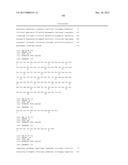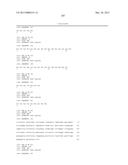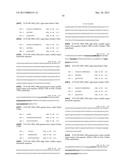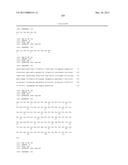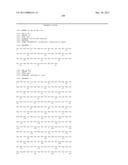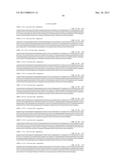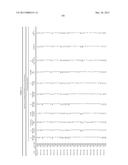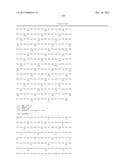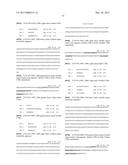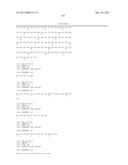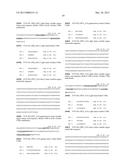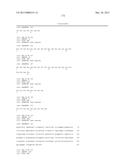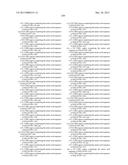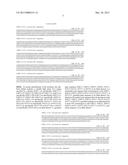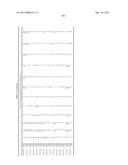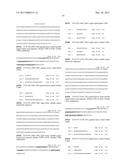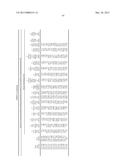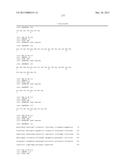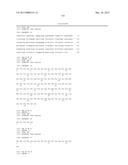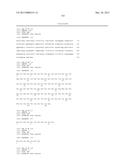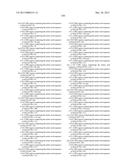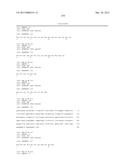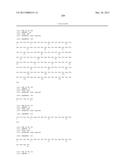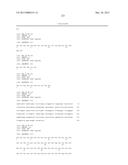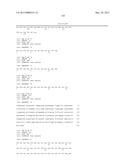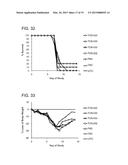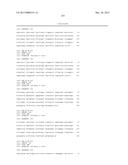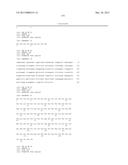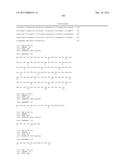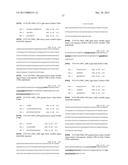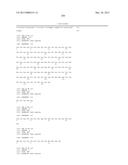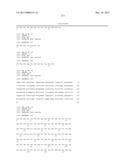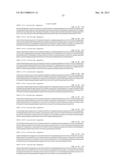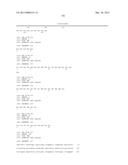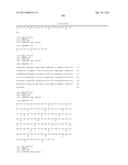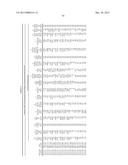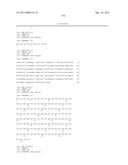Patent application title: Anti-Hemagglutinin Antibody Compositions and Methods of Use Thereof
Inventors:
Ole Olsen (Everett, WA, US)
Ole Olsen (Everett, WA, US)
Christina L. Boozer (Seattle, WA, US)
IPC8 Class: AC07K1610FI
USPC Class:
4241371
Class name: Drug, bio-affecting and body treating compositions immunoglobulin, antiserum, antibody, or antibody fragment, except conjugate or complex of the same with nonimmunoglobulin material binds specifically-identified oligosaccharide structure
Publication date: 2015-03-26
Patent application number: 20150086555
Abstract:
The present invention provides novel human anti-Influenza antibodies and
related compositions and methods. These antibodies are used in the
prevention, inhibition, neutralization, diagnosis, and treatment of
influenza infection.Claims:
1. An isolated fully human monoclonal antibody, wherein said monoclonal
antibody has the following characteristics: a) binds to an influenza A
virus; b) binds to a cell contacted with influenza A; c) binds to an
epitope of an influenza A viral protein; and d) neutralizes influenza A
virus infection.
2. The antibody of claim 1, wherein said influenza A viral protein is hemagglutinin (HA).
3. The antibody of claim 2, wherein said hemagglutinin (HA) comprises a hemagglutinin precursor peptide (HA0), a HA1 subunit, a HA2 subunit, a mature protein containing HA1 and HA2, or a recombinant HA polypeptide.
4. The antibody of claim 3, wherein recombinant HA polypeptide is encoded by the sequence of SEQ ID NO: 2, 3, 4, 5, 6, 7, 8, 9, 10, 11, 12, 13, 14, 15, 16, 17, 18, or 19.
5. The antibody of claim 1, wherein said antibody is isolated from a B-cell that is isolated from a human donor.
6. The antibody of claim 1, wherein said epitope is linear or non-linear.
7. The antibody of claim 6, wherein said non-linear epitope is a discontinuous epitope.
8. The antibody of claim 1, wherein said antibody is (a) TCN-522 (3212_I12), TCN-521 (3280_D18), TCN-523 (5248_A17), TCN-563 (5237_B21), TCN-526 (5084_C17), TCN-527 (5086_C06), TCN-528 (5087_P17), TCN-529 (5297_H01), TCN-530 (5248_H10), TCN-531 (5091_H13), TCN-532 (5262_H18), TCN-533 (5256_A17a), TCN-534 (5249_B02), TCN-535 (5246_P19), TCN-536 (5095_N01), TCN-537 (3194_D21), TCN-538 (3206_O17), TCN-539 (5056_A08), TCN-540 (5060_F05), TCN-541 (5062_M11), TCN-542 (5079_A16), TCN-543 (5081_G23), TCN-544 (5082_A19), TCN-545 (5082_I15), TCN-546 (5089_L08), TCN-547 (5092_F11), TCN-548 (5092_P01), TCN-549 (5092_P04), TCN-550 (5096_F06), TCN-551 (5243_D01), TCN-552 (5249_I23), TCN-553 (5261_C18), TCN-554 (5277_M05), TCN-555 (5246_L16), TCN-556 (5089_K12), TCN-557 (5081_A04), TCN-558 (5248_H10b), TCN-559 (5097_G08), TCN-560 (5084_P10), TCN-564 (5256_A17b), or TCN-504 (3251_K17), or (b) an antibody that binds the same epitope as TCN-522 (3212_I12), TCN-521 (3280_D18), TCN-523 (5248_A17), TCN-563 (5237_B21), TCN-526 (5084_C17), TCN-527 (5086_C06), TCN-528 (5087_P17), TCN-529 (5297_H01), TCN-530 (5248_H10), TCN-531 (5091_H13), TCN-532 (5262_H18), TCN-533 (5256_A17a), TCN-534 (5249_B02), TCN-535 (5246_P19), TCN-536 (5095_N01), TCN-537 (3194_D21), TCN-538 (3206_O17), TCN-539 (5056_A08), TCN-540 (5060_F05), TCN-541 (5062_M11), TCN-542 (5079_A16), TCN-543 (5081_G23), TCN-544 (5082_A19), TCN-545 (5082_I15), TCN-546 (5089_L08), TCN-547 (5092_F11), TCN-548 (5092_P01), TCN-549 (5092_P04), TCN-550 (5096_F06), TCN-551 (5243 D01), TCN-552 (5249_I23), TCN-553 (5261_C18), TCN-554 (5277_M05), TCN-555 (5246_L16), TCN-556 (5089_K12), TCN-557 (5081_A04), (5248_H10b), TCN-559 (5097_G08), TCN-560 (5084_P10), TCN-564 (5256_A17b), or TCN-504 (3251_K17).
9. An isolated anti-hemagglutinin (HA) antibody, wherein said antibody comprises a combination of variable heavy chain complementarity determining region 1 (VH CDR1), variable heavy chain complementarity determining region 2 (VH CDR2), variable heavy chain complementarity determining region 3 (VH CDR3), variable light chain complementarity determining region 1 (VL CDR1), variable light chain complementarity determining region 2 (VL CDR2), and variable light chain complementarity determining region 3 (VL CDR3), selected from the group consisting of: (a) a VH CDR1 region comprising the amino acid sequence of SEQ ID NO: 511; a VH CDR2 region comprising the amino acid sequence of SEQ ID NO: 512, a VH CDR3 region comprising the amino acid sequence of SEQ ID NO: 513, a VL CDR1 region comprising the amino acid sequence of SEQ ID NO: 517; a VL CDR2 region comprising the amino acid sequence of SEQ ID NO: 181, and a VL CDR3 region comprising the amino acid sequence of SEQ ID NO: 518; (b) a VH CDR1 region comprising the amino acid sequence of SEQ ID NO: 22; a VH CDR2 region comprising the amino acid sequence of SEQ ID NO: 23, a VH CDR3 region comprising the amino acid sequence of SEQ ID NO: 24, a VL CDR1 region comprising the amino acid sequence of SEQ ID NO: 29; a VL CDR2 region comprising the amino acid sequence of SEQ ID NO: 30, and a VL CDR3 region comprising the amino acid sequence of SEQ ID NO: 31; (c) a VH CDR1 region comprising the amino acid sequence of SEQ ID NO: 34; a VH CDR2 region comprising the amino acid sequence of SEQ ID NO: 35, a VH CDR3 region comprising the amino acid sequence of SEQ ID NO: 36, a VL CDR1 region comprising the amino acid sequence of SEQ ID NO: 41; a VL CDR2 region comprising the amino acid sequence of SEQ ID NO: 42, and a VL CDR3 region comprising the amino acid sequence of SEQ ID NO: 43; (d) a VH CDR1 region comprising the amino acid sequence of SEQ ID NO: 46; a VH CDR2 region comprising the amino acid sequence of SEQ ID NO: 47, a VH CDR3 region comprising the amino acid sequence of SEQ ID NO: 48, a VL CDR1 region comprising the amino acid sequence of SEQ ID NO: 53; a VL CDR2 region comprising the amino acid sequence of SEQ ID NO: 54, and a VL CDR3 region comprising the amino acid sequence of SEQ ID NO: 55; (e) a VH CDR1 region comprising the amino acid sequence of SEQ ID NO: 62; a VH CDR2 region comprising the amino acid sequence of SEQ ID NO: 58, a VH CDR3 region comprising the amino acid sequence of SEQ ID NO: 59, a VL CDR1 region comprising the amino acid sequence of SEQ ID NO: 65; a VL CDR2 region comprising the amino acid sequence of SEQ ID NO: 66, and a VL CDR3 region comprising the amino acid sequence of SEQ ID NO: 67; (f) a VH CDR1 region comprising the amino acid sequence of SEQ ID NO: 70; a VH CDR2 region comprising the amino acid sequence of SEQ ID NO: 71, a VH CDR3 region comprising the amino acid sequence of SEQ ID NO: 72, a VL CDR1 region comprising the amino acid sequence of SEQ ID NO: 77; a VL CDR2 region comprising the amino acid sequence of SEQ ID NO: 78, and a VL CDR3 region comprising the amino acid sequence of SEQ ID NO: 79; (g) a VH CDR1 region comprising the amino acid sequence of SEQ ID NO: 82; a VH CDR2 region comprising the amino acid sequence of SEQ ID NO: 83, a VH CDR3 region comprising the amino acid sequence of SEQ ID NO: 84, a VL CDR1 region comprising the amino acid sequence of SEQ ID NO: 89; a VL CDR2 region comprising the amino acid sequence of SEQ ID NO: 90, and a VL CDR3 region comprising the amino acid sequence of SEQ ID NO: 91; (h) a VH CDR1 region comprising the amino acid sequence of SEQ ID NO: 94; a VH CDR2 region comprising the amino acid sequence of SEQ ID NO: 95, a VH CDR3 region comprising the amino acid sequence of SEQ ID NO: 96, a VL CDR1 region comprising the amino acid sequence of SEQ ID NO: 101; a VL CDR2 region comprising the amino acid sequence of SEQ ID NO: 102, and a VL CDR3 region comprising the amino acid sequence of SEQ ID NO: 103; (i) a VH CDR1 region comprising the amino acid sequence of SEQ ID NO: 106; a VH CDR2 region comprising the amino acid sequence of SEQ ID NO: 107, a VH CDR3 region comprising the amino acid sequence of SEQ ID NO: 108, a VL CDR1 region comprising the amino acid sequence of SEQ ID NO: 113; a VL CDR2 region comprising the amino acid sequence of SEQ ID NO: 114, and a VL CDR3 region comprising the amino acid sequence of SEQ ID NO: 115; (j) a VH CDR1 region comprising the amino acid sequence of SEQ ID NO: 118; a VH CDR2 region comprising the amino acid sequence of SEQ ID NO: 119, a VH CDR3 region comprising the amino acid sequence of SEQ ID NO: 120, a VL CDR1 region comprising the amino acid sequence of SEQ ID NO: 125; a VL CDR2 region comprising the amino acid sequence of SEQ ID NO: 126, and a VL CDR3 region comprising the amino acid sequence of SEQ ID NO: 127; (k) a VH CDR1 region comprising the amino acid sequence of SEQ ID NO: 130; a VH CDR2 region comprising the amino acid sequence of SEQ ID NO: 131, a VH CDR3 region comprising the amino acid sequence of SEQ ID NO: 132, a VL CDR1 region comprising the amino acid sequence of SEQ ID NO: 137; a VL CDR2 region comprising the amino acid sequence of SEQ ID NO: 138, and a VL CDR3 region comprising the amino acid sequence of SEQ ID NO: 139; (l) a VH CDR1 region comprising the amino acid sequence of SEQ ID NO: 142; a VH CDR2 region comprising the amino acid sequence of SEQ ID NO: 143, a VH CDR3 region comprising the amino acid sequence of SEQ ID NO: 144, a VL CDR1 region comprising the amino acid sequence of SEQ ID NO: 149; a VL CDR2 region comprising the amino acid sequence of SEQ ID NO: 150, and a VL CDR3 region comprising the amino acid sequence of SEQ ID NO: 151; (m) a VH CDR1 region comprising the amino acid sequence of SEQ ID NO: 154; a VH CDR2 region comprising the amino acid sequence of SEQ ID NO: 155, a VH CDR3 region comprising the amino acid sequence of SEQ ID NO: 156, a VL CDR1 region comprising the amino acid sequence of SEQ ID NO: 53; a VL CDR2 region comprising the amino acid sequence of SEQ ID NO: 54, and a VL CDR3 region comprising the amino acid sequence of SEQ ID NO: 55; (n) a VH CDR1 region comprising the amino acid sequence of SEQ ID NO: 162; a VH CDR2 region comprising the amino acid sequence of SEQ ID NO: 163, a VH CDR3 region comprising the amino acid sequence of SEQ ID NO: 164, a VL CDR1 region comprising the amino acid sequence of SEQ ID NO: 169; a VL CDR2 region comprising the amino acid sequence of SEQ ID NO: 170, and a VL CDR3 region comprising the amino acid sequence of SEQ ID NO: 171; (o) a VH CDR1 region comprising the amino acid sequence of SEQ ID NO: 174; a VH CDR2 region comprising the amino acid sequence of SEQ ID NO: 175, a VH CDR3 region comprising the amino acid sequence of SEQ ID NO: 176, a VL CDR1 region comprising the amino acid sequence of SEQ ID NO: 157; a VL CDR2 region comprising the amino acid sequence of SEQ ID NO: 181, and a VL CDR3 region comprising the amino acid sequence of SEQ ID NO: 182; (p) a VH CDR1 region comprising the amino acid sequence of SEQ ID NO: 185; a VH CDR2 region comprising the amino acid sequence of SEQ ID NO: 186, a VH CDR3 region comprising the amino acid sequence of SEQ ID NO: 187, a VL CDR1 region comprising the amino acid sequence of SEQ ID NO: 192; a VL CDR2 region comprising the amino acid sequence of SEQ ID NO: 30, and a VL CDR3 region comprising the amino acid sequence of SEQ ID NO: 193; (q) a VH CDR1 region comprising the amino acid sequence of SEQ ID NO: 196; a VH CDR2 region comprising the amino acid sequence of SEQ ID NO: 197, a VH CDR3 region comprising the amino acid sequence of SEQ ID NO: 198, a VL CDR1 region comprising the amino acid sequence of SEQ ID NO: 203; a VL CDR2 region comprising the amino acid sequence of SEQ ID NO: 204, and a VL CDR3 region comprising the amino acid sequence of SEQ ID NO: 205; (r) a VH CDR1 region comprising the amino acid sequence of SEQ ID NO: 208; a VH CDR2 region comprising the amino acid sequence of SEQ ID NO: 209, a VH CDR3 region comprising the amino acid sequence of SEQ ID NO: 210, a VL CDR1 region comprising the amino acid sequence of SEQ ID NO: 215; a VL CDR2 region comprising the amino acid sequence of SEQ ID NO: 216, and a VL CDR3 region comprising the amino acid sequence of SEQ ID NO: 217; (s) a VH CDR1 region comprising the amino acid sequence of SEQ ID NO: 220; a VH CDR2 region comprising the amino acid sequence of SEQ ID NO: 221, a VH CDR3 region comprising the amino acid sequence of SEQ ID NO: 222, a VL CDR1 region comprising the amino acid sequence of SEQ ID NO: 227; a VL CDR2 region comprising the amino acid sequence of SEQ ID NO: 228, and a VL CDR3 region comprising the amino acid sequence of SEQ ID NO: 229; (t) a VH CDR1 region comprising the amino acid sequence of SEQ ID NO: 232; a VH CDR2 region comprising the amino acid sequence of SEQ ID NO: 233, a VH CDR3 region comprising the amino acid sequence of SEQ ID NO: 234; a VL CDR1 region comprising the amino acid sequence of SEQ ID NO: 239; a VL CDR2 region comprising the amino acid sequence of SEQ ID NO: 240, and a VL CDR3 region comprising the amino acid sequence of SEQ ID NO: 241; (u) a VH CDR1 region comprising the amino acid sequence of SEQ ID NO: 244; a VH CDR2 region comprising the amino acid sequence of SEQ ID NO: 245, a VH CDR3 region comprising the amino acid sequence of SEQ ID NO: 246; a VL CDR1 region comprising the amino acid sequence of SEQ ID NO: 251; a VL CDR2 region comprising the amino acid sequence of SEQ ID NO: 252, and a VL CDR3 region comprising the amino acid sequence of SEQ ID NO: 253; (v) a VH CDR1 region comprising the amino acid sequence of SEQ ID NO: 256; a VH CDR2 region comprising the amino acid sequence of SEQ ID NO: 257, a VH CDR3 region comprising the amino acid sequence of SEQ ID NO: 258; a VL CDR1 region comprising the amino acid sequence of SEQ ID NO: 263; a VL CDR2 region comprising the amino acid sequence of SEQ ID NO: 264, and a VL CDR3 region comprising the amino acid sequence of SEQ ID NO: 265; (w) a VH CDR1 region comprising the amino acid sequence of SEQ ID NO: 268; a VH CDR2 region comprising the amino acid sequence of SEQ ID NO: 269, a VH CDR3 region comprising the amino acid sequence of SEQ ID NO: 270; a VL CDR1 region comprising the amino acid sequence of SEQ ID NO: 275; a VL CDR2 region comprising the amino acid sequence of SEQ ID NO: 276, and a VL CDR3 region comprising the amino acid sequence of SEQ ID NO: 277; (x) a VH CDR1 region comprising the amino acid sequence of SEQ ID NO: 280; a VH CDR2 region comprising the amino acid sequence of SEQ ID NO: 281, a VH CDR3 region comprising the amino acid sequence of SEQ ID NO: 282; a VL CDR1 region comprising the amino acid sequence of SEQ ID NO: 287; a VL CDR2 region comprising the amino acid sequence of SEQ ID NO: 288, and a VL CDR3 region comprising the amino acid sequence of SEQ ID NO: 289; (y) a VH CDR1 region comprising the amino acid sequence of SEQ ID NO: 292; a VH CDR2 region comprising the amino acid sequence of SEQ ID NO: 293, a VH CDR3 region comprising the amino acid sequence of SEQ ID NO: 294; a VL CDR1 region comprising the amino acid sequence of SEQ ID NO: 299; a VL CDR2 region comprising the amino acid sequence of SEQ ID NO: 181, and a VL CDR3 region comprising the amino acid sequence of SEQ ID NO: 300; (z) a VH CDR1 region comprising the amino acid sequence of SEQ ID NO: 303; a VH CDR2 region comprising the amino acid sequence of SEQ ID NO: 304, a VH CDR3 region comprising the amino acid sequence of SEQ ID NO: 305; a VL CDR1 region comprising the amino acid sequence of SEQ ID NO: 310; a VL CDR2 region comprising the amino acid sequence of SEQ ID NO: 30, and a VL CDR3 region comprising the amino acid sequence of SEQ ID NO: 311; (aa) a VH CDR1 region comprising the amino acid sequence of SEQ ID NO: 314; a VH CDR2 region comprising the amino acid sequence of SEQ ID NO: 315, a VH CDR3 region comprising the amino acid sequence of SEQ ID NO: 316; a VL CDR1 region comprising the amino acid sequence of SEQ ID NO: 321; a VL CDR2 region comprising the amino acid sequence of SEQ ID NO: 322, and a VL CDR3 region comprising the amino acid sequence of SEQ ID NO: 323; (bb) a VH CDR1 region comprising the amino acid sequence of SEQ ID NO: 303; a VH CDR2 region comprising the amino acid sequence of SEQ ID NO: 326, a VH CDR3 region comprising the amino acid sequence of SEQ ID NO: 327; a VL CDR1 region comprising the amino acid sequence of SEQ ID NO: 332; a VL CDR2 region comprising the amino acid sequence of SEQ ID NO: 216, and a VL CDR3 region comprising the amino acid sequence of SEQ ID NO: 333; (cc) a VH CDR1 region comprising the amino acid sequence of SEQ ID NO: 336; a VH CDR2 region comprising the amino acid sequence of SEQ ID NO: 337, a VH CDR3 region comprising the amino acid sequence of SEQ ID NO: 338; a VL CDR1 region comprising the amino acid sequence of SEQ ID NO: 343; a VL CDR2 region comprising the amino acid sequence of SEQ ID NO: 216, and a VL CDR3 region comprising the amino acid sequence of SEQ ID NO: 344; (dd) a VH CDR1 region comprising the amino acid sequence of SEQ ID NO: 347; a VH CDR2 region comprising the amino acid sequence of SEQ ID NO: 348, a VH CDR3 region comprising the amino acid sequence of SEQ ID NO: 349; a VL CDR1 region comprising the amino acid sequence of SEQ ID NO: 354; a VL CDR2 region comprising the amino acid sequence of SEQ ID NO: 355, and a VL CDR3 region comprising the amino acid sequence of SEQ ID NO: 356; (ee) a VH CDR1 region comprising the amino acid sequence of SEQ ID NO: 359; a VH CDR2 region comprising the amino acid sequence of SEQ ID NO: 360, a VH CDR3 region comprising the amino acid sequence of SEQ ID NO: 361; a VL CDR1 region comprising the amino acid sequence of SEQ ID NO: 366; a VL CDR2 region comprising the amino acid sequence of SEQ ID NO: 367, and a VL CDR3 region comprising the amino acid sequence of SEQ ID NO: 368; (ff) a VH CDR1 region comprising the amino acid sequence of SEQ ID NO: 371; a VH CDR2 region comprising the amino acid sequence of SEQ ID NO: 372, a VH CDR3 region comprising the amino acid sequence of SEQ ID NO: 373; a VL CDR1 region comprising the amino acid sequence of SEQ ID NO: 378; a VL CDR2 region comprising the amino acid sequence of SEQ ID NO: 379, and a VL CDR3 region comprising the amino acid sequence of SEQ ID NO: 380; (gg) a VH CDR1 region comprising the amino acid sequence of SEQ ID NO: 383; a VH CDR2 region comprising the amino acid sequence of SEQ ID NO: 384, a VH CDR3 region comprising the amino acid sequence of SEQ ID NO: 385; a VL CDR1 region comprising the amino acid sequence of SEQ ID NO: 203; a VL CDR2 region comprising the amino acid sequence of SEQ ID NO: 181, and a VL CDR3 region comprising the amino acid sequence of SEQ ID NO: 390; (hh) a VH CDR1 region comprising the amino acid sequence of SEQ ID NO: 393; a VH CDR2 region comprising the amino acid sequence of SEQ ID NO: 394, a VH CDR3 region comprising the amino acid sequence of SEQ ID NO: 395; a VL CDR1 region comprising the amino acid sequence of SEQ ID NO: 400; a VL CDR2 region comprising the amino acid sequence of SEQ ID NO: 216, and a VL CDR3 region comprising the amino acid sequence of SEQ ID NO: 401; (ii) a VH CDR1 region comprising the amino acid sequence of SEQ ID NO: 62; a VH CDR2 region comprising the amino acid sequence of SEQ ID NO: 58, a VH CDR3 region comprising the amino acid sequence of SEQ ID NO: 59; a VL CDR1 region comprising the amino acid sequence of SEQ ID NO: 406; a VL CDR2 region comprising the amino acid sequence of SEQ ID NO: 66, and a VL CDR3 region comprising the amino acid sequence of SEQ ID NO: 67; (jj) a VH CDR1 region comprising the amino acid sequence of SEQ ID NO: 409; a VH CDR2 region comprising the amino acid sequence of SEQ ID NO: 410, a VH CDR3 region comprising the amino acid sequence of SEQ ID NO: 411; a VL CDR1 region comprising the amino acid sequence of SEQ ID NO: 416; a VL CDR2 region comprising the amino acid sequence of SEQ ID NO: 417, and a VL CDR3 region comprising the amino acid sequence of SEQ ID NO: 418; (kk) a VH CDR1 region comprising the amino acid sequence of SEQ ID NO: 421; a VH CDR2 region comprising the amino acid sequence of SEQ ID NO: 422, a VH CDR3 region comprising the amino acid sequence of SEQ ID NO: 423; a VL CDR1 region comprising the amino acid sequence of SEQ ID NO: 428; a VL CDR2 region comprising the amino acid sequence of SEQ ID NO: 429, and a VL CDR3 region comprising the amino acid sequence of SEQ ID NO: 430; (ll) a VH CDR1 region comprising the amino acid sequence of SEQ ID NO: 174; a VH CDR2 region comprising the amino acid sequence of SEQ ID NO: 175, a VH CDR3 region comprising the amino acid sequence of SEQ ID NO: 176; a VL CDR1 region comprising the amino acid sequence of SEQ ID NO: 125; a VL CDR2 region comprising the amino acid sequence of SEQ ID NO: 126, and a VL CDR3 region comprising the amino acid sequence of SEQ ID NO: 127; (mm) a VH CDR1 region comprising the amino acid sequence of SEQ ID NO: 435; a VH CDR2 region comprising the amino acid sequence of SEQ ID NO: 436, a VH CDR3 region comprising the amino acid sequence of SEQ ID NO: 437; a VL CDR1 region comprising the amino acid sequence of SEQ ID NO: 442; a VL CDR2 region comprising the amino acid sequence of SEQ ID NO: 443, and a VL CDR3 region comprising the amino acid sequence of SEQ ID NO: 444; (nn) a VH CDR1 region comprising the amino acid sequence of SEQ ID NO: 447; a VH CDR2 region comprising the amino acid sequence of SEQ ID NO: 448, a VH CDR3 region comprising the amino acid sequence of SEQ ID NO: 449; a VL CDR1 region comprising the amino acid sequence of SEQ ID NO: 454; a VL CDR2 region comprising the amino acid sequence of SEQ ID NO: 455, and a VL CDR3 region comprising the amino acid sequence of SEQ ID NO: 456; and (oo) a VH CDR1 region comprising the amino acid sequence of SEQ ID NO: 154; a VH CDR2 region comprising the amino acid sequence of SEQ ID NO: 155, a VH CDR3 region comprising the amino acid sequence of SEQ ID NO:
156; a VL CDR1 region comprising the amino acid sequence of SEQ ID NO: 520; a VL CDR2 region comprising the amino acid sequence of SEQ ID NO: 521, and a VL CDR3 region comprising the amino acid sequence of SEQ ID NO: 522.
10. An isolated fully human monoclonal anti-hemagglutinin (HA) antibody comprising: a) a heavy chain variable sequence comprising the amino acid sequence of SEQ ID NO: 510 and a light chain variable sequence comprising amino acid sequence SEQ ID NO: 524 or b) a heavy chain variable sequence comprising the amino acid sequence of SEQ ID NO: 21 and a light chain variable sequence comprising amino acid sequence SEQ ID NO: 28 or c) a heavy chain variable sequence comprising the amino acid sequence of SEQ ID NO: 33 and a light chain variable sequence comprising amino acid sequence SEQ ID NO: 40 or d) a heavy chain variable sequence comprising the amino acid sequence of SEQ ID NO: 45 and a light chain variable sequence comprising amino acid sequence SEQ ID NO: 52 or e) a heavy chain variable sequence comprising the amino acid sequence of SEQ ID NO: 57 and a light chain variable sequence comprising amino acid sequence SEQ ID NO: 64 or f) a heavy chain variable sequence comprising the amino acid sequence of SEQ ID NO: 69 and a light chain variable sequence comprising amino acid sequence SEQ ID NO: 76 or g) a heavy chain variable sequence comprising the amino acid sequence of SEQ ID NO: 81 and a light chain variable sequence comprising amino acid sequence SEQ ID NO: 88 or h) a heavy chain variable sequence comprising the amino acid sequence of SEQ ID NO: 93 and a light chain variable sequence comprising amino acid sequence SEQ ID NO: 100 or i) a heavy chain variable sequence comprising the amino acid sequence of SEQ ID NO: 105 and a light chain variable sequence comprising amino acid sequence SEQ ID NO: 112 or j) a heavy chain variable sequence comprising the amino acid sequence of SEQ ID NO: 117 and a light chain variable sequence comprising amino acid sequence SEQ ID NO: 124 or k) a heavy chain variable sequence comprising the amino acid sequence of SEQ ID NO: 129 and a light chain variable sequence comprising amino acid sequence SEQ ID NO: 136 or l) a heavy chain variable sequence comprising the amino acid sequence of SEQ ID NO: 141 and a light chain variable sequence comprising amino acid sequence SEQ ID NO: 148 or m) a heavy chain variable sequence comprising the amino acid sequence of SEQ ID NO: 153 and a light chain variable sequence comprising amino acid sequence SEQ ID NO: 52 or n) a heavy chain variable sequence comprising the amino acid sequence of SEQ ID NO: 161 and a light chain variable sequence comprising amino acid sequence SEQ ID NO: 168 or o) a heavy chain variable sequence comprising the amino acid sequence of SEQ ID NO: 173 and a light chain variable sequence comprising amino acid sequence SEQ ID NO: 180 or p) a heavy chain variable sequence comprising the amino acid sequence of SEQ ID NO: 184 and a light chain variable sequence comprising amino acid sequence SEQ ID NO: 191 or q) a heavy chain variable sequence comprising the amino acid sequence of SEQ ID NO: 195 and a light chain variable sequence comprising amino acid sequence SEQ ID NO: 202 or r) a heavy chain variable sequence comprising the amino acid sequence of SEQ ID NO: 207 and a light chain variable sequence comprising amino acid sequence SEQ ID NO: 214 or s) a heavy chain variable sequence comprising the amino acid sequence of SEQ ID NO: 219 and a light chain variable sequence comprising amino acid sequence SEQ ID NO: 226 or t) a heavy chain variable sequence comprising the amino acid sequence of SEQ ID NO: 231 and a light chain variable sequence comprising amino acid sequence SEQ ID NO: 238 or u) a heavy chain variable sequence comprising the amino acid sequence of SEQ ID NO: 243 and a light chain variable sequence comprising amino acid sequence SEQ ID NO: 250 or v) a heavy chain variable sequence comprising the amino acid sequence of SEQ ID NO: 255 and a light chain variable sequence comprising amino acid sequence SEQ ID NO: 262 or w) a heavy chain variable sequence comprising the amino acid sequence of SEQ ID NO: 267 and a light chain variable sequence comprising amino acid sequence SEQ ID NO: 274 or x) a heavy chain variable sequence comprising the amino acid sequence of SEQ ID NO: 279 and a light chain variable sequence comprising amino acid sequence SEQ ID NO: 286 or y) a heavy chain variable sequence comprising the amino acid sequence of SEQ ID NO: 291 and a light chain variable sequence comprising amino acid sequence SEQ ID NO: 298 or z) a heavy chain variable sequence comprising the amino acid sequence of SEQ ID NO: 302 and a light chain variable sequence comprising amino acid sequence SEQ ID NO: 309 or aa) a heavy chain variable sequence comprising the amino acid sequence of SEQ ID NO: 313 and a light chain variable sequence comprising amino acid sequence SEQ ID NO: 320 or bb) a heavy chain variable sequence comprising the amino acid sequence of SEQ ID NO: 325 and a light chain variable sequence comprising amino acid sequence SEQ ID NO: 331 or cc) a heavy chain variable sequence comprising the amino acid sequence of SEQ ID NO: 335 and a light chain variable sequence comprising amino acid sequence SEQ ID NO: 342 or dd) a heavy chain variable sequence comprising the amino acid sequence of SEQ ID NO: 346 and a light chain variable sequence comprising amino acid sequence SEQ ID NO: 353 or ee) a heavy chain variable sequence comprising the amino acid sequence of SEQ ID NO: 358 and a light chain variable sequence comprising amino acid sequence SEQ ID NO: 365 or ff) a heavy chain variable sequence comprising the amino acid sequence of SEQ ID NO: 370 and a light chain variable sequence comprising amino acid sequence SEQ ID NO: 377 or gg) a heavy chain variable sequence comprising the amino acid sequence of SEQ ID NO: 382 and a light chain variable sequence comprising amino acid sequence SEQ ID NO: 389 or hh) a heavy chain variable sequence comprising the amino acid sequence of SEQ ID NO: 392 and a light chain variable sequence comprising amino acid sequence SEQ ID NO: 399 or ii) a heavy chain variable sequence comprising the amino acid sequence of SEQ ID NO: 403 and a light chain variable sequence comprising amino acid sequence SEQ ID NO: 405 or jj) a heavy chain variable sequence comprising the amino acid sequence of SEQ ID NO: 420 and a light chain variable sequence comprising amino acid sequence SEQ ID NO: 427 or kk) a heavy chain variable sequence comprising the amino acid sequence of SEQ ID NO: 173 and a light chain variable sequence comprising amino acid sequence SEQ ID NO: 124 or ll) a heavy chain variable sequence comprising the amino acid sequence of SEQ ID NO: 434 and a light chain variable sequence comprising amino acid sequence SEQ ID NO: 441 or mm) a heavy chain variable sequence comprising the amino acid sequence of SEQ ID NO: 446 and a light chain variable sequence comprising amino acid sequence SEQ ID NO: 453 or nn) a heavy chain variable sequence comprising the amino acid sequence of SEQ ID NO: 153 and a light chain variable sequence comprising amino acid sequence SEQ ID NO: 519.
11. The antibody of claim 1, wherein said cell is a eukaryotic cell.
12. The antibody of claim 1, wherein said cell is a human cell.
13. The antibody of claim 1, wherein said antibody is operably-linked to a therapeutic agent or a detectable label.
14. A pharmaceutical composition comprising the antibody of claim 1 and a pharmaceutical carrier.
15. The composition of claim 14, further comprising an anti-viral drug, a viral entry inhibitor or a viral attachment inhibitor.
16. The composition of claim 15, wherein said anti-viral drug is a neuraminidase inhibitor, a HA inhibitor, a sialic acid inhibitor or an M2 ion channel inhibitor.
17. The composition of claim 16, wherein said M2 ion channel inhibitor is amantadine or rimantadine.
18. The composition of claim 16, wherein said neuraminidase inhibitor zanamivir or oseltamivir phosphate.
19. The composition of claim 14, further comprising a second anti-Influenza A antibody.
20. A method for stimulating an immune response in a subject, comprising administering to the subject the pharmaceutical composition of claim 14.
21. A method for the treatment of an Influenza virus infection in a subject, comprising administering to the subject the pharmaceutical composition of claim 14.
22. A method for the prevention of an Influenza virus infection in a subject, comprising administering to the subject the composition of claim 14 prior to exposure of the subject to Influenza virus or infection.
23. The method of claim 21, wherein the method further comprises administering an anti-viral drug, a viral entry inhibitor, a viral attachment inhibitor, or a second anti-Influenza A antibody.
24. The method of claim 23, wherein said anti-viral drug is a neuraminidase inhibitor, a HA inhibitor, a sialic acid inhibitor or an M2 ion channel.
25. The method of claim 24, wherein said M2 ion channel inhibitor is amantadine or rimantadine.
26. The method of claim 24, wherein said neuraminidase inhibitor zanamivir or oseltamivir phosphate.
27. The method of claim 21, wherein said antibody is administered prior to or after exposure to Influenza virus.
28. The method of claim 21, wherein said antibody is administered at a dose sufficient to promote viral clearance or eliminate Influenza A infected cells.
29. A method for determining the presence of an Influenza virus infection in a subject, comprising the steps of: (a) contacting a biological sample obtained from the subject with the antibody of claim 1; (b) detecting an amount of the antibody that binds to the biological sample; and (c) comparing the amount of antibody that binds to the biological sample to a control value, and therefrom determining the presence of the Influenza virus in the subject.
30. A vaccine composition comprising the antibody of claim 1 or an epitope bound by the antibody of claim 1.
31. A diagnostic kit comprising the antibody of claim 1.
32. A prophylactic kit comprising the antibody of claim 1 or an epitope bound by the antibody of claim 1.
Description:
RELATED APPLICATIONS
[0001] This application is a continuation of U.S. Ser. No. 13/208,754, filed Aug. 12, 2011 and issued as U.S. Pat. No. 8,900,590, which claims the benefit of provisional applications U.S. Ser. No. 61/373,191, filed Aug. 12, 2010 and U.S. Ser. No. 61/386,235, filed Sep. 24, 2010, the contents which are each herein incorporated by reference in their entireties.
INCORPORATION OF SEQUENCE LISTING
[0002] The contents of the text file named "THER015C01US_SeqList.txt," which was created on Nov. 24, 2014 and is 292 KB in size, are hereby incorporated by reference in their entirety.
FIELD OF THE INVENTION
[0003] The present invention relates generally to therapy, diagnosis, inhibition, and prevention of Influenza infection. The invention is more specifically related to methods of identifying influenza hemagglutinin protein-specific neutralizing antibodies as well as their manufacture and use. Such antibodies are useful in pharmaceutical compositions for the prevention and treatment of influenza, and for the diagnosis and monitoring of Influenza infection.
BACKGROUND OF THE INVENTION
[0004] Influenza virus infects 5-20% of the population and results in 30,000-50,000 deaths each year in the U.S. Although the Influenza vaccine is the primary method of infection prevention, four antiviral drugs are also available in the U.S.: amantadine, rimantadine, oseltamivir and zanamivir.
[0005] Disease caused by Influenza A viral infections is typified by its cyclical nature. Antigenic drift and shift allow for different A strains to emerge every year. Added to that, the threat of highly pathogenic strains entering into the general population has stressed the need for novel therapies for flu infections. The predominant fraction of neutralizing antibodies is directed to the polymorphic regions Influenza virus-specific proteins. Thus, such a neutralizing monoclonal antibody (MAb) would presumably target only one or a few strains.
[0006] Therefore, a long-felt need exists in the art for new antibodies that bind to an invariant Influenza protein, or domain thereof, and which neutralize a large number of Influenza strains.
SUMMARY OF THE INVENTION
[0007] The invention provides neutralizing human monoclonal antibodies that bind influenza A virus and inhibit the influenza A virus from infecting a cell. Although neutralizing human monoclonal antibodies of the invention bind epitopes within proteins that are exposed on the surface of an influenza virus, the invention focuses on the relatively invariant Influenza hemagglutinin (HA) protein. A neutralizing MAb raised against an Influenza HA protein, which is maintained in its native conformation, provides a superior therapy for all Influenza A strains because it is not dependent upon small changes to the amino acid sequence.
[0008] The Influenza hemagglutinin (HA) protein is responsible for allowing the virus to recognize target cells through binding the monosaccharide sialic acid-containing receptors on the surface of the target cell prior to infection. Moreover, the Influenza HA protein is responsible for allowing entry of the viral genome into the target cell by fusing the host endosomal membrane with the viral membrane.
[0009] The Influenza hemagglutinin (HA) protein is a homotrimeric integral membrane glycoprotein found on the surface of the Influenza virus. Using the host cell's protein synthesis machinery, the Influenza HA protein is first synthesized as a single-chain precursor polypeptide (HA0) in the endoplasmic reticulum, where it is also assembled as a homotrimer. The resulting HA homotrimer is subsequently exported to the cell surface via the Golgi network. HA homotrimers located on a cell surface are cleaved by a host-produced protease into two smaller peptide subunits: HA1 and HA2. The HA2 subunit forms a long helical chain anchored to the viral membrane whereas the HA1 subunit tops the HA2 subunit to form a large globule. The cleavage step, which converts the HA0 precursor into the mature HA protein containing HA1 and HA2 subunits, is essential for the viral pathogenicity of Influenza. Structurally, the mature HA protein contains a central α-helix coil resulting in an overall cylindrical shape with three spherical heads. The HA protein, and specifically, the HA1 subunit of the mature HA protein, binds receptors containing glycans with terminal sialic acids on host cells. The way in which sialic acid is connected to galactose, for example, α2-3 linkages as in avian serotypes versus α2-6 linkages as in human serotypes, not only determine species specificity of an Influenza virus, but also prevents cross-species infection. However, within certain serotypes of HA, such as H1 and H3, only two amino acid mutations in the framework sequence are required to convert species specificity from avian to human.
[0010] To mediate infection, the Influenza HA protein first binds sialic acid-containing receptors present on the surface of the target cell. Consequently, the target cell membrane endocytoses or engulfs the Influenza virus. Once inside the endosome, and upon the host cell's acidification of that compartment, the Influenza HA protein partially unfolds revealing a very hydrophobic fusion peptide that inserts itself into the endosomal membrane. As the rest of the Influenza HA protein refolds, the fusion protein retracts and fuses the endosomal membrane with the viral membrane. Upon fusion of the cellular and viral membranes, the contents of the virus, including the viral genome, are released in the cytoplasm of the target cell.
[0011] At least 16 different Influenza A hemagglutinin serotypes or antigens have been identified: H1-H16. Only HA serotypes H1-H3 normally mediate human Influenza infection. However, Influenza strains thought to infect only certain avian or mammalian species can mutate to infect humans. As described above, only a few amino acids need to change along the length of the entire protein to enable Influenza to cross a species barrier. For instance, a single amino acid change in the sequence of the H5 subtype allowed an avian-specific Influenza strain to become infectious in humans (H5N1). A pandemic arose when an Influenza strain common to swine species, became lethal to humans (H1N1). In contrast to Influenza A, Influenza B and C viruses each contain only one form of HA protein.
[0012] Specifically, the invention provides an isolated fully human monoclonal antibody, wherein said monoclonal antibody has the following characteristics: a) binds to an influenza A virus; b) binds to a cell contacted with influenza A; c) binds to an epitope of an influenza A viral protein; and, optionally, d) neutralizes influenza A virus infection. An antibody that does not neutralize influenza A virus infection may be used, for instance, for a conjugate therapy. In certain aspects, this antibody binds to a eukaryotic cell. Moreover, the cell is optionally a human cell.
[0013] In another aspect, this antibody is isolated from a B-cell from a human donor. Isolation of a fully human monoclonal antibody of the invention from a B-cell is performed using recombinant methods. Alternatively, or in addition, the isolated fully human monoclonal antibody of the invention is isolated from the supernatant of a plasma cell cultured either in vitro or ex vivo. Plasma cells also known as a differentiated B-cells, plasma B-cells, plasmacytes, or effector B-cells. The fully human monoclonal antibody isolated from either a B-cell or a plasma cell demonstrates neutralizing activity.
[0014] Antibodies of the invention bind to an epitope of influenza A viral hemagglutinin (HA) protein. Exemplary HA epitopes to which the antibodies of the invention bind include a hemagglutinin precursor peptide (HA0), a HA1 subunit, a HA2 subunit, a mature protein containing HA1 and HA2, and a recombinant HA polypeptide. Alternatively, antibodies of the invention bind to an epitope within a hemagglutinin precursor peptide (HA0), a HA1 subunit, a HA2 subunit, a mature protein containing HA1 and HA2, or a recombinant HA polypeptide. Recombinant HA polypeptides are encoded, for example, by the sequence of SEQ ID NO: 2, 3, 4, 5, 6, 7, 8, 9, 10, 11, 12, 13, 14, 15, 16, 17, 18, or 19.
[0015] Antibodies of the invention bind to an epitope that is linear or non-linear. In certain aspects of the invention, a non-linear epitope is a discontinuous epitope.
[0016] An antibody of the invention is TCN-522 (3212_I12), TCN-521 (3280_D18), TCN-523 (5248_A17), TCN-563 (5237_B21), TCN-526 (5084_C17), TCN-527 (5086_C06), TCN-528 (5087_P17), TCN-529 (5297_H01), TCN-530 (5248_H10a), TCN-531 (5091_H13), TCN-532 (5262_H18), TCN-533 (5256_A17a), TCN-534 (5249_B02), TCN-535 (5246_P19), TCN-536 (5095_N01), TCN-537 (3194_D21), TCN-538 (3206_O17), TCN-539 (5056_A08), TCN-540 (5060_F05), TCN-541 (5062_M11), TCN-542 (5079_A16), TCN-543 (5081_G23), TCN-544 (5082_A19), TCN-545 (5082_I15), TCN-546 (5089_L08), TCN-547 (5092_F11), TCN-548 (5092_P01), TCN-549 (5092 P04), TCN-550 (5096_F06), TCN-551 (5243 D01), TCN-552 (5249_I23), TCN-553 (5261_C18), TCN-554 (5277_M05), TCN-555 (5246_L16), TCN-556 (5089_K12), TCN-557 (5081_A04), TCN-558 (5248_H10b), TCN-559 (5097_G08), TCN-560 (5084_P10), TCN-564 (5256_A17b), or TCN-504 (3251_K17).
[0017] The invention further encompasses an antibody that binds the same epitope as TCN-522 (3212_I12), TCN-521 (3280_D18), TCN-523 (5248_A17), TCN-563 (5237_B21), TCN-526 (5084_C17), TCN-527 (5086_C06), TCN-528 (5087_P17), TCN-529 (5297_H01), TCN-530 (5248_H10a), TCN-531 (5091_H13), TCN-532 (5262_H18), TCN-533 (5256_A17a), TCN-534 (5249_B02), TCN-535 (5246_P19), TCN-536 (5095_N01), TCN-537 (3194_D21), TCN-538 (3206_O17), TCN-539 (5056_A08), TCN-540 (5060_F05), TCN-541 (5062_M11), TCN-542 (5079_A16), TCN-543 (5081_G23), TCN-544 (5082_A19), TCN-545 (5082_I15), TCN-546 (5089_L08), TCN-547 (5092_F11), TCN-548 (5092_P01), TCN-549 (5092_P04), TCN-550 (5096_F06), TCN-551 (5243_D01), TCN-552 (5249_I23), TCN-553 (5261_C18), TCN-554 (5277_M05), TCN-555 (5246_L16), TCN-556 (5089_K12), TCN-557 (5081_A04), TCN-558 (5248_H10b), TCN-559 (5097_G08), TCN-560 (5084_P10), TCN-564 (5256_A17b), or TCN-504 (3251_K17).
[0018] The invention provides an isolated fully human monoclonal anti-HA antibody or fragment thereof, wherein said antibody includes a variable heavy chain (VH) region comprising CDR1 and CDR2, wherein the VH region is encoded by a human IGHV1 (or specifically, IGHV1-18, IGHV1-2, IGHV1-69, IGHV1-8), IGHV2 (or specifically, IGHV2-5), IGHV3 (or specifically, IGHV3-30, IGHV3-33, IGHV3-49, IGHV3-53, 66, IGHV3-7), IGHV4 (or specifically, IGHV4-31, IGHV4-34, IGHV4-39, IGHV4-59, IGHV4-61), or IGHV5 (or specifically, IGHV5-51) VH germline sequence or an allele thereof, or a nucleic acid sequence that is homologous to the IGHV1, IGHV2, IGHV3, IGHV4, or IGHV5 VH germline gene sequence or an allele thereof. In one aspect, the nucleic acid sequence that is homologous to the IGHV1, IGHV2, IGHV3, IGHV4, or IGHV5 VH germline sequence is at least 75% homologous to the IGHV1, IGHV2, IGHV3, IGHV4, or IGHV5 VH germline sequence or an allele thereof. Exemplary alleles include, but are not limited to, IGHV1-18*01, IGHV1-2*02, IGHV1-2*04, IGHV1-69*01, IGHV1-69*05, IGHV1-69*06, IGHV1-69*12, IGHV1-8*01, IGHV2-5*10, IGHV3-30-3*01, IGHV3-30*03, IGHV3-30*18, IGHV3-33*05, IGHV3-49*04, IGHV3-53*01, IGHV3-66*03, IGHV3-7*01, IGHV4-31*03, IGHV4-31*06, IGHV4-34*01, IGHV4-34*02, IGHV4-34*03, IGHV4-34*12, IGHV4-39*01, IGHV4-59*01, IGHV4-59*03, IGHV4-61*01, IGHV4-61*08, and IGHV5-51*01. Exemplary sequences for each allele are provided below.
TABLE-US-00001 IGHV1-18*01 nucleotide sequence (SEQ ID NO: 457) CAGGTTCAGCTGGTGCAGTCTGGAGCTGAGGTGAAGAAGCCTGGGGCCTCAGTGAAGGTCTCCTGCAAGGCTTC- TGG TTACACCTTTACCAGCTATGGTATCAGCTGGGTGCGACAGGCCCCTGGACAAGGGCTTGAGTGGATGGGATGGA- TCA GCGCTTACAATGGTAACACAAACTATGCACAGAAGCTCCAGGGCAGAGTCACCATGACCACAGACACATCCACG- AGC ACAGCCTACATGGAGCTGAGGAGCCTGAGATCTGACGACACGGCCGTGTATTACTGTGCGAGAGA IGHV1-2*02 nucleotide sequence (SEQ ID NO: 458) CAGGTGCAGCTGGTGCAGTCTGGGGCTGAGGTGAAGAAGCCTGGGGCCTCAGTGAAGGTCTCCTGCAAGGCTTC- TGG ATACACCTTCACCGGCTACTATATGCACTGGGTGCGACAGGCCCCTGGACAAGGGCTTGAGTGGATGGGATGGA- TCA ACCCTAACAGTGGTGGCACAAACTATGCACAGAAGTTTCAGGGCAGGGTCACCATGACCAGGGACACGTCCATC- AGC ACAGCCTACATGGAGCTGAGCAGGCTGAGATCTGACGACACGGCCGTGTATTACTGTGCGAGAGA IGHV1-2*04 nucleotide sequence (SEQ ID NO: 459) CAGGTGCAGCTGGTGCAGTCTGGGGCTGAGGTGAAGAAGCCTGGGGCCTCAGTGAAGGTCTCCTGCAAGGCTTC- TGG ATACACCTTCACCGGCTACTATATGCACTGGGTGCGACAGGCCCCTGGACAAGGGCTTGAGTGGATGGGATGGA- TCA ACCCTAACAGTGGTGGCACAAACTATGCACAGAAGTTTCAGGGCTGGGTCACCATGACCAGGGACACGTCCATC- AGC ACAGCCTACATGGAGCTGAGCAGGCTGAGATCTGACGACACGGCCGTGTATTACTGTGCGAGA IGHV1-69*01 nucleotide sequence (SEQ ID NO: 460) CAGGTGCAGCTGGTGCAGTCTGGGGCTGAGGTGAAGAAGCCTGGGTCCTCGGTGAAGGTCTCCTGCAAGGCTTC- TGG AGGCACCTTCAGCAGCTATGCTATCAGCTGGGTGCGACAGGCCCCTGGACAAGGGCTTGAGTGGATGGGAGGGA- TCA TCCCTATCTTTGGTACAGCAAACTACGCACAGAAGTTCCAGGGCAGAGTCACGATTACCGCGGACGAATCCACG- AGC ACAGCCTACATGGAGCTGAGCAGCCTGAGATCTGAGGACACGGCCGTGTATTACTGTGCGAGAGA IGHV1-69*05 nucleotide sequence (SEQ ID NO: 461) CAGGTCCAGCTGGTGCAGTCTGGGGCTGAGGTGAAGAAGCCTGGGTCCTCGGTGAAGGTCTCCTGCAAGGCTTC- TGG AGGCACCTTCAGCAGCTATGCTATCAGCTGGGTGCGACAGGCCCCTGGACAAGGGCTTGAGTGGATGGGAGGGA- TCA TCCCTATCTTTGGTACAGCAAACTACGCACAGAAGTTCCAGGGCAGAGTCACGATTACCACGGACGAATCCACG- AGC ACAGCCTACATGGAGCTGAGCAGCCTGAGATCTGAGGACACGGCCGTGTATTACTGTGCGAGA IGHV1-69*06 nucleotide sequence (SEQ ID NO: 462) CAGGTGCAGCTGGTGCAGTCTGGGGCTGAGGTGAAGAAGCCTGGGTCCTCGGTGAAGGTCTCCTGCAAGGCTTC- TGG AGGCACCTTCAGCAGCTATGCTATCAGCTGGGTGCGACAGGCCCCTGGACAAGGGCTTGAGTGGATGGGAGGGA- TCA TCCCTATCTTTGGTACAGCAAACTACGCACAGAAGTTCCAGGGCAGAGTCACGATTACCGCGGACAAATCCACG- AGC ACAGCCTACATGGAGCTGAGCAGCCTGAGATCTGAGGACACGGCCGTGTATTACTGTGCGAGAGA IGHV1-69*12 nucleotide sequence (SEQ ID NO: 463) CAGGTCCAGCTGGTGCAGTCTGGGGCTGAGGTGAAGAAGCCTGGGTCCTCGGTGAAGGTCTCCTGCAAGGCTTC- TGG AGGCACCTTCAGCAGCTATGCTATCAGCTGGGTGCGACAGGCCCCTGGACAAGGGCTTGAGTGGATGGGAGGGA- TCA TCCCTATCTTTGGTACAGCAAACTACGCACAGAAGTTCCAGGGCAGAGTCACGATTACCGCGGACGAATCCACG- AGC ACAGCCTACATGGAGCTGAGCAGCCTGAGATCTGAGGACACGGCCGTGTATTACTGTGCGAGAGA IGHV1-8*01 nucleotide sequence (SEQ ID NO: 464) CAGGTGCAGCTGGTGCAGTCTGGGGCTGAGGTGAAGAAGCCTGGGGCCTCAGTGAAGGTCTCCTGCAAGGCTTC- TGG ATACACCTTCACCAGTTATGATATCAACTGGGTGCGACAGGCCACTGGACAAGGGCTTGAGTGGATGGGATGGA- TGA ACCCTAACAGTGGTAACACAGGCTATGCACAGAAGTTCCAGGGCAGAGTCACCATGACCAGGAACACCTCCATA- AGC ACAGCCTACATGGAGCTGAGCAGCCTGAGATCTGAGGACACGGCCGTGTATTACTGTGCGAGAGG IGHV2-5*10 nucleotide sequence (SEQ ID NO: 465) CAGATCACCTTGAAGGAGTCTGGTCCTACGCTGGTGAAACCCACACAGACCCTCACGCTGACCTGCACCTTCTC- TGG GTTCTCACTCAGCACTAGTGGAGTGGGTGTGGGCTGGATCCGTCAGCCCCCAGGAAAGGCCCTGGAGTGGCTTG- CAC TCATTTATTGGGATGATGATAAGCGCTACAGCCCATCTCTGAAGAGCAGGCTCACCATCACCAAGGACACCTCC- AAA AACCAGGTGGTCCTTACAATGACCAACATGGACCCTGTGGACACAGCCACATATTACTGTGCACGG IGHV3-30-3*01 nucleotide sequence (SEQ ID NO: 466) CAGGTGCAGCTGGTGGAGTCTGGGGGAGGCGTGGTCCAGCCTGGGAGGTCCCTGAGACTCTCCTGTGCAGCCTC- TGG ATTCACCTTCAGTAGCTATGCTATGCACTGGGTCCGCCAGGCTCCAGGCAAGGGGCTGGAGTGGGTGGCAGTTA- TAT CATATGATGGAAGCAATAAATACTACGCAGACTCCGTGAAGGGCCGATTCACCATCTCCAGAGACAATTCCAAG- AAC ACGCTGTATCTGCAAATGAACAGCCTGAGAGCTGAGGACACGGCTGTGTATTACTGTGCGAGA IGHV3-30*03 nucleotide sequence (SEQ ID NO: 467) CAGGTGCAGCTGGTGGAGTCTGGGGGAGGCGTGGTCCAGCCTGGGAGGTCCCTGAGACTCTCCTGTGCAGCCTC- TGG ATTCACCTTCAGTAGCTATGGCATGCACTGGGTCCGCCAGGCTCCAGGCAAGGGGCTGGAGTGGGTGGCAGTTA- TAT CATATGATGGAAGTAATAAATACTATGCAGACTCCGTGAAGGGCCGATTCACCATCTCCAGAGACAATTCCAAG- AAC ACGCTGTATCTGCAAATGAACAGCCTGAGAGCTGAGGACACGGCTGTGTATTACTGTGCGAGAGA IGHV3-30*18 nucleotide sequence (SEQ ID NO: 468) CAGGTGCAGCTGGTGGAGTCTGGGGGAGGCGTGGTCCAGCCTGGGAGGTCCCTGAGACTCTCCTGTGCAGCCTC- TGG ATTCACCTTCAGTAGCTATGGCATGCACTGGGTCCGCCAGGCTCCAGGCAAGGGGCTGGAGTGGGTGGCAGTTA- TAT CATATGATGGAAGTAATAAATACTATGCAGACTCCGTGAAGGGCCGATTCACCATCTCCAGAGACAATTCCAAG- AAC ACGCTGTATCTGCAAATGAACAGCCTGAGAGCTGAGGACACGGCTGTGTATTACTGTGCGAAAGA IGHV3-33*05 nucleotide sequence (SEQ ID NO: 469) CAGGTGCAGCTGGTGGAGTCTGGGGGAGGCGTGGTCCAGCCTGGGAGGTCCCTGAGACTCTCCTGTGCAGCGTC- TGG ATTCACCTTCAGTAGCTATGGCATGCACTGGGTCCGCCAGGCTCCAGGCAAGGGGCTGGAGTGGGTGGCAGTTA- TAT CATATGATGGAAGTAATAAATACTATGCAGACTCCGTGAAGGGCCGATTCACCATCTCCAGAGACAATTCCAAG- AAC ACGCTGTATCTGCAAATGAACAGCCTGAGAGCCGAGGACACGGCTGTGTATTACTGTGCGAGAGA IGHV3-49*04 nucleotide sequence (SEQ ID NO: 470) GAGGTGCAGCTGGTGGAGTCTGGGGGAGGCTTGGTACAGCCAGGGCGGTCCCTGAGACTCTCCTGTACAGCTTC- TGG ATTCACCTTTGGTGATTATGCTATGAGCTGGGTCCGCCAGGCTCCAGGGAAGGGGCTGGAGTGGGTAGGTTTCA- TTA GAAGCAAAGCTTATGGTGGGACAACAGAATACGCCGCGTCTGTGAAAGGCAGATTCACCATCTCAAGAGATGAT- TCC AAAAGCATCGCCTATCTGCAAATGAACAGCCTGAAAACCGAGGACACAGCCGTGTATTACTGTACTAGAGA IGHV3-53*01 nucleotide sequence (SEQ ID NO: 471) GAGGTGCAGCTGGTGGAGTCTGGAGGAGGCTTGATCCAGCCTGGGGGGTCCCTGAGACTCTCCTGTGCAGCCTC- TGG GTTCACCGTCAGTAGCAACTACATGAGCTGGGTCCGCCAGGCTCCAGGGAAGGGGCTGGAGTGGGTCTCAGTTA- TTT ATAGCGGTGGTAGCACATACTACGCAGACTCCGTGAAGGGCCGATTCACCATCTCCAGAGACAATTCCAAGAAC- ACG CTGTATCTTCAAATGAACAGCCTGAGAGCCGAGGACACGGCCGTGTATTACTGTGCGAGAGA IGHV3-66*03 nucleotide sequence (SEQ ID NO: 472) CAGGTGCAGCTGGTGCAGTCTGGCCATGAGGTGAAGCAGCCTGGGGCCTCAGTGAAGGTCTCCTGCAAGGCTTC- TGG TTACAGTTTCACCACCTATGGTATGAATTGGGTGCCACAGGCCCCTGGACAAGGGCTTGAGTGGATGGGATGGT- TCA ACACCTACACTGGGAACCCAACATATGCCCAGGGCTTCACAGGACGGTTTGTCTTCTCCATGGACACCTCTGCC- AGC ACAGCATACCTGCAGATCAGCAGCCTAAAGGCTGAGGACATGGCCATGTATTACTGTGCGAGATA IGHV3-7*01 nucleotide sequence (SEQ ID NO: 473) GAGGTGCAGCTGGTGGAGTCTGGGGGAGGCTTGGTCCAGCCTGGGGGGTCCCTGAGACTCTCCTGTGCAGCCTC- TGG ATTCACCTTTAGTAGCTATTGGATGAGCTGGGTCCGCCAGGCTCCAGGGAAGGGGCTGGAGTGGGTGGCCAACA- TAA AGCAAGATGGAAGTGAGAAATACTATGTGGACTCTGTGAAGGGCCGATTCACCATCTCCAGAGACAACGCCAAG- AAC TCACTGTATCTGCAAATGAACAGCCTGAGAGCCGAGGACACGGCTGTGTATTACTGTGCGAGAGA IGHV4-31*03 nucleotide sequence (SEQ ID NO: 474) CAGGTGCAGCTGCAGGAGTCGGGCCCAGGACTGGTGAAGCCTTCACAGACCCTGTCCCTCACCTGCACTGTCTC- TGG TGGCTCCATCAGCAGTGGTGGTTACTACTGGAGCTGGATCCGCCAGCACCCAGGGAAGGGCCTGGAGTGGATTG- GGT ACATCTATTACAGTGGGAGCACCTACTACAACCCGTCCCTCAAGAGTCGAGTTACCATATCAGTAGACACGTCT- AAG AACCAGTTCTCCCTGAAGCTGAGCTCTGTGACTGCCGCGGACACGGCCGTGTATTACTGTGCGAGAGA IGHV4-31*06 nucleotide sequence (SEQ ID NO: 475) CAGGTGCAGCTGCAGGAGTCGGGCCCAGGACTGGTGAAGCCTTCACAGACCCTGTCCCTCACCTGCACTGTCTC- TGG TGGCTCCATCAGCAGTGGTAGTTACTACTGGAGCTGGATCCGCCAGCACCCAGGGAAGGGCCTGGAGTGGATTG- GGT ACATCTATTACAGTGGGAGCACCTACTACAACCCGTCCCTCAAGAGTCGAGTTACCATATCAGTAGACACGTCT- AAG AACCAGTTCTCCCTGAAGCTGAGCTCTGTGACTGCCGCGGACACGGCCGTGTATTACTG IGHV4-34*01 nucleotide sequence (SEQ ID NO: 476) CAGCTGCAGCTGCAGGAGTCGGGCCCAGGACTGGTGAAGCCTTCGGAGACCCTGTCCCTCACCTGCACTGTCTC- TGG TGGCTCCATCAGCAGTAGTAGTTACTACTGGGGCTGGATCCGCCAGCCCCCAGGGAAGGGGCTGGAGTGGATTG- GGA GTATCTATTATAGTGGGAGCACCTACTACAACCCGTCCCTCAAGAGTCGAGTCACCATATCCGTAGACACGTCC- AAG AACCAGTTCTCCCTGAAGCTGAGCTCTGTGACCGCCGCAGACACGGCTGTGTATTACTGTGCGAGACA IGHV4-34*02 nucleotide sequence (SEQ ID NO: 477) CAGGTGCAGCTACAACAGTGGGGCGCAGGACTGTTGAAGCCTTCGGAGACCCTGTCCCTCACCTGCGCTGTCTA- TGG TGGGTCCTTCAGTGGTTACTACTGGAGCTGGATCCGCCAGCCCCCAGGGAAGGGGCTGGAGTGGATTGGGGAAA- TCA ATCATAGTGGAAGCACCAACTACAACCCGTCCCTCAAGAGTCGAGTCACCATATCAGTAGACACGTCCAAGAAC- CAG TTCTCCCTGAAGCTGAGCTCTGTGACCGCCGCGGACACGGCTGTGTATTACTGTGCGAGAGG IGHV4-34*03 nucleotide sequence (SEQ ID NO: 478) CAGGTGCAGCTACAGCAGTGGGGCGCAGGACTGTTGAAGCCTTCGGAGACCCTGTCCCTCACCTGCGCTGTCTA- TGG TGGGTCCTTCAGTGGTTACTACTGGAGCTGGATCCGCCAGCCCCCAGGGAAGGGGCTGGAGTGGATTGGGGAAA- TCA ATCATAGTGGAAGCACCAACTACAACCCGTCCCTCAAGAGTCGAGTCACCATATCAGTAGACACGTCCAAGAAC- CAG TTCTCCCTGAAGCTGAGCTCTGTGACCGCCGCGGACACGGCCGTGTATTACTG IGHV4-34*12 nucleotide sequence (SEQ ID NO: 479) CAGGTGCAGCTACAGCAGTGGGGCGCAGGACTGTTGAAGCCTTCGGAGACCCTGTCCCTCACCTGCGCTGTCTA- TGG TGGGTCCTTCAGTGGTTACTACTGGAGCTGGATCCGCCAGCCCCCAGGGAAGGGGCTGGAGTGGATTGGGGAAA- TCA TTCATAGTGGAAGCACCAACTACAACCCGTCCCTCAAGAGTCGAGTCACCATATCAGTAGACACGTCCAAGAAC- CAG TTCTCCCTGAAGCTGAGCTCTGTGACCGCCGCGGACACGGCTGTGTATTACTGTGCGAGA IGHV4-39*01 nucleotide sequence (SEQ ID NO: 480) CAGCTGCAGCTGCAGGAGTCGGGCCCAGGACTGGTGAAGCCTTCGGAGACCCTGTCCCTCACCTGCACTGT CTCTGGTGGCTCCATCAGCAGTAGTAGTTACTACTGGGGCTGGATCCGCCAGCCCCCAGGGAAGGGGCTGGAGT- GGA TTGGGAGTATCTATTATAGTGGGAGCACCTACTACAACCCGTCCCTCAAGAGTCGAGTCACCATATCCGTAGAC- ACG TCCAAGAACCAGTTCTCCCTGAAGCTGAGCTCTGTGACCGCCGCAGACACGGCTGTGTATTACTGTGCGAGACA IGHV4-59*01 nucleotide sequence (SEQ ID NO: 481) GAGGTGCAGCTGGTGGAGTCTGGGGGAGGCTTAGTAAAGACTGGAGGGGTCTCTGAGACTCTCCTGTGCAGCCT- CTG GATTCACCTTCAGTAGCTCTGCTATGCACTGGGTCCACCAGGCTCCAGGAAAGGGTTTGGAGTGGGTCTCAGTT- ATT AGTACAAGTGGTGATACCGTACTCTACACAGACTCTGTGAAGGGCTGATTCACCATCTCTAGAGACAATGCCCA- GAA TTCACTGTATCTGCAAATGAACAGCCTGAGAGCCGACGACATGGCTGTGTATTACTGTGTGAAAGA
IGHV4-59*03 nucleotide sequence (SEQ ID NO: 482) CAGGTGCAGCTGCAGGAGTCGGGCCCAGGACTGGTGAAGCCTTCGGAGACCCTGTCCCTCACCTGCACTGTCTC- TGG TGGCTCCATCAGTAGTTACTACTGGAGCTGGATCCGGCAGCCCCCAGGGAAGGGACTGGAGTGGATTGGGTATA- TCT ATTACAGTGGGAGCACCAACTACAACCCCTCCCTCAAGAGTCGAGTCACCATATCAGTAGACACGTCCAAGAAC- CAA TTCTCCCTGAAGCTGAGCTCTGTGACCGCTGCGGACACGGCCGTGTATTACTGTGCG IGHV4-61*01 nucleotide sequence (SEQ ID NO: 483) CAGGTGCAGCTGCAGGAGTCGGGCCCAGGACTGGTGAAGCCTTCGGAGACCCTGTCCCTCACCTGCACTGTCTC- TGG TGGCTCCGTCAGCAGTGGTAGTTACTACTGGAGCTGGATCCGGCAGCCCCCAGGGAAGGGACTGGAGTGGATTG- GGT ATATCTATTACAGTGGGAGCACCAACTACAACCCCTCCCTCAAGAGTCGAGTCACCATATCAGTAGACACGTCC- AAG AACCAGTTCTCCCTGAAGCTGAGCTCTGTGACCGCTGCGGACACGGCCGTGTATTACTGTGCGAGAGA IGHV4-61*08 nucleotide sequence (SEQ ID NO: 484) CAGGTGCAGCTGGTGCAGTCTGGCCATGAGGTGAAGCAGCCTGGGGCCTCAGTGAAGGTCTCCTGCAAGGCTTC- TGG TTACAGTTTCACCACCTATGGTATGAATTGGGTGCCACAGGCCCCTGGACAAGGGCTTGAGTGGATGGGATGGT- TCA ACACCTACACTGGGAACCCAACATATGCCCAGGGCTTCACAGGACGGTTTGTCTTCTCCATGGACACCTCTGCC- AGC ACAGCATACCTGCAGATCAGCAGCCTAAAGGCTGAGGACATGGCCATGTATTACTGTGCGAGATA IGHV5-51*01 nucleotide sequence (SEQ ID NO: 485) GAGGTGCAGCTGGTGCAGTCTGGAGCAGAGGTGAAAAAGCCCGGGGAGTCTCTGAAGATCTCCTGTAAGGGTTC- TGG ATACAGCTTTACCAGCTACTGGATCGGCTGGGTGCGCCAGATGCCCGGGAAAGGCCTGGAGTGGATGGGGATCA- TCT ATCCTGGTGACTCTGATACCAGATACAGCCCGTCCTTCCAAGGCCAGGTCACCATCTCAGCCGACAAGTCCATC- AGC ACCGCCTACCTGCAGTGGAGCAGCCTGAAGGCCTCGGACACCGCCATGTATTACTGTGCGAGACA
[0019] In certain embodiments of the invention, the antibody further includes a variable light chain (VL) region encoded by a human IGKV1 (or specifically, IGKV1-17, IGKV1-27, IGKV1-39, IGKV1D-39, IGKV1-5), IGKV2 (or specifically, IGKV2-30), IGKV3 (or specifically, IGKV3-11, IGKV3-15, IGKV3-20), IGKV4 (or specifically, IGKV4-1, IGKV4-1), IGLV1 (or specifically, IGLV1-40, IGLV1-44, IGLV1-55), IGLV2 (or specifically, IGLV2-11, IGLV2-14, IGLV2-8), IGLV3 (or specifically, IGLV3-21 or IGLV3-25), IGLV7 (or specifically, IGLV7-43 or IGLV7-46), or IGLV9 (or specifically, IGLV9-49) or an allele thereof. VL germline gene sequence IGKV1, IGKV2, IGKV3, IGKV4, IGLV1, IGLV2, IGLV3, IGLV7, or IGLV9 or an allele thereof, or a nucleotide acid sequence that is homologous to the IGKV1, IGKV2, IGKV3, IGKV4, IGLV1, IGLV2, IGLV3, IGLV7, or IGLV9 VL germline gene sequence or an allele thereof. Furthermore, the nucleic acid sequence that is homologous to the IGKV1, IGKV2, IGKV3, IGKV4, IGLV1, IGLV2, IGLV3, IGLV7, or IGLV9 VL germline sequence or an allele thereof is at least 65% homologous to the IGKV1, IGKV2, IGKV3, IGKV4, IGLV1, IGLV2, IGLV3, IGLV7, or IGLV9 VL germline sequence or an allele thereof
TABLE-US-00002 IGKV1-17*01 nucleotide sequence (SEQ ID NO: 486) GACATCCAGATGACCCAGTCTCCATCCTCCCTGTCTGCATCTGTAGGAGACAGAGTCACCATCACTTGCCGGGC- AAG TCAGGGCATTAGAAATGATTTAGGCTGGTATCAGCAGAAACCAGGGAAAGCCCCTAAGCGCCTGATCTATGCTG- CAT CCAGTTTGCAAAGTGGGGTCCCATCAAGGTTCAGCGGCAGTGGATCTGGGACAGAATTCACTCTCACAATCAGC- AGC CTGCAGCCTGAAGATTTTGCAACTTATTACTGTCTACAGCATAATAGTTACCCTCC IGKV1-27*01 nucleotide sequence (SEQ ID NO: 487) GACATCCAGATGACCCAGTCTCCATCCTCCCTGTCTGCATCTGTAGGAGACAGAGTCACCATCACTTGCCGGGC- GAG TCAGGGCATTAGCAATTATTTAGCCTGGTATCAGCAGAAACCAGGGAAAGTTCCTAAGCTCCTGATCTATGCTG- CAT CCACTTTGCAATCAGGGGTCCCATCTCGGTTCAGTGGCAGTGGATCTGGGACAGATTTCACTCTCACCATCAGC- AGC CTGCAGCCTGAAGATGTTGCAACTTATTACTGTCAAAAGTATAACAGTGCCCCTCC IGKV1-39*01 nucleotide sequence (SEQ ID NO: 488) GACATCCAGATGACCCAGTCTCCATCCTCCCTGTCTGCATCTGTAGGAGACAGAGTCACCATCACTTGCCGGGC- AAG TCAGAGCATTAGCAGCTATTTAAATTGGTATCAGCAGAAACCAGGGAAAGCCCCTAAGCTCCTGATCTATGCTG- CAT CCAGTTTGCAAAGTGGGGTCCCATCAAGGTTCAGTGGCAGTGGATCTGGGACAGATTTCACTCTCACCATCAGC- AGT CTGCAACCTGAAGATTTTGCAACTTACTACTGTCAACAGAGTTACAGTACCCCTCC IGKV1D-39*01 nucleotide sequence (SEQ ID NO: 489) GACATCCAGATGACCCAGTCTCCATCCTCCCTGTCTGCATCTGTAGGAGACAGAGTCACCATCACTTGCCGGGC- AAG TCAGAGCATTAGCAGCTATTTAAATTGGTATCAGCAGAAACCAGGGAAAGCCCCTAAGCTCCTGATCTATGCTG- CAT CCAGTTTGCAAAGTGGGGTCCCATCAAGGTTCAGTGGCAGTGGATCTGGGACAGATTTCACTCTCACCATCAGC- AGT CTGCAACCTGAAGATTTTGCAACTTACTACTGTCAACAGAGTTACAGTACCCCTCC IGKV1-5*03 nucleotide sequence (SEQ ID NO: 490) GACATCCAGATGACCCAGTCTCCTTCCACCCTGTCTGCATCTGTAGGAGACAGAGTCACCATCACTTGCCGGGC- CAG TCAGAGTATTAGTAGCTGGTTGGCCTGGTATCAGCAGAAACCAGGGAAAGCCCCTAAGCTCCTGATCTATAAGG- CGT CTAGTTTAGAAAGTGGGGTCCCATCAAGGTTCAGCGGCAGTGGATCTGGGACAGAATTCACTCTCACCATCAGC- AGC CTGCAGCCTGATGATTTTGCAACTTATTACTGCCAACAGTATAATAGTTATTCTCC IGKV2-30*02 nucleotide sequence (SEQ ID NO: 491) GATGTTGTGATGACTCAGTCTCCACTCTCCCTGCCCGTCACCCTTGGACAGCCGGCCTCCATCTCCTGCAGGTC- TAG TCAAAGCCTCGTACACAGTGATGGAAACACCTACTTGAATTGGTTTCAGCAGAGGCCAGGCCAATCTCCAAGGC- GCC TAATTTATAAGGTTTCTAACCGGGACTCTGGGGTCCCAGACAGATTCAGCGGCAGTGGGTCAGGCACTGATTTC- ACA CTGAAAATCAGCAGGGTGGAGGCTGAGGATGTTGGGGTTTATTACTGCATGCAAGGTACACACTGGCCTCC IGKV3-11*01 nucleotide sequence (SEQ ID NO: 492) GAAATTGTGTTGACACAGTCTCCAGCCACCCTGTCTTTGTCTCCAGGGGAAAGAGCCACCCTCTCCTGCAGGGC- CAG TCAGAGTGTTAGCAGCTACTTAGCCTGGTACCAACAGAAACCTGGCCAGGCTCCCAGGCTCCTCATCTATGATG- CAT CCAACAGGGCCACTGGCATCCCAGCCAGGTTCAGTGGCAGTGGGTCTGGGACAGACTTCACTCTCACCATCAGC- AGC CTAGAGCCTGAAGATTTTGCAGTTTATTACTGTCAGCAGCGTAGCAACTGGCCTCC IGKV3-15*01 nucleotide sequence (SEQ ID NO: 493) GAAATAGTGATGACGCAGTCTCCAGCCACCCTGTCTGTGTCTCCAGGGGAAAGAGCCACCCTCTCCTGCAGGGC- CAG TCAGAGTGTTAGCAGCAACTTAGCCTGGTACCAGCAGAAACCTGGCCAGGCTCCCAGGCTCCTCATCTATGGTG- CAT CCACCAGGGCCACTGGTATCCCAGCCAGGTTCAGTGGCAGTGGGTCTGGGACAGAGTTCACTCTCACCATCAGC- AGC CTGCAGTCTGAAGATTTTGCAGTTTATTACTGTCAGCAGTATAATAACTGGCCTCC IGKV3-20*01 nucleotide sequence (SEQ ID NO: 494) GAAATTGTGTTGACGCAGTCTCCAGGCACCCTGTCTTTGTCTCCAGGGGAAAGAGCCACCCTCTCCTGCAGGGC- CAG TCAGAGTGTTAGCAGCAGCTACTTAGCCTGGTACCAGCAGAAACCTGGCCAGGCTCCCAGGCTCCTCATCTATG- GTG CATCCAGCAGGGCCACTGGCATCCCAGACAGGTTCAGTGGCAGTGGGTCTGGGACAGACTTCACTCTCACCATC- AGC AGACTGGAGCCTGAAGATTTTGCAGTGTATTACTGTCAGCAGTATGGTAGCTCACCTCC IGKV4-1*01 nucleotide sequence (SEQ ID NO: 495) GACATCGTGATGACCCAGTCTCCAGACTCCCTGGCTGTGTCTCTGGGCGAGAGGGCCACCATCAACTGCAAGTC- CAG CCAGAGTGTTTTATACAGCTCCAACAATAAGAACTACTTAGCTTGGTACCAGCAGAAACCAGGACAGCCTCCTA- AGC TGCTCATTTACTGGGCATCTACCCGGGAATCCGGGGTCCCTGACCGATTCAGTGGCAGCGGGTCTGGGACAGAT- TTC ACTCTCACCATCAGCAGCCTGCAGGCTGAAGATGTGGCAGTTTATTACTGTCAGCAATATTATAGTACTCCTCC IGLV1-40*01 nucleotide sequence (SEQ ID NO: 496) CAGTCTGTGCTGACGCAGCCGCCCTCAGTGTCTGGGGCCCCAGGGCAGAGGGTCACCATCTCCTGCACTGGGAG- CAG CTCCAACATCGGGGCAGGTTATGATGTACACTGGTACCAGCAGCTTCCAGGAACAGCCCCCAAACTCCTCATCT- ATG GTAACAGCAATCGGCCCTCAGGGGTCCCTGACCGATTCTCTGGCTCCAAGTCTGGCACCTCAGCCTCCCTGGCC- ATC ACTGGGCTCCAGGCTGAGGATGAGGCTGATTATTACTGCCAGTCCTATGACAGCAGCCTGAGTGGTTC IGLV1-44*01 nucleotide sequence (SEQ ID NO: 497) CAGTCTGTGCTGACTCAGCCACCCTCAGCGTCTGGGACCCCCGGGCAGAGGGTCACCATCTCTTGTTCTGGAAG- CAG CTCCAACATCGGAAGTAATACTGTAAACTGGTACCAGCAGCTCCCAGGAACGGCCCCCAAACTCCTCATCTATA- GTA ATAATCAGCGGCCCTCAGGGGTCCCTGACCGATTCTCTGGCTCCAAGTCTGGCACCTCAGCCTCCCTGGCCATC- AGT GGGCTCCAGTCTGAGGATGAGGCTGATTATTACTGTGCAGCATGGGATGACAGCCTGAATGGTCC IGLV1-51*02 nucleotide sequence (SEQ ID NO: 498) CAGTCTGTGTTGACGCAGCCGCCCTCAGTGTCTGCGGCCCCAGGACAGAAGGTCACCATCTCCTGCTCTGGAAG- CAG CTCCAACATTGGGAATAATTATGTATCCTGGTACCAGCAGCTCCCAGGAACAGCCCCCAAACTCCTCATCTATG- AAA ATAATAAGCGACCCTCAGGGATTCCTGACCGATTCTCTGGCTCCAAGTCTGGCACGTCAGCCACCCTGGGCATC- ACC GGACTCCAGACTGGGGACGAGGCCGATTATTACTGCGGAACATGGGATAGCAGCCTGAGTGCTGG IGLV2-11*01 nucleotide sequence (SEQ ID NO: 499) CAGTCTGCCCTGACTCAGCCTCGCTCAGTGTCCGGGTCTCCTGGACAGTCAGTCACCATCTCCTGCACTGGAAC- CAG CAGTGATGTTGGTGGTTATAACTATGTCTCCTGGTACCAACAGCACCCAGGCAAAGCCCCCAAACTCATGATTT- ATG ATGTCAGTAAGCGGCCCTCAGGGGTCCCTGATCGCTTCTCTGGCTCCAAGTCTGGCAACACGGCCTCCCTGACC- ATC TCTGGGCTCCAGGCTGAGGATGAGGCTGATTATTACTGCTGCTCATATGCAGGCAGCTACACTTTC IGLV2-14*01 nucleotide sequence (SEQ ID NO: 500) CAGTCTGCCCTGACTCAGCCTGCCTCCGTGTCTGGGTCTCCTGGACAGTCGATCACCATCTCCTGCACTGGAAC- CAG CAGTGACGTTGGTGGTTATAACTATGTCTCCTGGTACCAACAGCACCCAGGCAAAGCCCCCAAACTCATGATTT- ATG AGGTCAGTAATCGGCCCTCAGGGGTTTCTAATCGCTTCTCTGGCTCCAAGTCTGGCAACACGGCCTCCCTGACC- ATC TCTGGGCTCCAGGCTGAGGACGAGGCTGATTATTACTGCAGCTCATATACAAGCAGCAGCACTCTC IGLV2-8*01 nucleotide sequence (SEQ ID NO: 501) CAGTCTGCCCTGACTCAGCCTCCCTCCGCGTCCGGGTCTCCTGGACAGTCAGTCACCATCTCCTGCACTGGAAC- CAG CAGTGACGTTGGTGGTTATAACTATGTCTCCTGGTACCAACAGCACCCAGGCAAAGCCCCCAAACTCATGATTT- ATG AGGTCAGTAAGCGGCCCTCAGGGGTCCCTGATCGCTTCTCTGGCTCCAAGTCTGGCAACACGGCCTCCCTGACC- GTC TCTGGGCTCCAGGCTGAGGATGAGGCTGATTATTACTGCAGCTCATATGCAGGCAGCAACAATTTC IGLV3-21*02 nucleotide sequence (SEQ ID NO: 502) TCCTATGAGCTGACACAGCTACCCTCGGTGTCAGTGTCCCCAGGACAGACAGCCAGGATCACCTGCTCTGGAGA- TGT ACTGGGGGAAAATTATGCTGACTGGTACCAGCAGAAGCCAGGCCAGGCCCCTGAGTTGGTGATATACGAAGATA- GTG AGCGGTACCCTGGAATCCCTGAACGATTCTCTGGGTCCACCTCAGGGAACACGACCACCCTGACCATCAGCAGG- GTC CTGACCGAAGACGAGGCTGACTATTACTGTTTGTCTGGGGATGAGGACAATCC IGLV3-25*03 nucleotide sequence (SEQ ID NO: 503) TCCTATGAGCTGACACAGCCACCCTCGGTGTCAGTGTCCCCAGGACAGACGGCCAGGATCACCTGCTCTGGAGA- TGC ATTGCCAAAGCAATATGCTTATTGGTACCAGCAGAAGCCAGGCCAGGCCCCTGTGCTGGTGATATATAAAGACA- GTG AGAGGCCCTCAGGGATCCCTGAGCGATTCTCTGGCTCCAGCTCAGGGACAACAGTCACGTTGACCATCAGTGGA- GTC CAGGCAGAAGACGAGGCTGACTATTACTGTCAATCAGCAGACAGCAGTGGT IGLV7-43*01 nucleotide sequence (SEQ ID NO: 504) CAGACTGTGGTGACTCAGGAGCCCTCACTGACTGTGTCCCCAGGAGGGACAGTCACTCTCACCTGTGCTTCCAG- CAC TGGAGCAGTCACCAGTGGTTACTATCCAAACTGGTTCCAGCAGAAACCTGGACAAGCACCCAGGGCACTGATTT- ATA GTACAAGCAACAAACACTCCTGGACCCCTGCCCGGTTCTCAGGCTCCCTCCTTGGGGGCAAAGCTGCCCTGACA- CTG TCAGGTGTGCAGCCTGAGGACGAGGCTGAGTATTACTGCCTGCTCTACTATGGTGGTGCTCAG IGLV7-46*01 nucleotide sequence (SEQ ID NO: 505) CAGGCTGTGGTGACTCAGGAGCCCTCACTGACTGTGTCCCCAGGAGGGACAGTCACTCTCACCTGTGGCTCCAG- CAC TGGAGCTGTCACCAGTGGTCATTATCCCTACTGGTTCCAGCAGAAGCCTGGCCAAGCCCCCAGGACACTGATTT- ATG ATACAAGCAACAAACACTCCTGGACACCTGCCCGGTTCTCAGGCTCCCTCCTTGGGGGCAAAGCTGCCCTGACC- CTT TCGGGTGCGCAGCCTGAGGATGAGGCTGAGTATTACTGCTTGCTCTCCTATAGTGGTGCTCGG IGLV7-46*02 nucleotide sequence (SEQ ID NO: 506) CAGGCTGTGGTGACTCAGGAGCCCTCACTGACTGTGTCCCCAGGAGGGACAGTCACTCTCACCTGTGGCTCCAG- CAC TGGAGCTGTCACCAGTGGTCATTATCCCTACTGGTTCCAGCAGAAGCCTGGCCAAGCCCCCAGGACACTGATTT- ATG ATACAAGCAACAAACACTCCTGGACACCTGCCCGGTTCTCAGGCTCCCTCCTTGGGGGCAAAGCTGCCCTGACC- CTT TTGGGTGCGCAGCCTGAGGATGAGGCTGAGTATTACTGCTTGCTCTCCTATAGTGGTGCTCGG IGLV9-49*01 nucleotide sequence (SEQ ID NO: 507) CAGCCTGTGCTGACTCAGCCACCTTCTGCATCAGCCTCCCTGGGAGCCTCGGTCACACTCACCTGCACCCTGAG- CAG CGGCTACAGTAATTATAAAGTGGACTGGTACCAGCAGAGACCAGGGAAGGGCCCCCGGTTTGTGATGCGAGTGG- GCA CTGGTGGGATTGTGGGATCCAAGGGGGATGGCATCCCTGATCGCTTCTCAGTCTTGGGCTCAGGCCTGAATCGG- TAC CTGACCATCAAGAACATCCAGGAAGAGGATGAGAGTGACTACCACTGTGGGGCAGACCATGGCAGTGGGAGCAA- CTT CGTGTAACC IGLV9-49*03 nucleotide sequence (SEQ ID NO: 508) CAGCCTGTGCTGACTCAGCCACCTTCTGCATCAGCCTCCCTGGGAGCCTCGGTCACACTCACCTGCACCCTGAG- CAG CGGCTACAGTAATTATAAAGTGGACTGGTACCAGCAGAGACCAGGGAAGGGCCCCCGATTTGTGATGCGAGTGG- GCA CTGGTGGGATTGTGGGATCCAAGGGGGATGGCATCCCTGATCGCTTCTCAGTCTTGGGCTCAGGCCTGAATCGG- TAC CTGACCATCAAGAACATCCAGGAAGAGGATGAGAGTGACTACCACTGTGGGGCAGACCATGGCAGTGGGAGCAA- CTT CGTGTAACC
[0020] The invention provides an isolated fully human monoclonal anti-HA antibody or fragment thereof, wherein said antibody comprises a variable heavy chain (VH) region comprising CDR1 and CDR2, wherein said region is encoded by a human IGHV1, IGHV2, IGHV3, IGHV4, or IGHV5 VH germline sequence, or a nucleic acid sequence that is homologous to the said IGHV1, IGHV2, IGHV3, IGHV4, or IGHV5 VH germline gene sequence. In one aspect, the nucleic acid sequence that is homologous to the IGHV1, IGHV2, IGHV3, IGHV4, or IGHV5 VH germline sequence is at least 75% homologous to said IGHV1, IGHV2, IGHV3, IGHV4, or IGHV5 VH germline sequence. Alternatively, the nucleic acid sequence that is homologous to the IGHV1, IGHV2, IGHV3, IGHV4, or IGHV5 VH germline sequence is at least 75%, 80%, 85%, 90%, 95%, 100%, or any percentage point in between homologous to said IGHV1, IGHV2, IGHV3, IGHV4, or IGHV5 VH germline sequence. The antibody further comprises a variable light chain (VL) region encoded by a human IGKV1, IGKV2, IGKV3, IGKV4, IGLV1, IGLV2, IGLV3, IGLV7, or IGLV9 VL germline gene sequence, or a nucleotide acid sequence that is homologous to the said IGKV1, IGKV2, IGKV3, IGKV4, IGLV1, IGLV2, IGLV3, IGLV7, or IGLV9 VL germline gene sequence. In another aspect, the nucleic acid sequence that is homologous to the IGKV1, IGKV2, IGKV3, IGKV4, IGLV1, IGLV2, IGLV3, IGLV7, or IGLV9 VL germline sequence is at least 65% homologous to the said IGKV1, IGKV2, IGKV3, IGKV4, IGLV1, IGLV2, IGLV3, IGLV7, or IGLV9 VL germline sequence. Alternatively, the nucleic acid sequence that is homologous to the IGKV1, IGKV2, IGKV3, IGKV4, IGLV1, IGLV2, IGLV3, IGLV7, or IGLV9 VL germline sequence is at least 65%, 70%, 75%, 80%, 85%, 90%, 95%, 100%, or any percentage point in between homologous to the said IGKV1, IGKV2, IGKV3, IGKV4, IGLV1, IGLV2, IGLV3, IGLV7, or IGLV9 VL germline sequence.
[0021] The invention provides an isolated anti-HA antibody, wherein said antibody has a heavy chain with three CDRs comprising an amino acid sequence selected from the group consisting of the amino acid sequences of SEQ ID NOs: 22, 23, 24, 25, 26, 34, 35, 36, 37, 38, 46, 47, 48, 49, 50, 62, 58, 59, 60, 61, 70, 71, 72, 73, 74, 82, 83, 84, 85, 86, 94, 95, 96, 97, 98, 106, 107, 108, 109, 110, 118, 119, 120, 121, 122, 130, 131, 132, 133, 134, 142, 143, 144, 145, 146, 154, 155, 156, 158, 162, 163, 164, 165, 166, 174, 175, 176, 177, 178, 185, 186, 187, 188, 189, 196, 197, 198, 199, 200, 208, 209, 210, 211, 212, 220, 221, 222, 223, 224, 232, 233, 234, 235, 236, 244, 245, 246, 247, 248, 256, 257, 258, 259, 260, 268, 269, 270, 271, 272, 280, 281, 282, 283, 284, 292, 293, 294, 295, 296, 303, 304, 305, 306, 307, 314, 315, 316, 317, 318, 326, 327, 328, 329, 336, 337, 338, 339, 340, 347, 348, 349, 350, 351, 359, 360, 361, 362, 363, 371, 372, 373, 374, 375, 383, 384, 385, 386, 387, 393, 394, 395, 396, 397, 409, 410, 411, 412, 413, 421, 422, 423, 424, 425, 435, 436, 437, 438, 439, 447, 448, 449, 450, 451, 511, 512, 513, 514, and 515, and a light chain with three CDRs that include an amino acid sequence selected from the group consisting of the amino acid sequences of SEQ ID NOs: 29, 30, 31, 41, 42, 43, 53, 54, 55, 65, 66, 67, 77, 78, 79, 89, 90, 91, 101, 102, 103, 113, 114, 115, 125, 126, 127, 137, 138, 139, 149, 150, 151, 169, 170, 171, 157, 181, 182, 192, 193, 203, 204, 205, 215, 216, 217, 227, 228, 229, 239, 240, 241, 251, 252, 253, 263, 264, 265, 275, 276, 277, 287, 288, 289, 299, 300, 310, 311, 321, 322, 323, 332, 333, 343, 344, 354, 355, 356, 366, 367, 368, 378, 379, 380, 390, 400, 401, 406, 416, 417, 418, 428, 429, 430, 442, 443, 444, 454, 455, 456, 517, 518, 520, 521, and 522.
[0022] The invention provides an isolated anti-hemagglutinin (HA) antibody, wherein said antibody has a heavy chain with three CDRs comprising an amino acid sequence selected from the group consisting of the amino acid sequences of SEQ ID NOs: 22, 23, 24, 25, 26, 34, 35, 36, 37, 38, 46, 47, 48, 49, 50, 62, 58, 59, 60, 61, 70, 71, 72, 73, 74, 82, 83, 84, 85, 86, 94, 95, 96, 97, 98, 106, 107, 108, 109, 110, 118, 119, 120, 121, 122, 130, 131, 132, 133, 134, 142, 143, 144, 145, 146, 154, 155, 156, 158, 162, 163, 164, 165, 166, 174, 175, 176, 177, 178, 185, 186, 187, 188, 189, 196, 197, 198, 199, 200, 208, 209, 210, 211, 212, 220, 221, 222, 223, 224, 232, 233, 234, 235, 236, 244, 245, 246, 247, 248, 256, 257, 258, 259, 260, 268, 269, 270, 271, 272, 280, 281, 282, 283, 284, 292, 293, 294, 295, 296, 303, 304, 305, 306, 307, 314, 315, 316, 317, 318, 326, 327, 328, 329, 336, 337, 338, 339, 340, 347, 348, 349, 350, 351, 359, 360, 361, 362, 363, 371, 372, 373, 374, 375, 383, 384, 385, 386, 387, 393, 394, 395, 396, 397, 409, 410, 411, 412, 413, 421, 422, 423, 424, 425, 435, 436, 437, 438, 439, 447, 448, 449, 450, 451, 511, 512, 513, 514, and 515, wherein said antibody binds HA.
[0023] The invention provides an isolated anti-hemagglutinin (HA) antibody, wherein said antibody has a light chain with three CDRs that include an amino acid sequence selected from the group consisting of the amino acid sequences of SEQ ID NOs: 29, 30, 31, 41, 42, 43, 53, 54, 55, 65, 66, 67, 77, 78, 79, 89, 90, 91, 101, 102, 103, 113, 114, 115, 125, 126, 127, 137, 138, 139, 149, 150, 151, 169, 170, 171, 157, 181, 182, 192, 193, 203, 204, 205, 215, 216, 217, 227, 228, 229, 239, 240, 241, 251, 252, 253, 263, 264, 265, 275, 276, 277, 287, 288, 289, 299, 300, 310, 311, 321, 322, 323, 332, 333, 343, 344, 354, 355, 356, 366, 367, 368, 378, 379, 380, 390, 400, 401, 406, 416, 417, 418, 428, 429, 430, 442, 443, 444, 454, 455, 456, 517, 518, 520, 521, and 522, wherein said antibody binds HA.
[0024] The invention provides an isolated anti-HA antibody, wherein said antibody has a heavy chain with three CDRs comprising an amino acid sequence selected from the group consisting of the amino acid sequences of SEQ ID NOs: 511, 512, and 513, and a light chain with three CDRs that include an amino acid sequence selected from the group consisting of the amino acid sequences of SEQ ID NOs: 517, 181, and 518.
[0025] The invention provides an isolated anti-HA antibody, wherein said antibody has a heavy chain with three CDRs comprising an amino acid sequence selected from the group consisting of the amino acid sequences of SEQ ID NOs: 514, 515, and 513, and a light chain with three CDRs that include an amino acid sequence selected from the group consisting of the amino acid sequences of SEQ ID NOs: 517, 181, and 518.
[0026] The invention provides an isolated anti-HA antibody, wherein said antibody has a heavy chain with three CDRs comprising an amino acid sequence selected from the group consisting of the amino acid sequences of SEQ ID NOs: 22, 23, and 24, and a light chain with three CDRs that include an amino acid sequence selected from the group consisting of the amino acid sequences of SEQ ID NOs: 29, 30, and 31.
[0027] The invention provides an isolated anti-HA antibody, wherein said antibody has a heavy chain with three CDRs comprising an amino acid sequence selected from the group consisting of the amino acid sequences of SEQ ID NOs: 25, 26, and 24, and a light chain with three CDRs that include an amino acid sequence selected from the group consisting of the amino acid sequences of SEQ ID NOs: 29, 30, and 31.
[0028] The invention provides an isolated anti-HA antibody, wherein said antibody has a heavy chain with three CDRs comprising an amino acid sequence selected from the group consisting of the amino acid sequences of SEQ ID NOs: 34, 35, and 36, and a light chain with three CDRs that include an amino acid sequence selected from the group consisting of the amino acid sequences of SEQ ID NOs: 41, 42, and 43.
[0029] The invention provides an isolated anti-HA antibody, wherein said antibody has a heavy chain with three CDRs comprising an amino acid sequence selected from the group consisting of the amino acid sequences of SEQ ID NOs: 37, 38, and 36, and a light chain with three CDRs that include an amino acid sequence selected from the group consisting of the amino acid sequences of SEQ ID NOs: 41, 42, and 43.
[0030] The invention provides an isolated anti-HA antibody, wherein said antibody has a heavy chain with three CDRs comprising an amino acid sequence selected from the group consisting of the amino acid sequences of SEQ ID NOs: 46, 47, and 48, and a light chain with three CDRs that include an amino acid sequence selected from the group consisting of the amino acid sequences of SEQ ID NOs: 53, 54, and 55.
[0031] The invention provides an isolated anti-HA antibody, wherein said antibody has a heavy chain with three CDRs comprising an amino acid sequence selected from the group consisting of the amino acid sequences of SEQ ID NOs: 49, 50, and 48, and a light chain with three CDRs that include an amino acid sequence selected from the group consisting of the amino acid sequences of SEQ ID NOs: 53, 54, and 55.
[0032] The invention provides an isolated anti-HA antibody, wherein said antibody has a heavy chain with three CDRs comprising an amino acid sequence selected from the group consisting of the amino acid sequences of SEQ ID NOs: 62, 58, and 59, and a light chain with three CDRs that include an amino acid sequence selected from the group consisting of the amino acid sequences of SEQ ID NOs: 65, 66, and 67.
[0033] The invention provides an isolated anti-HA antibody, wherein said antibody has a heavy chain with three CDRs comprising an amino acid sequence selected from the group consisting of the amino acid sequences of SEQ ID NOs: 60 61, and 59, and a light chain with three CDRs that include an amino acid sequence selected from the group consisting of the amino acid sequences of SEQ ID NOs: 65, 66, and 67.
[0034] The invention provides an isolated anti-HA antibody, wherein said antibody has a heavy chain with three CDRs comprising an amino acid sequence selected from the group consisting of the amino acid sequences of SEQ ID NOs: 70, 71, and 72, and a light chain with three CDRs that include an amino acid sequence selected from the group consisting of the amino acid sequences of SEQ ID NOs: 77, 78, and 79.
[0035] The invention provides an isolated anti-HA antibody, wherein said antibody has a heavy chain with three CDRs comprising an amino acid sequence selected from the group consisting of the amino acid sequences of SEQ ID NOs: 73, 74, and 72, and a light chain with three CDRs that include an amino acid sequence selected from the group consisting of the amino acid sequences of SEQ ID NOs: 77, 78, and 79.
[0036] The invention provides an isolated anti-HA antibody, wherein said antibody has a heavy chain with three CDRs comprising an amino acid sequence selected from the group consisting of the amino acid sequences of SEQ ID NOs: 82, 83, and 84, and a light chain with three CDRs that include an amino acid sequence selected from the group consisting of the amino acid sequences of SEQ ID NOs: 89, 90, and 91.
[0037] The invention provides an isolated anti-HA antibody, wherein said antibody has a heavy chain with three CDRs comprising an amino acid sequence selected from the group consisting of the amino acid sequences of SEQ ID NOs: 85, 86, and 84, and a light chain with three CDRs that include an amino acid sequence selected from the group consisting of the amino acid sequences of SEQ ID NOs: 89, 90, and 91.
[0038] The invention provides an isolated anti-HA antibody, wherein said antibody has a heavy chain with three CDRs comprising an amino acid sequence selected from the group consisting of the amino acid sequences of SEQ ID NOs: 94, 95, and 96, and a light chain with three CDRs that include an amino acid sequence selected from the group consisting of the amino acid sequences of SEQ ID NOs: 101, 102, and 103.
[0039] The invention provides an isolated anti-HA antibody, wherein said antibody has a heavy chain with three CDRs comprising an amino acid sequence selected from the group consisting of the amino acid sequences of SEQ ID NOs: 97, 98, and 96, and a light chain with three CDRs that include an amino acid sequence selected from the group consisting of the amino acid sequences of SEQ ID NOs: 101, 102, and 103.
[0040] The invention provides an isolated anti-HA antibody, wherein said antibody has a heavy chain with three CDRs comprising an amino acid sequence selected from the group consisting of the amino acid sequences of SEQ ID NOs: 106, 107, and 108, and a light chain with three CDRs that include an amino acid sequence selected from the group consisting of the amino acid sequences of SEQ ID NOs: 113, 114, and 115.
[0041] The invention provides an isolated anti-HA antibody, wherein said antibody has a heavy chain with three CDRs comprising an amino acid sequence selected from the group consisting of the amino acid sequences of SEQ ID NOs: 109, 110, and 108, and a light chain with three CDRs that include an amino acid sequence selected from the group consisting of the amino acid sequences of SEQ ID NOs: 113, 114, and 115.
[0042] The invention provides an isolated anti-HA antibody, wherein said antibody has a heavy chain with three CDRs comprising an amino acid sequence selected from the group consisting of the amino acid sequences of SEQ ID NOs: 118, 119, and 120, and a light chain with three CDRs that include an amino acid sequence selected from the group consisting of the amino acid sequences of SEQ ID NOs: 125, 126, and 127.
[0043] The invention provides an isolated anti-HA antibody, wherein said antibody has a heavy chain with three CDRs comprising an amino acid sequence selected from the group consisting of the amino acid sequences of SEQ ID NOs: 121, 122, and 120, and a light chain with three CDRs that include an amino acid sequence selected from the group consisting of the amino acid sequences of SEQ ID NOs: 125, 126, and 127.
[0044] The invention provides an isolated anti-HA antibody, wherein said antibody has a heavy chain with three CDRs comprising an amino acid sequence selected from the group consisting of the amino acid sequences of SEQ ID NOs: 130, 131, and 132, and a light chain with three CDRs that include an amino acid sequence selected from the group consisting of the amino acid sequences of SEQ ID NOs: 137, 138, and 139.
[0045] The invention provides an isolated anti-HA antibody, wherein said antibody has a heavy chain with three CDRs comprising an amino acid sequence selected from the group consisting of the amino acid sequences of SEQ ID NOs: 133, 134, and 132, and a light chain with three CDRs that include an amino acid sequence selected from the group consisting of the amino acid sequences of SEQ ID NOs: 137, 138, and 139.
[0046] The invention provides an isolated anti-HA antibody, wherein said antibody has a heavy chain with three CDRs comprising an amino acid sequence selected from the group consisting of the amino acid sequences of SEQ ID NOs: 142, 143, and 144, and a light chain with three CDRs that include an amino acid sequence selected from the group consisting of the amino acid sequences of SEQ ID NOs: 149, 150, 151.
[0047] The invention provides an isolated anti-HA antibody, wherein said antibody has a heavy chain with three CDRs comprising an amino acid sequence selected from the group consisting of the amino acid sequences of SEQ ID NOs: 145, 146, 144, and a light chain with three CDRs that include an amino acid sequence selected from the group consisting of the amino acid sequences of SEQ ID NOs: 149, 150, 151.
[0048] The invention provides an isolated anti-HA antibody, wherein said antibody has a heavy chain with three CDRs comprising an amino acid sequence selected from the group consisting of the amino acid sequences of SEQ ID NOs: 154, 155, and 156, and a light chain with three CDRs that include an amino acid sequence selected from the group consisting of the amino acid sequences of SEQ ID NOs: 53, 54, and 55.
[0049] The invention provides an isolated anti-HA antibody, wherein said antibody has a heavy chain with three CDRs comprising an amino acid sequence selected from the group consisting of the amino acid sequences of SEQ ID NOs: 49, 158, and 156, and a light chain with three CDRs that include an amino acid sequence selected from the group consisting of the amino acid sequences of SEQ ID NOs: 53, 54, and 55.
[0050] The invention provides an isolated anti-HA antibody, wherein said antibody has a heavy chain with three CDRs comprising an amino acid sequence selected from the group consisting of the amino acid sequences of SEQ ID NOs: 162, 163, and 164, and a light chain with three CDRs that include an amino acid sequence selected from the group consisting of the amino acid sequences of SEQ ID NOs: 169, 170, and 171.
[0051] The invention provides an isolated anti-HA antibody, wherein said antibody has a heavy chain with three CDRs comprising an amino acid sequence selected from the group consisting of the amino acid sequences of SEQ ID NOs: 165, 166, and 164, and a light chain with three CDRs that include an amino acid sequence selected from the group consisting of the amino acid sequences of SEQ ID NOs: 169, 170, and 171.
[0052] The invention provides an isolated anti-HA antibody, wherein said antibody has a heavy chain with three CDRs comprising an amino acid sequence selected from the group consisting of the amino acid sequences of SEQ ID NOs: 174, 175, and 176, and a light chain with three CDRs that include an amino acid sequence selected from the group consisting of the amino acid sequences of SEQ ID NOs: 157, 181, and 182.
[0053] The invention provides an isolated anti-HA antibody, wherein said antibody has a heavy chain with three CDRs comprising an amino acid sequence selected from the group consisting of the amino acid sequences of SEQ ID NOs: 177, 178, and 176, and a light chain with three CDRs that include an amino acid sequence selected from the group consisting of the amino acid sequences of SEQ ID NOs: 157, 181, and 182.
[0054] The invention provides an isolated anti-HA antibody, wherein said antibody has a heavy chain with three CDRs comprising an amino acid sequence selected from the group consisting of the amino acid sequences of SEQ ID NOs: 185, 186, and 187, and a light chain with three CDRs that include an amino acid sequence selected from the group consisting of the amino acid sequences of SEQ ID NOs: 192, 30, and 193.
[0055] The invention provides an isolated anti-HA antibody, wherein said antibody has a heavy chain with three CDRs comprising an amino acid sequence selected from the group consisting of the amino acid sequences of SEQ ID NOs: 188, 189, and 187, and a light chain with three CDRs that include an amino acid sequence selected from the group consisting of the amino acid sequences of SEQ ID NOs: 192, 30, and 193.
[0056] The invention provides an isolated anti-HA antibody, wherein said antibody has a heavy chain with three CDRs comprising an amino acid sequence selected from the group consisting of the amino acid sequences of SEQ ID NOs: 196, 197, and 198, and a light chain with three CDRs that include an amino acid sequence selected from the group consisting of the amino acid sequences of SEQ ID NOs: 203, 204, and 205.
[0057] The invention provides an isolated anti-HA antibody, wherein said antibody has a heavy chain with three CDRs comprising an amino acid sequence selected from the group consisting of the amino acid sequences of SEQ ID NOs: 199, 200, and 198, and a light chain with three CDRs that include an amino acid sequence selected from the group consisting of the amino acid sequences of SEQ ID NOs: 203, 204, and 205.
[0058] The invention provides an isolated anti-HA antibody, wherein said antibody has a heavy chain with three CDRs comprising an amino acid sequence selected from the group consisting of the amino acid sequences of SEQ ID NOs: 208, 209, 210, and a light chain with three CDRs that include an amino acid sequence selected from the group consisting of the amino acid sequences of SEQ ID NOs: 215, 216, and 217.
[0059] The invention provides an isolated anti-HA antibody, wherein said antibody has a heavy chain with three CDRs comprising an amino acid sequence selected from the group consisting of the amino acid sequences of SEQ ID NOs: 211, 212, and 210, and a light chain with three CDRs that include an amino acid sequence selected from the group consisting of the amino acid sequences of SEQ ID NOs: 215, 216, and 217.
[0060] The invention provides an isolated anti-HA antibody, wherein said antibody has a heavy chain with three CDRs comprising an amino acid sequence selected from the group consisting of the amino acid sequences of SEQ ID NOs: 220, 221, and 222, and a light chain with three CDRs that include an amino acid sequence selected from the group consisting of the amino acid sequences of SEQ ID NOs: 227, 228, and 229.
[0061] The invention provides an isolated anti-HA antibody, wherein said antibody has a heavy chain with three CDRs comprising an amino acid sequence selected from the group consisting of the amino acid sequences of SEQ ID NOs: 223, 224, and 222, and a light chain with three CDRs that include an amino acid sequence selected from the group consisting of the amino acid sequences of SEQ ID NOs: 227, 228, and 229.
[0062] The invention provides an isolated anti-HA antibody, wherein said antibody has a heavy chain with three CDRs comprising an amino acid sequence selected from the group consisting of the amino acid sequences of SEQ ID NOs: 232, 233, and 234, and a light chain with three CDRs that include an amino acid sequence selected from the group consisting of the amino acid sequences of SEQ ID NOs: 239, 240, and 241.
[0063] The invention provides an isolated anti-HA antibody, wherein said antibody has a heavy chain with three CDRs comprising an amino acid sequence selected from the group consisting of the amino acid sequences of SEQ ID NOs: 235, 236, and 234, and a light chain with three CDRs that include an amino acid sequence selected from the group consisting of the amino acid sequences of SEQ ID NOs: 239, 240, and 241.
[0064] The invention provides an isolated anti-HA antibody, wherein said antibody has a heavy chain with three CDRs comprising an amino acid sequence selected from the group consisting of the amino acid sequences of SEQ ID NOs: 244, 245, and 246, and a light chain with three CDRs that include an amino acid sequence selected from the group consisting of the amino acid sequences of SEQ ID NOs: 251, 252, and 253.
[0065] The invention provides an isolated anti-HA antibody, wherein said antibody has a heavy chain with three CDRs comprising an amino acid sequence selected from the group consisting of the amino acid sequences of SEQ ID NOs: 247, 248, and 246, and a light chain with three CDRs that include an amino acid sequence selected from the group consisting of the amino acid sequences of SEQ ID NOs: 251, 252, and 253.
[0066] The invention provides an isolated anti-HA antibody, wherein said antibody has a heavy chain with three CDRs comprising an amino acid sequence selected from the group consisting of the amino acid sequences of SEQ ID NOs: 256, 257, and 258, and a light chain with three CDRs that include an amino acid sequence selected from the group consisting of the amino acid sequences of SEQ ID NOs: 263, 264, and 265.
[0067] The invention provides an isolated anti-HA antibody, wherein said antibody has a heavy chain with three CDRs comprising an amino acid sequence selected from the group consisting of the amino acid sequences of SEQ ID NOs: 259, 260, and 258, and a light chain with three CDRs that include an amino acid sequence selected from the group consisting of the amino acid sequences of SEQ ID NOs: 263, 264, and 265.
[0068] The invention provides an isolated anti-HA antibody, wherein said antibody has a heavy chain with three CDRs comprising an amino acid sequence selected from the group consisting of the amino acid sequences of SEQ ID NOs: 268, 269, and 270, and a light chain with three CDRs that include an amino acid sequence selected from the group consisting of the amino acid sequences of SEQ ID NOs: 275, 276, and 277.
[0069] The invention provides an isolated anti-HA antibody, wherein said antibody has a heavy chain with three CDRs comprising an amino acid sequence selected from the group consisting of the amino acid sequences of SEQ ID NOs: 271, 272, and 270, and a light chain with three CDRs that include an amino acid sequence selected from the group consisting of the amino acid sequences of SEQ ID NOs: 275, 276, and 277.
[0070] The invention provides an isolated anti-HA antibody, wherein said antibody has a heavy chain with three CDRs comprising an amino acid sequence selected from the group consisting of the amino acid sequences of SEQ ID NOs: 280, 281, and 282, and a light chain with three CDRs that include an amino acid sequence selected from the group consisting of the amino acid sequences of SEQ ID NOs: 287, 288, and 289.
[0071] The invention provides an isolated anti-HA antibody, wherein said antibody has a heavy chain with three CDRs comprising an amino acid sequence selected from the group consisting of the amino acid sequences of SEQ ID NOs: 283, 284, and 282, and a light chain with three CDRs that include an amino acid sequence selected from the group consisting of the amino acid sequences of SEQ ID NOs: 287, 288, and 289.
[0072] The invention provides an isolated anti-HA antibody, wherein said antibody has a heavy chain with three CDRs comprising an amino acid sequence selected from the group consisting of the amino acid sequences of SEQ ID NOs: 292, 293, and 294, and a light chain with three CDRs that include an amino acid sequence selected from the group consisting of the amino acid sequences of SEQ ID NOs: 299, 181, and 300.
[0073] The invention provides an isolated anti-HA antibody, wherein said antibody has a heavy chain with three CDRs comprising an amino acid sequence selected from the group consisting of the amino acid sequences of SEQ ID NOs: 295, 296, and 294, and a light chain with three CDRs that include an amino acid sequence selected from the group consisting of the amino acid sequences of SEQ ID NOs: 299, 181, and 300.
[0074] The invention provides an isolated anti-HA antibody, wherein said antibody has a heavy chain with three CDRs comprising an amino acid sequence selected from the group consisting of the amino acid sequences of SEQ ID NOs: 303, 304, and 305, and a light chain with three CDRs that include an amino acid sequence selected from the group consisting of the amino acid sequences of SEQ ID NOs: 310, 30, and 311.
[0075] The invention provides an isolated anti-HA antibody, wherein said antibody has a heavy chain with three CDRs comprising an amino acid sequence selected from the group consisting of the amino acid sequences of SEQ ID NOs: 306, 307, and 305, and a light chain with three CDRs that include an amino acid sequence selected from the group consisting of the amino acid sequences of SEQ ID NOs: SEQ ID NOs: 310, 30, and 311.
[0076] The invention provides an isolated anti-HA antibody, wherein said antibody has a heavy chain with three CDRs comprising an amino acid sequence selected from the group consisting of the amino acid sequences of SEQ ID NOs: 314, 315, and 316, and a light chain with three CDRs that include an amino acid sequence selected from the group consisting of the amino acid sequences of SEQ ID NOs: 321, 322, and 323.
[0077] The invention provides an isolated anti-HA antibody, wherein said antibody has a heavy chain with three CDRs comprising an amino acid sequence selected from the group consisting of the amino acid sequences of SEQ ID NOs: 317, 318, and 316, and a light chain with three CDRs that include an amino acid sequence selected from the group consisting of the amino acid sequences of SEQ ID NOs: 321, 322, and 323.
[0078] The invention provides an isolated anti-HA antibody, wherein said antibody has a heavy chain with three CDRs comprising an amino acid sequence selected from the group consisting of the amino acid sequences of SEQ ID NOs: 303, 326, and 327, and a light chain with three CDRs that include an amino acid sequence selected from the group consisting of the amino acid sequences of SEQ ID NOs: 332, 216, and 333.
[0079] The invention provides an isolated anti-HA antibody, wherein said antibody has a heavy chain with three CDRs comprising an amino acid sequence selected from the group consisting of the amino acid sequences of SEQ ID NOs: 328, 329, and 327, and a light chain with three CDRs that include an amino acid sequence selected from the group consisting of the amino acid sequences of SEQ ID NOs: 332, 216, and 333.
[0080] The invention provides an isolated anti-HA antibody, wherein said antibody has a heavy chain with three CDRs comprising an amino acid sequence selected from the group consisting of the amino acid sequences of SEQ ID NOs: 336, 337, and 338, and a light chain with three CDRs that include an amino acid sequence selected from the group consisting of the amino acid sequences of SEQ ID NOs: 343, 216, and 344.
[0081] The invention provides an isolated anti-HA antibody, wherein said antibody has a heavy chain with three CDRs comprising an amino acid sequence selected from the group consisting of the amino acid sequences of SEQ ID NOs: 339, 340, and 338, and a light chain with three CDRs that include an amino acid sequence selected from the group consisting of the amino acid sequences of SEQ ID NOs: SEQ ID NOs: 343, 216, and 344.
[0082] The invention provides an isolated anti-HA antibody, wherein said antibody has a heavy chain with three CDRs comprising an amino acid sequence selected from the group consisting of the amino acid sequences of SEQ ID NOs: 347, 348, and 349, and a light chain with three CDRs that include an amino acid sequence selected from the group consisting of the amino acid sequences of SEQ ID NOs: 354, 355, and 356.
[0083] The invention provides an isolated anti-HA antibody, wherein said antibody has a heavy chain with three CDRs comprising an amino acid sequence selected from the group consisting of the amino acid sequences of SEQ ID NOs: 350, 351, and 349, and a light chain with three CDRs that include an amino acid sequence selected from the group consisting of the amino acid sequences of SEQ ID NOs: 354, 355, and 356.
[0084] The invention provides an isolated anti-HA antibody, wherein said antibody has a heavy chain with three CDRs comprising an amino acid sequence selected from the group consisting of the amino acid sequences of SEQ ID NOs: 359, 360, 361, and a light chain with three CDRs that include an amino acid sequence selected from the group consisting of the amino acid sequences of SEQ ID NOs: 366, 367, and 368.
[0085] The invention provides an isolated anti-HA antibody, wherein said antibody has a heavy chain with three CDRs comprising an amino acid sequence selected from the group consisting of the amino acid sequences of SEQ ID NOs: 362, 363, and 361, and a light chain with three CDRs that include an amino acid sequence selected from the group consisting of the amino acid sequences of SEQ ID NOs: 366, 367, and 368.
[0086] The invention provides an isolated anti-HA antibody, wherein said antibody has a heavy chain with three CDRs comprising an amino acid sequence selected from the group consisting of the amino acid sequences of SEQ ID NOs: 371, 372, and 373, and a light chain with three CDRs that include an amino acid sequence selected from the group consisting of the amino acid sequences of SEQ ID NOs: 378, 379, and 380.
[0087] The invention provides an isolated anti-HA antibody, wherein said antibody has a heavy chain with three CDRs comprising an amino acid sequence selected from the group consisting of the amino acid sequences of SEQ ID NOs: 374, 375, and 373, and a light chain with three CDRs that include an amino acid sequence selected from the group consisting of the amino acid sequences of SEQ ID NOs: 378, 379, and 380.
[0088] The invention provides an isolated anti-HA antibody, wherein said antibody has a heavy chain with three CDRs comprising an amino acid sequence selected from the group consisting of the amino acid sequences of SEQ ID NOs: 383, 384, and 385, and a light chain with three CDRs that include an amino acid sequence selected from the group consisting of the amino acid sequences of SEQ ID NOs: 203, 181, and 390.
[0089] The invention provides an isolated anti-HA antibody, wherein said antibody has a heavy chain with three CDRs comprising an amino acid sequence selected from the group consisting of the amino acid sequences of SEQ ID NOs: 386, 387, and 385, and a light chain with three CDRs that include an amino acid sequence selected from the group consisting of the amino acid sequences of SEQ ID NOs: 203, 181, and 390.
[0090] The invention provides an isolated anti-HA antibody, wherein said antibody has a heavy chain with three CDRs comprising an amino acid sequence selected from the group consisting of the amino acid sequences of SEQ ID NOs: 393, 394, and 395, and a light chain with three CDRs that include an amino acid sequence selected from the group consisting of the amino acid sequences of SEQ ID NOs: 400, 216, and 401.
[0091] The invention provides an isolated anti-HA antibody, wherein said antibody has a heavy chain with three CDRs comprising an amino acid sequence selected from the group consisting of the amino acid sequences of SEQ ID NOs: 396, 397, and 395, and a light chain with three CDRs that include an amino acid sequence selected from the group consisting of the amino acid sequences of SEQ ID NOs: 400, 216, and 401.
[0092] The invention provides an isolated anti-HA antibody, wherein said antibody has a heavy chain with three CDRs comprising an amino acid sequence selected from the group consisting of the amino acid sequences of SEQ ID NOs: 62, 58, and 59, and a light chain with three CDRs that include an amino acid sequence selected from the group consisting of the amino acid sequences of SEQ ID NOs: 406, 66, and 67.
[0093] The invention provides an isolated anti-HA antibody, wherein said antibody has a heavy chain with three CDRs comprising an amino acid sequence selected from the group consisting of the amino acid sequences of SEQ ID NOs: 60, 61, and 59, and a light chain with three CDRs that include an amino acid sequence selected from the group consisting of the amino acid sequences of SEQ ID NOs: 406, 66, and 67.
[0094] The invention provides an isolated anti-HA antibody, wherein said antibody has a heavy chain with three CDRs comprising an amino acid sequence selected from the group consisting of the amino acid sequences of SEQ ID NOs: 409, 410, and 411, and a light chain with three CDRs that include an amino acid sequence selected from the group consisting of the amino acid sequences of SEQ ID NOs: 416, 417, and 418.
[0095] The invention provides an isolated anti-HA antibody, wherein said antibody has a heavy chain with three CDRs comprising an amino acid sequence selected from the group consisting of the amino acid sequences of SEQ ID NOs: 412, 413, and 411, and a light chain with three CDRs that include an amino acid sequence selected from the group consisting of the amino acid sequences of SEQ ID NOs: 416, 417, and 418.
[0096] The invention provides an isolated anti-HA antibody, wherein said antibody has a heavy chain with three CDRs comprising an amino acid sequence selected from the group consisting of the amino acid sequences of SEQ ID NOs: 421, 422, and 423, and a light chain with three CDRs that include an amino acid sequence selected from the group consisting of the amino acid sequences of SEQ ID NOs: 428, 429, and 430.
[0097] The invention provides an isolated anti-HA antibody, wherein said antibody has a heavy chain with three CDRs comprising an amino acid sequence selected from the group consisting of the amino acid sequences of SEQ ID NOs: 424, 425, and 423, and a light chain with three CDRs that include an amino acid sequence selected from the group consisting of the amino acid sequences of SEQ ID NOs: 428, 429, and 430.
[0098] The invention provides an isolated anti-HA antibody, wherein said antibody has a heavy chain with three CDRs comprising an amino acid sequence selected from the group consisting of the amino acid sequences of SEQ ID NOs: 174, 175, and 176, and a light chain with three CDRs that include an amino acid sequence selected from the group consisting of the amino acid sequences of SEQ ID NOs: 125, 126, and 127.
[0099] The invention provides an isolated anti-HA antibody, wherein said antibody has a heavy chain with three CDRs comprising an amino acid sequence selected from the group consisting of the amino acid sequences of SEQ ID NOs: 177, 178, and 176, and a light chain with three CDRs that include an amino acid sequence selected from the group consisting of the amino acid sequences of SEQ ID NOs: 125, 126, and 127.
[0100] The invention provides an isolated anti-HA antibody, wherein said antibody has a heavy chain with three CDRs comprising an amino acid sequence selected from the group consisting of the amino acid sequences of SEQ ID NOs: 435, 436, and 437, and a light chain with three CDRs that include an amino acid sequence selected from the group consisting of the amino acid sequences of SEQ ID NOs: 442, 443, and 444.
[0101] The invention provides an isolated anti-HA antibody, wherein said antibody has a heavy chain with three CDRs comprising an amino acid sequence selected from the group consisting of the amino acid sequences of SEQ ID NOs: 438, 439, and 437, and a light chain with three CDRs that include an amino acid sequence selected from the group consisting of the amino acid sequences of SEQ ID NOs: 442, 443, and 444.
[0102] The invention provides an isolated anti-HA antibody, wherein said antibody has a heavy chain with three CDRs comprising an amino acid sequence selected from the group consisting of the amino acid sequences of SEQ ID NOs: 447, 448, and 449, and a light chain with three CDRs that include an amino acid sequence selected from the group consisting of the amino acid sequences of SEQ ID NOs: 454, 455, and 456.
[0103] The invention provides an isolated anti-HA antibody, wherein said antibody has a heavy chain with three CDRs comprising an amino acid sequence selected from the group consisting of the amino acid sequences of SEQ ID NOs: 450, 451, and 449, and a light chain with three CDRs that include an amino acid sequence selected from the group consisting of the amino acid sequences of SEQ ID NOs: 454, 455, and 456.
[0104] The invention provides an isolated anti-HA antibody, wherein said antibody has a heavy chain with three CDRs comprising an amino acid sequence selected from the group consisting of the amino acid sequences of SEQ ID NOs: 154, 155, and 156, and a light chain with three CDRs that include an amino acid sequence selected from the group consisting of the amino acid sequences of SEQ ID NOs: 520, 521, and 522.
[0105] The invention provides an isolated anti-hemagglutinin (HA) antibody, wherein said antibody comprises, a VH CDR1 region comprising the amino acid sequence of SEQ ID NO: 511; a VH CDR2 region comprising the amino acid sequence of SEQ ID NO: 512, a VH CDR3 region comprising the amino acid sequence of SEQ ID NO: 513, a VL CDR1 region comprising the amino acid sequence of SEQ ID NO: 517; a VL CDR2 region comprising the amino acid sequence of SEQ ID NO: 181, and a VL CDR3 region comprising the amino acid sequence of SEQ ID NO: 518.
[0106] The invention provides an isolated anti-hemagglutinin (HA) antibody wherein said antibody comprises, a VH CDR1 region comprising the amino acid sequence of SEQ ID NO: 22; a VH CDR2 region comprising the amino acid sequence of SEQ ID NO: 23, a VH CDR3 region comprising the amino acid sequence of SEQ ID NO: 24, a VL CDR1 region comprising the amino acid sequence of SEQ ID NO: 29; a VL CDR2 region comprising the amino acid sequence of SEQ ID NO: 30, and a VL CDR3 region comprising the amino acid sequence of SEQ ID NO: 31.
[0107] The invention provides an isolated anti-hemagglutinin (HA) antibody wherein said antibody comprises, a VH CDR1 region comprising the amino acid sequence of SEQ ID NO: 34; a VH CDR2 region comprising the amino acid sequence of SEQ ID NO: 35, a VH CDR3 region comprising the amino acid sequence of SEQ ID NO: 36, a VL CDR1 region comprising the amino acid sequence of SEQ ID NO: 41; a VL CDR2 region comprising the amino acid sequence of SEQ ID NO: 42, and a VL CDR3 region comprising the amino acid sequence of SEQ ID NO: 43.
[0108] The invention provides an isolated anti-hemagglutinin (HA) antibody wherein said antibody comprises, a VH CDR1 region comprising the amino acid sequence of SEQ ID NO: 46; a VH CDR2 region comprising the amino acid sequence of SEQ ID NO: 47, a VH CDR3 region comprising the amino acid sequence of SEQ ID NO: 48, a VL CDR1 region comprising the amino acid sequence of SEQ ID NO: 53; a VL CDR2 region comprising the amino acid sequence of SEQ ID NO: 54, and a VL CDR3 region comprising the amino acid sequence of SEQ ID NO: 55.
[0109] The invention provides an isolated anti-hemagglutinin (HA) antibody wherein said antibody comprises, a VH CDR1 region comprising the amino acid sequence of SEQ ID NO: 62; a VH CDR2 region comprising the amino acid sequence of SEQ ID NO: 58, a VH CDR3 region comprising the amino acid sequence of SEQ ID NO: 59, a VL CDR1 region comprising the amino acid sequence of SEQ ID NO: 65; a VL CDR2 region comprising the amino acid sequence of SEQ ID NO: 66, and a VL CDR3 region comprising the amino acid sequence of SEQ ID NO: 67.
[0110] The invention provides an isolated anti-hemagglutinin (HA) antibody wherein said antibody comprises, a VH CDR1 region comprising the amino acid sequence of SEQ ID NO: 70; a VH CDR2 region comprising the amino acid sequence of SEQ ID NO: 71, a VH CDR3 region comprising the amino acid sequence of SEQ ID NO: 72, a VL CDR1 region comprising the amino acid sequence of SEQ ID NO: 77; a VL CDR2 region comprising the amino acid sequence of SEQ ID NO: 78, and a VL CDR3 region comprising the amino acid sequence of SEQ ID NO: 79.
[0111] The invention provides an isolated anti-hemagglutinin (HA) antibody wherein said antibody comprises, a VH CDR1 region comprising the amino acid sequence of SEQ ID NO: 82; a VH CDR2 region comprising the amino acid sequence of SEQ ID NO: 83, a VH CDR3 region comprising the amino acid sequence of SEQ ID NO: 84, a VL CDR1 region comprising the amino acid sequence of SEQ ID NO: 89; a VL CDR2 region comprising the amino acid sequence of SEQ ID NO: 90, and a VL CDR3 region comprising the amino acid sequence of SEQ ID NO: 91.
[0112] The invention provides an isolated anti-hemagglutinin (HA) antibody wherein said antibody comprises, a VH CDR1 region comprising the amino acid sequence of SEQ ID NO: 94; a VH CDR2 region comprising the amino acid sequence of SEQ ID NO: 95, a VH CDR3 region comprising the amino acid sequence of SEQ ID NO: 96, a VL CDR1 region comprising the amino acid sequence of SEQ ID NO: 101; a VL CDR2 region comprising the amino acid sequence of SEQ ID NO: 102, and a VL CDR3 region comprising the amino acid sequence of SEQ ID NO: 103.
[0113] The invention provides an isolated anti-hemagglutinin (HA) antibody wherein said antibody comprises, a VH CDR1 region comprising the amino acid sequence of SEQ ID NO: 106; a VH CDR2 region comprising the amino acid sequence of SEQ ID NO: 107, a VH CDR3 region comprising the amino acid sequence of SEQ ID NO: 108, a VL CDR1 region comprising the amino acid sequence of SEQ ID NO: 113; a VL CDR2 region comprising the amino acid sequence of SEQ ID NO: 114, and a VL CDR3 region comprising the amino acid sequence of SEQ ID NO: 115.
[0114] The invention provides an isolated anti-hemagglutinin (HA) antibody wherein said antibody comprises, a VH CDR1 region comprising the amino acid sequence of SEQ ID NO: 118; a VH CDR2 region comprising the amino acid sequence of SEQ ID NO: 119, a VH CDR3 region comprising the amino acid sequence of SEQ ID NO: 120, a VL CDR1 region comprising the amino acid sequence of SEQ ID NO: 125; a VL CDR2 region comprising the amino acid sequence of SEQ ID NO: 126, and a VL CDR3 region comprising the amino acid sequence of SEQ ID NO: 127.
[0115] The invention provides an isolated anti-hemagglutinin (HA) antibody wherein said antibody comprises, a VH CDR1 region comprising the amino acid sequence of SEQ ID NO: 130; a VH CDR2 region comprising the amino acid sequence of SEQ ID NO: 131, a VH CDR3 region comprising the amino acid sequence of SEQ ID NO: 132, a VL CDR1 region comprising the amino acid sequence of SEQ ID NO: 137; a VL CDR2 region comprising the amino acid sequence of SEQ ID NO: 138, and a VL CDR3 region comprising the amino acid sequence of SEQ ID NO: 139.
[0116] The invention provides an isolated anti-hemagglutinin (HA) antibody wherein said antibody comprises, a VH CDR1 region comprising the amino acid sequence of SEQ ID NO: 142; a VH CDR2 region comprising the amino acid sequence of SEQ ID NO: 143, a VH CDR3 region comprising the amino acid sequence of SEQ ID NO: 144, a VL CDR1 region comprising the amino acid sequence of SEQ ID NO: 149; a VL CDR2 region comprising the amino acid sequence of SEQ ID NO: 150, and a VL CDR3 region comprising the amino acid sequence of SEQ ID NO: 151.
[0117] The invention provides an isolated anti-hemagglutinin (HA) antibody wherein said antibody comprises, a VH CDR1 region comprising the amino acid sequence of SEQ ID NO: 154; a VH CDR2 region comprising the amino acid sequence of SEQ ID NO: 155, a VH CDR3 region comprising the amino acid sequence of SEQ ID NO: 156, a VL CDR1 region comprising the amino acid sequence of SEQ ID NO: 53; a VL CDR2 region comprising the amino acid sequence of SEQ ID NO: 54, and a VL CDR3 region comprising the amino acid sequence of SEQ ID NO: 55.
[0118] The invention provides an isolated anti-hemagglutinin (HA) antibody wherein said antibody comprises, a VH CDR1 region comprising the amino acid sequence of SEQ ID NO: 162; a VH CDR2 region comprising the amino acid sequence of SEQ ID NO: 163, a VH CDR3 region comprising the amino acid sequence of SEQ ID NO: 164, a VL CDR1 region comprising the amino acid sequence of SEQ ID NO: 169; a VL CDR2 region comprising the amino acid sequence of SEQ ID NO: 170, and a VL CDR3 region comprising the amino acid sequence of SEQ ID NO: 171.
[0119] The invention provides an isolated anti-hemagglutinin (HA) antibody wherein said antibody comprises, a VH CDR1 region comprising the amino acid sequence of SEQ ID NO: 174; a VH CDR2 region comprising the amino acid sequence of SEQ ID NO: 175, a VH CDR3 region comprising the amino acid sequence of SEQ ID NO: 176, a VL CDR1 region comprising the amino acid sequence of SEQ ID NO: 157; a VL CDR2 region comprising the amino acid sequence of SEQ ID NO: 181, and a VL CDR3 region comprising the amino acid sequence of SEQ ID NO: 182.
[0120] The invention provides an isolated anti-hemagglutinin (HA) antibody wherein said antibody comprises, a VH CDR1 region comprising the amino acid sequence of SEQ ID NO: 185; a VH CDR2 region comprising the amino acid sequence of SEQ ID NO: 186, a VH CDR3 region comprising the amino acid sequence of SEQ ID NO: 187, a VL CDR1 region comprising the amino acid sequence of SEQ ID NO: 192; a VL CDR2 region comprising the amino acid sequence of SEQ ID NO: 30, and a VL CDR3 region comprising the amino acid sequence of SEQ ID NO: 193.
[0121] The invention provides an isolated anti-hemagglutinin (HA) antibody wherein said antibody comprises, a VH CDR1 region comprising the amino acid sequence of SEQ ID NO: 196; a VH CDR2 region comprising the amino acid sequence of SEQ ID NO: 197, a VH CDR3 region comprising the amino acid sequence of SEQ ID NO: 198, a VL CDR1 region comprising the amino acid sequence of SEQ ID NO: 203; a VL CDR2 region comprising the amino acid sequence of SEQ ID NO: 204, and a VL CDR3 region comprising the amino acid sequence of SEQ ID NO: 205.
[0122] The invention provides an isolated anti-hemagglutinin (HA) antibody wherein said antibody comprises, a VH CDR1 region comprising the amino acid sequence of SEQ ID NO: 208; a VH CDR2 region comprising the amino acid sequence of SEQ ID NO: 209, a VH CDR3 region comprising the amino acid sequence of SEQ ID NO: 210, a VL CDR1 region comprising the amino acid sequence of SEQ ID NO: 215; a VL CDR2 region comprising the amino acid sequence of SEQ ID NO: 216, and a VL CDR3 region comprising the amino acid sequence of SEQ ID NO: 217.
[0123] The invention provides an isolated anti-hemagglutinin (HA) antibody wherein said antibody comprises, a VH CDR1 region comprising the amino acid sequence of SEQ ID NO: 220; a VH CDR2 region comprising the amino acid sequence of SEQ ID NO: 221, a VH CDR3 region comprising the amino acid sequence of SEQ ID NO: 222, a VL CDR1 region comprising the amino acid sequence of SEQ ID NO: 227; a VL CDR2 region comprising the amino acid sequence of SEQ ID NO: 228, and a VL CDR3 region comprising the amino acid sequence of SEQ ID NO: 229.
[0124] The invention provides an isolated anti-hemagglutinin (HA) antibody wherein said antibody comprises, a VH CDR1 region comprising the amino acid sequence of SEQ ID NO: 232; a VH CDR2 region comprising the amino acid sequence of SEQ ID NO: 233, a VH CDR3 region comprising the amino acid sequence of SEQ ID NO: 234; a VL CDR1 region comprising the amino acid sequence of SEQ ID NO: 239; a VL CDR2 region comprising the amino acid sequence of SEQ ID NO: 240, and a VL CDR3 region comprising the amino acid sequence of SEQ ID NO: 241.
[0125] The invention provides an isolated anti-hemagglutinin (HA) antibody wherein said antibody comprises, a VH CDR1 region comprising the amino acid sequence of SEQ ID NO: 244; a VH CDR2 region comprising the amino acid sequence of SEQ ID NO: 245, a VH CDR3 region comprising the amino acid sequence of SEQ ID NO: 246; a VL CDR1 region comprising the amino acid sequence of SEQ ID NO: 251; a VL CDR2 region comprising the amino acid sequence of SEQ ID NO: 252, and a VL CDR3 region comprising the amino acid sequence of SEQ ID NO: 253.
[0126] The invention provides an isolated anti-hemagglutinin (HA) antibody wherein said antibody comprises, a VH CDR1 region comprising the amino acid sequence of SEQ ID NO: 256; a VH CDR2 region comprising the amino acid sequence of SEQ ID NO: 257, a VH CDR3 region comprising the amino acid sequence of SEQ ID NO: 258; a VL CDR1 region comprising the amino acid sequence of SEQ ID NO: 263; a VL CDR2 region comprising the amino acid sequence of SEQ ID NO: 264, and a VL CDR3 region comprising the amino acid sequence of SEQ ID NO: 265.
[0127] The invention provides an isolated anti-hemagglutinin (HA) antibody wherein said antibody comprises, a VH CDR1 region comprising the amino acid sequence of SEQ ID NO: 268; a VH CDR2 region comprising the amino acid sequence of SEQ ID NO: 269, a VH CDR3 region comprising the amino acid sequence of SEQ ID NO: 270; a VL CDR1 region comprising the amino acid sequence of SEQ ID NO: 275; a VL CDR2 region comprising the amino acid sequence of SEQ ID NO: 276, and a VL CDR3 region comprising the amino acid sequence of SEQ ID NO: 277.
[0128] The invention provides an isolated anti-hemagglutinin (HA) antibody wherein said antibody comprises, a VH CDR1 region comprising the amino acid sequence of SEQ ID NO: 280; a VH CDR2 region comprising the amino acid sequence of SEQ ID NO: 281, a VH CDR3 region comprising the amino acid sequence of SEQ ID NO: 282; a VL CDR1 region comprising the amino acid sequence of SEQ ID NO: 287; a VL CDR2 region comprising the amino acid sequence of SEQ ID NO: 288, and a VL CDR3 region comprising the amino acid sequence of SEQ ID NO: 289.
[0129] The invention provides an isolated anti-hemagglutinin (HA) antibody wherein said antibody comprises, a VH CDR1 region comprising the amino acid sequence of SEQ ID NO: 292; a VH CDR2 region comprising the amino acid sequence of SEQ ID NO: 293, a VH CDR3 region comprising the amino acid sequence of SEQ ID NO: 294; a VL CDR1 region comprising the amino acid sequence of SEQ ID NO: 299; a VL CDR2 region comprising the amino acid sequence of SEQ ID NO: 181, and a VL CDR3 region comprising the amino acid sequence of SEQ ID NO: 300.
[0130] The invention provides an isolated anti-hemagglutinin (HA) antibody wherein said antibody comprises, a VH CDR1 region comprising the amino acid sequence of SEQ ID NO: 303; a VH CDR2 region comprising the amino acid sequence of SEQ ID NO: 304, a VH CDR3 region comprising the amino acid sequence of SEQ ID NO: 305; a VL CDR1 region comprising the amino acid sequence of SEQ ID NO: 310; a VL CDR2 region comprising the amino acid sequence of SEQ ID NO: 30, and a VL CDR3 region comprising the amino acid sequence of SEQ ID NO: 311.
[0131] The invention provides an isolated anti-hemagglutinin (HA) antibody wherein said antibody comprises, a VH CDR1 region comprising the amino acid sequence of SEQ ID NO: 314; a VH CDR2 region comprising the amino acid sequence of SEQ ID NO: 315, a VH CDR3 region comprising the amino acid sequence of SEQ ID NO: 316; a VL CDR1 region comprising the amino acid sequence of SEQ ID NO: 321; a VL CDR2 region comprising the amino acid sequence of SEQ ID NO: 322, and a VL CDR3 region comprising the amino acid sequence of SEQ ID NO: 323.
[0132] The invention provides an isolated anti-hemagglutinin (HA) antibody wherein said antibody comprises, a VH CDR1 region comprising the amino acid sequence of SEQ ID NO: 303; a VH CDR2 region comprising the amino acid sequence of SEQ ID NO: 326, a VH CDR3 region comprising the amino acid sequence of SEQ ID NO: 327; a VL CDR1 region comprising the amino acid sequence of SEQ ID NO: 332; a VL CDR2 region comprising the amino acid sequence of SEQ ID NO: 216, and a VL CDR3 region comprising the amino acid sequence of SEQ ID NO: 333.
[0133] The invention provides an isolated anti-hemagglutinin (HA) antibody wherein said antibody comprises, a VH CDR1 region comprising the amino acid sequence of SEQ ID NO: 336; a VH CDR2 region comprising the amino acid sequence of SEQ ID NO: 337, a VH CDR3 region comprising the amino acid sequence of SEQ ID NO: 338; a VL CDR1 region comprising the amino acid sequence of SEQ ID NO: 343; a VL CDR2 region comprising the amino acid sequence of SEQ ID NO: 216, and a VL CDR3 region comprising the amino acid sequence of SEQ ID NO: 344.
[0134] The invention provides an isolated anti-hemagglutinin (HA) antibody wherein said antibody comprises, a VH CDR1 region comprising the amino acid sequence of SEQ ID NO: 347; a VH CDR2 region comprising the amino acid sequence of SEQ ID NO: 348, a VH CDR3 region comprising the amino acid sequence of SEQ ID NO: 349; a VL CDR1 region comprising the amino acid sequence of SEQ ID NO: 354; a VL CDR2 region comprising the amino acid sequence of SEQ ID NO: 355, and a VL CDR3 region comprising the amino acid sequence of SEQ ID NO: 356.
[0135] The invention provides an isolated anti-hemagglutinin (HA) antibody wherein said antibody comprises, a VH CDR1 region comprising the amino acid sequence of SEQ ID NO: 359; a VH CDR2 region comprising the amino acid sequence of SEQ ID NO: 360, a VH CDR3 region comprising the amino acid sequence of SEQ ID NO: 361; a VL CDR1 region comprising the amino acid sequence of SEQ ID NO: 366; a VL CDR2 region comprising the amino acid sequence of SEQ ID NO: 367, and a VL CDR3 region comprising the amino acid sequence of SEQ ID NO: 368.
[0136] The invention provides an isolated anti-hemagglutinin (HA) antibody wherein said antibody comprises, a VH CDR1 region comprising the amino acid sequence of SEQ ID NO: 371; a VH CDR2 region comprising the amino acid sequence of SEQ ID NO: 372, a VH CDR3 region comprising the amino acid sequence of SEQ ID NO: 373; a VL CDR1 region comprising the amino acid sequence of SEQ ID NO: 378; a VL CDR2 region comprising the amino acid sequence of SEQ ID NO: 379, and a VL CDR3 region comprising the amino acid sequence of SEQ ID NO: 380.
[0137] The invention provides an isolated anti-hemagglutinin (HA) antibody wherein said antibody comprises, a VH CDR1 region comprising the amino acid sequence of SEQ ID NO: 383; a VH CDR2 region comprising the amino acid sequence of SEQ ID NO: 384, a VH CDR3 region comprising the amino acid sequence of SEQ ID NO: 385; a VL CDR1 region comprising the amino acid sequence of SEQ ID NO: 203; a VL CDR2 region comprising the amino acid sequence of SEQ ID NO: 181, and a VL CDR3 region comprising the amino acid sequence of SEQ ID NO: 390.
[0138] The invention provides an n isolated anti-hemagglutinin (HA) antibody wherein said antibody comprises, a VH CDR1 region comprising the amino acid sequence of SEQ ID NO: 393; a VH CDR2 region comprising the amino acid sequence of SEQ ID NO: 394, a VH CDR3 region comprising the amino acid sequence of SEQ ID NO: 395; a VL CDR1 region comprising the amino acid sequence of SEQ ID NO: 400; a VL CDR2 region comprising the amino acid sequence of SEQ ID NO: 216, and a VL CDR3 region comprising the amino acid sequence of SEQ ID NO: 401.
[0139] The invention provides an isolated anti-hemagglutinin (HA) antibody wherein said antibody comprises, a VH CDR1 region comprising the amino acid sequence of SEQ ID NO: 62; a VH CDR2 region comprising the amino acid sequence of SEQ ID NO: 58, a VH CDR3 region comprising the amino acid sequence of SEQ ID NO: 59; a VL CDR1 region comprising the amino acid sequence of SEQ ID NO: 406; a VL CDR2 region comprising the amino acid sequence of SEQ ID NO: 66, and a VL CDR3 region comprising the amino acid sequence of SEQ ID NO: 67.
[0140] The invention provides an isolated anti-hemagglutinin (HA) antibody wherein said antibody comprises, a VH CDR1 region comprising the amino acid sequence of SEQ ID NO: 409; a VH CDR2 region comprising the amino acid sequence of SEQ ID NO: 410, a VH CDR3 region comprising the amino acid sequence of SEQ ID NO: 411; a VL CDR1 region comprising the amino acid sequence of SEQ ID NO: 416; a VL CDR2 region comprising the amino acid sequence of SEQ ID NO: 417, and a VL CDR3 region comprising the amino acid sequence of SEQ ID NO: 418.
[0141] The invention provides an isolated anti-hemagglutinin (HA) antibody wherein said antibody comprises, a VH CDR1 region comprising the amino acid sequence of SEQ ID NO: 421; a VH CDR2 region comprising the amino acid sequence of SEQ ID NO: 422, a VH CDR3 region comprising the amino acid sequence of SEQ ID NO: 423; a VL CDR1 region comprising the amino acid sequence of SEQ ID NO: 428; a VL CDR2 region comprising the amino acid sequence of SEQ ID NO: 429, and a VL CDR3 region comprising the amino acid sequence of SEQ ID NO: 430.
[0142] The invention provides an isolated anti-hemagglutinin (HA) antibody wherein said antibody comprises, a VH CDR1 region comprising the amino acid sequence of SEQ ID NO: 174; a VH CDR2 region comprising the amino acid sequence of SEQ ID NO: 175, a VH CDR3 region comprising the amino acid sequence of SEQ ID NO: 176; a VL CDR1 region comprising the amino acid sequence of SEQ ID NO: 125; a VL CDR2 region comprising the amino acid sequence of SEQ ID NO: 126, and a VL CDR3 region comprising the amino acid sequence of SEQ ID NO: 127.
[0143] The invention provides an isolated anti-hemagglutinin (HA) antibody wherein said antibody comprises, a VH CDR1 region comprising the amino acid sequence of SEQ ID NO: 435; a VH CDR2 region comprising the amino acid sequence of SEQ ID NO: 436, a VH CDR3 region comprising the amino acid sequence of SEQ ID NO: 437; a VL CDR1 region comprising the amino acid sequence of SEQ ID NO: 442; a VL CDR2 region comprising the amino acid sequence of SEQ ID NO: 443, and a VL CDR3 region comprising the amino acid sequence of SEQ ID NO: 444.
[0144] The invention provides an isolated anti-hemagglutinin (HA) antibody wherein said antibody comprises, a VH CDR1 region comprising the amino acid sequence of SEQ ID NO: 447; a VH CDR2 region comprising the amino acid sequence of SEQ ID NO: 448, a VH CDR3 region comprising the amino acid sequence of SEQ ID NO: 449; a VL CDR1 region comprising the amino acid sequence of SEQ ID NO: 454; a VL CDR2 region comprising the amino acid sequence of SEQ ID NO: 455, and a VL CDR3 region comprising the amino acid sequence of SEQ ID NO: 456.
[0145] The invention provides an isolated anti-hemagglutinin (HA) antibody wherein said antibody comprises, a VH CDR1 region comprising the amino acid sequence of SEQ ID NO: 154; a VH CDR2 region comprising the amino acid sequence of SEQ ID NO: 155, a VH CDR3 region comprising the amino acid sequence of SEQ ID NO: 156; a VL CDR1 region comprising the amino acid sequence of SEQ ID NO: 520; a VL CDR2 region comprising the amino acid sequence of SEQ ID NO: 521, and a VL CDR3 region comprising the amino acid sequence of SEQ ID NO: 522.
[0146] The invention provides an isolated anti-hemagglutinin (HA) antibody or fragment thereof, wherein said antibody comprises: (a) a VH CDR1 region comprising the amino acid sequence of SEQ ID NO: 22, 34, 46, 62, 70, 82, 94, 106, 118, 130, 142, 151, 162, 174, 185, 196, 208, 220, 232, 244, 256, 268, 280, 292, 303, 314, 336, 347, 359, 371, 383, 393, 409, 421, 435, 447, and 511; (b) a VH CDR2 region comprising the amino acid sequence of SEQ ID NO: 23, 35, 47, 58, 71, 83, 95, 107, 119, 131, 143, 155, 163, 175, 186, 197, 209, 221, 233, 245, 257, 269, 281, 293, 304, 315, 326, 337, 348, 360, 372, 384, 394, 410, 422, 436, 448, and 512; and (c) a VH CDR3 region comprising the amino acid sequence of SEQ ID NO: 24, 36, 48, 59, 72, 84, 96, 108, 120, 132, 144, 156, 164, 176, 187, 198, 210, 222, 234, 246, 258, 270, 282, 294, 305, 316, 327, 338, 349, 361, 373, 385, 395, 411, 423, 437, 449, and 513, wherein said antibody binds HA. In one aspect, the antibody further comprises: (a) a VL CDR1 region comprising the amino acid sequence of SEQ ID NO: 29, 41, 53, 65, 77, 89, 101, 113, 125, 137, 149, 169, 157, 192, 203, 215, 227, 239, 251, 263, 275, 287, 299, 310, 321, 332, 343, 354, 366, 378, 400, 406, 416, 428, 442, 454, 517, and 520; (b) a VL CDR2 region comprising the amino acid sequence of SEQ ID NO: 30, 42, 54, 66, 78, 90, 102, 114, 126, 138, 150, 170, 181, 204, 216, 228, 240, 252, 264, 276, 288, 322, 355, 367, 379, 417, 429, 443, 455, and 521; and (c) a VL CDR3 region comprising the amino acid sequence of SEQ ID NO: 31, 43, 55, 67, 79, 91, 103, 115, 127, 139, 151, 171, 182, 193, 205, 217, 229, 241, 253, 265, 277, 289, 300, 311, 323, 333, 344, 356, 368, 380, 390, 401, 418, 430, 444, 456, 518, and 522.
[0147] The invention provides an isolated anti-hemagglutinin (HA) antibody or fragment thereof, wherein said antibody comprises: (a) a VH CDR1 region comprising the amino acid sequence of SEQ ID NO: 25, 37, 49, 60, 73, 85, 97, 109, 121, 133, 145, 165, 177, 188, 199, 211, 223, 235, 247, 259, 271, 283, 295, 306, 317, 328, 338, 350, 362, 374, 386, 396, 412, 424, 438, 450, and 514; (b) a VH CDR2 region comprising the amino acid sequence of SEQ ID NO: 26, 38, 50, 61, 74, 86, 98, 110, 122, 134, 146, 158, 166, 178, 189, 200, 212, 224, 236, 248, 260, 272, 284, 296, 307, 318, 329, 340, 351, 363, 375, 387, 397, 413, 425, 439, 451, and 515; and (c) a VH CDR3 region comprising the amino acid sequence of SEQ ID NO: 24, 36, 48, 59, 72, 84, 96, 108, 120, 132, 144, 156, 164, 176, 187, 198, 210, 222, 234, 246, 258, 270, 282, 294, 305, 316, 327, 338, 349, 361, 373, 385, 395, 411, 423, 437, 449, and 513, wherein said antibody binds HA. In one aspect, the antibody further comprises: (a) a VL CDR1 region comprising the amino acid sequence of SEQ ID NO: 29, 41, 53, 65, 77, 89, 101, 113, 125, 137, 149, 169, 157, 192, 203, 215, 227, 239, 251, 263, 275, 287, 299, 310, 321, 332, 343, 354, 366, 378, 400, 406, 416, 428, 442, 454, 517, and 520; (b) a VL CDR2 region comprising the amino acid sequence of SEQ ID NO: 30, 42, 54, 66, 78, 90, 102, 114, 126, 138, 150, 170, 181, 204, 216, 228, 240, 252, 264, 276, 288, 322, 355, 367, 379, 417, 429, 443, 455, and 521; and (c) a VL CDR3 region comprising the amino acid sequence of SEQ ID NO: 31, 43, 55, 67, 79, 91, 103, 115, 127, 139, 151, 171, 182, 193, 205, 217, 229, 241, 253, 265, 277, 289, 300, 311, 323, 333, 344, 356, 368, 380, 390, 401, 418, 430, 444, 456, 518, and 522.
[0148] The invention provides an isolated fully human monoclonal anti-hemagglutinin (HA) antibody comprising: a) a heavy chain variable sequence comprising the amino acid sequence of SEQ ID NO: 510 and a light chain variable sequence comprising amino acid sequence SEQ ID NO: 524 or b) a heavy chain variable sequence comprising the amino acid sequence of SEQ ID NO: 21 and a light chain variable sequence comprising amino acid sequence SEQ ID NO: 28 or c) a heavy chain variable sequence comprising the amino acid sequence of SEQ ID NO: 33 and a light chain variable sequence comprising amino acid sequence SEQ ID NO: 40 or d) a heavy chain variable sequence comprising the amino acid sequence of SEQ ID NO: 43 and a light chain variable sequence comprising amino acid sequence SEQ ID NO: 52 or e) a heavy chain variable sequence comprising the amino acid sequence of SEQ ID NO: 57 and a light chain variable sequence comprising amino acid sequence SEQ ID NO: 64 or f) a heavy chain variable sequence comprising the amino acid sequence of SEQ ID NO: 69 and a light chain variable sequence comprising amino acid sequence SEQ ID NO: 76 or g) a heavy chain variable sequence comprising the amino acid sequence of SEQ ID NO: 81 and a light chain variable sequence comprising amino acid sequence SEQ ID NO: 88 or h) a heavy chain variable sequence comprising the amino acid sequence of SEQ ID NO: 93 and a light chain variable sequence comprising amino acid sequence SEQ ID NO: 100 or i) a heavy chain variable sequence comprising the amino acid sequence of SEQ ID NO: 105 and a light chain variable sequence comprising amino acid sequence SEQ ID NO: 112 or j) a heavy chain variable sequence comprising the amino acid sequence of SEQ ID NO: 117 and a light chain variable sequence comprising amino acid sequence SEQ ID NO: 124 or k) a heavy chain variable sequence comprising the amino acid sequence of SEQ ID NO: 129 and a light chain variable sequence comprising amino acid sequence SEQ ID NO: 136 or l) a heavy chain variable sequence comprising the amino acid sequence of SEQ ID NO: 141 and a light chain variable sequence comprising amino acid sequence SEQ ID NO: 148 or m) a heavy chain variable sequence comprising the amino acid sequence of SEQ ID NO: 153 and a light chain variable sequence comprising amino acid sequence SEQ ID NO: 52 or n) a heavy chain variable sequence comprising the amino acid sequence of SEQ ID NO: 161 and a light chain variable sequence comprising amino acid sequence SEQ ID NO: 168 or o) a heavy chain variable sequence comprising the amino acid sequence of SEQ ID NO: 173 and a light chain variable sequence comprising amino acid sequence SEQ ID NO: 180 or p) a heavy chain variable sequence comprising the amino acid sequence of SEQ ID NO: 184 and a light chain variable sequence comprising amino acid sequence SEQ ID NO: 191 or q) a heavy chain variable sequence comprising the amino acid sequence of SEQ ID NO: 195 and a light chain variable sequence comprising amino acid sequence SEQ ID NO: 202 or r) a heavy chain variable sequence comprising the amino acid sequence of SEQ ID NO: 207 and a light chain variable sequence comprising amino acid sequence SEQ ID NO: 214 or s) a heavy chain variable sequence comprising the amino acid sequence of SEQ ID NO: 219 and a light chain variable sequence comprising amino acid sequence SEQ ID NO: 226 or t) a heavy chain variable sequence comprising the amino acid sequence of SEQ ID NO: 231 and a light chain variable sequence comprising amino acid sequence SEQ ID NO: 238 or u) a heavy chain variable sequence comprising the amino acid sequence of SEQ ID NO: 243 and a light chain variable sequence comprising amino acid sequence SEQ ID NO: 250 or v) a heavy chain variable sequence comprising the amino acid sequence of SEQ ID NO: 255 and a light chain variable sequence comprising amino acid sequence SEQ ID NO: 262 or w) a heavy chain variable sequence comprising the amino acid sequence of SEQ ID NO: 267 and a light chain variable sequence comprising amino acid sequence SEQ ID NO: 274 or x) a heavy chain variable sequence comprising the amino acid sequence of SEQ ID NO: 279 and a light chain variable sequence comprising amino acid sequence SEQ ID NO: 286 or y) a heavy chain variable sequence comprising the amino acid sequence of SEQ ID NO: 291 and a light chain variable sequence comprising amino acid sequence SEQ ID NO: 298 or z) a heavy chain variable sequence comprising the amino acid sequence of SEQ ID NO: 302 and a light chain variable sequence comprising amino acid sequence SEQ ID NO: 309 or aa) a heavy chain variable sequence comprising the amino acid sequence of SEQ ID NO: 313 and a light chain variable sequence comprising amino acid sequence SEQ ID NO: 320 or bb) a heavy chain variable sequence comprising the amino acid sequence of SEQ ID NO: 325 and a light chain variable sequence comprising amino acid sequence SEQ ID NO: 331 or cc) a heavy chain variable sequence comprising the amino acid sequence of SEQ ID NO: 335 and a light chain variable sequence comprising amino acid sequence SEQ ID NO: 342 or dd) a heavy chain variable sequence comprising the amino acid sequence of SEQ ID NO: 346 and a light chain variable sequence comprising amino acid sequence SEQ ID NO: 353 or ee) a heavy chain variable sequence comprising the amino acid sequence of SEQ ID NO: 358 and a light chain variable sequence comprising amino acid sequence SEQ ID NO: 365 or ff) a heavy chain variable sequence comprising the amino acid sequence of SEQ ID NO: 370 and a light chain variable sequence comprising amino acid sequence SEQ ID NO: 377 or gg) a heavy chain variable sequence comprising the amino acid sequence of SEQ ID NO: 382 and a light chain variable sequence comprising amino acid sequence SEQ ID NO: 389 or hh) a heavy chain variable sequence comprising the amino acid sequence of SEQ ID NO: 392 and a light chain variable sequence comprising amino acid sequence SEQ ID NO: 399 or ii) a heavy chain variable sequence comprising the amino acid sequence of SEQ ID NO: 403 and a light chain variable sequence comprising amino acid sequence SEQ ID NO: 405 or jj) a heavy chain variable sequence comprising the amino acid sequence of SEQ ID NO: 420 and a light chain variable sequence comprising amino acid sequence SEQ ID NO: 427 or kk) a heavy chain variable sequence comprising the amino acid sequence of SEQ ID NO: 173 and a light chain variable sequence comprising amino acid sequence SEQ ID NO: 124 or ll) a heavy chain variable sequence comprising the amino acid sequence of SEQ ID NO: 434 and a light chain variable sequence comprising amino acid sequence SEQ ID NO: 441 or mm) a heavy chain variable sequence comprising the amino acid sequence of SEQ ID NO: 446 and a light chain variable sequence comprising amino acid sequence SEQ ID NO: 453 or nn) a heavy chain variable sequence comprising the amino acid sequence of SEQ ID NO: 153 and a light chain variable sequence comprising amino acid sequence SEQ ID NO: 519.
[0149] An antibody of the invention, or specifically, any antibody described herein, may be operably-linked to a therapeutic agent or a detectable label.
[0150] The invention further provides a pharmaceutical composition including an antibody described herein and a pharmaceutical carrier. This composition optionally includes an anti-viral drug, a viral entry inhibitor or a viral attachment inhibitor. Exemplary anti-viral drugs include, but are not limited to, a neuraminidase inhibitor, a HA inhibitor, a sialic acid inhibitor and an M2 ion channel inhibitor. In one embodiment of the composition, the M2 ion channel inhibitor is amantadine or rimantadine. Alternatively, or in addition, the neuraminidase inhibitor zanamivir or oseltamivir phosphate. The composition may also include a second anti-Influenza A antibody. The second anti-Influenza A antibody is optionally an antibody described herein.
[0151] The invention provides a method for stimulating an immune response in a subject, including administering to the subject the pharmaceutical composition described herein.
[0152] Moreover, the invention provides a method for the treatment of an Influenza virus infection in a subject, including administering to the subject the pharmaceutical composition described herein. This method further includes administering an anti-viral drug, a viral entry inhibitor or a viral attachment inhibitor.
[0153] The invention also provides a method for the prevention of an Influenza virus infection in a subject, including administering to the subject the pharmaceutical composition described herein prior to exposure of the subject to Influenza virus or infection. This method further includes administering an anti-viral drug, a viral entry inhibitor or a viral attachment inhibitor. This method may be a method of vaccination.
[0154] The subject of these methods may have an Influenza infection or is predisposed to developing an Influenza virus infection. Subjects predisposed to developing an Influenza infection, or who may be at elevated risk for contracting an infection, are those subjects with compromised immune systems because of autoimmune disease, those persons receiving immunosuppressive therapy (for example, following organ transplant), those persons afflicted with human immunodeficiency syndrome (HIV) or acquired immune deficiency syndrome (AIDS), certain forms of anemia that deplete or destroy white blood cells, those persons receiving radiation or chemotherapy, or those persons afflicted with an inflammatory disorder. Additionally, subject of extreme young or old age are at increased risk. Any person who comes into physical contact or close physical proximity with an infected individual has an increased risk of developing an Influenza virus infection. Moreover, a subject is at risk of contracting an influenza infection due to proximity to an outbreak of the disease, e.g. subject resides in a densely-populated city or in close proximity to subjects having confirmed or suspected infections of Influenza virus, or choice of employment, e.g. hospital worker, pharmaceutical researcher, traveler to infected area, or frequent flier.
[0155] According to the methods described herein, exemplary anti-viral drugs include, but are not limited to, a neuraminidase inhibitor, a HA inhibitor, a sialic acid inhibitor and an M2 ion channel. In one aspect of these methods, the M2 ion channel inhibitor is amantadine or rimantadine. Alternatively, or in addition, the neuraminidase inhibitor is zanamivir or oseltamivir phosphate.
[0156] These methods optionally include administering a second anti-Influenza A antibody. For example, the antibody is administered prior to or after exposure to Influenza virus. In certain aspects of these methods, the antibody is administered at a dose sufficient to promote viral clearance or to eliminate Influenza A infected cells. The second antibody is optionally an antibody described herein
[0157] The invention further provides a method for determining the presence of a Influenza virus infection in a subject, including the steps of: (a) contacting a biological sample obtained from the subject with an antibody described herein or the pharmaceutical composition described herein; (b) detecting an amount of the antibody that binds to the biological sample; and (c) comparing the amount of antibody that binds to the biological sample to a control value, and therefrom determining the presence of the Influenza virus in the subject.
[0158] The invention provides a vaccine composition including an antibody described herein. This composition optionally contains a pharmaceutical carrier.
[0159] Alternatively, the invention provides a vaccine composition including an epitope of an antibody described herein. This composition optionally contains a pharmaceutical carrier.
[0160] Vaccines of the invention are multivalent vaccines. The term "multivalent vaccine" is meant to describe a single vaccine that elicits an immune response either to more than one infectious agent, e.g. recombinant homotrimeric HA0 proteins or fragments thereof derived from multiple strains of Influenza A (see, Table 2), or to several different epitopes of a molecule, e.g. a linear and a discontinuous epitope of the same recombinant homotrimeric HA0 protein or fragment thereof derived from a single strain of Influenza A. Alternatively, or in addition, the term multivalent vaccine is meant to describe the administration of a combination of human antibodies raised against more than one infectious agent, e.g. a combination of HuMHA antibodies raised against recombinant homotrimeric HA0 proteins or fragments thereof derived from multiple strains of Influenza A (see, Table 2).
[0161] The invention provides a diagnostic kit including an antibody described herein.
[0162] The invention provides a prophylactic kit including an antibody described herein or an epitope of an antibody described herein. Alternatively, or in addition, the invention provides a prophylactic kit including a vaccine composition described herein.
[0163] In a preferred embodiment, the present invention provides fully human monoclonal antibodies specifically directed against the Influenza hemagglutinin glycoprotein, which neutralize influenza infection. Optionally, the antibody is isolated from a B-cell from a mammalian donor, and preferably, a human donor. In certain embodiments of the invention, the antibody is identified for its ability to bind an intact or whole Influenza virus. Alternatively, or in addition, the antibody is identified isolated for its ability to bind to an epitope of a recombinant homotrimeric Influenza HA0 protein or HA protein(s) isolated from multiple Influenza strains, or made as recombinant proteins such as those influenza A virus strains provided in Table 2. Alternatively, or in addition, the antibody is identified for its ability to inhibit or neutralize virus infection of susceptible eukaryotic cells. Exemplary neutralizing antibodies of this profile include, but are not limited to, those antibodies listed in Table 3. Alternatively, the monoclonal antibody is an antibody that binds to the same epitope as the antibodies provided in Table 3. In certain embodiments, neutralizing human monoclonal antibodies of the invention are anti-HA antibodies. A monoclonal anti-HA antibody of the invention has one or more of the following characteristics: a) binds to an epitope in an HA1 subunit of an Influenza hemagglutinin (HA) protein; b) binds to an epitope in the HA2 subunit of Influenza hemagglutinin (HA) protein; c) binds to an epitope in the extracellular domain of an Influenza hemagglutinin (HA) protein, consisting of an HA1 subunit and an HA2 subunit; d) binds to an epitope of a recombinant homotrimeric Influenza HA0 protein; e) binds to an epitope of an Influenza HA protein expressed on an infected cell; f) binds to an epitope of an Influenza HA protein expressed on a modified cell; g) binds to an Influenza virus; or h) inhibits virus infection of susceptible eukaryotic cells.
[0164] Modified cells of the invention are transfected or transformed with a polynucleotide that encodes an Influenza HA protein, or any fragment thereof. The term "Influenza HA protein fragment" is meant to describe any portion of the protein that is smaller or less than the entire protein. Polynucleotides and polypeptides of the invention do not always encode a functional Influenza HA protein.
[0165] Infected cells of the invention are mammalian, and preferably human in origin. Specifically, mammalian cells are infected with Influenza A virus in vivo, in vitro, in situ, ex vivo, in culture, and any combination thereof. Cells are infected with active or inactive virions. Exemplary inactive virions display the HA protein on their surfaces, however, they are replication-defective, and therefore, unable to propagate within the cell or subject.
[0166] Epitopes of the human monoclonal antibodies of the invention include a transmembrane or integral membrane Influenza A protein. Specifically, epitopes of the human monoclonal antibodies of the invention comprise Influenza hemagglutinin (HA) protein.
[0167] Epitopes of the human monoclonal antibodies of the invention include one or more subunits of an influenza hemagglutinin (HA) protein. HA proteins of the invention include hemagglutinin precursor proteins (HA0), the HA1 subunit, the HA2 subunit, the mature protein containing the HA1 and HA2 subunits, and a recombinant HA protein. Recombinant HA proteins contain SEQ ID NO: 1. Exemplary recombinant proteins include but, are not limited to, those proteins described by SEQ ID NO: 2-19.
[0168] Epitopes of the human monoclonal antibodies of the invention are linear or non-linear. For instance, a non-linear epitope is discontinuous. Discontinuous epitopes are available for antibody binding only when the Influenza HA protein is maintained in its native homotrimeric conformation. When an antibody binds to a discontinuous epitope, the antibody binds to a three-dimensional surface of the target protein, i.e. the Influenza HA protein, upon which juxtaposed amino acids are alternatively exposed or masked.
[0169] Recombinant homotrimeric HA0 proteins of the invention are encoded by, for instance, sequences described by any one of SEQ ID NO: 2-19. In certain embodiments of the invention, the human monoclonal antibodies, or monoclonal anti-HA antibodies, described herein bind membrane-bound or soluble recombinant homotrimeric Influenza HA proteins. Alternatively, the monoclonal anti-HA antibodies described herein bind membrane-bound and soluble recombinant homotrimeric Influenza HA proteins. In certain embodiments of the invention, the monoclonal anti-HA antibodies described herein bind and neutralize Influenza virus subtypes H1, H2, and H3. In other embodiments of the invention, the monoclonal anti-HA antibodies bind Influenza virus subtypes H1, H2, and H3, and neutralize one of these subtypes, such as H1, H2, or H3. In a specific embodiment, the monoclonal anti-HA antibodies bind Influenza subtypes H1N1, H2N2, and H3N2, and neutralize H1N1.
[0170] In one aspect, the HA precursor polypeptide (HA0) of the soluble and recombinant homotrimeric Influenza HA protein contains a trimerization domain (foldon) encoded in the phage T4 fibritin. An exemplary trimerization domain isolated from the phage T4 fibritin has the following sequence wherein a thrombin cleavage site is italicized and bolded, a T4 trimerization domain or sequence is underlined, a V5 tag is boxed, and a hexa-histidine (His) tag is bolded:
TABLE-US-00003 ##STR00001##
[0171] As used herein, the term "neutralizing antibody" is meant to describe an antibody that inhibits or prevents influenza A infection, inhibits or prevents Influenza A viral entry into a cell, inhibits or prevents influenza replication, inhibits or prevents influenza egress from a host cell, or reduces the Influenza A titer in a cell, biological sample, or subject. In a preferred embodiment, neutralizing antibodies of the invention prevent viral entry into the cytoplasmic compartment of host cells.
[0172] Other features and advantages of the invention will be apparent from and are encompassed by the following detailed description and claims.
BRIEF DESCRIPTION OF THE DRAWINGS
[0173] FIG. 1 is a graph depicting the minimum concentration of monoclonal antibody (mAb) that neutralized 100% of input virus, comprising H1, H2, H3, H5, H7 and H9 subtypes of influenza A.
[0174] FIG. 2 is a graph depicting the survival of mice infected with 25×LD50 of H1N1 A/California/04/09 and antibody administration at 15 mg/kg on day +1 (one day) after infection.
[0175] FIG. 3 is a graph depicting the percent weight loss of mice infected with 25×LD50 of H1N1 A/California/04/09 and antibody administration at 15.0 mg/kg on day +1 after infection.
[0176] FIG. 4 is a graph depicting the survival of mice infected with 25×LD50 of H1N1 A/California/04/09 and antibody administration at 15 mg/kg on day +3 (three days) after infection.
[0177] FIG. 5 is a graph depicting the percent weight loss of mice infected with 25×LD50 of H1N1 A/California/04/09 and antibody administration at 15.0 mg/kg on day +3 after infection.
[0178] FIG. 6 is a graph depicting the survival of mice infected with 25×LD50 of H1N1 A/California/04/09 and antibody administration at 15 mg/kg on day +5 (five days) after infection.
[0179] FIG. 7 is a graph depicting the percent weight loss of mice infected with 25×LD50 of H1N1 A/California/04/09 and antibody administration at 15.0 mg/kg on day +5 after infection.
[0180] FIG. 8 is a graph depicting the survival of mice infected with 25×LD50 of H1N1 A/California/04/09 and antibody administration at 1.5 mg/kg on day +1 after infection.
[0181] FIG. 9 is a graph depicting the percent weight loss of mice infected with 25×LD50 of H1N1 A/California/04/09 and antibody administration at 1.5 mg/kg on day +1 after infection.
[0182] FIG. 10 is a graph depicting the survival of mice infected with 25×LD50 of H1N1 A/California/04/09 and antibody administration at 1.5 mg/kg on day +3 after infection.
[0183] FIG. 11 is a graph depicting the percent weight loss of mice infected with 25×LD50 of H1N1 A/California/04/09 and antibody administration at 1.5 mg/kg on day +3 after infection.
[0184] FIG. 12 is a graph depicting the survival of mice infected with 25×LD50 of H1N1 A/California/04/09 and antibody administration at 1.5 mg/kg on day +5 after infection.
[0185] FIG. 13 is a graph depicting the percent weight loss of mice infected with 25×LD50 of H1N1 A/California/04/09 and antibody administration at 1.5 mg/kg on day +5 after infection.
[0186] FIG. 14 is a graph depicting the survival of mice infected with 25×LD50 of H1N1 A/California/04/09 and antibody administration at 15 mg/kg on day +1 after infection.
[0187] FIG. 15 is a graph depicting the percent weight loss of mice infected with 25×LD50 of H1N1 A/California/04/09 and antibody administration at 15 mg/kg on day +1 after infection.
[0188] FIG. 16 is a graph depicting the survival of mice infected with 25×LD50 of H1N1 A/California/04/09 and antibody administration at 15 mg/kg on day +3 after infection.
[0189] FIG. 17 is a graph depicting the percent weight loss of mice infected with 25×LD50 of H1N1 A/California/04/09 and antibody administration at 15 mg/kg on day +3 after infection.
[0190] FIG. 18 is a graph depicting the survival of mice infected with 25×LD50 of H1N1 A/California/04/09 and antibody administration at 15 mg/kg on day +5 after infection.
[0191] FIG. 19 is a graph depicting the percent weight loss of mice infected with 25×LD50 of H1N1 A/California/04/09 and antibody administration at 15 mg/kg on day +5 after infection.
[0192] FIG. 20 is a graph depicting the survival of mice infected with 25×LD50 of H1N1 A/California/04/09 and antibody administration at 1.5 mg/kg on day +1 after infection.
[0193] FIG. 21 is a graph depicting the percent weight loss of mice infected with 25×LD50 of H1N1 A/California/04/09 and antibody administration at 1.5 mg/kg on day +1 after infection.
[0194] FIG. 22 is a graph depicting the percent weight loss of mice infected with 25×LD50 of H1N1 A/California/04/09 and antibody administration at 1.5 mg/kg on day +3 after infection.
[0195] FIG. 23 is a graph depicting the survival of mice infected with 25×LD50 of H1N1 A/California/04/09 and antibody administration at 1.5 mg/kg on day +3 after infection.
[0196] FIG. 24 is a graph depicting the survival of mice infected with 25×LD50 of H1N1 A/California/04/09 and antibody administration at 1.5 mg/kg on day +5 after infection.
[0197] FIG. 25 is a graph depicting the percent weight loss of mice infected with 25×LD50 of H1N1 A/California/04/09 and antibody administration at 1.5 mg/kg on day +5 after infection.
[0198] FIG. 26 is a graph depicting the survival of mice infected with 25×LD50 of H5N1 A/Hong Kong/156/1997 and antibody administration at 15 mg/kg on day +1 after infection.
[0199] FIG. 27 is a graph depicting the percent weight loss of mice infected with 25×LD50 of H5N1 A/Hong Kong/156/1997 and antibody administration at 15 mg/kg on day +1 after infection.
[0200] FIG. 28 is a graph depicting the survival of mice infected with 25×LD50 of H5N1 A/Hong Kong/156/1997 and antibody administration at 15 mg/kg on day +3 after infection.
[0201] FIG. 29 is a graph depicting the percent weight loss of mice infected with 25×LD50 of H5N1 A/Hong Kong/156/1997 and antibody administration at 15 mg/kg on day +3 after infection.
[0202] FIG. 30 is a graph depicting the survival of mice infected with 25×LD of H5N1 A/Hong Kong/156/1997 and antibody administration at 15 mg/kg on day +4 (four days) after infection.
[0203] FIG. 31 is a graph depicting the percent weight loss of mice infected with 25×LD50 of H5N1 A/Hong Kong/156/1997 and antibody administration at 15 mg/kg on day +4 after infection.
[0204] FIG. 32 is a graph depicting the survival of mice infected with 25×LD50 of H5N1 A/Hong Kong/156/1997 and antibody administration at 15 mg/kg on day +5 after infection.
[0205] FIG. 33 is a graph depicting the percent weight loss of mice infected with 25×LD50 of H5N1 A/Hong Kong/156/1997 and antibody administration at 15 mg/kg on day +5 after infection.
[0206] FIG. 34 is a graph depicting the percent weight loss of mice infected with 25×LD50 of H5N1 A/Hong Kong/156/1997 and antibody administration at 15 mg/kg on day +6 (six days) after infection.
[0207] FIG. 35 is a graph depicting the survival of mice infected with 25×LD50 of H5N1 A/Hong Kong/156/1997 and antibody administration at 15 mg/kg on day +6 after infection.
[0208] FIG. 36 is a schematic diagram of an exemplary plate depicting the experimental design of a viral microneutralization (VMN) assay.
DETAILED DESCRIPTION
[0209] The present invention provides fully human monoclonal antibodies that bind influenza virus and neutralize infection. In certain embodiments, the present invention provides fully human monoclonal neutralizing antibodies specific against the Influenza hemagglutinin protein. The antibodies are respectively referred to herein is human monoclonal anti-HA (huMHA) antibodies.
[0210] The Influenza hemagglutinin (HA) protein is a homotrimeric integral membrane glycoprotein found on the surface of the Influenza virus. To mimic the native conformation of this homotrimeric protein, the methods of the invention provide an isolated HA protein precursor that is operably-linked to a trimerization or foldon domain from the phage T4 fibritin protein
TABLE-US-00004 ##STR00002##
[0211] The resultant recombinant homotrimeric foldon HA protein not only retains the native Influenza hemagglutinin homotrimeric conformation, but also becomes soluble, i.e. the protein is no longer bound to a viral or cellular membrane. Specifically, these recombinant HA homotrimeric proteins lack an integral membrane or transmembrane domain. In certain embodiments, these recombinant HA homotrimeric proteins include HA1 and HA2 subunits as well as a trimerization domain, the resultant recombinant HA homotrimeric protein containing between 1-50, 50-100, 100-150, 150-200, 200-250, 250-300, 300-350, 350-400, 400-450, 450-500, 500-550, 550-600 amino acids (aa) or any length of amino acids in between. Preferably, these recombinant HA homotrimeric proteins contain between 520-540 amino acids (aa), and preferably, about 530 amino acids. Recombinant HA homotrimeric proteins further include a signal cleavage site at the N-terminus containing between 15-25 aa. Alternatively, or in addition, recombinant HA homotrimeric proteins further include a transmembrane domain positioned between amino acids 525-535 of HA depending on the influenza A virus subtype. In a preferred embodiment, the HA protein is derived from one or more strains of an Influenza A virus. Recombinant HA homotrimeric proteins of the invention retain the native signal sequence to enable secretion from mammalian cells. Moreover, recombinant HA homotrimeric proteins of the invention contain a same signal sequence, which is not derived from HA. Furthermore, signal sequences used with recombinant HA homotrimeric proteins of the invention include those signal sequences known in the art that allow efficient secretion of proteins, such as the signal sequence of the immunoglobulin light kappa chain. Alternatively, recombinant HA homotrimeric proteins, or the HA0 precursors thereof, may have the native signal sequences in the expression constructs used by Immune Technology Corp. (http://www.immune-tech.com/). Signal sequences are retained or manipulated to allow efficient secretion from, for instance, art-recognized cell lines maintained in vitro, e.g. 293 HEK cells.
[0212] Recombinant HA homotrimeric proteins may retain a native HA1/HA2 protease cleavage site, which is critical for viral pathogenicity. In one aspect of the invention, recombinant HA homotrimeric proteins contain a substituted HA1/HA2 protease cleavage site. For example, the recombinant HA protein encoded by SEQ ID NO: 12 does not have a native cleavage site, but rather a cleavage site substituted from another HA protein. Furthermore, these proteins optionally retain sialic acid-containing receptor binding sites within the HA1 subunit.
[0213] According to the methods of the invention, human antibodies obtained from blood, serum, plasma, or cerebral spinal fluid, are contacted to recombinant and soluble HA homotrimers of the invention in vitro, wherein the recombinant and soluble HA homotrimers act as targets for human antibody binding to confirm specificity of the isolated human antibody for an Influenza HA homotrimer in its native conformation. In general, the methods include obtaining serum or plasma samples from subjects or patients that have been infected with or vaccinated against an infectious agent. These serum or plasma samples are then screened to identify those that contain antibodies specific for a particular polypeptide associated with the infectious agent, such as, e.g. a polypeptide specifically expressed on the surface of cells infected with the infectious agent, but not uninfected cells. In particular embodiments, the serum or plasma samples are screened by contacting the samples with a cell that has been transfected with an expression vector that expresses the polypeptide expressed on the surface of infected cells. In particular embodiments the serum or plasma samples are screened by contacting the samples with a recombinant protein which represents a particular protein of the infectious agent such as, e.g. hemagglutinin of the influenza A virus. In particular embodiments the serum or plasma samples are screened by contacting the samples with a purified form of the infectious agent such as, e.g. intact whole virions of the influenza A virus. In particular embodiments, the serum or plasma samples are screened by contacting the samples with a live form of the infectious agent such as, e.g. intact whole virions of the influenza A virus to determine the presence of serum antibodies that inhibit or neutralize infection of susceptible cells. Exemplary susceptible cells are eukaryotic or mammalian cells, such as MDCK cells.
[0214] Once a subject or patient is identified as having serum or plasma containing an antibody specific for the infectious agent polypeptide or virus of interest, mononuclear and/or B cells obtained from the same subject or patient are used to identify a cell or clone thereof that produces the antibody, using any of the methods described herein or available in the art. Once a B cell that produces the antibody is identified, cDNAs encoding the variable regions or fragments thereof of the antibody may be cloned using standard RT-PCR vectors and primers specific for conserved antibody sequences, and subcloned into expression vectors used for the recombinant production of monoclonal antibodies specific for the infectious agent polypeptide of interest.
[0215] More specifically, B cells are collected from a particular donor, i.e. a subject or patient is identified as having serum or plasma containing an antibody specific for HA, cultured, and antibody is secreted from these B cells into the culture medium. The culture medium is separated from these B cells, the B cells are lysed, and then frozen for storage. The culture medium is then screened for antibody binding to various HA targets and/or inhibition/neutralization of infection in vitro. When a culture well is identified as having an antibody of the desired specificity, reverse-transcriptase polymerase chain reaction (RT-PCR) is applied to the B-cell lysate to amplify the antibody variable regions and subsequently clone, express, and test for binding and function of the recombinant antibody,
[0216] Human antibodies, such as the MAbs listed in Table 3, which bind the recombinant and soluble HA homotrimer and/or bind whole virions, and optionally inhibit or neutralize infection of live virus are recombinantly reproduced and formulated into a pharmaceutical composition for administration to a subject at risk of contacting an Influenza virus. Furthermore, recombinant and soluble HA homotrimers are derived from multiple strains of Influenza viruses, including multiple strains of influenza A virus. Exemplary human antibodies specifically bind Influenza A, and may be selected for an inability to bind influenza B and C virus strains.
[0217] The invention further provides a novel process whereby full-length HA is expressed in mammalian cell lines, which allows for the identification of human antibodies that bind this cell-expressed HA. The huMHA antibodies have been shown to bind conformational determinants on the HA-transfected cells, as well as native HA, which can be isolated, or contacted to huMHA antibodies when presented either on Influenza infected cells or on Influenza A virus. Alternatively, or in addition, huMHA antibodies bind native HA, recombinant homotrimeric HA, purified virus, infected cells, linear peptide, synthetic HA peptide, HA transfected mammalian cells, and HA expressed on the surface of genetically altered bacteriophage virus, which are used for gene fragment display assays. Thus, this invention has allowed for the identification and production of human monoclonal antibodies that exhibit novel specificity for a very broad range of Influenza A virus strains. These antibodies may be used prophylactically to prevent Influenza A infection, diagnostically to identify Influenza A infection and therapeutically to treat Influenza A infection. Moreover, the epitopes to which huMHA antibodies of the invention bind are used as vaccines to prevent influenza A infection.
[0218] The huMHA antibodies of the invention has one or more of the following characteristics: a) binds to an epitope in an HA1 subunit of an Influenza hemagglutinin (HA) protein; b) binds to an epitope in the HA2 subunit of Influenza hemagglutinin (HA) protein; c) binds to an epitope in the extracellular domain of an Influenza hemagglutinin (HA) protein, consisting of an HA1 subunit and an HA2 subunit; d) binds to an epitope of a recombinant homotrimeric Influenza HA0 protein; e) binds to an epitope of an Influenza HA protein expressed on an infected cell; f) binds to an epitope of an Influenza HA protein expressed on a modified cell; g) binds to an Influenza virus; or h) inhibits virus infection of susceptible eukaryotic cells. The huMHA antibodies of the invention eliminate Influenza infected cells through immune effector mechanisms such as ADCC and/or CDC and promote direct viral clearance by binding to Influenza virions.
[0219] Exemplary Influenza A strains used for screening human plasma samples, B Cell Culture supernatants (BCC SN), and monoclonal transfection supernatants (MN are shown in Table 1 below). Live strains were used for the neutralization assays described herein. Inactivated strains were used for the virus binding assays described herein. Recombinant homotrimeric HA protein was used in the trimeric HA binding assay.
TABLE-US-00005 TABLE 1 Trimeric Sub- Neutrali- Virus HA Virus type zation binding binding A/California/4/09 H1 + A/Solomon Islands/3/06 H1 + + + A/South Carolina/1/18 H1 + A/Japan/305/57 H2 + + A/Wisconsin/67/05 H3 + + + A/swine/Ontario/01911-2/99 H4 + A/Vietnam/1203/04 H5 + A/Indonesia/5/05 H5 + A/Egypt/3300-NAMRU3/08 H5 + A/common magpie/Hong Kong/ H5 + 5052/07 A/Anhui/1/05 H5 + A/chicken/Vietnam/ H5 + NCVD-016/08 A/Hong Kong/156/97 H5 + A/northern shoveler/ H6 + California/HKWF115/07 A/Netherlands/219/03 H7 + A/duck/Yangzhou/02/05 H8 + A/Hong Kong/2108/03 H9 + A/Hong Kong/1073/99 H9 +
[0220] Exemplary HA sequences include those sequences listed on Table 2 below.
TABLE-US-00006 TABLE 2 GenBank Accession Sub- HA Sequence from Type No. type Strain SEQ ID NO: A ACP41105 H1 A/California/04/ SEQ ID NO: 2 2009(H1N1) A ABU99109 H1 A/Solomon Islands/ SEQ ID NO: 3 3/2006(H1N1) A AF117241 H1 A/South Carolina/1/ SEQ ID NO: 4 18 (H1N1) A AAA43185 H2 A/Japan/305/ SEQ ID NO: 5 1957(H2N2) A ACF54576 H3 A/Wisconsin/67/ SEQ ID NO: 6 2005(H3N2) A AAG17427 H4 A/Swine/Ontario/ SEQ ID NO: 7 01911-2/99 (H4N6) A AF028709 H5 A/Hong Kong/156/ SEQ ID NO: 8 97 (H5N1) A AAT73274 H5 A/VietNam/ SEQ ID NO: 9 1203/2004(H5N1) A ABW06108 H5 A/Indonesia/5/ SEQ ID NO: 10 2005(H5N1) A ACI06185 H5 A/Egypt/3300- SEQ ID NO: 11 NAMRU3/2008(H5N1) A ACJ26242 H5 A/common magpie/Hong SEQ ID NO: 12 Kong/5052/2007(H5N1) A ABD28180 H5 A/Anhui/1/2005(H5N1) SEQ ID NO: 13 A ACO07033 H5 A/chicken/Vietnam/ SEQ ID NO: 14 NCVD-016/2008(H5N1) A ACE81692 H6 A/northern shoveler/ SEQ ID NO: 15 California/HKWF115/ 2007(H6N1) A AAR02640 H7 A/Netherlands/219/ SEQ ID NO: 16 03(H7N7) A ABK32094 H8 A/duck/Yangzhou/02/ SEQ ID NO: 17 2005(H8N4) A ABB58945 H15 A/HK/2108/2003(H9N2) SEQ ID NO: 18 A NC_004908 H9 A/Hong Kong/1073/ SEQ ID NO: 19 99 (H9N2)
[0221] In one embodiment, the huMHA antibodies of the invention bind to an HA that wholly or partially includes the amino acid residues from position 1 to position 525 of Influenza hemagglutinin when numbered in accordance with SEQ ID NO: 2-19. In other embodiments, the huMHA antibodies of the invention bind to an HA that wholly or partially includes the amino acid residues from position 1 to position 566 of Influenza hemagglutinin H3, wherein the full-length protein includes amino acids 1-566, the signal peptide includes amino acids 1-16, the HA1 subunit includes amino acids 17-345 and the HA2 subunit includes amino acids 346-566 (Wiley D C, Wilson I A, Skehel J J. Nature. 1981 Jan. 29; 289(5796):373-8). Alternatively, the huMHA antibodies of the invention bind to an HA that wholly or partially includes the amino acid residues from position 1 to position 566 of Influenza hemagglutinin H1, wherein the full-length protein includes amino acids 1-566, the signal peptide includes amino acids 1-17, the HA1 subunit includes amino acids 18-344 and the HA2 subunit includes amino acids 345-566 (Caton A J, Brownlee G G, Yewdell J W, Gerhard W. Cell. 1982 December; 31(2 Pt 1):417-27).
[0222] Alternatively, the monoclonal antibody is an antibody that binds to the same epitope as the mAbs listed in Table 3.
TABLE-US-00007 TABLE 3 BCC Well Theraclone ID ID 3251_K17 TCN-504 3280_D18 TCN-521 3212_I12 TCN-522 5248_A17 TCN-523 5084_C17 TCN-526 5086_C06 TCN-527 5087_P17 TCN-528 5297_H01 TCN-529 5248_H10a TCN-530 5091_H13 TCN-531 5262_H18 TCN-532 5256_A17a TCN-533 5249_B02 TCN-534 5246_P19 TCN-535 5095_N01 TCN-536 3194_D21 TCN-537 3206_O17 TCN-538 5056_A08 TCN-539 5060_F05 TCN-540 5062_M11 TCN-541 5079_A16 TCN-542 5081_G23 TCN-543 5082_A19 TCN-544 5082_I15 TCN-545 5089_L08 TCN-546 5092_P04 TCN-549 5096_F06 TCN-550 5243_D01 TCN-551 5249_I23 TCN-552 5261_C18 TCN-553 5277_M05 TCN-554 5246_L16 TCN-555 5089_K12 TCN-556 5081_A04 TCN-557 5248_H10 TCN-558 5097_G08 TCN-559 5084_P10 TCN-560 5237_B21b TCN-563 5256_A17b TCN-564
[0223] The antibodies of the invention are able to bind, and optionally, neutralize Influenza A. Monoclonal antibodies can be produced by known procedures, e.g., as described by R. Kennet et al. in "Monoclonal Antibodies and Functional Cell Lines; Progress and Applications". Plenum Press (New York), 1984. Further materials and methods applied are based on known procedures, e.g., such as described in J. Virol. 67:6642-6647, 1993.
[0224] Isolated anti-HA monoclonal antibodies of the invention can be used as diagnostic, prophylactic, and/or therapeutic agents upon appropriate formulation.
[0225] A "neutralizing antibody" is one that can neutralize the ability of that pathogen to initiate and/or perpetuate an infection in a host and/or in target cells in vitro. The invention provides a neutralizing monoclonal human antibody, wherein the antibody recognizes an antigen from an Influenza virus, which is preferably derived from the HA protein.
[0226] Preferably an antibody according to the invention is a novel monoclonal antibody referred to herein as TCN-522 (corresponding to BCC plate and well location 3212_I12), TCN-521 (3280_D18), TCN-523 (5248_A17), TCN-563 (5237_B21), TCN-526 (5084_C17), TCN-527 (5086_C06), TCN-528 (5087_P17), TCN-529 (5297_H01), TCN-530 (5248_H10a), TCN-531 (5091_H13), TCN-532 (5262_H18), TCN-533 (5256_A17a), TCN-534 (5249_B02), TCN-535 (5246_P19), TCN-536 (5095_N01), TCN-537 (3194_D21), TCN-538 (3206_O17), TCN-539 (5056_A08), TCN-540 (5060_F05), TCN-541 (5062_M11), TCN-542 (5079_A16), TCN-543 (5081_G23), TCN-544 (5082_A19), TCN-545 (5082_I15), TCN-546 (5089_L08), TCN-547 (5092_F11), TCN-548 (5092_P01), TCN-549 (5092_P04), TCN-550 (5096_F06), TCN-551 (5243_D01), TCN-552 (5249_I23), TCN-553 (5261_C18), TCN-554 (5277_M05), TCN-555 (5246_L16), TCN-556 (5089_K12), TCN-557 (5081_A04), TCN-558 (5248_H10b), TCN-559 (5097_G08), TCN-560 (5084_P10), TCN-564 (5256_A17b), and TCN-504 (3251_K17). These antibodies were initially isolated from human samples and are produced by the B cell cultures referred to as 3212_I12, 3280_D18, 5248_A17, 5237_B21, 5084_C17, 5086_C06, 5087_P17, 5297_H01, 5248_H10a, 5091_H13, 5262_H18, 5256_A17a, 5249_B02, 5246_P19, 5095_N01, 3194_D21, 3206_O17, 5056_A08, 5060_F05, 5062_M11, 5079_A16, 5081_G23, 5082_A19, 5082_I15, 5089_L08, 5092_F11, 5092_P01, 5092_P04, 5096_F06, 5243_D01, 5249_I23, 5261_C18, 5277_M05, 5246_L16, 5089_K12, 5081_A04, 5248 H10b, 5097_G08, 5084_P10, 5256_A17b, and 3251_K17. These antibodies have broad neutralizing activity or broad binding activity for Influenza A in vitro.
[0227] Antibodies of the invention with broad neutralizing activity include TCN-522 (corresponding to BCC plate and well location 3212_I12), TCN-521 (3280_D18), TCN-523 (5248_A17), TCN-563 (5237_B21), TCN-526 (5084_C17), TCN-529 (5297_H01), TCN-530 (5248_H10a), TCN-531 (5091_H13), TCN-532 (5262_H18), TCN-533 (5256_A17a), TCN-534 (5249_B02), TCN-535 (5246_P19), TCN-536 (5095_N01), TCN-537 (3194_D21), TCN-538 (3206_O17), TCN-539 (5056_A08), TCN-540 (5060_F05), TCN-541 (5062_M11), TCN-542 (5079_A16), TCN-543 (5081_G23), TCN-544 (5082_A19), TCN-545 (5082_I15), TCN-546 (5089_L08), TCN-547 (5092_F11), TCN-548 (5092_P01), TCN-549 (5092_P04), TCN-550 (5096_F06), TCN-551 (5243_D01), TCN-552 (5249_I23), TCN-553 (5261_C18), TCN-554 (5277_M05), TCN-555 (5246_L16), TCN-556 (5089_K12), TCN-557 (5081_A04), TCN-558 (5248_H10b), TCN-559 (5097_G08), TCN-560 (5084_P10), TCN-564 (5256_A17b), and TCN-504 (3251_K17).
[0228] The CDRs of the antibody heavy chains are referred to as CDRH1, CDRH2 and CDRH3, respectively. Similarly, the CDRs of the antibody light chains are referred to as CDRL1, CDRL2 and CDRL3, respectively. The position of the CDR amino acids is defined according to the IMGT numbering system as: CDR1-IMGT positions 27 to 38, CDR2-IMGT positions 56 to 65 and CDR3-IMGT positions 105 to 117. (Lefranc, M P. et al. 2003 IMGT unique numbering for immunoglobulin and T cell receptor variable regions and Ig superfamily V-like domains. Dev Comp Immunol. 27(1):55-77; Lefranc, M P. 1997. Unique database numbering system for immunogenetic analysis. Immunology Today, 18:509; Lefranc, M P. 1999. The IMGT unique numbering for Immunoglobulins, T cell receptors and Ig-like domains. The Immunologist, 7:132-136.)
[0229] The sequences of the antibodies were determined, including the sequences of the variable regions of the Gamma heavy and Kappa or Lambda light chains of the antibodies designated. In addition, the sequence of each of the polynucleotides and polypeptides encoding the antibody sequences was determined for TCN-522 (3212_I12), TCN-521 (3280_D18), TCN-523 (5248_A17), TCN-563 (5237_B21), TCN-526 (5084_C17), TCN-527 (5086_C06), TCN-528 (5087_P17), TCN-529 (5297_H01), TCN-530 (5248_H10a), TCN-531 (5091_H13), TCN-532 (5262_H18), TCN-533 (5256_A17a), TCN-534 (5249_B02), TCN-535 (5246_P19), TCN-536 (5095_N01), TCN-537 (3194_D21), TCN-538 (3206_O17), TCN-539 (5056_A08), TCN-540 (5060_F05), TCN-541 (5062_M11), TCN-542 (5079_A16), TCN-543 (5081_G23), TCN-544 (5082_A19), TCN-545 (5082_I15), TCN-546 (5089_L08), TCN-547 (5092_F11), TCN-548 (5092_P01), TCN-549 (5092_P04), TCN-550 (5096_F06), TCN-551 (5243 D01), TCN-552 (5249_I23), TCN-553 (5261_C18), TCN-554 (5277_M05), TCN-555 (5246_L16), TCN-556 (5089_K12), TCN-557 (5081_A04), TCN-558 (5248_H10b), TCN-559 (5097_G08), TCN-560 (5084_P10), TCN-564 (5256_A17b), and TCN-504 (3251_K17).
[0230] Shown below are the polypeptide and polynucleotide sequences of the variable regions of the heavy and light chains.
[0231] TCN-504 (3251_K17) heavy chain variable region nucleotide sequence:
TABLE-US-00008 (SEQ ID NO: 509) CAGGTGCAACTGCAGGAGTCGGGCCCAGGACTGGTGAAGCCCTCGGAGAC CCTGTCCCTCACTTGCGCTGTCTCTGGTGTCTCCATCAGCAATATTGATT TCTACTGGGGCTGGATCCGCCAGCCCCCAGGGAAGGGGCTAGAATGGATT GGCAATATCTATTATACGGGGATCACCTTCTACAACCCGTCCCTCAGCAG TCGAGTCGCCATATCCATTGACACCTCCAAGAACCAGTTCTCCCTGACTC TGACTTCTGTGACCGCCGCAGACACGGCTATGTATTACTGTGCGAGACAT TACGGTGACTCCGAGGCAATAAACGATGCCTTTGACATCTGGGGCCAAGG GACAATGCTCACCGTCTCGAGC
[0232] TCN-504 (3251_K17) gamma heavy chain variable region amino acid sequence: (Kabat CDRs in bold, Chothia CDRs underlined)
TABLE-US-00009 (SEQ ID NO: 510) QVQLQESGPGLVKPSETLSLTCAVSGVSISNIDFYWGWIRQPPGKGLEW IGNIYYTGITFYNPSLSSRVAISIDTSKNQFSLTLTSVTAADTAMYYCA RHYGDSEAINDAFDIWGQGTMLTVSS
[0233] TCN-504 (3251_K17) gamma heavy chain Kabat CDRs:
TABLE-US-00010 CDR 1: NIDFYWG (SEQ ID NO: 511) CDR 2: NIYYTGITFYNPSLSS (SEQ ID NO: 512) CDR 3: HYGDSEAINDAFDI (SEQ ID NO: 513)
[0234] TCN-504 (3251_K17) gamma heavy chain Chothia CDRs
TABLE-US-00011 CDR 1: GVSISN (SEQ ID NO: 514) CDR 2: NIYYTGITF (SEQ ID NO: 515) CDR 3: HYGDSEAINDAFDI (SEQ ID NO: 513)
[0235] TCN-504 (3251_K17) light chain variable region nucleotide sequence:
TABLE-US-00012 (SEQ ID NO: 516) GAGATAGTGATGACGCAGTCTCCAGCCACCCTGTCTGTGTCTCCAGGGGA AAGAGCCACCCTCTCCTGCAGGGCCAGTCAGAGTGTTGGCAATAGTTTAG CCTGGTACCAGCAGAGACCTGGCCAGGCTCCCAGGCTCCTCATCTACGGT GCATCCACCAGGGCCACTGGTATCCCACCCAGGTTCAGTGGCAGTGGGTC TGGGACAGAATTCACTCTCACCATCAGCAGCCTGCAGACTGAAGATTTTG CAGTTTATTACTGTCAACAATATATTAACTGGCGTCCGCTCAGTTTTGGC GGAGGGACCAAGGTGGAGATCAAA
[0236] TCN-504 (3251_K17) light chain variable region amino acid sequence (Kabat CDRs in bold, Chothia CDRs underlined)
TABLE-US-00013 (SEQ ID NO: 524) EIVMTQSPATLSVSPGERATLSCRASQSVGNSLAWYQQRPGQAPRLLIY GASTRATGIPPRFSGSGSGTEFTLTISSLQTEDFAVYYCQQYINWRPLS FGGGTKVEIK
[0237] TCN-504 (3251_K17) light chain Kabat CDRs:
TABLE-US-00014 CDR 1: RASQSVGNSLA (SEQ ID NO: 517) CDR 2: GASTRAT (SEQ ID NO: 181) CDR 3: QQYINWRPLS (SEQ ID NO: 518)
[0238] TCN-504 (3251_K17) light chain Chothia CDRs:
TABLE-US-00015 CDR 1: RASQSVGNSLA (SEQ ID NO: 517) CDR 2: GASTRAT (SEQ ID NO: 181) CDR 3: QQYINWRPLS (SEQ ID NO: 518)
[0239] TCN-521 (3280_D18) heavy chain variable region nucleotide sequence:
TABLE-US-00016 (SEQ ID NO: 20) GAAGTGCAGTTGGTGCAGTCTGGAGGAGGCTTGGTCCAGCCTGGGGGGT CCCTGAGACTCGCCTGTGTAGTCTCTGGGTTCACCGTCACCAGCAATTA TATAACTTGGGTCCGCCAGGCTCCAGGGAAGGGGCTGGAGTGGGTCTCA GTTATTTATAGTCATGGTCGCGCATATTATTCAGCCTCCGTGAATGGCC GATTCACCATCTCCAGACACACTTCCAAGAACACAGTTTATCTTGAAAT GAACAGCCTGAGACCTGAGGACACGGCCGTCTATTACTGTGCGGGCGGG GGCCTAGTCGGTGGCTACGACGAATATTTCTTTGACTATTGGGGCCAGG GAACCCTGGCCACCGTCTCCTCA
[0240] TCN-521 (3280_D18) gamma heavy chain variable region amino acid sequence: (Kabat CDRs in bold, Chothia CDRs underlined)
TABLE-US-00017 (SEQ ID NO: 21) EVQLVQSGGGLVQPGGSLRLACVVSGFTVTSNYITWVRQAPGKGLEWVS VIYSHGRAYYSASVNGRFTISRHTSKNTVYLEMNSLRPEDTAVYYCAGG GLVGGYDEYFFDYWGQGTLATVSS
[0241] TCN-521 (3280_D18) gamma heavy chain Kabat CDRs:
TABLE-US-00018 CDR 1: SNYIT (SEQ ID NO: 22) CDR 2: VIYSHGRAYYSASVNG (SEQ ID NO: 23) CDR 3: GGLVGGYDEYFFDY (SEQ ID NO: 24)
[0242] TCN-521 (3280_D18) gamma heavy chain Chothia CDRs:
TABLE-US-00019 CDR 1: GFTVTS (SEQ ID NO: 25) CDR 2: VIYSHGRAY (SEQ ID NO: 26) CDR 3: GGLVGGYDEYFFDY (SEQ ID NO: 24)
[0243] TCN-521 (3280_D18) light chain variable region nucleotide sequence:
TABLE-US-00020 (SEQ ID NO: 27) GAAACTGTCTTGACGCAATCTCCAGGCACCTTGTCTTTGACTCCAGGGG AAAGAGCCACCCTCTCCTGCAGAGTCGGTCAGAGTGTTAGCGGCAGCCA CTTAGCCTGGTACCAACAGAAACCTGGCCAGGCTCCCAGGCTCCTCATC TATGGTGCATCCAGCAGGGCCACTGGCATCCCAGACAGGTTCGGTGGCA GTGTGTCTGGGACAGACTTCACTCTCACCATCAGCAGACTGGAGCCTGA AGATTCTGCAGTTTATTACTGTCAGCAGTATGGTGACTCACGATACACT TTTGGCCAGGGGACCAAGCTGGAGATCAAA
[0244] TCN-521 (3280_D18) light chain variable region amino acid sequence (Kabat CDRs in bold, Chothia CDRs underlined)
TABLE-US-00021 (SEQ ID NO: 28) ETVLTQSPGTLSLTPGERATLSCRVGQSVSGSHLAWYQQKPGQAPRLLI YGASSRATGIPDRFGGSVSGTDFTLTISRLEPEDSAVYYCQQYGDSRYT FGQGTKLEIK
[0245] TCN-521 (3280_D18) Light chain Kabat CDRs:
TABLE-US-00022 CDR 1: RVGQSVSGSHLA (SEQ ID NO: 29) CDR 2: GASSRAT (SEQ ID NO: 30) CDR 3: QQYGDSRYT (SEQ ID NO: 31)
[0246] TCN-521 (3280_D18) Light chain Chothia CDRs:
TABLE-US-00023 CDR 1: RVGQSVSGSHLA (SEQ ID NO: 29) CDR 2: GASSRAT (SEQ ID NO: 30) CDR 3: QQYGDSRYT (SEQ ID NO: 31)
[0247] TCN-522 (3212_I12) heavy chain variable region nucleotide sequence:
TABLE-US-00024 (SEQ ID NO: 32) CAGGTGCAGCTACAGCAGTGGGGCGCAGGACTTTTGAAACCTTCGGAGA CCCTGTCCCTCACCTGCACTGTGTCTGGGGGGTCCCTCACTGATTACTC TTGGAACTGGATCCGCCAGCCCCCAGGGAAGGGGCTGGAGTGGATCGGT GACACCCTTCATAATGGCTACACCAACTACAACCCGTCCCTCAGGGGTC GAGTTTCCATCTCAATAGACACGTCCAAGAACCAGGTCTCACTCAGGCT GACCTCTGTGACCGCCGCGGACACGGCTCTTTATTACTGTGCGAGAGGC TCAGGTGGATATGGTGGCTTCGATTATTTTGGCAAGCTCCGGACATGGG ACTTCTGGGGCCAGGGAACGCTGGTCACCGTCTCCTCA
[0248] TCN-522 (3212_I12) gamma heavy chain variable region amino acid sequence: (Kabat CDRs in bold, Chothia CDRs underlined)
TABLE-US-00025 (SEQ ID NO: 33) QVQLQQWGAGLLKPSETLSLTCTVSGGSLTDYSWNWIRQPPGKGLEWIG DTLHNGYTNYNPSLRGRVSISIDTSKNQVSLRLTSVTAADTALYYCARG SGGYGGFDYFGKLRTWDFWGQGTLVTVSS
[0249] TCN-522 (3212_I12) gamma heavy chain Kabat CDRs:
TABLE-US-00026 CDR 1: DYSWN (SEQ ID NO: 34) CDR 2: DTLHNGYTNYNPSLRG (SEQ ID NO: 35) CDR 3: GSGGYGGFDYFGKLRTWDF (SEQ ID NO: 36)
[0250] TCN-522 (3212_I12) gamma heavy chain Chothia CDRs:
TABLE-US-00027 CDR 1: GGSLTD (SEQ ID NO: 37) CDR 2: DTLHNGYTN (SEQ ID NO: 38) CDR 3: GSGGYGGFDYFGKLRTWDF (SEQ ID NO: 36)
[0251] TCN-522 (3212_I12) light chain variable region nucleotide sequence:
TABLE-US-00028 (SEQ ID NO: 39) GACATTCAGTTGACCCAGTCTCCATCCTCCCTGTCTGCATCTGTGGGAG ACAGAGTCACCATCACTTGCCGGGCAAGTCAGGGCATTAGAAATGATTT AGGCTGGTATCAGCAAAAACCAGGGAACGCCCCTAAGCGCCTGATCTTT GGTGCATCCAGTTTGCAAAGTGGGGTCCCATCAAGGTTCAGCGGCAGTG GATCTGGGACAGAGTTCACTCTCACAATCAGCAGCCTGCAGCCTGAGGA CTTTGCAACTTATTACTGTCTACAGCATAATAGTTACCCGTACACTTTT GGCCAGGGGACCAAGCTGGAGATCAAG
[0252] TCN-522 (3212_I12) light chain variable region amino acid sequence (Kabat CDRs in bold, Chothia CDRs underlined)
TABLE-US-00029 (SEQ ID NO: 40) DIQLTQSPSSLSASVGDRVTITCRASQGIRNDLGWYQQKPGNAPKRLIF GASSLQSGVPSRFSGSGSGTEFTLTISSLQPEDFATYYCLQHNSYPYTF GQGTKLEIK
[0253] TCN-522 (3212_I12) Light chain Kabat CDRs:
TABLE-US-00030 CDR 1: RASQGIRNDLG (SEQ ID NO: 41) CDR 2: GASSLQS (SEQ ID NO: 42) CDR 3: LQHNSYPYT (SEQ ID NO: 43)
[0254] TCN-522 (3212_I12) Light chain Chothia CDRs
TABLE-US-00031 CDR 1: RASQGIRNDLG (SEQ ID NO: 41) CDR 2: GASSLQS (SEQ ID NO: 42) CDR 3: LQHNSYPYT (SEQ ID NO: 43)
[0255] TCN-523 (5248_A17) heavy chain variable region nucleotide sequence:
TABLE-US-00032 (SEQ ID NO: 44) CAGGTGCAACTGGTGCAGTCTGGGGCTGAGGTGAAGAAGCCTGGGTCCTC GGTGAAGGTCTCCTGCAAGGCTTCTGGAGGCAGCTTCAGCAACTATGCCT TCAGCTGGGTGCGACAGGCCCCTGGACAAGGGCTTGAGTGGATGGGAGGG ACCATCCCTCTACTTGGTACAACAAACTACGCACAGAAGTTCCAGGGCAG AGTCACGATTTCCGCGGACCAATTCACGAGCACAGCCTACATGGAGCTGG GCAGCCTGAGATCTGAAGACACGGCCGTGTATTACTGTACGAGACGGAAA ATGACTACGGCTTTTGACTCCTGGGGCCAGGGAACCCTGGTCACCGTCTC CTCA
[0256] TCN-523 (5248_A17) gamma heavy chain variable region amino acid sequence: (Kabat CDRs in bold, Chothia CDRs underlined)
TABLE-US-00033 (SEQ ID NO: 45) QVQLVQSGAEVKKPGSSVKVSCKASGGSFSNYAFSWVRQAPGQGLEWMG GTIPLLGTTNYAQKFQGRVTISADQFTSTAYMELGSLRSEDTAVYYCTR RKMTTAFDSWGQGTLVTVSS
[0257] TCN-523 (5248_A17) gamma heavy chain Kabat CDRs:
TABLE-US-00034 CDR 1: NYAFS (SEQ ID NO: 46) CDR 2: GTIPLLGTTNYAQKFQG (SEQ ID NO: 47) CDR 3: RKMTTAFDS (SEQ ID NO: 48)
[0258] TCN-523 (5248_A17) gamma heavy chain Chothia CDRs:
TABLE-US-00035 CDR 1: GGSFSN (SEQ ID NO: 49) CDR 2: GTIPLLGTTN (SEQ ID NO: 50) CDR 3: RKMTTAFDS (SEQ ID NO: 48)
[0259] TCN-523 (5248_A17) light chain variable region nucleotide sequence:
TABLE-US-00036 (SEQ ID NO: 51) CAGCCTGTTCTGACTCAGCCACCTTCTGCATCAGCCTCCCTGGGAGCCTC GGTCACACTCACCTGCACCCTGAGCAGCGCCTACAGTAATTATAAAGTGG ACTGGTACCAGCAGAGACCAGGGAAGGGCCCCCGCTTTGTGATGCGAGTG GGCACTGGTGGGATTGTGGGATCCAAGGGGGATGGCATCCCTGATCGCTT CTCAGTCTTGGGCTCAGGCCTGAATCGGTACCTGACCATCAAGAACATCC AGGAAGAGGATGAGAGTGACTACCACTGTGGGGCAGACCATGGCAGTGGG AGCAACTTCGTGTCCCCTTACGTATTCGGCGGAGGGACCAAGCTGACCGT TCTA
[0260] TCN-523 (5248_A17) light chain variable region amino acid sequence (Kabat CDRs in bold, Chothia CDRs underlined)
TABLE-US-00037 (SEQ ID NO: 52) QPVLTQPPSASASLGASVTLTCTLSSAYSNYKVDWYQQRPGKGPRFVMR VGTGGIVGSKGDGIPDRFSVLGSGLNRYLTIKNIQEEDESDYHCGADHG SGSNFVSPYVFGGGTKLTVL
[0261] TCN-523 (5248_A17) Light chain Kabat CDRs:
TABLE-US-00038 CDR 1: TLSSAYSNYKVD (SEQ ID NO: 53) CDR 2: VGTGGIVGSKGD (SEQ ID NO: 54) CDR 3: GADHGSGSNFVSPYV (SEQ ID NO: 55)
[0262] TCN-523 (5248_A17) Light chain Chothia CDRs:
TABLE-US-00039 CDR 1: TLSSAYSNYKVD (SEQ ID NO: 53) CDR 2: VGTGGIVGSKGD (SEQ ID NO: 54) CDR 3: GADHGSGSNFVSPYV (SEQ ID NO: 55)
[0263] TCN-563 (5237_B21) heavy chain variable region nucleotide sequence:
TABLE-US-00040 (SEQ ID NO: 56) CAGGTGCAGCTGGCGCAGTCTGGGGCTGAGGTGAAGAGGCCTGGGTCCTC GGTGAAAGTCTCATGCACGGCTTCTGGAGGCATCTTCAGGAAGAATGCAA TCAGCTGGGTGCGACAGGCCCCTGGACAAGGCCTTGAGTGGATGGGAGGG ATCATCGCAGTCTTTAACACAGCAAATTACGCGCAGAAGTTTCAGGGCAG AGTCAAAATTACCGCAGACGAATCCGGGAATACAGCCTACATGGAGCTGA GCAGCCTGAGATCTGACGACACGGCCGTGTATTACTGTGCGAGTCACCCA AAATATTTCTATGGTTCGGGGAGTTATCCGGACTTCTGGGGCCAGGGAAC CCTGGTCACCGTCTCGAGC
[0264] TCN-563 (5237_B21) gamma heavy chain variable region amino acid sequence: (Kabat CDRs in bold, Chothia CDRs underlined)
TABLE-US-00041 (SEQ ID NO: 57) QVQLAQSGAEVKRPGSSVKVSCTASGGIFRKNAISWVRQAPGQGLEWMG GIIAVFNTANYAQKFQGRVKITADESGNTAYMELSSLRSDDTAVYYCAS HPKYFYGSGSYPDFWGQGTLVTVSS
[0265] TCN-563 (5237_B21) gamma heavy chain Kabat CDRs:
TABLE-US-00042 CDR 1: KNAIS (SEQ ID NO: 62) CDR 2: GIIAVFNTANYAQKFQG (SEQ ID NO: 58) CDR 3: HPKYFYGSGSYPDF (SEQ ID NO: 59)
[0266] TCN-563 (5237_B21) gamma heavy chain Chothia CDRs:
TABLE-US-00043 CDR 1: GGIFRK (SEQ ID NO: 60) CDR 2: GIIAVFNTAN (SEQ ID NO: 61) CDR 3: HPKYFYGSGSYPDF (SEQ ID NO: 59)
[0267] TCN-563 (5237_B21) light chain variable region nucleotide sequence:
TABLE-US-00044 (SEQ ID NO: 63) CAATCTGCCCTGACTCAGCCTCGCTCAGTGTCCGGGTCTCCTGGACAGTC AGTCACCATCTCCTGCACTGGAAGCAGCAGTGATGTTGGTGCTTCTAACT CTGTCTCCTGGTACCAACAACACCCAGGCAAAGCCCCCAAACTCGTTATT TATGATGTCACTGAGCGACCCTCAGGGGTCCCTCATCGCTTCTCTGGCTC CAAGTCTGGCAACACGGCCTCCCTGACCGTCTCTGGGCTCCAGCCTGAGG ACGAGGCTGATTATTTCTGCTGCGCATATGGAGGCAAATATCTTGTGGTC TTCGGCGGAGGGACCAAGGTGACCGTCCTC
[0268] TCN-563 (5237_B21) light chain variable region amino acid sequence (Kabat CDRs in bold, Chothia CDRs underlined)
TABLE-US-00045 (SEQ ID NO: 64) QSALTQPRSVSGSPGQSVTISCTGSSSDVGASNSVSWYQQHPGKAPKLV IYDVTERPSGVPHRFSGSKSGNTASLTVSGLQPEDEADYFCCAYGGKYL VVFGGGTKVTVL
[0269] TCN-563 (5237_B21) light chain Kabat CDRs:
TABLE-US-00046 CDR 1: TGSSSDVGASNSVS (SEQ ID NO: 65) CDR 2: DVTERPS (SEQ ID NO: 66) CDR 3: CAYGGKYLVV (SEQ ID NO: 67)
[0270] TCN-563 (5237_B21) light chain Chothia CDRs:
TABLE-US-00047 CDR 1: TGSSSDVGASNSVS (SEQ ID NO: 65) CDR 2: DVTERPS (SEQ ID NO: 66) CDR 3: CAYGGKYLVV (SEQ ID NO: 67)
[0271] TCN-526 (5084_C17) heavy chain variable region nucleotide sequence:
TABLE-US-00048 (SEQ ID NO: 68) GAGGTGCTGATGGTGGAGTCTGGGGGAGGCTTGGTCCAGCCTGGGGGGTC CGTGAGACTCTCCTGTGTAGCCTCTGGATTCAGTTTCAGTAGTCATTGGA TGACCTGGGTCCGCCAGGCTCCAGGGAAGGGGCTGGAGTGGGTGGCCAAC ATAGAGGACGATGGAGGTGACAAGTACTATGTGGACTCTGTGAAGGGCCG ATTCATTATCTCCAGAGACAACGCCAAGAATTCAGTGTATCTGCAAATGA ACAGCCTAAGAGCCGAGGACACGGCTGTGTATTTCTGTGCGAGAGGTTCG GGGAGCTCTGATAGAAGTGATTATGACCCCCACTACTACTACTACTTGGA CGTCTGGGGCAAAGGGGCCACGGTCACCGTCTCCTCA
[0272] TCN-526 (5084_C17) gamma heavy chain variable region amino acid sequence: (Kabat CDRs in bold, Chothia CDRs underlined)
TABLE-US-00049 (SEQ ID NO: 69) EVLMVESGGGLVQPGGSVRLSCVASGFSFSSHWMTWVRQAPGKGLEWVA NIEDDGGDKYYVDSVKGRFIISRDNAKNSVYLQMNSLRAEDTAVYFCAR GSGSSDRSDYDPHYYYYLDVWGKGATVTVSS
[0273] TCN-526 (5084_C17) gamma heavy chain Kabat CDRs:
TABLE-US-00050 CDR 1: SHWMT (SEQ ID NO: 70) CDR 2: NIEDDGGDKYYVDSVKG (SEQ ID NO: 71) CDR 3: GSGSSDRSDYDPHYYYYLDV (SEQ ID NO: 72)
[0274] TCN-526 (5084_C17) gamma heavy chain Chothia CDRs:
TABLE-US-00051 CDR 1: GFSFSS (SEQ ID NO: 73) CDR 2: NIEDDGGDKY (SEQ ID NO: 74) CDR 3: GSGSSDRSDYDPHYYYYLDV (SEQ ID NO: 72)
[0275] TCN-526 (5084_C17) light chain variable region nucleotide sequence:
TABLE-US-00052 (SEQ ID NO: 75) GACATCCAGCTGACCCAGTCTCCATCTTCCCTGTCTGCATCTGTAGGAGA CAGAGTCACCATCACTTGCCGGGCAAGTCAGAGCATTAGTAGGTATTTAA ATTGGTATCAGCAAAAACCAGGGAAAGCCCCTAAGCTCCTGCTGTTTGCT GCTTCTACTTTGCTAGATGGGGTCCCATCAAGATTCAGTGGCAGTGGATC TGGGACAGATTTCACTCTCACCATCAGCAGTCTGCAACCTGAAGATTTTG CAACTTACTACTGTCAACGGAATCACAGTCCCTCGTGGACGTTCGGCCAA GGGACCAGGGTGGAAATCAAA
[0276] TCN-526 (5084_C17) light chain variable region amino acid sequence (Kabat CDRs in bold, Chothia CDRs underlined)
TABLE-US-00053 (SEQ ID NO: 76) DIQLTQSPSSLSASVGDRVTITCRASQSISRYLNWYQQKPGKAPKLLLF AASTLLDGVPSRFSGSGSGTDFTLTISSLQPEDFATYYCQRNHSPSWTF GQGTRVEIK
[0277] TCN-526 (5084_C17) Light chain Kabat CDRs:
TABLE-US-00054 CDR 1: RASQSISRYLN (SEQ ID NO: 77) CDR 2: AASTLLD (SEQ ID NO: 78) CDR 3: QRNHSPSWT (SEQ ID NO: 79)
[0278] TCN-526 (5084_C17) Light chain Chothia CDRs:
TABLE-US-00055 CDR 1: RASQSISRYLN (SEQ ID NO: 77) CDR 2: AASTLLD (SEQ ID NO: 78) CDR 3: QRNHSPSWT (SEQ ID NO: 79)
[0279] TCN-527 (5086_C06) heavy chain variable region nucleotide sequence:
TABLE-US-00056 (SEQ ID NO: 80) CAGGTGCAGCTGCAAGAGTCGGGCCCGGGACTGGTGAAGCCTTCGGAGAC CCTGTCCCTCAACTGCGCTGTCTCTGGAGGCTCCATCAGTAATTACTACT GGAGCTGGATCCGGCAGCCCCCCGGGAAGGGACTGGAGTGGATTGGCTAT ATCTCTTACAATGGGAGGCCCAAGTACAACCCCTCCCTCACGAGTCGAGT CACCATATCCGTCGACACGTCCAAGGACCAGTTCTCCCTGGAGCTGCGCT CTGTGACCGCTGCGGACACGGCCCTTTATTACTGTGCGAGAGAAACGCGG TTCGGGGAGTTATTATCTCCCTATGATGCTTTTGAAATCTGGGGCCAAGG GACAATGGTCACCGTCTCCTCA
[0280] TCN-527 (5086_C06) gamma heavy chain variable region amino acid sequence: (Kabat CDRs in bold, Chothia CDRs underlined)
TABLE-US-00057 (SEQ ID NO: 81) QVQLQESGPGLVKPSETLSLNCAVSGGSISNYYWSWIRQPPGKGLEWIG YISYNGRPKYNPSLTSRVTISVDTSKDQFSLELRSVTAADTALYYCARE TRFGELLSPYDAFEIWGQGTMVTVSS
[0281] TCN-527 (5086_C06) gamma heavy chain Kabat CDRs:
TABLE-US-00058 CDR 1: NYYWS (SEQ ID NO: 82) CDR 2: YISYNGRPKYNPSLTS (SEQ ID NO: 83) CDR 3: ETRFGELLSPYDAFEI (SEQ ID NO: 84)
[0282] TCN-527 (5086_C06) gamma heavy chain Chothia CDRs:
TABLE-US-00059 CDR 1: GGSISN (SEQ ID NO: 85) CDR 2: YISYNGRPK (SEQ ID NO: 86) CDR 3: ETRFGELLSPYDAFEI (SEQ ID NO: 84)
[0283] TCN-527 (5086_C06) light chain variable region nucleotide sequence:
TABLE-US-00060 (SEQ ID NO: 87) GACATCCAGATGACCCAGTCTCCATCCTCCCTGTCTGCATCTGTAGGAGA CAGAGTCACCATGACTTGCCGGGCAAGTCAGAACATTAGAAGCTATTTAA ATTGGTATCAGCAGAGACCAGGGACAGCCCCTAAACTCCTGATCTATGCT GCATCCACTTTACACAGTGGGGTCCCATCAAGGTTCAGTGGCGGTGGGTC TGGGACAGATTTCACTCTCACCATCAATAATCTGCAACCTGAAGATTTTG CATCTTACTACTGTCAACAGAGTTACGATAACCCTCAGACGTTCGGCCAA GGGACCAAGGTGGAAATCAAA
[0284] TCN-527 (5086_C06) light chain variable region amino acid sequence (Kabat CDRs in bold, Chothia CDRs underlined)
TABLE-US-00061 (SEQ ID NO: 88) DIQMTQSPSSLSASVGDRVTMTCRASQNIRSYLNWYQQRPGTAPKLLIY AASTLHSGVPSRFSGGGSGTDFTLTINNLQPEDFASYYCQQSYDNPQTF GQGTKVEIK
[0285] TCN-527 (5086_C06) Light chain Kabat CDRs:
TABLE-US-00062 CDR 1: RASQNIRSYLN (SEQ ID NO: 89) CDR 2: AASTLHS (SEQ ID NO: 90) CDR 3: QQSYDNPQT (SEQ ID NO: 91)
[0286] TCN-527 (5086_C06) Light chain Chothia CDRs:
TABLE-US-00063 CDR 1: RASQNIRSYLN (SEQ ID NO: 89) CDR 2: AASTLHS (SEQ ID NO: 90) CDR 3: QQSYDNPQT (SEQ ID NO: 91)
[0287] TCN-528 (5087_P17) heavy chain variable region nucleotide sequence:
TABLE-US-00064 (SEQ ID NO: 92) CAGGTGCAGCTGGTGCAGTCTGGGTCTGAGGTGAAGAAGCCTGGGGCCTC AGTGAAGGTCTCCTGCAAGGCTTCTGGATACACCTTCACCAATTATGACA TCAACTGGATTCGACAGGCCCCTGGTCAAGGACTTGAGTGGATGGGCTGG ATAAATCCCAACAGTGGAACCACGGGCTCTGCACAGAGGTTCCAGGGCAG AGTCACCATAACCGTGGACACCTCCATAACCACAGTCTACATGGAACTGA GCAGCCTGAGATCTGACGACACGGCCATTTACTACTGCGCGAGAGGCCGT GAGCTCCTCCGGCTTCAACATTTTTTGACTGACTCCCAGTCCGAGAGGAG GGACTGCTTCGACCCCTGGGGCCAGGGAACCCTGGTCACCGTCTCCTCA
[0288] TCN-528 (5087_P17) gamma heavy chain variable region amino acid sequence: (Kabat CDRs in bold, Chothia CDRs underlined)
TABLE-US-00065 (SEQ ID NO: 93) QVQLVQSGSEVKKPGASVKVSCKASGYTFTNYDINWIRQAPGQGLEWMG WINPNSGTTGSAQRFQGRVTITVDTSITTVYMELSSLRSDDTAIYYCAR GRELLRLQHFLTDSQSERRDCFDPWGQGTLVTVSS
[0289] TCN-528 (5087_P17) gamma heavy chain Kabat CDRs:
TABLE-US-00066 CDR 1: NYDIN (SEQ ID NO: 94) CDR 2: WINPNSGTTGSAQRFQG (SEQ ID NO: 95) CDR 3: GRELLRLQHFLTDSQSERRDCFDP (SEQ ID NO: 96)
[0290] TCN-528 (5087_P17) gamma heavy chain Chothia CDRs:
TABLE-US-00067 CDR 1: GYTFTN (SEQ ID NO: 97) CDR 2: WINPNSGTTG (SEQ ID NO: 98) CDR 3: GRELLRLQHFLTDSQSERRDCFDP (SEQ ID NO: 96)
[0291] TCN-528 (5087_P17) light chain variable region nucleotide sequence:
TABLE-US-00068 (SEQ ID NO: 99) GATATCCAGATGACCCAGTCTCCTTCCTCCCTGTCTGCATCTGTAGGAGA CAGAGTCACCATCACTTGCCGGGCAAATCAAGACATTGGCATTTATTTAA ATTGGTATCAACAGAATCCAGGGAAAGTCCCTAAACTCCTGCTCCATGGT GCGTCCAGTTTGCAGGGCGGGGTCCCATCAAGGTTCAGTGCCAGTGGATC TGGGACAGATTTCACTCTCACCATTCACAGTCTACAACCTGAAGATTTAG CAACCTACTACTGTCAACAGAGTCGCCGTCTACCGTACACTTTTGGCCAG GGGACCAGGGTGGAACTCAAA
[0292] TCN-528 (5087_P17) light chain variable region amino acid sequence (Kabat CDRs in bold, Chothia CDRs underlined)
TABLE-US-00069 (SEQ ID NO: 100) DIQMTQSPSSLSASVGDRVTITCRANQDIGIYLNWYQQNPGKVPKLLLH GASSLQGGVPSRFSASGSGTDFTLTIHSLQPEDLATYYCQQSRRLPYTF GQGTRVELK
[0293] TCN-528 (5087_P17) Light chain Kabat CDRs:
TABLE-US-00070 CDR 1: RANQDIGIYLN (SEQ ID NO: 101) CDR 2: GASSLQG (SEQ ID NO: 102) CDR 3: QQSRRLPYT (SEQ ID NO: 103)
[0294] TCN-528 (5087_P17) Light chain Chothia CDRs:
TABLE-US-00071 CDR 1: RANQDIGIYLN (SEQ ID NO: 101) CDR 2: GASSLQG (SEQ ID NO: 102) CDR 3: QQSRRLPYT (SEQ ID NO: 103)
[0295] TCN-529 (5297_H01) heavy chain variable region nucleotide sequence:
TABLE-US-00072 (SEQ ID NO: 104) CAGATCACCTTGAGGGAGTCTGGTCCTACGCTGGTGAAACCCACACAGAC CCTCACGCTGACCTGCACCTTCTCTGGGTTTTCACTCAGCACTAATGGAG TGAATGTGGGCTGGATCCGTCAGCCCCCAGGAAAGGCCCTGGAGTGGCTT GCACTCATTTACTGGGATGATGATAAGCGCTACAGTCCGTCTCTGAAGAG AAGGCTCACCATCACCAAGGACACCTCCAAAAACCAAGTGGTCCTTACAC TGACCAACATGGACCCTGTAGATACAGCCACATATTACTGTGCACACAGA CCCGACTTCTATGGTGACTTCGAGTACTGGGGCCCGGGAACCCTGGTCAC CGTCTCCTCA
[0296] TCN-529 (5297_H01) gamma heavy chain variable region amino acid sequence: (Kabat CDRs in bold, Chothia CDRs underlined)
TABLE-US-00073 (SEQ ID NO: 105) QITLRESGPTLVKPTQTLTLTCTFSGFSLSTNGVNVGWIRQPPGKALEW LALIYWDDDKRYSPSLKRRLTITKDTSKNQVVLTLTNMDPVDTATYYCA HRPDFYGDFEYWGPGTLVTVSS
[0297] TCN-529 (5297_H01) gamma heavy chain Kabat CDRs:
TABLE-US-00074 CDR 1: TNGVNVG (SEQ ID NO: 106) CDR 2: LIYWDDDKRYSPSLKR (SEQ ID NO: 107) CDR 3: RPDFYGDFEY (SEQ ID NO: 108)
[0298] TCN-529 (5297_H01) gamma heavy chain Chothia CDRs:
TABLE-US-00075 CDR 1: GFSLSTNG (SEQ ID NO: 109) CDR 2: LIYWDDDKR (SEQ ID NO: 110) CDR 3: RPDFYGDFEY (SEQ ID NO: 108)
[0299] TCN-529 (5297_H01) light chain variable region nucleotide sequence:
TABLE-US-00076 (SEQ ID NO: 111) CAGTCTGCACTGACTCAGCCTGCCTCCGTGTCTGGGTCTCCCGGACAGTC GATCACCATCTCCTGCACTGGAAGCAGCAGTGACATTGGTGGTTATAACT ATGTCTCCTGGTACCAACAACACCCAGGCAAGGCCCCCAAACTCATGATT TACGATGTCAATAATCGGCCCTCAGGGGTTTCTAATCGCTTCTCTGGCTC CAAGTCTGGCAACACGGCCTCCCTGACTATCTCTGGGCTCCAGACTGACG ACGAGGCTGATTATTACTGCGGCTCATATACAGGCAGTCCTCATTATGTC TTCGGAACTGGGACCAAGGTCACCGTCCTA
[0300] TCN-529 (5297_H01) light chain variable region amino acid sequence (Kabat CDRs in bold, Chothia CDRs underlined)
TABLE-US-00077 (SEQ ID NO: 112) QSALTQPASVSGSPGQSITISCTGSSSDIGGYNYVSWYQQHPGKAPKLM IYDVNNRPSGVSNRFSGSKSGNTASLTISGLQTDDEADYYCGSYTGSPH YVFGTGTKVTVL
[0301] TCN-529 (5297_H01) Light chain Kabat CDRs:
TABLE-US-00078 CDR 1: TGSSSDIGGYNYVS (SEQ ID NO: 113) CDR 2: DVNNRPS (SEQ ID NO: 114) CDR 3: GSYTGSPHYV (SEQ ID NO: 115)
[0302] TCN-529 (5297_H01) Light chain Chothia CDRs:
TABLE-US-00079 CDR 1: TGSSSDIGGYNYVS (SEQ ID NO: 113) CDR 2: DVNNRPS (SEQ ID NO: 114) CDR 3: GSYTGSPHYV (SEQ ID NO: 115)
[0303] TCN-530 (5248_H10a) heavy chain variable region nucleotide sequence:
TABLE-US-00080 (SEQ ID NO: 116) CAGGTCCAACTGGTGCAATCTGGGGCTGAGGTGAGGAAGCCTGGGTCCTC GGTGAAGGTCTCCTGCAAGGCTTCTGGAGGCCCCTTCATGAGTTATGCTA TCGGCTGGGTGCGACAGGCCCCTGGACAAGGGCTTGAGTGGATGGGAGGG ATCAACCCTGTGTTTGGTAGACCGCACTACGCACAGAAGTTCCAGGGCAG AGTCACCATCGCCACGGACGACTCCACGAAGACATCGTACATGGAACTGA GTAGCCTGACGTCTGAGGACACGGGCATGTATTACTGTGCGAGTAGGTAT AGTAGGTCGTCCCCAGGGACCTTTGAGTCCTGGGGCCAGGGAACCCTGGT CACCGTCTCGAGC
[0304] TCN-530 (5248_H10a) gamma heavy chain variable region amino acid sequence: (Kabat CDRs in bold, Chothia CDRs underlined)
TABLE-US-00081 (SEQ ID NO: 117) QVQLVQSGAEVRKPGSSVKVSCKASGGPFMSYAIGWVRQAPGQGLEWMG GINPVFGRPHYAQKFQGRVTIATDDSTKTSYMELSSLTSEDTGMYYCAS RYSRSSPGTFESWGQGTLVTVSS
[0305] TCN-530 (5248_H10a) gamma heavy chain Kabat CDRs:
TABLE-US-00082 CDR 1: SYAIG (SEQ ID NO: 118) CDR 2: GINPVFGRPHYAQKFQG (SEQ ID NO: 119) CDR 3: RYSRSSPGTFES (SEQ ID NO: 120)
[0306] TCN-530 (5248_H10a) gamma heavy chain Chothia CDRs:
TABLE-US-00083 CDR 1: GGPFMS (SEQ ID NO: 121) CDR 2: GINPVFGRPH (SEQ ID NO: 122) CDR 3: RYSRSSPGTFES (SEQ ID NO: 120)
[0307] TCN-530 (5248_H10a) light chain variable region nucleotide sequence:
TABLE-US-00084 (SEQ ID NO: 123) GAAATAGTGATGACGCAGTTTCCAGCCACCCTGTCTGTGTCTCCCGGGGA ACGAGTCACCCTCTCCTGTAGGGCCAGTCAGAGTGTTAGCAACAATTTAG CCTGGTACCAGCAAAAACCTGGCCAGCCTCCCAGGCTCCTCATCTATGAT GCATCTACCAGGGCCACGGGTGTCCCAGCCAAGTTCAGTGGCACTGGGTC TGGCACAGAGTTCACTCTCAGCATCAGCAGCCTGCAGTCCGAAGATTTTG CAGTTTATTACTGTCAGCAGTATCACAACTGGCCTCCCTCGTACAGTTTT GGCCTGGGGACCAAGCTGGAGATCAAA
[0308] TCN-530 (5248_H10a) light chain variable region amino acid sequence (Kabat CDRs in bold, Chothia CDRs underlined)
TABLE-US-00085 (SEQ ID NO: 124) EIVMTQFPATLSVSPGERVTLSCRASQSVSNNLAWYQQKPGQPPRLLIY DASTRATGVPAKFSGTGSGTEFTLSISSLQSEDFAVYYCQQYHNWPPSYS FGLGTKLEIK
[0309] TCN-530 (5248_H10a) Light chain Kabat CDRs:
TABLE-US-00086 CDR 1: RASQSVSNNLA (SEQ ID NO: 125) CDR 2: DASTRAT (SEQ ID NO: 126) CDR 3: QQYHNWPPSYS (SEQ ID NO: 127)
[0310] TCN-530 (5248_H10a) Light chain Chothia CDRs:
TABLE-US-00087 CDR 1: RASQSVSNNLA (SEQ ID NO: 125) CDR 2: DASTRAT (SEQ ID NO: 126) CDR 3: QQYHNWPPSYS (SEQ ID NO: 127)
[0311] TCN-531 (5091_H13) heavy chain variable region nucleotide sequence:
TABLE-US-00088 (SEQ ID NO: 128) GAGGTGCAGCTGGTGGAGTCTGGGGGAGACTTGGTACAGCCAGGGCGGTC CCTGAAACTCTCCTGCACAGGTTCTGGATTCACCTTTGGTGATTATGGTG TGACCTGGGTCCGCCAGGCTCCAGGGAAGGGGCTGGAGTGGGTAGGTTTC ATTAGAACCAGACCTTGGGGTGGGACAGCAGATACCGCCGCGTCTGTGAA AGGCAGATTCACTATTTCAAGAGATGATTCCAAAAGTCTCGCCTATCTGC AAATGAACAGCCTGAAAACCGAGGACACAGCCGTGTATTACTGTTGTAGA GATGCCCCTCCAAATGTGGAAGTGGCTTCTATGACCAACTGGTACTTCGA TCTCTGGGGCCGTGGCACCCTGGTCACCGTCTCCTCA
[0312] TCN-531 (5091_H13) gamma heavy chain variable region amino acid sequence: (Kabat CDRs in bold, Chothia CDRs underlined)
TABLE-US-00089 (SEQ ID NO: 129) EVQLVESGGDLVQPGRSLKLSCTGSGFTFGDYGVTWVRQAPGKGLEWVG FIRTRPWGGTADTAASVKGRFTISRDDSKSLAYLQMNSLKTEDTAVYYC CRDAPPNVEVASMTNWYFDLWGRGTLVTVSS
[0313] TCN-531 (5091_H13) gamma heavy chain Kabat CDRs:
TABLE-US-00090 CDR 1: DYGVT (SEQ ID NO: 130) CDR 2: FIRTRPWGGTADTAASVKG (SEQ ID NO: 131) CDR 3: DAPPNVEVASMTNWYFDL (SEQ ID NO: 132)
[0314] TCN-531 (5091_H13) gamma heavy chain Chothia CDRs:
TABLE-US-00091 CDR 1: GFTFGD (SEQ ID NO: 133) CDR 2: FIRTRPWGGTAD (SEQ ID NO: 134) CDR 3: DAPPNVEVASMTNWYFDL (SEQ ID NO: 132)
[0315] TCN-531 (5091_H13) light chain variable region nucleotide sequence:
TABLE-US-00092 (SEQ ID NO: 135) GACATCCAGCTGACCCAGTCTCCATCCTCCCTGTCTGCATCTGTGGGAGA CAGAGTCACCATCACTTGCCGGGCGAGTCAGGGCATTCTCAATTGTTTAG CCTGGTATCAGCAGAAACCGGGGAAAGTTCCTAACCTCCTGATGTATGCT GCATCCACATTGCAGTCAGGGGTCCCATCTCGGTTCAGCGGCAGTGGATT TGGGACAGATTTCACTCTCACCATCAGCAGCCTGCAGCCTGAAGATGTTG CAACTTATTACTGTCAAACGTATGGCGGTGTCTCTACTTTCGGCGGAGGG ACCAAGGTGGAGATCAGA
[0316] TCN-531 (5091_H13) light chain variable region amino acid sequence (Kabat CDRs in bold, Chothia CDRs underlined)
TABLE-US-00093 (SEQ ID NO: 136) DIQLTQSPSSLSASVGDRVTITCRASQGILNCLAWYQQKPGKVPNLLMY AASTLQSGVPSRFSGSGFGTDFTLTISSLQPEDVATYYCQTYGGVSTFG GGTKVEIR
[0317] TCN-531 (5091_H13) Light chain Kabat CDRs:
TABLE-US-00094 CDR 1: RASQGILNCLA (SEQ ID NO: 137) CDR 2: AASTLQS (SEQ ID NO: 138) CDR 3: QTYGGVST (SEQ ID NO: 139)
[0318] TCN-531 (5091_H13) Light chain Chothia CDRs:
TABLE-US-00095 CDR 1: RASQGILNCLA (SEQ ID NO: 137) CDR 2: AASTLQS (SEQ ID NO: 138) CDR 3: QTYGGVST (SEQ ID NO: 139)
[0319] TCN-532 (5262_H18) heavy chain variable region nucleotide sequence:
TABLE-US-00096 (SEQ ID NO: 140) CAGGTGCAGCTGCAGGAGTCGGGCCCAGGACTGGTGAAGCCTTCGGAGAC CTTGTCCCTCACCTGCACTGTCTCTGGTGGCTCCGTCAGCAGTGAGACTT ACTACTGGAGCTGGATCCGGCAGCCCCCAGGGAAGGGACTAGAGTGGATT GGATATATCTATTACATTGGGAACACCGACTACAGGCCCTCCCTCAAGAG TCGAGTCACCATATCACTGGACACGTCCAAGAACCAGTTCTCCCTGAAGC TGAGCTCTGTGACCGCTGCGGACACGGCCGTTTATTACTGTGCGAGAGGC GCTTATTATGATAGTAGTGGTTACCCGGCTTTTTATATCTGGGGCCAAGG GACAATGGTCACCGTCTCCTCA
[0320] TCN-532 (5262_H18) gamma heavy chain variable region amino acid sequence: (Kabat CDRs in bold, Chothia CDRs underlined)
TABLE-US-00097 (SEQ ID NO: 141) QVQLQESGPGLVKPSETLSLTCTVSGGSVSSETYYWSWIRQPPGKGLEW IGYIYYIGNTDYRPSLKSRVTISLDTSKNQFSLKLSSVTAADTAVYYCA RGAYYDSSGYPAFYIWGQGTMVTVSS
[0321] TCN-532 (5262_H18) gamma heavy chain Kabat CDRs:
TABLE-US-00098 CDR 1: SETYYWS (SEQ ID NO: 142) CDR 2: YIYYIGNTDYRPSLKS (SEQ ID NO: 143) CDR 3: GAYYDSSGYPAFYI (SEQ ID NO: 144)
[0322] TCN-532 (5262_H18) gamma heavy chain Chothia CDRs:
TABLE-US-00099 CDR 1: GGSVSSET (SEQ ID NO: 145) CDR 2: YIYYIGNTD (SEQ ID NO: 146) CDR 3: GAYYDSSGYPAFYI (SEQ ID NO: 144)
[0323] TCN-532 (5262_H18) light chain variable region nucleotide sequence:
TABLE-US-00100 (SEQ ID NO: 147) CAGTCTGTGCTGACGCAGCCGCCCTCAGTGTCTGGGGCCCCAGGGCAGAG GGTCACCATCTCCTGCACTGGGAGCAGCTCCAACATCGGGTCAGATTATG ATGTGCACTGGTACAAGCAACTTCCAGGAACAGCCCCCAAACTCCTCATC TTTGGTAACAGCAATCGGCCCTCAGGGGTCCCTGACCGATTCTCTGGCTC CAAGTCTGGCACCTCAGCCTCCCTGGCCATCACTGGGCTCCAGGCTGAGG ATGAGGCTGATTATTACTGCCAATCCTATGACAGCAGCCTGAGTGGTTTT CATGTCTTCGGAAGTGGGACCAAGGTCACCGTCCTA
[0324] TCN-532 (5262_H18) light chain variable region amino acid sequence (Kabat CDRs in bold, Chothia CDRs underlined)
TABLE-US-00101 (SEQ ID NO: 148) QSVLTQPPSVSGAPGQRVTISCTGSSSNIGSDYDVHWYKQLPGTAPKLL IFGNSNRPSGVPDRFSGSKSGTSASLAITGLQAEDEADYYCQSYDSSLS GFHVFGSGTKVTVL
[0325] TCN-532 (5262_H18) Light chain Kabat CDRs:
TABLE-US-00102 CDR 1: TGSSSNIGSDYDVH (SEQ ID NO: 149) CDR 2: GNSNRPS (SEQ ID NO: 150) CDR 3: QSYDSSLSGFHV (SEQ ID NO: 151)
[0326] TCN-532 (5262_H18) Light chain Chothia CDRs:
TABLE-US-00103 CDR 1: TGSSSNIGSDYDVH (SEQ ID NO: 149) CDR 2: GNSNRPS (SEQ ID NO: 150) CDR 3: QSYDSSLSGFHV (SEQ ID NO: 151)
[0327] TCN-533 (5256_A17a) heavy chain variable region nucleotide sequence:
TABLE-US-00104 (SEQ ID NO: 152) CAGGTGCAGCTGGTGCAGTCTGGGGCTGACGTGAAGAAGCCTGGGTCCTC GGTGACGGTCTCCTGCAAGGCTTCTGGAGGCAGCTTCAGCAACTATGGAA TCAACTGGGTGCGACAGGCCCCTGGACAAGGGCTTGAGTGGATGGGGGGA ATCATCCCTCTCATTAATGCACCGAACTACGCACCGAAGTTCCAGGGCAG AGTGACGATTACCGCGGACATGTTCTCGAATATAGTCTCCTTGCAGTTGA CCAGCCTGAGAACTGACGACACGGCCGTGTATTATTGTGCGAGACGAAAA ATGACTACGGCTATTGACTATTGGGGCCAGGGAACCCTGGTCACCGTCTC CTCA
[0328] TCN-533 (5256_A17a) gamma heavy chain variable region amino acid sequence: (Kabat CDRs in bold, Chothia CDRs underlined)
TABLE-US-00105 (SEQ ID NO: 153) QVQLVQSGADVKKPGSSVTVSCKASGGSFSNYGINWVRQAPGQGLEWMG GIIPLINAPNYAPKFQGRVTITADMFSNIVSLQLTSLRTDDTAVYYCAR RKMTTAIDYWGQGTLVTVSS
[0329] TCN-533 (5256_A17a) gamma heavy chain Kabat CDRs:
TABLE-US-00106 CDR 1: NYGIN (SEQ ID NO: 154) CDR 2: GIIPLINAPNYAPKFQG (SEQ ID NO: 155) CDR 3: RKMTTAIDY (SEQ ID NO: 156)
[0330] TCN-533 (5256_A17a) gamma heavy chain Chothia CDRs:
TABLE-US-00107 CDR 1: GGSFSN (SEQ ID NO: 49) CDR 2: GIIPLINAPN (SEQ ID NO: 158) CDR 3: RKMTTAIDY (SEQ ID NO: 156)
[0331] TCN-533 (5256_A17a) light chain variable region nucleotide sequence:
TABLE-US-00108 (SEQ ID NO: 159) CAGCCTGTTCTGACTCAGCCACCTTCTGCATCAGCCTCCCTGGGAGCCTC GGTCACACTCACCTGCACCCTGAGCAGCGCCTACAGTAATTATAAAGTGG ACTGGTACCAGCAGAGACCAGGGAAGGGCCCCCGCTTTGTGATGCGAGTG GGCACTGGTGGGATTGTGGGATCCAAGGGGGATGGCATCCCTGATCGCTT CTCAGTCTTGGGCTCAGGCCTGAATCGGTACCTGACCATCAAGAACATCC AGGAAGAGGATGAGAGTGACTACCACTGTGGGGCAGACCATGGCAGTGGG AGCAACTTCGTGTCCCCTTACGTATTCGGCGGAGGGACCAAGCTGACCGT CCTA
[0332] TCN-533 (5256_A17a) light chain variable region amino acid sequence (Kabat CDRs in bold, Chothia CDRs underlined)
TABLE-US-00109 (SEQ ID NO: 52) QPVLTQPPSASASLGASVTLTCTLSSAYSNYKVDWYQQRPGKGPRFVMR VGTGGIVGSKGDGIPDRFSVLGSGLNRYLTIKNIQEEDESDYHCGADHG SGSNFVSPYVFGGGTKLTVL
[0333] TCN-533 (5256_A17a) Light chain Kabat CDRs:
TABLE-US-00110 CDR 1: TLSSAYSNYKVD (SEQ ID NO: 53) CDR 2: VGTGGIVGSKGD (SEQ ID NO: 54) CDR 3: GADHGSGSNFVSPYV (SEQ ID NO: 55)
[0334] TCN-533 (5256_A17a) Light chain Chothia CDRs:
TABLE-US-00111 CDR 1: TLSSAYSNYKVD (SEQ ID NO: 53) CDR 2: VGTGGIVGSKGD (SEQ ID NO: 54) CDR 3: GADHGSGSNFVSPYV (SEQ ID NO: 55)
[0335] TCN-534 (5249_B02) heavy chain variable region nucleotide sequence:
TABLE-US-00112 (SEQ ID NO: 160) CAGGTCCAGCTGGTGCAGTCTGGGGCTGAGGTGAAGAAGCCAGGGTCCTC GGTGAAGGTCTCCTGCAGGGAATCTGGAGGCACCTTCAACGGCTACACTA TCACCTGGGTGCGACAGGCCCCTGGGCAAGGCCTTGAGTGGATGGGAGGG ATCATCCCTATGATGGGGACAGTCAACTACGCACAGAAGTTGCAGGGCAG AGTCACCATTACCACGGACTATTTCACGAAAACAGCCTACATGGATCTGA ACAATTTAAGATCTGAAGACACGGCCATGTATTATTGTGTGAAAATCAGA TATACTGGGCAGCAGCTGCTCTGGGGCCAGGGAACCCTGGTCACCGTCTC CTCA
[0336] TCN-534 (5249_B02) gamma heavy chain variable region amino acid sequence: (Kabat CDRs in bold, Chothia CDRs underlined)
TABLE-US-00113 (SEQ ID NO: 161) QVQLVQSGAEVKKPGSSVKVSCRESGGTFNGYTITWVRQAPGQGLEWMG GIIPMMGTVNYAQKLQGRVTITTDYFTKTAYMDLNNLRSEDTAMYYCVK IRYTGQQLLWGQGTLVTVSS
[0337] TCN-534 (5249_B02) gamma heavy chain Kabat CDRs:
TABLE-US-00114 CDR 1: GYTIT (SEQ ID NO: 162) CDR 2: GIIPMMGTVNYAQKLQG (SEQ ID NO: 163) CDR 3: IRYTGQQLL (SEQ ID NO: 164)
[0338] TCN-534 (5249_B02) gamma heavy chain Chothia CDRs:
TABLE-US-00115 CDR 1: GGTFNG (SEQ ID NO: 165) CDR 2: GIIPMMGTVN (SEQ ID NO: 166) CDR 3: IRYTGQQLL (SEQ ID NO: 164)
[0339] TCN-534 (5249_B02) light chain variable region nucleotide sequence:
TABLE-US-00116 (SEQ ID NO: 167) GACATCCAGATGACCCAGTCTCCTTCCACCCTGTCGGCATCTATAGGAGA CAGAGTCACCATCACTTGCCGGGCCAGTCAGAGTATTGCAAGTTGGTTGG CCTGGTATCAGCAAAAACCAGGGAAAGCCCCTAAGCTCCTGATCTATGAG GCAGTTAATTTAGAAAGTGGGGTCCCATCAAGGTTCAGCGGCAGTGGATC TGGGACAGATTTCACTCTCACCATCAGCAGCCTGCAGCCCGATGATTTTG CAACTTATTTCTGCCAACATTATGGTACTATTTCTCAGACCTTCGGCGGA GGGACCAAGGTGGAGATCAAA
[0340] TCN-534 (5249_B02) light chain variable region amino acid sequence (Kabat CDRs in bold, Chothia CDRs underlined)
TABLE-US-00117 (SEQ ID NO: 168) DIQMTQSPSTLSASIGDRVTITCRASQSIASWLAWYQQKPGKAPKLLIY EAVNLESGVPSRFSGSGSGTDFTLTISSLQPDDFATYFCQHYGTISQTF GGGTKVEIK
[0341] TCN-534 (5249_B02) Light chain Kabat CDRs:
TABLE-US-00118 CDR 1: RASQSIASWLA (SEQ ID NO: 169) CDR 2: EAVNLES (SEQ ID NO: 170) CDR 3: QHYGTISQT (SEQ ID NO: 171)
[0342] TCN-534 (5249_B02) Light chain Chothia CDRs:
TABLE-US-00119 CDR 1: RASQSIASWLA (SEQ ID NO: 169) CDR 2: EAVNLES (SEQ ID NO: 170) CDR 3: QHYGTISQT (SEQ ID NO: 171)
[0343] TCN-535 (5246_P19) heavy chain variable region nucleotide sequence:
TABLE-US-00120 (SEQ ID NO: 172) CAGGTCCAGCTGGTGCAATCTGGGAGTGAGGTGAAGAAGCCTGGGACCTC GGTGAAGGTCTCCTGCACGGCCTCTGGAAGTGTCTTCACCAATTATGGAA TTAGTTGGGTGCGACAGGCCCCTGGACAAGGGCTTGAGTGGATGGGAGGG ATCATCCCTCTCTTTGGCGCAGCCAAGTACGCACAGAAATTCCAGGGCAG AGTCACCATCACAGCGGACGAATCCACGAAGACAGTCTACATGGAGCTGA GCAGGCTGACATCTAAAGACACGGCCATATATTTCTGTGCGAAGGCCCCC CGTGTCTACGAGTACTACTTTGATCAGTGGGGCCAGGGAACCCCAGTCAC CGTCTCCTCA
[0344] TCN-535 (5246_P19) gamma heavy chain variable region amino acid sequence: (Kabat CDRs in bold, Chothia CDRs underlined)
TABLE-US-00121 (SEQ ID NO: 173) QVQLVQSGSEVKKPGTSVKVSCTASGSVFTNYGISWVRQAPGQGLEWMG GIIPLFGAAKYAQKFQGRVTITADESTKTVYMELSRLTSKDTAIYFCAK APRVYEYYFDQWGQGTPVTVSS
[0345] TCN-535 (5246_P19) gamma heavy chain Kabat CDRs:
TABLE-US-00122 CDR 1: NYGIS (SEQ ID NO: 174) CDR 2: GIIPLFGAAKYAQKFQG (SEQ ID NO: 175) CDR 3: APRVYEYYFDQ (SEQ ID NO: 176)
[0346] TCN-535 (5246_P19) gamma heavy chain Chothia CDRs:
TABLE-US-00123 CDR 1: GSVFTN (SEQ ID NO: 177) CDR 2: GIIPLFGAAK (SEQ ID NO: 178) CDR 3: APRVYEYYFDQ (SEQ ID NO: 176)
[0347] TCN-535 (5246_P19) light chain variable region nucleotide sequence:
TABLE-US-00124 (SEQ ID NO: 179) GAAATTGTGTTGACGCAGTCTCCAGGCACCCTGTCTTTGTCTCCAGGGGA AAGAGCCACCCTCTCCTGCAGGGCCAGTCAGAGTGTTAGCAGCAGTCAAT TAGCCTGGTACCAGCAAAAACCTGGCCAGGCTCCCAGGCTCATCATCTAT GGTGCGTCCACCAGGGCCACTGGCATCCCAGACAGGTTCAGTGGAAGTGG GTCTGGGACAGACTTCACTCTCACCATCGGCAGACTGGAGCCTGAAGATT TTGCAGTGTTTTTCTGTCAGCAGTATAGTACCTCACCTCCGACGTTCGGC CAAGGGACCAAGGTGGATTTCAAA
[0348] TCN-535 (5246_P19) light chain variable region amino acid sequence (Kabat CDRs in bold, Chothia CDRs underlined)
TABLE-US-00125 (SEQ ID NO: 180) EIVLTQSPGTLSLSPGERATLSCRASQSVSSSQLAWYQQKPGQAPRLII YGASTRATGIPDRFSGSGSGTDFTLTIGRLEPEDFAVFFCQQYSTSPPT FGQGTKVDFK
[0349] TCN-535 (5246_P19) Light chain Kabat CDRs:
TABLE-US-00126 CDR 1: RASQSVSSSQLA (SEQ ID NO: 157) CDR 2: GASTRAT (SEQ ID NO: 181) CDR 3: QQYSTSPPT (SEQ ID NO: 182)
[0350] TCN-535 (5246_P19) Light chain Chothia CDRs:
TABLE-US-00127 CDR 1: RASQSVSSSQLA (SEQ ID NO: 157) CDR 2: GASTRAT (SEQ ID NO: 181) CDR 3: QQYSTSPPT (SEQ ID NO: 182)
[0351] TCN-536 (5095_N01) heavy chain variable region nucleotide sequence:
TABLE-US-00128 (SEQ ID NO: 183) CAGGTGCAGCTGCAGCAGTGGGGCGCAGGACTGTTGAAGCCTTCGGAGAC CCTGTCCCTCACCTGCGCTGTCTATGGTGGGTCCTTCAGTGTCAGTGGTT ACTACTGGAGCTGGATCCGCCAGCCCCCAGGGAGGGGGCTGGAGTGGATT GGGGAAATCAGTCATGGTGGAAGCACCAACTACAACCCGTCCCTCAAGAG TCGAGTCACCATATCAGTGGACACGACCAAGAACCAGTTCTCCCTGAGAC TGAGCTCTGTGACCGCCGCGGACACGGCCGTCTATTACTGTGCGAGAGGG ACAGACCCTGACACGGAAGTATATTGTCGTGTTGGTAACTGCGCGGCCTT TGACTACTGGGGCCAGGGAAGCCTGGTCACCGTCTCCTCA
[0352] TCN-536 (5095_N01) gamma heavy chain variable region amino acid sequence: (Kabat CDRs in bold, Chothia CDRs underlined)
TABLE-US-00129 (SEQ ID NO: 184) QVQLQQWGAGLLKPSETLSLTCAVYGGSFSVSGYYWSWIRQPPGRGLEW IGEISHGGSTNYNPSLKSRVTISVDTTKNQFSLRLSSVTAADTAVYYCA RGTDPDTEVYCRVGNCAAFDYWGQGSLVTVSS
[0353] TCN-536 (5095_N01) gamma heavy chain Kabat CDRs:
TABLE-US-00130 CDR 1: VSGYYWS (SEQ ID NO: 185) CDR 2: EISHGGSTNYNPSLKS (SEQ ID NO: 186) CDR 3: GTDPDTEVYCRVGNCAAFDY (SEQ ID NO: 187)
[0354] TCN-536 (5095_N01) gamma heavy chain Chothia CDRs:
TABLE-US-00131 CDR 1: GGSFSVSG (SEQ ID NO: 188) CDR 2: EISHGGSTN (SEQ ID NO: 189) CDR 3: GTDPDTEVYCRVGNCAAFDY (SEQ ID NO: 187)
[0355] TCN-536 (5095_N01) light chain variable region nucleotide sequence:
TABLE-US-00132 (SEQ ID NO: 190) GAAATTATATTGGCGCAGTCTCCAGGCACCCTGTCTTTGTCTCCAGGGG AGAGAGCCACCCTCTCCTGCAGGGCCAGCCAGTTTGTTAGCACCAGATC CCTGGCCTGGTACCAGCAGAGACCTGGCCAGGCTCCCAGACTCCTCATC TATGGTGCATCCAGCAGGGCCACTGGCATCCCAGACAGGTTCAGTGGCA GTGGGTCTGGGACAGACTTCACGCTCACCATCAGCAGACTGGAGCCTGA AGATTTTGCAGTGTATTACTGTCAGCACTATGGTTACTCACCTAGGTAC GCTTTTGGCCAGGGGTCCAAGGTTGAGATCAAA
[0356] TCN-536 (5095_N01) light chain variable region amino acid sequence (Kabat CDRs in bold, Chothia CDRs underlined)
TABLE-US-00133 (SEQ ID NO: 191) EIILAQSPGTLSLSPGERATLSCRASQFVSTRSLAWYQQRPGQAPRLLI YGASSRATGIPDRFSGSGSGTDFTLTISRLEPEDFAVYYCQHYGYSPRYA FGQGSKVEIK
[0357] TCN-536 (5095_N01) Light chain Kabat CDRs:
TABLE-US-00134 CDR 1: RASQFVSTRSLA (SEQ ID NO: 192) CDR 2: GASSRAT (SEQ ID NO: 30) CDR 3: QHYGYSPRYA (SEQ ID NO: 193)
[0358] TCN-536 (5095_N01) Light chain Chothia CDRs:
TABLE-US-00135 CDR 1: RASQFVSTRSLA (SEQ ID NO: 192) CDR 2: GASSRAT (SEQ ID NO: 30) CDR 3: QHYGYSPRYA (SEQ ID NO: 193)
[0359] TCN-537 (3194_D21) heavy chain variable region nucleotide sequence:
TABLE-US-00136 (SEQ ID NO: 194) CAGGTGCAGCTCCAACAGTGGGGCTCAGGACTGTTGAAGCCTTCGGAGA CCCTGTCCCTCACCTGCGCTGTCTATGGTGGGTCCTTCAGAGATGACTA CTGGACCTGGATTCGCCAGCCCCCAGGCAAGGGGCTGGAGTGGATTGGG GAAATCAATCATAGTGGAAGAACCAACTACAACCCGTCCCTCAAGAGTC GAGTCACCATATCAGTAGACACGTCCCTGAAACAGTTCTCCTTGAAGGT GATTTCTGTGACCGCCGCGGACACGGCTGTTTATTACTGTGCGAGAGGG ACGAGCCATGTTTCCCGGTATTTTGATTGGTTACCACCCACCAACTGGT TCGACCCCTGGGGCCAGGGAACCCAGGTCACCGTCTCGAGC
[0360] TCN-537 (3194_D21) gamma heavy chain variable region amino acid sequence: (Kabat CDRs in bold, Chothia CDRs underlined)
TABLE-US-00137 (SEQ ID NO: 195) QVQLQQWGSGLLKPSETLSLTCAVYGGSFRDDYWTWIRQPPGKGLEWIG EINHSGRTNYNPSLKSRVTISVDTSLKQFSLKVISVTAADTAVYYCAR GTSHVSRYFDWLPPTNWFDPWGQGTQVTVSS
[0361] TCN-537 (3194_D21) gamma heavy chain Kabat CDRs:
TABLE-US-00138 CDR 1: DDYWT (SEQ ID NO: 196) CDR 2: EINHSGRTNYNPSLKS (SEQ ID NO: 197) CDR 3: GTSHVSRYFDWLPPTNWFDP (SEQ ID NO: 198)
[0362] TCN-537 (3194_D21) gamma heavy chain Chothia CDRs:
TABLE-US-00139 CDR 1: GGSFRD (SEQ ID NO: 199) CDR 2: EINHSGRTN (SEQ ID NO: 200) CDR 3: GTSHVSRYFDWLPPTNWFDP (SEQ ID NO: 198)
[0363] TCN-537 (3194_D21) light chain variable region nucleotide sequence:
TABLE-US-00140 (SEQ ID NO: 201) GACATTGTGTTGACGCAGTCTCCAGGCACCCTGTCTTTGTCTCCAGGGG AAAGAGCCACCCTCTCCTGCAGGGCCAGTCAGAGTGTTAGCAGCAGCTA CTTAGCCTGGTACCAGCAGAAACCTGGCCAGGCTCCCAGGCTCGTCATG TATGGTGCAGCCACCAGGGCCACTGGCATCCCAGACAGGTTCAGTGGCA GTGGGTCTGGGCCAGACTTCACTCTCACCATCAGCAGACTGGAGCCTGA AGATTTTGCAATGTATTACTGTCAGCAGTATGGTAACTCACCGATCACC TTCGGCCAAGGGACACGACTGGAGATCAAA
[0364] TCN-537 (3194_D21) light chain variable region amino acid sequence (Kabat CDRs in bold, Chothia CDRs underlined)
TABLE-US-00141 (SEQ ID NO: 202) DIVLTQSPGTLSLSPGERATLSCRASQSVSSSYLAWYQQKPGQAPRLVM YGAATRATGIPDRFSGSGSGPDFTLTISRLEPEDFAMYYCQQYGNSPIT FGQGTRLEIK
[0365] TCN-537 (3194_D21) Light chain Kabat CDRs:
TABLE-US-00142 CDR 1: RASQSVSSSYLA (SEQ ID NO: 203) CDR 2: GAATRAT (SEQ ID NO: 204) CDR 3: QQYGNSPIT (SEQ ID NO: 205)
[0366] TCN-537 (3194_D21) Light chain Chothia CDRs:
TABLE-US-00143 CDR 1: RASQSVSSSYLA (SEQ ID NO: 203) CDR 2: GAATRAT (SEQ ID NO: 204) CDR 3: QQYGNSPIT (SEQ ID NO: 205)
[0367] TCN-538 (3206_O17) heavy chain variable region nucleotide sequence:
TABLE-US-00144 (SEQ ID NO: 206) CAGATCACCTTGAAGGAGTCTGGTCCTACACTGGTGAAACCCACACAGA CCCTCACACTGACCTGCGTCTTCTCTGGGTTCTCACTCAGCATTACTGG AGTGCGTGTGGGCTGGATCCGTCAGCCCCCAGGAAAGGCCCTGGAGTGG CTTGCACTCATTTCTTGGGATGATGAAAAGCACTACAGCCCATCTCTGC AGAGTAGGCTCACCATCACCAAGGACACCTCCAAAAACCAGGTGGTCCT TACAATGACCAACCTGGACCCTGTCGACACAGCCACATATTACTGTGCA CGGTCAACCGACAGGGGCCACGTCTTACGATATTTTGGCTGGATGTTAC CGGGTGATGCATTTGATGTCTGGGGCCAAGGGACAATGGTCACCGTCTC GAGC
[0368] TCN-538 (3206_O17) gamma heavy chain variable region amino acid sequence: (Kabat CDRs in bold, Chothia CDRs underlined)
TABLE-US-00145 (SEQ ID NO: 207) QITLKESGPTLVKPTQTLTLTCVFSGFSLSITGVRVGWIRQPPGKALEW LALISWDDEKHYSPSLQSRLTITKDTSKNQVVLTMTNLDPVDTATYYCA RSTDRGHVLRYFGWMLPGDAFDVWGQGTMVTVSS
[0369] TCN-538 (3206_O17) gamma heavy chain Kabat CDRs:
TABLE-US-00146 CDR 1: ITGVRVG (SEQ ID NO: 208) CDR 2: LISWDDEKHYSPSLQS (SEQ ID NO: 209) CDR 3: STDRGHVLRYFGWMLPGDAFDV (SEQ ID NO: 210)
[0370] TCN-538 (3206_O17) gamma heavy chain Chothia CDRs:
TABLE-US-00147 CDR 1: GFSLSITG (SEQ ID NO: 211) CDR 2: LISWDDEKH (SEQ ID NO: 212) CDR 3: STDRGHVLRYFGWMLPGDAFDV (SEQ ID NO: 210)
[0371] TCN-538 (3206_O17) light chain variable region nucleotide sequence:
TABLE-US-00148 (SEQ ID NO: 213) GACATCGTGATGACCCAGTCTCCAGACTTCCTGCCTGTGTCTCTGGGCG AGAGGGCCACCATCAACTGCAAGTCCAGCCAGAGAGTTTTATACAGCTC CAACAATAAAAACTACTTAGCTTGGTACCAGCTGAAACCAGGGCAGCCT CCTAAGTTGATCATTTATTGGGCATCTACCCGGGAATCCGGGGTCCCTG ACCGATTCAGTGGCAGCGGGTCTGGGACAGAATTCACTCTCACCATCAG CAGCCTGCAGGCTGAAGATGTGGCAGTTTATTACTGTCAACAATATTAT AGTCGTCCGTACACTTTTGGCCAGGGGACCAAGCTCGAGATCAAA
[0372] TCN-538 (3206_O17) light chain variable region amino acid sequence (Kabat CDRs in bold, Chothia CDRs underlined)
TABLE-US-00149 (SEQ ID NO: 214) DIVMTQSPDFLPVSLGERATINCKSSQRVLYSSNNKNYLAWYQLKPGQP PKLIIYWASTRESGVPDRFSGSGSGTEFTLTISSLQAEDVAVYYCQQYY SRPYTFGQGTKLEIK
[0373] TCN-538 (3206_O17) Light chain Kabat CDRs:
TABLE-US-00150 CDR 1: KSSQRVLYSSNNKNYLA (SEQ ID NO: 215) CDR 2: WASTRES (SEQ ID NO: 216) CDR 3: QQYYSRPYT (SEQ ID NO: 217)
[0374] TCN-538 (3206_O17) Light chain Chothia CDRs:
TABLE-US-00151 CDR 1: KSSQRVLYSSNNKNYLA (SEQ ID NO: 215) CDR 2: WASTRES (SEQ ID NO: 216) CDR 3: QQYYSRPYT (SEQ ID NO: 217)
[0375] TCN-539 (5056_A08) heavy chain variable region nucleotide sequence:
TABLE-US-00152 (SEQ ID NO: 218) CAGGTGCAGCTGGTGGAGTCTGGGGGAGGCGTGGTCCAGCCTGGGAGGT CCCTGAGACTCTCCTGTGCAGCCTCTGAAATCACCTTCATTACCTATGC TATGCACTGGGTCCGCCAGGCCCCAGGCAAGGGGCTGGAGTGGGTGGCA CTTATATCAGATGATGGAAGCAATAAATTCTACGCAGACTCCGTGAAGG GCCGATTCACCATCTCCAGAGACAATTCCAAGAACACGCTGTATCTGCA AATGAACAGCCTGAGAGCTGAGGACACGGCTGCTTATTACTGTGCGAGA GAAGGGGTTTACTTTGATTCGGGGACTTATAGGGGCTACTTTGACTACT GGGGCCAGGAAACCCTGGTCACCGTCTCGAGC
[0376] TCN-539 (5056_A08) gamma heavy chain variable region amino acid sequence: (Kabat CDRs in bold, Chothia CDRs underlined)
TABLE-US-00153 (SEQ ID NO: 219) QVQLVESGGGVVQPGRSLRLSCAASEITFITYAMHWVRQAPGKGLEWVA LISDDGSNKFYADSVKGRFTISRDNSKNTLYLQMNSLRAEDTAAYYCAR EGVYFDSGTYRGYFDYWGQETLVTVSS
[0377] TCN-539 (5056_A08) gamma heavy chain Kabat CDRs:
TABLE-US-00154 CDR 1: TYAMH (SEQ ID NO: 220) CDR 2: LISDDGSNKFYADSVKG (SEQ ID NO: 221) CDR 3: EGVYFDSGTYRGYFDY (SEQ ID NO: 222)
[0378] TCN-539 (5056_A08) gamma heavy chain Chothia CDRs:
TABLE-US-00155 CDR 1: EITFIT (SEQ ID NO: 223) CDR 2: LISDDGSNKF (SEQ ID NO: 224) CDR 3: EGVYFDSGTYRGYFDY (SEQ ID NO: 222)
[0379] TCN-539 (5056_A08) light chain variable region nucleotide sequence:
TABLE-US-00156 (SEQ ID NO: 225) GAAATTGTGTTGACACAGTCTCCAGCCACCCTGTCTTTGTCTCCAGGGG AAAGAGCCACCCTCTCCTGCAGGGCCAGTCAGAGTGTTAGCAGCTACTT AGCCTGGTACCAACAGAAACCTGGCCAGGCTCCCAGGCTCCTCATCTAT GATGCATCCAACAGGGCCACTGGCATCCCAGCCAGGTTCAGTGGCAGTG GGTCTGGGACAGACTTCACTCTCACCATCAGCAGCCTAGAGCCTGAAGA TTTTGCAGTTTATTACTGTCAGCAGCGTAGCCACTGGCCTCCGATCACC TTCGGCCAAGGGACACGACTGGAGATCAAA
[0380] TCN-539 (5056_A08) light chain variable region amino acid sequence (Kabat CDRs in bold, Chothia CDRs underlined)
TABLE-US-00157 (SEQ ID NO: 226) EIVLTQSPATLSLSPGERATLSCRASQSVSSYLAWYQQKPGQAPRLLIY DASNRATGIPARFSGSGSGTDFTLTISSLEPEDFAVYYCQQRSHWPPIT FGQGTRLEIK
[0381] TCN-539 (5056_A08) Light chain Kabat CDRs:
TABLE-US-00158 CDR 1: RASQSVSSYLA (SEQ ID NO: 227) CDR 2: DASNRAT (SEQ ID NO: 228) CDR 3: QQRSHWPPIT (SEQ ID NO: 229)
[0382] TCN-539 (5056_A08) Light chain Chothia CDRs:
TABLE-US-00159 CDR 1: RASQSVSSYLA (SEQ ID NO: 227) CDR 2: DASNRAT (SEQ ID NO: 228) CDR 3: QQRSHWPPIT (SEQ ID NO: 229)
[0383] TCN-540 (5060_F05) heavy chain variable region nucleotide sequence:
TABLE-US-00160 (SEQ ID NO: 230) CAGGTGCAGCTGGTACAATCTGGGGGAGGCGTGGTCCAGCCTGGGAGGT CCCTGAGACTCTCCTGTGCAGCCTCTGGATTCACCTTCAGTAGCTACGC CATGCACTGGGTCCGCCAGGCTCCAGGCAAGGGGCTGGAGTGGGTGGCT ATTATATCATACGACGGAAATGATCAATACTATACAGACTCCGTGAAGG GCCGATTCACCATCTCCAGAGACAGCTCCAAAGTGTATCTCCAAATGCA CAGGCTGAGACCTGAGGACACGGCTGTTTATTACTGTGCGAAAGAATTT GAAACTAGTGGTTATTTTCATGGGAGTTTTGACTACTGGGGCCAGGGAA TCCTGGTCACCGTCTCGAGC
[0384] TCN-540 (5060_F05) gamma heavy chain variable region amino acid sequence: (Kabat CDRs in bold, Chothia CDRs underlined)
TABLE-US-00161 (SEQ ID NO: 231) QVQLVQSGGGVVQPGRSLRLSCAASGFTFSSYAMHWVRQAPGKGLEWVA IISYDGNDQYYTDSVKGRFTISRDSSKVYLQMHRLRPEDTAVYYCAKEF ETSGYFHGSFDYWGQGILVTVSS
[0385] TCN-540 (5060_F05) gamma heavy chain Kabat CDRs:
TABLE-US-00162 CDR 1: SYAMH (SEQ ID NO: 232) CDR 2: IISYDGNDQYYTDSVKG (SEQ ID NO: 233) CDR 3: EFETSGYFHGSFDY (SEQ ID NO: 234)
[0386] TCN-540 (5060_F05) gamma heavy chain Chothia CDRs:
TABLE-US-00163 CDR 1: GFTFSS (SEQ ID NO: 235) CDR 2: IISYDGNDQY (SEQ ID NO: 236) CDR 3: EFETSGYFHGSFDY (SEQ ID NO: 234)
[0387] TCN-540 (5060_F05) light chain variable region nucleotide sequence:
TABLE-US-00164 (SEQ ID NO: 237) CAGTCTGCCCTGACTCAGCCTGCCTCCGTGTCTGGGTCTCCTGGACAGT CGATCACCATCTCCTGCACTGGAACCAGCAGTGACGTTGGTGGTTATAA CTATGTCTCCTGGTACCAACAACACCCAGGCAAAGCCCCCAAACTCTTG ATTTATGAGGTCACTAATTGGCCCTCAGGGGTTTCTAATCGCTTCTCTG GCTCCAAGTCTGGCAACACGGCCTCCCTGACAATCTCTGGGCTCCAGGC TGAGGACGAGGCTGACTATTACTGCAGCTCATATGCGGGCAGCAGCACT TGGGTGTTCGGCGGAGGGACCAGGGTGACCGTTCTA
[0388] TCN-540 (5060_F05) light chain variable region amino acid sequence (Kabat CDRs in bold, Chothia CDRs underlined)
TABLE-US-00165 (SEQ ID NO: 238) QSALTQPASVSGSPGQSITISCTGTSSDVGGYNYVSWYQQHPGKAPKLL IYEVTNWPSGVSNRFSGSKSGNTASLTISGLQAEDEADYYCSSYAGSST WVFGGGTRVTVL
[0389] TCN-540 (5060_F05) Light chain Kabat CDRs:
TABLE-US-00166 CDR 1: TGTSSDVGGYNYVS (SEQ ID NO: 239) CDR 2: EVTNWPS (SEQ ID NO: 240) CDR 3: SSYAGSSTWV (SEQ ID NO: 241)
[0390] TCN-540 (5060_F05) Light chain Chothia CDRs:
TABLE-US-00167 CDR 1: TGTSSDVGGYNYVS (SEQ ID NO: 239) CDR 2: EVTNWPS (SEQ ID NO: 240) CDR 3: SSYAGSSTWV (SEQ ID NO: 241)
[0391] TCN-541 (5062_M11) heavy chain variable region nucleotide sequence:
TABLE-US-00168 (SEQ ID NO: 242) CAGGTGCAGCTGCAGGAGTCGGGCCCAGGACTGGTGAAGCCTTCGGAGA CCCTGTCCCTCACCTGCACTGTCTCTGGTGGCTCCATCAATAGTTACTA CTGGAACTGGATCCGGCAGCCCCCAGGGAAGGGACTGGAGTGGATTGGC TATATCTATCACAGTGGGAGCACCAACTACAACCCCTCCCTCAAGAGTC GAGTCACCATTTCGGTAGACACGTCCAAGAACCAGTTCTCCCTGCAGCT GAGCTCTGTGACCGCCGCAGACACGGCCGTGTATTACTGTGCGAGACTC CGGACGGACTACGGTGACCCCGACTCGGTATACTACTACGGTATGGACG TCTGGGGCCAAGGGACCACGGTCACCGTCTCGAGC
[0392] TCN-541 (5062_M11) gamma heavy chain variable region amino acid sequence: (Kabat CDRs in bold, Chothia CDRs underlined)
TABLE-US-00169 (SEQ ID NO: 243) QVQLQESGPGLVKPSETLSLTCTVSGGSINSYYWNWIRQPPGKGLEWIG YIYHSGSTNYNPSLKSRVTISVDTSKNQFSLQLSSVTAADTAVYYCAR LRTDYGDPDSVYYYGMDVWGQGTTVTVSS
[0393] TCN-541 (5062_M11) gamma heavy chain Kabat CDRs:
TABLE-US-00170 CDR 1: SYYWN (SEQ ID NO: 244) CDR 2: YIYHSGSTNYNPSLKS (SEQ ID NO: 245) CDR 3: LRTDYGDPDSVYYYGMDV (SEQ ID NO: 246)
[0394] TCN-541 (5062_M11) gamma heavy chain Chothia CDRs:
TABLE-US-00171 CDR 1: GGSINS (SEQ ID NO: 247) CDR 2: YIYHSGSTN (SEQ ID NO: 248) CDR 3: LRTDYGDPDSVYYYGMDV (SEQ ID NO: 246)
[0395] TCN-541 (5062_M11) light chain variable region nucleotide sequence:
TABLE-US-00172 (SEQ ID NO: 249) TCCTATGAGCTGACACAGCCACCCTCGGTGTCAGTGTCCCCAGGACAGAC GGCCAGGATCACCTGCTCTGGAGATGCATTGCCAAAGCAAAATGCTTATT GGTACCAGCAGAAGCCAGGCCAGGCCCCTGTGCTGCTGATATATAAAGAC AGTGAGAGGCCCTCAGGGATCCCTGAGCGATTCTCTGGCTCCAGCTCAGG GACAACAGTCACGTTGACCATCAGTGGAGTCCAGGCAGAGGACGAGGCTG ACTATTACTGTCAATCAGCAGACAGCAGTGGTACTTCTTGGGTGTTCGGC GGAGGGACCAAACTGACCGTTCTA
[0396] TCN-541 (5062_M11) light chain variable region amino acid sequence (Kabat CDRs in bold, Chothia CDRs underlined)
TABLE-US-00173 (SEQ ID NO: 250) SYELTQPPSVSVSPGQTARITCSGDALPKQNAYWYQQKPGQAPVLLIY KDSERPSGIPERFSGSSSGTTVTLTISGVQAEDEADYYCQSADSSGTSWV FGGGTKLTVL
[0397] TCN-541 (5062_M11) Light chain Kabat CDRs:
TABLE-US-00174 CDR 1: SGDALPKQNAY (SEQ ID NO: 251) CDR 2: KDSERPS (SEQ ID NO: 252) CDR 3: QSADSSGTSWV (SEQ ID NO: 253)
[0398] TCN-541 (5062_M11) Light chain Chothia CDRs:
TABLE-US-00175 CDR 1: SGDALPKQNAY (SEQ ID NO: 251) CDR 2: KDSERPS (SEQ ID NO: 252) CDR 3: QSADSSGTSWV (SEQ ID NO: 253)
[0399] TCN-542 (5079_A16) heavy chain variable region nucleotide sequence:
TABLE-US-00176 (SEQ ID NO: 254) CAGGTGCAGCTGCAGGAGTCGGGCCCAGGACTGGTGAAGCCTTCACAGAC CCTGTCCCTCACCTGCACTGTCTCTGGTGGCTCCATCAGCAGTGGTAATT ACTACTGGAACTGGGTCCGCCAGCACCCAGGGAAGGGCCTGGAGTGGATT GGGTACATCTATTACAGAGGGAGCACCTTCTACAACCCGTCCCTCAAGAG TCGAGTGACCATATCAATAGACACGTCTAAGAACCAGTTCTCCCTGAGGC TGAGCTCTGTGACGGCCGCGGACACGGCCGTGTATTACTGTGCGAAGGAT ACAAGGTCGAGCCTAGACAATTACCAGTACGGTATGGACGTCTGGGGCCA AGGGACCACGGTCACCGTCTCGAGC
[0400] TCN-542 (5079_A16) gamma heavy chain variable region amino acid sequence: (Kabat CDRs in bold, Chothia CDRs underlined)
TABLE-US-00177 (SEQ ID NO: 255) QVQLQESGPGLVKPSQTLSLTCTVSGGSISSGNYYWNWVRQHPGKGLEW IGYIYYRGSTFYNPSLKSRVTISIDTSKNQFSLRLSSVTAADTAVYYCA KDTRSSLDNYQYGMDVWGQGTTVTVSS
[0401] TCN-542 (5079_A16) gamma heavy chain Kabat CDRs:
TABLE-US-00178 CDR 1: SGNYYWN (SEQ ID NO: 256) CDR 2: YIYYRGSTFYNPSLKS (SEQ ID NO: 257) CDR 3: DTRSSLDNYQYGMDV (SEQ ID NO: 258)
[0402] TCN-542 (5079_A16) gamma heavy chain Chothia CDRs:
TABLE-US-00179 CDR 1: GGSISSGN (SEQ ID NO: 259) CDR 2: YIYYRGSTF (SEQ ID NO: 260) CDR 3: DTRSSLDNYQYGMDV (SEQ ID NO: 258)
[0403] TCN-542 (5079_A16) light chain variable region nucleotide sequence:
TABLE-US-00180 (SEQ ID NO: 261) CAGACTGTGGTGACTCAGGAGCCCTCACTGACTGTGTCCCCAGGAGGGAC AGTCACTCTCACCTGTGCTTCCAGCACTGGAGCAGTCACCAGTAGTTACT TTCCAAACTGGTTCCAGCAGAAACCTGGACAAGCGCCCAGGCCACTGATT TATAGTACAACTATCAGACACTCCTGGACCCCGGCCCGATTCTCAGGCTC CCTCCTTGGGGGCAAAGCTGCCCTGACACTGTCAGGTGTGCAGCCTGAGG ACGAGGCTGACTATTACTGCCTGCTCTACTCTGGTGGTGATCCAGTGGCT TTCGGCGGAGGGACCAAACTGACCGTTCTA
[0404] TCN-542 (5079_A16) light chain variable region amino acid sequence (Kabat CDRs in bold, Chothia CDRs underlined)
TABLE-US-00181 (SEQ ID NO: 262) QTVVTQEPSLTVSPGGTVTLTCASSTGAVTSSYFPNWFQQKPGQAPRPL IYSTTIRHSWTPARFSGSLLGGKAALTLSGVQPEDEADYYCLLYSGGDP VAFGGGTKLTVL
[0405] TCN-542 (5079_A16) Light chain Kabat CDRs:
TABLE-US-00182 CDR 1: ASSTGAVTSSYFPN (SEQ ID NO: 263) CDR 2: STTIRHS (SEQ ID NO: 264) CDR 3: LLYSGGDPVA (SEQ ID NO: 265)
[0406] TCN-542 (5079_A16) Light chain Chothia CDRs:
TABLE-US-00183 CDR 1: ASSTGAVTSSYFPN (SEQ ID NO: 263) CDR 2: STTIRHS (SEQ ID NO: 264) CDR 3: LLYSGGDPVA (SEQ ID NO: 265)
[0407] TCN-543 (5081_G23) heavy chain variable region nucleotide sequence:
TABLE-US-00184 (SEQ ID NO: 266) CAGGTTCATCTGGTGCAGTCTGGAGCTGAGGTGAGGAAGCCTGGGGACTC AGTGAAGGTCTCCTGTAAGACTTCTGGTTACACCTTTTCCACCTATCCTG TCGCCTGGGTGCGACAGGTCCCCGGACAAGGGCTTGAGTGGATGGGATGG ATCAGCACTTACAATGGAAACACAAACTTTGCACAGAACTTCCAGGGCAG AGTCACCCTGACCACAGACACAACCACGAACACAGCCTACATGGAAGTGA GGAGCCTGAAATTTGACGACACGGCCGTCTATTACTGTGCGAGAGTGGAA GGCTCGTACAGGGATTTTTGGAATAATCAAAACAGATTCGACCCCTGGGG CCAGGGAACCCTGGTCACCGTCTCGAGC
[0408] TCN-543 (5081_G23) gamma heavy chain variable region amino acid sequence: (Kabat CDRs in bold, Chothia CDRs underlined)
TABLE-US-00185 (SEQ ID NO: 267) QVHLVQSGAEVRKPGDSVKVSCKTSGYTFSTYPVAWVRQVPGQGLEWMG WISTYNGNTNFAQNFQGRVTLTTDTTTNTAYMEVRSLKFDDTAVYYCAR VEGSYRDFWNNQNRFDPWGQGTLVTVSS
[0409] TCN-543 (5081_G23) gamma heavy chain Kabat CDRs:
TABLE-US-00186 CDR 1: TYPVA (SEQ ID NO: 268) CDR 2: WISTYNGNTNFAQNFQG (SEQ ID NO: 269) CDR 3: VEGSYRDFWNNQNRFDP (SEQ ID NO: 270)
[0410] TCN-543 (5081_G23) gamma heavy chain Chothia CDRs:
TABLE-US-00187 CDR 1: GYTFST (SEQ ID NO: 271) CDR 2: WISTYNGNTN (SEQ ID NO: 272) CDR 3: VEGSYRDFWNNQNRFDP (SEQ ID NO: 270)
[0411] TCN-543 (5081_G23) light chain variable region nucleotide sequence:
TABLE-US-00188 (SEQ ID NO: 273) TCCTATGTACTGACTCAGCCACCCTCGGTGTCAGTGGCCCCAGGACAGAC GGCCAGGATTTCCTGTGGGGGAAGCAACATTGGAGGGAAAAGTGTGCACT GGTACCAGCAGAAGCCAGGCCAGGCCCCTGTGCTGGTCGTCTATGATGAT AGCGGCCGGCCCTCAGGGATCCCTGAGCGATTCTCTGGCTCCAACTCTGG GGACACGGCCACCCTGACCATCAGCAGGGTCGAAGCCGGGGATGAGGCCG ACTATTTCTGTCAGGTGTGGGATAATTTCGGGGGAGTCTTCGGAACTGGG ACCAAGGTCACCGTTCTA
[0412] TCN-543 (5081_G23) light chain variable region amino acid sequence (Kabat CDRs in bold, Chothia CDRs underlined)
TABLE-US-00189 (SEQ ID NO: 274) SYVLTQPPSVSVAPGQTARISCGGSNIGGKSVHWYQQKPGQAPVLVVYD DSGRPSGIPERFSGSNSGDTATLTISRVEAGDEADYFCQVWDNFGGVFG TGTKVTVL
[0413] TCN-543 (5081_G23) Light chain Kabat CDRs:
TABLE-US-00190 CDR 1: GGSNIGGKSVH (SEQ ID NO: 275) CDR 2: DDSGRPS (SEQ ID NO: 276) CDR 3: QVWDNFGGV (SEQ ID NO: 277)
[0414] TCN-543 (5081_G23) Light chain Chothia CDRs:
TABLE-US-00191 CDR 1: GGSNIGGKSVH (SEQ ID NO: 275) CDR 2: DDSGRPS (SEQ ID NO: 276) CDR 3: QVWDNFGGV (SEQ ID NO: 277)
[0415] TCN-544 (5082_A19) heavy chain variable region nucleotide sequence:
TABLE-US-00192 (SEQ ID NO: 278) CAGGTGCAGCTGCAGGAGTCGGGCCCAGGGCTGGTGAAGCCTTCGGAGAC CCTGTCCCTCACCTGCACTGTCTCTCGTGGCTCCATCGGTCATTACTTCT GGAGCTGGATCCGGCAGCCCCCAGGGAAGGGACTGGAGTGGATTGGTTAT ATCTCTTACAGTGGGAGCACCAAGTACAACCCCTCCCTCAGGAGTCGAGT CACCATATCAGTAGACACGTCCAAGAACCAGTTCTCCCTGAATCTGAACT CTGTCACCGCTACGGACACGGCCCTATATTACTGTGCGAGAGAGGATTAC GATATTTTGACTGGGGCGGGACCCGGTATGGAGGTCTGGGGCCAAGGGAC CACGGTCACCGTCTCGAGC
[0416] TCN-544 (5082_A19) gamma heavy chain variable region amino acid sequence: (Kabat CDRs in bold, Chothia CDRs underlined)
TABLE-US-00193 (SEQ ID NO: 279) QVQLQESGPGLVKPSETLSLTCTVSRGSIGHYFWSWIRQPPGKGLEWIG YISYSGSTKYNPSLRSRVTISVDTSKNQFSLNLNSVTATDTALYYCARE DYDILTGAGPGMEVWGQGTTVTVSS
[0417] TCN-544 (5082_A19) gamma heavy chain Kabat CDRs:
TABLE-US-00194 CDR 1: HYFWS (SEQ ID NO: 280) CDR 2: YISYSGSTKYNPSLRS (SEQ ID NO: 281) CDR 3: EDYDILTGAGPGMEV (SEQ ID NO: 282)
[0418] TCN-544 (5082_A19) gamma heavy chain Chothia CDRs:
TABLE-US-00195 CDR 1: RGSIGH (SEQ ID NO: 283) CDR 2: YISYSGSTK (SEQ ID NO: 284) CDR 3: EDYDILTGAGPGMEV (SEQ ID NO: 282)
[0419] TCN-544 (5082_A19) light chain variable region nucleotide sequence:
TABLE-US-00196 (SEQ ID NO: 285) CAGTCTATGTTGACTCAGCCACCCTCAGCGTCTGGGACCCCCGGGCAGAG GGTCACCATCTCTTGTTCTGGGAGCAGCTCCAACATCGGAAGTAATACTG TCAACTGGTTCAAACATCTCCCAGGAACGGCCCCCAAACTCCTCATCTAC AGAAATGATCTGCGGCCCTCAGGGGTCCCTGACCGATTCTCTGGCTCCAA GTCTGGCACCTCAGCCTCCCTGGCCATCAGTGGGCTCCAGTCTGAGGATG AGGCTGATTATTACTGTGCAACATGGGATGACAGCCTGAATGGTTTTTAT GTCTTCGGAACTGGGACCAAAGTCACCGTTCTA
[0420] TCN-544 (5082_A19) light chain variable region amino acid sequence (Kabat CDRs in bold, Chothia CDRs underlined)
TABLE-US-00197 (SEQ ID NO: 286) QSMLTQPPSASGTPGQRVTISCSGSSSNIGSNTVNWFKHLPGTAPKLLI YRNDLRPSGVPDRFSGSKSGTSASLAISGLQSEDEADYYCATWDDSLNG FYVFGTGTKVTVL
[0421] TCN-544 (5082_A19) Light chain Kabat CDRs:
TABLE-US-00198 CDR 1: SGSSSNIGSNTVN (SEQ ID NO: 287) CDR 2: RNDLRPS (SEQ ID NO: 288) CDR 3: ATWDDSLNGFYV (SEQ ID NO: 289)
[0422] TCN-544 (5082_A19) Light chain Chothia CDRs:
TABLE-US-00199 CDR 1: SGSSSNIGSNTVN (SEQ ID NO: 287) CDR 2: RNDLRPS (SEQ ID NO: 288) CDR 3: ATWDDSLNGFYV (SEQ ID NO: 289)
[0423] TCN-545 (5082_I15) heavy chain variable region nucleotide sequence:
TABLE-US-00200 (SEQ ID NO: 290) CAGGTGCAGCTACAGCAGTGGGGCGCAGGACTGTTGAAGCCTTCGGAGAC CCTGTCCCTCTCCTGCGCTGTCTTTGGTGGGTCCTTCAGTGATTACTACT GGACCTGGATACGCCAGCCCCCAGGGAAGGGGCTGGAGTGGATTGGCGAA ATCAAACATAGTGGAAGAACCAACTACAACCCGTCCCTTGAGAGTCGAGT CACCATATCAGTGGACACGTCCAAGAACCAGTTTTCCCTGAAACTGAGTT CTGTGACCGCCGCGGACACGGCTATATATTATTGTGCGAGAGGGACAGAC CCTGACACGGAGGGATATTGTCGTAGTGGTAGCTGCTCGGCCTTTGACTT CTGGGGCCAGGGAACCCTGGTCACCGTCTCGAGC
[0424] TCN-545 (5082_I15) gamma heavy chain variable region amino acid sequence: (Kabat CDRs in bold, Chothia CDRs underlined)
TABLE-US-00201 (SEQ ID NO: 291) QVQLQQWGAGLLKPSETLSLSCAVFGGSFSDYYWTWIRQPPGKGLEWIG EIKHSGRTNYNPSLESRVTISVDTSKNQFSLKLSSVTAADTAIYYCARG TDPDTEGYCRSGSCSAFDFWGQGTLVTVSS
[0425] TCN-545 (5082_I15) gamma heavy chain Kabat CDRs:
TABLE-US-00202 CDR 1: DYYWT (SEQ ID NO: 292) CDR 2: EIKHSGRTNYNPSLES (SEQ ID NO: 293) CDR 3: GTDPDTEGYCRSGSCSAFDF (SEQ ID NO: 294)
[0426] TCN-545 (5082_I15) gamma heavy chain Chothia CDRs:
TABLE-US-00203 CDR 1: GGSFSD (SEQ ID NO: 295) CDR 2: EIKHSGRTN (SEQ ID NO: 296) CDR 3: GTDPDTEGYCRSGSCSAFDF (SEQ ID NO: 294)
[0427] TCN-545 (5082_I15) light chain variable region nucleotide sequence:
TABLE-US-00204 (SEQ ID NO: 297) GAAATTGTGTTGACGCAGTCTCCAGGCACCCTGTCTTTGTCTCCAGGGGA AAGAGCCACCCTCTCCTGCAGGGCCAGTCACTTTGTGAACTACAGGTCCT TAGCCTGGTACCAGCAGACACCTGGCCAGGTTCCCAGGCTCCTCATCTAT GGTGCGTCCACCAGGGCCACTGGCATCCCAGACAGGTTCAGTGGCAGTGG GTCTGGGACAGACTTCACTCTCACCATCAGCAGACTGGAGCCTGAAGATT TTGCAGTGTATTTCTGTCAGCAGTATGGTGGCTCACCTAGGTACACTTTT GGCCAGGGGACCAGGCTGGAGATCAAA
[0428] TCN-545 (5082_I15) light chain variable region amino acid sequence (Kabat CDRs in bold, Chothia CDRs underlined)
TABLE-US-00205 (SEQ ID NO: 298) EIVLTQSPGTLSLSPGERATLSCRASHFVNYRSLAWYQQTPGQVPRLLI YGASTRATGIPDRFSGSGSGTDFTLTISRLEPEDFAVYFCQQYGGSPRY TFGQGTRLEIK
[0429] TCN-545 (5082_I15) Light chain Kabat CDRs:
TABLE-US-00206 CDR 1: RASHFVNYRSLA (SEQ ID NO: 299) CDR 2: GASTRAT (SEQ ID NO: 181) CDR 3: QQYGGSPRYT (SEQ ID NO: 300)
[0430] TCN-545 (5082_I15) Light chain Chothia CDRs:
TABLE-US-00207 CDR 1: RASHFVNYRSLA (SEQ ID NO: 299) CDR 2: GASTRAT (SEQ ID NO: 181) CDR 3: QQYGGSPRYT (SEQ ID NO: 300)
[0431] TCN-546 (5089_L08) heavy chain variable region nucleotide sequence:
TABLE-US-00208 (SEQ ID NO: 301) CAGGTGCAGCTACAGCAGTGGGGCGCAGGACTGTTGAAGCCTTCGGAGAC CCTGTCCCTCACCTGCGGTGTCTATGGTGGGTCCCTCAGTGATTACTACT GGAGCTGGATCCGCCAGCCCCCAGGGAAGGGGCTGGAGTGGATTGGAGAA ATCAATCATAGTGGAGGCACCAACTACAATCCGTCCCTCAAGAGACGAGT CACCATATCAGTAGACACGTCAAAGAAGCAATTCTCCCTGAAGATGAACT CTGTGACCGCCGCGGACACGGCTGTATATTACTGTGCGAGAGGGACAGAC CCTGACACGGAAGTATATTGTCGTGCTGGTAACTGCGCGGCCTTTGACTT CTGGGGCCAGGGAACCCTGGTCACCGTCTCGAGC
[0432] TCN-546 (5089_L08) gamma heavy chain variable region amino acid sequence: (Kabat CDRs in bold, Chothia CDRs underlined)
TABLE-US-00209 (SEQ ID NO: 302) QVQLQQWGAGLLKPSETLSLTCGVYGGSLSDYYWSWIRQPPGKGLEWIG EINHSGGTNYNPSLKRRVTISVDTSKKQFSLKMNSVTAADTAVYYCARG TDPDTEVYCRAGNCAAFDFWGQGTLVTVSS
[0433] TCN-546 (5089_L08) gamma heavy chain Kabat CDRs:
TABLE-US-00210 CDR 1: DYYWS (SEQ ID NO: 303) CDR 2: EINHSGGTNYNPSLKR (SEQ ID NO: 304) CDR 3: GTDPDTEVYCRAGNCAAFDF (SEQ ID NO: 305)
[0434] TCN-546 (5089_L08) gamma heavy chain Chothia CDRs:
TABLE-US-00211 CDR 1: GGSLSD (SEQ ID NO: 306) CDR 2: EINHSGGTN (SEQ ID NO: 307) CDR 3: GTDPDTEVYCRAGNCAAFDF (SEQ ID NO: 305)
[0435] TCN-546 (5089_L08) light chain variable region nucleotide sequence:
TABLE-US-00212 (SEQ ID NO: 308) GAAATTGTGTTGACGCAGTCTCCAGGCACCCTGTCTTTGTCTCCAGGGGA GAGAGCCACCCTCTCCTGCCGGGCCAGTCACTTTGTTATAGGCAGGGCTG TAGCCTGGTACCAGCAGAAACCTGGCCAGGCTCCCAGGCTCCTCATCTAC GGTGCATCCAGCAGGGCCACTGGCATCCCGGACAGGTTCAGTGGCAGTGG GTCTGGGACAGACTTCACTCTCACCATCAGCAGACTGGAGACTGAAGATT TTGCTGTGTTTTACTGTCAGCACTATGGTAGCTCACCTAGGTACGCTTTT GGCCAGGGGACCAAGCTGGAGATCAAA
[0436] TCN-546 (5089_L08) light chain variable region amino acid sequence (Kabat CDRs in bold, Chothia CDRs underlined)
TABLE-US-00213 (SEQ ID NO: 309) EIVLTQSPGTLSLSPGERATLSCRASHFVIGRAVAWYQQKPGQAPRLLI YGASSRATGIPDRFSGSGSGTDFTLTISRLETEDFAVFYCQHYGSSPRY AFGQGTKLEIK
[0437] TCN-546 (5089_L08) Light chain Kabat CDRs:
TABLE-US-00214 CDR 1: RASHFVIGRAVA (SEQ ID NO: 310) CDR 2: GASSRAT (SEQ ID NO: 30) CDR 3: QHYGSSPRYAF (SEQ ID NO: 311)
[0438] TCN-546 (5089_L08) Light chain Chothia CDRs:
TABLE-US-00215 CDR 1: RASHFVIGRAVA (SEQ ID NO: 310) CDR 2: GASSRAT (SEQ ID NO: 30) CDR 3: QHYGSSPRYAF (SEQ ID NO: 311)
[0439] TCN-547 (5092_F11) heavy chain variable region nucleotide sequence:
TABLE-US-00216 (SEQ ID NO: 312) CAGGTGCAGCTGCAGGAGTCGGGCCCAGGACTGGTGAAGCCTTCACAGAC CCTGTCCCTCACCTGCACTGTCTCTGGTGACTCCATTAGTAGTGTTGATC ACTACTGGAGCTGGATCCGCCAACACCCAGTGAAGGGCCTGGAGTGGATT GGGTTCATGTATTACAGTGCGAGCACCTATTACAACCCGTCCCTCAAGAG TCGAGTTACCATATCAACGGACACGTCTAAGAACCAGTTCTCCCTGAGGC TGAGTTCTGTGACTGCCGCGGACACGGCCGTATATTACTGTGCGAGAGGC ACTTGTGCTGGTGACTGCTCCCTTCACTACTACTACTACGGTTTGGACGT CTGGGGCCAAGGGAGGACGGTCACCGTCTCGAGC
[0440] TCN-547 (5092_F11) gamma heavy chain variable region amino acid sequence: (Kabat CDRs in bold, Chothia CDRs underlined)
TABLE-US-00217 (SEQ ID NO: 313) QVQLQESGPGLVKPSQTLSLTCTVSGDSISSVDHYWSWIRQHPVKGLEW IGFMYYSASTYYNPSLKSRVTISTDTSKNQFSLRLSSVTAADTAVYYCA RGTCAGDCSLHYYYYGLDVWGQGRTVTVSS
[0441] TCN-547 (5092_F11) gamma heavy chain Kabat CDRs:
TABLE-US-00218 CDR 1: SVDHYWS (SEQ ID NO: 314) CDR 2: FMYYSASTYYNPSLKS (SEQ ID NO: 315) CDR 3: GTCAGDCSLHYYYYGLDV (SEQ ID NO: 316)
[0442] TCN-547 (5092_F11) gamma heavy chain Chothia CDRs:
TABLE-US-00219 CDR 1: GDSISSVD (SEQ ID NO: 317) CDR 2: FMYYSASTY (SEQ ID NO: 318) CDR 3: GTCAGDCSLHYYYYGLDV (SEQ ID NO: 316)
[0443] TCN-547 (5092_F11) light chain variable region nucleotide sequence:
TABLE-US-00220 (SEQ ID NO: 319) GACATCCAGATGACCCAGTCTCCATCCTCCCTGTCTGCATCTGTAGGAGA CAGAGTCACCATCACTTGCCGGGCAAGTCAGAGCATTAGCAGCTATTTAA ATTGGTATCAGCACAAACCAGGGAAAGCCCCTAAGGTCCTGATGTATGCT GTATCCATTTTGCAAAGTGGGGTCCCATCAAGGTTCAGTGGCAGTGGATC TGGGGCAGATTTCACTCTCACCATCAGCAGTCTGCAACCTGAAGATTTTG CAACTTACTACTGTCAACAGAGTTACAGTTCCCCGCTCACTTTCGGCGGA GGGACCAAGGTGGAGATCAAA
[0444] TCN-547 (5092_F11) light chain variable region amino acid sequence (Kabat CDRs in bold, Chothia CDRs underlined)
TABLE-US-00221 (SEQ ID NO: 320) DIQMTQSPSSLSASVGDRVTITCRASQSISSYLNWYQHKPGKAPKVLMY AVSILQSGVPSRFSGSGSGADFTLTISSLQPEDFATYYCQQSYSSPLTF GGGTKVEIK
[0445] TCN-547 (5092_F11) Light chain Kabat CDRs:
TABLE-US-00222 CDR 1: RASQSISSYLN (SEQ ID NO: 321) CDR 2: AVSILQS (SEQ ID NO: 322) CDR 3: QQSYSSPLT (SEQ ID NO: 323)
[0446] TCN-547 (5092_F11) Light chain Chothia CDRs:
TABLE-US-00223 CDR 1: RASQSISSYLN (SEQ ID NO: 321) CDR 2: AVSILQS (SEQ ID NO: 322) CDR 3: QQSYSSPLT (SEQ ID NO: 323)
[0447] TCN-548 (5092_P01) heavy chain variable region nucleotide sequence:
TABLE-US-00224 (SEQ ID NO: 324) CAGGTGCAGCTGCAGGAGTCGGGCCCAGGACTGGTGAAGCCTTCGGAGAC CCTGTCCCTCACCTGCACTGTCTCTAGTGGCCCCATGAGTGATTATTACT GGAGCTGGATCCGGCAGCCCCCAGGGAAGGGACTGGAGTGGATTGGGCAT GTCTCTGTCTCTCACGGAGGGAGGACCAAATCCAATCCCTCCGTCATGAG TCGAGTCACCATTTCAGTAGAAACGTCCAAGAACCAATTCTCCCTGAAAC TGACCTCCGTGACCGCTGCGGACACGGCCGTTTATTACTGTGCGAGATTA AATTACTATGATAGAAGTGGTTATCATTCGCCTGACGGCCCCTCGAACAA CTGGTTCGACCCCTGGGGCCAGGGAACCCTGGTCACCGTCTCGAGC
[0448] TCN-548 (5092_P01) gamma heavy chain variable region amino acid sequence: (Kabat CDRs in bold, Chothia CDRs underlined)
TABLE-US-00225 (SEQ ID NO: 325) QVQLQESGPGLVKPSETLSLTCTVSSGPMSDYYWSWIRQPPGKGLEWIG HVSVSHGGRTKSNPSVMSRVTISVETSKNQFSLKLTSVTAADTAVYYCA RLNYYDRSGYHSPDGPSNNWFDPWGQGTLVTVSS
[0449] TCN-548 (5092_P01) gamma heavy chain Kabat CDRs:
TABLE-US-00226 CDR 1: DYYWS (SEQ ID NO: 303) CDR 2: HVSVSHGGRTKSNPSVMS (SEQ ID NO: 326) CDR 3: LNYYDRSGYHSPDGPSNNWFDP (SEQ ID NO: 327)
[0450] TCN-548 (5092_P01) gamma heavy chain Chothia CDRs:
TABLE-US-00227 CDR 1: SGPMSD (SEQ ID NO: 328) CDR 2: HVSVSHGGRTK (SEQ ID NO: 329) CDR 3: LNYYDRSGYHSPDGPSNNWFDP (SEQ ID NO: 327)
[0451] TCN-548 (5092_P01) light chain variable region nucleotide sequence:
TABLE-US-00228 (SEQ ID NO: 330) GACATCGTGATGACCCAGTCTCCAGACTCCCTGGCTGTGTCTCTGGGCGA GAGGGCCACCATCAACTGCAAGTCCAGCCAGAGTGTTTTATACAGCTCCA ACAATAAGAACTACTTAGCTTGGTACCAGCAGAAACCAGGACAGCCTCCT AAGCTGCTCATTTACTGGGCATCTACCCGGGAATCCGGGGTCCCTGACCG AATCAGCGGCAGCGGGTCTGGGGCAGATTTCACTCTCACCATCAGCAGCC TGCAGGCTGAAGATGTGGCAGTTTATTACTGTCAGCAGTATTTTGCTACT CCTCGGACGTTCGGCCAAGGGACCAAGGTGGAAATCAAA
[0452] TCN-548 (5092_P01) light chain variable region amino acid sequence (Kabat CDRs in bold, Chothia CDRs underlined)
TABLE-US-00229 (SEQ ID NO: 331) DIVMTQSPDSLAVSLGERATINCKSSOSVLYSSNNKNYLAWYQQKPGQP PKLLIYWASTRESGVPDRISGSGSGADFTLTISSLQAEDVAVYYCQQYF ATPRTFGQGTKVEIK
[0453] TCN-548 (5092_P01) Light chain Kabat CDRs:
TABLE-US-00230 CDR 1: KSSQSVLYSSNNKNYLA (SEQ ID NO: 332) CDR 2: WASTRES (SEQ ID NO: 216) CDR 3: QQYFATPRT (SEQ ID NO: 333)
[0454] TCN-548 (5092_P01) Light chain Chothia CDRs:
TABLE-US-00231 CDR 1: KSSQSVLYSSNNKNYLA (SEQ ID NO: 332) CDR 2: WASTRES (SEQ ID NO: 216) CDR 3: QQYFATPRT (SEQ ID NO: 333)
[0455] TCN-549 (5092_P04) heavy chain variable region nucleotide sequence:
TABLE-US-00232 (SEQ ID NO: 334) CAGGTACAGCTGGTGCAGTCTGGGGCTGAGGTGAAGAAGCCTGGGGCCTC ATACACCTTCACCGGCTACTATATGCACTGGGTGCGACAGGCCCCTGGAC AAGGGCTTGAGTGGATGGGATGGATCAACCCTAACAGTGGTGACACAAAC TATGCACAGAAGTTTCAGGGCAGGGTCACCATGACCAGGGACACGTCCAT CACCACAGCCTACATGGAGCTGAGCAGCCTGAGATCTGACGACACGGCCG TGTATTACTGTGCGAGAGATTCCCCCTATAGCAGCAGCTGGTCCTTCTTT GACTACTGGGGCCAGGGACCCCTGGTCACCGTCTCGAGC
[0456] TCN-549 (5092_P04) gamma heavy chain variable region amino acid sequence: (Kabat CDRs in bold, Chothia CDRs underlined)
TABLE-US-00233 (SEQ ID NO: 335) QVQLVQSGAEVKKPGASVKVSCKASGYTFTGYYMHWVRQAPGQGLEWMG WINPNSGDTNYAQKFQGRVTMTRDTSITTAYMELSSLRSDDTAVYYCAR DSPYSSSWSFFDYWGQGPLVTVSS
[0457] TCN-549 (5092_P04) gamma heavy chain Kabat CDRs:
TABLE-US-00234 CDR 1: GYYMH (SEQ ID NO: 336) CDR 2: WINPNSGDTNYAQKFQG (SEQ ID NO: 337) CDR 3: DSPYSSSWSFFDY (SEQ ID NO: 338)
[0458] TCN-549 (5092_P04) gamma heavy chain Chothia CDRs:
TABLE-US-00235 CDR 1: GYTFTG (SEQ ID NO: 339) CDR 2: WINPNSGDTN (SEQ ID NO: 340) CDR 3: DSPYSSSWSFFDY (SEQ ID NO: 338)
[0459] TCN-549 (5092_P04) light chain variable region nucleotide sequence:
TABLE-US-00236 (SEQ ID NO: 341) GACATCGTGATGACCCAGTCTCCAGACTCCCTGGCTGTGTCTCTGGGCGA GAGGGCCACCATCAACTGCAAGTCCAGCCAGAGTGTTTTATACAGCTCCA ACAATAAGAGCCACTTAGCTTGGTACCAGCAGAAACCAGGACAGCCTCCT AAGTTGCTCATTTACTGGGCATCTACCCGGGAATCCGGGGTCCCTGACCG ATTCAGTGGCAGCGGGTCTGGGACAGATTTCACCCTCATCATCAGCAGCC TGCAGGCTGAGGATGTGGCAGTTTATTACTGTCAGCAATATTATTTTTCT CCCCTCACTTTCGGCGGAGGGACCAAGGTGGAGATCAAA
[0460] TCN-549 (5092_P04) light chain variable region amino acid sequence (Kabat CDRs in bold, Chothia CDRs underlined)
TABLE-US-00237 (SEQ ID NO: 342) DIVMTQSPDSLAVSLGERATINCKSSOSVLYSSNNKSHLAWYQQKPGQP PKLLIYWASTRESGVPDRFSGSGSGTDFTLIISSLQAEDVAVYYCQQYY FSPLTFGGGTKVEIK
[0461] TCN-549 (5092_P04) Light chain Kabat CDRs:
TABLE-US-00238 CDR 1: KSSQSVLYSSNNKSHLA (SEQ ID NO: 343) CDR 2: WASTRES (SEQ ID NO: 216) CDR 3: QQYYFSPLT (SEQ ID NO: 344)
[0462] TCN-549 (5092_P04) Light chain Chothia CDRs:
TABLE-US-00239 CDR 1: KSSQSVLYSSNNKSHLA (SEQ ID NO: 343) CDR 2: WASTRES (SEQ ID NO: 216) CDR 3: QQYYFSPLT (SEQ ID NO: 344)
[0463] TCN-550 (5096_F06) heavy chain variable region nucleotide sequence:
TABLE-US-00240 (SEQ ID NO: 345) CAGGTGCAGCTGCAGGAGTCGGGCCCAGGACTGGTGAAGCCTTCGGAGAC CCTGTCCCTCACCTGCACTGTCTCTGGTGCCTCCATCAATAGTCACTACT GGAGCTGGATCCGGCAGCCCCCAGGGAAGGGACTGGAGTGGATTGGGTAT GTCTATTACAGTGGGAGCACCACCTACAACCCCTCCCTCAAGAGTCGAGT CACCTTATCAGTAGATACGTCCAAGAACCAGTTCTCCCTGAACCTGAGCT CTGTGACCGCCGCAGACACGGCCTTCTATTACTGTGCGAGACATCCCTAC GATGTTTTGACTGGTTCCGGGGACTGGTTCGACCCCTGGGGCCAGGGAAC CCTGGTCACCGTCTCGAGC
[0464] TCN-550 (5096_F06) gamma heavy chain variable region amino acid sequence: (Kabat CDRs in bold, Chothia CDRs underlined)
TABLE-US-00241 (SEQ ID NO: 346) QVQLQESGPGLVKPSETLSLTCTVSGASINSHYWSWIRQPPGKGLEWIG YVYYSGSTTYNPSLKSRVTLSVDTSKNQFSLNLSSVTAADTAFYYCAR HPYDVLTGSGDWFDPWGQGTLVTVSS
[0465] TCN-550 (5096_F06) gamma heavy chain Kabat CDRs:
TABLE-US-00242 CDR 1: SHYWS (SEQ ID NO: 347) CDR 2: YVYYSGSTTYNPSLKS (SEQ ID NO: 348) CDR 3: HPYDVLTGSGDWFDP (SEQ ID NO: 349)
[0466] TCN-550 (5096_F06) gamma heavy chain Chothia CDRs:
TABLE-US-00243 CDR 1: GASINSH (SEQ ID NO: 350) CDR 2: YVYYSGSTT (SEQ ID NO: 351) CDR 3: HPYDVLTGSGDWFDP (SEQ ID NO: 349)
[0467] TCN-550 (5096_F06) light chain variable region nucleotide sequence:
TABLE-US-00244 (SEQ ID NO: 352) TCCTATGTTCTGACTCAGGCACCCTCGGTGTCAGTGGCCCCAGGACAGAC GGCCAGGATTACCTGTGGGGGAAATGCCATTGGAAGTAAAAAAGTTCACT GGTACCAGCACAAGGCAGGCCAGGCCCCTGTACTCGTCGTCTATGATGAT ACAGACCGGCCCTCAGGGATCCCTGAGCGATTCTCTGGCTCCAACTCTTG GAGCACGGCCACCCTGACCATCAACAGGGTCGAAGCCGGGGATGAGGCCG ACTATTACTGTCAGGTGTGGGATTTTACCATTGATCATGTGGTCTTCGGC GGAGGGACCAAGCTGACCGTTCTA
[0468] TCN-550 (5096_F06) light chain variable region amino acid sequence (Kabat CDRs in bold, Chothia CDRs underlined)
TABLE-US-00245 (SEQ ID NO: 353) SYVLTQAPSVSVAPGQTARITCGGNAIGSKKVHWYQHKAGQAPVLVVY DDTDRPSGIPERFSGSNSWSTATLTINRVEAGDEADYYCQVWDFTIDHVV FGGGTKLTVL
[0469] TCN-550 (5096_F06) Light chain Kabat CDRs:
TABLE-US-00246 CDR 1: GGNAIGSKKVH (SEQ ID NO: 354) CDR 2: DDTDRPS (SEQ ID NO: 355) CDR 3: QVWDFTIDHVV (SEQ ID NO: 356)
[0470] TCN-550 (5096_F06) Light chain Chothia CDRs:
TABLE-US-00247 CDR 1: GGNAIGSKKVH (SEQ ID NO: 354) CDR 2: DDTDRPS (SEQ ID NO: 355) CDR 3: QVWDFTIDHVV (SEQ ID NO: 356)
[0471] TCN-551 (5243_D01) heavy chain variable region nucleotide sequence:
TABLE-US-00248 (SEQ ID NO: 357) GAGGTGCAACTGGTTCAGTCTGGATCAGAGGTGAAAAAGCCCGGGGAGTC TCTGAAGATCTCCTGTAAGGGTTCTGGCTACAGCTTTAGCAACTACTGGA TCGGCTGGGTGCGCCACATGCCCGGGAAAGGCCTGGAATGGATGGGGATC ATTTATCCTGGTGACTCTGATACCAGATACAGCCCGTCCTTCCAAGGCCA GGTCACCATGTCAGCCGACAAGTCCAGCAGCACCGTCTACCTGCAGTGGA GCAGCCTGAAGGCCTCGGACACCGCCATTTATTATTGTGCGAGACGGGGC GGACATAGTTTTGGATATGGGTCGGGGGGGGACACGCACAGTGAATTCGA CTCCTGGGGCCAGGGAACCCTGGTCACCGTCTCGAGC
[0472] TCN-551 (5243_D01) gamma heavy chain variable region amino acid sequence: (Kabat CDRs in bold, Chothia CDRs underlined)
TABLE-US-00249 (SEQ ID NO: 358) EVQLVQSGSEVKKPGESLKISCKGSGYSFSNYWIGWVRHMPGKGLEWMG HYPGDSDTRYSPSFQGQVTMSADKSSSTVYLQWSSLKASDTAIYYCAR RGGHSFGYGSGGDTHSEFDSWGQGTLVTVSS
[0473] TCN-551 (5243_D01) gamma heavy chain Kabat CDRs:
TABLE-US-00250 CDR 1: NYWIG (SEQ ID NO: 359) CDR 2: IIYPGDSDTRYSPSFQG (SEQ ID NO: 360) CDR 3: RGGHSFGYGSGGDTHSEFDS (SEQ ID NO: 361)
[0474] TCN-551 (5243_D01) gamma heavy chain Chothia CDRs:
TABLE-US-00251 CDR 1: GYSFSN (SEQ ID NO: 362) CDR 2: IIYPGDSDTR (SEQ ID NO: 363) CDR 3: RGGHSFGYGSGGDTHSEFDS (SEQ ID NO: 361)
[0475] TCN-551 (5243_D01) light chain variable region nucleotide sequence:
TABLE-US-00252 (SEQ ID NO: 364) CAGTCTGTATTGACGCAGTCGCCCTCAGTGTCTGCGGCCCCAGGACAGAA GGTCACCATCTCCTGCTCTGGAAGCGACTCCAACATTGGTGATTATTTTG TATGTTGGTACCAGCACCTCCCAGGAAAACCCCCCCAACTCCTCATCTAT GAAAATAATAAGCGACCCTCAGGGATTCCTGACCGATTCTCTGGCTCCAA GTCTGGCACGTCAGCCACCCTGGGCATCACCGGAATCCAGACCGGGGACG AGGCCGATTACTACTGCGCAACTTGGGATGGCAGCCTGAGTGCTTGGGTG TTCGGCGGAGGGACCAAGCTGACCGTTCTA
[0476] TCN-551 (5243_D01) light chain variable region amino acid sequence (Kabat CDRs in bold, Chothia CDRs underlined)
TABLE-US-00253 (SEQ ID NO: 365) QSVLTQSPSVSAAPGQKVTISCSGSDSNIGDYFVCWYQHLPGKPPQLLI YENNKRPSGIPDRFSGSKSGTSATLGITGIQTGDEADYYCATWDGSLSA WVFGGGTKLTVL
[0477] TCN-551 (5243_D01) Light chain Kabat CDRs:
TABLE-US-00254 CDR 1: SGSDSNIGDYFVC (SEQ ID NO: 366) CDR 2: ENNKRPS (SEQ ID NO: 367) CDR 3: ATWDGSLSAWV (SEQ ID NO: 368)
[0478] TCN-551 (5243_D01) Light chain Chothia CDRs:
TABLE-US-00255 CDR 1: SGSDSNIGDYFVC (SEQ ID NO: 366) CDR 2: ENNKRPS (SEQ ID NO: 367) CDR 3: ATWDGSLSAWV (SEQ ID NO: 368)
[0479] TCN-552 (5249_I23) heavy chain variable region nucleotide sequence:
TABLE-US-00256 (SEQ ID NO: 369) CAGGTCCAAGTGGTGCAGTCTGGGGCTGAGGTGAAGAAGCCTGGGTCCTC GGTGAGGGTCTCCTGCCAGGCTTCTGGAGGCACCTTCATGAATTATGCTA TCATTTGGGTGCGACGGGCCCCTGGACAAGGCCTTGAGTGGATGGGAGGG ATCATCCCTGTCTTTCCTACACCAAACTACGCACAGATGTTCCAGGGCAG AGTCACGATTTCCACGGACGAATCCAGGAGCACATCCTTCTTGGAACTGA CCAACCTGAGATATGAGGACACGGCCGTTTATTACTGTGCGAGGCGAATT TATCACGGTGGTAACTCCGGCTTTGACTTCTGGGGCCAGGGAACCCTGGT CACCGTCTCGAGC
[0480] TCN-552 (5249_I23) gamma heavy chain variable region amino acid sequence: (Kabat CDRs in bold, Chothia CDRs underlined)
TABLE-US-00257 (SEQ ID NO: 370) QVQVVQSGAEVKKPGSSVRVSCQASGGTFMNYAIIWVRRAPGQGLEWMG GIIPVFPTPNYAQMFQGRVTISTDESRSTSFLELTNLRYEDTAVYYCAR RIYHGGNSGFDFWGQGTLVTVSS
[0481] TCN-552 (5249_I23) gamma heavy chain Kabat CDRs:
TABLE-US-00258 CDR 1: NYAII (SEQ ID NO: 371) CDR 2: GIIPVFPTPNYAQMFQG (SEQ ID NO: 372) CDR 3: RIYHGGNSGFDF (SEQ ID NO: 373)
[0482] TCN-552 (5249_I23) gamma heavy chain Chothia CDRs:
TABLE-US-00259 CDR 1: GGTFMN (SEQ ID NO: 374) CDR 2: GIIPVFPTPN (SEQ ID NO: 375) CDR 3: RIYHGGNSGFDF (SEQ ID NO: 373)
[0483] TCN-552 (5249_I23) light chain variable region nucleotide sequence:
TABLE-US-00260 (SEQ ID NO: 376) GAAATTGTGTTGACACAGTCTCCAGCCACCCTGTCTTTGTCTCCAGGGGA AAGAGCCACCCTCTCCTGCAGGGCCAGTCAGAGTGTTGGCAACTACTTAG CCTGGTACCAACAGAAACCTGGCCAGGCTCCCAGGCTCCTCATCTATGAT TCATCCAACAGGGCCCCTGGCATCCCAGCCAGGTTCAGTGGCAGTGGGTC TGGGACAGACTTCACTCTCACCATCAGCAGCCTCGCGCCTGAAGATTTTG CAGTTTATTACTGTCAGCAGCGTAGCAAGTGGCCTCCCATGTACAGTTTT GGCCATGGGACCAAGCTGGAGATCAAA
[0484] TCN-552 (5249_I23) light chain variable region amino acid sequence (Kabat CDRs in bold, Chothia CDRs underlined)
TABLE-US-00261 (SEQ ID NO: 377) EIVLTQSPATLSLSPGERATLSCRASQSVGNYLAWYQQKPGQAPRLLIY DSSNRAPGIPARFSGSGSGTDFTLTISSLAPEDFAVYYCQQRSKWPPMYS FGHGTKLEIK
[0485] TCN-552 (5249_I23) Light chain Kabat CDRs:
TABLE-US-00262 CDR 1: RASQSVGNYLA (SEQ ID NO: 378) CDR 2: DSSNRAP (SEQ ID NO: 379) CDR 3: QQRSKWPPMYS (SEQ ID NO: 380)
[0486] TCN-552 (5249_I23) Light chain Chothia CDRs:
TABLE-US-00263 CDR 1: RASQSVGNYLA (SEQ ID NO: 378) CDR 2: DSSNRAP (SEQ ID NO: 379) CDR 3: QQRSKWPPMYS (SEQ ID NO: 380)
[0487] TCN-553 (5261_C18) heavy chain variable region nucleotide sequence:
TABLE-US-00264 (SEQ ID NO: 381) CAGGTCCAGGTGGTGCAGTCTGGGACTGAGGTGAAGAAGCCTGGGTCCTC GGTGAAGGTCTCCTGCCAGACTTCTGGAGGCAGGTTCATGAGTTATGCTA TCACCTGGGTGCGACAGGCCCCTGGACAAGGGCTTGAGTGGATGGGAGGC ATCGTCCCTGTCTTCGGAACAGCAAACTACGCTCAGAAGTTCCAGGGCAG AGTCACGATCACCACGGACGATTCCACGCGCACAGCCTATATGGAGTTGA GCAGCCTGAGAAGTGAGGACACGGCCGTTTATTACTGTGGGTTCCGATAC GGCTCTGGTTACGGGTTTGACTCCTGGGGCCAGGGAACCCTGGTCACCGT CTCGAGC
[0488] TCN-553 (5261_C18) gamma heavy chain variable region amino acid sequence: (Kabat CDRs in bold, Chothia CDRs underlined)
TABLE-US-00265 (SEQ ID NO: 382) QVQVVQSGTEVKKPGSSVKVSCQTSGGRFMSYAITWVRQAPGQGLEWMG GIVPVFGTANYAQKFQGRVTITTDDSTRTAYMELSSLRSEDTAVYYCGF RYGSGYGFDSWGQGTLVTVSS
[0489] TCN-553 (5261_C18) gamma heavy chain Kabat CDRs:
TABLE-US-00266 CDR 1: SYAIT (SEQ ID NO: 383) CDR 2: GIVPVFGTANYAQKFQG (SEQ ID NO: 384) CDR 3: RYGSGYGFDS (SEQ ID NO: 385)
[0490] TCN-553 (5261_C18) gamma heavy chain Chothia CDRs:
TABLE-US-00267 CDR 1: GGRFMS (SEQ ID NO: 386) CDR 2: GIVPVFGTAN (SEQ ID NO: 387) CDR 3: RYGSGYGFDS (SEQ ID NO: 385)
[0491] TCN-553 (5261_C18) light chain variable region nucleotide sequence:
TABLE-US-00268 (SEQ ID NO: 388) GAAATTGTATTGACGCAGTCTCCAGGCACCCTGTCTTTGTCTCCAGGGGA AAGAGCCACCCTCTCCTGCAGGGCCAGTCAGAGTGTTAGTAGCAGCTACT TAGCCTGGTATCAGAAGAAACCTGGCCAGGCTCCCAGGCTCCTCATCTAT GGTGCTTCCACTAGGGCCACTGGCATCCCGGACCGGTTCACTGGCAGTGG GTCTGGGACAGACTTCACTCTCAGCATCAGTAGACTGGAGCCTGAAGATT TTGCAGTGTATTACTGTCAGCACTTTGGTACCTCAGTCTTCACTTTCGGC GGAGGGACCAAGGTTGAGATCAAA
[0492] TCN-553 (5261_C18) light chain variable region amino acid sequence (Kabat CDRs in bold, Chothia CDRs underlined)
TABLE-US-00269 (SEQ ID NO: 389) EIVLTQSPGTLSLSPGERATLSCRASOSVSSSYLAWYQKKPGQAPRLLI YGASTRATGIPDRFTGSGSGTDFTLSISRLEPEDFAVYYCQHFGTSVFT FGGGTKVEIK
[0493] TCN-553 (5261_C18) Light chain Kabat CDRs:
TABLE-US-00270 CDR 1: RASQSVSSSYLA (SEQ ID NO: 203) CDR 2: GASTRAT (SEQ ID NO: 181) CDR 3: QHFGTSVFT (SEQ ID NO: 390)
[0494] TCN-553 (5261_C18) Light chain Chothia CDRs:
TABLE-US-00271 CDR 1: RASQSVSSSYLA (SEQ ID NO: 203) CDR 2: GASTRAT (SEQ ID NO: 181) CDR 3: QHFGTSVFT (SEQ ID NO: 390)
[0495] TCN-554 (5277_M05) heavy chain variable region nucleotide sequence:
TABLE-US-00272 (SEQ ID NO: 391) CAGGTGCAGCTGGTGCAGTCTGGGGCTGATCTGAAGAAGCCTGGGGCCT CAGTGAAGGTCTCCTGCAAGGCTTCTGGATACACCTTCACCGACTACTA TATTCACTGGGTGCGACAGGCCCCTGGACAAGGGCTTGAGTGGATGGGA TGGATCAACCCTGAAAGTGGTGACACAAAGTATGCACAGAAGTTTCAGG GCAGGGTCACCATGACCAGGGACACGTCCATCACCACAGCCTACATGGA GCTGGGTAGGCTGAGATCCGACGACACGGCCGTGTATTACTGTGCGAGA GATGTAAGTACGACCTGGAGCTGGTTCGCCCCCTGGGGCCAGGGAACCC TGGTCACCGTCTCGAGC
[0496] TCN-554 (5277_M05) gamma heavy chain variable region amino acid sequence: (Kabat CDRs in bold, Chothia CDRs underlined)
TABLE-US-00273 (SEQ ID NO: 392) QVQLVQSGADLKKPGASVKVSCKASGYTFTDYYIHWVRQAPGQGLEWMG WINPESGDTKYAQKFQGRVTMTRDTSITTAYMELGRLRSDDTAVYYCAR DVSTTWSWFAPWGQGTLVTVSS
[0497] TCN-554 (5277_M05) gamma heavy chain Kabat CDRs:
TABLE-US-00274 CDR 1: DYYIH (SEQ ID NO: 393) CDR 2: WINPESGDTKYAQKFQG (SEQ ID NO: 394) CDR 3: DVSTTWSWFAP (SEQ ID NO: 395)
[0498] TCN-554 (5277_M05) gamma heavy chain Chothia CDRs:
TABLE-US-00275 CDR 1: GYTFTD (SEQ ID NO: 396) CDR 2: WINPESGDTK (SEQ ID NO: 397) CDR 3: DVSTTWSWFAP (SEQ ID NO: 395)
[0499] TCN-554 (5277_M05) light chain variable region nucleotide sequence:
TABLE-US-00276 (SEQ ID NO: 398) GACATCGTGATGACCCAGTCTCCAGACTCCCTGGCAGTGTCTCTGGGCG AGAGGGCCACCATCAACTGCAGGTCCAGCCAGAGTATTTTCCACAACTC CAACAATGAGAACTACTTAGCTTGGTACCAGCAGAAACCAGGACAGCCT CCTAAGCTGCTCATTTACTGGGCATCTACCCGGGAATCCGGGGTCCCTG ACCGATTCAGTGGCAGCGGGTCTGGGACAGATTTCACTCTCACCATCAG CAGCCTGCAGGCTGAAGATGTGGCGGTTTATTTCTGTCAGCAATATTAT AATGCTCCGCTCACTTTCGGCGGAGGGACCAAGGTGGAGATCAAA
[0500] TCN-554 (5277_M05) light chain variable region amino acid sequence (Kabat CDRs in bold, Chothia CDRs underlined)
TABLE-US-00277 (SEQ ID NO: 399) DIVMTQSPDSLAVSLGERATINCRSSQSIFHNSNNENYLAWYQQKPGQP PKLLIYWASTRESGVPDRFSGSGSGTDFTLTISSLQAEDVAVYFCQQYY NAPLTFGGGTKVEIK
[0501] TCN-554 (5277_M05) Light chain Kabat CDRs:
TABLE-US-00278 CDR 1: RSSQSIFHNSNNENYLA (SEQ ID NO: 400) CDR 2: WASTRES (SEQ ID NO: 216) CDR 3: QQYYNAPLT (SEQ ID NO: 401)
[0502] TCN-554 (5277_M05) Light chain Chothia CDRs:
TABLE-US-00279 CDR 1: RSSQSIFHNSNNENYLA (SEQ ID NO: 400) CDR 2: WASTRES (SEQ ID NO: 216) CDR 3: QQYYNAPLT (SEQ ID NO: 401)
[0503] TCN-555 (5246_L16) heavy chain variable region nucleotide sequence:
TABLE-US-00280 (SEQ ID NO: 402) CAGGTGCAGCTGGTGCAGTCTGGGGCTGAGGTGAAGAGGCCTGGGTCCTC GGTGAAGGTCTCATGCACGGCTTCTGGAGGCATCTTCAGGAAGAATGCAA TCAGCTGGGTGCGACAGGCCCCTGGACAAGGCCTTGAGTGGATGGGAGGG ATCATCGCAGTCTTTAACACAGCAAATTACGCGCAGAAGTTCCAGAACAG AGTCAAAATTACCGCAGACGAGTCAGGCAATACGGCCTACATGGAGCTGA GCAGCCTGACATCTGACGACACGGCCGTGTATTACTGTGCGAGTCACCCA AAATATTTCTATGGTTCGGGGAGTTATCCGGACTTCTGGGGCCAGGGAAC CCTGGTCACCGTCTCGAGC
[0504] TCN-555 (5246_L16) gamma heavy chain variable region amino acid sequence: (Kabat CDRs in bold, Chothia CDRs underlined)
TABLE-US-00281 (SEQ ID NO: 403) QVQLVQSGAEVKRPGSSVKVSCTASGGIFRKNAISWVRQAPGQGLEWMGG IIAVFNTANYAQKFQNRVKITADESGNTAYMELSSLTSDDTAVYYCASHP KYFYGSGSYPDFWGQGTLVTVSS
[0505] TCN-555 (5246_L16) gamma heavy chain Kabat CDRs:
TABLE-US-00282 CDR 1: KNAIS (SEQ ID NO: 62) CDR 2: GIIAVFNTANYAQKFQN (SEQ ID NO: 58) CDR 3: HPKYFYGSGSYPDF (SEQ ID NO: 59)
[0506] TCN-555 (5246_L16) gamma heavy chain Chothia CDRs:
TABLE-US-00283 CDR 1: GGIFRK (SEQ ID NO: 60) CDR 2: GIIAVFNTAN (SEQ ID NO: 61) CDR 3: HPKYFYGSGSYPDF (SEQ ID NO: 59)
[0507] TCN-555 (5246_L16) light chain variable region nucleotide sequence:
TABLE-US-00284 (SEQ ID NO: 404) CAATCTGCCCTGACTCAGCCTCGCTCAGTGTCCGGGTCTCCTGGACAGTC AATCACCATCTCCTGTACTGGTGGCAGCAGTGATATTGGTGCTTCTAACT CTGTCTCCTGGTACCAACAACACCCAGGCAAAGCCCCCAAACTCGTTATT TTTGATGTCACTGAGCGACCCTCAGGGGTCCCGCATCGGTTCTCTGGCTC CAAGTCTGGCAACACGGCCTCCCTGACCGTCTCTGGGCTCCAGCCTGACG ACGAGGCTGATTATTTCTGCTGCGCATATGGAGGCAAATATCTTGTGGTC TTCGGCGGAGGGACCAAGGTGACCGTTCTA
[0508] TCN-555 (5246_L16) light chain variable region amino acid sequence (Kabat CDRs in bold, Chothia CDRs underlined)
TABLE-US-00285 (SEQ ID NO: 405) QSALTQPRSVSGSPGQSITISCTGGSSDIGASNSVSWYQQHPGKAPKLVI FDVTERPSGVPHRFSGSKSGNTASLTVSGLQPDDEADYFCCAYGGKYLVV FGGGTKVTVL
[0509] TCN-555 (5246_L16) Light chain Kabat CDRs:
TABLE-US-00286 CDR 1: TGGSSDIGASNSVS (SEQ ID NO: 406) CDR 2: DVTERPS (SEQ ID NO: 66) CDR 3: CAYGGKYLVV (SEQ ID NO: 67)
[0510] TCN-555 (5246_L16) Light chain Chothia CDRs:
TABLE-US-00287 CDR 1: TGGSSDIGASNSVS (SEQ ID NO: 406) CDR 2: DVTERPS (SEQ ID NO: 66) CDR 3: CAYGGKYLVV (SEQ ID NO: 67)
[0511] TCN-556 (5089_K12) heavy chain variable region nucleotide sequence:
TABLE-US-00288 (SEQ ID NO: 407) CAGGTGCAGCTGGTGCAGTCTGGGGCTGAGGTGAAGAAACCTGGGGCCTC AGTGAAGGTCTCCTGCAAGGCTTCTGGATACACCTTCATCGGCTATGATA TGCACTGGGTGCGACAGGCCCCTGGACAAGGGCTTGAGTGGATGGGATGG ATCAACGCTAAAAGAGGTGGCACAAACTATGCACAAAAGTTTCAGGGCAG GGTCACCATGACCAGGGACACGTCTATCAGCACAGCCTACATGGAGCTGA ACAGCCTGAGATCTGACGACACGGCCGTGTATTACTGTGCGAGAGGGGTG GGGTCACGAACTACGATTTTTGGAGTTCTCAACCCGGAATTTGACTACTG GGGCCAGGGAACCCTGGTCACCGTCTCGAGC
[0512] TCN-556 (5089_K12) gamma heavy chain variable region amino acid sequence: (Kabat CDRs in bold, Chothia CDRs underlined)
TABLE-US-00289 (SEQ ID NO: 408) QVQLVQSGAEVKKPGASVKVSCKASGYTFIGYDMHWVRQAPGQGLEWMGW INAKRGGTNYAQKFQGRVTMTRDTSISTAYMELNSLRSDDTAVYYCARGV GSRTTIFGVLNPEFDYWGQGTLVTVSS
[0513] TCN-556 (5089_K12) gamma heavy chain Kabat CDRs:
TABLE-US-00290 CDR 1: GYDMH (SEQ ID NO: 409) CDR 2: WINAKRGGTNYAQKFQG (SEQ ID NO: 410) CDR 3: GVGSRTTIFGVLNPEFDY (SEQ ID NO: 411)
[0514] TCN-556 (5089_K12) gamma heavy chain Chothia CDRs:
TABLE-US-00291 CDR 1: GYTFIG (SEQ ID NO: 412) CDR 2: WINAKRGGTN (SEQ ID NO: 413) CDR 3: GVGSRTTIFGVLNPEFDY (SEQ ID NO: 411)
[0515] TCN-556 (5089_K12) light chain variable region nucleotide sequence:
TABLE-US-00292 (SEQ ID NO: 414) CAGTCTGCCCTGACTCAGCCTCCCTCCGCGTCCGGGTCTCCTGGACAGTC AGTCACCATCTCCTGCACTGGATCCAGCAGTGACGTTGGTGGTTATGACT ATGTCTCCTGGTACCAACAACACCCAGGCAAAGCCCCCAAACTCCTGATT TATGAGGTCACTAAGCGGCCCTCAGGGGTCCCTGATCGCTTCTCTGGCTC CAAGTCTGGCAACACGGCCTCCCTGACCGTCTCTGGGCTCCAGGCTGAGG ATGAGGCTGATTATTACTGCAGCTCATATGCGGGCAACTACAATCATGTC TTCGGACCTGGGACCAAGGTCACCGTTCTA
[0516] TCN-556 (5089_K12) light chain variable region amino acid sequence (Kabat CDRs in bold, Chothia CDRs underlined)
TABLE-US-00293 (SEQ ID NO: 415) QSALTQPPSASGSPGQSVTISCTGSSSDVGGYDYVSWYQQHPGKAPKLLI YEVTKRPSGVPDRFSGSKSGNTASLTVSGLQAEDEADYYCSSYAGNYNHV FGPGTKVTVL
[0517] TCN-556 (5089_K12) Light chain Kabat CDRs:
TABLE-US-00294 CDR 1: TGSSSDVGGYDYVS (SEQ ID NO: 416) CDR 2: EVTKRPS (SEQ ID NO: 417) CDR 3: SSYAGNYNHV (SEQ ID NO: 418)
[0518] TCN-556 (5089_K12) Light chain Chothia CDRs:
TABLE-US-00295 CDR 1: TGSSSDVGGYDYVS (SEQ ID NO: 416) CDR 2: EVTKRPS (SEQ ID NO: 417) CDR 3: SSYAGNYNHV (SEQ ID NO: 418)
[0519] TCN-557 (5081_A04) heavy chain variable region nucleotide sequence:
TABLE-US-00296 (SEQ ID NO: 419) CAGGTGCAGCTGGTGCAGTCTGGGGCTGAGGTGAAGAAGCCTGGGGCCT CAGTGAAGGTCTCCTGCAAGGCTTCTGGACACACCTTCACCGGCTACTA CATACACTGGGTGCGACAGGCCCCTGGACAAGGGCTTGAGTGGATGGGA TGGATCAACCCTGACAGTGGTGCCACCAGTTCTGCACAGAACTTTCAGG GCAGGGTCACCATGACCGGGGACACGTCCTCTAGCACAGCCTACATGGA GCTGAGTAGGCTGAGTTTTGACGACACGGCCGTCTATTACTGTGCGAGA GTACTGTTTACCAGTCCTTTTGACTTCTGGGGTGAGGGAACCCTGGTCA CCGTCTCGAGC
[0520] TCN-557 (5081_A04) gamma heavy chain variable region amino acid sequence: (Kabat CDRs in bold, Chothia CDRs underlined)
TABLE-US-00297 (SEQ ID NO: 420) QVQLVQSGAEVKKPGASVKVSCKASGHTFTGYYIHWVRQAPGQGLEWMG WINPDSGATSSAQNFQGRVTMTGDTSSSTAYMELSRLSFDDTAVYYCAR VLFTSPFDFWGEGTLVTVSS
[0521] TCN-557 (5081_A04) gamma heavy chain Kabat CDRs:
TABLE-US-00298 CDR 1: GYYIH (SEQ ID NO: 421) CDR 2: WINPDSGATSSAQNFQG (SEQ ID NO: 422) CDR 3: VLFTSPFDF (SEQ ID NO: 423)
[0522] TCN-557 (5081_A04) gamma heavy chain Chothia CDRs:
TABLE-US-00299 CDR 1: GHTFTG (SEQ ID NO: 424) CDR 2: WINPDSGATS (SEQ ID NO: 425) CDR 3: VLFTSPFDF (SEQ ID NO: 423)
[0523] TCN-557 (5081_A04) light chain variable region nucleotide sequence:
TABLE-US-00300 (SEQ ID NO: 426) CAGGCTGTGGTGACTCAGGAGCCCTCACTGGCTGTGTCCCCAGGAGGGA CAGTCACTCTCACCTGTGGCTCCAGCACTGGAGCTGTCACCAGGGGTCA TTATCCCTATTGGTTCCAGCAGAAGCCTGGCCAAGCCCCCAGGGCACTC ATTTATGATAGTGCAGGCAACAGACACTCCTGGACTCCCGCCCGATTCT CAGGCTCCCTCCTTGGGGGCAAAGCTGCCCTGACCCTTTCGGGTGCGCA GCCTGAGGATGAGGCTGAGTATTACTGCTTGCTCTCCTATAGTGGTGTC TGGGTGTTCGGCGGAGGGACGAAGCTGACCGTTCTA
[0524] TCN-557 (5081_A04) light chain variable region amino acid sequence (Kabat CDRs in bold, Chothia CDRs underlined)
TABLE-US-00301 (SEQ ID NO: 427) QAVVTQEPSLAVSPGGTVTLTCGSSTGAVTRGHYPYWFQQKPGQAPRAL IYDSAGNRHSWTPARFSGSLLGGKAALTLSGAQPEDEAEYYCLLSYSGV WVFGGGTKLTVL
[0525] TCN-557 (5081_A04) Light chain Kabat CDRs:
TABLE-US-00302 CDR 1: GSSTGAVTRGHYPY (SEQ ID NO: 428) CDR 2: DSAGNRHS (SEQ ID NO: 429) CDR 3: LLSYSGVWV (SEQ ID NO: 430)
[0526] TCN-557 (5081_A04) Light chain Chothia CDRs:
TABLE-US-00303 CDR 1: GSSTGAVTRGHYPY (SEQ ID NO: 428) CDR 2: DSAGNRHS (SEQ ID NO: 429) CDR 3: LLSYSGVWV (SEQ ID NO: 430)
[0527] TCN-558 (5248_H10b) heavy chain variable region nucleotide sequence:
TABLE-US-00304 (SEQ ID NO: 431) CAGGTCCAGCTGGTGCAATCTGGGAGTGAGGTGAAGAAGCCTGGGACCT CGGTGAAGGTCTCCTGCACGGCCTCTGGAAGTGTCTTCACCAATTATGG AATTAGTTGGGTGCGACAGGCCCCTGGACAAGGGCTTGAGTGGATGGGA GGGATCATCCCTCTCTTTGGCGCAGCCAAGTACGCACAGAAATTCCAGG GCAGAGTCACCATCACAGCGGACGAATCCACGAAGACAGTCTACATGGA GCTGAGCAGGCTGACATCTAAAGACACGGCCATATATTTCTGTGCGAAG GCCCCCCGTGTCTACGAGTACTACTTTGATCAGTGGGGCCAGGGAACCC CAGTCACCGTCTCCTCA
[0528] TCN-558 (5248_H10b) gamma heavy chain variable region amino acid sequence: (Kabat CDRs in bold, Chothia CDRs underlined)
TABLE-US-00305 (SEQ ID NO: 173) QVQLVQSGSEVKKPGTSVKVSCTASGSVFTNYGISWVRQAPGQGLEWMG GIIPLFGAAKYAQKFQGRVTITADESTKTVYMELSRLTSKDTAIYFCAK APRVYEYYFDQWGQGTPVTVSS
[0529] TCN-558 (5248_H10b) gamma heavy chain Kabat CDRs:
TABLE-US-00306 CDR 1: NYGIS (SEQ ID NO: 174) CDR 2: GIIPLFGAAKYAQKFQG (SEQ ID NO: 175) CDR 3: APRVYEYYFDQ (SEQ ID NO: 176)
[0530] TCN-558 (5248_H10b) gamma heavy chain Chothia CDRs:
TABLE-US-00307 CDR 1: GSVFTN (SEQ ID NO: 177) CDR 2: GIIPLFGAAK (SEQ ID NO: 178) CDR 3: APRVYEYYFDQ (SEQ ID NO: 176)
[0531] TCN-558 (5248_H10b) light chain variable region nucleotide sequence:
TABLE-US-00308 (SEQ ID NO: 432) GAAATAGTGATGACGCAGTTTCCAGCCACCCTGTCTGTGTCTCCCGGGG AACGAGTCACCCTCTCCTGTAGGGCCAGTCAGAGTGTTAGCAACAATTT AGCCTGGTACCAGCAAAAACCTGGCCAGCCTCCCAGGCTCCTCATCTAT GATGCATCTACCAGGGCCACGGGTGTCCCAGCCAAGTTCAGTGGCACTG GGTCTGGCACAGAGTTCACTCTCAGCATCAGCAGCCTGCAGTCCGAAGA TTTTGCAGTTTATTACTGTCAGCAGTATCACAACTGGCCTCCCTCGTAC AGTTTTGGCCTGGGGACCAAGCTGGAGATCAAA
[0532] TCN-558 (5248_H10b) light chain variable region amino acid sequence (Kabat CDRs in bold, Chothia CDRs underlined)
TABLE-US-00309 (SEQ ID NO: 124) EIVMTQFPATLSVSPGERVTLSCRASQSVSNNLAWYQQKPGQPPRLLIY DASTRATGVPAKFSGTGSGTEFTLSISSLQSEDFAVYYCQQYHNWPPSYS FGLGTKLEIK
[0533] TCN-558 (5248_H10b) Light chain Kabat CDRs:
TABLE-US-00310 CDR 1: RASQSVSNNLA (SEQ ID NO: 125) CDR 2: DASTRAT (SEQ ID NO: 126) CDR 3: QQYHNWPPSYS (SEQ ID NO: 127)
[0534] TCN-558 (5248_H10b) Light chain Chothia CDRs:
TABLE-US-00311 CDR 1: RASQSVSNNLA (SEQ ID NO: 125) CDR 2: DASTRAT (SEQ ID NO: 126) CDR 3: QQYHNWPPSYS (SEQ ID NO: 127)
[0535] TCN-559 (5097_G08) heavy chain variable region nucleotide sequence:
TABLE-US-00312 (SEQ ID NO: 433) CAAGAGCAGCTGGTGCAGTCTGGGGCTGAGGTGAAGAAGCCTGGGGCCTC AGTGAAGGTCTCCTGCAAGGCTTCTAGAAAGTCCTTCATTGGCTACTATG TACACTGGGTGCGACAGGCCCCTGGACAAGGGCTTGAGTGGATGGGATGG ATCAGCCCTGACAGTGATGCCACAAAGTACGCACAGAAGTTTCAGGGCTC CGTCATCATGACCAGGGACACGTCCGTCAGCACAGTGTACATGGAGCTGA GTAGGCTGACATCTGACGACACGGCCCTTTATTACTGTCTCCTTTTTCGA GGTGGAAACTCCCTCTCCTGGGGCCAGGGAACCCTGGTCACCGTCTCG AGC
[0536] TCN-559 (5097_G08) gamma heavy chain variable region amino acid sequence: (Kabat CDRs in bold, Chothia CDRs underlined)
TABLE-US-00313 (SEQ ID NO: 434) QEQLVQSGAEVKKPGASVKVSCKASRKSFIGYYVHWVRQAPGQGLEWMG WISPDSDATKYAQKFQGSVIMTRDTSVSTVYMELSRLTSDDTALYYCLL FRGGNSLSWGQGTLVTVSS
[0537] TCN-559 (5097_G08) gamma heavy chain Kabat CDRs:
TABLE-US-00314 CDR 1: GYYVH (SEQ ID NO: 435) CDR 2: WISPDSDATKYAQKFQG (SEQ ID NO: 436) CDR 3: FRGGNSLS (SEQ ID NO: 437)
[0538] TCN-559 (5097_G08) gamma heavy chain Chothia CDRs:
TABLE-US-00315 CDR 1: RKSFIG (SEQ ID NO: 438) CDR 2: WISPDSDATK (SEQ ID NO: 439) CDR 3: FRGGNSLS (SEQ ID NO: 437)
[0539] TCN-559 (5097_G08) light chain variable region nucleotide sequence:
TABLE-US-00316 (SEQ ID NO: 440) CAGGCTGTGGTGACTCAGGAGCCCTCACTGACTGTGTCCCCAGGAGGGAC AGTCACCCTCACCTGTGGCTCCAGCACTGGACCTGTCACCAGTGGTCATT ATCCCTACTGGTTCCAGCAGAAGCCTGGCCAAGCCCCCAGGACATTGATT TCTGCTACATCCAACACACACTCCTGGACACCTGCCCGCTTCTCAGGCTC CCTCCTTGGGGGCAGAGCTGCCCTGACCCTTTCGGGTGCGCAGCCTGAGG ATGAGGCTGACTATTATTGCTTTCTCTCCTACAGTGGTGCTTGGGTGTTC GGCGGAGGGACCACGCTGACCGTTCTA
[0540] TCN-559 (5097_G08) light chain variable region amino acid sequence (Kabat CDRs in bold, Chothia CDRs underlined)
TABLE-US-00317 (SEQ ID NO: 441) QAVVTQEPSLTVSPGGTVTLTCGSSTGPVTSGHYPYWFQQKPGQAPRTLI SATSNTHSWTPARFSGSLLGGRAALTLSGAQPEDEADYYCFLSYSGAWVF GGGTTLTVL
[0541] TCN-559 (5097_G08) Light chain Kabat CDRs:
TABLE-US-00318 CDR 1: GSSTGPVTSGHYPY (SEQ ID NO: 442) CDR 2: ATSNTHS (SEQ ID NO: 443) CDR 3: FLSYSGAWV (SEQ ID NO: 444)
[0542] TCN-559 (5097_G08) Light chain Chothia CDRs:
TABLE-US-00319 CDR 1: GSSTGPVTSGHYPY (SEQ ID NO: 442) CDR 2: ATSNTHS (SEQ ID NO: 443) CDR 3: FLSYSGAWV (SEQ ID NO: 444)
[0543] TCN-560 (5084_P10) heavy chain variable region nucleotide sequence:
TABLE-US-00320 (SEQ ID NO: 445) GAGGTGCAGCTGGTGGAATCTGGGGGAGGCTTGGTCCAGCCGGGGGGGTC CCTGAGACTCTCCTGTGCAGCCTCTGGATTTATCTTTAGAAATTACTGGA TGAGCTGGGTCCGGCAGGCTCCAGGGAAGGGGCTGGAGTGGGTGGCCAAC ATAAAACAAGATGGAAGAGAGAAGTACTATGTGGACTCTCTGAGGGGCCG AGTCAACATCTCCAGAGACAACGCCGAGAACTCATTGTATCTGCACATGA ACAGCCTGAGAGTCGAGGACACGGCTGTTTATTTCTGTGCGAGAGCTCGG ATGGTGGTGGTTACTGGCGATGGTTTTGATGTCTGGGGCCATGGGACAAT GGTCACCGTCTCGAGC
[0544] TCN-560 (5084_P10) gamma heavy chain variable region amino acid sequence: (Kabat CDRs in bold, Chothia CDRs underlined)
TABLE-US-00321 (SEQ ID NO: 446) EVQLVESGGGLVQPGGSLRLSCAASGFIFRNYWMSWVRQAPGKGLEWVA NIKQDGREKYYVDSLRGRVNISRDNAENSLYLHMNSLRVEDTAVYFCAR ARMVVVTGDGFDVWGHGTMVTVSS
[0545] TCN-560 (5084_P10) gamma heavy chain Kabat CDRs:
TABLE-US-00322 CDR 1: NYWMS (SEQ ID NO: 447) CDR 2: NIKQDGREKYYVDSLRG (SEQ ID NO: 448) CDR 3: ARMVVVTGDGFDV (SEQ ID NO: 449)
[0546] TCN-560 (5084_P10) gamma heavy chain Chothia CDRs:
TABLE-US-00323 CDR 1: GFIFRN (SEQ ID NO: 450) CDR 2: NIKQDGREKY (SEQ ID NO: 451) CDR 3: ARMVVVTGDGFDV (SEQ ID NO: 449)
[0547] TCN-560 (5084_P10) light chain variable region nucleotide sequence:
TABLE-US-00324 (SEQ ID NO: 452) GACATCCAGATGACCCAGTCTCCATCCTCCCTGTCTGCATCTGTGGGAGA CAGAGTCACCATCACTTGCCGGGCAAGTCAGAATATTAAGAGGTATTTCA ATTGGTATCAGCAGAAACCAGGGAAAGCCCCTAAGCTCCTGATCTATGCT GCATCCAATTTAGAAAATGGGGTCCCATCAAGGTTCAGTGGCAGTGGATC TGGGACAGATTTCACTCTCACCATCAGCAGTCTGCAACCTGAGGATTTTG CGACTTATTACTGTCAGCAGAGTTTCAGTAAATCGTGGACATTCGGCCAA GGGACCAACGTGGACATCAAA
[0548] TCN-560 (5084_P10) light chain variable region amino acid sequence (Kabat CDRs in bold, Chothia CDRs underlined)
TABLE-US-00325 (SEQ ID NO: 453) DIQMTQSPSSLSASVGDRVTITCRASONIKRYFNWYQQKPGKAPKLLIY AASNLENGVPSRFSGSGSGTDFTLTISSLQPEDFATYYCQQSFSKSWTF GQGTNVDIK
[0549] TCN-560 (5084_P10) Light chain Kabat CDRs:
TABLE-US-00326 CDR 1: RASQNIKRYFN (SEQ ID NO: 454) CDR 2: AASNLEN (SEQ ID NO: 455) CDR 3: QQSFSKSWT (SEQ ID NO: 456)
[0550] TCN-560 (5084_P10) Light chain Chothia CDRs:
TABLE-US-00327 CDR 1: RASQNIKRYFN (SEQ ID NO: 454) CDR 2: AASNLEN (SEQ ID NO: 455) CDR 3: QQSFSKSWT (SEQ ID NO: 456)
[0551] TCN-564 (5256_A17b) heavy chain variable region nucleotide sequence:
TABLE-US-00328 (SEQ ID NO: 152) CAGGTGCAGCTGGTGCAGTCTGGGGCTGACGTGAAGAAGCCTGGGTCCTC GGTGACGGTCTCCTGCAAGGCTTCTGGAGGCAGCTTCAGCAACTATGGAA TCAACTGGGTGCGACAGGCCCCTGGACAAGGGCTTGAGTGGATGGGGGGA ATCATCCCTCTCATTAATGCACCGAACTACGCACCGAAGTTCCAGGGCAG AGTGACGATTACCGCGGACATGTTCTCGAATATAGTCTCCTTGCAGTTGA CCAGCCTGAGAACTGACGACACGGCCGTGTATTATTGTGCGAGACGAAAA ATGACTACGGCTATTGACTATTGGGGCCAGGGAACCCTGGTCACCGTCTC CTCA
[0552] TCN-564 (5256_A17b) gamma heavy chain variable region amino acid sequence: (Kabat CDRs in bold, Chothia CDRs underlined)
TABLE-US-00329 (SEQ ID NO: 153) QVQLVQSGADVKKPGSSVTVSCKASGGSFSNYGINWVRQAPGQGLEWMG GIIPLINAPNYAPKFQGRVTITADMFSNIVSLQLTSLRTDDTAVYYCAR RKMTTAIDYWGQGTLVTVSS
[0553] TCN-564 (5256_A17b) gamma heavy chain Kabat CDRs:
TABLE-US-00330 CDR 1: NYGIN (SEQ ID NO: 154) CDR 2: GIIPLINAPNYAPKFQG (SEQ ID NO: 155) CDR 3: RKMTTAIDY (SEQ ID NO: 156)
[0554] TCN-564 (5256_A17b) gamma heavy chain Chothia CDRs:
TABLE-US-00331 CDR 1: GGSFSN (SEQ ID NO: 49) CDR 2: GIIPLINAPN (SEQ ID NO: 158) CDR 3: RKMTTAIDY (SEQ ID NO: 156)
[0555] TCN-564 (5256_A17b) light chain variable region nucleotide sequence:
TABLE-US-00332 (SEQ ID NO: 523) CAGCCTGTGTTGAGTCAGCCACCTTCTGCATCGGCCTCCCTGGGAGCCTC CGTCACACTCACCTGCACCCTGAGTAGCGGCTTCGATAATTATCAAGTGG CCTGGTACCAGCAGAGACCAGGGAAGGGCCCCCGCTTTGTGATGCGGGTG GGCAATGGTGGGAATGTGGCTTCCAAGGGGGATGGCATTCCTGATCGTTT CTCAGTCTCGGGCTCAGGCCTGAATCGGTACCTGACCATCAAGAACATCC AGGAAGACGATGAGAGTGACTATTATTGTGGGGCAGACCATGGCAGTGGG AACAACTTCGTGTCCCCTTATGTGTTTGGCGGAGGGACCAAGCTGACCGT TCTA
[0556] TCN-564 (5256_A17b) light chain variable region amino acid sequence (Kabat CDRs in bold, Chothia CDRs underlined)
TABLE-US-00333 (SEQ ID NO: 519) QPVLSQPPSASASLGASVTLTCTLSSGFDNYQVAWYQQRPGKGPRFVMR VGNGGNVASKGDGIPDRFSVSGSGLNRYLTIKNIQEDDESDYYCGADHG SGNNFVSPYVFGGGTKLTVL
[0557] TCN-564 (5256_A17b) Light chain Kabat CDRs:
TABLE-US-00334 CDR 1: TLSSGFDNYQVA (SEQ ID NO: 520) CDR 2: VGNGGNVASKGD (SEQ ID NO: 521) CDR 3: GADHGSGNNFVSPYV (SEQ ID NO: 522)
[0558] TCN-564 (5256_A17b) Light chain Chothia CDRs:
TABLE-US-00335 CDR 1: TLSSGFDNYQVA (SEQ ID NO: 520) CDR 2: VGNGGNVASKGD (SEQ ID NO: 521) CDR 3: GADHGSGNNFVSPYV (SEQ ID NO: 522)
[0559] The invention provides an isolated fully human monoclonal anti-HA antibody or fragment thereof, wherein said antibody includes a variable heavy chain (VH) region comprising CDR1 and CDR2, wherein the VH region is encoded by a human IGHV1 (or specifically, IGHV1-18, IGHV1-2, IGHV1-69, IGHV1-8), IGHV2 (or specifically, IGHV2-5), IGHV3 (or specifically, IGHV3-30, IGHV3-33, IGHV3-49, IGHV3-53, 66, IGHV3-7), IGHV4 (or specifically, IGHV4-31, IGHV4-34, IGHV4-39, IGHV4-59, IGHV4-61), or IGHV5 (or specifically, IGHV5-51) VH germline sequence or an allele thereof, or a nucleic acid sequence that is homologous to the IGHV1, IGHV2, IGHV3, IGHV4, or IGHV5 VH germline gene sequence or an allele thereof. In one aspect, the nucleic acid sequence that is homologous to the IGHV1, IGHV2, IGHV3, IGHV4, or IGHV5 VH germline sequence is at least 75% homologous to the IGHV1, IGHV2, IGHV3, IGHV4, or IGHV5 VH germline sequence or an allele thereof. Exemplary alleles include, but are not limited to, IGHV1-18*01, IGHV1-2*02, IGHV1-2*04, IGHV1-69*01, IGHV1-69*05, IGHV1-69*06, IGHV1-69*12, IGHV1-8*01, IGHV2-5*10, IGHV3-30-3*01, IGHV3-30*03, IGHV3-30*18, IGHV3-33*05, IGHV3-49*04, IGHV3-53*01, IGHV3-66*03, IGHV3-7*01, IGHV4-31*03, IGHV4-31*06, IGHV4-34*01, IGHV4-34*02, IGHV4-34*03, IGHV4-34*12, IGHV4-39*01, IGHV4-59*01, IGHV4-59*03, IGHV4-61*01, IGHV4-61*08, and IGHV5-51*01. Exemplary sequences for each allele are provided below.
TABLE-US-00336 IGHV1-18*01 nucleotide sequence (SEQ ID NO: 457) CAGGTTCAGCTGGTGCAGTCTGGAGCTGAGGTGAAGAAGCCTGGGGCCTCAGTGAAGGTCTCCTGCAAGGCTTC- TGG TTACACCTTTACCAGCTATGGTATCAGCTGGGTGCGACAGGCCCCTGGACAAGGGCTTGAGTGGATGGGATGGA- TCA GCGCTTACAATGGTAACACAAACTATGCACAGAAGCTCCAGGGCAGAGTCACCATGACCACAGACACATCCACG- AGC ACAGCCTACATGGAGCTGAGGAGCCTGAGATCTGACGACACGGCCGTGTATTACTGTGCGAGAGA IGHV1-2*02 nucleotide sequence (SEQ ID NO: 458) CAGGTGCAGCTGGTGCAGTCTGGGGCTGAGGTGAAGAAGCCTGGGGCCTCAGTGAAGGTCTCCTGCAAGGCTTC- TGG ATACACCTTCACCGGCTACTATATGCACTGGGTGCGACAGGCCCCTGGACAAGGGCTTGAGTGGATGGGATGGA- TCA ACCCTAACAGTGGTGGCACAAACTATGCACAGAAGTTTCAGGGCAGGGTCACCATGACCAGGGACACGTCCATC- AGC ACAGCCTACATGGAGCTGAGCAGGCTGAGATCTGACGACACGGCCGTGTATTACTGTGCGAGAGA IGHV1-2*04 nucleotide sequence (SEQ ID NO: 459) CAGGTGCAGCTGGTGCAGTCTGGGGCTGAGGTGAAGAAGCCTGGGGCCTCAGTGAAGGTCTCCTGCAAGGCTTC- TGG ATACACCTTCACCGGCTACTATATGCACTGGGTGCGACAGGCCCCTGGACAAGGGCTTGAGTGGATGGGATGGA- TCA ACCCTAACAGTGGTGGCACAAACTATGCACAGAAGTTTCAGGGCTGGGTCACCATGACCAGGGACACGTCCATC- AGC ACAGCCTACATGGAGCTGAGCAGGCTGAGATCTGACGACACGGCCGTGTATTACTGTGCGAGA IGHV1-69*01 nucleotide sequence (SEQ ID NO: 460) CAGGTGCAGCTGGTGCAGTCTGGGGCTGAGGTGAAGAAGCCTGGGTCCTCGGTGAAGGTCTCCTGCAAGGCTTC- TGG AGGCACCTTCAGCAGCTATGCTATCAGCTGGGTGCGACAGGCCCCTGGACAAGGGCTTGAGTGGATGGGAGGGA- TCA TCCCTATCTTTGGTACAGCAAACTACGCACAGAAGTTCCAGGGCAGAGTCACGATTACCGCGGACGAATCCACG- AGC ACAGCCTACATGGAGCTGAGCAGCCTGAGATCTGAGGACACGGCCGTGTATTACTGTGCGAGAGA IGHV1-69*05 nucleotide sequence (SEQ ID NO: 461) CAGGTCCAGCTGGTGCAGTCTGGGGCTGAGGTGAAGAAGCCTGGGTCCTCGGTGAAGGTCTCCTGCAAGGCTTC- TGG AGGCACCTTCAGCAGCTATGCTATCAGCTGGGTGCGACAGGCCCCTGGACAAGGGCTTGAGTGGATGGGAGGGA- TCA TCCCTATCTTTGGTACAGCAAACTACGCACAGAAGTTCCAGGGCAGAGTCACGATTACCACGGACGAATCCACG- AGC ACAGCCTACATGGAGCTGAGCAGCCTGAGATCTGAGGACACGGCCGTGTATTACTGTGCGAGA IGHV1-69*06 nucleotide sequence (SEQ ID NO: 462) CAGGTGCAGCTGGTGCAGTCTGGGGCTGAGGTGAAGAAGCCTGGGTCCTCGGTGAAGGTCTCCTGCAAGGCTTC- TGG AGGCACCTTCAGCAGCTATGCTATCAGCTGGGTGCGACAGGCCCCTGGACAAGGGCTTGAGTGGATGGGAGGGA- TCA TCCCTATCTTTGGTACAGCAAACTACGCACAGAAGTTCCAGGGCAGAGTCACGATTACCGCGGACAAATCCACG- AGC ACAGCCTACATGGAGCTGAGCAGCCTGAGATCTGAGGACACGGCCGTGTATTACTGTGCGAGAGA IGHV1-69*12 nucleotide sequence (SEQ ID NO: 463) CAGGTCCAGCTGGTGCAGTCTGGGGCTGAGGTGAAGAAGCCTGGGTCCTCGGTGAAGGTCTCCTGCAAGGCTTC- TGG AGGCACCTTCAGCAGCTATGCTATCAGCTGGGTGCGACAGGCCCCTGGACAAGGGCTTGAGTGGATGGGAGGGA- TCA TCCCTATCTTTGGTACAGCAAACTACGCACAGAAGTTCCAGGGCAGAGTCACGATTACCGCGGACGAATCCACG- AGC ACAGCCTACATGGAGCTGAGCAGCCTGAGATCTGAGGACACGGCCGTGTATTACTGTGCGAGAGA IGHV1-8*01 nucleotide sequence (SEQ ID NO: 464) CAGGTGCAGCTGGTGCAGTCTGGGGCTGAGGTGAAGAAGCCTGGGGCCTCAGTGAAGGTCTCCTGCAAGGCTTC- TGG ATACACCTTCACCAGTTATGATATCAACTGGGTGCGACAGGCCACTGGACAAGGGCTTGAGTGGATGGGATGGA- TGA ACCCTAACAGTGGTAACACAGGCTATGCACAGAAGTTCCAGGGCAGAGTCACCATGACCAGGAACACCTCCATA- AGC ACAGCCTACATGGAGCTGAGCAGCCTGAGATCTGAGGACACGGCCGTGTATTACTGTGCGAGAGG IGHV2-5*10 nucleotide sequence (SEQ ID NO: 465) CAGATCACCTTGAAGGAGTCTGGTCCTACGCTGGTGAAACCCACACAGACCCTCACGCTGACCTGCACCTTCTC- TGG GTTCTCACTCAGCACTAGTGGAGTGGGTGTGGGCTGGATCCGTCAGCCCCCAGGAAAGGCCCTGGAGTGGCTTG- CAC TCATTTATTGGGATGATGATAAGCGCTACAGCCCATCTCTGAAGAGCAGGCTCACCATCACCAAGGACACCTCC- AAA AACCAGGTGGTCCTTACAATGACCAACATGGACCCTGTGGACACAGCCACATATTACTGTGCACGG IGHV3-30-3*01 nucleotide sequence (SEQ ID NO: 466) CAGGTGCAGCTGGTGGAGTCTGGGGGAGGCGTGGTCCAGCCTGGGAGGTCCCTGAGACTCTCCTGTGCAGCCTC- TGG ATTCACCTTCAGTAGCTATGCTATGCACTGGGTCCGCCAGGCTCCAGGCAAGGGGCTGGAGTGGGTGGCAGTTA- TAT CATATGATGGAAGCAATAAATACTACGCAGACTCCGTGAAGGGCCGATTCACCATCTCCAGAGACAATTCCAAG- AAC ACGCTGTATCTGCAAATGAACAGCCTGAGAGCTGAGGACACGGCTGTGTATTACTGTGCGAGA IGHV3-30*03 nucleotide sequence (SEQ ID NO: 467) CAGGTGCAGCTGGTGGAGTCTGGGGGAGGCGTGGTCCAGCCTGGGAGGTCCCTGAGACTCTCCTGTGCAGCCTC- TGG ATTCACCTTCAGTAGCTATGGCATGCACTGGGTCCGCCAGGCTCCAGGCAAGGGGCTGGAGTGGGTGGCAGTTA- TAT CATATGATGGAAGTAATAAATACTATGCAGACTCCGTGAAGGGCCGATTCACCATCTCCAGAGACAATTCCAAG- AAC ACGCTGTATCTGCAAATGAACAGCCTGAGAGCTGAGGACACGGCTGTGTATTACTGTGCGAGAGA IGHV3-30*18 nucleotide sequence (SEQ ID NO: 468) CAGGTGCAGCTGGTGGAGTCTGGGGGAGGCGTGGTCCAGCCTGGGAGGTCCCTGAGACTCTCCTGTGCAGCCTC- TGG ATTCACCTTCAGTAGCTATGGCATGCACTGGGTCCGCCAGGCTCCAGGCAAGGGGCTGGAGTGGGTGGCAGTTA- TAT CATATGATGGAAGTAATAAATACTATGCAGACTCCGTGAAGGGCCGATTCACCATCTCCAGAGACAATTCCAAG- AAC ACGCTGTATCTGCAAATGAACAGCCTGAGAGCTGAGGACACGGCTGTGTATTACTGTGCGAAAGA IGHV3-33*05 nucleotide sequence (SEQ ID NO: 469) CAGGTGCAGCTGGTGGAGTCTGGGGGAGGCGTGGTCCAGCCTGGGAGGTCCCTGAGACTCTCCTGTGCAGCGTC- TGG ATTCACCTTCAGTAGCTATGGCATGCACTGGGTCCGCCAGGCTCCAGGCAAGGGGCTGGAGTGGGTGGCAGTTA- TAT CATATGATGGAAGTAATAAATACTATGCAGACTCCGTGAAGGGCCGATTCACCATCTCCAGAGACAATTCCAAG- AAC ACGCTGTATCTGCAAATGAACAGCCTGAGAGCCGAGGACACGGCTGTGTATTACTGTGCGAGAGA IGHV3-49*04 nucleotide sequence (SEQ ID NO: 470) GAGGTGCAGCTGGTGGAGTCTGGGGGAGGCTTGGTACAGCCAGGGCGGTCCCTGAGACTCTCCTGTACAGCTTC- TGG ATTCACCTTTGGTGATTATGCTATGAGCTGGGTCCGCCAGGCTCCAGGGAAGGGGCTGGAGTGGGTAGGTTTCA- TTA GAAGCAAAGCTTATGGTGGGACAACAGAATACGCCGCGTCTGTGAAAGGCAGATTCACCATCTCAAGAGATGAT- TCC AAAAGCATCGCCTATCTGCAAATGAACAGCCTGAAAACCGAGGACACAGCCGTGTATTACTGTACTAGAGA IGHV3-53*01 nucleotide sequence (SEQ ID NO: 471) GAGGTGCAGCTGGTGGAGTCTGGAGGAGGCTTGATCCAGCCTGGGGGGTCCCTGAGACTCTCCTGTGCAGCCTC- TGG GTTCACCGTCAGTAGCAACTACATGAGCTGGGTCCGCCAGGCTCCAGGGAAGGGGCTGGAGTGGGTCTCAGTTA- TTT ATAGCGGTGGTAGCACATACTACGCAGACTCCGTGAAGGGCCGATTCACCATCTCCAGAGACAATTCCAAGAAC- ACG CTGTATCTTCAAATGAACAGCCTGAGAGCCGAGGACACGGCCGTGTATTACTGTGCGAGAGA IGHV3-66*03 nucleotide sequence (SEQ ID NO: 472) CAGGTGCAGCTGGTGCAGTCTGGCCATGAGGTGAAGCAGCCTGGGGCCTCAGTGAAGGTCTCCTGCAAGGCTTC- TGG TTACAGTTTCACCACCTATGGTATGAATTGGGTGCCACAGGCCCCTGGACAAGGGCTTGAGTGGATGGGATGGT- TCA ACACCTACACTGGGAACCCAACATATGCCCAGGGCTTCACAGGACGGTTTGTCTTCTCCATGGACACCTCTGCC- AGC ACAGCATACCTGCAGATCAGCAGCCTAAAGGCTGAGGACATGGCCATGTATTACTGTGCGAGATA IGHV3-7*01 nucleotide sequence (SEQ ID NO: 473) GAGGTGCAGCTGGTGGAGTCTGGGGGAGGCTTGGTCCAGCCTGGGGGGTCCCTGAGACTCTCCTGTGCAGCCTC- TGG ATTCACCTTTAGTAGCTATTGGATGAGCTGGGTCCGCCAGGCTCCAGGGAAGGGGCTGGAGTGGGTGGCCAACA- TAA AGCAAGATGGAAGTGAGAAATACTATGTGGACTCTGTGAAGGGCCGATTCACCATCTCCAGAGACAACGCCAAG- AAC TCACTGTATCTGCAAATGAACAGCCTGAGAGCCGAGGACACGGCTGTGTATTACTGTGCGAGAGA IGHV4-31*03 nucleotide sequence (SEQ ID NO: 474) CAGGTGCAGCTGCAGGAGTCGGGCCCAGGACTGGTGAAGCCTTCACAGACCCTGTCCCTCACCTGCACTGTCTC- TGG TGGCTCCATCAGCAGTGGTGGTTACTACTGGAGCTGGATCCGCCAGCACCCAGGGAAGGGCCTGGAGTGGATTG- GGT ACATCTATTACAGTGGGAGCACCTACTACAACCCGTCCCTCAAGAGTCGAGTTACCATATCAGTAGACACGTCT- AAG AACCAGTTCTCCCTGAAGCTGAGCTCTGTGACTGCCGCGGACACGGCCGTGTATTACTGTGCGAGAGA IGHV4-31*06 nucleotide sequence (SEQ ID NO: 475) CAGGTGCAGCTGCAGGAGTCGGGCCCAGGACTGGTGAAGCCTTCACAGACCCTGTCCCTCACCTGCACTGTCTC- TGG TGGCTCCATCAGCAGTGGTAGTTACTACTGGAGCTGGATCCGCCAGCACCCAGGGAAGGGCCTGGAGTGGATTG- GGT ACATCTATTACAGTGGGAGCACCTACTACAACCCGTCCCTCAAGAGTCGAGTTACCATATCAGTAGACACGTCT- AAG AACCAGTTCTCCCTGAAGCTGAGCTCTGTGACTGCCGCGGACACGGCCGTGTATTACTG IGHV4-34*01 nucleotide sequence (SEQ ID NO: 476) CAGCTGCAGCTGCAGGAGTCGGGCCCAGGACTGGTGAAGCCTTCGGAGACCCTGTCCCTCACCTGCACTGTCTC- TGG TGGCTCCATCAGCAGTAGTAGTTACTACTGGGGCTGGATCCGCCAGCCCCCAGGGAAGGGGCTGGAGTGGATTG- GGA GTATCTATTATAGTGGGAGCACCTACTACAACCCGTCCCTCAAGAGTCGAGTCACCATATCCGTAGACACGTCC- AAG AACCAGTTCTCCCTGAAGCTGAGCTCTGTGACCGCCGCAGACACGGCTGTGTATTACTGTGCGAGACA IGHV4-34*02 nucleotide sequence (SEQ ID NO: 477) CAGGTGCAGCTACAACAGTGGGGCGCAGGACTGTTGAAGCCTTCGGAGACCCTGTCCCTCACCTGCGCTGTCTA- TGG TGGGTCCTTCAGTGGTTACTACTGGAGCTGGATCCGCCAGCCCCCAGGGAAGGGGCTGGAGTGGATTGGGGAAA- TCA ATCATAGTGGAAGCACCAACTACAACCCGTCCCTCAAGAGTCGAGTCACCATATCAGTAGACACGTCCAAGAAC- CAG TTCTCCCTGAAGCTGAGCTCTGTGACCGCCGCGGACACGGCTGTGTATTACTGTGCGAGAGG IGHV4-34*03 nucleotide sequence (SEQ ID NO: 478) CAGGTGCAGCTACAGCAGTGGGGCGCAGGACTGTTGAAGCCTTCGGAGACCCTGTCCCTCACCTGCGCTGTCTA- TGG TGGGTCCTTCAGTGGTTACTACTGGAGCTGGATCCGCCAGCCCCCAGGGAAGGGGCTGGAGTGGATTGGGGAAA- TCA ATCATAGTGGAAGCACCAACTACAACCCGTCCCTCAAGAGTCGAGTCACCATATCAGTAGACACGTCCAAGAAC- CAG TTCTCCCTGAAGCTGAGCTCTGTGACCGCCGCGGACACGGCCGTGTATTACTG IGHV4-34*12 nucleotide sequence (SEQ ID NO: 479) CAGGTGCAGCTACAGCAGTGGGGCGCAGGACTGTTGAAGCCTTCGGAGACCCTGTCCCTCACCTGCGCTGTCTA- TGG TGGGTCCTTCAGTGGTTACTACTGGAGCTGGATCCGCCAGCCCCCAGGGAAGGGGCTGGAGTGGATTGGGGAAA- TCA TTCATAGTGGAAGCACCAACTACAACCCGTCCCTCAAGAGTCGAGTCACCATATCAGTAGACACGTCCAAGAAC- CAG TTCTCCCTGAAGCTGAGCTCTGTGACCGCCGCGGACACGGCTGTGTATTACTGTGCGAGA IGHV4-39*01 nucleotide sequence (SEQ ID NO: 480) CAGCTGCAGCTGCAGGAGTCGGGCCCAGGACTGGTGAAGCCTTCGGAGACCCTGTCCCTCACCTGCACTGTCTC- TGG TGGCTCCATCAGCAGTAGTAGTTACTACTGGGGCTGGATCCGCCAGCCCCCAGGGAAGGGGCTGGAGTGGATTG- GGA GTATCTATTATAGTGGGAGCACCTACTACAACCCGTCCCTCAAGAGTCGAGTCACCATATCCGTAGACACGTCC- AAG AACCAGTTCTCCCTGAAGCTGAGCTCTGTGACCGCCGCAGACACGGCTGTGTATTACTGTGCGAGACA IGHV4-59*01 nucleotide sequence (SEQ ID NO: 481) GAGGTGCAGCTGGTGGAGTCTGGGGGAGGCTTAGTAAAGACTGGAGGGGTCTCTGAGACTCTCCTGTGCAGCCT- CTG GATTCACCTTCAGTAGCTCTGCTATGCACTGGGTCCACCAGGCTCCAGGAAAGGGTTTGGAGTGGGTCTCAGTT- ATT AGTACAAGTGGTGATACCGTACTCTACACAGACTCTGTGAAGGGCTGATTCACCATCTCTAGAGACAATGCCCA- GAA TTCACTGTATCTGCAAATGAACAGCCTGAGAGCCGACGACATGGCTGTGTATTACTGTGTGAAAGA
IGHV4-59*03 nucleotide sequence (SEQ ID NO: 482) CAGGTGCAGCTGCAGGAGTCGGGCCCAGGACTGGTGAAGCCTTCGGAGACCCTGTCCCTCACCTGCACTGTCTC- TGG TGGCTCCATCAGTAGTTACTACTGGAGCTGGATCCGGCAGCCCCCAGGGAAGGGACTGGAGTGGATTGGGTATA- TCT ATTACAGTGGGAGCACCAACTACAACCCCTCCCTCAAGAGTCGAGTCACCATATCAGTAGACACGTCCAAGAAC- CAA TTCTCCCTGAAGCTGAGCTCTGTGACCGCTGCGGACACGGCCGTGTATTACTGTGCG IGHV4-61*01 nucleotide sequence (SEQ ID NO: 483) CAGGTGCAGCTGCAGGAGTCGGGCCCAGGACTGGTGAAGCCTTCGGAGACCCTGTCCCTCACCTGCACTGTCTC- TGG TGGCTCCGTCAGCAGTGGTAGTTACTACTGGAGCTGGATCCGGCAGCCCCCAGGGAAGGGACTGGAGTGGATTG- GGT ATATCTATTACAGTGGGAGCACCAACTACAACCCCTCCCTCAAGAGTCGAGTCACCATATCAGTAGACACGTCC- AAG AACCAGTTCTCCCTGAAGCTGAGCTCTGTGACCGCTGCGGACACGGCCGTGTATTACTGTGCGAGAGA IGHV4-61*08 nucleotide sequence (SEQ ID NO: 484) CAGGTGCAGCTGGTGCAGTCTGGCCATGAGGTGAAGCAGCCTGGGGCCTCAGTGAAGGTCTCCTGCAAGGCTTC- TGG TTACAGTTTCACCACCTATGGTATGAATTGGGTGCCACAGGCCCCTGGACAAGGGCTTGAGTGGATGGGATGGT- TCA ACACCTACACTGGGAACCCAACATATGCCCAGGGCTTCACAGGACGGTTTGTCTTCTCCATGGACACCTCTGCC- AGC ACAGCATACCTGCAGATCAGCAGCCTAAAGGCTGAGGACATGGCCATGTATTACTGTGCGAGATA IGHV5-51*01 nucleotide sequence (SEQ ID NO: 485) GAGGTGCAGCTGGTGCAGTCTGGAGCAGAGGTGAAAAAGCCCGGGGAGTCTCTGAAGATCTCCTGTAAGGGTTC- TGG ATACAGCTTTACCAGCTACTGGATCGGCTGGGTGCGCCAGATGCCCGGGAAAGGCCTGGAGTGGATGGGGATCA- TCT ATCCTGGTGACTCTGATACCAGATACAGCCCGTCCTTCCAAGGCCAGGTCACCATCTCAGCCGACAAGTCCATC- AGC ACCGCCTACCTGCAGTGGAGCAGCCTGAAGGCCTCGGACACCGCCATGTATTACTGTGCGAGACA
[0560] In certain embodiments of the invention, the antibody further includes a variable light chain (VL) region encoded by a human IGKV1 (or specifically, IGKV1-17, IGKV1-27, IGKV1-39, IGKV1D-39, IGKV1-5), IGKV2 (or specifically, IGKV2-30), IGKV3 (or specifically, IGKV3-11, IGKV3-15, IGKV3-20), IGKV4 (or specifically, IGKV4-1, IGKV4-1), IGLV1 (or specifically, IGLV1-40, IGLV1-44, IGLV1-55), IGLV2 (or specifically, IGLV2-11, IGLV2-14, IGLV2-8), IGLV3 (or specifically, IGLV3-21 or IGLV3-25), IGLV7 (or specifically, IGLV7-43 or IGLV7-46), or IGLV9 (or specifically, IGLV9-49) or an allele thereof. VL germline gene sequence IGKV1, IGKV2, IGKV3, IGKV4, IGLV1, IGLV2, IGLV3, IGLV7, or IGLV9 or an allele thereof, or a nucleotide acid sequence that is homologous to the IGKV1, IGKV2, IGKV3, IGKV4, IGLV1, IGLV2, IGLV3, IGLV7, or IGLV9 VL germline gene sequence or an allele thereof. Furthermore, the nucleic acid sequence that is homologous to the IGKV1, IGKV2, IGKV3, IGKV4, IGLV1, IGLV2, IGLV3, IGLV7, or IGLV9 VL germline sequence or an allele thereof is at least 65% homologous to the IGKV1, IGKV2, IGKV3, IGKV4, IGLV1, IGLV2, IGLV3, IGLV7, or IGLV9 VL germline sequence or an allele thereof
TABLE-US-00337 IGKV1-17*01 nucleotide sequence (SEQ ID NO: 486) GACATCCAGATGACCCAGTCTCCATCCTCCCTGTCTGCATCTGTAGGAGACAGAGTCACCATCACTTGCCGGGC- AAG TCAGGGCATTAGAAATGATTTAGGCTGGTATCAGCAGAAACCAGGGAAAGCCCCTAAGCGCCTGATCTATGCTG- CAT CCAGTTTGCAAAGTGGGGTCCCATCAAGGTTCAGCGGCAGTGGATCTGGGACAGAATTCACTCTCACAATCAGC- AGC CTGCAGCCTGAAGATTTTGCAACTTATTACTGTCTACAGCATAATAGTTACCCTCC IGKV1-27*01 nucleotide sequence (SEQ ID NO: 487) GACATCCAGATGACCCAGTCTCCATCCTCCCTGTCTGCATCTGTAGGAGACAGAGTCACCATCACTTGCCGGGC- GAG TCAGGGCATTAGCAATTATTTAGCCTGGTATCAGCAGAAACCAGGGAAAGTTCCTAAGCTCCTGATCTATGCTG- CAT CCACTTTGCAATCAGGGGTCCCATCTCGGTTCAGTGGCAGTGGATCTGGGACAGATTTCACTCTCACCATCAGC- AGC CTGCAGCCTGAAGATGTTGCAACTTATTACTGTCAAAAGTATAACAGTGCCCCTCC IGKV1-39*01 nucleotide sequence (SEQ ID NO: 488) GACATCCAGATGACCCAGTCTCCATCCTCCCTGTCTGCATCTGTAGGAGACAGAGTCACCATCACTTGCCGGGC- AAG TCAGAGCATTAGCAGCTATTTAAATTGGTATCAGCAGAAACCAGGGAAAGCCCCTAAGCTCCTGATCTATGCTG- CAT CCAGTTTGCAAAGTGGGGTCCCATCAAGGTTCAGTGGCAGTGGATCTGGGACAGATTTCACTCTCACCATCAGC- AGT CTGCAACCTGAAGATTTTGCAACTTACTACTGTCAACAGAGTTACAGTACCCCTCC IGKV1D-39*01 nucleotide sequence (SEQ ID NO: 489) GACATCCAGATGACCCAGTCTCCATCCTCCCTGTCTGCATCTGTAGGAGACAGAGTCACCATCACTTGCCGGGC- AAG TCAGAGCATTAGCAGCTATTTAAATTGGTATCAGCAGAAACCAGGGAAAGCCCCTAAGCTCCTGATCTATGCTG- CAT CCAGTTTGCAAAGTGGGGTCCCATCAAGGTTCAGTGGCAGTGGATCTGGGACAGATTTCACTCTCACCATCAGC- AGT CTGCAACCTGAAGATTTTGCAACTTACTACTGTCAACAGAGTTACAGTACCCCTCC IGKV1-5*03 nucleotide sequence (SEQ ID NO: 490) GACATCCAGATGACCCAGTCTCCTTCCACCCTGTCTGCATCTGTAGGAGACAGAGTCACCATCACTTGCCGGGC- CAG TCAGAGTATTAGTAGCTGGTTGGCCTGGTATCAGCAGAAACCAGGGAAAGCCCCTAAGCTCCTGATCTATAAGG- CGT CTAGTTTAGAAAGTGGGGTCCCATCAAGGTTCAGCGGCAGTGGATCTGGGACAGAATTCACTCTCACCATCAGC- AGC CTGCAGCCTGATGATTTTGCAACTTATTACTGCCAACAGTATAATAGTTATTCTCC IGKV2-30*02 nucleotide sequence (SEQ ID NO: 491) GATGTTGTGATGACTCAGTCTCCACTCTCCCTGCCCGTCACCCTTGGACAGCCGGCCTCCATCTCCTGCAGGTC- TAG TCAAAGCCTCGTACACAGTGATGGAAACACCTACTTGAATTGGTTTCAGCAGAGGCCAGGCCAATCTCCAAGGC- GCC TAATTTATAAGGTTTCTAACCGGGACTCTGGGGTCCCAGACAGATTCAGCGGCAGTGGGTCAGGCACTGATTTC- ACA CTGAAAATCAGCAGGGTGGAGGCTGAGGATGTTGGGGTTTATTACTGCATGCAAGGTACACACTGGCCTCC IGKV3-11*01 nucleotide sequence (SEQ ID NO: 492) GAAATTGTGTTGACACAGTCTCCAGCCACCCTGTCTTTGTCTCCAGGGGAAAGAGCCACCCTCTCCTGCAGGGC- CAG TCAGAGTGTTAGCAGCTACTTAGCCTGGTACCAACAGAAACCTGGCCAGGCTCCCAGGCTCCTCATCTATGATG- CAT CCAACAGGGCCACTGGCATCCCAGCCAGGTTCAGTGGCAGTGGGTCTGGGACAGACTTCACTCTCACCATCAGC- AGC CTAGAGCCTGAAGATTTTGCAGTTTATTACTGTCAGCAGCGTAGCAACTGGCCTCC IGKV3-15*01 nucleotide sequence (SEQ ID NO: 493) GAAATAGTGATGACGCAGTCTCCAGCCACCCTGTCTGTGTCTCCAGGGGAAAGAGCCACCCTCTCCTGCAGGGC- CAG TCAGAGTGTTAGCAGCAACTTAGCCTGGTACCAGCAGAAACCTGGCCAGGCTCCCAGGCTCCTCATCTATGGTG- CAT CCACCAGGGCCACTGGTATCCCAGCCAGGTTCAGTGGCAGTGGGTCTGGGACAGAGTTCACTCTCACCATCAGC- AGC CTGCAGTCTGAAGATTTTGCAGTTTATTACTGTCAGCAGTATAATAACTGGCCTCC IGKV3-20*01 nucleotide sequence (SEQ ID NO: 494) GAAATTGTGTTGACGCAGTCTCCAGGCACCCTGTCTTTGTCTCCAGGGGAAAGAGCCACCCTCTCCTGCAGGGC- CAG TCAGAGTGTTAGCAGCAGCTACTTAGCCTGGTACCAGCAGAAACCTGGCCAGGCTCCCAGGCTCCTCATCTATG- GTG CATCCAGCAGGGCCACTGGCATCCCAGACAGGTTCAGTGGCAGTGGGTCTGGGACAGACTTCACTCTCACCATC- AGC AGACTGGAGCCTGAAGATTTTGCAGTGTATTACTGTCAGCAGTATGGTAGCTCACCTCC IGKV4-1*01 nucleotide sequence (SEQ ID NO: 495) GACATCGTGATGACCCAGTCTCCAGACTCCCTGGCTGTGTCTCTGGGCGAGAGGGCCACCATCAACTGCAAGTC- CAG CCAGAGTGTTTTATACAGCTCCAACAATAAGAACTACTTAGCTTGGTACCAGCAGAAACCAGGACAGCCTCCTA- AGC TGCTCATTTACTGGGCATCTACCCGGGAATCCGGGGTCCCTGACCGATTCAGTGGCAGCGGGTCTGGGACAGAT- TTC ACTCTCACCATCAGCAGCCTGCAGGCTGAAGATGTGGCAGTTTATTACTGTCAGCAATATTATAGTACTCCTCC IGLV1-40*01 nucleotide sequence (SEQ ID NO: 496) CAGTCTGTGCTGACGCAGCCGCCCTCAGTGTCTGGGGCCCCAGGGCAGAGGGTCACCATCTCCTGCACTGGGAG- CAG CTCCAACATCGGGGCAGGTTATGATGTACACTGGTACCAGCAGCTTCCAGGAACAGCCCCCAAACTCCTCATCT- ATG GTAACAGCAATCGGCCCTCAGGGGTCCCTGACCGATTCTCTGGCTCCAAGTCTGGCACCTCAGCCTCCCTGGCC- ATC ACTGGGCTCCAGGCTGAGGATGAGGCTGATTATTACTGCCAGTCCTATGACAGCAGCCTGAGTGGTTC IGLV1-44*01 nucleotide sequence (SEQ ID NO: 497) CAGTCTGTGCTGACTCAGCCACCCTCAGCGTCTGGGACCCCCGGGCAGAGGGTCACCATCTCTTGTTCTGGAAG- CAG CTCCAACATCGGAAGTAATACTGTAAACTGGTACCAGCAGCTCCCAGGAACGGCCCCCAAACTCCTCATCTATA- GTA ATAATCAGCGGCCCTCAGGGGTCCCTGACCGATTCTCTGGCTCCAAGTCTGGCACCTCAGCCTCCCTGGCCATC- AGT GGGCTCCAGTCTGAGGATGAGGCTGATTATTACTGTGCAGCATGGGATGACAGCCTGAATGGTCC IGLV1-51*02 nucleotide sequence (SEQ ID NO: 498) CAGTCTGTGTTGACGCAGCCGCCCTCAGTGTCTGCGGCCCCAGGACAGAAGGTCACCATCTCCTGCTCTGGAAG- CAG CTCCAACATTGGGAATAATTATGTATCCTGGTACCAGCAGCTCCCAGGAACAGCCCCCAAACTCCTCATCTATG- AAA ATAATAAGCGACCCTCAGGGATTCCTGACCGATTCTCTGGCTCCAAGTCTGGCACGTCAGCCACCCTGGGCATC- ACC GGACTCCAGACTGGGGACGAGGCCGATTATTACTGCGGAACATGGGATAGCAGCCTGAGTGCTGG IGLV2-11*01 nucleotide sequence (SEQ ID NO: 499) CAGTCTGCCCTGACTCAGCCTCGCTCAGTGTCCGGGTCTCCTGGACAGTCAGTCACCATCTCCTGCACTGGAAC- CAG CAGTGATGTTGGTGGTTATAACTATGTCTCCTGGTACCAACAGCACCCAGGCAAAGCCCCCAAACTCATGATTT- ATG ATGTCAGTAAGCGGCCCTCAGGGGTCCCTGATCGCTTCTCTGGCTCCAAGTCTGGCAACACGGCCTCCCTGACC- ATC TCTGGGCTCCAGGCTGAGGATGAGGCTGATTATTACTGCTGCTCATATGCAGGCAGCTACACTTTC IGLV2-14*01 nucleotide sequence (SEQ ID NO: 500) CAGTCTGCCCTGACTCAGCCTGCCTCCGTGTCTGGGTCTCCTGGACAGTCGATCACCATCTCCTGCACTGGAAC- CAG CAGTGACGTTGGTGGTTATAACTATGTCTCCTGGTACCAACAGCACCCAGGCAAAGCCCCCAAACTCATGATTT- ATG AGGTCAGTAATCGGCCCTCAGGGGTTTCTAATCGCTTCTCTGGCTCCAAGTCTGGCAACACGGCCTCCCTGACC- ATC TCTGGGCTCCAGGCTGAGGACGAGGCTGATTATTACTGCAGCTCATATACAAGCAGCAGCACTCTC IGLV2-8*01 nucleotide sequence (SEQ ID NO: 501) CAGTCTGCCCTGACTCAGCCTCCCTCCGCGTCCGGGTCTCCTGGACAGTCAGTCACCATCTCCTGCACTGGAAC- CAG CAGTGACGTTGGTGGTTATAACTATGTCTCCTGGTACCAACAGCACCCAGGCAAAGCCCCCAAACTCATGATTT- ATG AGGTCAGTAAGCGGCCCTCAGGGGTCCCTGATCGCTTCTCTGGCTCCAAGTCTGGCAACACGGCCTCCCTGACC- GTC TCTGGGCTCCAGGCTGAGGATGAGGCTGATTATTACTGCAGCTCATATGCAGGCAGCAACAATTTC IGLV3-21*02 nucleotide sequence (SEQ ID NO: 502) TCCTATGAGCTGACACAGCTACCCTCGGTGTCAGTGTCCCCAGGACAGACAGCCAGGATCACCTGCTCTGGAGA- TGT ACTGGGGGAAAATTATGCTGACTGGTACCAGCAGAAGCCAGGCCAGGCCCCTGAGTTGGTGATATACGAAGATA- GTG AGCGGTACCCTGGAATCCCTGAACGATTCTCTGGGTCCACCTCAGGGAACACGACCACCCTGACCATCAGCAGG- GTC CTGACCGAAGACGAGGCTGACTATTACTGTTTGTCTGGGGATGAGGACAATCC IGLV3-25*03 nucleotide sequence (SEQ ID NO: 503) TCCTATGAGCTGACACAGCCACCCTCGGTGTCAGTGTCCCCAGGACAGACGGCCAGGATCACCTGCTCTGGAGA- TGC ATTGCCAAAGCAATATGCTTATTGGTACCAGCAGAAGCCAGGCCAGGCCCCTGTGCTGGTGATATATAAAGACA- GTG AGAGGCCCTCAGGGATCCCTGAGCGATTCTCTGGCTCCAGCTCAGGGACAACAGTCACGTTGACCATCAGTGGA- GTC CAGGCAGAAGACGAGGCTGACTATTACTGTCAATCAGCAGACAGCAGTGGT IGLV7-43*01 nucleotide sequence (SEQ ID NO: 504) CAGACTGTGGTGACTCAGGAGCCCTCACTGACTGTGTCCCCAGGAGGGACAGTCACTCTCACCTGTGCTTCCAG- CAC TGGAGCAGTCACCAGTGGTTACTATCCAAACTGGTTCCAGCAGAAACCTGGACAAGCACCCAGGGCACTGATTT- ATA GTACAAGCAACAAACACTCCTGGACCCCTGCCCGGTTCTCAGGCTCCCTCCTTGGGGGCAAAGCTGCCCTGACA- CTG TCAGGTGTGCAGCCTGAGGACGAGGCTGAGTATTACTGCCTGCTCTACTATGGTGGTGCTCAG IGLV7-46*01 nucleotide sequence (SEQ ID NO: 505) CAGGCTGTGGTGACTCAGGAGCCCTCACTGACTGTGTCCCCAGGAGGGACAGTCACTCTCACCTGTGGCTCCAG- CAC TGGAGCTGTCACCAGTGGTCATTATCCCTACTGGTTCCAGCAGAAGCCTGGCCAAGCCCCCAGGACACTGATTT- ATG ATACAAGCAACAAACACTCCTGGACACCTGCCCGGTTCTCAGGCTCCCTCCTTGGGGGCAAAGCTGCCCTGACC- CTT TCGGGTGCGCAGCCTGAGGATGAGGCTGAGTATTACTGCTTGCTCTCCTATAGTGGTGCTCGG IGLV7-46*02 nucleotide sequence (SEQ ID NO: 506) CAGGCTGTGGTGACTCAGGAGCCCTCACTGACTGTGTCCCCAGGAGGGACAGTCACTCTCACCTGTGGCTCCAG- CAC TGGAGCTGTCACCAGTGGTCATTATCCCTACTGGTTCCAGCAGAAGCCTGGCCAAGCCCCCAGGACACTGATTT- ATG ATACAAGCAACAAACACTCCTGGACACCTGCCCGGTTCTCAGGCTCCCTCCTTGGGGGCAAAGCTGCCCTGACC- CTT TTGGGTGCGCAGCCTGAGGATGAGGCTGAGTATTACTGCTTGCTCTCCTATAGTGGTGCTCGG IGLV9-49*01 nucleotide sequence (SEQ ID NO: 507) CAGCCTGTGCTGACTCAGCCACCTTCTGCATCAGCCTCCCTGGGAGCCTCGGTCACACTCACCTGCACCCTGAG- CAG CGGCTACAGTAATTATAAAGTGGACTGGTACCAGCAGAGACCAGGGAAGGGCCCCCGGTTTGTGATGCGAGTGG- GCA CTGGTGGGATTGTGGGATCCAAGGGGGATGGCATCCCTGATCGCTTCTCAGTCTTGGGCTCAGGCCTGAATCGG- TAC CTGACCATCAAGAACATCCAGGAAGAGGATGAGAGTGACTACCACTGTGGGGCAGACCATGGCAGTGGGAGCAA- CTT CGTGTAACC IGLV9-49*03 nucleotide sequence (SEQ ID NO: 508) CAGCCTGTGCTGACTCAGCCACCTTCTGCATCAGCCTCCCTGGGAGCCTCGGTCACACTCACCTGCACCCTGAG- CAG CGGCTACAGTAATTATAAAGTGGACTGGTACCAGCAGAGACCAGGGAAGGGCCCCCGATTTGTGATGCGAGTGG- GCA CTGGTGGGATTGTGGGATCCAAGGGGGATGGCATCCCTGATCGCTTCTCAGTCTTGGGCTCAGGCCTGAATCGG- TAC CTGACCATCAAGAACATCCAGGAAGAGGATGAGAGTGACTACCACTGTGGGGCAGACCATGGCAGTGGGAGCAA- CTT CGTGTAACC
[0561] The heavy chain of an isolated monoclonal anti-hemagglutinin (HA) antibody (i.e., anti-hemagglutinin antibody of the invention) is derived from a germ line V (variable) gene such as, for example, the IGHV1, IGHV2, IGHV3, IGHV4, or IGHV5 germline gene or an allele thereof.
[0562] The HA antibodies of the invention include a variable heavy chain (VH) region encoded by a human IGHV1, IGHV2, IGHV3, IGHV4, or IGHV5 germline gene sequence or an allele thereof. A IGHV1, IGHV2, IGHV3, IGHV4, or IGHV5 germline gene sequence is shown, e.g., in SEQ ID NOs: 457 to 485. The HA antibodies of the invention include a VH region that is encoded by a nucleic acid sequence that is at least 75% homologous to the IGHV1, IGHV2, IGHV3, IGHV4, or IGHV5 germline gene sequence or an allele thereof. Preferably, the nucleic acid sequence is at least 75%, 80%, 85%, 90%, 95%, 96%, 97% homologous to the IGHV1, IGHV2, IGHV3, IGHV4, or IGHV5 germline gene sequence or an allele thereof, and more preferably, at least 98%, 99% homologous to the IGHV1, IGHV2, IGHV3, IGHV4, or IGHV5 germline gene sequence or an allele thereof. The VH region of the HA antibody is at least 75% homologous to the amino acid sequence of the VH region encoded by the IGHV1, IGHV2, IGHV3, IGHV4, or IGHV5 VH germline gene sequence or an allele thereof. Preferably, the amino acid sequence of VH region of the HA antibody is at least 75%, 80%, 85%, 90%, 95%, 96%, 97% homologous to the amino acid sequence encoded by the 75%, 80%, 85%, 90%, 95%, 96%, 97% germline gene sequence or an allele thereof, and more preferably, at least 98%, 99% homologous to the sequence encoded by the 75%, 80%, 85%, 90%, 95%, 96%, 97% germline gene sequence or an allele thereof.
[0563] The HA antibodies of the invention also include a variable light chain (VL) region encoded by a human IGKV1, IGKV2, IGKV3, IGKV4, IGLV1, IGLV2, IGLV3, IGLV7, or IGLV9 germline gene sequence or an allele thereof. A human IGKV1, IGKV2, IGKV3, IGKV4, IGLV1, IGLV2, IGLV3, IGLV7, or IGLV9 VL germline gene sequence, or an allele thereof is shown, e.g., at SEQ ID NOs: 486 to 508. Alternatively, the HA antibodies include a IGKV1, IGKV2, IGKV3, IGKV4, IGLV1, IGLV2, IGLV3, IGLV7, or IGLV9 VL region that is encoded by a nucleic acid sequence that is at least 65% homologous to the IGKV1, IGKV2, IGKV3, IGKV4, IGLV1, IGLV2, IGLV3, IGLV7, or IGLV9 germline gene sequence or an allele thereof. Preferably, the nucleic acid sequence is at least 65%, 70%, 75%, 80%, 85%, 90%, 95%, 96%, 97% homologous to the IGKV1, IGKV2, IGKV3, IGKV4, IGLV1, IGLV2, IGLV3, IGLV7, or IGLV9 germline gene sequence or an allele thereof, and more preferably, at least 98%, 99% homologous to the IGKV1, IGKV2, IGKV3, IGKV4, IGLV1, IGLV2, IGLV3, IGLV7, or IGLV9 germline gene sequence or an allele thereof. The VL region of the HA antibody is at least 65% homologous to the amino acid sequence of the VL region encoded the IGKV1, IGKV2, IGKV3, IGKV4, IGLV1, IGLV2, IGLV3, IGLV7, or IGLV9 germline gene sequence or an allele thereof. Preferably, the amino acid sequence of VL region of the HA antibody is at least 65%, 70%, 75%, 80%, 85%, 90%, 95%, 96%, 97% homologous to the amino acid sequence encoded by the IGKV1, IGKV2, IGKV3, IGKV4, IGLV1, IGLV2, IGLV3, IGLV7, or IGLV9 germline gene sequence or an allele thereof, and more preferably, at least 98%, 99% homologous to the sequence encoded by the IGKV1, IGKV2, IGKV3, IGKV4, IGLV1, IGLV2, IGLV3, IGLV7, or IGLV9 germline gene sequence or an allele thereof.
[0564] Unless otherwise defined, scientific and technical terms used in connection with the present invention shall have the meanings that are commonly understood by those of ordinary skill in the art. Further, unless otherwise required by context, singular terms shall include pluralities and plural terms shall include the singular. Generally, nomenclatures utilized in connection with, and techniques of, cell and tissue culture, molecular biology, and protein and oligo- or polynucleotide chemistry and hybridization described herein are those well known and commonly used in the art. Standard techniques are used for recombinant DNA, oligonucleotide synthesis, and tissue culture and transformation (e.g., electroporation, lipofection). Enzymatic reactions and purification techniques are performed according to manufacturer's specifications or as commonly accomplished in the art or as described herein. The practice of the present invention will employ, unless indicated specifically to the contrary, conventional methods of virology, immunology, microbiology, molecular biology and recombinant DNA techniques within the skill of the art, many of which are described below for the purpose of illustration. Such techniques are explained fully in the literature. See, e.g., Sambrook, et al. Molecular Cloning: A Laboratory Manual (2nd Edition, 1989); Maniatis et al. Molecular Cloning: A Laboratory Manual (1982); DNA Cloning: A Practical Approach, vol. I & II (D. Glover, ed.); Oligonucleotide Synthesis (N. Gait, ed., 1984); Nucleic Acid Hybridization (B. Hames & S. Higgins, eds., 1985); Transcription and Translation (B. Hames & S. Higgins, eds., 1984); Animal Cell Culture (R. Freshney, ed., 1986); Perbal, A Practical Guide to Molecular Cloning (1984).
[0565] The nomenclatures utilized in connection with, and the laboratory procedures and techniques of, analytical chemistry, synthetic organic chemistry, and medicinal and pharmaceutical chemistry described herein are those well known and commonly used in the art. Standard techniques are used for chemical syntheses, chemical analyses, pharmaceutical preparation, formulation, and delivery, and treatment of patients.
[0566] The following definitions are useful in understanding the present invention:
[0567] The term "antibody" (Ab) as used herein includes monoclonal antibodies, polyclonal antibodies, multispecific antibodies (e.g., bispecific antibodies), and antibody fragments, so long as they exhibit the desired biological activity. The term "immunoglobulin" (Ig) is used interchangeably with "antibody" herein.
[0568] An "isolated antibody" is one that has been separated and/or recovered from a component of its natural environment. Contaminant components of its natural environment are materials that would interfere with diagnostic or therapeutic uses for the antibody, and may include enzymes, hormones, and other proteinaceous or nonproteinaceous solutes. In preferred embodiments, the antibody is purified: (1) to greater than 95% by weight of antibody as determined by the Lowry method, and most preferably more than 99% by weight; (2) to a degree sufficient to obtain at least 15 residues of N-terminal or internal amino acid sequence by use of a spinning cup sequenator; or (3) to homogeneity by SDS-PAGE under reducing or non-reducing conditions using Coomassie blue or, preferably, silver stain. Isolated antibody includes the antibody in situ within recombinant cells since at least one component of the antibody's natural environment will not be present. Ordinarily, however, isolated antibody will be prepared by at least one purification step.
[0569] The basic four-chain antibody unit is a heterotetrameric glycoprotein composed of two identical light (L) chains and two identical heavy (H) chains. An IgM antibody consists of 5 of the basic heterotetramer unit along with an additional polypeptide called a J chain, and therefore contains 10 antigen binding sites, while secreted IgA antibodies can polymerize to form polyvalent assemblages comprising 2-5 of the basic 4-chain units along with J chain. In the case of IgGs, the 4-chain unit is generally about 150,000 daltons. Each L chain is linked to an H chain by one covalent disulfide bond, while the two H chains are linked to each other by one or more disulfide bonds depending on the H chain isotype. Each H and L chain also has regularly spaced intrachain disulfide bridges. Each H chain has at the N-terminus, a variable domain (VH) followed by three constant domains (CH) for each of the α and γ chains and four CH domains for μ and ε isotypes. Each L chain has at the N-terminus, a variable domain (VL) followed by a constant domain (CL) at its other end. The VL is aligned with the VH and the CL is aligned with the first constant domain of the heavy chain (CH1). Particular amino acid residues are believed to form an interface between the light chain and heavy chain variable domains. The pairing of a VH and VL together forms a single antigen-binding site. For the structure and properties of the different classes of antibodies, see, e.g., Basic and Clinical Immunology, 8th edition, Daniel P. Stites, Abba I. Ten and Tristram G. Parslow (eds.), Appleton & Lange, Norwalk, Conn., 1994, page 71, and Chapter 6.
[0570] The L chain from any vertebrate species can be assigned to one of two clearly distinct types, called kappa (κ) and lambda (λ), based on the amino acid sequences of their constant domains (CL). Depending on the amino acid sequence of the constant domain of their heavy chains (CH), immunoglobulins can be assigned to different classes or isotypes. There are five classes of immunoglobulins: IgA, IgD, IgE, IgG, and IgM, having heavy chains designated alpha (α), delta (δ), epsilon (ε), gamma (γ) and mu (μ), respectively. The γ and α classes are further divided into subclasses on the basis of relatively minor differences in CH sequence and function, e.g., humans express the following subclasses: IgG1, IgG2, IgG3, IgG4, IgA1, and IgA2.
[0571] The term "variable" refers to the fact that certain segments of the V domains differ extensively in sequence among antibodies. The V domain mediates antigen binding and defines specificity of a particular antibody for its particular antigen. However, the variability is not evenly distributed across the 110-amino acid span of the variable domains. Instead, the V regions consist of relatively invariant stretches called framework regions (FRs) of 15-30 amino acids separated by shorter regions of extreme variability called "hypervariable regions" that are each 9-12 amino acids long. The variable domains of native heavy and light chains each comprise four FRs, largely adopting a β-sheet configuration, connected by three hypervariable regions, which form loops connecting, and in some cases forming part of, the β-sheet structure. The hypervariable regions in each chain are held together in close proximity by the FRs and, with the hypervariable regions from the other chain, contribute to the formation of the antigen-binding site of antibodies (see Kabat et al., Sequences of Proteins of Immunological Interest, 5th Ed. Public Health Service, National Institutes of Health, Bethesda, Md. (1991)). The constant domains are not involved directly in binding an antibody to an antigen, but exhibit various effector functions, such as participation of the antibody in antibody dependent cellular cytotoxicity (ADCC).
[0572] The term "hypervariable region" when used herein refers to the amino acid residues of an antibody that are responsible for antigen binding. The hypervariable region generally comprises amino acid residues from a "complementarity determining region" or "CDR" (e.g., around about residues 24-34 (L1), 50-56 (L2) and 89-97 (L3) in the VL, and around about 31-35 (H1), 50-65 (H2) and 95-102 (H3) in the VH when numbered in accordance with the Kabat numbering system; Kabat et al., Sequences of Proteins of Immunological Interest, 5th Ed. Public Health Service, National Institutes of Health, Bethesda, Md. (1991)); and/or those residues from a "hypervariable loop" (e.g., residues 24-34 (L1), 50-56 (L2) and 89-97 (L3) in the VL, and 26-32 (H1), 52-56 (H2) and 95-101 (H3) in the VH when numbered in accordance with the Chothia numbering system; Chothia and Lesk, J. Mol. Biol. 196:901-917 (1987)); and/or those residues from a "hypervariable loop"/CDR (e.g., residues 27-38 (L1), 56-65 (L2) and 105-120 (L3) in the VL, and 27-38 (H1), 56-65 (H2) and 105-120 (H3) in the VH when numbered in accordance with the IMGT numbering system; Lefranc, M. P. et al. Nucl. Acids Res. 27:209-212 (1999), Ruiz, M. e al. Nucl. Acids Res. 28:219-221 (2000)). Optionally the antibody has symmetrical insertions at one or more of the following points 28, 36 (L1), 63, 74-75 (L2) and 123 (L3) in the VL, and 28, 36 (H1), 63, 74-75 (H2) and 123 (H3) in the VH when numbered in accordance with AHo; Honneger, A. and Plunkthun, A. J. Mol. Biol. 309:657-670 (2001)).
[0573] By "germline nucleic acid residue" is meant the nucleic acid residue that naturally occurs in a germline gene encoding a constant or variable region. "Germline gene" is the DNA found in a germ cell (i.e., a cell destined to become an egg or in the sperm). A "germline mutation" refers to a heritable change in a particular DNA that has occurred in a germ cell or the zygote at the single-cell stage, and when transmitted to offspring, such a mutation is incorporated in every cell of the body. A germline mutation is in contrast to a somatic mutation which is acquired in a single body cell. In some cases, nucleotides in a germline DNA sequence encoding for a variable region are mutated (i.e., a somatic mutation) and replaced with a different nucleotide.
[0574] The term "monoclonal antibody" as used herein refers to an antibody obtained from a population of substantially homogeneous antibodies, i.e., the individual antibodies comprising the population are identical except for possible naturally occurring mutations that may be present in minor amounts. Monoclonal antibodies are highly specific, being directed against a single antigenic site. Furthermore, in contrast to polyclonal antibody preparations that include different antibodies directed against different determinants (epitopes), each monoclonal antibody is directed against a single determinant on the antigen. In addition to their specificity, the monoclonal antibodies are advantageous in that they may be synthesized uncontaminated by other antibodies. The modifier "monoclonal" is not to be construed as requiring production of the antibody by any particular method. For example, the monoclonal antibodies useful in the present invention may be prepared by the hybridoma methodology first described by Kohler et al., Nature, 256:495 (1975), or may be made using recombinant DNA methods in bacterial, eukaryotic animal or plant cells (see, e.g., U.S. Pat. No. 4,816,567). The "monoclonal antibodies" may also be isolated from phage antibody libraries using the techniques described in Clackson et al., Nature, 352:624-628 (1991) and Marks et al., J. Mol. Biol., 222:581-597 (1991), for example.
[0575] The monoclonal antibodies herein include "chimeric" antibodies in which a portion of the heavy and/or light chain is identical with or homologous to corresponding sequences in antibodies derived from a particular species or belonging to a particular antibody class or subclass, while the remainder of the chain(s) is identical with or homologous to corresponding sequences in antibodies derived from another species or belonging to another antibody class or subclass, as well as fragments of such antibodies, so long as they exhibit the desired biological activity (see U.S. Pat. No. 4,816,567; and Morrison et al., Proc. Natl. Acad. Sci. USA, 81:6851-6855 (1984)). The present invention provides variable domain antigen-binding sequences derived from human antibodies. Accordingly, chimeric antibodies of primary interest herein include antibodies having one or more human antigen binding sequences (e.g., CDRs) and containing one or more sequences derived from a non-human antibody, e.g., an FR or C region sequence. In addition, chimeric antibodies of primary interest herein include those comprising a human variable domain antigen binding sequence of one antibody class or subclass and another sequence, e.g., FR or C region sequence, derived from another antibody class or subclass. Chimeric antibodies of interest herein also include those containing variable domain antigen-binding sequences related to those described herein or derived from a different species, such as a non-human primate (e.g., Old World Monkey, Ape, etc). Chimeric antibodies also include primatized and humanized antibodies.
[0576] Furthermore, chimeric antibodies may include residues that are not found in the recipient antibody or in the donor antibody. These modifications are made to further refine antibody performance. For further details, see Jones et al., Nature 321:522-525 (1986); Riechmann et al., Nature 332:323-329 (1988); and Presta, Curr. Op. Struct. Biol. 2:593-596 (1992).
[0577] A "humanized antibody" is generally considered to be a human antibody that has one or more amino acid residues introduced into it from a source that is non-human. These non-human amino acid residues are often referred to as "import" residues, which are typically taken from an "import" variable domain. Humanization is traditionally performed following the method of Winter and co-workers (Jones et al., Nature, 321:522-525 (1986); Reichmann et al., Nature, 332:323-327 (1988); Verhoeyen et al., Science, 239:1534-1536 (1988)), by substituting import hypervariable region sequences for the corresponding sequences of a human antibody. Accordingly, such "humanized" antibodies are chimeric antibodies (U.S. Pat. No. 4,816,567) wherein substantially less than an intact human variable domain has been substituted by the corresponding sequence from a non-human species.
[0578] A "human antibody" is an antibody containing only sequences present in an antibody naturally produced by a human. However, as used herein, human antibodies may comprise residues or modifications not found in a naturally occurring human antibody, including those modifications and variant sequences described herein. These are typically made to further refine or enhance antibody performance.
[0579] An "intact" antibody is one that comprises an antigen-binding site as well as a CL and at least heavy chain constant domains, CH1, CH2 and CH3. The constant domains may be native sequence constant domains (e.g., human native sequence constant domains) or amino acid sequence variant thereof. Preferably, the intact antibody has one or more effector functions.
[0580] An "antibody fragment" comprises a portion of an intact antibody, preferably the antigen binding or variable region of the intact antibody. Examples of antibody fragments include Fab, Fab', F(ab')2, and Fv fragments; diabodies; linear antibodies (see U.S. Pat. No. 5,641,870; Zapata et al., Protein Eng. 8(10): 1057-1062
[1995]); single-chain antibody molecules; and multispecific antibodies formed from antibody fragments.
[0581] The phrase "functional fragment or analog" of an antibody is a compound having qualitative biological activity in common with a full-length antibody. For example, a functional fragment or analog of an anti-IgE antibody is one that can bind to an IgE immunoglobulin in such a manner so as to prevent or substantially reduce the ability of such molecule from having the ability to bind to the high affinity receptor, Fc.sub.εRI.
[0582] Papain digestion of antibodies produces two identical antigen-binding fragments, called "Fab" fragments, and a residual "Fc" fragment, a designation reflecting the ability to crystallize readily. The Fab fragment consists of an entire L chain along with the variable region domain of the H chain (VH), and the first constant domain of one heavy chain (CH1). Each Fab fragment is monovalent with respect to antigen binding, i.e., it has a single antigen-binding site. Pepsin treatment of an antibody yields a single large F(ab')2 fragment that roughly corresponds to two disulfide linked Fab fragments having divalent antigen-binding activity and is still capable of cross-linking antigen. Fab' fragments differ from Fab fragments by having additional few residues at the carboxy terminus of the CH1 domain including one or more cysteines from the antibody hinge region. Fab'-SH is the designation herein for Fab' in which the cysteine residue(s) of the constant domains bear a free thiol group. F(ab')2 antibody fragments originally were produced as pairs of Fab' fragments that have hinge cysteines between them. Other chemical couplings of antibody fragments are also known.
[0583] The "Fc" fragment comprises the carboxy-terminal portions of both H chains held together by disulfides. The effector functions of antibodies are determined by sequences in the Fc region, which region is also the part recognized by Fc receptors (FcR) found on certain types of cells.
[0584] "Fv" is the minimum antibody fragment that contains a complete antigen-recognition and -binding site. This fragment consists of a dimer of one heavy- and one light-chain variable region domain in tight, non-covalent association. From the folding of these two domains emanate six hypervariable loops (three loops each from the H and L chain) that contribute the amino acid residues for antigen binding and confer antigen binding specificity to the antibody. However, even a single variable domain (or half of an Fv comprising only three CDRs specific for an antigen) has the ability to recognize and bind antigen, although at a lower affinity than the entire binding site.
[0585] "Single-chain Fv" also abbreviated as "sFv" or "scFv" are antibody fragments that comprise the VH and VL antibody domains connected into a single polypeptide chain. Preferably, the sFv polypeptide further comprises a polypeptide linker between the VH and VL domains that enables the sFv to form the desired structure for antigen binding. For a review of sFv, see Pluckthun in The Pharmacology of Monoclonal Antibodies, vol. 113, Rosenburg and Moore eds., Springer-Verlag, New York, pp. 269-315 (1994); Borrebaeck 1995, infra.
[0586] The term "diabodies" refers to small antibody fragments prepared by constructing sFv fragments (see preceding paragraph) with short linkers (about 5-10 residues) between the VH and VL domains such that inter-chain but not intra-chain pairing of the V domains is achieved, resulting in a bivalent fragment, i.e., fragment having two antigen-binding sites. Bispecific diabodies are heterodimers of two "crossover" sFv fragments in which the VH and VL domains of the two antibodies are present on different polypeptide chains. Diabodies are described more fully in, for example, EP 404,097; WO 93/11161; and Hollinger et al., Proc. Natl. Acad. Sci. USA, 90:6444-6448 (1993).
[0587] As used herein, an antibody that "internalizes" is one that is taken up by (i.e., enters) the cell upon binding to an antigen on a mammalian cell (e.g., a cell surface polypeptide or receptor). The internalizing antibody includes antibody fragments, human or chimeric antibody, and antibody conjugates. For certain therapeutic applications, internalization in vivo is contemplated. The number of antibody molecules internalized will be sufficient or adequate to kill a cell or inhibit its growth, especially an infected cell. Depending on the potency of the antibody or antibody conjugate, in some instances, the uptake of a single antibody molecule into the cell is sufficient to kill the target cell to which the antibody binds. For example, certain toxins are highly potent in killing such that internalization of one molecule of the toxin conjugated to the antibody is sufficient to kill the infected cell.
[0588] As used herein, an antibody is said to be "immunospecific," "specific for" or to "specifically bind" an antigen if it reacts at a detectable level with the antigen, preferably with an affinity constant, Ka, of greater than or equal to about 104 M-1, or greater than or equal to about 105 M-1, greater than or equal to about 106 M-1, greater than or equal to about 107 M-1, or greater than or equal to 108 M-1. Affinity of an antibody for its cognate antigen is also commonly expressed as a dissociation constant KD, and in certain embodiments, HuMHA antibody specifically binds to HA if it binds with a KD of less than or equal to 10-4 M, less than or equal to about 10-5 M, less than or equal to about 10-6 M, less than or equal to 10-7 M, or less than or equal to 10-8 M. Affinities of antibodies can be readily determined using conventional techniques, for example, those described by Scatchard et al. (Ann. N.Y. Acad. Sci. USA 51:660 (1949)).
[0589] Binding properties of an antibody to antigens, cells or tissues thereof may generally be determined and assessed using immunodetection methods including, for example, immunofluorescence-based assays, such as immuno-histochemistry (IHC) and/or fluorescence-activated cell sorting (FACS).
[0590] An antibody having a "biological characteristic" of a designated antibody is one that possesses one or more of the biological characteristics of that antibody which distinguish it from other antibodies. For example, in certain embodiments, an antibody with a biological characteristic of a designated antibody will bind the same epitope as that bound by the designated antibody and/or have a common effector function as the designated antibody.
[0591] The term "antagonist" antibody is used in the broadest sense, and includes an antibody that partially or fully blocks, inhibits, or neutralizes a biological activity of an epitope, polypeptide, virus, or cell that it specifically binds. Methods for identifying antagonist antibodies may comprise contacting a polypeptide, virus, or cell specifically bound by a candidate antagonist antibody with the candidate antagonist antibody and measuring a detectable change in one or more biological activities normally associated with the polypeptide, virus, or cell.
[0592] An "antibody that inhibits the growth of infected cells" or a "growth inhibitory" antibody is one that binds to and results in measurable growth inhibition of infected cells expressing or capable of expressing an HA epitope bound by an antibody. Preferred growth inhibitory antibodies inhibit growth of infected cells by greater than 20%, preferably from about 20% to about 50%, and even more preferably, by greater than 50% (e.g., from about 50% to about 100%) as compared to the appropriate control, the control typically being infected cells not treated with the antibody being tested. Growth inhibition can be measured at an antibody concentration of about 0.1 to 30 μg/ml or about 0.5 nM to 200 nM in cell culture, where the growth inhibition is determined 1-10 days after exposure of the infected cells to the antibody. Growth inhibition of infected cells in vivo can be determined in various ways known in the art. The antibody is growth inhibitory in vivo if administration of the antibody at about 1 μg/kg to about 100 mg/kg body weight results in reduction the percent of infected cells or total number of infected cells within about 5 days to 3 months from the first administration of the antibody, preferably within about 5 to 30 days.
[0593] An antibody that "induces apoptosis" is one which induces programmed cell death as determined by binding of annexin V, fragmentation of DNA, cell shrinkage, dilation of endoplasmic reticulum, cell fragmentation, and/or formation of membrane vesicles (called apoptotic bodies). Preferably the cell is an infected cell. Various methods are available for evaluating the cellular events associated with apoptosis. For example, phosphatidyl serine (PS) translocation can be measured by annexin binding; DNA fragmentation can be evaluated through DNA laddering; and nuclear/chromatin condensation along with DNA fragmentation can be evaluated by any increase in hypodiploid cells. Preferably, the antibody that induces apoptosis is one that results in about 2 to 50 fold, preferably about 5 to 50 fold, and most preferably about 10 to 50 fold, induction of annexin binding relative to untreated cell in an annexin binding assay.
[0594] Antibody "effector functions" refer to those biological activities attributable to the Fc region (a native sequence Fc region or amino acid sequence variant Fc region) of an antibody, and vary with the antibody isotype. Examples of antibody effector functions include: C1q binding and complement dependent cytotoxicity; Fc receptor binding; antibody-dependent cell-mediated cytotoxicity (ADCC); phagocytosis; down regulation of cell surface receptors (e.g., B cell receptor); and B cell activation.
[0595] "Antibody-dependent cell-mediated cytotoxicity" or "ADCC" refers to a form of cytotoxicity in which secreted Ig bound to Fc receptors (FcRs) present on certain cytotoxic cells (e.g., Natural Killer (NK) cells, neutrophils, and macrophages) enable these cytotoxic effector cells to bind specifically to an antigen-bearing target cell and subsequently kill the target cell with cytotoxins. The antibodies "arm" the cytotoxic cells and are required for such killing. The primary cells for mediating ADCC, NK cells, express FcγRIII only, whereas monocytes express FcγRI, FcγRII and FcγRIII. FcR expression on hematopoietic cells is summarized in Table 3 on page 464 of Ravetch and Kinet, Annu Rev. Immunol 9:457-92 (1991). To assess ADCC activity of a molecule of interest, an in vitro ADCC assay, such as that described in U.S. Pat. No. 5,500,362 or U.S. Pat. No. 5,821,337 may be performed. Useful effector cells for such assays include peripheral blood mononuclear cells (PBMC) and Natural Killer (NK) cells. Alternatively, or additionally, ADCC activity of the molecule of interest may be assessed in vivo, e.g., in a animal model such as that disclosed in Clynes et al., PNAS (USA) 95:652-656 (1998).
[0596] "Fc receptor" or "FcR" describes a receptor that binds to the Fc region of an antibody. In certain embodiments, the FcR is a native sequence human FcR. Moreover, a preferred FcR is one that binds an IgG antibody (a gamma receptor) and includes receptors of the FcγRI, FcγRII, and FcγRIII subclasses, including allelic variants and alternatively spliced forms of these receptors. FCγRII receptors include FcγRIIA (an "activating receptor") and FcγRIIB (an "inhibiting receptor"), which have similar amino acid sequences that differ primarily in the cytoplasmic domains thereof. Activating receptor FcγRIIA contains an immunoreceptor tyrosine-based activation motif (ITAM) in its cytoplasmic domain. Inhibiting receptor FcγRIIB contains an immunoreceptor tyrosine-based inhibition motif (ITIM) in its cytoplasmic domain. (see review M. in Daeron, Annu Rev. Immunol. 15:203-234 (1997)). FcRs are reviewed in Ravetch and Kinet, Annu Rev. Immunol 9:457-92 (1991); Capel et al., Immunomethods 4:25-34 (1994); and de Haas et al., J. Lab. Clin. Med. 126:330-41 (1995). Other FcRs, including those to be identified in the future, are encompassed by the term "FcR" herein. The term also includes the neonatal receptor, FcRn, which is responsible for the transfer of maternal IgGs to the fetus (Guyer et al., J. Immunol. 117:587 (1976) and Kim et al., J. Immunol. 24:249 (1994)).
[0597] "Human effector cells" are leukocytes that express one or more FcRs and perform effector functions. Preferably, the cells express at least FcγRIII and perform ADCC effector function. Examples of human leukocytes that mediate ADCC include PBMC, NK cells, monocytes, cytotoxic T cells and neutrophils; with PBMCs and NK cells being preferred. The effector cells may be isolated from a native source, e.g., from blood.
[0598] "Complement dependent cytotoxicity" or "CDC" refers to the lysis of a target cell in the presence of complement. Activation of the classical complement pathway is initiated by the binding of the first component of the complement system (C1q) to antibodies (of the appropriate subclass) that are bound to their cognate antigen. To assess complement activation, a CDC assay, e.g., as described in Gazzano-Santoro et al., J. Immunol. Methods 202:163 (1996), may be performed.
[0599] The terms "Influenza A" and "Influenza virus A" refer to a genus of the Orthomyxoviridae family of viruses. Influenza virus A includes only one species: Influenza A virus which causes Influenza in birds, humans, pigs, and horses. Strains of all subtypes of Influenza A virus have been isolated from wild birds, although disease is uncommon. Some isolates of Influenza A virus cause severe disease both in domestic poultry and, rarely, in humans.
[0600] A "mammal" for purposes of treating an infection, refers to any mammal, including humans, domestic and farm animals, and zoo, sports, or pet animals, such as dogs, cats, cattle, horses, sheep, pigs, goats, rabbits, etc. Preferably, the mammal is human.
[0601] "Treating" or "treatment" or "alleviation" refers to both therapeutic treatment and prophylactic or preventative measures; wherein the object is to prevent or slow down (lessen) the targeted pathologic condition or disorder. Those in need of treatment include those already with the disorder as well as those prone to have the disorder or those in whom the disorder is to be prevented. A subject or mammal is successfully "treated" for an infection if, after receiving a therapeutic amount of an antibody according to the methods of the present invention, the patient shows observable and/or measurable reduction in or absence of one or more of the following: reduction in the number of infected cells or absence of the infected cells; reduction in the percent of total cells that are infected; and/or relief to some extent, one or more of the symptoms associated with the specific infection; reduced morbidity and mortality, and improvement in quality of life issues. The above parameters for assessing successful treatment and improvement in the disease are readily measurable by routine procedures familiar to a physician.
[0602] The term "therapeutically effective amount" refers to an amount of an antibody or a drug effective to "treat" a disease or disorder in a subject or mammal. See preceding definition of "treating."
[0603] "Chronic" administration refers to administration of the agent(s) in a continuous mode as opposed to an acute mode, so as to maintain the initial therapeutic effect (activity) for an extended period of time. "Intermittent" administration is treatment that is not consecutively done without interruption, but rather is cyclic in nature.
[0604] Administration "in combination with" one or more further therapeutic agents includes simultaneous (concurrent) and consecutive administration in any order.
[0605] "Carriers" as used herein include pharmaceutically acceptable carriers, excipients, or stabilizers that are nontoxic to the cell or mammal being exposed thereto at the dosages and concentrations employed. Often the physiologically acceptable carrier is an aqueous pH buffered solution. Examples of physiologically acceptable carriers include buffers such as phosphate, citrate, and other organic acids; antioxidants including ascorbic acid; low molecular weight (less than about 10 residues) polypeptide; proteins, such as serum albumin, gelatin, or immunoglobulins; hydrophilic polymers such as polyvinylpyrrolidone; amino acids such as glycine, glutamine, asparagine, arginine or lysine; monosaccharides, disaccharides, and other carbohydrates including glucose, mannose, or dextrins; chelating agents such as EDTA; sugar alcohols such as mannitol or sorbitol; salt-forming counterions such as sodium; and/or nonionic surfactants such as TWEEN®, polyethylene glycol (PEG), and PLURONICS®
[0606] The term "cytotoxic agent" as used herein refers to a substance that inhibits or prevents the function of cells and/or causes destruction of cells. The term is intended to include radioactive isotopes (e.g., At211, I131, I125, Y90, Re186, Re188, Sm153, Bi212, P32 and radioactive isotopes of Lu), chemotherapeutic agents e.g., methotrexate, adriamicin, vinca alkaloids (vincristine, vinblastine, etoposide), doxorubicin, melphalan, mitomycin C, chlorambucil, daunorubicin or other intercalating agents, enzymes and fragments thereof such as nucleolytic enzymes, antibiotics, and toxins such as small molecule toxins or enzymatically active toxins of bacterial, fungal, plant or animal origin, including fragments and/or variants thereof, and the various antitumor or anticancer agents disclosed below. Other cytotoxic agents are described below.
[0607] A "growth inhibitory agent" when used herein refers to a compound or composition which inhibits growth of a cell, either in vitro or in vivo. Examples of growth inhibitory agents include agents that block cell cycle progression, such as agents that induce G1 arrest and M-phase arrest. Classical M-phase blockers include the vinca alkaloids (vincristine, vinorelbine and vinblastine), taxanes, and topoisomerase II inhibitors such as doxorubicin, epirubicin, daunorubicin, etoposide, and bleomycin. Those agents that arrest G1 also spill over into S-phase arrest, for example, DNA alkylating agents such as tamoxifen, prednisone, dacarbazine, mechlorethamine, cisplatin, methotrexate, 5-fluorouracil, and ara-C. Further information can be found in The Molecular Basis of Cancer, Mendelsohn and Israel, eds., Chapter 1, entitled "Cell cycle regulation, oncogenes, and antineoplastic drugs" by Murakami et al. (W B Saunders: Philadelphia, 1995), especially p. 13. The taxanes (paclitaxel and docetaxel) are anticancer drugs both derived from the yew tree. Docetaxel (TAXOTERE®, Rhone-Poulenc Rorer), derived from the European yew, is a semisynthetic analogue of paclitaxel (TAXOL®, Bristol-Myers Squibb). Paclitaxel and docetaxel promote the assembly of microtubules from tubulin dimers and stabilize microtubules by preventing depolymerization, which results in the inhibition of mitosis in cells.
[0608] "Label" as used herein refers to a detectable compound or composition that is conjugated directly or indirectly to the antibody so as to generate a "labeled" antibody. The label may be detectable by itself (e.g., radioisotope labels or fluorescent labels) or, in the case of an enzymatic label, may catalyze chemical alteration of a substrate compound or composition that is detectable.
[0609] The term "epitope tagged" as used herein refers to a chimeric polypeptide comprising a polypeptide fused to a "tag polypeptide." The tag polypeptide has enough residues to provide an epitope against which an antibody can be made, yet is short enough such that it does not interfere with activity of the polypeptide to which it is fused. The tag polypeptide is also preferably fairly unique so that the antibody does not substantially cross-react with other epitopes. Suitable tag polypeptides generally have at least six amino acid residues and usually between about 8 and 50 amino acid residues (preferably, between about 10 and 20 amino acid residues).
[0610] A "small molecule" is defined herein to have a molecular weight below about 500 Daltons.
[0611] The terms "nucleic acid" and "polynucleotide" are used interchangeably herein to refer to single- or double-stranded RNA, DNA, or mixed polymers. Polynucleotides may include genomic sequences, extra-genomic and plasmid sequences, and smaller engineered gene segments that express, or may be adapted to express polypeptides.
[0612] An "isolated nucleic acid" is a nucleic acid that is substantially separated from other genome DNA sequences as well as proteins or complexes such as ribosomes and polymerases, which naturally accompany a native sequence. The term embraces a nucleic acid sequence that has been removed from its naturally occurring environment, and includes recombinant or cloned DNA isolates and chemically synthesized analogues or analogues biologically synthesized by heterologous systems. A substantially pure nucleic acid includes isolated forms of the nucleic acid. Of course, this refers to the nucleic acid as originally isolated and does not exclude genes or sequences later added to the isolated nucleic acid by the hand of man.
[0613] The term "polypeptide" is used in its conventional meaning, i.e., as a sequence of amino acids. The polypeptides are not limited to a specific length of the product. Peptides, oligopeptides, and proteins are included within the definition of polypeptide, and such terms may be used interchangeably herein unless specifically indicated otherwise. This term also does not refer to or exclude post-expression modifications of the polypeptide, for example, glycosylations, acetylations, phosphorylations and the like, as well as other modifications known in the art, both naturally occurring and non-naturally occurring. A polypeptide may be an entire protein, or a subsequence thereof. Particular polypeptides of interest in the context of this invention are amino acid subsequences comprising CDRs and being capable of binding an antigen, an Influenza virus, or an Influenza-infected cell, preferably, an Influenza A virus or an Influenza-A-infected virus.
[0614] An "isolated polypeptide" is one that has been identified and separated and/or recovered from a component of its natural environment. In preferred embodiments, the isolated polypeptide will be purified (1) to greater than 95% by weight of polypeptide as determined by the Lowry method, and most preferably more than 99% by weight, (2) to a degree sufficient to obtain at least 15 residues of N-terminal or internal amino acid sequence by use of a spinning cup sequenator, or (3) to homogeneity by SDS-PAGE under reducing or non-reducing conditions using Coomassie blue or, preferably, silver stain. Isolated polypeptide includes the polypeptide in situ within recombinant cells since at least one component of the polypeptide's natural environment will not be present. Ordinarily, however, isolated polypeptide will be prepared by at least one purification step.
[0615] A "native sequence" polynucleotide is one that has the same nucleotide sequence as a polynucleotide derived from nature. A "native sequence" polypeptide is one that has the same amino acid sequence as a polypeptide (e.g., antibody) derived from nature (e.g., from any species). Such native sequence polynucleotides and polypeptides can be isolated from nature or can be produced by recombinant or synthetic means.
[0616] A polynucleotide "variant," as the term is used herein, is a polynucleotide that typically differs from a polynucleotide specifically disclosed herein in one or more substitutions, deletions, additions, inversions, and/or insertions. Such variants may be naturally occurring or may be synthetically generated, for example, by modifying one or more of the polynucleotide sequences of the invention and evaluating one or more biological activities of the encoded polypeptide as described herein and/or using any of a number of techniques well known in the art.
[0617] A polypeptide "variant," as the term is used herein, is a polypeptide that typically differs from a polypeptide specifically disclosed herein in one or more substitutions, deletions, additions, inversions, and/or insertions. Such variants may be naturally occurring or may be synthetically generated, for example, by modifying one or more of the above polypeptide sequences of the invention and evaluating one or more biological activities of the polypeptide as described herein and/or using any of a number of techniques well known in the art.
[0618] Modifications may be made in the structure of the polynucleotides and polypeptides of the present invention and still obtain a functional molecule that encodes a variant or derivative polypeptide with desirable characteristics. When it is desired to alter the amino acid sequence of a polypeptide to create an equivalent, or even an improved, variant or portion of a polypeptide of the invention, one skilled in the art will typically change one or more of the codons of the encoding DNA sequence.
[0619] For example, certain amino acids may be substituted for other amino acids in a protein structure without appreciable loss of its ability to bind other polypeptides (e.g., antigens) or cells. Since it is the binding capacity and nature of a protein that defines that protein's biological functional activity, certain amino acid sequence substitutions can be made in a protein sequence, and, of course, its underlying DNA coding sequence, and nevertheless obtain a protein with like properties. It is thus contemplated that various changes may be made in the peptide sequences of the disclosed compositions, or corresponding DNA sequences that encode said peptides without appreciable loss of their biological utility or activity.
[0620] In many instances, a polypeptide variant will contain one or more conservative substitutions. A "conservative substitution" is one in which an amino acid is substituted for another amino acid that has similar properties, such that one skilled in the art of peptide chemistry would expect the secondary structure and hydropathic nature of the polypeptide to be substantially unchanged.
[0621] In making such changes, the hydropathic index of amino acids may be considered. The importance of the hydropathic amino acid index in conferring interactive biologic function on a protein is generally understood in the art (Kyte and Doolittle, 1982). It is accepted that the relative hydropathic character of the amino acid contributes to the secondary structure of the resultant protein, which in turn defines the interaction of the protein with other molecules, for example, enzymes, substrates, receptors, DNA, antibodies, antigens, and the like. Each amino acid has been assigned a hydropathic index on the basis of its hydrophobicity and charge characteristics (Kyte and Doolittle, 1982). These values are: isoleucine (+4.5); valine (+4.2); leucine (+3.8); phenylalanine (+2.8); cysteine/cystine (+2.5); methionine (+1.9); alanine (+1.8); glycine (-0.4); threonine (-0.7); serine (-0.8); tryptophan (-0.9); tyrosine (-1.3); proline (-1.6); histidine (-3.2); glutamate (-3.5); glutamine (-3.5); aspartate (-3.5); asparagine (-3.5); lysine (-3.9); and arginine (-4.5).
[0622] It is known in the art that certain amino acids may be substituted by other amino acids having a similar hydropathic index or score and still result in a protein with similar biological activity, i.e. still obtain a biological functionally equivalent protein. In making such changes, the substitution of amino acids whose hydropathic indices are within ±2 is preferred, those within ±1 are particularly preferred, and those within ±0.5 are even more particularly preferred. It is also understood in the art that the substitution of like amino acids can be made effectively on the basis of hydrophilicity. U.S. Pat. No. 4,554,101 states that the greatest local average hydrophilicity of a protein, as governed by the hydrophilicity of its adjacent amino acids, correlates with a biological property of the protein.
[0623] As detailed in U.S. Pat. No. 4,554,101, the following hydrophilicity values have been assigned to amino acid residues: arginine (+3.0); lysine (+3.0); aspartate (+3.0±1); glutamate (+3.0±1); serine (+0.3); asparagine (+0.2); glutamine (+0.2); glycine (0); threonine (-0.4); proline (-0.5±1); alanine (-0.5); histidine (-0.5); cysteine (-1.0); methionine (-1.3); valine (-1.5); leucine (-1.8); isoleucine (-1.8); tyrosine (-2.3); phenylalanine (-2.5); tryptophan (-3.4). It is understood that an amino acid can be substituted for another having a similar hydrophilicity value and still obtain a biologically equivalent, and in particular, an immunologically equivalent protein. In such changes, the substitution of amino acids whose hydrophilicity values are within ±2 is preferred, those within ±1 are particularly preferred, and those within ±0.5 are even more particularly preferred.
[0624] As outlined above, amino acid substitutions are generally therefore based on the relative similarity of the amino acid side-chain substituents, for example, their hydrophobicity, hydrophilicity, charge, size, and the like. Exemplary substitutions that take various of the foregoing characteristics into consideration are well known to those of skill in the art and include: arginine and lysine; glutamate and aspartate; serine and threonine; glutamine and asparagine; and valine, leucine and isoleucine.
[0625] Amino acid substitutions may further be made on the basis of similarity in polarity, charge, solubility, hydrophobicity, hydrophilicity and/or the amphipathic nature of the residues. For example, negatively charged amino acids include aspartic acid and glutamic acid; positively charged amino acids include lysine and arginine; and amino acids with uncharged polar head groups having similar hydrophilicity values include leucine, isoleucine and valine; glycine and alanine; asparagine and glutamine; and serine, threonine, phenylalanine and tyrosine. Other groups of amino acids that may represent conservative changes include: (1) ala, pro, gly, glu, asp, gln, asn, ser, thr; (2) cys, ser, tyr, thr; (3) val, ile, leu, met, ala, phe; (4) lys, arg, his; and (5) phe, tyr, trp, his. A variant may also, or alternatively, contain nonconservative changes. In a preferred embodiment, variant polypeptides differ from a native sequence by substitution, deletion or addition of five amino acids or fewer. Variants may also (or alternatively) be modified by, for example, the deletion or addition of amino acids that have minimal influence on the immunogenicity, secondary structure and hydropathic nature of the polypeptide.
[0626] Polypeptides may comprise a signal (or leader) sequence at the N-terminal end of the protein, which co-translationally or post-translationally directs transfer of the protein. The polypeptide may also be conjugated to a linker or other sequence for ease of synthesis, purification or identification of the polypeptide (e.g., poly-His), or to enhance binding of the polypeptide to a solid support. For example, a polypeptide may be conjugated to an immunoglobulin Fc region. Specifically, the poly-His tail of SEQ ID NO: 1 is bound to a solid support when this sequence is incorporated into a soluble and recombinant Influenza HA protein of the invention, such that this homotrimeric protein is used as a target for trapping human antibodies that bind a conformational epitope of this antigenic and homotrimeric Influenza protein.
[0627] When comparing polynucleotide and polypeptide sequences, two sequences are said to be "identical" if the sequence of nucleotides or amino acids in the two sequences is the same when aligned for maximum correspondence, as described below. Comparisons between two sequences are typically performed by comparing the sequences over a comparison window to identify and compare local regions of sequence similarity. A "comparison window" as used herein, refers to a segment of at least about 20 contiguous positions, usually 30 to about 75, 40 to about 50, in which a sequence may be compared to a reference sequence of the same number of contiguous positions after the two sequences are optimally aligned.
[0628] Optimal alignment of sequences for comparison may be conducted using the Megalign program in the Lasergene suite of bioinformatics software (DNASTAR, Inc., Madison, Wis.), using default parameters. This program embodies several alignment schemes described in the following references: Dayhoff, M. O. (1978) A model of evolutionary change in proteins--Matrices for detecting distant relationships. In Dayhoff, M. O. (ed.) Atlas of Protein Sequence and Structure, National Biomedical Research Foundation, Washington D.C. Vol. 5, Suppl. 3, pp. 345-358; Hein J. (1990) Unified Approach to Alignment and Phylogenes pp. 626-645 Methods in Enzymology vol. 183, Academic Press, Inc., San Diego, Calif.; Higgins, D. G. and Sharp, P. M. (1989) CABIOS 5:151-153; Myers, E. W. and Muller W. (1988) CABIOS 4:11-17; Robinson, E. D. (1971) Comb. Theor 11:105; Santou, N. Nes, M. (1987) Mol. Biol. Evol. 4:406-425; Sneath, P. H. A. and Sokal, R. R. (1973) Numerical Taxonomy--the Principles and Practice of Numerical Taxonomy, Freeman Press, San Francisco, Calif.; Wilbur, W. J. and Lipman, D. J. (1983) Proc. Natl. Acad., Sci. USA 80:726-730.
[0629] Alternatively, optimal alignment of sequences for comparison may be conducted by the local identity algorithm of Smith and Waterman (1981) Add. APL. Math 2:482, by the identity alignment algorithm of Needleman and Wunsch (1970) J. Mol. Biol. 48:443, by the search for similarity methods of Pearson and Lipman (1988) Proc. Natl. Acad. Sci. USA 85: 2444, by computerized implementations of these algorithms (GAP, BESTFIT, BLAST, FASTA, and TFASTA in the Wisconsin Genetics Software Package, Genetics Computer Group (GCG), 575 Science Dr., Madison, Wis.), or by inspection.
[0630] One preferred example of algorithms that are suitable for determining percent sequence identity and sequence similarity are the BLAST and BLAST 2.0 algorithms, which are described in Altschul et al. (1977) Nucl. Acids Res. 25:3389-3402 and Altschul et al. (1990) J. Mol. Biol. 215:403-410, respectively. BLAST and BLAST 2.0 can be used, for example with the parameters described herein, to determine percent sequence identity for the polynucleotides and polypeptides of the invention. Software for performing BLAST analyses is publicly available through the National Center for Biotechnology Information.
[0631] In one illustrative example, cumulative scores can be calculated using, for nucleotide sequences, the parameters M (reward score for a pair of matching residues; always >0) and N (penalty score for mismatching residues; always <0). Extension of the word hits in each direction are halted when: the cumulative alignment score falls off by the quantity X from its maximum achieved value; the cumulative score goes to zero or below, due to the accumulation of one or more negative-scoring residue alignments; or the end of either sequence is reached. The BLAST algorithm parameters W, T and X determine the sensitivity and speed of the alignment. The BLASTN program (for nucleotide sequences) uses as defaults a wordlength (W) of 11, and expectation (E) of 10, and the BLOSUM62 scoring matrix (see Henikoff and Henikoff (1989) Proc. Natl. Acad. Sci. USA 89:10915) alignments, (B) of 50, expectation (E) of 10, M=5, N=-4 and a comparison of both strands.
[0632] For amino acid sequences, a scoring matrix can be used to calculate the cumulative score. Extension of the word hits in each direction are halted when: the cumulative alignment score falls off by the quantity X from its maximum achieved value; the cumulative score goes to zero or below, due to the accumulation of one or more negative-scoring residue alignments; or the end of either sequence is reached. The BLAST algorithm parameters W, T and X determine the sensitivity and speed of the alignment.
[0633] In one approach, the "percentage of sequence identity" is determined by comparing two optimally aligned sequences over a window of comparison of at least 20 positions, wherein the portion of the polynucleotide or polypeptide sequence in the comparison window may comprise additions or deletions (i.e., gaps) of 20 percent or less, usually 5 to 15 percent, or 10 to 12 percent, as compared to the reference sequences (which does not comprise additions or deletions) for optimal alignment of the two sequences. The percentage is calculated by determining the number of positions at which the identical nucleic acid bases or amino acid residues occur in both sequences to yield the number of matched positions, dividing the number of matched positions by the total number of positions in the reference sequence (i.e., the window size) and multiplying the results by 100 to yield the percentage of sequence identity.
[0634] "Homology" refers to the percentage of residues in the polynucleotide or polypeptide sequence variant that are identical to the non-variant sequence after aligning the sequences and introducing gaps, if necessary, to achieve the maximum percent homology. In particular embodiments, polynucleotide and polypeptide variants have at least 70%, at least 75%, at least 80%, at least 90%, at least 95%, at least 98%, or at least 99% polynucleotide or polypeptide homology with a polynucleotide or polypeptide described herein.
[0635] "Vector" includes shuttle and expression vectors. Typically, the plasmid construct will also include an origin of replication (e.g., the ColE1 origin of replication) and a selectable marker (e.g., ampicillin or tetracycline resistance), for replication and selection, respectively, of the plasmids in bacteria. An "expression vector" refers to a vector that contains the necessary control sequences or regulatory elements for expression of the antibodies including antibody fragment of the invention, in bacterial or eukaryotic cells. Suitable vectors are disclosed below.
[0636] As used in this specification and the appended claims, the singular forms "a," "an" and "the" include plural references unless the content clearly dictates otherwise.
[0637] The present invention includes human monoclonal ant-influenza A antibodies. In one embodiment, the antibody is an antibody designated herein as TCN-522 (3212_I12), TCN-521 (3280_D18), TCN-523 (5248_A17), TCN-563 (5237_B21), TCN-526 (5084_C17), TCN-527 (5086_C06), TCN-528 (5087_P17), TCN-529 (5297_H01), TCN-530 (5248_H10), TCN-531 (5091_H13), TCN-532 (5262_H18), TCN-533 (5256_A17a), TCN-534 (5249_B02), TCN-535 (5246_P19), TCN-536 (5095_N01), TCN-537 (3194_D21), TCN-538 (3206_O17), TCN-539 (5056_A08), TCN-540 (5060_F05), TCN-541 (5062_M11), TCN-542 (5079_A16), TCN-543 (5081_G23), TCN-544 (5082_A19), TCN-545 (5082_I15), TCN-546 (5089_L08), TCN-547 (5092_F11), TCN-548 (5092_P01), TCN-549 (5092_P04), TCN-550 (5096_F06), TCN-551 (5243_D01), TCN-552 (5249_I23), TCN-553 (5261_C18), TCN-554 (5277_M05), TCN-555 (5246_L16), TCN-556 (5089_K12), TCN-557 (5081_A04), TCN 558 (5248_H10b), TCN-559 (5097_G08), TCN-560 (5084_P10), TCN-564 (5256_A17b), or TCN-504 (3251_K17). These antibodies bind to an epitope of an Influenza protein on multiple Influenza subtypes and inhibit influenza A infection.
[0638] In particular embodiments, the antibodies of the present invention bind to the HA protein. In certain embodiments, the present invention provides HuMHA antibodies that bind to epitopes within HA protein that are only present in the native conformation, i.e., as expressed on the surface of the Influenza virus. It is understood that these antibodies recognize non-linear (i.e. conformational) epitope(s) of the HA protein, particularly in its homotrimeric conformation.
[0639] These specific conformational epitopes within the HA protein may be used as vaccines to prevent the development of Influenza infection within a subject.
[0640] As will be understood by the skilled artisan, general description of antibodies herein and methods of preparing and using the same also apply to individual antibody polypeptide constituents and antibody fragments.
[0641] The antibodies of the present invention may be polyclonal or monoclonal antibodies. However, in preferred embodiments, they are monoclonal. In particular embodiments, antibodies of the present invention are fully human antibodies. Methods of producing polyclonal and monoclonal antibodies are known in the art and described generally, e.g., in U.S. Pat. No. 6,824,780. Typically, the antibodies of the present invention are produced recombinantly, using vectors and methods available in the art, as described further below. Human antibodies may also be generated by in vitro activated B cells (see U.S. Pat. Nos. 5,567,610 and 5,229,275).
[0642] Human antibodies may also be produced in transgenic animals (e.g., mice) that are capable of producing a full repertoire of human antibodies in the absence of endogenous immunoglobulin production. For example, it has been described that the homozygous deletion of the antibody heavy-chain joining region (JH) gene in chimeric and germ-line mutant mice results in complete inhibition of endogenous antibody production. Transfer of the human germ-line immunoglobulin gene array into such germ-line mutant mice results in the production of human antibodies upon antigen challenge. See, e.g., Jakobovits et al., Proc. Natl. Acad. Sci. USA, 90:2551 (1993); Jakobovits et al., Nature, 362:255-258 (1993); Bruggemann et al., Year in Immuno., 7:33 (1993); U.S. Pat. Nos. 5,545,806, 5,569,825, 5,591,669 (all of GenPharm); U.S. Pat. No. 5,545,807; and WO 97/17852. Such animals may be genetically engineered to produce human antibodies comprising a polypeptide of the present invention.
[0643] In certain embodiments, antibodies of the present invention are chimeric antibodies that comprise sequences derived from both human and non-human sources. In particular embodiments, these chimeric antibodies are humanized or Primatized®. In practice, humanized antibodies are typically human antibodies in which some hypervariable region residues and possibly some FR residues are substituted by residues from analogous sites in rodent antibodies.
[0644] In the context of the present invention, chimeric antibodies also include fully human antibodies wherein the human hypervariable region or one or more CDRs are retained, but one or more other regions of sequence have been replaced by corresponding sequences from a non-human animal.
[0645] The choice of non-human sequences, both light and heavy, to be used in making the chimeric antibodies is important to reduce antigenicity and human anti-non-human antibody responses when the antibody is intended for human therapeutic use. It is further important that chimeric antibodies retain high binding affinity for the antigen and other favorable biological properties. To achieve this goal, according to a preferred method, chimeric antibodies are prepared by a process of analysis of the parental sequences and various conceptual chimeric products using three-dimensional models of the parental human and non-human sequences. Three-dimensional immunoglobulin models are commonly available and are familiar to those skilled in the art. Computer programs are available which illustrate and display probable three-dimensional conformational structures of selected candidate immunoglobulin sequences. Inspection of these displays permits analysis of the likely role of the residues in the functioning of the candidate immunoglobulin sequence, i.e., the analysis of residues that influence the ability of the candidate immunoglobulin to bind its antigen. In this way, FR residues can be selected and combined from the recipient and import sequences so that the desired antibody characteristic, such as increased affinity for the target antigen(s), is achieved. In general, the hypervariable region residues are directly and most substantially involved in influencing antigen binding.
[0646] As noted above, antibodies (or immunoglobulins) can be divided into five different classes, based on differences in the amino acid sequences in the constant region of the heavy chains. All immunoglobulins within a given class have very similar heavy chain constant regions. These differences can be detected by sequence studies or more commonly by serological means (i.e. by the use of antibodies directed to these differences). Antibodies, or fragments thereof, of the present invention may be any class, and may, therefore, have a gamma, mu, alpha, delta, or epsilon heavy chain. A gamma chain may be gamma 1, gamma 2, gamma 3, or gamma 4; and an alpha chain may be alpha 1 or alpha 2.
[0647] In a preferred embodiment, an antibody of the present invention, or fragment thereof, is an IgG. IgG is considered the most versatile immunoglobulin, because it is capable of carrying out all of the functions of immunoglobulin molecules. IgG is the major Ig in serum, and the only class of Ig that crosses the placenta. IgG also fixes complement, although the IgG4 subclass does not. Macrophages, monocytes, PMN's and some lymphocytes have Fc receptors for the Fc region of IgG. Not all subclasses bind equally well; IgG2 and IgG4 do not bind to Fc receptors. A consequence of binding to the Fc receptors on PMN's, monocytes and macrophages is that the cell can now internalize the antigen better. IgG is an opsonin that enhances phagocytosis. Binding of IgG to Fc receptors on other types of cells results in the activation of other functions. Antibodies of the present invention may be of any IgG subclass.
[0648] In another preferred embodiment, an antibody, or fragment thereof, of the present invention is an IgE. IgE is the least common serum Ig since it binds very tightly to Fc receptors on basophils and mast cells even before interacting with antigen. As a consequence of its binding to basophils an mast cells, IgE is involved in allergic reactions. Binding of the allergen to the IgE on the cells results in the release of various pharmacological mediators that result in allergic symptoms. IgE also plays a role in parasitic helminth diseases. Eosinophils have Fc receptors for IgE and binding of eosinophils to IgE-coated helminths results in killing of the parasite. IgE does not fix complement.
[0649] In various embodiments, antibodies of the present invention, and fragments thereof, comprise a variable light chain that is either kappa or lambda. The lambda chain may be any of subtype, including, e.g., lambda 1, lambda 2, lambda 3, and lambda 4.
[0650] As noted above, the present invention further provides antibody fragments comprising a polypeptide of the present invention. In certain circumstances there are advantages of using antibody fragments, rather than whole antibodies. For example, the smaller size of the fragments allows for rapid clearance, and may lead to improved access to certain tissues, such as solid tumors. Examples of antibody fragments include: Fab, Fab', F(ab')2 and Fv fragments; diabodies; linear antibodies; single-chain antibodies; and multispecific antibodies formed from antibody fragments.
[0651] Various techniques have been developed for the production of antibody fragments. Traditionally, these fragments were derived via proteolytic digestion of intact antibodies (see, e.g., Morimoto et al., Journal of Biochemical and Biophysical Methods 24:107-117 (1992); and Brennan et al., Science, 229:81 (1985)). However, these fragments can now be produced directly by recombinant host cells. Fab, Fv and ScFv antibody fragments can all be expressed in and secreted from E. coli, thus allowing the facile production of large amounts of these fragments. Fab'-SH fragments can be directly recovered from E. coli and chemically coupled to form F(ab')2 fragments (Carter et al., Bio/Technology 10:163-167 (1992)). According to another approach, F(ab')2 fragments can be isolated directly from recombinant host cell culture. Fab and F(ab')2 fragment with increased in vivo half-life comprising a salvage receptor binding epitope residues are described in U.S. Pat. No. 5,869,046. Other techniques for the production of antibody fragments will be apparent to the skilled practitioner.
[0652] In other embodiments, the antibody of choice is a single chain Fv fragment (scFv). See WO 93/16185; U.S. Pat. Nos. 5,571,894; and 5,587,458. Fv and sFv are the only species with intact combining sites that are devoid of constant regions. Thus, they are suitable for reduced nonspecific binding during in vivo use. sFv fusion proteins may be constructed to yield fusion of an effector protein at either the amino or the carboxy terminus of an sFv. See Antibody Engineering, ed. Borrebaeck, supra. The antibody fragment may also be a "linear antibody", e.g., as described in U.S. Pat. No. 5,641,870 for example. Such linear antibody fragments may be monospecific or bispecific.
[0653] In certain embodiments, antibodies of the present invention are bispecific or multi-specific. Bispecific antibodies are antibodies that have binding specificities for at least two different epitopes. Exemplary bispecific antibodies may bind to two different epitopes of a single antigen. Other such antibodies may combine a first antigen binding site with a binding site for a second antigen. Alternatively, a human MAb arm may be combined with an arm that binds to a triggering molecule on a leukocyte, such as a T-cell receptor molecule (e.g., CD3), or Fc receptors for IgG (FcγR), such as FcγRI (CD64), FcγRII (CD32) and FcγRIII (CD16), so as to focus and localize cellular defense mechanisms to the infected cell. Bispecific antibodies may also be used to localize cytotoxic agents to infected cells. These antibodies possess an HA-binding arm and an arm that binds the cytotoxic agent (e.g., saporin, anti-interferon-α, vinca alkaloid, ricin A chain, methotrexate or radioactive isotope hapten). Bispecific antibodies can be prepared as full length antibodies or antibody fragments (e.g., F(ab')2 bispecific antibodies). WO 96/16673 describes a bispecific anti-ErbB2/anti-FcγRIII antibody and U.S. Pat. No. 5,837,234 discloses a bispecific anti-ErbB2/anti-FcγRI antibody. A bispecific anti-ErbB2/Fcα antibody is shown in WO98/02463. U.S. Pat. No. 5,821,337 teaches a bispecific anti-ErbB2/anti-CD3 antibody.
[0654] Methods for making bispecific antibodies are known in the art. Traditional production of full length bispecific antibodies is based on the co-expression of two immunoglobulin heavy chain-light chain pairs, where the two chains have different specificities (Millstein et al., Nature, 305:537-539 (1983)). Because of the random assortment of immunoglobulin heavy and light chains, these hybridomas (quadromas) produce a potential mixture of ten different antibody molecules, of which only one has the correct bispecific structure. Purification of the correct molecule, which is usually done by affinity chromatography steps, is rather cumbersome, and the product yields are low. Similar procedures are disclosed in WO 93/08829, and in Traunecker et al., EMBO J., 10:3655-3659 (1991).
[0655] According to a different approach, antibody variable domains with the desired binding specificities (antibody-antigen combining sites) are fused to immunoglobulin constant domain sequences. Preferably, the fusion is with an Ig heavy chain constant domain, comprising at least part of the hinge, CH2, and CH3 regions. It is preferred to have the first heavy-chain constant region (CH1) containing the site necessary for light chain bonding, present in at least one of the fusions. DNAs encoding the immunoglobulin heavy chain fusions and, if desired, the immunoglobulin light chain, are inserted into separate expression vectors, and are co-transfected into a suitable host cell. This provides for greater flexibility in adjusting the mutual proportions of the three polypeptide fragments in embodiments when unequal ratios of the three polypeptide chains used in the construction provide the optimum yield of the desired bispecific antibody. It is, however, possible to insert the coding sequences for two or all three polypeptide chains into a single expression vector when the expression of at least two polypeptide chains in equal ratios results in high yields or when the ratios have no significant affect on the yield of the desired chain combination.
[0656] In a preferred embodiment of this approach, the bispecific antibodies are composed of a hybrid immunoglobulin heavy chain with a first binding specificity in one arm, and a hybrid immunoglobulin heavy chain-light chain pair (providing a second binding specificity) in the other arm. It was found that this asymmetric structure facilitates the separation of the desired bispecific compound from unwanted immunoglobulin chain combinations, as the presence of an immunoglobulin light chain in only one half of the bispecific molecule provides for a facile way of separation. This approach is disclosed in WO 94/04690. For further details of generating bispecific antibodies see, for example, Suresh et al., Methods in Enzymology, 121:210 (1986).
[0657] According to another approach described in U.S. Pat. No. 5,731,168, the interface between a pair of antibody molecules can be engineered to maximize the percentage of heterodimers that are recovered from recombinant cell culture. The preferred interface comprises at least a part of the CH3 domain. In this method, one or more small amino acid side chains from the interface of the first antibody molecule are replaced with larger side chains (e.g., tyrosine or tryptophan). Compensatory "cavities" of identical or similar size to the large side chain(s) are created on the interface of the second antibody molecule by replacing large amino acid side chains with smaller ones (e.g., alanine or threonine). This provides a mechanism for increasing the yield of the heterodimer over other unwanted end-products such as homodimers.
[0658] Bispecific antibodies include cross-linked or "heteroconjugate" antibodies. For example, one of the antibodies in the heteroconjugate can be coupled to avidin, the other to biotin. Such antibodies have, for example, been proposed to target immune system cells to unwanted cells (U.S. Pat. No. 4,676,980), and for treatment of HIV infection (WO 91/00360, WO 92/200373, and EP 03089). Heteroconjugate antibodies may be made using any convenient cross-linking methods. Suitable cross-linking agents are well known in the art, and are disclosed in U.S. Pat. No. 4,676,980, along with a number of cross-linking techniques.
[0659] Techniques for generating bispecific antibodies from antibody fragments have also been described in the literature. For example, bispecific antibodies can be prepared using chemical linkage. Brennan et al., Science, 229: 81 (1985) describe a procedure wherein intact antibodies are proteolytically cleaved to generate F(ab')2 fragments. These fragments are reduced in the presence of the dithiol complexing agent, sodium arsenite, to stabilize vicinal dithiols and prevent intermolecular disulfide formation. The Fab' fragments generated are then converted to thionitrobenzoate (TNB) derivatives. One of the Fab'-TNB derivatives is then reconverted to the Fab'-thiol by reduction with mercaptoethylamine and is mixed with an equimolar amount of the other Fab'-TNB derivative to form the bispecific antibody. The bispecific antibodies produced can be used as agents for the selective immobilization of enzymes.
[0660] Recent progress has facilitated the direct recovery of Fab'-SH fragments from E. coli, which can be chemically coupled to form bispecific antibodies. Shalaby et al., J. Exp. Med., 175: 217-225 (1992) describe the production of a fully humanized bispecific antibody F(ab')2 molecule. Each Fab' fragment was separately secreted from E. coli and subjected to directed chemical coupling in vitro to form the bispecific antibody. The bispecific antibody thus formed was able to bind to cells overexpressing the ErbB2 receptor and normal human T cells, as well as trigger the lytic activity of human cytotoxic lymphocytes against human breast tumor targets.
[0661] Various techniques for making and isolating bispecific antibody fragments directly from recombinant cell culture have also been described. For example, bispecific antibodies have been produced using leucine zippers. Kostelny et al., J. Immunol., 148(5):1547-1553 (1992). The leucine zipper peptides from the Fos and Jun proteins were linked to the Fab' portions of two different antibodies by gene fusion. The antibody homodimers were reduced at the hinge region to form monomers and then re-oxidized to form the antibody heterodimers. This method can also be utilized for the production of antibody homodimers. The "diabody" technology described by Hollinger et al., Proc. Natl. Acad. Sci. USA, 90:6444-6448 (1993) has provided an alternative mechanism for making bispecific antibody fragments. The fragments comprise a VH connected to a VL by a linker that is too short to allow pairing between the two domains on the same chain. Accordingly, the VH and VL domains of one fragment are forced to pair with the complementary VL and VH domains of another fragment, thereby forming two antigen-binding sites. Another strategy for making bispecific antibody fragments by the use of single-chain Fv (sFv) dimers has also been reported. See Gruber et al., J. Immunol., 152:5368 (1994).
[0662] Antibodies with more than two valencies are contemplated. For example, trispecific antibodies can be prepared. Tutt et al., J. Immunol. 147: 60 (1991). A multivalent antibody may be internalized (and/or catabolized) faster than a bivalent antibody by a cell expressing an antigen to which the antibodies bind. The antibodies of the present invention can be multivalent antibodies with three or more antigen binding sites (e.g., tetravalent antibodies), which can be readily produced by recombinant expression of nucleic acid encoding the polypeptide chains of the antibody. The multivalent antibody can comprise a dimerization domain and three or more antigen binding sites. The preferred dimerization domain comprises (or consists of) an Fc region or a hinge region. In this scenario, the antibody will comprise an Fc region and three or more antigen binding sites amino-terminal to the Fc region. The preferred multivalent antibody herein comprises (or consists of) three to about eight, but preferably four, antigen binding sites. The multivalent antibody comprises at least one polypeptide chain (and preferably two polypeptide chains), wherein the polypeptide chain(s) comprise two or more variable domains. For instance, the polypeptide chain(s) may comprise VD1-(X1)n-VD2-(X2)n-Fc, wherein VD1 is a first variable domain, VD2 is a second variable domain, Fc is one polypeptide chain of an Fc region, X1 and X2 represent an amino acid or polypeptide, and n is 0 or 1. For instance, the polypeptide chain(s) may comprise: VH-CH1-flexible linker-VH-CH1-Fc region chain; or VH-CH1-VH-CH1-Fc region chain. The multivalent antibody herein preferably further comprises at least two (and preferably four) light chain variable domain polypeptides. The multivalent antibody herein may, for instance, comprise from about two to about eight light chain variable domain polypeptides. The light chain variable domain polypeptides contemplated here comprise a light chain variable domain and, optionally, further comprise a CL domain.
[0663] Antibodies of the present invention further include single chain antibodies.
[0664] In particular embodiments, antibodies of the present invention are internalizing antibodies.
[0665] Amino acid sequence modification(s) of the antibodies described herein are contemplated. For example, it may be desirable to improve the binding affinity and/or other biological properties of the antibody. Amino acid sequence variants of the antibody may be prepared by introducing appropriate nucleotide changes into a polynucleotide that encodes the antibody, or a chain thereof, or by peptide synthesis. Such modifications include, for example, deletions from, and/or insertions into and/or substitutions of, residues within the amino acid sequences of the antibody. Any combination of deletion, insertion, and substitution may be made to arrive at the final antibody, provided that the final construct possesses the desired characteristics. The amino acid changes also may alter post-translational processes of the antibody, such as changing the number or position of glycosylation sites. Any of the variations and modifications described above for polypeptides of the present invention may be included in antibodies of the present invention.
[0666] A useful method for identification of certain residues or regions of an antibody that are preferred locations for mutagenesis is called "alanine scanning mutagenesis" as described by Cunningham and Wells in Science, 244:1081-1085 (1989). Here, a residue or group of target residues are identified (e.g., charged residues such as arg, asp, his, lys, and glu) and replaced by a neutral or negatively charged amino acid (most preferably alanine or polyalanine) to affect the interaction of the amino acids with PSCA antigen. Those amino acid locations demonstrating functional sensitivity to the substitutions then are refined by introducing further or other variants at, or for, the sites of substitution. Thus, while the site for introducing an amino acid sequence variation is predetermined, the nature of the mutation per se need not be predetermined. For example, to analyze the performance of a mutation at a given site, ala scanning or random mutagenesis is conducted at the target codon or region and the expressed anti-antibody variants are screened for the desired activity.
[0667] Amino acid sequence insertions include amino- and/or carboxyl-terminal fusions ranging in length from one residue to polypeptides containing a hundred or more residues, as well as intrasequence insertions of single or multiple amino acid residues. Examples of terminal insertions include an antibody with an N-terminal methionyl residue or the antibody fused to a cytotoxic polypeptide. Other insertional variants of an antibody include the fusion to the N- or C-terminus of the antibody to an enzyme (e.g., for ADEPT) or a polypeptide that increases the serum or plasma half-life of the antibody.
[0668] Another type of variant is an amino acid substitution variant. These variants have at least one amino acid residue in the antibody molecule replaced by a different residue. The sites of greatest interest for substitutional mutagenesis include the hypervariable regions, but FR alterations are also contemplated. Conservative and non-conservative substitutions are contemplated.
[0669] Substantial modifications in the biological properties of the antibody are accomplished by selecting substitutions that differ significantly in their effect on maintaining (a) the structure of the polypeptide backbone in the area of the substitution, for example, as a sheet or helical conformation, (b) the charge or hydrophobicity of the molecule at the target site, or (c) the bulk of the side chain.
[0670] Any cysteine residue not involved in maintaining the proper conformation of the antibody also may be substituted, generally with serine, to improve the oxidative stability of the molecule and prevent aberrant crosslinking. Conversely, cysteine bond(s) may be added to the antibody to improve its stability (particularly where the antibody is an antibody fragment such as an Fv fragment).
[0671] One type of substitutional variant involves substituting one or more hypervariable region residues of a parent antibody. Generally, the resulting variant(s) selected for further development will have improved biological properties relative to the parent antibody from which they are generated. A convenient way for generating such substitutional variants involves affinity maturation using phage display. Briefly, several hypervariable region sites (e.g., 6-7 sites) are mutated to generate all possible amino substitutions at each site. The antibody variants thus generated are displayed in a monovalent fashion from filamentous phage particles as fusions to the gene III product of M13 packaged within each particle. The phage-displayed variants are then screened for their biological activity (e.g., binding affinity) as herein disclosed. In order to identify candidate hypervariable region sites for modification, alanine scanning mutagenesis can be performed to identify hypervariable region residues contributing significantly to antigen binding. Alternatively, or additionally, it may be beneficial to analyze a crystal structure of the antigen-antibody complex to identify contact points between the antibody and an antigen or infected cell. Such contact residues and neighboring residues are candidates for substitution according to the techniques elaborated herein. Once such variants are generated, the panel of variants is subjected to screening as described herein and antibodies with superior properties in one or more relevant assays may be selected for further development.
[0672] Another type of amino acid variant of the antibody alters the original glycosylation pattern of the antibody. By altering is meant deleting one or more carbohydrate moieties found in the antibody, and/or adding one or more glycosylation sites that are not present in the antibody.
[0673] Glycosylation of antibodies is typically either N-linked or O-linked. N-linked refers to the attachment of the carbohydrate moiety to the side chain of an asparagine residue. The tripeptide sequences asparagine-X-serine and asparagine-X-threonine, where X is any amino acid except proline, are the recognition sequences for enzymatic attachment of the carbohydrate moiety to the asparagine side chain. Thus, the presence of either of these tripeptide sequences in a polypeptide creates a potential glycosylation site. O-linked glycosylation refers to the attachment of one of the sugars N-aceylgalactosamine, galactose, or xylose to a hydroxyamino acid, most commonly serine or threonine, although 5-hydroxyproline or 5-hydroxylysine may also be used.
[0674] Addition of glycosylation sites to the antibody is conveniently accomplished by altering the amino acid sequence such that it contains one or more of the above-described tripeptide sequences (for N-linked glycosylation sites). The alteration may also be made by the addition of, or substitution by, one or more serine or threonine residues to the sequence of the original antibody (for O-linked glycosylation sites).
[0675] The antibody of the invention is modified with respect to effector function, e.g., so as to enhance antigen-dependent cell-mediated cyotoxicity (ADCC) and/or complement dependent cytotoxicity (CDC) of the antibody. This may be achieved by introducing one or more amino acid substitutions in an Fc region of the antibody. Alternatively or additionally, cysteine residue(s) may be introduced in the Fc region, thereby allowing interchain disulfide bond formation in this region. The homodimeric antibody thus generated may have improved internalization capability and/or increased complement-mediated cell killing and antibody-dependent cellular cytotoxicity (ADCC). See Caron et al., J. Exp Med. 176:1191-1195 (1992) and Shopes, B. J. Immunol. 148:2918-2922 (1992). Homodimeric antibodies with enhanced anti-infection activity may also be prepared using heterobifunctional cross-linkers as described in Wolff et al., Cancer Research 53:2560-2565 (1993). Alternatively, an antibody can be engineered which has dual Fc regions and may thereby have enhanced complement lysis and ADCC capabilities. See Stevenson et al., Anti-Cancer Drug Design 3:219-230 (1989).
[0676] To increase the serum or plasma half-life of the antibody, one may incorporate a salvage receptor binding epitope into the antibody (especially an antibody fragment) as described in U.S. Pat. No. 5,739,277, for example. As used herein, the term "salvage receptor binding epitope" refers to an epitope of the Fc region of an IgG molecule (e.g., IgG1, IgG2, IgG3, or IgG4) that is responsible for increasing the in vivo serum half-life of the IgG molecule.
[0677] Antibodies of the present invention may also be modified to include an epitope tag or label, e.g., for use in purification or diagnostic applications. The invention also pertains to therapy with immunoconjugates comprising an antibody conjugated to an anti-cancer agent such as a cytotoxic agent or a growth inhibitory agent. Chemotherapeutic agents useful in the generation of such immunoconjugates have been described above.
[0678] Conjugates of an antibody and one or more small molecule toxins, such as a calicheamicin, maytansinoids, a trichothene, and CC1065, and the derivatives of these toxins that have toxin activity, are also contemplated herein.
[0679] In one preferred embodiment, an antibody (full length or fragments) of the invention is conjugated to one or more maytansinoid molecules. Maytansinoids are mitototic inhibitors that act by inhibiting tubulin polymerization. Maytansine was first isolated from the east African shrub Maytenus serrata (U.S. Pat. No. 3,896,111). Subsequently, it was discovered that certain microbes also produce maytansinoids, such as maytansinol and C-3 maytansinol esters (U.S. Pat. No. 4,151,042). Synthetic maytansinol and derivatives and analogues thereof are disclosed, for example, in U.S. Pat. Nos. 4,137,230; 4,248,870; 4,256,746; 4,260,608; 4,265,814; 4,294,757; 4,307,016; 4,308,268; 4,308,269; 4,309,428; 4,313,946; 4,315,929; 4,317,821; 4,322,348; 4,331,598; 4,361,650; 4,364,866; 4,424,219; 4,450,254; 4,362,663; and 4,371,533.
[0680] In an attempt to improve their therapeutic index, maytansine and maytansinoids have been conjugated to antibodies specifically binding to tumor cell antigens. Immunoconjugates containing maytansinoids and their therapeutic use are disclosed, for example, in U.S. Pat. Nos. 5,208,020, 5,416,064 and European Patent EP 0 425 235 B1. Liu et al., Proc. Natl. Acad. Sci. USA 93:8618-8623 (1996) described immunoconjugates comprising a maytansinoid designated DM1 linked to the monoclonal antibody C242 directed against human colorectal cancer. The conjugate was found to be highly cytotoxic towards cultured colon cancer cells, and showed antitumor activity in an in vivo tumor growth assay.
[0681] Antibody-maytansinoid conjugates are prepared by chemically linking an antibody to a maytansinoid molecule without significantly diminishing the biological activity of either the antibody or the maytansinoid molecule. An average of 3-4 maytansinoid molecules conjugated per antibody molecule has shown efficacy in enhancing cytotoxicity of target cells without negatively affecting the function or solubility of the antibody, although even one molecule of toxin/antibody would be expected to enhance cytotoxicity over the use of naked antibody. Maytansinoids are well known in the art and can be synthesized by known techniques or isolated from natural sources. Suitable maytansinoids are disclosed, for example, in U.S. Pat. No. 5,208,020 and in the other patents and nonpatent publications referred to hereinabove. Preferred maytansinoids are maytansinol and maytansinol analogues modified in the aromatic ring or at other positions of the maytansinol molecule, such as various maytansinol esters.
[0682] There are many linking groups known in the art for making antibody conjugates, including, for example, those disclosed in U.S. Pat. No. 5,208,020 or EP Patent 0 425 235 B1, and Chari et al., Cancer Research 52: 127-131 (1992). The linking groups include disulfide groups, thioether groups, acid labile groups, photolabile groups, peptidase labile groups, or esterase labile groups, as disclosed in the above-identified patents, disulfide and thioether groups being preferred.
[0683] Immunoconjugates may be made using a variety of bifunctional protein coupling agents such as N-succinimidyl-3-(2-pyridyldithio)propionate (SPDP), succinimidyl-4-(N-maleimidomethyl)cyclohexane-1-carboxylate, iminothiolane (IT), bifunctional derivatives of imidoesters (such as dimethyl adipimidate HCL), active esters (such as disuccinimidyl suberate), aldehydes (such as glutareldehyde), bis-azido compounds (such as bis(p-azidobenzoyl)hexanediamine), bis-diazonium derivatives (such as bis-(p-diazoniumbenzoyl)-ethylenediamine), diisocyanates (such as toluene 2,6-diisocyanate), and bis-active fluorine compounds (such as 1,5-difluoro-2,4-dinitrobenzene). Particularly preferred coupling agents include N-succinimidyl-3-(2-pyridyldithio)propionate (SPDP) (Carlsson et al., Biochem. J. 173:723-737
[1978]) and N-succinimidyl-4-(2-pyridylthio)pentanoate (SPP) to provide for a disulfide linkage. For example, a ricin immunotoxin can be prepared as described in Vitetta et al., Science 238: 1098 (1987). Carbon-14-labeled 1-isothiocyanatobenzyl-3-methyldiethylene triaminepentaacetic acid (MX-DTPA) is an exemplary chelating agent for conjugation of radionucleotide to the antibody. See WO94/11026. The linker may be a "cleavable linker" facilitating release of the cytotoxic drug in the cell. For example, an acid-labile linker, Cancer Research 52: 127-131 (1992); U.S. Pat. No. 5,208,020) may be used.
[0684] Another immunoconjugate of interest comprises an antibody conjugated to one or more calicheamicin molecules. The calicheamicin family of antibiotics are capable of producing double-stranded DNA breaks at sub-picomolar concentrations. For the preparation of conjugates of the calicheamicin family, see U.S. Pat. Nos. 5,712,374, 5,714,586, 5,739,116, 5,767,285, 5,770,701, 5,770,710, 5,773,001, 5,877,296 (all to American Cyanamid Company). Another drug that the antibody can be conjugated is QFA which is an antifolate. Both calicheamicin and QFA have intracellular sites of action and do not readily cross the plasma membrane. Therefore, cellular uptake of these agents through antibody mediated internalization greatly enhances their cytotoxic effects.
[0685] Examples of other agents that can be conjugated to the antibodies of the invention include BCNU, streptozoicin, vincristine and 5-fluorouracil, the family of agents known collectively LL-E33288 complex described in U.S. Pat. Nos. 5,053,394, 5,770,710, as well as esperamicins (U.S. Pat. No. 5,877,296).
[0686] Enzymatically active toxins and fragments thereof that can be used include, e.g., diphtheria A chain, nonbinding active fragments of diphtheria toxin, exotoxin A chain (from Pseudomonas aeruginosa), ricin A chain, abrin A chain, modeccin A chain, alpha-sarcin, Aleurites fordii proteins, dianthin proteins, Phytolaca americana proteins (PAPI, PAPII, and PAP-S), momordica charantia inhibitor, curcin, crotin, sapaonaria officinalis inhibitor, gelonin, mitogellin, restrictocin, phenomycin, enomycin and the tricothecenes. See, for example, WO 93/21232.
[0687] The present invention further includes an immunoconjugate formed between an antibody and a compound with nucleolytic activity (e.g., a ribonuclease or a DNA endonuclease such as a deoxyribonuclease; DNase).
[0688] For selective destruction of infected cells, the antibody includes a highly radioactive atom. A variety of radioactive isotopes are available for the production of radioconjugated anti-PSCA antibodies. Examples include At211, I131, I125, Y90, Re186, Rc188, Sm153, Bi212, P32, Pb212 and radioactive isotopes of Lu. When the conjugate is used for diagnosis, it may comprise a radioactive atom for scintigraphic studies, for example tc99m or I123, or a spin label for nuclear magnetic resonance (NMR) imaging (also known as magnetic resonance imaging, mri), such as iodine-123, iodine-131, indium-111, fluorine-19, carbon-13, nitrogen-15, oxygen-17, gadolinium, manganese or iron.
[0689] The radio- or other label is incorporated in the conjugate in known ways. For example, the peptide may be biosynthesized or may be synthesized by chemical amino acid synthesis using suitable amino acid precursors involving, for example, fluorine-19 in place of hydrogen. Labels such as tc99m or I123, Re186, Re188 and In111 can be attached via a cysteine residue in the peptide. Yttrium-90 can be attached via a lysine residue. The IODOGEN method (Fraker et al. (1978) Biochem. Biophys. Res. Commun. 80: 49-57 can be used to incorporate iodine-123. "Monoclonal Antibodies in Immunoscintigraphy" (Chatal, CRC Press 1989) describes other methods in detail.
[0690] Alternatively, a fusion protein comprising the antibody and cytotoxic agent is made, e.g., by recombinant techniques or peptide synthesis. The length of DNA may comprise respective regions encoding the two portions of the conjugate either adjacent one another or separated by a region encoding a linker peptide which does not destroy the desired properties of the conjugate.
[0691] The antibodies of the present invention are also used in antibody dependent enzyme mediated prodrug therapy (ADET) by conjugating the antibody to a prodrug-activating enzyme which converts a prodrug (e.g., a peptidyl chemotherapeutic agent, see WO81/01145) to an active anti-cancer drug (see, e.g., WO 88/07378 and U.S. Pat. No. 4,975,278).
[0692] The enzyme component of the immunoconjugate useful for ADEPT includes any enzyme capable of acting on a prodrug in such a way so as to convert it into its more active, cytotoxic form. Enzymes that are useful in the method of this invention include, but are not limited to, alkaline phosphatase useful for converting phosphate-containing prodrugs into free drugs; arylsulfatase useful for converting sulfate-containing prodrugs into free drugs; cytosine deaminase useful for converting non-toxic 5-fluorocytosine into the anti-cancer drug, 5-fluorouracil; proteases, such as serratia protease, thermolysin, subtilisin, carboxypeptidases and cathepsins (such as cathepsins B and L), that are useful for converting peptide-containing prodrugs into free drugs; D-alanylcarboxypeptidases, useful for converting prodrugs that contain D-amino acid substituents; carbohydrate-cleaving enzymes such as β-galactosidase and neuraminidase useful for converting glycosylated prodrugs into free drugs; β-lactamase useful for converting drugs derivatized with β-lactams into free drugs; and penicillin amidases, such as penicillin V amidase or penicillin G amidase, useful for converting drugs derivatized at their amine nitrogens with phenoxyacetyl or phenylacetyl groups, respectively, into free drugs. Alternatively, antibodies with enzymatic activity, also known in the art as "abzymes", can be used to convert the prodrugs of the invention into free active drugs (see, e.g., Massey, Nature 328: 457-458 (1987)). Antibody-abzyme conjugates can be prepared as described herein for delivery of the abzyme to a infected cell population.
[0693] The enzymes of this invention can be covalently bound to the antibodies by techniques well known in the art such as the use of the heterobifunctional crosslinking reagents discussed above. Alternatively, fusion proteins comprising at least the antigen binding region of an antibody of the invention linked to at least a functionally active portion of an enzyme of the invention can be constructed using recombinant DNA techniques well known in the art (see, e.g., Neuberger et al., Nature, 312: 604-608 (1984).
[0694] Other modifications of the antibody are contemplated herein. For example, the antibody may be linked to one of a variety of nonproteinaceous polymers, e.g., polyethylene glycol, polypropylene glycol, polyoxyalkylenes, or copolymers of polyethylene glycol and polypropylene glycol. The antibody also may be entrapped in microcapsules prepared, for example, by coacervation techniques or by interfacial polymerization (for example, hydroxymethylcellulose or gelatin-microcapsules and poly-(methylmethacylate)microcapsules, respectively), in colloidal drug delivery systems (for example, liposomes, albumin microspheres, microemulsions, nano-particles and nanocapsules), or in macroemulsions. Such techniques are disclosed in Remington's Pharmaceutical Sciences, 16th edition, Oslo, A., Ed., (1980).
[0695] The antibodies disclosed herein are also formulated as immunoliposomes. A "liposome" is a small vesicle composed of various types of lipids, phospholipids and/or surfactant that is useful for delivery of a drug to a mammal. The components of the liposome are commonly arranged in a bilayer formation, similar to the lipid arrangement of biological membranes. Liposomes containing the antibody are prepared by methods known in the art, such as described in Epstein et al., Proc. Natl. Acad. Sci. USA, 82:3688 (1985); Hwang et al., Proc. Natl. Acad. Sci. USA, 77:4030 (1980); U.S. Pat. Nos. 4,485,045 and 4,544,545; and WO97/38731 published Oct. 23, 1997. Liposomes with enhanced circulation time are disclosed in U.S. Pat. No. 5,013,556.
[0696] Particularly useful liposomes can be generated by the reverse phase evaporation method with a lipid composition comprising phosphatidylcholine, cholesterol and PEG-derivatized phosphatidylethanolamine (PEG-PE). Liposomes are extruded through filters of defined pore size to yield liposomes with the desired a diameter. Fab' fragments of the antibody of the present invention can be conjugated to the liposomes as described in Martin et al., J. Biol. Chem. 257: 286-288 (1982) via a disulfide interchange reaction. A chemotherapeutic agent is optionally contained within the liposome. See Gabizon et al., J. National Cancer Inst. 81(19)1484 (1989).
[0697] Antibodies of the present invention, or fragments thereof, may possess any of a variety of biological or functional characteristics. In certain embodiments, these antibodies are Influenza A specific or HA protein specific antibodies, indicating that they specifically bind to or preferentially bind to Influenza A or the HA protein thereof, respectively, as compared to a normal control cell. In particular embodiments, the antibodies are HuMHA antibodies, indicating that they specifically bind to an Influenza HA protein, preferably to an epitope of an HA1 or HA2 domain that is only present when the HA protein is expressed as a soluble recombinant Influenza HA protein or in its native confirmation on the surface of an Influenza virus.
[0698] In particular embodiments, an antibody of the present invention is an antagonist antibody, which partially or fully blocks or inhibits a biological activity of a polypeptide or cell to which it specifically or preferentially binds. In other embodiments, an antibody of the present invention is a growth inhibitory antibody, which partially or fully blocks or inhibits the growth of an infected cell to which it binds. In another embodiment, an antibody of the present invention induces apoptosis. In yet another embodiment, an antibody of the present invention induces or promotes antibody-dependent cell-mediated cytotoxicity or complement dependent cytotoxicity.
Methods of Identifying and Producing Antibodies Specific for Influenza Virus
[0699] The present invention provides novel methods for the identification of HuMHA antibodies, as exemplified in Example 3. These methods may be readily adapted to identify antibodies specific for other polypeptides expressed on a viral surface.
[0700] In general, the methods include obtaining serum or plasma samples from patients that have been infected with or vaccinated against an infectious agent. These serum or plasma samples are then screened to identify those that contain antibodies specific for a particular polypeptide associated with the infectious agent, such as, e.g., a polypeptide specifically expressed on the surface of cells infected with the infectious agent, but not uninfected cells. In particular embodiments, the serum or plasma samples are screened by contacting the samples with a cell that has been transfected with an expression vector that expresses the polypeptide expressed on the surface of infected cells. In particular embodiments the serum or plasma samples are screened by contacting the samples with a recombinant protein which represents a particular protein of the infectious agent such as, e.g. hemagglutinin of the influenza A virus. In particular embodiments the serum or plasma samples are screened by contacting the samples with a purified form of the infectious agent such as, e.g. intact whole virions of the influenza A virus. In particular embodiments the serum or plasma samples are screened by contacting the samples with a live form of the infectious agent such as, e.g. intact whole virions of the influenza A virus to determine the presence of serum antibodies that inhibit or neutralize infection of susceptible cells e.g MDCK cells.
[0701] Once a patient is identified as having serum or plasma containing an antibody specific for the infectious agent polypeptide of interest, mononuclear and/or B cells obtained from the same patient are used to identify a cell or clone thereof that produces the antibody, using any of the methods described herein or available in the art. Once a B cell that produces the antibody is identified, cDNAs encoding the variable regions or fragments thereof of the antibody may be cloned using standard RT-PCR vectors and primers specific for conserved antibody sequences, and subcloned into expression vectors used for the recombinant production of monoclonal antibodies specific for the infectious agent polypeptide of interest.
[0702] In one embodiment, the present invention provides a method of identifying an antibody that specifically binds Influenza A-infected cells, comprising: contacting an Influenza A virus or a cell expressing the HA protein with a biological sample obtained from a patient having been infected by Influenza A; determining an amount of antibody in the biological sample that binds to the cell; and comparing the amount determined with a control value, wherein if the value determined is at least two-fold greater than the control value, an antibody that specifically binds Influenza A-infected cells is indicated.
[0703] In various embodiments, the cells expressing an HA protein are cells infected with an Influenza virus, preferably an Influenza A virus, or cells that have been transfected with a polynucleotide that expressed the HA protein. Alternatively, the cells may express a portion of the HA protein and a trimerization domain wherein the soluble recombinant homotrimeric HA protein is presented in the same conformation as when present on the viral surface. Methods of preparing an HA expression vector and transfecting an appropriate cell, including those described herein, may be readily accomplished, in view of many HA sequences being publicly available. See, for example, the Influenza Sequence Database (ISD) (flu.lan1.gov on the World Wide Web, described in Macken et al., 2001, "The value of a database in surveillance and vaccine selection" in Options for the Control of Influenza IV. A.D.M.E., Osterhaus & Hampson (Eds.), Elsevier Science, Amsterdam, pp. 103-106) and the Microbial Sequencing Center (MSC) at The Institute for Genomic Research (TIGR) (tigr.org/msc/infl_a_virus.shtml on the World Wide Web).
[0704] The HA-expressing cells or virus described above are used to screen the biological sample obtained from a patient infected with Influenza A for the presence of antibodies that preferentially bind to the cell expressing the HA polypeptide using standard biological techniques. For example, in certain embodiments, the antibodies may be labeled, and the presence of label associated with the cell detected, e.g., using FMAT or FACs analysis. In particular embodiments, the biological sample is blood, serum, plasma, bronchial lavage, or saliva. Methods of the present invention may be practiced using high throughput techniques.
[0705] Identified human antibodies may then be characterized further. For example the particular conformational epitopes with in the HA protein that are necessary or sufficient for binding of the antibody may be determined, e.g., using site-directed mutagenesis of expressed HA polypeptides. These methods may be readily adapted to identify human antibodies that bind any protein expressed on a cell surface. Furthermore, these methods may be adapted to determine binding of the antibody to the virus itself, as opposed to a cell expressing recombinant HA or infected with the virus.
[0706] Polynucleotide sequences encoding the antibodies, variable regions thereof, or antigen-binding fragments thereof may be subcloned into expression vectors for the recombinant production of HuMHA antibodies. In one embodiment, this is accomplished by obtaining mononuclear cells from the patient from the serum or plasma containing the identified HuMHA antibody was obtained; producing B cell clones from the mononuclear cells; inducing the B cells to become antibody-producing plasma cells; and screening the supernatants produced by the plasma cells to determine if it contains the HuMHA antibody. Once a B cell clone that produces an HuMHA antibody is identified, reverse-transcription polymerase chain reaction (RT-PCR) is performed to clone the DNAs encoding the variable regions or portions thereof of the HuMHA antibody. These sequences are then subcloned into expression vectors suitable for the recombinant production of human HuMHA antibodies. The binding specificity may be confirmed by determining the recombinant antibody's ability to bind cells expressing HA polypeptide.
[0707] In particular embodiments of the methods described herein, B cells isolated from peripheral blood or lymph nodes are sorted, e.g., based on their being CD19 positive, and plated, e.g., as low as a single cell specificity per well, e.g., in 96, 384, or 1536 well configurations. The cells are induced to differentiate into antibody-producing cells, e.g., plasma cells, and the culture supernatants are harvested and tested for 1) binding to cells expressing the infectious agent polypeptide on their surface using, e.g., FMAT or FACS analysis; and/or 2) binding to intact virions coated onto plastic plates, e.g., ELISA; and/or 3) binding to soluble recombinant homotrimeric HA protein in microarray format e.g., Aushon microarrayer; and/or 4) inhibition or neutralization of virus infection of susceptible cells e.g., MDCK cells. Positive wells are then subjected to whole well RT-PCR to amplify heavy and light chain variable regions of the IgG molecule expressed by the clonal daughter plasma cells. The resulting PCR products encoding the heavy and light chain variable regions, or portions thereof, are subcloned into human antibody expression vectors for recombinant expression. The resulting recombinant antibodies are then tested to confirm their original binding specificity and may be further tested for pan-specificity across various strains of isolates of the infectious agent.
[0708] Thus, in one embodiment, a method of identifying HuMHA antibodies is practiced as follows. First, full length or approximately full length HA cDNAs are transfected into a cell line for expression of HA protein. Secondly, individual human plasma or sera samples are tested for antibodies that bind the cell-expressed HA. And lastly, MAbs derived from plasma- or serum-positive individuals are characterized for binding to the same cell-expressed HA. Further definition of the fine specificities of the MAbs can be performed at this point.
[0709] These methods may be practiced to identify a variety of different HuMHA antibodies, including antibodies specific for (a) epitopes in a linear HA peptide, (b) common epitopes in multiple variants of an HA peptide or protein, (c) conformational determinants of an HA homotrimer, and (d) common conformational determinants of multiple variants of the HA homotrimer. The last category is particularly desirable, as this specificity is perhaps specific for all strains of influenza, particularly A strains of influenza.
[0710] Polynucleotides that encode the HuMHA antibodies or portions thereof of the present invention may be isolated from cells expressing HuMHA antibodies, according to methods available in the art and described herein, including amplification by polymerase chain reaction using primers specific for conserved regions of human antibody polypeptides. For example, light chain and heavy chain variable regions may be cloned from the B cell according to molecular biology techniques described in WO 92/02551; U.S. Pat. No. 5,627,052; or Babcook et al., Proc. Natl. Acad. Sci. USA 93:7843-48 (1996). In certain embodiments, polynucleotides encoding all or a region of both the heavy and light chain variable regions of the IgG molecule expressed by the clonal daughter plasma cells expressing the HuMHA antibody are subcloned and sequenced. The sequence of the encoded polypeptide may be readily determined from the polynucleotide sequence.
[0711] Isolated polynucleotides encoding a polypeptide of the present invention may be subcloned into an expression vector to recombinantly produce antibodies and polypeptides of the present invention, using procedures known in the art and described herein.
[0712] Binding properties of an antibody (or fragment thereof) to HA, soluble recombinant HA, or infected cells or tissues may generally be determined and assessed using immunodetection methods including, for example, immunofluorescence-based assays, such as immuno-histochemistry (IHC) and/or fluorescence-activated cell sorting (FACS). Immunoassay methods may include controls and procedures to determine whether antibodies bind specifically to HA from one or more specific strains of Influenza A, and do not recognize or cross-react with normal control cells.
[0713] Following pre-screening of serum or plasma to identify patients that produce antibodies to an infectious agent or polypeptide thereof, e.g., HA, the methods of the present invention typically include the isolation or purification of B cells from a biological sample previously obtained from a patient or subject. The patient or subject may be currently or previously diagnosed with or suspect or having a particular disease or infection, or the patient or subject may be considered free or a particular disease or infection. Typically, the patient or subject is a mammal and, in particular embodiments, a human. The biological sample may be any sample that contains B cells, including but not limited to, lymph node or lymph node tissue, pleural effusions, peripheral blood, ascites, tumor tissue, or cerebrospinal fluid (CSF). In various embodiments, B cells are isolated from different types of biological samples, such as a biological sample affected by a particular disease or infection. However, it is understood that any biological sample comprising B cells may be used for any of the embodiments of the present invention.
[0714] Once isolated, the B cells are induced to produce antibodies, e.g., by culturing the B cells under conditions that support B cell proliferation or development into a plasmacyte, plasmablast, or plasma cell. The antibodies are then screened, typically using high throughput techniques, to identify an antibody that specifically binds to a target antigen, e.g., a particular tissue, cell, infectious agent, or polypeptide. In certain embodiments, the specific antigen, e.g., cell surface polypeptide bound by the antibody is not known, while in other embodiments, the antigen specifically bound by the antibody is known.
[0715] According to the present invention, B cells may be isolated from a biological sample, e.g., a tumor, tissue, peripheral blood or lymph node sample, by any means known and available in the art. B cells are typically sorted by FACS based on the presence on their surface of a B cell-specific marker, e.g., CD19, CD138, and/or surface IgG. However, other methods known in the art may be employed, such as, e.g., column purification using CD19 magnetic beads or IgG-specific magnetic beads, followed by elution from the column. However, magnetic isolation of B cells utilizing any marker may result in loss of certain B cells. Therefore, in certain embodiments, the isolated cells are not sorted but, instead, ficolll-purified mononuclear cells isolated from tumor are directly plated to the appropriate or desired number of specificities per well.
[0716] In order to identify B cells that produce an infectious agent-specific antibody, the B cells are typically plated at low density (e.g., a single cell specificity per well, 1-10 cells per well, 10-100 cells per well, 1-100 cells per well, less than 10 cells per well, or less than 100 cells per well) in multi-well or microtitre plates, e.g., in 96, 384, or 1536 well configurations. When the B cells are initially plated at a density greater than one cell per well, then the methods of the present invention may include the step of subsequently diluting cells in a well identified as producing an antigen-specific antibody, until a single cell specificity per well is achieved, thereby facilitating the identification of the B cell that produces the antigen-specific antibody. Cell supernatants or a portion thereof and/or cells may be frozen and stored for future testing and later recovery of antibody polynucleotides.
[0717] In certain embodiments, the B cells are cultured under conditions that favor the production of antibodies by the B cells. For example, the B cells may be cultured under conditions favorable for B cell proliferation and differentiation to yield antibody-producing plasmablast, plasmacytes, or plasma cells. In particular embodiments, the B cells are cultured in the presence of a B cell mitogen, such as lipopolysaccharide (LPS) or CD40 ligand. In one specific embodiment, B cells are differentiated to antibody-producing cells by culturing them with feeder cells and/or other B cell activators, such as CD40 ligand.
[0718] Cell culture supernatants or antibodies obtained therefrom may be tested for their ability to bind to a target antigen, using routine methods available in the art, including those described herein. In particular embodiments, culture supernatants are tested for the presence of antibodies that bind to a target antigen using high-throughput methods. For example, B cells may be cultured in multi-well microtitre dishes, such that robotic plate handlers may be used to simultaneously sample multiple cell supernatants and test for the presence of antibodies that bind to a target antigen. In particular embodiments, antigens are bound to beads, e.g., paramagnetic or latex beads) to facilitate the capture of antibody/antigen complexes. In other embodiments, antigens and antibodies are fluorescently labeled (with different labels) and FACS analysis is performed to identify the presence of antibodies that bind to target antigen. In one embodiment, antibody binding is determined using FMAT® analysis and instrumentation (Applied Biosystems, Foster City, Calif.). FMAT® is a fluorescence macro-confocal platform for high-throughput screening, which mix-and-read, non-radioactive assays using live cells or beads.
[0719] In the context of comparing the binding of an antibody to a particular target antigen (e.g., a biological sample such as infected tissue or cells, or infectious agents) as compared to a control sample (e.g., a biological sample such as uninfected cells, or a different infectious agent), in various embodiments, the antibody is considered to preferentially bind a particular target antigen if at least two-fold, at least three-fold, at least five-fold, or at least ten-fold more antibody binds to the particular target antigen as compared to the amount that binds a control sample.
[0720] Polynucleotides encoding antibody chains, variable regions thereof, or fragments thereof, may be isolated from cells utilizing any means available in the art. In one embodiment, polynucleotides are isolated using polymerase chain reaction (PCR), e.g., reverse transcription-PCR (RT-PCR) using oligonucleotide primers that specifically bind to heavy or light chain encoding polynucleotide sequences or complements thereof using routine procedures available in the art. In one embodiment, positive wells are subjected to whole well RT-PCR to amplify the heavy and light chain variable regions of the IgG molecule expressed by the clonal daughter plasma cells. These PCR products may be sequenced.
[0721] The resulting PCR products encoding the heavy and light chain variable regions or portions thereof are then subcloned into human antibody expression vectors and recombinantly expressed according to routine procedures in the art (see, e.g., U.S. Pat. No. 7,112,439). The nucleic acid molecules encoding a tumor-specific antibody or fragment thereof, as described herein, may be propagated and expressed according to any of a variety of well-known procedures for nucleic acid excision, ligation, transformation, and transfection. Thus, in certain embodiments expression of an antibody fragment may be preferred in a prokaryotic host cell, such as Escherichia coli (see, e.g., Pluckthun et al., Methods Enzymol. 178:497-515 (1989)). In certain other embodiments, expression of the antibody or an antigen-binding fragment thereof may be preferred in a eukaryotic host cell, including yeast (e.g., Saccharomyces cerevisiae, Schizosaccharomyces pombe, and Pichia pastoris); animal cells (including mammalian cells); or plant cells. Examples of suitable animal cells include, but are not limited to, myeloma, COS, CHO, or hybridoma cells. Examples of plant cells include tobacco, corn, soybean, and rice cells. By methods known to those having ordinary skill in the art and based on the present disclosure, a nucleic acid vector may be designed for expressing foreign sequences in a particular host system, and then polynucleotide sequences encoding the tumor-specific antibody (or fragment thereof) may be inserted. The regulatory elements will vary according to the particular host.
[0722] One or more replicable expression vectors containing a polynucleotide encoding a variable and/or constant region may be prepared and used to transform an appropriate cell line, for example, a non-producing myeloma cell line, such as a mouse NSO line or a bacterium, such as E. coli, in which production of the antibody will occur. In order to obtain efficient transcription and translation, the polynucleotide sequence in each vector should include appropriate regulatory sequences, particularly a promoter and leader sequence operatively linked to the variable domain sequence. Particular methods for producing antibodies in this way are generally well known and routinely used. For example, molecular biology procedures are described by Sambrook et al. (Molecular Cloning, A Laboratory Manual, 2nd ed., Cold Spring Harbor Laboratory, New York, 1989; see also Sambrook et al., 3rd ed., Cold Spring Harbor Laboratory, New York, (2001)). While not required, in certain embodiments, regions of polynucleotides encoding the recombinant antibodies may be sequenced. DNA sequencing can be performed as described in Sanger et al. (Proc. Natl. Acad. Sci. USA 74:5463 (1977)) and the Amersham International plc sequencing handbook and including improvements thereto.
[0723] In particular embodiments, the resulting recombinant antibodies or fragments thereof are then tested to confirm their original specificity and may be further tested for pan-specificity, e.g., with related infectious agents. In particular embodiments, an antibody identified or produced according to methods described herein is tested for cell killing via antibody dependent cellular cytotoxicity (ADCC) or apoptosis, and/or well as its ability to internalize.
Polynucleotides
[0724] The present invention, in other aspects, provides polynucleotide compositions. In preferred embodiments, these polynucleotides encode a polypeptide of the invention, e.g., a region of a variable chain of an antibody that binds to Influenza virus (Influenza A, B, or C), HA, or soluble and recombinant HA. Polynucleotides of the invention are single-stranded (coding or antisense) or double-stranded DNA (genomic, cDNA or synthetic) or RNA molecules. RNA molecules include, but are not limited to, HnRNA molecules, which contain introns and correspond to a DNA molecule in a one-to-one manner, and mRNA molecules, which do not contain introns. Alternatively, or in addition, coding or non-coding sequences are present within a polynucleotide of the present invention. Also alternatively, or in addition, a polynucleotide is linked to other molecules and/or support materials of the invention. Polynucleotides of the invention are used, e.g., in hybridization assays to detect the presence of an Influenza Antibody (preferably an Influenza A antibody) in a biological sample, and in the recombinant production of polypeptides of the invention.
[0725] In certain preferred embodiments, the polynucleotide sequences set forth herein encode polypeptides capable of preferentially binding an Influenza virus (preferably, an Influenza A virus) as compared to a non-Influenza virus, an Influenza A-infected cell as compared to a normal control uninfected cell, or a soluble and recombinant Influenza HA protein in a native homotrimeric conformation compared to a linear peptide from an Influenza HA protein, including a polypeptide having a sequence of, for instance, SEQ ID NOs: 2-19. Furthermore, the invention includes all polynucleotides that encode any polypeptide of the present invention.
[0726] In other related embodiments, the invention provides polynucleotide variants having substantial identity, for example those comprising at least 70% sequence identity, preferably at least 75%, 80%, 85%, 90%, 95%, 96%, 97%, 98%, or 99% or higher, sequence identity compared to a polynucleotide sequence of this invention, as determined using the methods described herein, (e.g., BLAST analysis using standard parameters). One skilled in this art will recognize that these values can be appropriately adjusted to determine corresponding identity of proteins encoded by two nucleotide sequences by taking into account codon degeneracy, amino acid similarity, reading frame positioning, and the like.
[0727] Typically, polynucleotide variants contain one or more substitutions, additions, deletions, inversions, and/or insertions, preferably such that the immunogenic binding properties of the polypeptide encoded by the variant polynucleotide is not substantially diminished relative to a polypeptide encoded by a polynucleotide sequence specifically set forth herein.
[0728] In additional embodiments, the present invention provides polynucleotide fragments comprising various lengths of contiguous stretches of sequence identical to or complementary to one or more of the sequences disclosed herein. For example, polynucleotides are provided by this invention that comprise at least about 10, 15, 20, 30, 40, 50, 75, 100, 150, 200, 300, 400, 500 or 1000 or more contiguous nucleotides of one or more of the sequences disclosed herein as well as all intermediate lengths there between. As used herein, the term "intermediate lengths" is meant to describe any length between the quoted values, such as 16, 17, 18, 19, etc.; 21, 22, 23, etc.; 30, 31, 32, etc.; 50, 51, 52, 53, etc.; 100, 101, 102, 103, etc.; 150, 151, 152, 153, etc.; including all integers through 200-500; 500-1,000, and the like.
[0729] In another embodiment of the invention, polynucleotide compositions are provided that are capable of hybridizing under moderate to high stringency conditions to a polynucleotide sequence provided herein, or a fragment thereof, or a complementary sequence thereof. Hybridization techniques are well known in the art of molecular biology. For purposes of illustration, suitable moderately stringent conditions for testing the hybridization of a polynucleotide of this invention with other polynucleotides include prewashing in a solution of 5×SSC, 0.5% SDS, 1.0 mM EDTA (pH 8.0); hybridizing at 50° C.-60° C., 5×SSC, overnight; followed by washing twice at 65° C. for 20 minutes with each of 2×, 0.5× and 0.2×SSC containing 0.1% SDS. One skilled in the art will understand that the stringency of hybridization can be readily manipulated, such as by altering the salt content of the hybridization solution and/or the temperature at which the hybridization is performed. For example, in another embodiment, suitable highly stringent hybridization conditions include those described above, with the exception that the temperature of hybridization is increased, e.g., to 60-65° C. or 65-70° C.
[0730] In preferred embodiments, the polypeptide encoded by the polynucleotide variant or fragment has the same binding specificity (i.e., specifically or preferentially binds to the same epitope or Influenza A strain) as the polypeptide encoded by the native polynucleotide. In certain preferred embodiments, the polynucleotides described above, e.g., polynucleotide variants, fragments and hybridizing sequences, encode polypeptides that have a level of binding activity of at least about 50%, preferably at least about 70%, and more preferably at least about 90% of that for a polypeptide sequence specifically set forth herein.
[0731] The polynucleotides of the present invention, or fragments thereof, regardless of the length of the coding sequence itself, may be combined with other DNA sequences, such as promoters, polyadenylation signals, additional restriction enzyme sites, multiple cloning sites, other coding segments, and the like, such that their overall length may vary considerably. A nucleic acid fragment of almost any length is employed, with the total length preferably being limited by the ease of preparation and use in the intended recombinant DNA protocol. For example, illustrative polynucleotide segments with total lengths of about 10,000, about 5000, about 3000, about 2,000, about 1,000, about 500, about 200, about 100, about 50 base pairs in length, and the like, (including all intermediate lengths) are included in many implementations of this invention.
[0732] It will be appreciated by those of ordinary skill in the art that, as a result of the degeneracy of the genetic code, there are multiple nucleotide sequences that encode a polypeptide as described herein. Some of these polynucleotides bear minimal homology to the nucleotide sequence of any native gene. Nonetheless, polynucleotides that encode a polypeptide of the present invention but which vary due to differences in codon usage are specifically contemplated by the invention. Further, alleles of the genes including the polynucleotide sequences provided herein are within the scope of the invention. Alleles are endogenous genes that are altered as a result of one or more mutations, such as deletions, additions and/or substitutions of nucleotides. The resulting mRNA and protein may, but need not, have an altered structure or function. Alleles may be identified using standard techniques (such as hybridization, amplification and/or database sequence comparison).
[0733] In certain embodiments of the present invention, mutagenesis of the disclosed polynucleotide sequences is performed in order to alter one or more properties of the encoded polypeptide, such as its binding specificity or binding strength. Techniques for mutagenesis are well-known in the art, and are widely used to create variants of both polypeptides and polynucleotides. A mutagenesis approach, such as site-specific mutagenesis, is employed for the preparation of variants and/or derivatives of the polypeptides described herein. By this approach, specific modifications in a polypeptide sequence are made through mutagenesis of the underlying polynucleotides that encode them. These techniques provides a straightforward approach to prepare and test sequence variants, for example, incorporating one or more of the foregoing considerations, by introducing one or more nucleotide sequence changes into the polynucleotide.
[0734] Site-specific mutagenesis allows the production of mutants through the use of specific oligonucleotide sequences include the nucleotide sequence of the desired mutation, as well as a sufficient number of adjacent nucleotides, to provide a primer sequence of sufficient size and sequence complexity to form a stable duplex on both sides of the deletion junction being traversed. Mutations are employed in a selected polynucleotide sequence to improve, alter, decrease, modify, or otherwise change the properties of the polynucleotide itself, and/or alter the properties, activity, composition, stability, or primary sequence of the encoded polypeptide.
[0735] In other embodiments of the present invention, the polynucleotide sequences provided herein are used as probes or primers for nucleic acid hybridization, e.g., as PCR primers. The ability of such nucleic acid probes to specifically hybridize to a sequence of interest enables them to detect the presence of complementary sequences in a given sample. However, other uses are also encompassed by the invention, such as the use of the sequence information for the preparation of mutant species primers, or primers for use in preparing other genetic constructions. As such, nucleic acid segments of the invention that include a sequence region of at least about 15 nucleotide long contiguous sequence that has the same sequence as, or is complementary to, a 15 nucleotide long contiguous sequence disclosed herein is particularly useful. Longer contiguous identical or complementary sequences, e.g., those of about 20, 30, 40, 50, 100, 200, 500, 1000 (including all intermediate lengths) including full length sequences, and all lengths in between, are also used in certain embodiments.
[0736] Polynucleotide molecules having sequence regions consisting of contiguous nucleotide stretches of 10-14, 15-20, 30, 50, or even of 100-200 nucleotides or so (including intermediate lengths as well), identical or complementary to a polynucleotide sequence disclosed herein, are particularly contemplated as hybridization probes for use in, e.g., Southern and Northern blotting, and/or primers for use in, e.g., polymerase chain reaction (PCR). The total size of fragment, as well as the size of the complementary stretch(es), ultimately depends on the intended use or application of the particular nucleic acid segment. Smaller fragments are generally used in hybridization embodiments, wherein the length of the contiguous complementary region may be varied, such as between about 15 and about 100 nucleotides, but larger contiguous complementarity stretches may be used, according to the length complementary sequences one wishes to detect.
[0737] The use of a hybridization probe of about 15-25 nucleotides in length allows the formation of a duplex molecule that is both stable and selective. Molecules having contiguous complementary sequences over stretches greater than 12 bases in length are generally preferred, though, in order to increase stability and selectivity of the hybrid, and thereby improve the quality and degree of specific hybrid molecules obtained. Nucleic acid molecules having gene-complementary stretches of 15 to 25 contiguous nucleotides, or even longer where desired, are generally preferred.
[0738] Hybridization probes are selected from any portion of any of the sequences disclosed herein. All that is required is to review the sequences set forth herein, or to any continuous portion of the sequences, from about 15-25 nucleotides in length up to and including the full length sequence, that one wishes to utilize as a probe or primer. The choice of probe and primer sequences is governed by various factors. For example, one may wish to employ primers from towards the termini of the total sequence.
[0739] Polynucleotide of the present invention, or fragments or variants thereof, are readily prepared by, for example, directly synthesizing the fragment by chemical means, as is commonly practiced using an automated oligonucleotide synthesizer. Also, fragments are obtained by application of nucleic acid reproduction technology, such as the PCR® technology of U.S. Pat. No. 4,683,202, by introducing selected sequences into recombinant vectors for recombinant production, and by other recombinant DNA techniques generally known to those of skill in the art of molecular biology.
Vectors, Host Cells and Recombinant Methods
[0740] The invention provides vectors and host cells comprising a nucleic acid of the present invention, as well as recombinant techniques for the production of a polypeptide of the present invention. Vectors of the invention include those capable of replication in any type of cell or organism, including, e.g., plasmids, phage, cosmids, and mini chromosomes. In various embodiments, vectors comprising a polynucleotide of the present invention are vectors suitable for propagation or replication of the polynucleotide, or vectors suitable for expressing a polypeptide of the present invention. Such vectors are known in the art and commercially available.
[0741] Polynucleotides of the present invention are synthesized, whole or in parts that are then combined, and inserted into a vector using routine molecular and cell biology techniques, including, e.g., subcloning the polynucleotide into a linearized vector using appropriate restriction sites and restriction enzymes. Polynucleotides of the present invention are amplified by polymerase chain reaction using oligonucleotide primers complementary to each strand of the polynucleotide. These primers also include restriction enzyme cleavage sites to facilitate subcloning into a vector. The replicable vector components generally include, but are not limited to, one or more of the following: a signal sequence, an origin of replication, and one or more marker or selectable genes.
[0742] In order to express a polypeptide of the present invention, the nucleotide sequences encoding the polypeptide, or functional equivalents, are inserted into an appropriate expression vector, i.e., a vector that contains the necessary elements for the transcription and translation of the inserted coding sequence. Methods well known to those skilled in the art are used to construct expression vectors containing sequences encoding a polypeptide of interest and appropriate transcriptional and translational control elements. These methods include in vitro recombinant DNA techniques, synthetic techniques, and in vivo genetic recombination. Such techniques are described, for example, in Sambrook, J., et al. (1989) Molecular Cloning, A Laboratory Manual, Cold Spring Harbor Press, Plainview, N.Y., and Ausubel, F. M. et al. (1989) Current Protocols in Molecular Biology, John Wiley & Sons, New York. N.Y.
[0743] A variety of expression vector/host systems are utilized to contain and express polynucleotide sequences. These include, but are not limited to, microorganisms such as bacteria transformed with recombinant bacteriophage, plasmid, or cosmid DNA expression vectors; yeast transformed with yeast expression vectors; plant cell systems transformed with virus expression vectors (e.g., cauliflower mosaic virus, CaMV; tobacco mosaic virus, TMV) or with bacterial expression vectors (e.g., Ti or pBR322 plasmids); or animal cell systems.
[0744] Within one embodiment, the variable regions of a gene expressing a monoclonal antibody of interest are amplified from a hybridoma cell using nucleotide primers. These primers are synthesized by one of ordinary skill in the art, or may be purchased from commercially available sources (see, e.g., Stratagene (La Jolla, Calif.), which sells primers for amplifying mouse and human variable regions. The primers are used to amplify heavy or light chain variable regions, which are then inserted into vectors such as ImmunoZAP® H or ImmunoZAP® L (Stratagene), respectively. These vectors are then introduced into E. coli, yeast, or mammalian-based systems for expression. Large amounts of a single-chain protein containing a fusion of the VH and VL domains are produced using these methods (see Bird et al., Science 242:423-426 (1988)).
[0745] The "control elements" or "regulatory sequences" present in an expression vector are those non-translated regions of the vector, e.g., enhancers, promoters, 5' and 3' untranslated regions, that interact with host cellular proteins to carry out transcription and translation. Such elements may vary in their strength and specificity. Depending on the vector system and host utilized, any number of suitable transcription and translation elements, including constitutive and inducible promoters, is used.
[0746] Examples of promoters suitable for use with prokaryotic hosts include the phoa promoter, β-lactamase and lactose promoter systems, alkaline phosphatase promoter, a tryptophan (trp) promoter system, and hybrid promoters such as the tac promoter. However, other known bacterial promoters are suitable. Promoters for use in bacterial systems also usually contain a Shine-Dalgarno sequence operably linked to the DNA encoding the polypeptide. Inducible promoters such as the hybrid lacZ promoter of the PBLUESCRIPT phagemid (Stratagene, La Jolla, Calif.) or PSPORT1 plasmid (Gibco BRL, Gaithersburg, Md.) and the like are used.
[0747] A variety of promoter sequences are known for eukaryotes and any are used according to the present invention. Virtually all eukaryotic genes have an AT-rich region located approximately 25 to 30 bases upstream from the site where transcription is initiated. Another sequence found 70 to 80 bases upstream from the start of transcription of many genes is a CNCAAT region where N may be any nucleotide. At the 3' end of most eukaryotic genes is an AATAAA sequence that may be the signal for addition of the poly A tail to the 3' end of the coding sequence. All of these sequences are suitably inserted into eukaryotic expression vectors.
[0748] In mammalian cell systems, promoters from mammalian genes or from mammalian viruses are generally preferred. Polypeptide expression from vectors in mammalian host cells are controlled, for example, by promoters obtained from the genomes of viruses such as polyoma virus, fowlpox virus, adenovirus (e.g., Adenovirus 2), bovine papilloma virus, avian sarcoma virus, cytomegalovirus (CMV), a retrovirus, hepatitis-B virus and most preferably Simian Virus 40 (SV40), from heterologous mammalian promoters, e.g., the actin promoter or an immunoglobulin promoter, and from heat-shock promoters, provided such promoters are compatible with the host cell systems. If it is necessary to generate a cell line that contains multiple copies of the sequence encoding a polypeptide, vectors based on SV40 or EBV may be advantageously used with an appropriate selectable marker. One example of a suitable expression vector is pcDNA-3.1 (Invitrogen, Carlsbad, Calif.), which includes a CMV promoter.
[0749] A number of viral-based expression systems are available for mammalian expression of polypeptides. For example, in cases where an adenovirus is used as an expression vector, sequences encoding a polypeptide of interest may be ligated into an adenovirus transcription/translation complex consisting of the late promoter and tripartite leader sequence. Insertion in a non-essential E1 or E3 region of the viral genome may be used to obtain a viable virus that is capable of expressing the polypeptide in infected host cells (Logan, J. and Shenk, T. (1984) Proc. Natl. Acad. Sci. 81:3655-3659). In addition, transcription enhancers, such as the Rous sarcoma virus (RSV) enhancer, may be used to increase expression in mammalian host cells.
[0750] In bacterial systems, any of a number of expression vectors are selected depending upon the use intended for the expressed polypeptide. For example, when large quantities are desired, vectors that direct high level expression of fusion proteins that are readily purified are used. Such vectors include, but are not limited to, the multifunctional E. coli cloning and expression vectors such as BLUESCRIPT (Stratagene), in which the sequence encoding the polypeptide of interest may be ligated into the vector in frame with sequences for the amino-terminal Met and the subsequent 7 residues of β-galactosidase, so that a hybrid protein is produced; pIN vectors (Van Heeke, G. and S. M. Schuster (1989) J. Biol. Chem. 264:5503-5509); and the like. pGEX Vectors (Promega, Madison, Wis.) are also used to express foreign polypeptides as fusion proteins with glutathione S-transferase (GST). In general, such fusion proteins are soluble and can easily be purified from lysed cells by adsorption to glutathione-agarose beads followed by elution in the presence of free glutathione. Proteins made in such systems are designed to include heparin, thrombin, or factor XA protease cleavage sites so that the cloned polypeptide of interest can be released from the GST moiety at will.
[0751] In the yeast, Saccharomyces cerevisiae, a number of vectors containing constitutive or inducible promoters such as alpha factor, alcohol oxidase, and PGH are used. Examples of other suitable promoter sequences for use with yeast hosts include the promoters for 3-phosphoglycerate kinase or other glycolytic enzymes, such as enolase, glyceraldehyde-3-phosphate dehydrogcnase, hexokinase, pyruvate decarboxylase, phosphofructokinase, glucose-6-phosphate isomerase, 3-phosphoglycerate mutase, pyruvate kinase, triosephosphate isomerase, phosphoglucose isomerase, and glucokinase. For reviews, see Ausubel et al. (supra) and Grant et al. (1987) Methods Enzymol. 153:516-544. Other yeast promoters that are inducible promoters having the additional advantage of transcription controlled by growth conditions include the promoter regions for alcohol dehydrogenase 2, isocytochrome C, acid phosphatase, degradative enzymes associated with nitrogen metabolism, metallothionein, glyceraldehyde-3-phosphate dehydrogenase, and enzymes responsible for maltose and galactose utilization. Suitable vectors and promoters for use in yeast expression are further described in EP 73,657. Yeast enhancers also are advantageously used with yeast promoters.
[0752] In cases where plant expression vectors are used, the expression of sequences encoding polypeptides are driven by any of a number of promoters. For example, viral promoters such as the 35S and 19S promoters of CaMV are used alone or in combination with the omega leader sequence from TMV (Takamatsu, N. (1987) EMBO J. 6:307-311. Alternatively, plant promoters such as the small subunit of RUBISCO or heat shock promoters are used (Coruzzi, G. et al. (1984) EMBO J. 3:1671-1680; Broglie, R. et al. (1984) Science 224:838-843; and Winter, J., et al. (1991) Results Probl. Cell Differ. 17:85-105). These constructs can be introduced into plant cells by direct DNA transformation or pathogen-mediated transfection. Such techniques are described in a number of generally available reviews (see, e.g., Hobbs, S. or Murry, L. E. in McGraw Hill Yearbook of Science and Technology (1992) McGraw Hill, New York, N.Y.; pp. 191-196).
[0753] An insect system is also used to express a polypeptide of interest. For example, in one such system, Autographa californica nuclear polyhedrosis virus (AcNPV) is used as a vector to express foreign genes in Spodoptera frugiperda cells or in Trichoplusia larvae. The sequences encoding the polypeptide are cloned into a non-essential region of the virus, such as the polyhedrin gene, and placed under control of the polyhedrin promoter. Successful insertion of the polypeptide-encoding sequence renders the polyhedrin gene inactive and produce recombinant virus lacking coat protein. The recombinant viruses are then used to infect, for example, S. frugiperda cells or Trichoplusia larvae, in which the polypeptide of interest is expressed (Engelhard, E. K. et al. (1994) Proc. Natl. Acad. Sci. 91:3224-3227).
[0754] Specific initiation signals are also used to achieve more efficient translation of sequences encoding a polypeptide of interest. Such signals include the ATG initiation codon and adjacent sequences. In cases where sequences encoding the polypeptide, its initiation codon, and upstream sequences are inserted into the appropriate expression vector, no additional transcriptional or translational control signals may be needed. However, in cases where only coding sequence, or a portion thereof, is inserted, exogenous translational control signals including the ATG initiation codon are provided. Furthermore, the initiation codon is in the correct reading frame to ensure correct translation of the inserted polynucleotide. Exogenous translational elements and initiation codons are of various origins, both natural and synthetic.
[0755] Transcription of a DNA encoding a polypeptide of the invention is often increased by inserting an enhancer sequence into the vector. Many enhancer sequences are known, including, e.g., those identified in genes encoding globin, elastase, albumin, α-fetoprotein, and insulin. Typically, however, an enhancer from a eukaryotic cell virus is used. Examples include the SV40 enhancer on the late side of the replication origin (bp 100-270), the cytomegalovirus early promoter enhancer, the polyoma enhancer on the late side of the replication origin, and adenovirus enhancers. See also Yaniv, Nature 297:17-18 (1982) on enhancing elements for activation of eukaryotic promoters. The enhancer is spliced into the vector at a position 5' or 3' to the polypeptide-encoding sequence, but is preferably located at a site 5' from the promoter.
[0756] Expression vectors used in eukaryotic host cells (yeast, fungi, insect, plant, animal, human, or nucleated cells from other multicellular organisms) typically also contain sequences necessary for the termination of transcription and for stabilizing the mRNA. Such sequences are commonly available from the 5' and, occasionally 3', untranslated regions of eukaryotic or viral DNAs or cDNAs. These regions contain nucleotide segments transcribed as polyadenylated fragments in the untranslated portion of the mRNA encoding anti-PSCA antibody. One useful transcription termination component is the bovine growth hormone polyadenylation region. See WO94/11026 and the expression vector disclosed therein.
[0757] Suitable host cells for cloning or expressing the DNA in the vectors herein are the prokaryote, yeast, plant or higher eukaryote cells described above. Examples of suitable prokaryotes for this purpose include eubacteria, such as Gram-negative or Gram-positive organisms, for example, Enterobacteriaceae such as Escherichia, e.g., E. coli, Enterobacter, Erwinia, Klebsiella, Proteus, Salmonella, e.g., Salmonella typhimurium, Serratia, e.g., Serratia marcescans, and Shigella, as well as Bacilli such as B. subtilis and B. licheniformis (e.g., B. licheniformis 41P disclosed in DD 266,710 published 12 Apr. 1989), Pseudomonas such as P. aeruginosa, and Streptomyces. One preferred E. coli cloning host is E. coli 294 (ATCC 31,446), although other strains such as E. coli B, E. coli X1776 (ATCC 31,537), and E. coli W3110 (ATCC 27,325) are suitable. These examples are illustrative rather than limiting.
[0758] Saccharomyces cerevisiae, or common baker's yeast, is the most commonly used among lower eukaryotic host microorganisms. However, a number of other genera, species, and strains are commonly available and used herein, such as Schizosaccharomyces pombe; Kluyveromyces hosts such as, e.g., K lactis, K. fragilis (ATCC 12,424), K. bulgaricus (ATCC 16,045), K wickeramii (ATCC 24,178), K. waltii (ATCC 56,500), K. drosophilarum (ATCC 36,906), K. thermotolerans, and K. marxianus; yarrowia (EP 402,226); Pichia pastoris. (EP 183,070); Candida; Trichoderma reesia (EP 244,234); Neurospora crassa; Schwanniomyces such as Schwanniomyces occidentalis; and filamentous fungi such as, e.g., Neurospora, Penicillium, Tolypocladium, and Aspergillus hosts such as A. nidulans and A. niger.
[0759] In certain embodiments, a host cell strain is chosen for its ability to modulate the expression of the inserted sequences or to process the expressed protein in the desired fashion. Such modifications of the polypeptide include, but are not limited to, acetylation, carboxylation. glycosylation, phosphorylation, lipidation, and acylation. Post-translational processing that cleaves a "prepro" form of the protein is also used to facilitate correct insertion, folding and/or function. Different host cells such as CHO, COS, HeLa, MDCK, HEK293, and WI38, which have specific cellular machinery and characteristic mechanisms for such post-translational activities, are chosen to ensure the correct modification and processing of the foreign protein.
[0760] Methods and reagents specifically adapted for the expression of antibodies or fragments thereof are also known and available in the art, including those described, e.g., in U.S. Pat. Nos. 4,816,567 and 6,331,415. In various embodiments, antibody heavy and light chains, or fragments thereof, are expressed from the same or separate expression vectors. In one embodiment, both chains are expressed in the same cell, thereby facilitating the formation of a functional antibody or fragment thereof.
[0761] Full length antibody, antibody fragments, and antibody fusion proteins are produced in bacteria, in particular when glycosylation and Fc effector function are not needed, such as when the therapeutic antibody is conjugated to a cytotoxic agent (e.g., a toxin) and the immunoconjugate by itself shows effectiveness in infected cell destruction. For expression of antibody fragments and polypeptides in bacteria, see, e.g., U.S. Pat. Nos. 5,648,237, 5,789,199, and 5,840,523, which describes translation initiation region (TIR) and signal sequences for optimizing expression and secretion. After expression, the antibody is isolated from the E. coli cell paste in a soluble fraction and can be purified through, e.g., a protein A or G column depending on the isotype. Final purification can be carried out using a process similar to that used for purifying antibody expressed e.g., in CHO cells.
[0762] Suitable host cells for the expression of glycosylated polypeptides and antibodies are derived from multicellular organisms. Examples of invertebrate cells include plant and insect cells. Numerous baculoviral strains and variants and corresponding permissive insect host cells from hosts such as Spodoptera frugiperda (caterpillar), Aedes aegypti (mosquito), Aedes albopicius (mosquito), Drosophila melanogaster (fruitfly), and Bombyx mori have been identified. A variety of viral strains for transfection are publicly available, e.g., the L-1 variant of Autographa californica NPV and the Bm-5 strain of Bombyx mori NPV, and such viruses are used as the virus herein according to the present invention, particularly for transfection of Spodoptera frugiperda cells. Plant cell cultures of cotton, corn, potato, soybean, petunia, tomato, and tobacco are also utilized as hosts.
[0763] Methods of propagation of antibody polypeptides and fragments thereof in vertebrate cells in culture (tissue culture) are encompassed by the invention. Examples of mammalian host cell lines used in the methods of the invention are monkey kidney CV1 line transformed by SV40 (COS-7, ATCC CRL 1651); human embryonic kidney line (293 or 293 cells subcloned for growth in suspension culture, Graham et al., J. Gen Virol. 36:59 (1977)); baby hamster kidney cells (BHK, ATCC CCL 10); Chinese hamster ovary cells/-DHFR (CHO, Urlaub et al., Proc. Natl. Acad. Sci. USA 77:4216 (1980)); mouse sertoli cells (TM4, Mather, Biol. Reprod. 23:243-251 (1980)); monkey kidney cells (CV1 ATCC CCL 70); African green monkey kidney cells (VERO-76, ATCC CRL-1587); human cervical carcinoma cells (HELA, ATCC CCL 2); canine kidney cells (MDCK, ATCC CCL 34); buffalo rat liver cells (BRL 3A, ATCC CRL 1442); human lung cells (W138, ATCC CCL 75); human liver cells (Hep G2, HB 8065); mouse mammary tumor (MMT 060562, ATCC CCL51); TR1 cells (Mather et al., Annals N.Y. Acad. Sci. 383:44-68 (1982)); MRC 5 cells; FS4 cells; and a human hepatoma line (Hep G2).
[0764] Host cells are transformed with the above-described expression or cloning vectors for polypeptide production and cultured in conventional nutrient media modified as appropriate for inducing promoters, selecting transformants, or amplifying the genes encoding the desired sequences.
[0765] For long-term, high-yield production of recombinant proteins, stable expression is generally preferred. For example, cell lines that stably express a polynucleotide of interest are transformed using expression vectors that contain viral origins of replication and/or endogenous expression elements and a selectable marker gene on the same or on a separate vector. Following the introduction of the vector, cells are allowed to grow for 1-2 days in an enriched media before they are switched to selective media. The purpose of the selectable marker is to confer resistance to selection, and its presence allows growth and recovery of cells that successfully express the introduced sequences. Resistant clones of stably transformed cells are proliferated using tissue culture techniques appropriate to the cell type.
[0766] A plurality of selection systems are used to recover transformed cell lines. These include, but are not limited to, the herpes simplex virus thymidine kinase (Wigler, M. et al. (1977) Cell 11:223-32) and adenine phosphoribosyltransferase (Lowy, I. et al. (1990) Cell 22:817-23) genes that are employed in tk.sup.- or aprt.sup.- cells, respectively. Also, antimetabolite, antibiotic or herbicide resistance is used as the basis for selection; for example, dhfr, which confers resistance to methotrexate (Wigler, M. et al. (1980) Proc. Natl. Acad. Sci. 77:3567-70); npt, which confers resistance to the aminoglycosides, neomycin and G-418 (Colbere-Garapin, F. et al. (1981) J. Mol. Biol. 150:1-14); and also or pat, which confer resistance to chlorsulfuron and phosphinotricin acetyltransferase, respectively (Murry, supra). Additional selectable genes have been described. For example, trpB allows cells to utilize indole in place of tryptophan, and hisD allows cells to utilize histinol in place of histidine (Hartman, S. C. and R. C. Mulligan (1988) Proc. Natl. Acad. Sci. 85:8047-51). The use of visible markers has gained popularity with such markers as anthocyanins, beta-glucuronidase and its substrate GUS, and luciferase and its substrate luciferin, being widely used not only to identify transformants, but also to quantify the amount of transient or stable protein expression attributable to a specific vector system (Rhodes, C. A. et al. (1995) Methods Mol. Biol. 55:121-131).
[0767] Although the presence/absence of marker gene expression suggests that the gene of interest is also present, its presence and expression is confirmed. For example, if the sequence encoding a polypeptide is inserted within a marker gene sequence, recombinant cells containing sequences are identified by the absence of marker gene function. Alternatively, a marker gene is placed in tandem with a polypeptide-encoding sequence under the control of a single promoter. Expression of the marker gene in response to induction or selection usually indicates expression of the tandem gene as well.
[0768] Alternatively, host cells that contain and express a desired polynucleotide sequence are identified by a variety of procedures known to those of skill in the art. These procedures include, but are not limited to, DNA-DNA or DNA-RNA hybridizations and protein bioassay or immunoassay techniques which include, for example, membrane, solution, or chip based technologies for the detection and/or quantification of nucleic acid or protein.
[0769] A variety of protocols for detecting and measuring the expression of polynucleotide-encoded products, using either polyclonal or monoclonal antibodies specific for the product are known in the art. Nonlimiting examples include enzyme-linked immunosorbent assay (ELISA), radioimmunoassay (RIA), and fluorescence activated cell sorting (FACS). A two-site, monoclonal-based immunoassay utilizing monoclonal antibodies reactive to two non-interfering epitopes on a given polypeptide is preferred for some applications, but a competitive binding assay may also be employed. These and other assays are described, among other places, in Hampton, R. et al. (1990; Serological Methods, a Laboratory Manual, APS Press, St Paul. Minn.) and Maddox, D. E. et al. (1983; J. Exp. Med. 158:1211-1216).
[0770] Various labels and conjugation techniques are known by those skilled in the art and are used in various nucleic acid and amino acid assays. Means for producing labeled hybridization or PCR probes for detecting sequences related to polynucleotides include oligolabeling, nick translation, end-labeling or PCR amplification using a labeled nucleotide. Alternatively, the sequences, or any portions thereof are cloned into a vector for the production of an mRNA probe. Such vectors are known in the art, are commercially available, and are used to synthesize RNA probes in vitro by addition of an appropriate RNA polymerase such as T7, T3, or SP6 and labeled nucleotides. These procedures are conducted using a variety of commercially available kits. Suitable reporter molecules or labels, which are used include, but are not limited to, radionuclides, enzymes, fluorescent, chemiluminescent, or chromogenic agents as well as substrates, cofactors, inhibitors, magnetic particles, and the like.
[0771] The polypeptide produced by a recombinant cell is secreted or contained intracellularly depending on the sequence and/or the vector used. Expression vectors containing polynucleotides of the invention are designed to contain signal sequences that direct secretion of the encoded polypeptide through a prokaryotic or eukaryotic cell membrane.
[0772] In certain embodiments, a polypeptide of the invention is produced as a fusion polypeptide further including a polypeptide domain that facilitates purification of soluble proteins. Such purification-facilitating domains include, but are not limited to, metal chelating peptides such as histidine-tryptophan modules that allow purification on immobilized metals, protein A domains that allow purification on immobilized immunoglobulin, and the domain utilized in the FLAGS extension/affinity purification system (Amgen, Seattle, Wash.). The inclusion of cleavable linker sequences such as those specific for Factor XA or enterokinase (Invitrogen. San Diego, Calif.) between the purification domain and the encoded polypeptide are used to facilitate purification. An exemplary expression vector provides for expression of a fusion protein containing a polypeptide of interest and a nucleic acid encoding 6 histidine residues preceding a thioredoxin or an enterokinase cleavage site. The histidine residues facilitate purification on IMIAC (immobilized metal ion affinity chromatography) as described in Porath, J. et al. (1992, Prot. Exp. Purif. 3:263-281) while the enterokinase cleavage site provides a means for purifying the desired polypeptide from the fusion protein. A discussion of vectors used for producing fusion proteins is provided in Kroll, D. J. et al. (1993; DNA Cell Biol. 12:441-453).
[0773] In certain embodiments, a polypeptide of the present invention is fused with a heterologous polypeptide, which may be a signal sequence or other polypeptide having a specific cleavage site at the N-terminus of the mature protein or polypeptide. The heterologous signal sequence selected preferably is one that is recognized and processed (i.e., cleaved by a signal peptidase) by the host cell. For prokaryotic host cells, the signal sequence is selected, for example, from the group of the alkaline phosphatase, penicillinase, 1 pp, or heat-stable enterotoxin II leaders. For yeast secretion, the signal sequence is selected from, e.g., the yeast invertase leader, α factor leader (including Saccharomyces and Kluyveromyces α factor leaders), or acid phosphatase leader, the C. albicans glucoamylase leader, or the signal described in WO 90/13646. In mammalian cell expression, mammalian signal sequences as well as viral secretory leaders, for example, the herpes simplex gD signal, are available.
[0774] When using recombinant techniques, the polypeptide or antibody is produced intracellularly, in the periplasmic space, or directly secreted into the medium. If the polypeptide or antibody is produced intracellularly, as a first step, the particulate debris, either host cells or lysed fragments, are removed, for example, by centrifugation or ultrafiltration. Carter et al., Bio/Technology 10:163-167 (1992) describe a procedure for isolating antibodies that are secreted to the periplasmic space of E. coli. Briefly, cell paste is thawed in the presence of sodium acetate (pH 3.5), EDTA, and phenylmethylsulfonylfluoride (PMSF) over about 30 min. Cell debris is removed by centrifugation. Where the polypeptide or antibody is secreted into the medium, supernatants from such expression systems are generally first concentrated using a commercially available protein concentration filter, for example, an Amicon or Millipore Pellicon ultrafiltration unit. Optionally, a protease inhibitor such as PMSF is included in any of the foregoing steps to inhibit proteolysis and antibiotics is included to prevent the growth of adventitious contaminants.
[0775] The polypeptide or antibody composition prepared from the cells are purified using, for example, hydroxylapatite chromatography, gel electrophoresis, dialysis, and affinity chromatography, with affinity chromatography being the preferred purification technique. The suitability of protein A as an affinity ligand depends on the species and isotype of any immunoglobulin Fc domain that is present in the polypeptide or antibody. Protein A is used to purify antibodies or fragments thereof that are based on human γ1, γ2, or γ4 heavy chains (Lindmark et al., J. Immunol. Meth. 62:1-13 (1983)). Protein G is recommended for all mouse isotypes and for human γ3 (Guss et al., EMBO J. 5:15671575 (1986)). The matrix to which the affinity ligand is attached is most often agarose, but other matrices are available. Mechanically stable matrices such as controlled pore glass or poly(styrenedivinyl)benzene allow for faster flow rates and shorter processing times than can be achieved with agarose. Where the polypeptide or antibody comprises a CH3 domain, the Bakerbond ABX® resin (J. T. Baker, Phillipsburg, N.J.) is useful for purification. Other techniques for protein purification such as fractionation on an ion-exchange column, ethanol precipitation, Reverse Phase HPLC, chromatography on silica, chromatography on heparin SEPHAROSE® chromatography on an anion or cation exchange resin (such as a polyaspartic acid column), chromatofocusing, SDS-PAGE, and ammonium sulfate precipitation are also available depending on the polypeptide or antibody to be recovered.
[0776] Following any preliminary purification step(s), the mixture comprising the polypeptide or antibody of interest and contaminants are subjected to low pH hydrophobic interaction chromatography using an elution buffer at a pH between about 2.5-4.5, preferably performed at low salt concentrations (e.g., from about 0-0.25M salt).
Pharmaceutical Compositions
[0777] The invention further includes pharmaceutical formulations including a polypeptide, antibody, or modulator of the present invention, at a desired degree of purity, and a pharmaceutically acceptable carrier, excipient, or stabilizer (Remington's Pharmaceutical Sciences 16th edition, Osol, A. Ed. (1980)). In certain embodiments, pharmaceutical formulations are prepared to enhance the stability of the polypeptide or antibody during storage, e.g., in the form of lyophilized formulations or aqueous solutions. Acceptable carriers, excipients, or stabilizers are nontoxic to recipients at the dosages and concentrations employed, and include, e.g., buffers such as acetate, Tris, phosphate, citrate, and other organic acids; antioxidants including ascorbic acid and methionine; preservatives (such as octadecyldimethylbenzyl ammonium chloride; hexamethonium chloride; benzalkonium chloride, benzethonium chloride; phenol, butyl or benzyl alcohol; alkyl parabens such as methyl or propyl paraben; catechol; resorcinol; cyclohexanol; 3-pentanol; and m-cresol); low molecular weight (less than about 10 residues) polypeptides; proteins, such as serum albumin, gelatin, or immunoglobulins; hydrophilic polymers such as polyvinylpyrrolidone; amino acids such as glycine, glutamine, asparagine, histidine, arginine, or lysine; monosaccharides, disaccharides, and other carbohydrates including glucose, mannose, or dextrins; chelating agents such as EDTA; tonicifiers such as trehalose and sodium chloride; sugars such as sucrose, mannitol, trehalose or sorbitol; surfactant such as polysorbate; salt-forming counter-ions such as sodium; metal complexes (e.g. Zn-protein complexes); and/or non-ionic surfactants such as TWEEN®, PLURONICS® or polyethylene glycol (PEG). In certain embodiments, the therapeutic formulation preferably comprises the polypeptide or antibody at a concentration of between 5-200 mg/ml, preferably between 10-100 mg/ml.
[0778] The formulations herein also contain one or more additional therapeutic agents suitable for the treatment of the particular indication, e.g., infection being treated, or to prevent undesired side-effects. Preferably, the additional therapeutic agent has an activity complementary to the polypeptide or antibody of the resent invention, and the two do not adversely affect each other. For example, in addition to the polypeptide or antibody of the invention, an additional or second antibody, anti-viral agent, anti-infective agent and/or cardioprotectant is added to the formulation. Such molecules are suitably present in the pharmaceutical formulation in amounts that are effective for the purpose intended.
[0779] The active ingredients, e.g., polypeptides and antibodies of the invention and other therapeutic agents, are also entrapped in microcapsules prepared, for example, by coacervation techniques or by interfacial polymerization, for example, hydroxymethylcellulose or gelatin-microcapsules and polymethylmethacrylate) microcapsules, respectively, in colloidal drug delivery systems (for example, liposomes, albumin microspheres, microemulsions, nano-particles and nanocapsules) or in macroemulsions. Such techniques are disclosed in Remington's Pharmaceutical Sciences 16th edition, Osol, A. Ed. (1980).
[0780] Sustained-release preparations are prepared. Suitable examples of sustained-release preparations include, but are not limited to, semi-permeable matrices of solid hydrophobic polymers containing the antibody, which matrices are in the form of shaped articles, e.g., films, or microcapsules. Nonlimiting examples of sustained-release matrices include polyesters, hydrogels (for example, poly(2-hydroxyethyl-methacrylate), or poly(vinylalcohol)), polylactides (U.S. Pat. No. 3,773,919), copolymers of L-glutamic acid and y ethyl-L-glutamate, non-degradable ethylene-vinyl acetate, degradable lactic acid-glycolic acid copolymers such as the LUPRON DEPOT® (injectable microspheres composed of lactic acid-glycolic acid copolymer and leuprolide acetate), and poly-D-(-)-3-hydroxybutyric acid.
[0781] Formulations to be used for in vivo administration are preferably sterile. This is readily accomplished by filtration through sterile filtration membranes.
Diagnostic Uses
[0782] Antibodies and fragments thereof, and therapeutic compositions, of the invention specifically bind or preferentially bind to an Influenza virus, Influenza virus-infected cells or Influenzavirus-infected tissue, as compared to a unrelated virus, normal control cells and normal control tissue. Thus, these Influenza Antibodies are used to detect an Influenza virus, preferably Influenza A, as well as infected cells or tissues in a patient, biological sample, or cell population, using any of a variety of diagnostic and prognostic methods, including those described herein. The ability of a human anti-HA specific antibody to detect an Influenza virus or an infected cell depends upon its binding specificity, which is readily determined by testing its ability to bind to an Influenza virus, an Influenza virus-infected cell or an Influenza virus-infected tissue obtained from different patients, and/or from patients infected with different strains of an Influenza virus, preferably, Influenza A.
[0783] Diagnostic methods also generally involve contacting an Influenza virus, preferably an Influenza A virus, with an Influenza Antibody, and determining whether the antibody preferentially binds to the Influenza virus as compared to a control virus (e.g. unrelated virus or dissociated virus) or predetermined cut-off value, thereby indicating the presence of an Influenza virus. In particular embodiments, at least two-fold, three-fold, or five-fold more HuMHA antibody binds to an Influenza virus as compared to an appropriate control virus or predetermined cut-off value. A pre-determined cut-off value is determined, e.g., by averaging the amount of HuMHA antibody that binds to several different appropriate control viruses under the same conditions used to perform the diagnostic assay of the biological sample being tested. Alternatively or in addition, a hemagglutinin (HA) protein is substituted for an Influenza virus in the above method. The HA protein is presented on the surface of a virus, host cell (e.g. any mammalian cell), or in a recombinant and soluble form. In the HA version of this above diagnostic method, the control protein is a denatured HA protein, a linear HA peptide, an unrelated protein of similar size and shape, but dissimilar sequence, or a pre-determined cut-off value.
[0784] Diagnostic methods also generally involve contacting a biological sample obtained from a patient, such as, e.g., blood, serum, plasma, cerebral spinal fluid, saliva, urine, sputum, a cell swab sample, or a tissue biopsy, with an Influenza, preferably Influenza A, antibody, e.g., HuMHA, and determining whether the antibody preferentially binds to the sample as compared to a control sample or predetermined cut-off value, thereby indicating the presence of infected cells. In particular embodiments, at least two-fold, three-fold, or five-fold more HuMHA antibody binds to an infected cell as compared to an appropriate control normal cell or tissue sample. A pre-determined cut-off value is determined, e.g., by averaging the amount of HuMHA antibody that binds to several different appropriate control samples under the same conditions used to perform the diagnostic assay of the biological sample being tested.
[0785] Bound antibody is detected using procedures described herein and known in the art. In certain embodiments, diagnostic methods of the invention are practiced using HuMHA antibodies that are conjugated to a detectable label, e.g., a fluorophore, to facilitate detection of bound antibody. However, they are also practiced using methods of secondary detection of the HuMHA antibody. These include, for example, RIA, ELISA, precipitation, agglutination, complement fixation and immuno-fluorescence.
[0786] In certain procedures, the HuMHA antibodies are labeled. The label is detected directly. Exemplary labels that are detected directly include, but are not limited to, radiolabels and fluorochromes. Alternatively, or in addition, labels are moieties, such as enzymes, that must be reacted or derivatized to be detected. Nonlimiting examples of isotope labels are 99Tc, 14C, 131I, 125I, 3H, 32P and 35S. Fluorescent materials that are used include, but are not limited to, for example, fluorescein and its derivatives, rhodamine and its derivatives, auramine, dansyl, umbelliferone, luciferia, 2,3-dihydrophthalazinediones, horseradish peroxidase, alkaline phosphatase, lysozyme, and glucose-6-phosphate dehydrogenase.
[0787] An enzyme label is detected by any of the currently utilized colorimetric, spectrophotometric, fluorospectro-photometric or gasometric techniques. Many enzymes which are used in these procedures are known and utilized by the methods of the invention. Nonlimiting examples are peroxidase, alkaline phosphatase, β-glucuronidase, β-D-glucosidase, β-D-galactosidase, urease, glucose oxidase plus peroxidase, galactose oxidase plus peroxidase and acid phosphatase.
[0788] The antibodies are tagged with such labels by known methods. For instance, coupling agents such as aldehydes, carbodiimides, dimaleimide, imidates, succinimides, bid-diazotized benzadine and the like are used to tag the antibodies with the above-described fluorescent, chemiluminescent, and enzyme labels. An enzyme is typically combined with an antibody using bridging molecules such as carbodiimides, periodate, diisocyanates, glutaraldehyde and the like. Various labeling techniques are described in Morrison, Methods in Enzymology 32b, 103 (1974), Syvanen et al., J. Biol. Chem. 284, 3762 (1973) and Bolton and Hunter, Biochem J. 133, 529 (1973).
[0789] HuMHA antibodies of the present invention are capable of differentiating between patients with and patients without an Influenza infection, preferably an Influenza A infection, and determining whether or not a patient has an infection, using the representative assays provided herein.
[0790] According to one method, a biological sample is obtained from a patient suspected of having or known to have an Influenza infection. The sample is blood, serum, plasma, cerebral spinal fluid, saliva, urine, sputum, a cell swab sample, or a tissue biopsy. In certain embodiments, the biological sample is cell free, i.e. the sample is a fluid containing an intact or whole Influenza virus. In other embodiments, the biological sample includes cells from the patient. The sample is contacted with an HuMHA antibody, e.g., for a time and under conditions sufficient to allow the HuMHA antibody to bind to either the Influenza virus or to an infected cell present in the sample. For instance, the sample is contacted with an HuMHA antibody for 10 seconds, 30 seconds, 1 minute, 5 minutes, 10 minutes, 30 minutes, 1 hour, 6 hours, 12 hours, 24 hours, 3 days or any point in between. The amount of bound HuMHA antibody is determined and compared to a control value, which may be, e.g., a pre-determined value or a value determined from performing this procedure with an unrelated virus or a normal (uninfected) tissue sample. An increased amount of antibody bound to the patient sample as compared to the control sample is indicative of the presence of an Influenza virus or an infected cell in the patient sample.
[0791] In a related method, a biological sample obtained from a patient is contacted with an HuMHA antibody for a time and under conditions sufficient to allow the antibody to bind to an Influenza virus or to an infected cell. Bound antibody is then detected, and the presence of bound antibody indicates that the sample contains an Influenza virus or an infected cell. This embodiment is particularly useful when the HuMHA antibody does not bind unrelated viruses or normal cells at a detectable level. Different HuMHA antibodies possess different binding and specificity characteristics. Depending upon these characteristics, particular HuMHA antibodies are used to detect the presence of one or more strains of an Influenza virus, which are preferably strains of Influenza A. For example, certain antibodies bind specifically to only one or several strains of an Influenza virus, whereas others bind to all or a majority of different strains of Influenza virus. Antibodies specific for only one strain of Influenza A are used to identify the strain of an infection.
[0792] In certain embodiments, antibodies that bind to an Influenza virus or to an infected cell preferably generate a signal indicating the presence of an infection in at least about 20% of patients with the infection being detected, more preferably at least about 30% of patients. Alternatively, or in addition, the antibody generates a negative signal indicating the absence of the infection in at least about 90% of individuals without the infection being detected. Each antibody satisfies the above criteria; however, antibodies of the present invention are used in combination to improve sensitivity.
[0793] The present invention also includes kits useful in performing diagnostic and prognostic assays using the antibodies of the present invention. Kits of the invention include a suitable container comprising a HuMHA antibody of the invention in either labeled or unlabeled form. In addition, when the antibody is supplied in a labeled form suitable for an indirect binding assay, the kit further includes reagents for performing the appropriate indirect assay. For example, the kit includes one or more suitable containers including enzyme substrates or derivatizing agents, depending on the nature of the label. Control samples and/or instructions are also included.
Therapeutic/Prophylactic Uses
[0794] Passive immunization has proven to be an effective and safe strategy for the prevention and treatment of viral diseases. (See Keller et al., Clin. Microbiol. Rev. 13:602-14 (2000); Casadevall, Nat. Biotechnol. 20:114 (2002); Shibata et al., Nat. Med. 5:204-10 (1999); and Igarashi et al., Nat. Med. 5:211-16 (1999), each of which are incorporated herein by reference)). Passive immunization using human monoclonal antibodies provide an immediate treatment strategy for emergency prophylaxis and treatment of Influenza.
[0795] HuMHA antibodies and fragments thereof, and therapeutic compositions, of the invention specifically bind or preferentially bind to an Influenza virus and/or an infected cell, as compared to an unrelated, non-Influenza virus, or a normal control uninfected cell or tissue. Thus, these HuMHA antibodies are used to selectively target Influenza viruses, infected cells, or tissues in a patient, biological sample, or cell population. In light of the infection-specific binding properties of these antibodies, the present invention provides methods of regulating (e.g., inhibiting) the growth of infected cells, methods of killing infected cells, and methods of inducing apoptosis of infected cells. These methods include contacting an infected cell with a HuMHA antibody of the invention. These methods are practiced in vitro, ex vivo, and in vivo.
[0796] In various embodiments, antibodies of the invention are intrinsically therapeutically active. Alternatively, or in addition, antibodies of the invention are conjugated to a cytotoxic agent or growth inhibitory agent, e.g., a radioisotope or toxin, that is used in treating infected cells bound or contacted by the antibody.
[0797] In one embodiment, the invention provides methods of treating or preventing infection in a patient, including the steps of providing an HuMHA antibody of the invention to a patient diagnosed with, at risk of developing, or suspected of having an Influenza infection, preferably an Influenza A infection. The methods of the invention are used in the first-line treatment of the infection, follow-on treatment, or in the treatment of a relapsed or refractory infection.
[0798] Treatment with an antibody of the invention is a stand-alone treatment. Alternatively, treatment with an antibody of the invention is one component or phase of a combination therapy regime, in which one or more additional therapeutic agents are also used to treat the patient.
[0799] Subjects at risk for an Influenza virus-related diseases or disorders include patients who have come into contact with an infected person or who have been exposed to the Influenza virus in some other way. Administration of a prophylactic agent can occur prior to the manifestation of symptoms characteristic of the Influenza virus-related disease or disorder, such that a disease or disorder is prevented or, alternatively, delayed in its progression.
[0800] In various aspects, the huMHA is administered substantially contemporaneously with or following infection of the subject, i.e., therapeutic treatment. In another aspect, the antibody provides a therapeutic benefit. In various aspects, a therapeutic benefit includes reducing or decreasing progression, severity, frequency, duration or probability of one or more symptoms or complications of Influenza infection, virus titer, virus replication or an amount of a viral protein of one or more Influenza strains. still another aspect, a therapeutic benefit includes hastening or accelerating a subject's recovery from Influenza infection.
[0801] Methods for preventing an increase in Influenza virus titer, virus replication, virus proliferation or an amount of an Influenza viral protein in a subject are further provided. In one embodiment, a method includes administering to the subject an amount of a huMHA antibody effective to prevent an increase in Influenza virus titer, virus replication or an amount of an Influenza viral protein of one or more Influenza strains or isolates in the subject.
[0802] Methods for protecting a subject from infection or decreasing susceptibility of a subject to infection by one or more Influenza strains/isolates or subtypes, i.e., prophylactic methods, are additionally provided. In one embodiment, a method includes administering to the subject an effective amount of huMHA antibody that specifically binds Influenza HA to protect the subject from infection, or to decrease susceptibility of the subject to infection, by one or more Influenza strains/isolates or subtypes.
[0803] Optionally, the subject is further administered with a second agent such as, but not limited to, an Influenza virus antibody, an anti-viral drug such as a neuraminidase inhibitor, a HA inhibitor, a sialic acid inhibitor or an M2 ion channel inhibitor, a viral entry inhibitor or a viral attachment inhibitor. The M2 ion channel inhibitor is for example amantadine or rimantadine. The neuraminidase inhibitor for example zanamivir, or oseltamivir phosphate.
[0804] Symptoms or complications of Influenza infection that can be reduced or decreased include, for example, chills, fever, cough, sore throat, nasal congestion, sinus congestion, nasal infection, sinus infection, body ache, head ache, fatigue, pneumonia, bronchitis, ear infection, ear ache or death.
[0805] For in vivo treatment of human and non-human patients, the patient is usually administered or provided a pharmaceutical formulation including a HuMHA antibody of the invention. When used for in vivo therapy, the antibodies of the invention are administered to the patient in therapeutically effective amounts (i.e., amounts that eliminate or reduce the patient's viral burden). The antibodies are administered to a human patient, in accord with known methods, such as intravenous administration, e.g., as a bolus or by continuous infusion over a period of time, by intramuscular, intraperitoneal, intracerobrospinal, subcutaneous, intra-articular, intrasynovial, intrathecal, oral, topical, or inhalation routes. The antibodies may be administered parenterally, when possible, at the site of infection, target cell site, or intravenously. Intravenous or subcutaneous administration of the antibody is preferred in certain embodiments. Therapeutic compositions of the invention are administered to a patient or subject systemically, parenterally, or locally.
[0806] For parenteral administration, the antibodies are formulated in a unit dosage injectable form (solution, suspension, emulsion) in association with a pharmaceutically acceptable, parenteral vehicle. Examples of such vehicles are water, saline, Ringer's solution, dextrose solution, and 5% human serum albumin. Nonaqueous vehicles such as fixed oils and ethyl oleate are also used. Liposomes are used as carriers. The vehicle contains minor amounts of additives such as substances that enhance isotonicity and chemical stability, e.g., buffers and preservatives. The antibodies are typically formulated in such vehicles at concentrations of about 1 mg/ml to 10 mg/ml.
[0807] The dose and dosage regimen depends upon a variety of factors readily determined by a physician, such as the nature of the infection and the characteristics of the particular cytotoxic agent or growth inhibitory agent conjugated to the antibody (when used), e.g., its therapeutic index, the patient, and the patient's history. Generally, a therapeutically effective amount of an antibody is administered to a patient. In particular embodiments, the amount of antibody administered is in the range of about 0.1 mg/kg to about 50 mg/kg of patient body weight. Depending on the type and severity of the infection, about 0.1 mg/kg to about 50 mg/kg body weight (e.g., about 0.1-15 mg/kg/dose) of antibody is an initial candidate dosage for administration to the patient, whether, for example, by one or more separate administrations, or by continuous infusion. The progress of this therapy is readily monitored by conventional methods and assays and based on criteria known to the physician or other persons of skill in the art.
[0808] In one particular embodiment, an immunoconjugate including the antibody conjugated with a cytotoxic agent is administered to the patient. Preferably, the immunoconjugate is internalized by the cell, resulting in increased therapeutic efficacy of the immunoconjugate in killing the cell to which it binds. In one embodiment, the cytotoxic agent targets or interferes with the nucleic acid in the infected cell. Examples of such cytotoxic agents are described above and include, but are not limited to, maytansinoids, calicheamicins, ribonucleases and DNA endonucleases.
[0809] Other therapeutic regimens are combined with the administration of the HuM2e antibody of the present invention. The combined administration includes co-administration, using separate formulations or a single pharmaceutical formulation, and consecutive administration in either order, wherein preferably there is a time period while both (or all) active agents simultaneously exert their biological activities. Preferably such combined therapy results in a synergistic therapeutic effect.
[0810] In certain embodiments, it is desirable to combine administration of an antibody of the invention with another antibody directed against another antigen associated with the infectious agent.
[0811] Aside from administration of the antibody protein to the patient, the invention provides methods of administration of the antibody by gene therapy. Such administration of nucleic acid encoding the antibody is encompassed by the expression "administering a therapeutically effective amount of an antibody". See, for example, PCT Patent Application Publication WO96/07321 concerning the use of gene therapy to generate intracellular antibodies.
[0812] In another embodiment, anti-HA antibodies of the invention are used to determine the structure of bound antigen, e.g., conformational epitopes, the structure of which is then used to develop a vaccine having or mimicking this structure, e.g., through chemical modeling and SAR methods. Such a vaccine could then be used to prevent Influenza A infection.
[0813] All of the above U.S. patents, U.S. patent application publications, U.S. patent applications, foreign patents, foreign patent applications and non-patent publications referred to in this specification and/or listed in the Application Data Sheet are incorporated herein by reference, in their entirety.
EXAMPLES
Example 1
Screening and Characterization of HA-Specific Antibodies Present in Human Plasma that Bind Purified Whole Inactivated Influenza A Virions, Bind Recombinant Homotrimeric HA Proteins, and Neutralize Infectious Influenza A
[0814] Fully human monoclonal antibodies specific for HA and capable of binding purified whole inactivated Influenza A Virions, binding recombinant homotrimeric HA proteins, and neutralizing live influenza A were identified in patient plasma, as described below.
Expression of Recombinant Soluble HA
[0815] An expression construct was generated containing a cDNA encoding an HA precursor (HA0) polypeptide corresponding to the derived HA sequence found in the Influenza subtypes, for example, as listed in Table 2. Recombinant HA0 precursor polypeptides of the invention lack an integral membrane or transmembrane domain, and contain additional amino acids at the C-terminus of the HA0 ectodomain, for instance, corresponding to the sequence:
TABLE-US-00338 (SEQ ID NO: 1) ##STR00003##
wherein the thrombin cleavage site is bolded and italicized, the bacteriophage T4 fibritin "foldon" or trimerization domain is underlined, the last amino acid of the trimerization domain, "G", is the start of the boxed "V5" epitope tag, which is followed by the hexa histadine (HIS) epitope tag in bold. The hexa-HIS tag within the preceding C-terminal region is used for purification of recombinant HA proteins of the invention. Thus, recombinant HA0 precursor proteins that contain a trimerization domain are considered recombinant HA homotrimeric proteins of the invention.
[0816] Recombinant HA homotrimeric proteins of the invention retain the native signal sequence to allow efficient secretion from art-recognized cell lines maintained in vitro, e.g. 293 HEK cells as done by Immune Technology Corp. (http://www.immune-tech.com/). Moreover, within these recombinant HA homotrimeric proteins, or the HA0 precursors thereof, the native HA1/HA2 viral protease cleavage site was maintained, for instance, in all of the sequences provided in Table 2, except SEQ ID NO: 12, in which the native cleavage site positioned at amino acids 337-347 and consisting of the sequence "PQREGGRRRKR" (SEQ ID NO: 525) was substituted with the sequence "PQTETR" (SEQ ID NO: 526).
[0817] Furthermore, exemplary receptor binding domains of recombinant HA homotrimeric proteins, or the HA0 precursors thereof, include the following structural elements: a 190 α-helix, a 130-loop, and a 220-loop (see, sequence of Influenza A strain A/Vietnam/1203/2004) (or equivalent HA structures in other Influenza A strains that the ordinarily skilled artisan could readily obtain by accessing public databases, including GenBank, http://www.ncbi.nlm.nih.gov, and The Influenza Sequence Database, www.flu.lan1.gov, and downloading sequences) (Stevens et al. 2006. Science 312: 404-410). In other embodiments of the invention, in which the recombinant HA homotrimeric protein, or HA0 precursor thereof, encoded by this expression construct is partially or entirely expressed and administered to a subject, these receptor binding domains may be modified. The term "modified" is meant to describe the removal of one or more structural elements. Alternatively, or in addition, "modified" is meant to describe the addition, deletion, substitution, inversion, or translocation of one or more amino acids within a structural element of a receptor-binding domain of HA. For instance, a linear or discontinuous epitope to which a HuMHA antibody of the invention binds is administered to a subject at risk of contracting an influenza infection to prevent the infection. Alternatively or in addition, a linear or discontinuous epitope to which a HuMHA antibody of the invention binds is administered to a subject prior to exposure to an influenza virus to prevent influenza infection. In other embodiments a structural mimic of the conformational or discontinuous epitope is administered to a subject. When the above proteins are used for prophylactic purposes, for instance, as a vaccine, it may be advantageous to modify one or more receptor binding domains to control the resultant immune response in the subject. Exemplary structural elements of HA that are optionally modified include, but are not limited to, the 190 α-helix, the 130-loop, and the 220-loop of HA.
[0818] Recombinant homotrimeric HA proteins of the invention are encoded by the following amino acid sequences, wherein the native sequence is bolded and the sequence of SEQ ID NO: 1 is normal (see also, Table 2):
TABLE-US-00339 A/California/4/09 (SEQ ID NO: 2) DTLCIGYHANNSTDTVDTVLEKNVTVTHSVNLLEDKHNGKLCKLRGVAPLHLGKCNIAGWILGNPECESLSTAS- SWSY IVETPSSDNGTCYPGDFIDYEELREQLSSVSSFERFEIFPKTSSWPNHDSNKGVTAACPHAGAKSFYKNLIWLV- KKGNS YPKLSKSYINDKGKEVLVLWGIHHPSTSADQQSLYQNADTYVFVGSSRYSKKFKPEIAIRPKVRDQEGRMNYYW- TLV EPGDKITFEATGNLVVPRYAFAMERNAGSGIIISDTPVHDCNTTCQTPKGAINTSLPFQNIHPITIGKCPKYVK- STKLRL ATGLRNIPSIQSRGLFGAIAGFIEGGWTGMVDGINYGYHHQNEQGSGYAADLKSTQNAIDEITNKVNSVIEKMN- TQ FTAVGKEFNHLEKRIENLNKKVDDGFLDIWTYNAELLVLLENERTLDYHDSNVKNLYEKVRSQLKNNAKEIGNG- CFEF YHKCDNTCMESVKNGTYDYPKYSEEAKLNREEIDGVKLESTRIYQSGRLVPRGSPGSGYIPEAPRDGQAYVRKD- GEW VLLSTFLGKPIPNPLLGLDSTGHHHHHH A/Solomon Islands/3/06 - H1N1 (SEQ ID NO: 3) DTICIGYHANNSTDTVDTVLEKNVTVTHSVNLLEDSHNGKLCLLKGIAPLQLGNCSVAGWILGNPECELLISRE- SWSYI VEKPNPENGTCYPGHFADYEELREQLSSVSSFERFEIFPKESSWPNHTTTGVSASCSHNGESSFYKNLLWLTGK- NGLY PNLSKSYANNKEKEVLVLWGVHHPPNIGDQRALYHKENAYVSVVSSHYSRKFTPEIAKRPKVRDQEGRINYYWT- LLE PGDTIIFEANGNLIAPRYAFALSRGFGSGIINSNAPMDECDAKCQTPQGAINSSLPFQNVHPVTIGECPKYVRS- AKLR MVTGLRNIPSIQSRGLFGAIAGFIEGGWTGMVDGINYGYHHQNEQGSGYAADQKSTQNAINGITNKVNSVIEKM- N TQFTAVGKEFNKLERRMENLNKKVDDGFIDIWTYNAELLVLLENERTLDFHDSNVKNLYEKVKSQLKNNAKEIG- NGC FEFYHKCNDECMESVKNGTYDYPKYSEESKLNREKIDGVKLESMGVYQSGRLVPRGSPGSGYIPEAPRDGQAYV- RKD GEWVLLSTFLGKPIPNPLLGLDSTGHHHHHH A/South Carolina/1/18 - (SEQ ID NO: 4) MEARLLVLLCAFAATNADTICIGYHANNSTDTVDTVLEKNVTVTHSVNLLEDSHNGKLCKLKGIAPLQLGKCNI- AGWL LGNPECDLLLTASSWSYIVETSNSENGTCYPGDFIDYEELREQLSSVSSFEKFEIFPKTSSWPNHETTKGVTAA- CSYAGA SSFYRNLLWLTKKGSSYPKLSKSYVNNKGKEVLVLWGVHHPPTGTDQQSLYQNADAYVSVGSSKYNRRFTPEIA- ARP KVRDQAGRMNYYWTLLEPGDTITFEATGNLIAPWYAFALNRGSGSGIITSDAPVHDCNTKCQTPHGAINSSLPF- QNI HPVTIGECPKYVRSTKLRMATGLRNIPSIQSRGLFGAIAGFIEGGWTGMIDGWYGYHHQNEQGSGYAADQKSTQ- N AIDGITNKVNSVIEKMNTQFTAVGKEFNNLERRIENLNKKVDDGFLDIWTYNAELLVLLENERTLDFHDSNVRN- LYEK VKSQLKNNAKEIGNGCFEFYHKCDDACMESVRNGTYDYPKYSEESKLNREEIDGVKLESMGVYQSGRLVPRGSP- GSG YIPEAPRDGQAYVRKDGEWVLLSTFLGKPIPNPLLGLDSTGHHHHHH A/Japan/305/57 - H2N2 (SEQ ID NO: 5) DQICIGYHANNSTEKVDTNLERNVTVTHAKDILEKTHNGKLCKLNGIPPLELGDCSIAGWLLGNPECDRLLSVP- EWSYI MEKENPRDGLCYPGSFNDYEELKHLLSSVKHFEKVKILPKDRWTQHTTTGGSRACAVSGNPSFFRNMVWLTKEG- SD YPVAKGSYNNTSGEQMLIIWGVHHPIDETEQRTLYQNVGTYVSVGTSTLNKRSTPEIATRPKVNGQGGRMEFSW- TL LDMWDTINFESTGNLIAPEYGFKISKRGSSGIMKTEGTLENCETKCQTPLGAINTTLPFHNVHPLTIGECPKYV- KSEKLV LATGLRNVPQIESRGLFGAIAGFIEGGWQGMVDGWYGYHHSNDQGSGYAADKESTQKAFDGITNKVNSVIEKMN TQFEAVGKEFGNLERRLENLNKRMEDGFLDVWTYNAELLVLMENERTLDFHDSNVKNLYDKVRMQLRDNVKELG- N GCFEFYHKCDDECMNSVKNGTYDYPKYEEESKLNRNEIKGVKLSSMGVYQSGRLVPRGSPGSGYIPEAPRDGQA- YVR KDGEWVLLSTFLGKPIPNPLLGLDSTGHHHHHH A/Wisconsin/67/05 - H3N2 (SEQ ID NO: 6) QKLPGNDNSTATLCLGHHAVPNGTIVKTITNDQIEVTNATELVQSSSTGGICDSPHQILDGENCTLIDALLGDP- QCDG FQNKKWDLFVERSKAYSNCYPYDVPDYASLRSLVASSGTLEFNDESFNWTGVTQNGTSSSCKRRSNNSFFSRLN- WL TQLKFKYPALNVTMPNNEKFDKLYIWGVHHPVTDNDQIFLYAQASGRITVSTKRSQQTVIPNIGSRPRIRNIPS- RISIY WTIVKPGDILLINSTGNLIAPRGYFKIRSGKSSIMRSDAPIGKCNSECITPNGSIPNDKPFQNVNRITYGACPR- YVKQNT LKLATGMRNVPEKQTRGIFGAIAGFIENGWEGMVDGWYGFRHQNSEGIGQAADLKSTQAAINQINGKLNRLIGK- T NEKFHQIEKEFSEVEGRIQDLEKYVEDTKIDLWSYNAELLVALENQHTIDLTDSEMNKLFERTKKQLRENAEDM- GNG CFKIYHKCDNACIGSIRNGTYDHDVYRDEALNNRFQIKGVELKSGSGRLVPRGSPGSGYIPEAPRDGQAYVRKD- GEWV LLSTFLGKPIPNPLLGLDSTGHHHHHH A/swine/Ontario/01911-2/99 - H4N6 (SEQ ID NO: 7) QNYTGNPVICLGHHAVSNGTMVKTLTDDQIEVVTAQELVESQHLPELCPSPLRLVDGQTCDIVNGALGSPGCDH- LN GAEWDVFIERPTAVDTCYPFDVPDYQSLRSILANNGKFEFIAEEFQWNTVKQNGKSGACKRANVNDFFNRLNWL- T KSDGNAYPLQNLTKVNNGDYARLYIWGVHHPSTDTEQTNLYKNNPGRVTVSTQTSQTSVVPNIGSRPWVRGLSS- RI SFYWTIVEPGDLIVFNTIGNLIAPRGHYKLNSQKKSTILNTAVPIGSCVSKCHTDKGSISTTKPFQNISRISIG- DCPKYVK QGSLKLATGMRSILEKATRGLFGAIAGFIENGWQGLIDGWYGFRHQNAEGTGTAADLKSTQAAIDQINGKLNRL- IGK PNEKYHQIEKEFEQVEGRIQDLEKYVEDTKIDLWSYNAELLVALENQHTIDVTDSEMNKLFERVRHQLRENAED- KGN GCFEIFHQCDNSCIESIRNGTYDHDIYRDEAINNRFQIQGVKLIQGYKDSGRLVPRGSPGSGYIPEAPRDGQAY- VRKDG EWVLLSTFLGKPIPNPLLGLDSTGHHHHHH A/Hong Kong/156/97 - H5N1 (SEQ ID NO: 8) MERTVLLLATVSLVKSDQICIGYHANNSTEQVDTIMEKNVTVTHAQDILERTHNGKLCDLNGVKPLILRDCSVA- GWL LGNPMCDEFINVPEWSYIVEKASPANDLCYPGNFNDYEELKHLLSRINHFEKIQIIPKSSWSNHDASSGVSSAC- PYLGR SSFFRNVVWLIKKNSAYPTIKRSYNNTNQEDLLVLWGVHHPNDAAEQTKLYQNPTTYISVGTSTLNQRLVPEIA- TRPK VNGQSGRMEFFWTILKPNDAINFESNGNFIAPEYAYKIVKKGDSTIMKSELEYGNCNTKCQTPMGAINSSMPFH- NIH PLTIGECPKYVKSNRLVLATGLRNTPQRERRRKKRGLFGAIAGFIEGGWQGMVDGWYGYHHSNEQGSCYSADKE- ST QKAIDGVTNKVNSIINKMNTQFEAVGREFNNLERRIENLNKKMEDGFLDVWTYNAELLVLMENERTLDFHDSNV- K NLYDKVRLQLRDNAKELGNGCFEFYHKCDNECMESVKNGTYDYPQYSEEARLNREEISGVKLESMGTYQSGRLV- PR GSPGSGYIPEAPRDGQAYVRKDGEWVLLSTFLGKPIPNPLLGLDSTGHHHHHH A/Vietnam/1203/04 - H5N1 (SEQ ID NO: 9) DQICIGYHANNSTEQVDTIMEKNVTVTHAQDILEKKHNGKLCDLDGVKPLILRDCSVAGWLLGNPMCDEFINVP- EW SYIVEKANPVNDLCYPGDFNDYEELKHLLSRINHFEKIQIIPKSSWSSHEASLGVSSACPYQGKSSFFRNVVWL- IKKNST YPTIKRSYNNTNQEDLLVLWGIHHPNDAAEQTKLYQNPTTYISVGTSTLNQRLVPRIATRSKVNGQSGRMEFFW- TIL KPNDAINFESNGNFIAPEYAYKIVKKGDSTIMKSELEYGNCNTKCQTPMGAINSSMPFHNIHPLTIGECPKYVK- SNRL VLATGLRNSPQRERRRKKRGLFGAIAGFIEGGWQGMVDGWYGYHHSNEQGSGYAADKESTQKAIDGVTNKVNSI- I DKMNTQFEAVGREFNNLERRIENLNKKMEDGFLDVWTYNAELLVLMENERTLDFHDSNVKNLYDKVRLQLRDNA- K ELGNGCFEFYHKCDNECMESVRNGTYDYPQYSEEARLKREEISGVKLESIGIYQSGRLVPRGSPGSGYIPEAPR- DGQAY VRKDGEWVLLSTFLGKPIPNPLLGLDSTGHHHHHH A/Indonesia/5/05 - H5N1 (SEQ ID NO: 10) DQICIGYHANNSTEQVDTIMEKNVTVTHAQDILEKTHNGKLCDLDGVKPLILRDCSVAGWLLGNPMCDEFINVP- EW SYIVEKANPTNDLCYPGSFNDYEELKHLLSRINHFEKIQIIPKSSWSDHEASSGVSSACPYLGSPSFFRNVVWL- IKKNST YPTIKKSYNNTNQEDLLVLWGIHHPNDAAEQTRLYQNPTTYISIGTSTLNQRLVPKIATRSKVNGQSGRMEFFW- TILK PNDAINFESNGNFIAPEYAYKIVKKGDSAIMKSELEYGNCNTKCQTPMGAINSSMPFHNIHPLTIGECPKYVKS- NRLV LATGLRNSPQRESRRKKRGLFGAIAGFIEGGWQGMVDGWYGYHHSNEQGSGYAADKESTQKAIDGVTNKVNSII- D KMNTQFEAVGREFNNLERRIENLNKKMEDGFLDVWTYNAELLVLMENERTLDFHDSNVKNLYDKVRLQLRDNAK- E LGNGCFEFYHKCDNECMESIRNGTYNYPQYSEEARLKREEISGVKLESIGTYQSGRLVPRGSPGSGYIPEAPRD- GQAYV RKDGEWVLLSTFLGKPIPNPLLGLDSTGHHHHHH A/Egypt/3300-NAMRU3/08 - H5N1 (SEQ ID NO: 11) DQICIGYHANNSTEQVDTIMEKNVTVTHAQDILEKTHNGKLCDLDGVKPLILRDCSVAGWLLGNPMCDEFLNVS- EW SYIVEKINPANDLCYPGNFNNYEELKHLLSRINRFEKIQIIPKSSWPDHEASLGVSSACPYQGGPSFYRNVVWL- IKKNN TYPTIKKSYHNTNQEDLLVLWGIHHPNDEAEQTRIYKNPTTYISVGTSTLNQRLVPKIATRSKVNGQSGRVEFF- WTILK SNDTINFESNGNFIAPENAYKIVKKGDSTIMKSELEYGNCNTKCQTPIGAINSSMPFHNIHPLTIGECPKYVKS- NRLVL ATGLRNSPQGERRRKKRGLFGAIAGFIEGGWQGMVDGWYGYHHSNEQGSGYAADKESTQKAIDGVTNKVNSIID KMNTQFEAVGREFNNLERRIENLNKKMEDGFLDVWTYNAELLVLMENERTLDFHDSNVKNLYDKVRLQLRDNAK- E LGNGCFEFYHRCDNECMESVRNGTYDYPQYSEEARLKREEISGVKLESIGTYQSGRLVPRGSPGSGYIPEAPRD- GQAY VRKDGEWVLLSTFLGKPIPNPLLGLDSTGHHHHHH A/Common magpie/Hong Kong/5052/07 - H5N1 (SEQ ID NO: 12) DHICIGYHANNSTEQVDTIMEKNVTVTHAQDILEKTHNGKLCDLNGVKPLILKDCSVAGWLLGNPMCDEFINVP- EW SYIVEKANPANDLCYPGNFNDYEELKHLLSRINHFEKIQIIPKDSWSDHEASLGVSSACPYQGNSSFFRNVVWL- IKKGN AYPTIKKSYNNTNQEDLLVLWGIHHPNDEAEQTRLYQNPTTYISIGTSTLNQRLVPKIATRSKVNGQSGRIDFF- WTILK PNDAINFESNGNFIAPEYAYKIVKKGDSTIMKSEVEYGNCNTRCQTPMGAINSSMPFHNIHPLTIGECPKYVKS- NKLV LATGLRNSPQRERRRKRGLFGAIAGFIEGGWQGMVDGWYGYHHSNEQGSGYAADKESTQKAIDGVTNKVNSIID- K MNTQFEAVGREFNNLERRIENLNKKMEDGFLDVWTYNAELLVLMENERTLDFHDSNVKNLYDKVRLQLRDNAKE- L GNGCFEFYHKCDNECMESVRNGTYDYPQYSEEARLKREEISGVKLESIGTYQSGRLVPRGSPGSGYIPEAPRDG- QAYV RKDGEWVLLSTFLGKPIPNPLLGLDSTGHHHHHH A/Anhui/1/05 - H5N1 (SEQ ID NO: 13) DQICIGYHANNSTEQVDTIMEKNVTVTHAQDILEKTHNGKLCDLDGVKPLILRDCSVAGWLLGNPMCDEFINVP- EW SYIVEKANPANDLCYPGNFNDYEELKHLLSRINHFEKIQIIPKSSWSDHEASSGVSSACPYQGTPSFFRNVVWL- IKKNN TYPTIKRSYNNTNQEDLLILWGIHHSNDAAEQTKLYQNPTTYISVGTSTLNQRLVPKIATRSKVNGQSGRMDFF- WTIL KPNDAINFESNGNFIAPEYAYKIVKKGDSAIVKSEVEYGNCNTKCQTPIGAINSSMPFHNIHPLTIGECPKYVK- SNKLVL ATGLRNSPLRERRRKRGLFGAIAGFIEGGWQGMVDGWYGYHHSNEQGSGYAADKESTQKAIDGVTNKVNSIIDK MNTQFEAVGREFNNLERRIENLNKKMEDGFLDVWTYNAELLVLMENERTLDFHDSNVKNLYDKVRLQLRDNAKE- L GNGCFEFYHKCDNECMESVRNGTYDYPQYSEEARLKREEISGVKLESIGTYQSGRLVPRGSPGSGYIPEAPRDG- QAYV RKDGEWVLLSTFLGKPIPNPLLGLDSTGHHHHHH A/chicken/Vietnam/NCVD-016/08 - H5N1 (SEQ ID NO: 14) DQICIGYHANNSTEQVDTIMEKNVTVTHAQDILEKTHNGKLCNLDGVKPLILKDCSVAGWLLGNPMCDEFLNVS- EW SYIVEKASPANGLCYPGDFNDYEELKHLLSRINHLKKIKIIPKSYWSNHEASSGVSAACSYLGEPSFFRNVVWL- IKKNNT YPPIKVNYTNTNQEDLLVLWGIHHPNDEKEQIRIYQNPNTSISVGTSTLNQRLVPKIATRPKVNGQSGRMEFFW- TILK PNDSINFDSNGNFIAPEYAYKIAKKGDSVIMKSELEYGNCNTKCQTPMGAINSSMPFHNIHPLTIGECPKYVKS- NRLV LATGLRNAPQTETRGLFGAIAGFIEGGWQGMVDGWYGYHHSNEQGSGYAADKESTQKAIDGITNKVNSIIDKMN- T QFEIVGREFNNLERRIENLNKKMEDGFLDVWTYNAELLVLMENERTLDFHDSNVKNLYEKVRLQLRDNAKELGN- GC FEFYHKCDNECMESVRNGTYDYPQYSEEARLSREEISGVKMESMVTYQSGRLVPRGSPGSGYIPEAPRDGQAYV- RKD GEWVLLSTFLGKPIPNPLLGLDSTGHHHHHH A/northern shoveler/California/HKWF115/2007 - H6N1 (SEQ ID NO: 15) DKICIGYHANNSTTQVDTILEKNVTVTHSVELLENQKEERFCKILNKAPLDLRGCTIEGWILGNPQCDLLLGDQ- SWSYI VERPTAQNGICYPGALNEVEELKALIGSGERVERFEMFPKSTWTGVDTSSGVTKACPYNSGSSFYRNLLWIIKT- KSAA YPVIKGTYNNTGSQPILYFWGVHHPPDTNEQNTLYGSGDRYVRMGTESMNFAKSPEIAARPAVNGQRGRIDYYW- S VLKPGETLNVESNGNLIAPWYAYKFVSTNNKGAIFKSNLPIENCDATCQTIAGVLRTNKTFQNVSPLWIGECPK- YVKS ESLRLATGLRNVPQIETRGLFGAIAGFIEGGWTGMIDGWYGYHHENSQGSGYAADKESTQKAIDGITNKVNSII- DKM NTQFEAVDHEFSNLERRIDNLNKRMEDGFLDVWTYNAELLVLLENERTLDLHDANVKNLYEKVKSQLRDNANDL- GN GCFEFWHKCDNECIESVKNGTYDYPKYQDESKLNRQEIESVKLDNLGVYQSGRLVPRGSPGSGYIPEAPRDGQA- YVRK
DGEWVLLSTFLGKPIPNPLLGLDSTGHHHHHH A/Netherlands/219/03 - H7N7 (SEQ ID NO: 16) DKICLGHHAVSNGTKVNTLTERGVEVVNATETVERTNVPRICSKGKRTVDLGQCGLLGTITGPPQCDQFLEFSA- DLIIE RREGSDVCYPGKFVNEEALRQILRESGGIDKETMGFTYSGIRTNGTTSACRRSGSSFYAEMKWLLSNTDNAAFP- QMT KSYKNTRKDPALIIWGIHHSGSTTEQTKLYGSGNKLITVGSSNYQQSFVPSPGARPQVNGQSGRIDFHWLILNP- NDT VTFSFNGAFIAPDRASFLRGKSMGIQSEVQVDANCEGDCYHSGGTIISNLPFQNINSRAVGKCPRYVKQESLLL- ATG MKNVPEIPKRRRRGLFGAIAGFIENGWEGLIDGWYGFRHQNAQGEGTAADYKSTQSAIDQITGKLNRLIEKTNQ- QF ELIDNEFTEVERQIGNVINWTRDSMTEVWSYNAELLVAMENQHTIDLADSEMNKLYERVKRQLRENAEEDGTGC- FE IFHKCDDDCMASIRNNTYDHSKYREEAIQNRIQIDPVKLSSGYKDSGRLVPRGSPGSGYIPEAPRDGQAYVRKD- GEWV LLSTFLGKPIPNPLLGLDSTGHHHHHH H8N4 - A/duck/Yangzhou/02/2005 (SEQ ID NO: 17) DRICIGYQSNNSTDTVNTLIEQKVPVTQTMELVETEKHPAYCNTDLGAPLELRDCKIEAVIYGNPKCDIHLKDQ- GWSY IVERPSAPEGMCYPGSVENLEELRFVFSSAASYKRIRLFDYSRWNVTSSGTSKACNASTGGQSFYRSINWLTKK- KPDT YDFNEGTYVNNEDGDIIFLWGIHHPPDTKEQTTLYKNANTLSSVTTNTINRSFQPNIGPRPLVRGQQGRMDYYW- GIL KRGETLKIRTNGNLIAPEFGYLLKGESHGRTIQNEDIPIGNCYTKCQTYAGAINSSKPFQNASRHYMGECPKYV- KKASL RLAVGLRNTPSVEPRGLFGAIAGFIEGGWSGMIDGWYGFHHSNSEGTGMAADQKSTQEAIDKITNKVNNIVDKM NREFEVVNHEFSEVEKRINMINDKIDDQIEDLWAYNAELLVLLENQKTLDEHDSNVKNLFDEVKRRLSANAIDA- GNG CFDILHKCDNECMETIKNGTYDHKEYEEEAKLERSKINGVKLEENTTYKSGRLVPRGSPGSGYIPEAPRDGQAY- VRKDG EWVLLSTFLGKPIPNPLLGLDSTGHHHHHH A/Hong Kong/2108/03 - H9N2 (SEQ ID NO: 18) DKICIGYQSTNSTETVDTLTKTNVPVTQAKELLHTEHNGMLCATNLGHPLILDTCTIEGLIYGNPSCDLLLGGR- EWSYIV ERPSAVNGMCYPGNVENLEELRLLFSSASSYQRVQIFPDTIWNVTYSGTSSACSNSFYRSMRWLTQKDNTYPVQ- DA QYTNNRGKSILFMWGINHPPTDTVQTNLYTRTDTTTSVTTEDINRAFKPVIGPRPLVNGLQGRIDYYWSVLKPG- QTL RVRSNGNLIAPWYGHILSGESHGRILKSDLNSGNCVVQCQTERGGLNTTLPFHNVSKYAFGNCPKYVGVKSLKL- AVG MRNVPARSSRGLFGAIAGFIEGGWPGLVAGWYGFQHSNDQGVGMAADRDSTQKAIDKITSKVNNIVDKMNKQY EIIDHEFSEIETRLNMINNKIDDQIQDIWAYNAELLVLLENQKTLDEHDANVNNLYNKVKRALGSNAMEDGKGC- FEL YHKCDDRCMETIRNGTYNRGKYKEESRLERQKIEGVKLESEGTYKSGRLVPRGSPGSGYIPEAPRDGQAYVRKD- GEW VLLSTFLGKPIPNPLLGLDSTGHHHHHH A/Hong Kong/1073/99 - H9N2 (SEQ ID NO: 19) METISLITILLVVTASNADKICIGHQSTNSTETVDTLTETNVPVTHAKELLHTEHNGMLCATSLGHPLILDTCT- IEGLVYG NPSCDLLLGGREWSYIVERSSAVNGTCYPGNVENLEELRTLFSSASSYQRIQIFPDTTWNVTYTGTSRACSGSF- YRSM RWLTQKSGFYPVQDAQYTNNRGKSILFVWGIHHPPTYTEQTNLYIRNDTTTSVTTEDLNRTFKPVIGPRPLVNG- LQG RIDYYWSVLKPGQTLRVRSNGNLIAPWYGHVLSGGSHGRILKTDLKGGNCVVQCQTEKGGLNSTLPFHNISKYA- FGT CPKYVRVNSLKLAVGLRNVPARSSRGLFGAIAGFIEGGWPGLVAGWYGFQHSNDQGVGMAADRDSTQKAIDKIT- S KVNNIVDKMNKQYEIIDHEFSEVETRLNMINNKIDDQIQDVWAYNAELLVLLENQKTLDEHDANVNNLYNKVKR- AL GSNAMEDGKGCFELYHKCDDQCMETIRNGTYNRRKYREESRLERQKIEGVKLESEGTYKSGRLVPRGSPGSGYI- PEAP RDGQAYVRKDGEWVLLSTFLGKPIPNPLLGLDSTGHHHHHH
[0819] The recombinant and soluble HA expression constructs of SEQ ID NO: 2-19 were transfected into 293 HEK cells. Recombinant HA0 protein or HA cleaved into its respective subunits HA1 and HA2 and disulphide linked was purified from culture supernatant by standard procedures using the hexa-HIS tag at the C-terminal. The purified protein was analyzed by size exclusion chromatography and/or denaturing coomasie gel to confirm a recombinant protein of the expected size was present.
Example 2
Screening of Antibodies in Peripheral Blood
[0820] One hundred and twenty-six individual serum or plasma samples were screened for the presence of IgG antibody that bound to recombinant soluble homotrimeric HA proteins (Table 2) using a micro-array scanning system, bind to whole inactivated Influenza A virions (Table 3) using standard ELISA techniques, and inhibits or neutralizes virus infection of MDCK cells with Influenza A H1N1 A/Solomon Islands/3/06 or H3N2 A/Wisconsin/67/05. A portion of the plasma samples contained IgG antibodies that bound specifically to the recombinant soluble HA homotrimeric protein, bound to inactivated virions, and neutralized virus infectivity. This indicates that the antibodies could be binding linear or discontinuous epitopes in the HA homotrimer, as well as binding to conformational determinants of multiple variants of the HA homotrimer. Soluble targets include, but are not limited to, exemplary recombinant HA proteins derived from the influenza virus strains listed enable 2 and the inactivated virus strains listed in Table 4.
TABLE-US-00340 TABLE 4 Inactivated whole virions used in ELISA binding assays. Influenza A Subtype Strain designation H1N1 A/Solomon Islands/3/06 H2N2 A/Japan/305/57 H3N2 A/Wisconsin/67/05
Example 3
Identification and Rescue of HA-Specific Antibodies
[0821] IgG+ memory B cells purified from a human blood sample were cultured for 9 days in order to activate, proliferate, and differentiate these memory B cells into IgG secreting plasma cells. The B cell culture media containing the IgG was screened for the presence of IgG antibody that bound to recombinant soluble homotrimeric HA proteins (Table 2) using a micro-array scanning system, bind to whole Influenza A virus (Table 3) using standard ELISA techniques, and inhibits or neutralizes virus infection of MDCK cells with Influenza A H1N1 A/Solomon Islands/3/06 or H3N2 A/Wisconsin/67/05. As shown in Tables 5, 6, and 7, thirty-nine BCC wells were identified that contained an IgG antibody with several virus, HA, or neutralizing profiles and the variable regions of the antibody were then cloned from the corresponding B cell cultures.
[0822] Transient transfections with monoclonal heavy and light chain pairs from each BCC well were performed in 293 6E cells to reconstitute and produce the antibody. Reconstituted antibody supernatants were then screened for IgG that binds to recombinant soluble homotrimeric HA proteins (Table 2) using a micro-array scanning system, bind to whole Influenza A virus (Table 4) using standard ELISA techniques, and inhibits or neutralizes virus infection of MDCK cells with Influenza A H1N1 A/Solomon Islands/3/06, and/or H1N1 A/California/04/09, and/or H3N2 A/Wisconsin/67/05 to identify the rescued anti-HA antibody. Binding and neutralization of the human IgG antibodies to the preceding targets is compared to the binding of the proprietary positive control antibody TCN-032 (specific for the N-terminal of the matrix 2 protein of influenza A, U.S. patent application Ser. No. 12/795,618) or to the binding of the broadly HA specific, non-neutralizing mAb TCN-504 (also known as 3251K17, and described herein), and the proprietary negative control antibody TCN-202 (specific for the AD2 site I epitope on human cytomegalovirus gB) to these same targets.
[0823] The sequences of the rescued antibodies are determined. In addition, the sequence of each of the polynucleotides encoding the antibody sequences is determined.
Example 4
Binding Profiles of IgG in B Cell Culture Supernatant or Monoclonal Transfection Supernatant Using Inactivated Whole Influenza A Virions
[0824] To determine whether the human mAbs in BCC SN or monoclonal transfection supernatant bind to purified virus, Enzyme-Linked ImmunoSorbent Assays (ELISAs) were performed according to the following methods. Briefly, various purified Influenza A virus subtype strains were coated directly onto an ELISA plate. A single dilution of BCC supernatant of the mAbs shown in Table 5 or of the monoclonal transfection supernatant shown in Table 8 and various dilutions of a positive control antibody (TCN-032) were then added to the virus coated wells. Unbound antibody was washed away and the bound antibody was detected with an anti-human antibody conjugated to HRP. The presence of anti-influenza antibodies was detected when the chromogen (TMB) is oxidized by the HRP conjugate, resulting in a blue color. The reaction is stopped by the addition of HCl, turning antibody positive wells yellow. The yellow color has a maximal absorbance at 450 nm.
Methods:
[0825] The following protocol was used:
1) Coat Microlon® plates with 25 ul/well of 3 ug/ml inactivated influenza A virions. 2) Incubate plates overnight at 4° C. 3) Remove plates from 4° C. and wash four times with phosphate buffered saline with Calicum and Magnesium (PBS w/Ca2+, Mg2+), using EL405× (Wash program: ELISA--4×_wash). 4) Add 20 μl/well of 1% milk/PBS to plates. 5) Prepare control mAb curves by 1:3 dilutions of 6 ug/ml 6) 5 ul of each BCC SN or monoclonal transient transfection supernatant and control mAb curves are stamped onto the plate according to the plate map. 7) Incubate 2 hour (hr) at room temperature (RT). 8) Wash plates four times with PBS w/Ca2+, Mg2+, using EL405× (Wash program: ELISA--4×_wash) 9) Add 25 μl/well of polyclonal antibody (pAb) goat anti-human (αHuman) IgG Fc horseradish peroxidase (HRP) at a dilution of 1:5000.
10) Incubate 1 hr at RT.
[0826] 11) Wash plates four times with PBS w/Ca2+, Mg2+, using EL405× (Wash program: ELISA--4×_wash) 12) Add 25 μl/well of Ultra-TMB (3,3',5,5'-tetramethylbenzidine) at Neat. 13) Develop 30 minutes (min) at RT. 14) Stop by adding 25 μl/well of hydrochloric acid (HCl) at a concentration of 0.3M. 15) Read the plate at 450 nm with the Spectromax.
[0827] One or more of the following control antibodies were used in these experiments: TCN-504 (also known as 3251_K17, and described herein) TCN-032 (also known as 8110, specific for the influenza A M2 protein), and TCN-202 (also known as 2N9, specific for the AD2 site I epitope on human cytomegalovirus gB protein).
[0828] The following purified viruses were used in these experiments: A/Solomon Islands/3/2006(H1N1) (SEQ ID NO: 3), A/Japan/305/1957(H2N2) (SEQ ID NO: 4), A/Wisconsin/67/2005(H3N2) (SEQ ID NO: 5). As shown in table 8 the human monoclonal antibodies in the transient transfection supernatant bind strongly to one or more of the H1N1, H2N2, and/or H3N2 viruses reproducing the virus binding profile of the IgG antibody in the original BCC SN (Table 5).
Example 5
Binding Profiles of IgG in B Cell Culture Supernatant or Monoclonal Transfection Supernatant Using Trimeric HA
[0829] To determine whether the human mAbs in BCC SN or monoclonal transfection supernatant bind to one or more of the recombinant homotrimeric HA proteins, a micro-array scanning system was used according to the following methods. Twenty Nexterion P (Schott) glass slides are incubated overnight in a humid chamber with 3 mg/ml goat anti-human, Fc-specific antibody. Nexterion P slides contain a hydrogel that terminates in an NHS ester reactive group that binds the capture antibody. The reaction is then quenched using 50 mM ethanolamine in 50 mM NaBorate (pH 8.0) buffer for 1 hour with agitation followed by 3 washes with ultrapure water. Transfection supernatants are transferred to 384-well array source plates. Control array source plates are made in 8-point, 3-fold serial dilutions of antibody starting at 3 ug/ml and ending 0 ug/ml in BCC or mock transfection media. Both BCC or transfection supernatant array source plates and control plates are loaded onto an Aushon 2470 microarray printer along with the 20 prepared slides.
[0830] Microarrays are printed in 48 subarray blocks with variable number of features and replicates depending on number of transfection supernatants are being printed. Printed microarrays are allowed to sit for at least 1 hour after printing (to overnight) in the printer's humidity controlled chamber (80%). They are then quickly removed from the printer, washed, and spun dry to prepare the slides for sample incubations. A LifterSlip is placed on each slide and 90 μl of sample is added to each. Each slide receives either one of 18 VS-tagged HA trimerics at predetermined concentrations, a horseradish peroxidase goat anti-human H+L specific antibody at a 1 ug/ml, or a blank for a total of 20 slides. The slides are then incubated overnight in a humid chamber at room temperature. After washing, spin drying, and new LifterSlip application, 19 slides, excluding slide incubated with anti-human IgG, are incubated with anti-V5 conjugated to biotin at a 1:1000 dilution for 1 hour. Subsequently the slides are again washed, dried and prepared for an 1-hour incubation with a 1:300 dilution of NeutrAvidin-HRP. After further washing, drying and preparation all 20 slides are incubated for 1 hour with a Tyramide-AlexaFluor reagent according to kit instructions. After final washing and drying the slides are scanned on an Axon Genepix 4300A at an excitation wavelength of 594 nm and with an emission band ranging from 619 nm to 641 nm. Data is recovered using the Axon Genepix software and is then analyzed for binding profiles.
Methods:
[0831] The following protocol was used:
1. Dilute goat anti-human, FC-specific antibody (JacksonImmuno, 10 mg/ml) to 3 mg/ml in PBS 0.05&Tween and apply to 20 Nexterion P Slides (Schott) using 90 μl under lifterslips (Thermo). 2. Incubate in a humid chamber overnight at room temperature 3. Removing the lifterslip quench all slides in 50 mM ethanolamine (Fisher)) in 50 mM Sodium tetraborate decahydrate (Fisher, S248-500) at a pH of 8.0 4. Quench for 1 hour with incubation at room temperature 5. Wash all slides (3×2 min MilliQ water washes with agitation). 6. Load all slides onto Aushon 2470 MicroArray printer. 7. Prepare control plates using by spiking control antibodies into transfection media to form an 8 point 3-fold serial dilution starting at 3 μg/ml and ending in 0 μg/ml. Transfer control dilutions to 4 array source plates (Thermo). 8. Load all array source plates, control and sample, onto Aushon 2470 microarray printer and begin deposition after checking all required fluid levels. Number of replicates is based on number of transfection supernatants being printed. Typically 1 to 10 replicates. 9. Allow slides to sit at 80% humidity for at least an hour, to overnight, after deposition. 10. Immediately wash (PBS with 2% tween 20, 5 min; MilliQ water, 2 min, 3×) and spin dry (2000 RPM for 1 minute) 11. Using lifterslips and apply 90 μl of HA at the following concentration:
TABLE-US-00341 Homotrimeric HA - strain [ug/ml] A/California/4/09 - H1N1 5 A/Solomon Islands/3/06 - H1N1 5 A/Japan/305/57 - H2N2 5 A/Wisconsin/67/05 - H3N2 20 A/swine/Ontario/01911-2/99 - H4N6 5 A/Vietnam/1203/04 - H5N1 20 A/Indonesia/5/05 - H5N1 0.5 A/Egypt/3300-NAMRU3/08 - H5N1 0.5 A/Common magpie/Hong Kong/5052/07 - H5N1 0.5 A/Anhui/1/05 - H5N1 0.5 A/chicken/Vietnam/NCVD-016/08 - H5N1 0.5 A/northern shoveler/California/HKWF115/2007 - H6N1 0.5 A/Netherlands/219/03 - H7N7 0.5 A/duck/Yangzhou/02/2005 - H8N4 5 A/Hong Kong/2108/03 - H9N2 5 A/South Carolina/1/18 - H1N1 20 A/Hong Kong/1073/99 20 A/Hong Kong/156/97 - H5N1 5
12. Use 1×PBS, 0.05% Tween 20, 10% Blocker Casein (Thermo, #37528) to bring the homotrimeric HA to the desired concentration. 13. Incubate overnight in a humid chamber at room temperature 14. Immediately wash (PBS with 2% tween 20, 5 min; MilliQ water, 2 min, 3×) and spin dry (2000 RPM for 1 minute) 15. Using lifterslips incubate all but slide previously incubated with anti-human IgG(H&L)-HRP with 90 μl of anti-V5-biotin (AbD Serotec, MCA1360B) at 1 μg/ml in 1×PBS 0.05% Tween 20 for 1 hour at room temperature in a humid chamber. 16. Immediately wash (PBS with 2% tween 20, 5 min; MilliQ water, 2 min, 3×) and spin dry (2000 RPM for 1 minute) 17. Using lifterslips incubate with 90 μl of horseradish peroxidase conjugated NeutrAvidin (Pierce #31030) for 1 hour at room temperature in a humid chamber. 18. Immediately wash (PBS with 2% tween 20, 5 min; MilliQ water, 2 min, 3×) and spin dry (2000 RPM for 1 minute) 19. Prepare Tyramide Signal Amplification reagent according to kit instructions (TSA Kit #25, Invitrogen, T20935). Briefly dilute 1 μl of hydrogen peroxide solution into 200 μl of amplification buffer. Take 20 μl of hydrogen peroxide/amplification buffer solution and add to 1940 μl of fresh amplification buffer. Then add 40 μl of tyramide-Alexa Fluor resulting in a total of 2 ml of amplification reagent 20. Incubate all 20 slides with amplification reagent for 1 hour at room temperature in a humid chamber. 21. Immediately wash (PBS with 2% tween 20, 5 min; MilliQ water, 2 min, 3×) and spin dry (2000 RPM for 1 minute) 22. Scan all slides on an Axon Genepix 4300A at an excitation wavelength of 594 nm and with an emission band ranging from 619 nm to 641 nm or optical scanner with similar capabilities. 23. Lay templates on each slide using GenePix Pro 7 or similar software to recover feature data. 24. Analyze feature data for binding profiles to each HA trimeric.
[0832] As shown in Table 9, the human monoclonal antibodies in the transient transfection supernatant bind strongly to one or more of the recombinant homotrimeric HA proteins reproducing the virus binding profile of the IgG antibody in the original BCC SN (Table 5).
Example 6
Neutralization Profiles of IgG in B Cell Culture Supernatant or Monoclonal Transfection Supernatant
[0833] MDCK cells were plated at 3×103 cells/well in a 384-well plate in complete DMEM media (supplemented with 10% FBS, 1× penicillin/streptomycin, 1×Glutamax®, and 1× Sodium Pyruvate) and incubated at 37° C. overnight.
[0834] Influenza A virus was preincubated with either BCC supernatant or monoclonal transfection supernatant or a positive control neutralizing monoclonal antibody (MAb), which was diluted in pooled BCC supernatant or in mock transfection supernatant at the desired concentrations and incubated overnight (˜16 hours) at 37° C. Void volumes and dilutions were made in PBS with Mg2+, Ca2+, 200 mM Mannose, and 1% BSA at 37° C. with a total volume of 30 μl/well.
[0835] Each sample well contained:
[0836] (a) 20 μl/well BCC supernatant; or
[0837] (b) 20 ul/well of monoclonal transfection
[0838] (c) 3000 IU/well A/Solomon Islands/03/2006 (H1N1) in 10 μl/well; or
[0839] (e) 3000 IU/well A/California/04/2009 (H1N1) in 10 ul/well; or
[0840] (f) 3000 IU/well A/Wisconsin/67/05 (H3N2) in 10 ul/well
[0841] Prior to infection, the MDCK cells were washed once with a solution containing PBS, Mg2+, and Ca3+ at 60 μl/well. After the wash, 25 ul of the virus/mAb mixture was transferred and the infection proceeded for 4 hours at 37° C.
[0842] After 4 hours of infection, the MDCK cells are washed twice with complete DMEM. After the last wash, 25 μl/well of complete DMEM remained, and the plates were incubated overnight at 37° C.
[0843] After the overnight incubation the culture media was removed and 20 μl of BD Cytofix/Cytoperm® (cat#51-2090KZ) was added to each well and incubated at room temperature (RT) for 30 minutes. Next, the wells were washed three times using the M384 Atlas plate washer.
[0844] After the final wash, 15 μl/well of 100 μg/ml Rabbit IgG (Sigma) in PBS with Mg2+, Ca2+, and 1% BSA, was added and incubated for at least 5 minutes at RT. Twenty μl/well of anti-M2e mAb TCN-032 at 2 μg/ml in PBS with Mg2+, Ca2+, and 1% BSA, were added to each well and incubated for at least 30 mins at room temperature. The wells are washed one time using the Atlas plate washer with PBS with Mg2+, Ca2+ Twenty μl/well of 2 μg/ml Alexa Fluor® 647 anti-Human IgG H+L (Invitrogen®) and 20 μg/ml Hoechst 33342 (Invitrogen®) was added and incubated in the dark for 45 mins at room temperature. Wells were washed three times using the Atlas plate washer with PBS with Mg2+, Ca2+. Twenty microliters of PBS with Mg2+, Ca2+, and 1% BSA was added to each well, and plates were sealed with black sealing tape. Plates were analyzed by scanning using an IN Cell analyzer. Specifically, the scan was performed using the IN Cell Developer Software, Protocol "384 GG Hoechst AF647 4×." Analysis of the scan was performed using the Developer Tool Box software, Protocol "Cellular Binding Nuclei GG Density 4."
[0845] The assay was able to detect well supernatants that individually neutralized the Influenza A infection. If an arbitrary cutoff was established at <150 nucleoprotein (NP)+ cells and the wells with a disrupted cell monolayer were subtracted, a total of 122 wells scored as positive.
[0846] Exemplary influenza neutralizing antibodies that were identified using this method are TCN-522 (3212_I12), TCN-521 (3280_D18), TCN-523 (5248_A17), TCN-526 (5084_C17), TCN-527 (5086_C06), TCN-528 (5087_P17), TCN-529 (5297_H01), TCN-530 (5248_H10a), TCN-531 (5091_H13), TCN-532 (5262_H18), TCN-533 (5256_A17a), TCN-534 (5249_B02), TCN-535 (5246_P19), TCN-536 (5095_N01), TCN-537 (3194_D21), TCN-538 (3206_O17), TCN-539 (5056_A08), TCN-540 (5060_F05), TCN-541 (5062_M11), TCN-542 (5079_A16), TCN-543 (5081_G23), TCN-544 (5082_A19), TCN-545 (5082_I15), TCN-546 (5089_L08), TCN-547 (5092_F11), TCN-548 (5092_P01), TCN-549 (5092_P04), TCN-550 (5096_F06), TCN-551 (5243 D01), TCN-552 (5249_I23), TCN-553 (5261_C18), TCN-554 (5277_M05), TCN-555 (5246_L16), TCN-556 (5089_K12), TCN-557 (5081_A04), TCN-558 (5248_H10b), TCN-559 (5097_G08), TCN-560 (5084_P10), TCN-563 (5237_B21), TCN-564 (5256_A17b), and TCN-504 (3251_K17). The individual neutralization activities of some of these antibodies are provided in Table 10.
[0847] Several antibodies were identified that may be non-neutralizing, including, TCN-504 (3251_K17), TCN-556 (5089_K12), TCN-557 (5081_A04), TCN-559 (5097_G08), and TCN-560 (5084_P10). These antibodies, similar to the neutralizing antibodies of the invention, bind to a broad range of HA proteins, including sequence and conformational variants. In certain embodiments of the invention, non-neutralizing antibodies, including TCN-504 (3251_K17), TCN-556 (5089_K12), TCN-557 (5081_A04), TCN-559 (5097_G08), and TCN-560 (5084_P10) may be used as antibody-drug conjugates.
TABLE-US-00342 TABLE 5 Summary of BCC SN screening by ELISA for virus binding. ELISA: Virus Binding (OD450) A/ Solomon A/ Islands/ A/Japan/ Wisconsin/ Theraclone BCC well 3/06 305/57 67/05 mAb ID ID H1N1 H2N2 H3N2 TCN-521 3280_D18 3.70 3.10 1.10 TCN-522 3212_I12 2.12 ND 0.07 TCN-523 5248_A17 3.47 1.62 0.08 TCN-526 5084_C17 0.06 0.07 3.65 TCN-527 5086_C06 3.03 1.48 0.07 TCN-528 5087_P17 3.62 2.82 0.24 TCN-529 5297_H01 0.07 ND 3.62 TCN-530 5248_H10 3.52 1.73 0.06 TCN-531 5091_H13 3.23 0.67 3.45 TCN-532 5262_H18 0.06 0.07 3.67 TCN-533 5256_A17 3.54 1.10 0.10 TCN-534 5249_B02 3.55 2.56 0.07 TCN-535 5246_P19 3.43 1.46 0.08 TCN-536 5095_N01 3.63 0.08 3.66 TCN-537 3194_D21 3.24 ND 0.06 TCN-538 3206_O17 3.47 ND 0.07 TCN-539 5056_A08 0.06 0.06 2.85 TCN-540 5060_F05 0.07 3.62 3.65 TCN-541 5062_M11 3.44 0.06 0.25 TCN-542 5079_A16 3.66 0.08 3.13 TCN-543 5081_G23 3.63 3.62 0.07 TCN-544 5082_A19 0.32 0.07 2.71 TCN-545 5082_I15 3.32 0.06 0.47 TCN-546 5089_L08 1.95 0.06 3.69 TCN-547 5092_F11 0.06 0.07 3.68 TCN-548 5092_P01 0.09 0.09 3.62 TCN-549 5092_P04 0.09 0.08 3.58 TCN-550 5096_F06 0.06 0.06 3.65 TCN-551 5243_D01 3.35 0.19 0.07 TCN-552 5249_I23 3.57 0.71 0.06 TCN-553 5261_C18 3.60 2.54 0.07 TCN-554 5277_M05 0.06 ND 1.09 TCN-555 5246_L16 2.89 0.60 0.06 TCN-556 5089_K12 2.70 2.41 0.06 TCN-557 5081_A04 2.32 2.70 0.07 TCN-559 5097_G08 3.68 1.25 0.70 TCN-560 5084_P10 3.63 2.07 0.07 TCN-563 5237_B21 3.62 1.23 0.07 TCN-564 5256_A17 3.54 1.10 0.10 TCN-202 2N9 ND ND ND TCN-504 3251_K17 ND ND ND TCN-032 8I10 3.61 3.61 3.62
TABLE-US-00343 TABLE 6 Summary of BCC SN screening for virus binding to recombinant homotrimeric HA. Trimeric HA Binding: RLU A/ A/ common A/ northern A/ A/ A/ A/ A/ A/ A/ A/ A/ magpie/ chicken/ A/ shoveler/ duck/ Hong Hong Cali- Solomon South Japan/ A/ swine/ A/ A/ Egypt/ Hong A/ Vietnam/ Hong California/ A/ Yang- Kong/ Kong/ fornia/ Islands/ Carolina/ 305/ Wisconsin/ Ontario/ Vietnam/ Indonesia/ 3300- Kong/ Anhui/ NCVD- Kong/ HKWF115/ Netherlands/ zhou/ 2108/ 1073/ Theraclone BCC 4/09 3/06 1/18 57 67/05 01911-2/ 1203/04 5/05 NAMRU3/ 5052/07 1/05 016/08 156/97 07 219/03 02/05 03 99 mAb ID well ID H1N1 H1N1 H1N1 H2N2 H3N2 99 H4N6 H5N1 H5N1 08 H5N1 H5N1 H5N1 H5N1 H5N1 H6N4 H7N7 H8N4 H9N2 H9N2 TCN-521 3280_D18 25726 39644 ND 6732 2298 210 196 31473 47871 13528 487 32390 ND 47991 2496 11659 93 ND TCN-522 3212_I12 5019 38914 ND 989 302 156 145 67 ND ND ND ND ND ND ND 502 639 ND TCN-523 5248_A17 34721 37916 ND 5111 22568 1288 3383 45815 36471 45837 5705 48880 ND 46908 2336 28949 189 ND TCN-526 5084_C17 203 341 ND 246 49312 253 372 46027 ND ND 20916 179 ND 2100 1338 596 36629 ND TCN-527 5086_C06 27991 16507 ND 19261 5715 7686 21264 23838 ND ND 21369 27047 ND 30323 8892 28803 15956 ND TCN-528 5087_P17 48845 44804 ND 46393 48795 47500 45577 42801 ND ND 49772 38191 ND 46781 49251 38362 41966 ND TCN-529 5297_H01 434 179 ND 435 51631 235 101 44085 53394 302 39376 410 ND 533 1165 771 42271 ND TCN-530 5248_H10 46600 32801 ND 47049 36846 2743 7152 39774 30430 42460 11874 48341 ND 45339 2896 41661 486 ND TCN-531 5091_H13 22207 51663 ND 410 7094 408 357 37443 ND ND 3606 20840 ND 43874 1969 3117 745 ND TCN-532 5262_H18 135 327 ND 176 18046 119 440 27992 24500 134 25219 46 ND 511 327 785 29816 ND TCN-533 5256_A17 29280 39186 ND 10806 13823 1582 5677 44063 34299 44511 8065 47704 ND 41449 2473 24745 172 ND TCN-534 5249_B02 30109 44185 ND 50626 7978 683 3435 46352 41381 32514 6861 56642 ND 52429 4340 46537 165 ND TCN-535 5246_P19 48576 39442 ND 26068 34320 5950 4740 45592 39412 45937 6875 49961 ND 48192 4757 36650 861 ND TCN-536 5095_N01 151 150 ND 121 34996 79 146 3969 ND ND 543 287 ND 2210 976 436 1566 ND TCN-537 3194_D21 21918 44264 ND 44685 549 19 80 14858 38168 18702 335 8617 ND 5206 1052 7826 147 ND TCN-538 3206_O17 13808 33228 ND 43002 6900 406 60 26421 23553 18746 689 37312 ND 17448 6531 6123 109 ND TCN-539 5056_A08 1803 239 ND 468 715 1579 545 49 11420 3957 91 100 ND 814 1698 1488 292 ND TCN-540 5060_F05 57 64 ND 2969 728 178 63 31 1968 113 25 70 ND 131 381 117 22 ND TCN-541 5062_M11 34 51 ND 83 2923 102 43 30 1162 71 17 40 ND 106 381 131 29 ND TCN-542 5079_A16 3108 132 ND 142 1940 350 306 ND ND ND ND 375 ND 900 909 332 1907 ND TCN-543 5081_G23 13080 511 ND 197 1358 428 488 ND ND ND 325 347 ND 2128 661 737 131 ND TCN-544 5082_A19 281 179 ND 187 2090 316 349 3052 ND ND ND 272 ND 1690 1618 464 296 ND TCN-545 5082_I15 365 266 ND 157 575 289 235 ND ND ND ND 392 ND 1167 1182 656 227 ND TCN-546 5089_L08 350 256 ND 520 30209 587 349 18432 ND ND 2037 421 ND 1354 1451 487 12983 ND TCN-547 5092_F11 170 155 ND 40 16932 252 308 6986 ND ND 1476 198 ND 1005 401 278 3986 ND TCN-548 5092_P01 234 283 ND 416 48600 240 270 17626 ND ND 5381 254 ND 314 758 184 3424 ND TCN-549 5092_P04 338 284 ND 387 30912 421 312 11445 ND ND 1793 498 ND 1103 1134 844 5037 ND TCN-550 5096_F06 454 204 ND 201 26315 195 277 9100 ND ND 1206 361 ND 964 939 407 2279 ND TCN-551 5243_D01 53362 53821 ND 22633 6840 733 4152 53543 47183 45688 4187 42301 ND 52491 786 9817 224 ND TCN-552 5249_I23 35312 39314 ND 23832 14769 493 2728 43559 39971 42201 4156 46249 ND 38413 1241 13115 171 ND TCN-553 5261_C18 20281 16271 ND 25509 20043 2583 6560 24406 18828 25979 12610 24158 ND 21732 1838 27998 273 ND TCN-554 5277_M05 173 115 ND 328 46531 78 113 32348 36126 224 10851 250 ND 296 610 583 28594 ND TCN-555 5246_L16 44903 26404 ND 2131 9800 1953 876 34539 42676 16060 1497 22302 ND 49507 3399 18390 262 ND TCN-556 5089_K12 14640 2846 ND 5611 9323 5604 13823 8454 ND ND 3703 8800 ND 11890 10606 16910 7413 ND TCN-557 5081_A04 17603 40699 ND 43367 10218 26967 47282 45165 ND ND 46033 45545 ND 24375 6779 50106 35309 ND TCN-559 5097_G08 539 7376 ND 16332 2402 1658 21670 18295 ND ND 11888 12935 ND 7233 1983 10385 2791 ND TCN-560 5084_P10 49166 38758 ND 46720 49078 41599 43990 35864 ND ND 49133 45969 ND 42303 48519 44696 49385 ND TCN-563 5237_B21 45157 30005 ND 6612 40848 4501 4836 39533 27514 27500 9581 40953 ND 27328 7515 46729 225 ND TCN-564 5256_A17 29280 39186 ND 10806 13823 1582 5677 44063 34299 44511 8065 47704 ND 41449 2473 24745 172 ND TCN-202 2N9 39 46 ND 85 252 75 53 24 1275 162 25 69 ND 105 348 196 50 ND TCN-504 3251_K17 3326 24140 ND 4091 40516 14669 196 43259 44352 17038 26175 38456 ND 7869 47190 14137 454 ND TCN-032 8I10 ND ND ND ND ND ND ND ND ND ND ND ND ND ND ND ND ND ND
TABLE-US-00344 TABLE 7 Summary of BCC SN screening for virus neutralization % Neutralization A/Solomon Theraclone Islands/3/06 A/Wisconsin/ mAb ID BCC well ID H1N1 67/05 H3N2 TCN-521 3280_D18 99 ND TCN-522 3212_I12 33 0 TCN-523 5248_A17 69 21 TCN-526 5084_C17 0 100 TCN-527 5086_C06 12 0 TCN-528 5087_P17 0 15 TCN-529 5297_H01 0 99 TCN-530 5248_H10 64 4 TCN-531 5091_H13 65 80 TCN-532 5262_H18 11 99 TCN-533 5256_A17 56 0 TCN-534 5249_B02 86 0 TCN-535 5246_P19 82 1 TCN-536 5095_N01 75 100 TCN-537 3194_D21 89 5 TCN-538 3206_O17 35 0 TCN-539 5056_A08 97 62 TCN-540 5060_F05 100 75 TCN-541 5062_M11 89 99 TCN-542 5079_A16 98 51 TCN-543 5081_G23 100 55 TCN-544 5082_A19 95 62 TCN-545 5082_I15 98 72 TCN-546 5089_L08 0 100 TCN-547 5092_F11 0 100 TCN-548 5092_P01 0 97 TCN-549 5092_P04 0 99 TCN-550 5096_F06 0 100 TCN-551 5243_D01 100 19 TCN-552 5249_I23 57 0 TCN-553 5261_C18 87 0 TCN-554 5277_M05 42 100 TCN-555 5246_L16 48 ND TCN-556 5089_K12 0 4 TCN-557 5081_A04 0 2 TCN-559 5097_G08 82 ND TCN-560 5084_P10 94 ND TCN-563 5237_B21 78 1 TCN-564 5256_A17 56 0 TCN-202 2N9 ND ND TCN-504 3251_K17 ND ND TCN-032 8I10 ND ND
TABLE-US-00345 TABLE 8 Summary of monoclonal antibody transfection supernatant screening by ELISA for virus binding. ELISA: Virus Binding (OD450) A/Solomon A/ Theraclone BCC Islands/3/06 A/Japan/305/57 Wisconsin/67/05 mAb ID well ID H1N1 H2N2 H3N2 Monoclonal TCN-523 5248_A17 3.59 1.69 0.09 transfection set 1 TCN-504 3251_K17 3.65 3.65 3.65 TCN-202 2N9 0.07 0.07 0.07 Monoclonal TCN-522 3212_I12 3.48 0.61 0.07 transfection TCN-526 5084_C17 0.08 0.07 0.31 set 2 TCN-527 5086_C06 3.69 3.63 0.14 TCN-528 5087_P17 3.66 3.64 0.23 TCN-563 5237_B21 3.60 0.84 0.09 TCN-504 3251_K17 3.65 3.62 3.65 TCN-523 5248_A17 3.67 1.39 0.09 TCN-202 2N9 0.08 0.07 0.07 Monoclonal TCN-531 5091_H13 0.10 0.09 3.59 transfection set 3 TCN-530 5248_H10 3.62 3.43 0.21 TCN-529 5297_H01 0.16 0.10 3.65 TCN-533 5256_A17a 3.61 3.65 0.22 TCN-532 5262_H18 0.13 0.08 3.43 TCN-504 3251_K17 3.63 3.64 3.65 TCN-523 5248_A17 3.59 3.47 0.15 TCN-202 2N9 0.10 0.08 0.08 Monoclonal TCN-535 5246_P19 3.52 2.45 0.10 transfection set 4 TCN-534 5249_B02 3.50 2.45 0.08 TCN-536 5095_N01 3.52 0.06 3.61 TCN-504 3251_K17 3.52 3.51 3.59 TCN-523 5248_A17 3.43 1.73 0.09 TCN-202 2N9 0.10 0.08 0.07 Monoclonal TCN-537 3194_D21 3.56 3.48 0.11 transfection set 5 TCN-538 3206_O17 3.59 3.37 0.12 TCN-539 5056_A08 0.07 0.07 0.13 TCN-540 5060_F05 0.09 3.61 3.62 TCN-541 5062_M11 3.63 0.07 0.07 TCN-542 5079_A16 3.60 0.07 0.23 TCN-543 5081_G23 3.63 3.64 2.23 TCN-544 5082_A19 0.07 0.07 3.65 TCN-545 5082_I15 1.36 0.10 3.62 TCN-546 5089_L08 3.67 0.07 3.67 TCN-547 5092_F11 0.09 0.09 0.13 TCN-548 5092_P01 0.13 0.09 3.63 TCN-549 5092_P04 0.09 0.08 0.46 TCN-550 5096_F06 0.13 0.08 3.62 TCN-551 5243_D01 3.65 0.10 0.27 TCN-552 5249_I23 3.61 2.68 0.27 TCN-553 5261_C18 3.56 3.28 0.17 TCN-554 5277_M05 0.18 0.11 3.40 TCN-555 5246_L16 3.57 2.10 0.13 TCN-556 5089_K12 3.64 3.64 0.34 TCN-557 5081_A04 3.58 3.59 3.47 TCN-558 5248_H10 3.52 3.31 0.20 TCN-559 5097_G08 1.16 2.29 2.39 TCN-560 5084_P10 3.52 3.55 0.30 TCN-504 3251_K17 3.60 3.59 3.60 TCN-523 5248_A17 3.62 2.56 0.14 TCN-202 2N9 0.07 0.07 0.07
TABLE-US-00346 TABLE 9 Summary of monoclonal antibody transfection supernatant screening for virus binding to recombinant homotrimeric HA. Trimeric HA Binding: RLU A/ A/ common A/ northern A/ A/ A/ A/ magpie/ chicken/ shoveler/ A/ A/ A/ A/ Solo- South A/ A/ swine/ Viet- A/ A/ Hong Viet A/ Cali- A/ duck/ Hong Hong Cali- mon Caro- Japan/ Wiscon- Ontario/ nam/ Indo- Egypt/ Kong/ A/ nam/ Hong fornia/ Nether- Yang- Kong/ Kong/ Thera- fornia/ Islands/ lina/ 30 sin/ 01911- 1203/ nesia/ 3300- 5052/ Anhui/ NCVD- Kong/ HKWF1 lands/ zhou/ 2108/ 1073/ clone BCC 4/09 3/06 1/18 5/57 67/05 2/99 04 5/05 NAMRU3/ 07 1/05 016/08 156/97 15/07 219/03 02/05 03 99 mAb ID well ID H1N1 H1N1 H1N1 H2N2 H3N2 H4N6 H5N1 H5N1 08 H5N1 H5N1 H5N1 H5N1 H5N1 H6N4 H7N7 H8N4 H9N2 H9N2 Mono- TCN-523 5248_A17 17703 6785 26364 191 1646 49 80 18508 25494 6235 60 10813 ND 9046 28 229 41 21719 clonal TCN-504 3251_K17 18286 29844 21541 15059 14311 26491 1300 16640 16113 29696 29046 27765 ND 5791 23828 28934 78 25703 trans- TCN-202 2N9 20 67 32 27 27 29 37 57 76 21 20 14 ND 13 55 26 24 21 fection set 1 Mono- TCN-522 3212_I12 37463 17281 39613 11936 3346 1048 48169 50472 55413 21393 2031 49343 ND 54364 2170 1646 203 11800 clonal TCN-526 5084_C17 3598 1468 2312 3592 27776 3487 9181 37831 39894 1758 43991 3294 ND 3789 5659 4305 23267 490 trans- TCN-527 5086_C06 21498 19685 48062 20758 35796 30085 20600 23433 23595 43794 15238 20112 ND 19272 49149 17921 25527 557 fection TCN-528 5087_P17 44586 26908 25226 23083 46012 49173 23336 39704 36834 45257 21207 22573 ND 28370 47229 19792 33621 322 set 2 TCN-563 5237_B21 21231 26475 17808 11198 23686 2248 31549 47277 23915 52783 1568 36304 ND 21901 5423 6275 364 49230 TCN-504 3251_K17 15621 31447 24695 22573 21615 32496 14953 19717 21365 16850 30975 27266 ND 1277 19272 17751 23 25832 TCN-523 5248_A17 18654 3270 25504 882 2062 82 26227 24527 30672 7214 139 17590 ND 21214 407 383 18 31283 TCN-202 2N9 52 16 195 32 46 15 121 8 18 11 9 22 ND 30 26 19 7 33 Mono- TCN-531 5091_H13 2830 194 1557 489 4159 296 2411 54 363 37 76 44 ND 96 384 3220 158 370 clonal TCN-530 5248_H10 21176 13820 17166 5174 3048 123 25172 25546 25523 5576 97 17979 ND 23513 118 227 44 10219 trans- TCN-529 5297_H01 735 43 158 45 2939 45 415 1353 1673 33 1258 33 ND 110 33 48 1197 46 fection TCN-533 5256_A17 6877 15526 16417 18618 16132 180 11677 28339 18587 25210 301 24551 ND 7806 209 711 33 23808 set 3 TCN-532 5262_H18 23601 59 311 441 9967 29 452 2786 2821 20 2402 29 ND 78 42 57 2767 48 TCN-504 3251_K17 18614 32672 27617 35957 21437 34456 13284 18559 17969 17814 29988 10261 ND 8335 19600 19647 36 27781 TCN-523 5248_A17 19366 11014 23710 4554 8558 1640 22129 21973 29080 640 546 18903 ND 29404 3144 2017 51 24193 TCN-202 2N9 205 57 731 42 51 54 967 43 63 16 33 14 ND 73 247 66 30 57 Mono- TCN-535 5246_P19 25157 836 22433 21491 4450 138 25244 18202 25318 477 24 20929 ND 18057 159 428 18 21197 clonal TCN-534 5249_B02 27035 60 11830 14745 897 264 23675 948 8314 127 20 11352 ND 21287 361 79 27 731 trans- TCN-536 5095_N01 49 30 39 260 20576 168 182 80 97 27 18 19 ND 95 246 48 24 115 fection TCN-504 3251_K17 549 14625 21713 19576 20627 21792 25665 18154 24796 8675 14053 19176 ND 2609 6707 19872 7 18770 set 4 TCN-523 5248_A17 28847 371 22983 3845 9742 850 30898 24534 33351 2131 48 23995 ND 25087 443 463 38 24575 TCN-202 2N9 94 34 27 334 125 157 67 19 40 21 13 42 ND 117 173 77 22 81 Mono- TCN-537 3194_D21 33793 760 46788 16197 1935 3282 50280 2420 33495 2068 2580 4476 10681 2376 3654 25529 clonal TCN-538 3206_O17 15956 1965 8434 6624 2070 3354 52375 13748 40969 3141 2745 2948 5167 8895 4374 4065 trans- TCN-539 5056_A08 1053 871 5330 2565 58831 6511 53254 8947 24338 1436 3244 3496 1450 2862 15729 7281 fection TCN-540 5060_F05 984 1176 1356 47894 52986 5419 42500 2569 15589 1799 2192 1514 1551 2461 4386 6078 set 5 TCN-541 5062_M11 1557 2277 2583 5382 1238 4724 45517 2959 23234 1936 2998 11039 1975 2684 13649 21203 TCN-542 5079_A16 667 48021 1116 5184 711 14340 29492 1761 14763 1674 7407 5458 786 2369 8049 11598 TCN-543 5081_G23 2338 43523 28290 2775 37048 2866 33145 1826 17583 1070 2626 5877 1433 2512 12873 13130 TCN-544 5082_A19 706 997 1331 1003 38514 2391 38620 4400 19414 1116 3770 3069 1491 2915 4647 9444 TCN-545 5082_I15 818 951 900 1355 32037 2936 42906 5269 26538 1388 4876 3230 1560 2319 3125 13197 TCN-546 5089_L08 1085 1140 955 1730 28453 4609 47108 40866 53039 1916 33344 2940 1243 2429 3743 11391 TCN-547 5092_F11 1474 1082 2016 1354 6968 1602 27666 12041 16784 856 1238 1315 1955 2618 2089 3335 TCN-548 5092_P01 818 750 1154 1016 34194 1624 23678 29142 37002 813 15578 1059 1555 2104 2131 5735 TCN-549 5092_P04 622 640 2340 1075 51626 1878 32265 8645 18581 1340 4113 1601 1848 996 8475 9452 TCN-550 5096_F06 628 758 1014 731 37809 1704 41900 9001 26791 993 7680 1802 955 2305 3248 4713 TCN-551 5243_D01 46133 43523 4344 25191 936 3120 41915 1289 17368 1123 2643 792 792 1764 4837 3097 TCN-552 5249_I23 23459 48559 37374 51986 18451 9084 18494 43382 21246 34619 9010 34451 36317 43861 7416 15937 TCN-553 5261_C18 23323 49581 41300 39848 25248 12230 19214 31183 19470 39224 8548 34718 36337 32461 7532 12545 TCN-554 5277_M05 4034 992 1261 2621 25329 5402 36582 44935 42395 1734 42805 2708 1441 3352 4522 5808 TCN-555 5246_L16 20223 44571 48009 16743 14660 4522 19300 33927 20001 33642 12236 35215 36302 28717 12656 8544 TCN-556 5089_K12 20865 23409 32732 22805 44715 19346 17421 15229 16603 20140 13795 22676 24620 34817 43640 22400 TCN-557 5081_A04 44419 26960 44865 27282 46082 41525 21320 22246 26351 54874 19980 23323 27061 49611 53747 24015 TCN-558 5248_H10 20220 36107 40709 34434 26611 10003 23527 24632 21861 49655 9783 33423 47113 29396 5841 19531 TCN-559 5097_G08 8079 41254 2233 46993 15279 35761 37607 51869 47369 12900 41835 33850 28953 6632 4852 42614 TCN-560 5084_P10 31134 22427 30462 25855 55383 16751 19475 16971 18730 30485 18628 18174 29287 35866 32120 27927 TCN-504 3251_K17 17599 30086 31975 23254 38088 54789 21485 18485 20625 37328 37168 34166 26597 39179 30626 35074 TCN-523 5248_A17 34415 37587 52010 22019 13690 1699 27819 55048 35484 33905 6079 51296 28380 46941 6750 25599 TCN-202 2N9 733 525 5331 1883 581 2692 30002 1973 13876 1366 10033 2570 945 3036 18026 13796
TABLE-US-00347 TABLE 10 Summary of monoclonal antibody transfection supernatant screening for virus neutralization. % Neutralization A/Solomon A/ A/ Theraclone BCC Islands/ California/ Wisconsin/6 mAb ID well ID 3/06 H1N1 4/09 H1N1 7/05 H3N2 Monoclonal TCN-523 5248_A17 82.71 ND ND transfection TCN-504 3251_K17 0.00 ND 0.00 set 1 TCN-202 2N9 0.00 ND 0.00 Monoclonal TCN-522 3212_I12 39.46 ND 0.84 transfection TCN-526 5084_C17 10.58 ND 94.26 set 2 TCN-527 5086_C06 17.55 ND 0.00 TCN-528 5087_P17 23.92 ND 0.00 TCN-563 5237_B21 88.85 ND 0.00 TCN-504 3251_K17 7.19 ND 0.00 TCN-523 5248_A17 80.68 ND 0.00 TCN-202 2N9 7.00 ND 0.00 Monoclonal TCN-531 5091_H13 0.00 ND 97.30 transfection TCN-530 5248_H10 96.95 ND 34.54 set 3 TCN-529 5297_H01 0.00 ND 99.59 TCN-533 5256_A17 96.12 ND 32.51 TCN-532 5262_H18 0.00 ND 99.73 TCN-504 3251_K17 0.00 ND 10.74 TCN-523 5248_A17 62.19 ND 34.00 TCN-202 2N9 0.00 ND 17.77 Monoclonal TCN-535 5246_P19 88.60 97.28 0.00 transfection TCN-534 5249_B02 65.66 96.37 0.00 set 4 TCN-536 5095_N01 81.63 18.76 99.88 TCN-504 3251_K17 29.68 0.00 0.00 TCN-523 5248_A17 65.54 93.19 0.00 TCN-202 2N9 ND ND ND Monoclonal TCN-537 3194_D21 0 71 0 transfection TCN-538 3206_O17 21 66 0 set 5 TCN-539 5056_A08 0 0 99 TCN-540 5060_F05 3 0 98 TCN-541 5062_M11 88 0 4 TCN-542 5079_A16 99 15 8 TCN-543 5081_G23 98 0 73 TCN-544 5082_A19 0 0 97 TCN-545 5082_I15 88 0 99 TCN-546 5089_L08 98 0 100 TCN-547 5092_F11 0 0 88 TCN-548 5092_P01 0 0 96 TCN-549 5092_P04 0 0 100 TCN-550 5096_F06 0 0 100 TCN-551 5243_D01 99 74 6 TCN-552 5249_I23 0 81 14 TCN-553 5261_C18 44 83 5 TCN-554 5277_M05 0 0 100 TCN-555 5246_L16 49 89 5 TCN-556 5089_K12 0 0 15 TCN-557 5081_A04 7 10 0 TCN-558 5248_H10 84 96 7 TCN-559 5097_G08 7 10 12 TCN-560 5084_P10 0 0 4 TCN-504 3251_K17 0 0 0 TCN-523 5248_A17 39 86 7 TCN-202 2N9 0 0 0
Example 7
Binding Profiles of Purified IgGs Using Inactivated Whole Influenza A Virions
[0848] For the antibodies listed in Table 11, milligram quantities of purified monoclonal IgG antibodies were made by transient transfection of 293 E cells with monoclonal heavy and light chain pairs followed by protein A purification to reconstitute and produce the antibody. To determine whether the purified mAbs bind to purified virus, Enzyme-Linked ImmunoSorbent Assays (ELISAs) were performed as described in Example 4 using an 8-point dilution series of test mAb. As shown in Table 11, at approximately 1.0 μg/ml, the purified mAbs bind strongly to one or more of the H1N1, H2N2, and/or H3N2 viruses reproducing the virus binding profile of the IgG antibody in the original BCC SN (Table 5) or monoclonal transfection SN (Table 8).
TABLE-US-00348 TABLE 11 Summary of screening purified IgG by ELISA for virus binding. ELISA: Virus Binding (OD450) A/ Solomon A/Japan/ A/Wisconsin/ Theraclone Islands/ 3/06 305/57 67/05 mAb ID H1N1 H2N2 H3N2 TCN-522 3.64 3.48 0.12 TCN-523 3.64 3.55 0.13 TCN-526 0.07 0.07 2.84 TCN-527 3.63 3.62 0.22 TCN-528 3.63 3.61 0.46 TCN-529 0.07 0.07 3.60 TCN-530 3.62 3.43 0.13 TCN-531 0.08 0.07 3.61 TCN-532 0.07 0.07 2.36 TCN-533 3.62 3.56 0.16 TCN-534 3.62 3.56 0.13 TCN-535 3.63 3.35 0.12 TCN-536 3.61 0.07 3.60 TCN-537 3.63 3.59 0.09 TCN-538 3.64 3.60 0.11 TCN-539 0.07 0.06 0.13 TCN-540 0.07 3.63 3.64 TCN-541 3.63 0.06 0.07 TCN-543 3.64 3.64 3.63 TCN-544 0.08 0.07 3.60 TCN-545 3.43 0.06 3.64 TCN-546 ND ND ND TCN-549 ND ND ND TCN-550 0.06 0.17 3.63 TCN-551 3.63 0.06 0.26 TCN-552 3.61 3.41 0.12 TCN-553 3.59 3.49 0.16 TCN-554 0.86 0.07 3.57 TCN-555 3.63 3.40 0.11 TCN-556 ND ND ND TCN-557 ND ND ND TCN-558 3.59 3.45 0.13 TCN-559 ND ND ND TCN-560 ND ND ND TCN-563 3.58 3.16 0.12 TCN-564 ND ND ND TCN-202 0.07 0.06 0.07
Example 8
Binding Profiles of Purified IgGs Using Trimeric HA
[0849] To determine whether the purified human mAbs bind to one or more of the recombinant homotrimeric HA proteins, a micro-array scanning system was used as described in Example 5 using an 8-point dilution series of test mAb. As shown in Table 12, the human mAbs bind strongly to one or more of the recombinant homotrimeric HA proteins. The binding profile shown in Table 12 substantially reproduces the virus binding profile of the IgG antibody in the original BCC SN (Table 5).
TABLE-US-00349 TABLE 12 Summary of screening purified IgG for virus binding to recombinant homotrimeric HA. Trimeric HA Binding: RLU A/ A/ common A/ A/ A/ A/ A/swine/ Egypt/ magpie/ A/ chicken/ A/ northern A/ A/ A/ A/ A/ Solomon South A/ A/ Ontario/ A/ A/ 3300- Hong Anhui/ Vietnam/ Hong shoveler/ Nether- duck/ Hong Hong California/ Islands/ Carolina/ Japan/ Wisconsin/ 01911-2/ Vietnam/ Indonesia/ NAMRU3/ Kong/ 1/ NCVD- Kong/ California/ lands/ Yangzhou/ Kong/ Kong/ Theraclone 4/09 3/06 1/18 305/57 67/05 99 1203/04 5/05 08 5052/07 05 016/08 156/97 HKWF115/ 219/03 02/05 2108/03 1073/99 mAb ID H1N1 H1N1 H1N1 H2N2 H3N2 H4N6 H5N1 H5N1 H5N1 H5N1 H5N1 H5N1 H5N1 07 H6N4 H7N7 H8N4 H9N2 H9N2 TCN-522 13871 19146 4500 9744 108 73 11308 12511 11341 15056 5265 1964 14838 3180 223 182 152 5049 TCN-523 19546 5131 9722 15313 245 85 20045 16864 21334 20890 7242 4961 5807 3371 306 303 163 2128 TCN-526 620 804 87 642 26620 140 1164 140 11543 713 18734 167 471 223 413 174 378 449 TCN-527 18648 22893 314 26976 600 11118 19760 29601 23888 24560 24663 25231 28619 13241 15182 25977 18727 366 TCN-528 6812 25431 16882 30119 1064 9488 24554 26986 25584 25491 28848 22749 25660 17960 16710 24106 23625 512 TCN-529 977 2822 243 1558 25597 311 1505 234 17970 841 25090 681 1499 184 1306 737 295 966 TCN-530 14159 8574 7362 9039 132 139 19052 10919 12270 10264 1837 2046 14031 9013 402 158 169 874 TCN-531 114 769 56 441 20642 84 488 84 2811 674 4963 124 259 45 170 112 142 350 TCN-532 238 571 149 764 25228 122 765 146 14164 770 23198 487 609 117 129 176 399 729 TCN-533 24019 12022 8670 23364 308 384 26885 23135 20622 19005 5651 5466 13200 20390 712 365 164 5807 TCN-534 20653 11397 9242 29122 230 220 25938 19460 18205 16536 1896 5169 13236 21667 3418 173 172 918 TCN-535 17196 11329 5662 13037 148 118 20823 17932 18056 20436 6697 2626 13154 5878 339 121 161 3466 TCN-536 298 830 160 771 24726 126 749 152 4707 794 8856 419 732 114 186 251 225 984 TCN-537 10197 9351 2840 19487 154 368 5689 265 3189 810 934 352 862 202 729 459 171 662 TCN-538 4814 9739 6768 20493 122 235 14014 7451 7290 5142 667 1061 7075 11365 446 162 172 1272 TCN-539 129 1065 60 544 8847 138 636 85 651 717 570 144 103 124 161 124 140 416 TCN-540 266 9361 139 28961 6905 138 830 139 860 799 769 338 465 76 191 318 164 721 TCN-541 348 3766 192 934 296 261 1154 160 791 728 970 444 1223 187 929 352 175 805 TCN-542 238 23353 117 502 151 473 1062 108 730 1540 10471 259 894 185 1126 182 2554 588 TCN-543 162 18316 259 13952 302 169 640 91 580 679 601 119 112 101 162 119 135 9158 TCN-544 285 1006 148 450 22600 154 773 117 2145 723 2329 402 362 82 203 380 145 534 TCN-545 672 3161 289 1398 23667 362 1704 193 1412 804 1902 679 1676 316 1487 396 262 987 TCN-546 277 1756 88 503 25548 271 1202 147 11208 810 21361 207 890 161 386 211 307 505 TCN-549 196 1396 72 413 27206 237 763 116 6919 781 13032 177 410 112 193 166 161 450 TCN-550 238 752 104 499 21266 203 829 107 3526 753 4778 295 304 106 223 256 150 413 TCN-551 19381 24996 10275 1595 267 415 2950 296 907 907 6639 794 824 401 1667 345 422 685 TCN-552 23876 19410 14175 24666 123 268 26982 23591 20345 19414 4520 4305 16161 8973 470 232 161 1876 TCN-553 25056 24601 20646 25681 197 271 27176 25968 24612 22807 9027 12357 23958 20151 499 204 172 6691 TCN-554 357 1537 166 705 27125 253 1206 147 11894 889 16489 544 652 159 342 386 235 539 TCN-555 25456 17902 13665 10711 369 333 26476 15633 20186 16958 6626 4422 13058 15555 1329 375 302 3440 TCN-556 25782 24255 21025 25802 2362 24103 21517 23036 24803 25559 26898 22386 18559 25020 20960 18337 25639 995 TCN-557 1172 22686 3592 28896 327 19168 25389 23316 23634 23720 21987 25368 22765 12550 7253 27223 7659 440 TCN-558 24695 21965 13577 27206 320 342 27714 26156 25503 21582 7294 9731 20115 12342 623 363 257 4382 TCN-559 274 26114 427 9163 2110 295 3362 173 1239 1599 1342 711 460 378 1152 309 371 740 TCN-560 24138 18490 20086 20524 11202 23015 14383 18049 21897 17892 16770 12635 13519 22167 19922 17760 24259 1109 TCN-563 25894 20971 16342 12379 314 376 27651 23202 21590 19979 7517 8581 17691 21407 1691 327 314 4601 TCN-564 27463 8568 15127 20218 339 251 25423 26345 19871 20785 4261 5862 18128 15957 1413 369 272 9473 TCN-202 104 667 203 779 314 96 851 138 450 726 969 478 551 69 381 562 209 320
Example 9
Neutralization Profiles of Purified IgGs
[0850] To determine whether the purified human mAbs inhibit or neutralize one or more strains of influenza virus, the assay described in Example 6 was performed with 11 H1N1 and 12 H3N2 strains (Table 13) using an 8-point dilution series of test mAb. The neutralization profile (% neutralization) of the tested mAbs is shown in table 13 when tested at 20,000 or 2,000 ng/ml. The neutralization profiles of the tested mAbs demonstrate that TCN-526, 529, 531, 532, 539, 540, 544, 549, 550, and 554 only neutralize H3N2 strains of influenza A. However, these data also show that TCN-536, 545, and 546 neutralize at least 1 strain of subtype H1 and H3. In addition, one mAb, TCN-543, neutralizes at least one stain of H1 and H3 influenza A (Table 13) and binds inactivated H1, H2, and H3 influenza A (Table 11) as well as the corresponding trimeric HA (Table 12). Therefore, it is expected that TCN-543 should also neutralize influenza A of the H2 subtype.
[0851] TCN-522, 523, 530, 533, 534, 535, 552, 553, 555, 558, 563, and 564 neutralize all of the H1N1 strains tested but do not neutralize any of the H3N2 strains tested. These data, combined with the trimeric HA and virus binding data shown in tables 12 and 13, indicate that these mAbs broadly neutralize influenza A subtypes H1, H2, H5, and H9.
TABLE-US-00350 TABLE 13 Summary of screening purified IgG for virus neutralization. % Neutralization H1N1 A/ A/ A/Solomon A/New A/ A/ A/ A/USSR/ A/ California/ Brisbane/ Islands/3/ Caledonia/ Beijing/ Singapore/ Taiwan/ 90/ Puerto A/ mAb ng/ml IgG 07/2009 59/2007 2006 20/1999 262/1995 06/1986 1/1986 1977 Rico/8/1934 A/NWS/33 WSN/33 TCN-522 20,000 96 63 80 52 94 83 39 83 82 85 93 2,000 96 22 28 16 97 32 11 17 55 61 70 TCN-523 20,000 77 60 49 32 77 86 36 72 39 36 72 2,000 100 19 25 7 100 50 12 15 46 63 62 TCN-526 20,000 0 0 0 0 0 0 7 0 0 0 6 2,000 3 0 5 0 0 0 0 0 7 2 2 TCN-529 20,000 0 0 0 0 0 0 0 0 0 0 0 2,000 0 0 0 0 0 0 0 0 0 0 0 TCN-530 20,000 57 87 49 85 53 91 76 97 30 0 71 2,000 100 39 62 40 101 81 43 74 87 82 85 TCN-531 20,000 1 0 0 0 0 0 0 0 4 0 1 2,000 9 0 0 0 5 0 0 0 2 3 8 TCN-532 20,000 0 0 0 0 0 0 0 0 0 0 0 2,000 14 0 0 0 9 0 4 0 5 3 8 TCN-533 20,000 90 91 87 92 91 94 80 100 68 60 93 2,000 100 47 70 36 101 71 36 68 83 91 90 TCN-534 20,000 93 77 81 66 92 87 54 86 80 74 88 2,000 100 24 36 8 100 44 21 43 68 78 73 TCN-535 20,000 69 88 71 85 65 95 72 94 64 28 76 2,000 100 41 69 41 100 73 30 58 83 84 84 TCN-536 20,000 0 9 87 10 0 0 0 0 8 0 0 2,000 2 0 98 0 0 0 0 0 12 1 0 TCN-539 20,000 0 0 0 0 0 0 5 0 7 0 3 2,000 0 0 0 0 0 0 0 9 8 6 5 TCN-540 20,000 0 0 0 6 0 7 10 16 14 1 3 2,000 0 0 0 6 0 0 17 10 16 2 5 TCN-543 20,000 7 102 99 101 4 0 0 0 97 98 98 2,000 5 102 101 101 2 0 0 0 100 100 61 TCN-544 20,000 3 0 0 0 2 0 3 0 0 0 10 2,000 0 0 0 0 0 0 0 0 2 8 3 TCN-545 20,000 0 0 97 0 0 0 0 7 5 9 0 2,000 0 0 93 0 0 0 0 0 11 6 1 TCN-546 20,000 0 0 94 7 0 0 15 7 22 5 0 2,000 0 0 98 3 0 16 0 12 17 0 1 TCN-549 20,000 0 0 0 0 0 0 0 0 12 3 0 2,000 0 0 0 0 0 5 0 0 0 5 0 TCN-550 20,000 0 0 2 0 0 13 2 0 0 0 11 2,000 0 0 3 0 0 0 0 0 12 3 0 TCN-552 20,000 77 78 70 83 77 92 69 93 59 1 79 2,000 100 27 42 36 101 71 34 50 80 79 75 TCN-553 20,000 80 74 63 70 81 89 61 85 64 33 80 2,000 100 29 40 23 101 58 14 30 69 70 75 TCN-554 20,000 0 0 4 0 0 0 0 0 5 7 0 2,000 0 0 2 3 0 12 0 0 13 9 0 TCN-555 20,000 55 69 65 68 52 82 55 80 64 4 65 2,000 99 24 41 9 97 41 23 28 79 77 67 TCN-558 20,000 69 78 18 73 70 86 60 80 0 0 64 2,000 99 19 37 22 100 45 14 39 73 71 76 TCN-563 20,000 87 76 68 70 86 88 56 87 60 39 87 2,000 100 18 41 12 101 45 23 25 51 74 67 TCN-564 20,000 ND 69 ND 63 ND 67 38 67 ND ND ND 2,000 ND 27 ND 9 ND 40 0 23 ND ND ND TCN-202 20,000 1 0 0 0 0 0 0 0 5 0 3 2,000 6 0 3 0 5 0 0 0 0 0 8 % Neutralization H3N2 A/ A/ A/ A/ A/ A/ A/ A/ A/Port A/ A/ A/Hong Perth/16/ Hiroshima/ Wisconsin/ Beijing/ Shanghai/ Mississippi/ Victoria/3/ Scotland/8 Chalmers/1/ England/ Aichi/2/ Kong/8/ mAb ng/ml IgG 2009 52/2005 67/2005 353/1989 11/1987 1/1985 1975 40/1974 1973 42/1972 1968 1968 TCN-522 20,000 4 0 0 0 0 0 5 0 7 0 0 0 2,000 2 18 0 0 0 0 3 0 2 0 17 14 TCN-523 20,000 0 0 0 0 0 0 0 0 0 0 0 0 2,000 3 0 0 0 0 0 8 0 6 0 8 2 TCN-526 20,000 101 114 97 85 8 0 3 0 0 0 0 0 2,000 99 116 101 98 0 0 8 0 0 0 0 0 TCN-529 20,000 100 120 100 1 0 0 7 0 0 0 0 0 2,000 59 102 102 0 0 0 4 0 0 0 0 0 TCN-530 20,000 3 0 0 0 0 0 0 0 0 0 0 0 2,000 0 0 0 0 0 0 12 0 0 0 0 0 TCN-531 20,000 101 117 98 89 100 7 0 15 2 0 14 0 2,000 101 122 101 101 101 4 1 0 0 0 0 0 TCN-532 20,000 100 106 100 0 0 0 4 0 0 0 0 0 2,000 100 117 100 0 0 0 2 0 12 0 10 0 TCN-533 20,000 0 0 0 0 0 0 2 0 0 0 0 0 2,000 0 0 0 0 0 0 5 0 0 0 0 0 TCN-534 20,000 14 0 0 0 0 0 5 0 0 0 0 0 2,000 12 0 0 0 0 0 7 0 0 0 0 0 TCN-535 20,000 6 0 0 0 0 0 9 0 0 0 0 0 2,000 11 0 3 3 0 0 10 0 9 0 3 0 TCN-536 20,000 101 50 86 0 15 0 0 35 5 0 0 0 2,000 100 91 99 7 4 0 7 17 6 0 8 0 TCN-539 20,000 42 114 97 0 0 0 7 0 0 0 0 0 2,000 9 119 100 0 0 0 2 0 0 0 6 0 TCN-540 20,000 12 111 99 0 0 0 96 103 97 101 97 98 2,000 14 124 99 0 1 0 100 103 101 100 98 100 TCN-543 20,000 8 100 99 0 0 0 1 0 2 0 100 99 2,000 2 119 101 6 0 0 0 0 0 0 101 100 TCN-544 20,000 42 109 98 0 0 1 6 0 5 0 3 0 2,000 12 125 101 3 0 0 5 0 3 0 6 0 TCN-545 20,000 100 122 99 26 0 4 0 12 6 0 0 0 2,000 71 127 102 28 0 2 6 0 25 0 5 0 TCN-546 20,000 99 121 95 71 100 10 0 8 0 0 2 2 2,000 101 128 101 39 54 0 0 0 3 2 5 0 TCN-549 20,000 18 109 97 0 0 0 5 0 1 0 5 3 2,000 6 132 101 0 2 2 6 0 4 1 0 0 TCN-550 20,000 99 98 96 0 0 0 6 0 2 0 5 16 2,000 100 122 0 0 13 0 5 0 3 1 17 12 TCN-552 20,000 0 0 0 0 6 0 7 0 0 0 3 0 2,000 12 10 0 8 7 12 9 0 6 1 2 0 TCN-553 20,000 5 0 0 0 0 0 12 0 0 0 6 0 2,000 8 2 7 4 13 16 15 2 11 0 20 11 TCN-554 20,000 80 74 96 0 0 12 7 4 15 0 0 46 2,000 13 103 101 10 5 27 8 0 7 5 1 51 TCN-555 20,000 0 0 0 0 0 0 2 0 0 0 0 0 2,000 3 0 0 0 0 0 5 0 0 0 0 0 TCN-558 20,000 0 0 0 0 0 0 0 0 0 0 0 0 2,000 1 7 0 0 0 3 0 0 0 0 0 0 TCN-563 20,000 5 0 0 0 0 0 0 0 0 0 0 0 2,000 0 11 0 6 0 0 0 0 0 0 5 7 TCN-564 20,000 0 ND ND ND 0 0 ND 0 ND 0 0 0 2,000 13 ND ND ND 0 0 ND 2 ND 0 10 0 TCN-202 20,000 2 0 3 0 0 0 9 0 0 0 0 0 2,000 6 0 0 0 0 0 0 0 1 1 10 0
Example 10
Neutralization of H1N1, H2N2, H3N2, H5N1, H7N7, or H9N2 Influenza A virus by Purified IgGs
[0852] TCN-522, 523, 530, 533, 534, 535, 552, 553, 555, 558, 563, and 564 were tested for neutralization of H1N1, H2N2, H3N2, H5N1, H7N7, and H9N2 strains at Midwest Research Institute (MRI) (www.mriglobal.org/lifesciences/Pages/default.aspx) by the method described infra.
Study Design
[0853] Influenza virus strains used in viral microneutralization (VMN) assays are shown in Table 14. Madin Darby canine kidney (MDCK) cells were used for the VMN assays. Purified anti-HA monoclonal antibodies TCN-522, 523, 529, 530, 533, 534, 535 and 202 were included in the study.
TABLE-US-00351 TABLE 14 Subtype Virus strain H1N1 A/Solomon Islands/03/2006 H1N1 A/California/07/2009 H2N2 A2/Japan/305/1957 H3N2 A/Wisconsin/67/2005 H3N2 A/Perth/16/2009 H5N1 A/Anhui/01/2005 (H5N1)-PR8-IBCDC-RG H5N1 A/Vietnam/1203/2004 H5N1 A/Human/Iraq/207-NAMRU3/2006 H5N1 A/Human/Hong Kong/156/1997 H7N7 A/Netherlands/219/2003 H9N2 A/Hong Kong/1073/1999
Viral Microneutralization Assay
[0854] Purified anti-HA monoclonal antibodies TCN-522, 523, 529, 530, 533, 534, 535 and 202 were included in the study as well as the negative control mAb TSN-202. Eleven (11) viruses, including, three belonging to the H1N1 subtype, one belonging to the H2N2 subtype, one belonging to the H3N2 subtype, four belonging to the H5N1 subtype, one belonging to the H7N7 subtype, and one belonging to the H9N2 subtype. Each antibody was tested against each of the eleven (11) antibodies listed in Table 14. All work was performed using aseptic technique.
[0855] Viral microneutralization (VMN) assays were performed using the Medical Research Institute (MRI) method described below, with a direct end-point read (presence of influenza virus-specific cytopathic effects) 5 days post inoculation of the cells with antibody-virus mixtures.
[0856] Although this study utilized the MRI method, alternative detection methods include, but are not limited to, ELISA detection of CPE using a colorimetric or an immunofluorescent readout and immunofluorescence for visual imaging (using, for example, GE InCell technology).
[0857] All viruses were grown in MDCK cells. During cell propagation, MDCK cells were fed Minimal Essential Medium with Earle's salts (EMEM) supplemented with 10% gamma-irradiated fetal bovine serum (FBS) with alanyl-glutamine (glutamax), antibiotics, and pyruvate. FBS was not added to EMEM during the propagation of viruses in MDCK cells. TPCK-treated trypsin was added to serum-free EMEM that was used to feed MDCK cells for the propagation of influenza A viruses.
[0858] Viruses were diluted in serum-free EMEM plus trypsin ("EMEM virus diluent"). The viruses were incubated with an anti-HA mAb of the invention (i.e., TCN-522, 523, 529, 530, 533, 534, 535 or 202) or the negative control Ab for 18 hrs prior to addition to MDCK cells.
[0859] Antibody diluent included trypsin-free EMEM+1% BSA (purified fraction V).
Experimental Procedure
[0860] Serial Dilution of Antibody.
[0861] The concentration of monoclonal antibody (mAb) was adjusted to 150.0 μg/ml in EMEM diluent w/1% BSA. To the plate in FIG. 36, 100 μl of antibody diluents was added to all wells in columns 2-12. MAb was serially diluted by 1/3 (i.e., 50 μl aliquots were serially transferred) across the plate to column 11. Fifty μl of mAb was discarded from column 11 and no mAb/virus mix was transferred to column 12.
[0862] Preparation of Ab/Virus Incubation Plate.
[0863] Virus (with known titer) was diluted to 5,000 TCID 50 units/mL in serum-free EMEM without trypsin. Eighty μl of serially-diluted mAb was transferred to a new U-Bottom plate. Twenty μL of 1.2 M Mannose was added to the plate [1.2 M mannose (Sigma M-6020) made in H2O]. Twenty μL, (100 TCID50 units) of virus prep were added to the plate except for control wells in column 12 (plate having the same geometry as the plate shown FIG. 36). The mAb and viral preps were mixed by gentle pipetting. The plate was sealed and incubated overnight at 37° C. (i.e., 18 hrs). The time of incubation was recorded.
[0864] Addition of the mAb/Virus Mixture to MDCK Cells.
[0865] The same day the mAb/virus incubation plate was prepared, MDCK cells were plated at a density of 1.25×104 cells/well (in a 96-well plate) with complete EMEM media. MDCK cells were incubated at 37° C. overnight (i.e., 18 hrs). Prior to infection, the cells were washed twice (2×) with 200 μl EMEM without serum.
[0866] One hundred μl from the mAb/virus incubation plate was transferred to the washed MDCK cell plate and incubate 4 hours at 37° C. for H5N1 and CA/07 H1N1, and at 35° C. for all other subtypes. Thus, approximately 83.3% of the antibody-virus mix was added to the MDCK cells.
[0867] After infection, the mAb/virus mixture was removed and the cells were washed twice (2×) with 200 μl EMEM. After the last wash, 100-200 μl of EMEM with TPCK-treated trypsin was added. Infected and washed MDCK cells were incubated at 37° C. for those infected with H5N1 and CA/07 (H1N1), and at 35° C. for those infected with all other subtypes. The plates were incubated for 5 days for those infected with all viruses except CA/07 (H1N1). Plates infected with CA/07 (H1N1) were incubated for 7 days. The wells were re-fed every 3 days during the incubation period.
[0868] FIG. 1 shows the minimum concentration of mAb that neutralized 100% of input virus. TCN-522, 523, 530, 533, and 534 neutralized all H1, H2, and H5 strains tested and 4 of these 5 mAbs, TCN-522, 523, 533, and 534 neutralized the H9N2 strain whereas TCN-530 did not.
[0869] TCN-529 only neutralized H3N2 strains whereas TCN-532 neutralized all of the H1N1 and H3N2 strains tested. However, this contradicts the results shown in Table 13, in which TCN-532 only neutralized H3N2 strains and bound only H3N2 virus by ELISA (Table 11) and trimeric HA for H3 (A/Wisconsin/67/05) (Table 12).
Example 11
Analysis of Purified IgGs for Inhibition of Influenza A Induced Hemagglutination or Lysis of Chicken Red Blood Cells (CRBC)
[0870] Influenza A virus causes agglutination of chicken red blood cells (CRBC) when mixed together. Thus, the inhibition of agglutination by a molecule, such as an antibody binding to the receptor binding domain (RBD) on the hemagglutinin molecule on the influenza A virus, is indicative of the specificity of the test antibody for the RBD. If the test antibody does not inhibit agglutination of the CRBC, the specificity of the test antibody is for a region of the hemagglutinin molecule at some point distant from the RBD. Therefore, TCN-522, 523, 528, 530, 533, and 202 were tested for hemagglutination inhibition (HAI).
[0871] MAbs were serially diluted 1:3 from 30 ug/ml to 0.5 ng/ml, mixed with a set concentration of live H1N1 A/Solomon Island/3/06 and incubated overnight at 37° C. (i.e., 18 hours) prior to the addition of CRBC. The CRBC were allowed to pellet for 1 hr, and scored for antibody-mediated inhibition of hemagglutination. None of the tested mAbs inhibited CRBC agglutination which indicates the specificity of these mAbs is at some point distant from the RBD (Table 14).
[0872] The hemagglutinin molecule of influenza A mediates fusion of the viral membrane with the host cell membrane once exposed to a drop in pH in the endosome upon internalization. Therefore, TCN-522, 523, 528, 530, 533, and 202 were tested for the capacity to inhibit virus-induced membrane fusion. A set concentration of CRBC was mixed with a set concentration of live H1N1 A/Solomon Island/3/06 and incubated for 1 hour at 37° C. MAbs that were serially diluted 1:3 from 30 ug/ml to 0.5 ng/ml were then added to the virus/CRBC mix and incubated overnight at 37° C. The mix was subsequently treated with acid (pH 5.0) and hemolysis was ascertained by hemoglobin release into the supernatant, as measured by A540. TCN-522, 523, 530, 533, and 534 inhibited fusion, but the non-neutralizing mAb TCN-528 and the negative control mAb TCN-202 did not (Table 14). These results demonstrate that mAbs TCN-522, 523, 530, 533, and 534 likely bind to the region of the hemagglutinin molecule known to mediate fusion by undergoing a conformational shift at low pH, and, thus, block this event. By inhibiting hemagglutinin-mediated fusion, these mAbs neutralize infection.
TABLE-US-00352 TABLE 15 Summary of screening purified IgG for inhibition of virus-induced agglutination of chicken erythrocytes or inhibition of virus-induced membrane fusion. Fusion Inhibition HAI EC50 (ug/ml) (ng/ml) TCN-522 >30,000 2,876 TCN-523 >30,000 2,295 TCN-528 >30,000 >30,000 TCN-530 >30,000 1,626 TCN-533 >30,000 943 TCN-534 >30,000 1,280 TCN-202 >30,000 >30,000
Example 12
Affinity of Antibody Fab Fragments of Purified IgGs for Recombinant Trimeric HA A/California/04/09
[0873] To determine the affinity of several broadly neutralizing mAbs, Fab fragments of mAbs TCN-522, 523, 530, 534, and 535 were made by standard techniques and then tested against the recombinant trimeric HA of H1N1 A/California/04/09 (HA-CA) described in Table 2, SEQ ID NO: 2. A Fab fragment of the influenza strain-specific mAb TCN-536 was included as a negative control (a Fab fragment which neither binds recombinant trimeric HA nor neutralizes H1N1 A/California/04/09, Tables 12 and 13).
[0874] These experiments were performed using a ProteOn biosensor with a GLM sensor chip (BioRad). HA-CA was captured onto an anti-V5 surface at 5 different densities from 20 to 500 RU. The running buffer contained 10 mM HEPES pH 7.5, 150 mM NaCl, 0.01% tween-20 and 0.1 mg/ml BSA. Data were collected at 25° C. Fabs were tested at 50 nM as the highest concentration in a 3-fold dilution series using 5 total concentrations. Surfaces were regenerated with a 20 second injection of 1 to 100 dilution of phosphoric acid. The data from the 5 different density antigen surfaces were globally fit to a 1:1 interaction binding model (using Scrubber2, Biologic Software Ptd Ltd) to extract a binding constant for each interaction. The results are provided in Table 16.
TABLE-US-00353 TABLE 16 Affinity analysis of HA-specific Fabs for recombinant trimeric HA (H1N1 A/California/04/09). The number in parentheses represents the statistical standard error in the last reported digit. ka (M-1s-1) kd (s-1) KD (pM) 522 6.98(6)e4 3.8(6)e-5 550(90) 523 5.40(2)e5 5.1(6)e-5 90(10) 530 5.11(1)e5 2.87(4)e-4 562(8) 533 6.35(2)e5 8.2(4)e-5 129(7) 534 5.73(2)e5 5.96(4)e-5 104.0(4) 535 9.87(3)e5 1.63(6)e-4 165(7) 536 No binding detected
[0875] All of the TCN Fabs, except TCN-522 and the negative control TCN-536, have a similar rate of association (ka) or "on-rate" for binding to HA-CA (Table 16). The on-rate for TCN-522 is 5-8 times slower than for the other Fabs (Table 16). However, the rate of dissociation or "off-rate" of TCN-522 is the slowest, and, therefore, most preferred rate of dissociation, of all of the Fabs tested with the corresponding affinity (KD) of 550 pM.
Example 13
Therapeutic Activity of Purified IgGs Against a Lethal Dose of Pandemic H1N1 Influenza A In-Vivo
[0876] To determine the therapeutic efficacy of several broadly neutralizing monoclonal antibodies, a study was performed in a post-infection therapeutic model against a lethal H1N1 A/California/04/09 virus challenge in-vivo, according to the study design shown in Table 17.
TABLE-US-00354 TABLE 17 Study design for testing therapeutic efficacy of 11 Bin 1 mAbs against letha linfection of DBA/2 mice with H1N1 A/California/04/09. mAb Day of mAb Dose Administration (mg/kg) 1 3 5 15 X X X 1.5 X X X
[0877] Each group of mice included 4 or 5 mice (DBA/2), which were infected intra-nasally on day 0 with 25×LD50 of wild-type H1N1 A/California/04/09 (in a separate study the LD50 in DBA/2 mice was determined to be approximately 1 plaque forming unit of infectious virus). A single dose of mAb (15.0 or 1.5 mg/kg) was administered by intra-peritoneal injection in 200 ul of phosphate buffered saline (PBS) on day +1, or +3, or +5 post-infection. Weight loss and survival were monitored for 18 days. The same regimen was used for the negative control mAb TCN-202 (specific for human cytomegalovirus). Oseltamivir (OSC) was dosed at 10 mg/kg twice daily on days +1-5. Vehicle control alone was 200 ul of PBS. Untreated animals challenged with virus (UT/C) were included as a positive infection control. In vivo experiments were conducted in 2 separate studies with 6 mAbs in study A and 5 mAbs in study B, respectively. Values shown for loss of body weight were the average for all surviving animals in a treatment group.
Study A
[0878] Study A, 15 Mg/Kg, mAb Administration Day 1 Post Infection:
[0879] 80-100% of the animals survived when treated with TCN-523, 530, 534, 535, 555, and 558. There was no survival in the control groups or oseltamivir treated animals (FIG. 2). Weight loss was recorded as loss of 20-30% of body weight by day 8-10 of infection followed by onset of recovery in all infected animals (FIG. 3).
[0880] Study A, 15 Mg/Kg, mAb Administration Day 3 Post Infection:
[0881] 60-100% of the animals survived when treated with TCN-523, 530, 534, 535, 555, and 558. There was no survival in the control groups or oseltamivir treated animals (FIG. 4). Weight loss was recorded as loss of 15-25% of body weight by day 7-8 of infection followed by onset of recovery in all infected animals (FIG. 5).
[0882] Study A, 15 Mg/Kg, mAb Administration Day 5 Post Infection:
[0883] 60% of the animals survived when treated with TCN-535, 40% survived when treated with TCN-530 and 534, and 20% survived when treated with TCN-523. There was no survival in the TCN-558 treated group, the control groups, or oseltamivir treated animals (FIG. 6). Weight loss was recorded as loss of 20-30% of body weight by day 8 of infection followed by onset of recovery in all infected animals (FIG. 7). For TCN-555, none of the animals lost weight during the study period, indicating that they were likely not infected with virus and, consequently, resulting in 100% survival.
[0884] Study A, 1.5 Mg/Kg, mAb Administration Day 1 Post Infection:
[0885] 50% of the animals survived when treated with TCN-530 and 555, 40% survived in the TCN-202 treated group, and 25% survived in the TCN-523 treated group. There was no survival in the TCN-534, 535 and 558 treated groups or in the control groups or oseltamivir treated animals (FIG. 8). Weight loss was recorded as loss of 25-35% of body weight by day 8-10 of infection followed by onset of recovery in all infected animals (FIG. 9).
[0886] Study A, 1.5 Mg/Kg, mAb Administration Day 3 Post Infection:
[0887] 80% of the animals survived when treated with TCN-530 and 535, 60% survived in the TCN-523 and 558 treated groups, 40% survived in the TCN-555 treated group, and 20% survived in the TCN-534 treated group. There was no survival in the control groups or oseltamivir treated animals (FIG. 10). Weight loss was recorded as loss of 20-30% of body weight by day 8-9 of infection followed by onset of recovery in all infected animals (FIG. 11).
[0888] Study A, 1.5 Mg/Kg, mAb Administration Day 5 Post Infection:
[0889] 40% of the animals survived when treated with TCN-530 or 535, 20% survived when treated with TCN-523, 534, or 555. There was no survival in the TCN-558 treated group, the control groups, or oseltamivir treated animals (FIG. 12). Weight loss was recorded as loss of 20-30% of body weight by day 8 of infection followed by onset of recovery in all infected animals (FIG. 13). For TCN-555, none of the animals lost weight during the study period which indicates they were likely not infected with virus resulting in 100% survival.
Study B
[0890] Study B, 15 Mg/Kg, mAb Administration Day 1 Post Infection:
[0891] 100% of the animals survived when treated with TCN-522, 552, 553, 563, and 564, 60% survived in the PBS treated group, and 20% survived in the TCN-202 treated group. There was no survival in the oseltamivir treated animals (FIG. 14). Weight loss was recorded as loss of 5-20% of body weight by day 6 of infection followed by onset of recovery in all infected animals (FIG. 15). However, the weight loss in the PBS treated group and the TCN-202 treated group was delayed by several days and did not reach a maximum until day 9 or 10 of the study, respectively.
[0892] Study B, 15 Mg/Kg, mAb Administration Day 3 Post Infection:
[0893] 100% of the animals survived when treated with TCN-522, 80% survived in the TCN-563 treated group, 40% survived in the TCN-552 and 564 treated groups, and 20% survived in the TCN-553 and 202 treated groups. There was no survival in the PBS control group or in the oseltamivir treated animals (FIG. 16). Weight loss was recorded as loss of 20-30% of body weight by day 7-9 of infection followed by onset of recovery in all infected animals (FIG. 17).
[0894] Study B, 15 Mg/Kg, mAb Administration Day 5 Post Infection:
[0895] 100% of the animals survived when treated with TCN-522, 80% survived in the TCN-553 treated group, 40% survived in the TCN-564 treated group, and 20% survived in the TCN-552 and 563 treated groups. There was no survival in the control groups, or oseltamivir treated animals (FIG. 18). Weight loss was recorded as loss of 25-35% of body weight by day 9 of infection followed by onset of recovery in all infected animals (FIG. 19).
[0896] Study B, 1.5 Mg/Kg, mAb Administration Day 1 Post Infection:
[0897] 80% of the animals survived when treated with TCN-552 and 553, 60% survived in the TCN-563 and 202 treated groups, 40% survived in the TCN 564 and 202 treated groups, and 20% survived in the TCN-522 treated group. There was no survival in the oseltamivir treated animals (FIG. 20). Weight loss was recorded as loss of 20-30% of body weight by day 9 of infection followed by onset of recovery in all infected animals (FIG. 21).
[0898] Study B, 1.5 Mg/Kg, mAb Administration Day 3 Post Infection:
[0899] 60% of the animals survived when treated with TCN-522, 40% survived in the TCN-564 treated group, and 20% survived in the TCN-552, 563, and 202 treated groups. There was no survival in the PBS control group or in the oseltamivir treated animals (FIG. 22). Weight loss was recorded as loss of 20-30% of body weight by day 8 of infection followed by onset of recovery in all infected animals (FIG. 23).
[0900] Study B, 1.5 Mg/Kg, mAb Administration Day 5 Post Infection:
[0901] 40% of the animals survived when treated with TCN-522 or 202. There was no survival in any of the other mAb or control treated groups (FIG. 24). Weight loss was recorded as loss of 25-35% of body weight by day 8-9 of infection followed by onset of recovery in all infected animals (FIG. 25).
Example 14
Therapeutic Activity of Purified IgGs Against a Lethal Dose of H5N1 Influenza A In-Vivo
[0902] MAbs TCN-522, TCN-530, and TCN-533 were tested to determine the therapeutic window of treatment in murine model of lethal infection with the highly pathogenic H5N1 A/Hong Kong/156/1997 (HK156). Each group of mice consisted of 10 BALB/C mice (except the untreated/unchallenged group: 7 mice) which were infected intra-nasally on day 0 with 25×LD50 of HK156. A single dose of mAb of 15.0 mg/kg was administered by intra-peritoneal injection in 200 ul of phosphate buffered saline (PBS) on day +1, or +3, or +4, or day +5, or day +6 post-infection. Weight loss and survival were monitored for 15 days. The same regimen was used for the negative control mAb TCN-202 (specific for human cytomegalovirus). Oseltamivir (OSC) was dosed at 10 mg/kg twice daily on days +1-5. Vehicle control alone is 200 ul of PBS. Untreated animals challenged with virus (UT/C) were included as a positive infection control.
[0903] All of the mice survived challenge when antibodies TCN-522, TCN-530, or TCN-533 were administered on day +1 post-infection (FIG. 26) and weight loss did not exceed 10% for any of the animals that were treated with TCN-522, TCN-530, or TCN-533 at this time point (FIG. 27).
[0904] As shown in FIGS. 28 and 29, 90% and 80% of the mice survived infection with 25×LD50 of H5N1 A/Hong Kong/156/97 (HK156), respectively, when mAb TCN-522 and TCN-530, or TCN-533 were administered on day 3 post-infection and weight loss did not exceed 15% in any of the mAb treatment groups except for the control TCN-202 group.
[0905] As shown in FIGS. 30 and 31, the 90%, 80%, and 70% of the mice survived infection with 25×LD50 of H5N1 A/Hong Kong/156/97 (HK156) when mAb TCN-522, TCN-530, or TCN-533, respectively, were administered on day 4 post-infection and weight loss did not exceed 20% in any of the mAb treatment groups except for the control TCN-202 group.
[0906] As shown in FIGS. 32 and 33, 20% and 10% of the mice survived infection with 25×LD50 of H5N1 A/Hong Kong/156/97 (HK156) when mAb TCN-522 and TCN-533, or TCN-530, respectively, were administered on day 5 post-infection and weight loss ranged from 20-30% in the surviving mice.
[0907] As shown in FIGS. 34 and 35, 20% and 10% of the mice survived infection with 25×LD50 of H5N1 A/Hong Kong/156/97 (HK156) when mAb TCN-530 or mAbs TCN-522 and TCN-533, respectively, were administered on day 6 post-infection and weight loss ranged from 20-30% in the surviving mice.
[0908] These data demonstrate that mAbs TCN-522, 530, and 533 can prevent mortality in mice due to a lethal infection with a highly pathogenic H5N1 influenza virus. Moreover, these results demonstrate that even 4 days post-infection the treatment with these mAbs prevented mortality in the majority of the treated mice.
OTHER EMBODIMENTS
[0909] Although specific embodiments of the invention have been described herein for purposes of illustration, various modifications may be made without deviating from the spirit and scope of the invention. Accordingly, the invention is not limited except as by the appended claims.
[0910] While the invention has been described in conjunction with the detailed description thereof, the foregoing description is intended to illustrate and not limit the scope of the invention, which is defined by the scope of the appended claims. Other aspects, advantages, and modifications are within the scope of the following claims.
[0911] The patent and scientific literature referred to herein establishes the knowledge that is available to those with skill in the art. All United States patents and published or unpublished United States patent applications cited herein are incorporated by reference. All published foreign patents and patent applications cited herein are hereby incorporated by reference. Genbank and NCBI submissions indicated by accession number cited herein are hereby incorporated by reference. All other published references, documents, manuscripts and scientific literature cited herein are hereby incorporated by reference.
[0912] While this invention has been particularly shown and described with references to preferred embodiments thereof, it will be understood by those skilled in the art that various changes in form and details may be made therein without departing from the scope of the invention encompassed by the appended claims.
Sequence CWU
1
1
526160PRTArtificial Sequencerecombinant trimerization domain 1Ser Gly Arg
Leu Val Pro Arg Gly Ser Pro Gly Ser Gly Tyr Ile Pro 1 5
10 15 Glu Ala Pro Arg Asp Gly Gln Ala
Tyr Val Arg Lys Asp Gly Glu Trp 20 25
30 Val Leu Leu Ser Thr Phe Leu Gly Lys Pro Ile Pro Asn
Pro Leu Leu 35 40 45
Gly Leu Asp Ser Thr Gly His His His His His His 50
55 60 2572PRTInfluenza A virus 2Asp Thr Leu Cys Ile Gly
Tyr His Ala Asn Asn Ser Thr Asp Thr Val 1 5
10 15 Asp Thr Val Leu Glu Lys Asn Val Thr Val Thr
His Ser Val Asn Leu 20 25
30 Leu Glu Asp Lys His Asn Gly Lys Leu Cys Lys Leu Arg Gly Val
Ala 35 40 45 Pro
Leu His Leu Gly Lys Cys Asn Ile Ala Gly Trp Ile Leu Gly Asn 50
55 60 Pro Glu Cys Glu Ser Leu
Ser Thr Ala Ser Ser Trp Ser Tyr Ile Val 65 70
75 80 Glu Thr Pro Ser Ser Asp Asn Gly Thr Cys Tyr
Pro Gly Asp Phe Ile 85 90
95 Asp Tyr Glu Glu Leu Arg Glu Gln Leu Ser Ser Val Ser Ser Phe Glu
100 105 110 Arg Phe
Glu Ile Phe Pro Lys Thr Ser Ser Trp Pro Asn His Asp Ser 115
120 125 Asn Lys Gly Val Thr Ala Ala
Cys Pro His Ala Gly Ala Lys Ser Phe 130 135
140 Tyr Lys Asn Leu Ile Trp Leu Val Lys Lys Gly Asn
Ser Tyr Pro Lys 145 150 155
160 Leu Ser Lys Ser Tyr Ile Asn Asp Lys Gly Lys Glu Val Leu Val Leu
165 170 175 Trp Gly Ile
His His Pro Ser Thr Ser Ala Asp Gln Gln Ser Leu Tyr 180
185 190 Gln Asn Ala Asp Thr Tyr Val Phe
Val Gly Ser Ser Arg Tyr Ser Lys 195 200
205 Lys Phe Lys Pro Glu Ile Ala Ile Arg Pro Lys Val Arg
Asp Gln Glu 210 215 220
Gly Arg Met Asn Tyr Tyr Trp Thr Leu Val Glu Pro Gly Asp Lys Ile 225
230 235 240 Thr Phe Glu Ala
Thr Gly Asn Leu Val Val Pro Arg Tyr Ala Phe Ala 245
250 255 Met Glu Arg Asn Ala Gly Ser Gly Ile
Ile Ile Ser Asp Thr Pro Val 260 265
270 His Asp Cys Asn Thr Thr Cys Gln Thr Pro Lys Gly Ala Ile
Asn Thr 275 280 285
Ser Leu Pro Phe Gln Asn Ile His Pro Ile Thr Ile Gly Lys Cys Pro 290
295 300 Lys Tyr Val Lys Ser
Thr Lys Leu Arg Leu Ala Thr Gly Leu Arg Asn 305 310
315 320 Ile Pro Ser Ile Gln Ser Arg Gly Leu Phe
Gly Ala Ile Ala Gly Phe 325 330
335 Ile Glu Gly Gly Trp Thr Gly Met Val Asp Gly Trp Tyr Gly Tyr
His 340 345 350 His
Gln Asn Glu Gln Gly Ser Gly Tyr Ala Ala Asp Leu Lys Ser Thr 355
360 365 Gln Asn Ala Ile Asp Glu
Ile Thr Asn Lys Val Asn Ser Val Ile Glu 370 375
380 Lys Met Asn Thr Gln Phe Thr Ala Val Gly Lys
Glu Phe Asn His Leu 385 390 395
400 Glu Lys Arg Ile Glu Asn Leu Asn Lys Lys Val Asp Asp Gly Phe Leu
405 410 415 Asp Ile
Trp Thr Tyr Asn Ala Glu Leu Leu Val Leu Leu Glu Asn Glu 420
425 430 Arg Thr Leu Asp Tyr His Asp
Ser Asn Val Lys Asn Leu Tyr Glu Lys 435 440
445 Val Arg Ser Gln Leu Lys Asn Asn Ala Lys Glu Ile
Gly Asn Gly Cys 450 455 460
Phe Glu Phe Tyr His Lys Cys Asp Asn Thr Cys Met Glu Ser Val Lys 465
470 475 480 Asn Gly Thr
Tyr Asp Tyr Pro Lys Tyr Ser Glu Glu Ala Lys Leu Asn 485
490 495 Arg Glu Glu Ile Asp Gly Val Lys
Leu Glu Ser Thr Arg Ile Tyr Gln 500 505
510 Ser Gly Arg Leu Val Pro Arg Gly Ser Pro Gly Ser Gly
Tyr Ile Pro 515 520 525
Glu Ala Pro Arg Asp Gly Gln Ala Tyr Val Arg Lys Asp Gly Glu Trp 530
535 540 Val Leu Leu Ser
Thr Phe Leu Gly Lys Pro Ile Pro Asn Pro Leu Leu 545 550
555 560 Gly Leu Asp Ser Thr Gly His His His
His His His 565 570
3571PRTInfluenza A virus 3Asp Thr Ile Cys Ile Gly Tyr His Ala Asn Asn Ser
Thr Asp Thr Val 1 5 10
15 Asp Thr Val Leu Glu Lys Asn Val Thr Val Thr His Ser Val Asn Leu
20 25 30 Leu Glu Asp
Ser His Asn Gly Lys Leu Cys Leu Leu Lys Gly Ile Ala 35
40 45 Pro Leu Gln Leu Gly Asn Cys Ser
Val Ala Gly Trp Ile Leu Gly Asn 50 55
60 Pro Glu Cys Glu Leu Leu Ile Ser Arg Glu Ser Trp Ser
Tyr Ile Val 65 70 75
80 Glu Lys Pro Asn Pro Glu Asn Gly Thr Cys Tyr Pro Gly His Phe Ala
85 90 95 Asp Tyr Glu Glu
Leu Arg Glu Gln Leu Ser Ser Val Ser Ser Phe Glu 100
105 110 Arg Phe Glu Ile Phe Pro Lys Glu Ser
Ser Trp Pro Asn His Thr Thr 115 120
125 Thr Gly Val Ser Ala Ser Cys Ser His Asn Gly Glu Ser Ser
Phe Tyr 130 135 140
Lys Asn Leu Leu Trp Leu Thr Gly Lys Asn Gly Leu Tyr Pro Asn Leu 145
150 155 160 Ser Lys Ser Tyr Ala
Asn Asn Lys Glu Lys Glu Val Leu Val Leu Trp 165
170 175 Gly Val His His Pro Pro Asn Ile Gly Asp
Gln Arg Ala Leu Tyr His 180 185
190 Lys Glu Asn Ala Tyr Val Ser Val Val Ser Ser His Tyr Ser Arg
Lys 195 200 205 Phe
Thr Pro Glu Ile Ala Lys Arg Pro Lys Val Arg Asp Gln Glu Gly 210
215 220 Arg Ile Asn Tyr Tyr Trp
Thr Leu Leu Glu Pro Gly Asp Thr Ile Ile 225 230
235 240 Phe Glu Ala Asn Gly Asn Leu Ile Ala Pro Arg
Tyr Ala Phe Ala Leu 245 250
255 Ser Arg Gly Phe Gly Ser Gly Ile Ile Asn Ser Asn Ala Pro Met Asp
260 265 270 Glu Cys
Asp Ala Lys Cys Gln Thr Pro Gln Gly Ala Ile Asn Ser Ser 275
280 285 Leu Pro Phe Gln Asn Val His
Pro Val Thr Ile Gly Glu Cys Pro Lys 290 295
300 Tyr Val Arg Ser Ala Lys Leu Arg Met Val Thr Gly
Leu Arg Asn Ile 305 310 315
320 Pro Ser Ile Gln Ser Arg Gly Leu Phe Gly Ala Ile Ala Gly Phe Ile
325 330 335 Glu Gly Gly
Trp Thr Gly Met Val Asp Gly Trp Tyr Gly Tyr His His 340
345 350 Gln Asn Glu Gln Gly Ser Gly Tyr
Ala Ala Asp Gln Lys Ser Thr Gln 355 360
365 Asn Ala Ile Asn Gly Ile Thr Asn Lys Val Asn Ser Val
Ile Glu Lys 370 375 380
Met Asn Thr Gln Phe Thr Ala Val Gly Lys Glu Phe Asn Lys Leu Glu 385
390 395 400 Arg Arg Met Glu
Asn Leu Asn Lys Lys Val Asp Asp Gly Phe Ile Asp 405
410 415 Ile Trp Thr Tyr Asn Ala Glu Leu Leu
Val Leu Leu Glu Asn Glu Arg 420 425
430 Thr Leu Asp Phe His Asp Ser Asn Val Lys Asn Leu Tyr Glu
Lys Val 435 440 445
Lys Ser Gln Leu Lys Asn Asn Ala Lys Glu Ile Gly Asn Gly Cys Phe 450
455 460 Glu Phe Tyr His Lys
Cys Asn Asp Glu Cys Met Glu Ser Val Lys Asn 465 470
475 480 Gly Thr Tyr Asp Tyr Pro Lys Tyr Ser Glu
Glu Ser Lys Leu Asn Arg 485 490
495 Glu Lys Ile Asp Gly Val Lys Leu Glu Ser Met Gly Val Tyr Gln
Ser 500 505 510 Gly
Arg Leu Val Pro Arg Gly Ser Pro Gly Ser Gly Tyr Ile Pro Glu 515
520 525 Ala Pro Arg Asp Gly Gln
Ala Tyr Val Arg Lys Asp Gly Glu Trp Val 530 535
540 Leu Leu Ser Thr Phe Leu Gly Lys Pro Ile Pro
Asn Pro Leu Leu Gly 545 550 555
560 Leu Asp Ser Thr Gly His His His His His His 565
570 4589PRTInfluenza A virus 4Met Glu Ala Arg Leu Leu
Val Leu Leu Cys Ala Phe Ala Ala Thr Asn 1 5
10 15 Ala Asp Thr Ile Cys Ile Gly Tyr His Ala Asn
Asn Ser Thr Asp Thr 20 25
30 Val Asp Thr Val Leu Glu Lys Asn Val Thr Val Thr His Ser Val
Asn 35 40 45 Leu
Leu Glu Asp Ser His Asn Gly Lys Leu Cys Lys Leu Lys Gly Ile 50
55 60 Ala Pro Leu Gln Leu Gly
Lys Cys Asn Ile Ala Gly Trp Leu Leu Gly 65 70
75 80 Asn Pro Glu Cys Asp Leu Leu Leu Thr Ala Ser
Ser Trp Ser Tyr Ile 85 90
95 Val Glu Thr Ser Asn Ser Glu Asn Gly Thr Cys Tyr Pro Gly Asp Phe
100 105 110 Ile Asp
Tyr Glu Glu Leu Arg Glu Gln Leu Ser Ser Val Ser Ser Phe 115
120 125 Glu Lys Phe Glu Ile Phe Pro
Lys Thr Ser Ser Trp Pro Asn His Glu 130 135
140 Thr Thr Lys Gly Val Thr Ala Ala Cys Ser Tyr Ala
Gly Ala Ser Ser 145 150 155
160 Phe Tyr Arg Asn Leu Leu Trp Leu Thr Lys Lys Gly Ser Ser Tyr Pro
165 170 175 Lys Leu Ser
Lys Ser Tyr Val Asn Asn Lys Gly Lys Glu Val Leu Val 180
185 190 Leu Trp Gly Val His His Pro Pro
Thr Gly Thr Asp Gln Gln Ser Leu 195 200
205 Tyr Gln Asn Ala Asp Ala Tyr Val Ser Val Gly Ser Ser
Lys Tyr Asn 210 215 220
Arg Arg Phe Thr Pro Glu Ile Ala Ala Arg Pro Lys Val Arg Asp Gln 225
230 235 240 Ala Gly Arg Met
Asn Tyr Tyr Trp Thr Leu Leu Glu Pro Gly Asp Thr 245
250 255 Ile Thr Phe Glu Ala Thr Gly Asn Leu
Ile Ala Pro Trp Tyr Ala Phe 260 265
270 Ala Leu Asn Arg Gly Ser Gly Ser Gly Ile Ile Thr Ser Asp
Ala Pro 275 280 285
Val His Asp Cys Asn Thr Lys Cys Gln Thr Pro His Gly Ala Ile Asn 290
295 300 Ser Ser Leu Pro Phe
Gln Asn Ile His Pro Val Thr Ile Gly Glu Cys 305 310
315 320 Pro Lys Tyr Val Arg Ser Thr Lys Leu Arg
Met Ala Thr Gly Leu Arg 325 330
335 Asn Ile Pro Ser Ile Gln Ser Arg Gly Leu Phe Gly Ala Ile Ala
Gly 340 345 350 Phe
Ile Glu Gly Gly Trp Thr Gly Met Ile Asp Gly Trp Tyr Gly Tyr 355
360 365 His His Gln Asn Glu Gln
Gly Ser Gly Tyr Ala Ala Asp Gln Lys Ser 370 375
380 Thr Gln Asn Ala Ile Asp Gly Ile Thr Asn Lys
Val Asn Ser Val Ile 385 390 395
400 Glu Lys Met Asn Thr Gln Phe Thr Ala Val Gly Lys Glu Phe Asn Asn
405 410 415 Leu Glu
Arg Arg Ile Glu Asn Leu Asn Lys Lys Val Asp Asp Gly Phe 420
425 430 Leu Asp Ile Trp Thr Tyr Asn
Ala Glu Leu Leu Val Leu Leu Glu Asn 435 440
445 Glu Arg Thr Leu Asp Phe His Asp Ser Asn Val Arg
Asn Leu Tyr Glu 450 455 460
Lys Val Lys Ser Gln Leu Lys Asn Asn Ala Lys Glu Ile Gly Asn Gly 465
470 475 480 Cys Phe Glu
Phe Tyr His Lys Cys Asp Asp Ala Cys Met Glu Ser Val 485
490 495 Arg Asn Gly Thr Tyr Asp Tyr Pro
Lys Tyr Ser Glu Glu Ser Lys Leu 500 505
510 Asn Arg Glu Glu Ile Asp Gly Val Lys Leu Glu Ser Met
Gly Val Tyr 515 520 525
Gln Ser Gly Arg Leu Val Pro Arg Gly Ser Pro Gly Ser Gly Tyr Ile 530
535 540 Pro Glu Ala Pro
Arg Asp Gly Gln Ala Tyr Val Arg Lys Asp Gly Glu 545 550
555 560 Trp Val Leu Leu Ser Thr Phe Leu Gly
Lys Pro Ile Pro Asn Pro Leu 565 570
575 Leu Gly Leu Asp Ser Thr Gly His His His His His His
580 585 5570PRTInfluenza A virus
5Asp Gln Ile Cys Ile Gly Tyr His Ala Asn Asn Ser Thr Glu Lys Val 1
5 10 15 Asp Thr Asn Leu
Glu Arg Asn Val Thr Val Thr His Ala Lys Asp Ile 20
25 30 Leu Glu Lys Thr His Asn Gly Lys Leu
Cys Lys Leu Asn Gly Ile Pro 35 40
45 Pro Leu Glu Leu Gly Asp Cys Ser Ile Ala Gly Trp Leu Leu
Gly Asn 50 55 60
Pro Glu Cys Asp Arg Leu Leu Ser Val Pro Glu Trp Ser Tyr Ile Met 65
70 75 80 Glu Lys Glu Asn Pro
Arg Asp Gly Leu Cys Tyr Pro Gly Ser Phe Asn 85
90 95 Asp Tyr Glu Glu Leu Lys His Leu Leu Ser
Ser Val Lys His Phe Glu 100 105
110 Lys Val Lys Ile Leu Pro Lys Asp Arg Trp Thr Gln His Thr Thr
Thr 115 120 125 Gly
Gly Ser Arg Ala Cys Ala Val Ser Gly Asn Pro Ser Phe Phe Arg 130
135 140 Asn Met Val Trp Leu Thr
Lys Glu Gly Ser Asp Tyr Pro Val Ala Lys 145 150
155 160 Gly Ser Tyr Asn Asn Thr Ser Gly Glu Gln Met
Leu Ile Ile Trp Gly 165 170
175 Val His His Pro Ile Asp Glu Thr Glu Gln Arg Thr Leu Tyr Gln Asn
180 185 190 Val Gly
Thr Tyr Val Ser Val Gly Thr Ser Thr Leu Asn Lys Arg Ser 195
200 205 Thr Pro Glu Ile Ala Thr Arg
Pro Lys Val Asn Gly Gln Gly Gly Arg 210 215
220 Met Glu Phe Ser Trp Thr Leu Leu Asp Met Trp Asp
Thr Ile Asn Phe 225 230 235
240 Glu Ser Thr Gly Asn Leu Ile Ala Pro Glu Tyr Gly Phe Lys Ile Ser
245 250 255 Lys Arg Gly
Ser Ser Gly Ile Met Lys Thr Glu Gly Thr Leu Glu Asn 260
265 270 Cys Glu Thr Lys Cys Gln Thr Pro
Leu Gly Ala Ile Asn Thr Thr Leu 275 280
285 Pro Phe His Asn Val His Pro Leu Thr Ile Gly Glu Cys
Pro Lys Tyr 290 295 300
Val Lys Ser Glu Lys Leu Val Leu Ala Thr Gly Leu Arg Asn Val Pro 305
310 315 320 Gln Ile Glu Ser
Arg Gly Leu Phe Gly Ala Ile Ala Gly Phe Ile Glu 325
330 335 Gly Gly Trp Gln Gly Met Val Asp Gly
Trp Tyr Gly Tyr His His Ser 340 345
350 Asn Asp Gln Gly Ser Gly Tyr Ala Ala Asp Lys Glu Ser Thr
Gln Lys 355 360 365
Ala Phe Asp Gly Ile Thr Asn Lys Val Asn Ser Val Ile Glu Lys Met 370
375 380 Asn Thr Gln Phe Glu
Ala Val Gly Lys Glu Phe Gly Asn Leu Glu Arg 385 390
395 400 Arg Leu Glu Asn Leu Asn Lys Arg Met Glu
Asp Gly Phe Leu Asp Val 405 410
415 Trp Thr Tyr Asn Ala Glu Leu Leu Val Leu Met Glu Asn Glu Arg
Thr 420 425 430 Leu
Asp Phe His Asp Ser Asn Val Lys Asn Leu Tyr Asp Lys Val Arg 435
440 445 Met Gln Leu Arg Asp Asn
Val Lys Glu Leu Gly Asn Gly Cys Phe Glu 450 455
460 Phe Tyr His Lys Cys Asp Asp Glu Cys Met Asn
Ser Val Lys Asn Gly 465 470 475
480 Thr Tyr Asp Tyr Pro Lys Tyr Glu Glu Glu Ser Lys Leu Asn Arg Asn
485 490 495 Glu Ile
Lys Gly Val Lys Leu Ser Ser Met Gly Val Tyr Gln Ser Gly 500
505 510 Arg Leu Val Pro Arg Gly Ser
Pro Gly Ser Gly Tyr Ile Pro Glu Ala 515 520
525 Pro Arg Asp Gly Gln Ala Tyr Val Arg Lys Asp Gly
Glu Trp Val Leu 530 535 540
Leu Ser Thr Phe Leu Gly Lys Pro Ile Pro Asn Pro Leu Leu Gly Leu 545
550 555 560 Asp Ser Thr
Gly His His His His His His 565 570
6570PRTInfluenza A virus 6Gln Lys Leu Pro Gly Asn Asp Asn Ser Thr Ala Thr
Leu Cys Leu Gly 1 5 10
15 His His Ala Val Pro Asn Gly Thr Ile Val Lys Thr Ile Thr Asn Asp
20 25 30 Gln Ile Glu
Val Thr Asn Ala Thr Glu Leu Val Gln Ser Ser Ser Thr 35
40 45 Gly Gly Ile Cys Asp Ser Pro His
Gln Ile Leu Asp Gly Glu Asn Cys 50 55
60 Thr Leu Ile Asp Ala Leu Leu Gly Asp Pro Gln Cys Asp
Gly Phe Gln 65 70 75
80 Asn Lys Lys Trp Asp Leu Phe Val Glu Arg Ser Lys Ala Tyr Ser Asn
85 90 95 Cys Tyr Pro Tyr
Asp Val Pro Asp Tyr Ala Ser Leu Arg Ser Leu Val 100
105 110 Ala Ser Ser Gly Thr Leu Glu Phe Asn
Asp Glu Ser Phe Asn Trp Thr 115 120
125 Gly Val Thr Gln Asn Gly Thr Ser Ser Ser Cys Lys Arg Arg
Ser Asn 130 135 140
Asn Ser Phe Phe Ser Arg Leu Asn Trp Leu Thr Gln Leu Lys Phe Lys 145
150 155 160 Tyr Pro Ala Leu Asn
Val Thr Met Pro Asn Asn Glu Lys Phe Asp Lys 165
170 175 Leu Tyr Ile Trp Gly Val His His Pro Val
Thr Asp Asn Asp Gln Ile 180 185
190 Phe Leu Tyr Ala Gln Ala Ser Gly Arg Ile Thr Val Ser Thr Lys
Arg 195 200 205 Ser
Gln Gln Thr Val Ile Pro Asn Ile Gly Ser Arg Pro Arg Ile Arg 210
215 220 Asn Ile Pro Ser Arg Ile
Ser Ile Tyr Trp Thr Ile Val Lys Pro Gly 225 230
235 240 Asp Ile Leu Leu Ile Asn Ser Thr Gly Asn Leu
Ile Ala Pro Arg Gly 245 250
255 Tyr Phe Lys Ile Arg Ser Gly Lys Ser Ser Ile Met Arg Ser Asp Ala
260 265 270 Pro Ile
Gly Lys Cys Asn Ser Glu Cys Ile Thr Pro Asn Gly Ser Ile 275
280 285 Pro Asn Asp Lys Pro Phe Gln
Asn Val Asn Arg Ile Thr Tyr Gly Ala 290 295
300 Cys Pro Arg Tyr Val Lys Gln Asn Thr Leu Lys Leu
Ala Thr Gly Met 305 310 315
320 Arg Asn Val Pro Glu Lys Gln Thr Arg Gly Ile Phe Gly Ala Ile Ala
325 330 335 Gly Phe Ile
Glu Asn Gly Trp Glu Gly Met Val Asp Gly Trp Tyr Gly 340
345 350 Phe Arg His Gln Asn Ser Glu Gly
Ile Gly Gln Ala Ala Asp Leu Lys 355 360
365 Ser Thr Gln Ala Ala Ile Asn Gln Ile Asn Gly Lys Leu
Asn Arg Leu 370 375 380
Ile Gly Lys Thr Asn Glu Lys Phe His Gln Ile Glu Lys Glu Phe Ser 385
390 395 400 Glu Val Glu Gly
Arg Ile Gln Asp Leu Glu Lys Tyr Val Glu Asp Thr 405
410 415 Lys Ile Asp Leu Trp Ser Tyr Asn Ala
Glu Leu Leu Val Ala Leu Glu 420 425
430 Asn Gln His Thr Ile Asp Leu Thr Asp Ser Glu Met Asn Lys
Leu Phe 435 440 445
Glu Arg Thr Lys Lys Gln Leu Arg Glu Asn Ala Glu Asp Met Gly Asn 450
455 460 Gly Cys Phe Lys Ile
Tyr His Lys Cys Asp Asn Ala Cys Ile Gly Ser 465 470
475 480 Ile Arg Asn Gly Thr Tyr Asp His Asp Val
Tyr Arg Asp Glu Ala Leu 485 490
495 Asn Asn Arg Phe Gln Ile Lys Gly Val Glu Leu Lys Ser Gly Ser
Gly 500 505 510 Arg
Leu Val Pro Arg Gly Ser Pro Gly Ser Gly Tyr Ile Pro Glu Ala 515
520 525 Pro Arg Asp Gly Gln Ala
Tyr Val Arg Lys Asp Gly Glu Trp Val Leu 530 535
540 Leu Ser Thr Phe Leu Gly Lys Pro Ile Pro Asn
Pro Leu Leu Gly Leu 545 550 555
560 Asp Ser Thr Gly His His His His His His 565
570 7571PRTInfluenza A virus 7Gln Asn Tyr Thr Gly Asn Pro Val
Ile Cys Leu Gly His His Ala Val 1 5 10
15 Ser Asn Gly Thr Met Val Lys Thr Leu Thr Asp Asp Gln
Ile Glu Val 20 25 30
Val Thr Ala Gln Glu Leu Val Glu Ser Gln His Leu Pro Glu Leu Cys
35 40 45 Pro Ser Pro Leu
Arg Leu Val Asp Gly Gln Thr Cys Asp Ile Val Asn 50
55 60 Gly Ala Leu Gly Ser Pro Gly Cys
Asp His Leu Asn Gly Ala Glu Trp 65 70
75 80 Asp Val Phe Ile Glu Arg Pro Thr Ala Val Asp Thr
Cys Tyr Pro Phe 85 90
95 Asp Val Pro Asp Tyr Gln Ser Leu Arg Ser Ile Leu Ala Asn Asn Gly
100 105 110 Lys Phe Glu
Phe Ile Ala Glu Glu Phe Gln Trp Asn Thr Val Lys Gln 115
120 125 Asn Gly Lys Ser Gly Ala Cys Lys
Arg Ala Asn Val Asn Asp Phe Phe 130 135
140 Asn Arg Leu Asn Trp Leu Thr Lys Ser Asp Gly Asn Ala
Tyr Pro Leu 145 150 155
160 Gln Asn Leu Thr Lys Val Asn Asn Gly Asp Tyr Ala Arg Leu Tyr Ile
165 170 175 Trp Gly Val His
His Pro Ser Thr Asp Thr Glu Gln Thr Asn Leu Tyr 180
185 190 Lys Asn Asn Pro Gly Arg Val Thr Val
Ser Thr Gln Thr Ser Gln Thr 195 200
205 Ser Val Val Pro Asn Ile Gly Ser Arg Pro Trp Val Arg Gly
Leu Ser 210 215 220
Ser Arg Ile Ser Phe Tyr Trp Thr Ile Val Glu Pro Gly Asp Leu Ile 225
230 235 240 Val Phe Asn Thr Ile
Gly Asn Leu Ile Ala Pro Arg Gly His Tyr Lys 245
250 255 Leu Asn Ser Gln Lys Lys Ser Thr Ile Leu
Asn Thr Ala Val Pro Ile 260 265
270 Gly Ser Cys Val Ser Lys Cys His Thr Asp Lys Gly Ser Ile Ser
Thr 275 280 285 Thr
Lys Pro Phe Gln Asn Ile Ser Arg Ile Ser Ile Gly Asp Cys Pro 290
295 300 Lys Tyr Val Lys Gln Gly
Ser Leu Lys Leu Ala Thr Gly Met Arg Ser 305 310
315 320 Ile Leu Glu Lys Ala Thr Arg Gly Leu Phe Gly
Ala Ile Ala Gly Phe 325 330
335 Ile Glu Asn Gly Trp Gln Gly Leu Ile Asp Gly Trp Tyr Gly Phe Arg
340 345 350 His Gln
Asn Ala Glu Gly Thr Gly Thr Ala Ala Asp Leu Lys Ser Thr 355
360 365 Gln Ala Ala Ile Asp Gln Ile
Asn Gly Lys Leu Asn Arg Leu Ile Gly 370 375
380 Lys Pro Asn Glu Lys Tyr His Gln Ile Glu Lys Glu
Phe Glu Gln Val 385 390 395
400 Glu Gly Arg Ile Gln Asp Leu Glu Lys Tyr Val Glu Asp Thr Lys Ile
405 410 415 Asp Leu Trp
Ser Tyr Asn Ala Glu Leu Leu Val Ala Leu Glu Asn Gln 420
425 430 His Thr Ile Asp Val Thr Asp Ser
Glu Met Asn Lys Leu Phe Glu Arg 435 440
445 Val Arg His Gln Leu Arg Glu Asn Ala Glu Asp Lys Gly
Asn Gly Cys 450 455 460
Phe Glu Ile Phe His Gln Cys Asp Asn Ser Cys Ile Glu Ser Ile Arg 465
470 475 480 Asn Gly Thr Tyr
Asp His Asp Ile Tyr Arg Asp Glu Ala Ile Asn Asn 485
490 495 Arg Phe Gln Ile Gln Gly Val Lys Leu
Ile Gln Gly Tyr Lys Asp Ser 500 505
510 Gly Arg Leu Val Pro Arg Gly Ser Pro Gly Ser Gly Tyr Ile
Pro Glu 515 520 525
Ala Pro Arg Asp Gly Gln Ala Tyr Val Arg Lys Asp Gly Glu Trp Val 530
535 540 Leu Leu Ser Thr Phe
Leu Gly Lys Pro Ile Pro Asn Pro Leu Leu Gly 545 550
555 560 Leu Asp Ser Thr Gly His His His His His
His 565 570 8591PRTInfluenza A virus
8 Met Glu Arg Thr Val Leu Leu Leu Ala Thr Val Ser Leu Val Lys Ser 1
5 10 15 Asp Gln Ile Cys
Ile Gly Tyr His Ala Asn Asn Ser Thr Glu Gln Val 20
25 30 Asp Thr Ile Met Glu Lys Asn Val Thr
Val Thr His Ala Gln Asp Ile 35 40
45 Leu Glu Arg Thr His Asn Gly Lys Leu Cys Asp Leu Asn Gly
Val Lys 50 55 60
Pro Leu Ile Leu Arg Asp Cys Ser Val Ala Gly Trp Leu Leu Gly Asn 65
70 75 80 Pro Met Cys Asp Glu
Phe Ile Asn Val Pro Glu Trp Ser Tyr Ile Val 85
90 95 Glu Lys Ala Ser Pro Ala Asn Asp Leu Cys
Tyr Pro Gly Asn Phe Asn 100 105
110 Asp Tyr Glu Glu Leu Lys His Leu Leu Ser Arg Ile Asn His Phe
Glu 115 120 125 Lys
Ile Gln Ile Ile Pro Lys Ser Ser Trp Ser Asn His Asp Ala Ser 130
135 140 Ser Gly Val Ser Ser Ala
Cys Pro Tyr Leu Gly Arg Ser Ser Phe Phe 145 150
155 160 Arg Asn Val Val Trp Leu Ile Lys Lys Asn Ser
Ala Tyr Pro Thr Ile 165 170
175 Lys Arg Ser Tyr Asn Asn Thr Asn Gln Glu Asp Leu Leu Val Leu Trp
180 185 190 Gly Val
His His Pro Asn Asp Ala Ala Glu Gln Thr Lys Leu Tyr Gln 195
200 205 Asn Pro Thr Thr Tyr Ile Ser
Val Gly Thr Ser Thr Leu Asn Gln Arg 210 215
220 Leu Val Pro Glu Ile Ala Thr Arg Pro Lys Val Asn
Gly Gln Ser Gly 225 230 235
240 Arg Met Glu Phe Phe Trp Thr Ile Leu Lys Pro Asn Asp Ala Ile Asn
245 250 255 Phe Glu Ser
Asn Gly Asn Phe Ile Ala Pro Glu Tyr Ala Tyr Lys Ile 260
265 270 Val Lys Lys Gly Asp Ser Thr Ile
Met Lys Ser Glu Leu Glu Tyr Gly 275 280
285 Asn Cys Asn Thr Lys Cys Gln Thr Pro Met Gly Ala Ile
Asn Ser Ser 290 295 300
Met Pro Phe His Asn Ile His Pro Leu Thr Ile Gly Glu Cys Pro Lys 305
310 315 320 Tyr Val Lys Ser
Asn Arg Leu Val Leu Ala Thr Gly Leu Arg Asn Thr 325
330 335 Pro Gln Arg Glu Arg Arg Arg Lys Lys
Arg Gly Leu Phe Gly Ala Ile 340 345
350 Ala Gly Phe Ile Glu Gly Gly Trp Gln Gly Met Val Asp Gly
Trp Tyr 355 360 365
Gly Tyr His His Ser Asn Glu Gln Gly Ser Cys Tyr Ser Ala Asp Lys 370
375 380 Glu Ser Thr Gln Lys
Ala Ile Asp Gly Val Thr Asn Lys Val Asn Ser 385 390
395 400 Ile Ile Asn Lys Met Asn Thr Gln Phe Glu
Ala Val Gly Arg Glu Phe 405 410
415 Asn Asn Leu Glu Arg Arg Ile Glu Asn Leu Asn Lys Lys Met Glu
Asp 420 425 430 Gly
Phe Leu Asp Val Trp Thr Tyr Asn Ala Glu Leu Leu Val Leu Met 435
440 445 Glu Asn Glu Arg Thr Leu
Asp Phe His Asp Ser Asn Val Lys Asn Leu 450 455
460 Tyr Asp Lys Val Arg Leu Gln Leu Arg Asp Asn
Ala Lys Glu Leu Gly 465 470 475
480 Asn Gly Cys Phe Glu Phe Tyr His Lys Cys Asp Asn Glu Cys Met Glu
485 490 495 Ser Val
Lys Asn Gly Thr Tyr Asp Tyr Pro Gln Tyr Ser Glu Glu Ala 500
505 510 Arg Leu Asn Arg Glu Glu Ile
Ser Gly Val Lys Leu Glu Ser Met Gly 515 520
525 Thr Tyr Gln Ser Gly Arg Leu Val Pro Arg Gly Ser
Pro Gly Ser Gly 530 535 540
Tyr Ile Pro Glu Ala Pro Arg Asp Gly Gln Ala Tyr Val Arg Lys Asp 545
550 555 560 Gly Glu Trp
Val Leu Leu Ser Thr Phe Leu Gly Lys Pro Ile Pro Asn 565
570 575 Pro Leu Leu Gly Leu Asp Ser Thr
Gly His His His His His His 580 585
590 9575PRTInfluenza A virus 9Asp Gln Ile Cys Ile Gly Tyr His
Ala Asn Asn Ser Thr Glu Gln Val 1 5 10
15 Asp Thr Ile Met Glu Lys Asn Val Thr Val Thr His Ala
Gln Asp Ile 20 25 30
Leu Glu Lys Lys His Asn Gly Lys Leu Cys Asp Leu Asp Gly Val Lys
35 40 45 Pro Leu Ile Leu
Arg Asp Cys Ser Val Ala Gly Trp Leu Leu Gly Asn 50
55 60 Pro Met Cys Asp Glu Phe Ile Asn
Val Pro Glu Trp Ser Tyr Ile Val 65 70
75 80 Glu Lys Ala Asn Pro Val Asn Asp Leu Cys Tyr Pro
Gly Asp Phe Asn 85 90
95 Asp Tyr Glu Glu Leu Lys His Leu Leu Ser Arg Ile Asn His Phe Glu
100 105 110 Lys Ile Gln
Ile Ile Pro Lys Ser Ser Trp Ser Ser His Glu Ala Ser 115
120 125 Leu Gly Val Ser Ser Ala Cys Pro
Tyr Gln Gly Lys Ser Ser Phe Phe 130 135
140 Arg Asn Val Val Trp Leu Ile Lys Lys Asn Ser Thr Tyr
Pro Thr Ile 145 150 155
160 Lys Arg Ser Tyr Asn Asn Thr Asn Gln Glu Asp Leu Leu Val Leu Trp
165 170 175 Gly Ile His His
Pro Asn Asp Ala Ala Glu Gln Thr Lys Leu Tyr Gln 180
185 190 Asn Pro Thr Thr Tyr Ile Ser Val Gly
Thr Ser Thr Leu Asn Gln Arg 195 200
205 Leu Val Pro Arg Ile Ala Thr Arg Ser Lys Val Asn Gly Gln
Ser Gly 210 215 220
Arg Met Glu Phe Phe Trp Thr Ile Leu Lys Pro Asn Asp Ala Ile Asn 225
230 235 240 Phe Glu Ser Asn Gly
Asn Phe Ile Ala Pro Glu Tyr Ala Tyr Lys Ile 245
250 255 Val Lys Lys Gly Asp Ser Thr Ile Met Lys
Ser Glu Leu Glu Tyr Gly 260 265
270 Asn Cys Asn Thr Lys Cys Gln Thr Pro Met Gly Ala Ile Asn Ser
Ser 275 280 285 Met
Pro Phe His Asn Ile His Pro Leu Thr Ile Gly Glu Cys Pro Lys 290
295 300 Tyr Val Lys Ser Asn Arg
Leu Val Leu Ala Thr Gly Leu Arg Asn Ser 305 310
315 320 Pro Gln Arg Glu Arg Arg Arg Lys Lys Arg Gly
Leu Phe Gly Ala Ile 325 330
335 Ala Gly Phe Ile Glu Gly Gly Trp Gln Gly Met Val Asp Gly Trp Tyr
340 345 350 Gly Tyr
His His Ser Asn Glu Gln Gly Ser Gly Tyr Ala Ala Asp Lys 355
360 365 Glu Ser Thr Gln Lys Ala Ile
Asp Gly Val Thr Asn Lys Val Asn Ser 370 375
380 Ile Ile Asp Lys Met Asn Thr Gln Phe Glu Ala Val
Gly Arg Glu Phe 385 390 395
400 Asn Asn Leu Glu Arg Arg Ile Glu Asn Leu Asn Lys Lys Met Glu Asp
405 410 415 Gly Phe Leu
Asp Val Trp Thr Tyr Asn Ala Glu Leu Leu Val Leu Met 420
425 430 Glu Asn Glu Arg Thr Leu Asp Phe
His Asp Ser Asn Val Lys Asn Leu 435 440
445 Tyr Asp Lys Val Arg Leu Gln Leu Arg Asp Asn Ala Lys
Glu Leu Gly 450 455 460
Asn Gly Cys Phe Glu Phe Tyr His Lys Cys Asp Asn Glu Cys Met Glu 465
470 475 480 Ser Val Arg Asn
Gly Thr Tyr Asp Tyr Pro Gln Tyr Ser Glu Glu Ala 485
490 495 Arg Leu Lys Arg Glu Glu Ile Ser Gly
Val Lys Leu Glu Ser Ile Gly 500 505
510 Ile Tyr Gln Ser Gly Arg Leu Val Pro Arg Gly Ser Pro Gly
Ser Gly 515 520 525
Tyr Ile Pro Glu Ala Pro Arg Asp Gly Gln Ala Tyr Val Arg Lys Asp 530
535 540 Gly Glu Trp Val Leu
Leu Ser Thr Phe Leu Gly Lys Pro Ile Pro Asn 545 550
555 560 Pro Leu Leu Gly Leu Asp Ser Thr Gly His
His His His His His 565 570
575 10575PRTInfluenza A virus 10 Asp Gln Ile Cys Ile Gly Tyr His Ala
Asn Asn Ser Thr Glu Gln Val 1 5 10
15 Asp Thr Ile Met Glu Lys Asn Val Thr Val Thr His Ala Gln
Asp Ile 20 25 30
Leu Glu Lys Thr His Asn Gly Lys Leu Cys Asp Leu Asp Gly Val Lys
35 40 45 Pro Leu Ile Leu
Arg Asp Cys Ser Val Ala Gly Trp Leu Leu Gly Asn 50
55 60 Pro Met Cys Asp Glu Phe Ile Asn
Val Pro Glu Trp Ser Tyr Ile Val 65 70
75 80 Glu Lys Ala Asn Pro Thr Asn Asp Leu Cys Tyr Pro
Gly Ser Phe Asn 85 90
95 Asp Tyr Glu Glu Leu Lys His Leu Leu Ser Arg Ile Asn His Phe Glu
100 105 110 Lys Ile Gln
Ile Ile Pro Lys Ser Ser Trp Ser Asp His Glu Ala Ser 115
120 125 Ser Gly Val Ser Ser Ala Cys Pro
Tyr Leu Gly Ser Pro Ser Phe Phe 130 135
140 Arg Asn Val Val Trp Leu Ile Lys Lys Asn Ser Thr Tyr
Pro Thr Ile 145 150 155
160 Lys Lys Ser Tyr Asn Asn Thr Asn Gln Glu Asp Leu Leu Val Leu Trp
165 170 175 Gly Ile His His
Pro Asn Asp Ala Ala Glu Gln Thr Arg Leu Tyr Gln 180
185 190 Asn Pro Thr Thr Tyr Ile Ser Ile Gly
Thr Ser Thr Leu Asn Gln Arg 195 200
205 Leu Val Pro Lys Ile Ala Thr Arg Ser Lys Val Asn Gly Gln
Ser Gly 210 215 220
Arg Met Glu Phe Phe Trp Thr Ile Leu Lys Pro Asn Asp Ala Ile Asn 225
230 235 240 Phe Glu Ser Asn Gly
Asn Phe Ile Ala Pro Glu Tyr Ala Tyr Lys Ile 245
250 255 Val Lys Lys Gly Asp Ser Ala Ile Met Lys
Ser Glu Leu Glu Tyr Gly 260 265
270 Asn Cys Asn Thr Lys Cys Gln Thr Pro Met Gly Ala Ile Asn Ser
Ser 275 280 285 Met
Pro Phe His Asn Ile His Pro Leu Thr Ile Gly Glu Cys Pro Lys 290
295 300 Tyr Val Lys Ser Asn Arg
Leu Val Leu Ala Thr Gly Leu Arg Asn Ser 305 310
315 320 Pro Gln Arg Glu Ser Arg Arg Lys Lys Arg Gly
Leu Phe Gly Ala Ile 325 330
335 Ala Gly Phe Ile Glu Gly Gly Trp Gln Gly Met Val Asp Gly Trp Tyr
340 345 350 Gly Tyr
His His Ser Asn Glu Gln Gly Ser Gly Tyr Ala Ala Asp Lys 355
360 365 Glu Ser Thr Gln Lys Ala Ile
Asp Gly Val Thr Asn Lys Val Asn Ser 370 375
380 Ile Ile Asp Lys Met Asn Thr Gln Phe Glu Ala Val
Gly Arg Glu Phe 385 390 395
400 Asn Asn Leu Glu Arg Arg Ile Glu Asn Leu Asn Lys Lys Met Glu Asp
405 410 415 Gly Phe Leu
Asp Val Trp Thr Tyr Asn Ala Glu Leu Leu Val Leu Met 420
425 430 Glu Asn Glu Arg Thr Leu Asp Phe
His Asp Ser Asn Val Lys Asn Leu 435 440
445 Tyr Asp Lys Val Arg Leu Gln Leu Arg Asp Asn Ala Lys
Glu Leu Gly 450 455 460
Asn Gly Cys Phe Glu Phe Tyr His Lys Cys Asp Asn Glu Cys Met Glu 465
470 475 480 Ser Ile Arg Asn
Gly Thr Tyr Asn Tyr Pro Gln Tyr Ser Glu Glu Ala 485
490 495 Arg Leu Lys Arg Glu Glu Ile Ser Gly
Val Lys Leu Glu Ser Ile Gly 500 505
510 Thr Tyr Gln Ser Gly Arg Leu Val Pro Arg Gly Ser Pro Gly
Ser Gly 515 520 525
Tyr Ile Pro Glu Ala Pro Arg Asp Gly Gln Ala Tyr Val Arg Lys Asp 530
535 540 Gly Glu Trp Val Leu
Leu Ser Thr Phe Leu Gly Lys Pro Ile Pro Asn 545 550
555 560 Pro Leu Leu Gly Leu Asp Ser Thr Gly His
His His His His His 565 570
575 11575PRTInfluenza A virus 11 Asp Gln Ile Cys Ile Gly Tyr His Ala
Asn Asn Ser Thr Glu Gln Val 1 5 10
15 Asp Thr Ile Met Glu Lys Asn Val Thr Val Thr His Ala Gln
Asp Ile 20 25 30
Leu Glu Lys Thr His Asn Gly Lys Leu Cys Asp Leu Asp Gly Val Lys
35 40 45 Pro Leu Ile Leu
Arg Asp Cys Ser Val Ala Gly Trp Leu Leu Gly Asn 50
55 60 Pro Met Cys Asp Glu Phe Leu Asn
Val Ser Glu Trp Ser Tyr Ile Val 65 70
75 80 Glu Lys Ile Asn Pro Ala Asn Asp Leu Cys Tyr Pro
Gly Asn Phe Asn 85 90
95 Asn Tyr Glu Glu Leu Lys His Leu Leu Ser Arg Ile Asn Arg Phe Glu
100 105 110 Lys Ile Gln
Ile Ile Pro Lys Ser Ser Trp Pro Asp His Glu Ala Ser 115
120 125 Leu Gly Val Ser Ser Ala Cys Pro
Tyr Gln Gly Gly Pro Ser Phe Tyr 130 135
140 Arg Asn Val Val Trp Leu Ile Lys Lys Asn Asn Thr Tyr
Pro Thr Ile 145 150 155
160 Lys Lys Ser Tyr His Asn Thr Asn Gln Glu Asp Leu Leu Val Leu Trp
165 170 175 Gly Ile His His
Pro Asn Asp Glu Ala Glu Gln Thr Arg Ile Tyr Lys 180
185 190 Asn Pro Thr Thr Tyr Ile Ser Val Gly
Thr Ser Thr Leu Asn Gln Arg 195 200
205 Leu Val Pro Lys Ile Ala Thr Arg Ser Lys Val Asn Gly Gln
Ser Gly 210 215 220
Arg Val Glu Phe Phe Trp Thr Ile Leu Lys Ser Asn Asp Thr Ile Asn 225
230 235 240 Phe Glu Ser Asn Gly
Asn Phe Ile Ala Pro Glu Asn Ala Tyr Lys Ile 245
250 255 Val Lys Lys Gly Asp Ser Thr Ile Met Lys
Ser Glu Leu Glu Tyr Gly 260 265
270 Asn Cys Asn Thr Lys Cys Gln Thr Pro Ile Gly Ala Ile Asn Ser
Ser 275 280 285 Met
Pro Phe His Asn Ile His Pro Leu Thr Ile Gly Glu Cys Pro Lys 290
295 300 Tyr Val Lys Ser Asn Arg
Leu Val Leu Ala Thr Gly Leu Arg Asn Ser 305 310
315 320 Pro Gln Gly Glu Arg Arg Arg Lys Lys Arg Gly
Leu Phe Gly Ala Ile 325 330
335 Ala Gly Phe Ile Glu Gly Gly Trp Gln Gly Met Val Asp Gly Trp Tyr
340 345 350 Gly Tyr
His His Ser Asn Glu Gln Gly Ser Gly Tyr Ala Ala Asp Lys 355
360 365 Glu Ser Thr Gln Lys Ala Ile
Asp Gly Val Thr Asn Lys Val Asn Ser 370 375
380 Ile Ile Asp Lys Met Asn Thr Gln Phe Glu Ala Val
Gly Arg Glu Phe 385 390 395
400 Asn Asn Leu Glu Arg Arg Ile Glu Asn Leu Asn Lys Lys Met Glu Asp
405 410 415 Gly Phe Leu
Asp Val Trp Thr Tyr Asn Ala Glu Leu Leu Val Leu Met 420
425 430 Glu Asn Glu Arg Thr Leu Asp Phe
His Asp Ser Asn Val Lys Asn Leu 435 440
445 Tyr Asp Lys Val Arg Leu Gln Leu Arg Asp Asn Ala Lys
Glu Leu Gly 450 455 460
Asn Gly Cys Phe Glu Phe Tyr His Arg Cys Asp Asn Glu Cys Met Glu 465
470 475 480 Ser Val Arg Asn
Gly Thr Tyr Asp Tyr Pro Gln Tyr Ser Glu Glu Ala 485
490 495 Arg Leu Lys Arg Glu Glu Ile Ser Gly
Val Lys Leu Glu Ser Ile Gly 500 505
510 Thr Tyr Gln Ser Gly Arg Leu Val Pro Arg Gly Ser Pro Gly
Ser Gly 515 520 525
Tyr Ile Pro Glu Ala Pro Arg Asp Gly Gln Ala Tyr Val Arg Lys Asp 530
535 540 Gly Glu Trp Val Leu
Leu Ser Thr Phe Leu Gly Lys Pro Ile Pro Asn 545 550
555 560 Pro Leu Leu Gly Leu Asp Ser Thr Gly His
His His His His His 565 570
575 12574PRTInfluenza A virus 12 Asp His Ile Cys Ile Gly Tyr His Ala
Asn Asn Ser Thr Glu Gln Val 1 5 10
15 Asp Thr Ile Met Glu Lys Asn Val Thr Val Thr His Ala Gln
Asp Ile 20 25 30
Leu Glu Lys Thr His Asn Gly Lys Leu Cys Asp Leu Asn Gly Val Lys
35 40 45 Pro Leu Ile Leu
Lys Asp Cys Ser Val Ala Gly Trp Leu Leu Gly Asn 50
55 60 Pro Met Cys Asp Glu Phe Ile Asn
Val Pro Glu Trp Ser Tyr Ile Val 65 70
75 80 Glu Lys Ala Asn Pro Ala Asn Asp Leu Cys Tyr Pro
Gly Asn Phe Asn 85 90
95 Asp Tyr Glu Glu Leu Lys His Leu Leu Ser Arg Ile Asn His Phe Glu
100 105 110 Lys Ile Gln
Ile Ile Pro Lys Asp Ser Trp Ser Asp His Glu Ala Ser 115
120 125 Leu Gly Val Ser Ser Ala Cys Pro
Tyr Gln Gly Asn Ser Ser Phe Phe 130 135
140 Arg Asn Val Val Trp Leu Ile Lys Lys Gly Asn Ala Tyr
Pro Thr Ile 145 150 155
160 Lys Lys Ser Tyr Asn Asn Thr Asn Gln Glu Asp Leu Leu Val Leu Trp
165 170 175 Gly Ile His His
Pro Asn Asp Glu Ala Glu Gln Thr Arg Leu Tyr Gln 180
185 190 Asn Pro Thr Thr Tyr Ile Ser Ile Gly
Thr Ser Thr Leu Asn Gln Arg 195 200
205 Leu Val Pro Lys Ile Ala Thr Arg Ser Lys Val Asn Gly Gln
Ser Gly 210 215 220
Arg Ile Asp Phe Phe Trp Thr Ile Leu Lys Pro Asn Asp Ala Ile Asn 225
230 235 240 Phe Glu Ser Asn Gly
Asn Phe Ile Ala Pro Glu Tyr Ala Tyr Lys Ile 245
250 255 Val Lys Lys Gly Asp Ser Thr Ile Met Lys
Ser Glu Val Glu Tyr Gly 260 265
270 Asn Cys Asn Thr Arg Cys Gln Thr Pro Met Gly Ala Ile Asn Ser
Ser 275 280 285 Met
Pro Phe His Asn Ile His Pro Leu Thr Ile Gly Glu Cys Pro Lys 290
295 300 Tyr Val Lys Ser Asn Lys
Leu Val Leu Ala Thr Gly Leu Arg Asn Ser 305 310
315 320 Pro Gln Arg Glu Arg Arg Arg Lys Arg Gly Leu
Phe Gly Ala Ile Ala 325 330
335 Gly Phe Ile Glu Gly Gly Trp Gln Gly Met Val Asp Gly Trp Tyr Gly
340 345 350 Tyr His
His Ser Asn Glu Gln Gly Ser Gly Tyr Ala Ala Asp Lys Glu 355
360 365 Ser Thr Gln Lys Ala Ile Asp
Gly Val Thr Asn Lys Val Asn Ser Ile 370 375
380 Ile Asp Lys Met Asn Thr Gln Phe Glu Ala Val Gly
Arg Glu Phe Asn 385 390 395
400 Asn Leu Glu Arg Arg Ile Glu Asn Leu Asn Lys Lys Met Glu Asp Gly
405 410 415 Phe Leu Asp
Val Trp Thr Tyr Asn Ala Glu Leu Leu Val Leu Met Glu 420
425 430 Asn Glu Arg Thr Leu Asp Phe His
Asp Ser Asn Val Lys Asn Leu Tyr 435 440
445 Asp Lys Val Arg Leu Gln Leu Arg Asp Asn Ala Lys Glu
Leu Gly Asn 450 455 460
Gly Cys Phe Glu Phe Tyr His Lys Cys Asp Asn Glu Cys Met Glu Ser 465
470 475 480 Val Arg Asn Gly
Thr Tyr Asp Tyr Pro Gln Tyr Ser Glu Glu Ala Arg 485
490 495 Leu Lys Arg Glu Glu Ile Ser Gly Val
Lys Leu Glu Ser Ile Gly Thr 500 505
510 Tyr Gln Ser Gly Arg Leu Val Pro Arg Gly Ser Pro Gly Ser
Gly Tyr 515 520 525
Ile Pro Glu Ala Pro Arg Asp Gly Gln Ala Tyr Val Arg Lys Asp Gly 530
535 540 Glu Trp Val Leu Leu
Ser Thr Phe Leu Gly Lys Pro Ile Pro Asn Pro 545 550
555 560 Leu Leu Gly Leu Asp Ser Thr Gly His His
His His His His 565 570
13574PRTInfluenza A virus 13 Asp Gln Ile Cys Ile Gly Tyr His Ala Asn Asn
Ser Thr Glu Gln Val 1 5 10
15 Asp Thr Ile Met Glu Lys Asn Val Thr Val Thr His Ala Gln Asp Ile
20 25 30 Leu Glu
Lys Thr His Asn Gly Lys Leu Cys Asp Leu Asp Gly Val Lys 35
40 45 Pro Leu Ile Leu Arg Asp Cys
Ser Val Ala Gly Trp Leu Leu Gly Asn 50 55
60 Pro Met Cys Asp Glu Phe Ile Asn Val Pro Glu Trp
Ser Tyr Ile Val 65 70 75
80 Glu Lys Ala Asn Pro Ala Asn Asp Leu Cys Tyr Pro Gly Asn Phe Asn
85 90 95 Asp Tyr Glu
Glu Leu Lys His Leu Leu Ser Arg Ile Asn His Phe Glu 100
105 110 Lys Ile Gln Ile Ile Pro Lys Ser
Ser Trp Ser Asp His Glu Ala Ser 115 120
125 Ser Gly Val Ser Ser Ala Cys Pro Tyr Gln Gly Thr Pro
Ser Phe Phe 130 135 140
Arg Asn Val Val Trp Leu Ile Lys Lys Asn Asn Thr Tyr Pro Thr Ile 145
150 155 160 Lys Arg Ser Tyr
Asn Asn Thr Asn Gln Glu Asp Leu Leu Ile Leu Trp 165
170 175 Gly Ile His His Ser Asn Asp Ala Ala
Glu Gln Thr Lys Leu Tyr Gln 180 185
190 Asn Pro Thr Thr Tyr Ile Ser Val Gly Thr Ser Thr Leu Asn
Gln Arg 195 200 205
Leu Val Pro Lys Ile Ala Thr Arg Ser Lys Val Asn Gly Gln Ser Gly 210
215 220 Arg Met Asp Phe Phe
Trp Thr Ile Leu Lys Pro Asn Asp Ala Ile Asn 225 230
235 240 Phe Glu Ser Asn Gly Asn Phe Ile Ala Pro
Glu Tyr Ala Tyr Lys Ile 245 250
255 Val Lys Lys Gly Asp Ser Ala Ile Val Lys Ser Glu Val Glu Tyr
Gly 260 265 270 Asn
Cys Asn Thr Lys Cys Gln Thr Pro Ile Gly Ala Ile Asn Ser Ser 275
280 285 Met Pro Phe His Asn Ile
His Pro Leu Thr Ile Gly Glu Cys Pro Lys 290 295
300 Tyr Val Lys Ser Asn Lys Leu Val Leu Ala Thr
Gly Leu Arg Asn Ser 305 310 315
320 Pro Leu Arg Glu Arg Arg Arg Lys Arg Gly Leu Phe Gly Ala Ile Ala
325 330 335 Gly Phe
Ile Glu Gly Gly Trp Gln Gly Met Val Asp Gly Trp Tyr Gly 340
345 350 Tyr His His Ser Asn Glu Gln
Gly Ser Gly Tyr Ala Ala Asp Lys Glu 355 360
365 Ser Thr Gln Lys Ala Ile Asp Gly Val Thr Asn Lys
Val Asn Ser Ile 370 375 380
Ile Asp Lys Met Asn Thr Gln Phe Glu Ala Val Gly Arg Glu Phe Asn 385
390 395 400 Asn Leu Glu
Arg Arg Ile Glu Asn Leu Asn Lys Lys Met Glu Asp Gly 405
410 415 Phe Leu Asp Val Trp Thr Tyr Asn
Ala Glu Leu Leu Val Leu Met Glu 420 425
430 Asn Glu Arg Thr Leu Asp Phe His Asp Ser Asn Val Lys
Asn Leu Tyr 435 440 445
Asp Lys Val Arg Leu Gln Leu Arg Asp Asn Ala Lys Glu Leu Gly Asn 450
455 460 Gly Cys Phe Glu
Phe Tyr His Lys Cys Asp Asn Glu Cys Met Glu Ser 465 470
475 480 Val Arg Asn Gly Thr Tyr Asp Tyr Pro
Gln Tyr Ser Glu Glu Ala Arg 485 490
495 Leu Lys Arg Glu Glu Ile Ser Gly Val Lys Leu Glu Ser Ile
Gly Thr 500 505 510
Tyr Gln Ser Gly Arg Leu Val Pro Arg Gly Ser Pro Gly Ser Gly Tyr
515 520 525 Ile Pro Glu Ala
Pro Arg Asp Gly Gln Ala Tyr Val Arg Lys Asp Gly 530
535 540 Glu Trp Val Leu Leu Ser Thr Phe
Leu Gly Lys Pro Ile Pro Asn Pro 545 550
555 560 Leu Leu Gly Leu Asp Ser Thr Gly His His His His
His His 565 570
14571PRTInfluenza A virus 14Asp Gln Ile Cys Ile Gly Tyr His Ala Asn Asn
Ser Thr Glu Gln Val 1 5 10
15 Asp Thr Ile Met Glu Lys Asn Val Thr Val Thr His Ala Gln Asp Ile
20 25 30 Leu Glu
Lys Thr His Asn Gly Lys Leu Cys Asn Leu Asp Gly Val Lys 35
40 45 Pro Leu Ile Leu Lys Asp Cys
Ser Val Ala Gly Trp Leu Leu Gly Asn 50 55
60 Pro Met Cys Asp Glu Phe Leu Asn Val Ser Glu Trp
Ser Tyr Ile Val 65 70 75
80 Glu Lys Ala Ser Pro Ala Asn Gly Leu Cys Tyr Pro Gly Asp Phe Asn
85 90 95 Asp Tyr Glu
Glu Leu Lys His Leu Leu Ser Arg Ile Asn His Leu Lys 100
105 110 Lys Ile Lys Ile Ile Pro Lys Ser
Tyr Trp Ser Asn His Glu Ala Ser 115 120
125 Ser Gly Val Ser Ala Ala Cys Ser Tyr Leu Gly Glu Pro
Ser Phe Phe 130 135 140
Arg Asn Val Val Trp Leu Ile Lys Lys Asn Asn Thr Tyr Pro Pro Ile 145
150 155 160 Lys Val Asn Tyr
Thr Asn Thr Asn Gln Glu Asp Leu Leu Val Leu Trp 165
170 175 Gly Ile His His Pro Asn Asp Glu Lys
Glu Gln Ile Arg Ile Tyr Gln 180 185
190 Asn Pro Asn Thr Ser Ile Ser Val Gly Thr Ser Thr Leu Asn
Gln Arg 195 200 205
Leu Val Pro Lys Ile Ala Thr Arg Pro Lys Val Asn Gly Gln Ser Gly 210
215 220 Arg Met Glu Phe Phe
Trp Thr Ile Leu Lys Pro Asn Asp Ser Ile Asn 225 230
235 240 Phe Asp Ser Asn Gly Asn Phe Ile Ala Pro
Glu Tyr Ala Tyr Lys Ile 245 250
255 Ala Lys Lys Gly Asp Ser Val Ile Met Lys Ser Glu Leu Glu Tyr
Gly 260 265 270 Asn
Cys Asn Thr Lys Cys Gln Thr Pro Met Gly Ala Ile Asn Ser Ser 275
280 285 Met Pro Phe His Asn Ile
His Pro Leu Thr Ile Gly Glu Cys Pro Lys 290 295
300 Tyr Val Lys Ser Asn Arg Leu Val Leu Ala Thr
Gly Leu Arg Asn Ala 305 310 315
320 Pro Gln Thr Glu Thr Arg Gly Leu Phe Gly Ala Ile Ala Gly Phe Ile
325 330 335 Glu Gly
Gly Trp Gln Gly Met Val Asp Gly Trp Tyr Gly Tyr His His 340
345 350 Ser Asn Glu Gln Gly Ser Gly
Tyr Ala Ala Asp Lys Glu Ser Thr Gln 355 360
365 Lys Ala Ile Asp Gly Ile Thr Asn Lys Val Asn Ser
Ile Ile Asp Lys 370 375 380
Met Asn Thr Gln Phe Glu Ile Val Gly Arg Glu Phe Asn Asn Leu Glu 385
390 395 400 Arg Arg Ile
Glu Asn Leu Asn Lys Lys Met Glu Asp Gly Phe Leu Asp 405
410 415 Val Trp Thr Tyr Asn Ala Glu Leu
Leu Val Leu Met Glu Asn Glu Arg 420 425
430 Thr Leu Asp Phe His Asp Ser Asn Val Lys Asn Leu Tyr
Glu Lys Val 435 440 445
Arg Leu Gln Leu Arg Asp Asn Ala Lys Glu Leu Gly Asn Gly Cys Phe 450
455 460 Glu Phe Tyr His
Lys Cys Asp Asn Glu Cys Met Glu Ser Val Arg Asn 465 470
475 480 Gly Thr Tyr Asp Tyr Pro Gln Tyr Ser
Glu Glu Ala Arg Leu Ser Arg 485 490
495 Glu Glu Ile Ser Gly Val Lys Met Glu Ser Met Val Thr Tyr
Gln Ser 500 505 510
Gly Arg Leu Val Pro Arg Gly Ser Pro Gly Ser Gly Tyr Ile Pro Glu
515 520 525 Ala Pro Arg Asp
Gly Gln Ala Tyr Val Arg Lys Asp Gly Glu Trp Val 530
535 540 Leu Leu Ser Thr Phe Leu Gly Lys
Pro Ile Pro Asn Pro Leu Leu Gly 545 550
555 560 Leu Asp Ser Thr Gly His His His His His His
565 570 15573PRTInfluenza A virus 15Asp Lys
Ile Cys Ile Gly Tyr His Ala Asn Asn Ser Thr Thr Gln Val 1 5
10 15 Asp Thr Ile Leu Glu Lys Asn
Val Thr Val Thr His Ser Val Glu Leu 20 25
30 Leu Glu Asn Gln Lys Glu Glu Arg Phe Cys Lys Ile
Leu Asn Lys Ala 35 40 45
Pro Leu Asp Leu Arg Gly Cys Thr Ile Glu Gly Trp Ile Leu Gly Asn
50 55 60 Pro Gln Cys
Asp Leu Leu Leu Gly Asp Gln Ser Trp Ser Tyr Ile Val 65
70 75 80 Glu Arg Pro Thr Ala Gln Asn
Gly Ile Cys Tyr Pro Gly Ala Leu Asn 85
90 95 Glu Val Glu Glu Leu Lys Ala Leu Ile Gly Ser
Gly Glu Arg Val Glu 100 105
110 Arg Phe Glu Met Phe Pro Lys Ser Thr Trp Thr Gly Val Asp Thr
Ser 115 120 125 Ser
Gly Val Thr Lys Ala Cys Pro Tyr Asn Ser Gly Ser Ser Phe Tyr 130
135 140 Arg Asn Leu Leu Trp Ile
Ile Lys Thr Lys Ser Ala Ala Tyr Pro Val 145 150
155 160 Ile Lys Gly Thr Tyr Asn Asn Thr Gly Ser Gln
Pro Ile Leu Tyr Phe 165 170
175 Trp Gly Val His His Pro Pro Asp Thr Asn Glu Gln Asn Thr Leu Tyr
180 185 190 Gly Ser
Gly Asp Arg Tyr Val Arg Met Gly Thr Glu Ser Met Asn Phe 195
200 205 Ala Lys Ser Pro Glu Ile Ala
Ala Arg Pro Ala Val Asn Gly Gln Arg 210 215
220 Gly Arg Ile Asp Tyr Tyr Trp Ser Val Leu Lys Pro
Gly Glu Thr Leu 225 230 235
240 Asn Val Glu Ser Asn Gly Asn Leu Ile Ala Pro Trp Tyr Ala Tyr Lys
245 250 255 Phe Val Ser
Thr Asn Asn Lys Gly Ala Ile Phe Lys Ser Asn Leu Pro 260
265 270 Ile Glu Asn Cys Asp Ala Thr Cys
Gln Thr Ile Ala Gly Val Leu Arg 275 280
285 Thr Asn Lys Thr Phe Gln Asn Val Ser Pro Leu Trp Ile
Gly Glu Cys 290 295 300
Pro Lys Tyr Val Lys Ser Glu Ser Leu Arg Leu Ala Thr Gly Leu Arg 305
310 315 320 Asn Val Pro Gln
Ile Glu Thr Arg Gly Leu Phe Gly Ala Ile Ala Gly 325
330 335 Phe Ile Glu Gly Gly Trp Thr Gly Met
Ile Asp Gly Trp Tyr Gly Tyr 340 345
350 His His Glu Asn Ser Gln Gly Ser Gly Tyr Ala Ala Asp Lys
Glu Ser 355 360 365
Thr Gln Lys Ala Ile Asp Gly Ile Thr Asn Lys Val Asn Ser Ile Ile 370
375 380 Asp Lys Met Asn Thr
Gln Phe Glu Ala Val Asp His Glu Phe Ser Asn 385 390
395 400 Leu Glu Arg Arg Ile Asp Asn Leu Asn Lys
Arg Met Glu Asp Gly Phe 405 410
415 Leu Asp Val Trp Thr Tyr Asn Ala Glu Leu Leu Val Leu Leu Glu
Asn 420 425 430 Glu
Arg Thr Leu Asp Leu His Asp Ala Asn Val Lys Asn Leu Tyr Glu 435
440 445 Lys Val Lys Ser Gln Leu
Arg Asp Asn Ala Asn Asp Leu Gly Asn Gly 450 455
460 Cys Phe Glu Phe Trp His Lys Cys Asp Asn Glu
Cys Ile Glu Ser Val 465 470 475
480 Lys Asn Gly Thr Tyr Asp Tyr Pro Lys Tyr Gln Asp Glu Ser Lys Leu
485 490 495 Asn Arg
Gln Glu Ile Glu Ser Val Lys Leu Asp Asn Leu Gly Val Tyr 500
505 510 Gln Ser Gly Arg Leu Val Pro
Arg Gly Ser Pro Gly Ser Gly Tyr Ile 515 520
525 Pro Glu Ala Pro Arg Asp Gly Gln Ala Tyr Val Arg
Lys Asp Gly Glu 530 535 540
Trp Val Leu Leu Ser Thr Phe Leu Gly Lys Pro Ile Pro Asn Pro Leu 545
550 555 560 Leu Gly Leu
Asp Ser Thr Gly His His His His His His 565
570 16567PRTInfluenza A virus 16Asp Lys Ile Cys Leu Gly His
His Ala Val Ser Asn Gly Thr Lys Val 1 5
10 15 Asn Thr Leu Thr Glu Arg Gly Val Glu Val Val
Asn Ala Thr Glu Thr 20 25
30 Val Glu Arg Thr Asn Val Pro Arg Ile Cys Ser Lys Gly Lys Arg
Thr 35 40 45 Val
Asp Leu Gly Gln Cys Gly Leu Leu Gly Thr Ile Thr Gly Pro Pro 50
55 60 Gln Cys Asp Gln Phe Leu
Glu Phe Ser Ala Asp Leu Ile Ile Glu Arg 65 70
75 80 Arg Glu Gly Ser Asp Val Cys Tyr Pro Gly Lys
Phe Val Asn Glu Glu 85 90
95 Ala Leu Arg Gln Ile Leu Arg Glu Ser Gly Gly Ile Asp Lys Glu Thr
100 105 110 Met Gly
Phe Thr Tyr Ser Gly Ile Arg Thr Asn Gly Thr Thr Ser Ala 115
120 125 Cys Arg Arg Ser Gly Ser Ser
Phe Tyr Ala Glu Met Lys Trp Leu Leu 130 135
140 Ser Asn Thr Asp Asn Ala Ala Phe Pro Gln Met Thr
Lys Ser Tyr Lys 145 150 155
160 Asn Thr Arg Lys Asp Pro Ala Leu Ile Ile Trp Gly Ile His His Ser
165 170 175 Gly Ser Thr
Thr Glu Gln Thr Lys Leu Tyr Gly Ser Gly Asn Lys Leu 180
185 190 Ile Thr Val Gly Ser Ser Asn Tyr
Gln Gln Ser Phe Val Pro Ser Pro 195 200
205 Gly Ala Arg Pro Gln Val Asn Gly Gln Ser Gly Arg Ile
Asp Phe His 210 215 220
Trp Leu Ile Leu Asn Pro Asn Asp Thr Val Thr Phe Ser Phe Asn Gly 225
230 235 240 Ala Phe Ile Ala
Pro Asp Arg Ala Ser Phe Leu Arg Gly Lys Ser Met 245
250 255 Gly Ile Gln Ser Glu Val Gln Val Asp
Ala Asn Cys Glu Gly Asp Cys 260 265
270 Tyr His Ser Gly Gly Thr Ile Ile Ser Asn Leu Pro Phe Gln
Asn Ile 275 280 285
Asn Ser Arg Ala Val Gly Lys Cys Pro Arg Tyr Val Lys Gln Glu Ser 290
295 300 Leu Leu Leu Ala Thr
Gly Met Lys Asn Val Pro Glu Ile Pro Lys Arg 305 310
315 320 Arg Arg Arg Gly Leu Phe Gly Ala Ile Ala
Gly Phe Ile Glu Asn Gly 325 330
335 Trp Glu Gly Leu Ile Asp Gly Trp Tyr Gly Phe Arg His Gln Asn
Ala 340 345 350 Gln
Gly Glu Gly Thr Ala Ala Asp Tyr Lys Ser Thr Gln Ser Ala Ile 355
360 365 Asp Gln Ile Thr Gly Lys
Leu Asn Arg Leu Ile Glu Lys Thr Asn Gln 370 375
380 Gln Phe Glu Leu Ile Asp Asn Glu Phe Thr Glu
Val Glu Arg Gln Ile 385 390 395
400 Gly Asn Val Ile Asn Trp Thr Arg Asp Ser Met Thr Glu Val Trp Ser
405 410 415 Tyr Asn
Ala Glu Leu Leu Val Ala Met Glu Asn Gln His Thr Ile Asp 420
425 430 Leu Ala Asp Ser Glu Met Asn
Lys Leu Tyr Glu Arg Val Lys Arg Gln 435 440
445 Leu Arg Glu Asn Ala Glu Glu Asp Gly Thr Gly Cys
Phe Glu Ile Phe 450 455 460
His Lys Cys Asp Asp Asp Cys Met Ala Ser Ile Arg Asn Asn Thr Tyr 465
470 475 480 Asp His Ser
Lys Tyr Arg Glu Glu Ala Ile Gln Asn Arg Ile Gln Ile 485
490 495 Asp Pro Val Lys Leu Ser Ser Gly
Tyr Lys Asp Ser Gly Arg Leu Val 500 505
510 Pro Arg Gly Ser Pro Gly Ser Gly Tyr Ile Pro Glu Ala
Pro Arg Asp 515 520 525
Gly Gln Ala Tyr Val Arg Lys Asp Gly Glu Trp Val Leu Leu Ser Thr 530
535 540 Phe Leu Gly Lys
Pro Ile Pro Asn Pro Leu Leu Gly Leu Asp Ser Thr 545 550
555 560 Gly His His His His His His
565 17572PRTInfluenza A virus 17Asp Arg Ile Cys Ile Gly
Tyr Gln Ser Asn Asn Ser Thr Asp Thr Val 1 5
10 15 Asn Thr Leu Ile Glu Gln Lys Val Pro Val Thr
Gln Thr Met Glu Leu 20 25
30 Val Glu Thr Glu Lys His Pro Ala Tyr Cys Asn Thr Asp Leu Gly
Ala 35 40 45 Pro
Leu Glu Leu Arg Asp Cys Lys Ile Glu Ala Val Ile Tyr Gly Asn 50
55 60 Pro Lys Cys Asp Ile His
Leu Lys Asp Gln Gly Trp Ser Tyr Ile Val 65 70
75 80 Glu Arg Pro Ser Ala Pro Glu Gly Met Cys Tyr
Pro Gly Ser Val Glu 85 90
95 Asn Leu Glu Glu Leu Arg Phe Val Phe Ser Ser Ala Ala Ser Tyr Lys
100 105 110 Arg Ile
Arg Leu Phe Asp Tyr Ser Arg Trp Asn Val Thr Ser Ser Gly 115
120 125 Thr Ser Lys Ala Cys Asn Ala
Ser Thr Gly Gly Gln Ser Phe Tyr Arg 130 135
140 Ser Ile Asn Trp Leu Thr Lys Lys Lys Pro Asp Thr
Tyr Asp Phe Asn 145 150 155
160 Glu Gly Thr Tyr Val Asn Asn Glu Asp Gly Asp Ile Ile Phe Leu Trp
165 170 175 Gly Ile His
His Pro Pro Asp Thr Lys Glu Gln Thr Thr Leu Tyr Lys 180
185 190 Asn Ala Asn Thr Leu Ser Ser Val
Thr Thr Asn Thr Ile Asn Arg Ser 195 200
205 Phe Gln Pro Asn Ile Gly Pro Arg Pro Leu Val Arg Gly
Gln Gln Gly 210 215 220
Arg Met Asp Tyr Tyr Trp Gly Ile Leu Lys Arg Gly Glu Thr Leu Lys 225
230 235 240 Ile Arg Thr Asn
Gly Asn Leu Ile Ala Pro Glu Phe Gly Tyr Leu Leu 245
250 255 Lys Gly Glu Ser His Gly Arg Thr Ile
Gln Asn Glu Asp Ile Pro Ile 260 265
270 Gly Asn Cys Tyr Thr Lys Cys Gln Thr Tyr Ala Gly Ala Ile
Asn Ser 275 280 285
Ser Lys Pro Phe Gln Asn Ala Ser Arg His Tyr Met Gly Glu Cys Pro 290
295 300 Lys Tyr Val Lys Lys
Ala Ser Leu Arg Leu Ala Val Gly Leu Arg Asn 305 310
315 320 Thr Pro Ser Val Glu Pro Arg Gly Leu Phe
Gly Ala Ile Ala Gly Phe 325 330
335 Ile Glu Gly Gly Trp Ser Gly Met Ile Asp Gly Trp Tyr Gly Phe
His 340 345 350 His
Ser Asn Ser Glu Gly Thr Gly Met Ala Ala Asp Gln Lys Ser Thr 355
360 365 Gln Glu Ala Ile Asp Lys
Ile Thr Asn Lys Val Asn Asn Ile Val Asp 370 375
380 Lys Met Asn Arg Glu Phe Glu Val Val Asn His
Glu Phe Ser Glu Val 385 390 395
400 Glu Lys Arg Ile Asn Met Ile Asn Asp Lys Ile Asp Asp Gln Ile Glu
405 410 415 Asp Leu
Trp Ala Tyr Asn Ala Glu Leu Leu Val Leu Leu Glu Asn Gln 420
425 430 Lys Thr Leu Asp Glu His Asp
Ser Asn Val Lys Asn Leu Phe Asp Glu 435 440
445 Val Lys Arg Arg Leu Ser Ala Asn Ala Ile Asp Ala
Gly Asn Gly Cys 450 455 460
Phe Asp Ile Leu His Lys Cys Asp Asn Glu Cys Met Glu Thr Ile Lys 465
470 475 480 Asn Gly Thr
Tyr Asp His Lys Glu Tyr Glu Glu Glu Ala Lys Leu Glu 485
490 495 Arg Ser Lys Ile Asn Gly Val Lys
Leu Glu Glu Asn Thr Thr Tyr Lys 500 505
510 Ser Gly Arg Leu Val Pro Arg Gly Ser Pro Gly Ser Gly
Tyr Ile Pro 515 520 525
Glu Ala Pro Arg Asp Gly Gln Ala Tyr Val Arg Lys Asp Gly Glu Trp 530
535 540 Val Leu Leu Ser
Thr Phe Leu Gly Lys Pro Ile Pro Asn Pro Leu Leu 545 550
555 560 Gly Leu Asp Ser Thr Gly His His His
His His His 565 570
18565PRTInfluenza A virus 18Asp Lys Ile Cys Ile Gly Tyr Gln Ser Thr Asn
Ser Thr Glu Thr Val 1 5 10
15 Asp Thr Leu Thr Lys Thr Asn Val Pro Val Thr Gln Ala Lys Glu Leu
20 25 30 Leu His
Thr Glu His Asn Gly Met Leu Cys Ala Thr Asn Leu Gly His 35
40 45 Pro Leu Ile Leu Asp Thr Cys
Thr Ile Glu Gly Leu Ile Tyr Gly Asn 50 55
60 Pro Ser Cys Asp Leu Leu Leu Gly Gly Arg Glu Trp
Ser Tyr Ile Val 65 70 75
80 Glu Arg Pro Ser Ala Val Asn Gly Met Cys Tyr Pro Gly Asn Val Glu
85 90 95 Asn Leu Glu
Glu Leu Arg Leu Leu Phe Ser Ser Ala Ser Ser Tyr Gln 100
105 110 Arg Val Gln Ile Phe Pro Asp Thr
Ile Trp Asn Val Thr Tyr Ser Gly 115 120
125 Thr Ser Ser Ala Cys Ser Asn Ser Phe Tyr Arg Ser Met
Arg Trp Leu 130 135 140
Thr Gln Lys Asp Asn Thr Tyr Pro Val Gln Asp Ala Gln Tyr Thr Asn 145
150 155 160 Asn Arg Gly Lys
Ser Ile Leu Phe Met Trp Gly Ile Asn His Pro Pro 165
170 175 Thr Asp Thr Val Gln Thr Asn Leu Tyr
Thr Arg Thr Asp Thr Thr Thr 180 185
190 Ser Val Thr Thr Glu Asp Ile Asn Arg Ala Phe Lys Pro Val
Ile Gly 195 200 205
Pro Arg Pro Leu Val Asn Gly Leu Gln Gly Arg Ile Asp Tyr Tyr Trp 210
215 220 Ser Val Leu Lys Pro
Gly Gln Thr Leu Arg Val Arg Ser Asn Gly Asn 225 230
235 240 Leu Ile Ala Pro Trp Tyr Gly His Ile Leu
Ser Gly Glu Ser His Gly 245 250
255 Arg Ile Leu Lys Ser Asp Leu Asn Ser Gly Asn Cys Val Val Gln
Cys 260 265 270 Gln
Thr Glu Arg Gly Gly Leu Asn Thr Thr Leu Pro Phe His Asn Val 275
280 285 Ser Lys Tyr Ala Phe Gly
Asn Cys Pro Lys Tyr Val Gly Val Lys Ser 290 295
300 Leu Lys Leu Ala Val Gly Met Arg Asn Val Pro
Ala Arg Ser Ser Arg 305 310 315
320 Gly Leu Phe Gly Ala Ile Ala Gly Phe Ile Glu Gly Gly Trp Pro Gly
325 330 335 Leu Val
Ala Gly Trp Tyr Gly Phe Gln His Ser Asn Asp Gln Gly Val 340
345 350 Gly Met Ala Ala Asp Arg Asp
Ser Thr Gln Lys Ala Ile Asp Lys Ile 355 360
365 Thr Ser Lys Val Asn Asn Ile Val Asp Lys Met Asn
Lys Gln Tyr Glu 370 375 380
Ile Ile Asp His Glu Phe Ser Glu Ile Glu Thr Arg Leu Asn Met Ile 385
390 395 400 Asn Asn Lys
Ile Asp Asp Gln Ile Gln Asp Ile Trp Ala Tyr Asn Ala 405
410 415 Glu Leu Leu Val Leu Leu Glu Asn
Gln Lys Thr Leu Asp Glu His Asp 420 425
430 Ala Asn Val Asn Asn Leu Tyr Asn Lys Val Lys Arg Ala
Leu Gly Ser 435 440 445
Asn Ala Met Glu Asp Gly Lys Gly Cys Phe Glu Leu Tyr His Lys Cys 450
455 460 Asp Asp Arg Cys
Met Glu Thr Ile Arg Asn Gly Thr Tyr Asn Arg Gly 465 470
475 480 Lys Tyr Lys Glu Glu Ser Arg Leu Glu
Arg Gln Lys Ile Glu Gly Val 485 490
495 Lys Leu Glu Ser Glu Gly Thr Tyr Lys Ser Gly Arg Leu Val
Pro Arg 500 505 510
Gly Ser Pro Gly Ser Gly Tyr Ile Pro Glu Ala Pro Arg Asp Gly Gln
515 520 525 Ala Tyr Val Arg
Lys Asp Gly Glu Trp Val Leu Leu Ser Thr Phe Leu 530
535 540 Gly Lys Pro Ile Pro Asn Pro Leu
Leu Gly Leu Asp Ser Thr Gly His 545 550
555 560 His His His His His 565
19583PRTInfluenza A virus 19 Met Glu Thr Ile Ser Leu Ile Thr Ile Leu Leu
Val Val Thr Ala Ser 1 5 10
15 Asn Ala Asp Lys Ile Cys Ile Gly His Gln Ser Thr Asn Ser Thr Glu
20 25 30 Thr Val
Asp Thr Leu Thr Glu Thr Asn Val Pro Val Thr His Ala Lys 35
40 45 Glu Leu Leu His Thr Glu His
Asn Gly Met Leu Cys Ala Thr Ser Leu 50 55
60 Gly His Pro Leu Ile Leu Asp Thr Cys Thr Ile Glu
Gly Leu Val Tyr 65 70 75
80 Gly Asn Pro Ser Cys Asp Leu Leu Leu Gly Gly Arg Glu Trp Ser Tyr
85 90 95 Ile Val Glu
Arg Ser Ser Ala Val Asn Gly Thr Cys Tyr Pro Gly Asn 100
105 110 Val Glu Asn Leu Glu Glu Leu Arg
Thr Leu Phe Ser Ser Ala Ser Ser 115 120
125 Tyr Gln Arg Ile Gln Ile Phe Pro Asp Thr Thr Trp Asn
Val Thr Tyr 130 135 140
Thr Gly Thr Ser Arg Ala Cys Ser Gly Ser Phe Tyr Arg Ser Met Arg 145
150 155 160 Trp Leu Thr Gln
Lys Ser Gly Phe Tyr Pro Val Gln Asp Ala Gln Tyr 165
170 175 Thr Asn Asn Arg Gly Lys Ser Ile Leu
Phe Val Trp Gly Ile His His 180 185
190 Pro Pro Thr Tyr Thr Glu Gln Thr Asn Leu Tyr Ile Arg Asn
Asp Thr 195 200 205
Thr Thr Ser Val Thr Thr Glu Asp Leu Asn Arg Thr Phe Lys Pro Val 210
215 220 Ile Gly Pro Arg Pro
Leu Val Asn Gly Leu Gln Gly Arg Ile Asp Tyr 225 230
235 240 Tyr Trp Ser Val Leu Lys Pro Gly Gln Thr
Leu Arg Val Arg Ser Asn 245 250
255 Gly Asn Leu Ile Ala Pro Trp Tyr Gly His Val Leu Ser Gly Gly
Ser 260 265 270 His
Gly Arg Ile Leu Lys Thr Asp Leu Lys Gly Gly Asn Cys Val Val 275
280 285 Gln Cys Gln Thr Glu Lys
Gly Gly Leu Asn Ser Thr Leu Pro Phe His 290 295
300 Asn Ile Ser Lys Tyr Ala Phe Gly Thr Cys Pro
Lys Tyr Val Arg Val 305 310 315
320 Asn Ser Leu Lys Leu Ala Val Gly Leu Arg Asn Val Pro Ala Arg Ser
325 330 335 Ser Arg
Gly Leu Phe Gly Ala Ile Ala Gly Phe Ile Glu Gly Gly Trp 340
345 350 Pro Gly Leu Val Ala Gly Trp
Tyr Gly Phe Gln His Ser Asn Asp Gln 355 360
365 Gly Val Gly Met Ala Ala Asp Arg Asp Ser Thr Gln
Lys Ala Ile Asp 370 375 380
Lys Ile Thr Ser Lys Val Asn Asn Ile Val Asp Lys Met Asn Lys Gln 385
390 395 400 Tyr Glu Ile
Ile Asp His Glu Phe Ser Glu Val Glu Thr Arg Leu Asn 405
410 415 Met Ile Asn Asn Lys Ile Asp Asp
Gln Ile Gln Asp Val Trp Ala Tyr 420 425
430 Asn Ala Glu Leu Leu Val Leu Leu Glu Asn Gln Lys Thr
Leu Asp Glu 435 440 445
His Asp Ala Asn Val Asn Asn Leu Tyr Asn Lys Val Lys Arg Ala Leu 450
455 460 Gly Ser Asn Ala
Met Glu Asp Gly Lys Gly Cys Phe Glu Leu Tyr His 465 470
475 480 Lys Cys Asp Asp Gln Cys Met Glu Thr
Ile Arg Asn Gly Thr Tyr Asn 485 490
495 Arg Arg Lys Tyr Arg Glu Glu Ser Arg Leu Glu Arg Gln Lys
Ile Glu 500 505 510
Gly Val Lys Leu Glu Ser Glu Gly Thr Tyr Lys Ser Gly Arg Leu Val
515 520 525 Pro Arg Gly Ser
Pro Gly Ser Gly Tyr Ile Pro Glu Ala Pro Arg Asp 530
535 540 Gly Gln Ala Tyr Val Arg Lys Asp
Gly Glu Trp Val Leu Leu Ser Thr 545 550
555 560 Phe Leu Gly Lys Pro Ile Pro Asn Pro Leu Leu Gly
Leu Asp Ser Thr 565 570
575 Gly His His His His His His 580
20366DNAHomo sapiens 20gaagtgcagt tggtgcagtc tggaggaggc ttggtccagc
ctggggggtc cctgagactc 60gcctgtgtag tctctgggtt caccgtcacc agcaattata
taacttgggt ccgccaggct 120ccagggaagg ggctggagtg ggtctcagtt atttatagtc
atggtcgcgc atattattca 180gcctccgtga atggccgatt caccatctcc agacacactt
ccaagaacac agtttatctt 240gaaatgaaca gcctgagacc tgaggacacg gccgtctatt
actgtgcggg cgggggccta 300gtcggtggct acgacgaata tttctttgac tattggggcc
agggaaccct ggccaccgtc 360tcctca
36621122PRTHomo sapiens 21Glu Val Gln Leu Val Gln
Ser Gly Gly Gly Leu Val Gln Pro Gly Gly 1 5
10 15 Ser Leu Arg Leu Ala Cys Val Val Ser Gly Phe
Thr Val Thr Ser Asn 20 25
30 Tyr Ile Thr Trp Val Arg Gln Ala Pro Gly Lys Gly Leu Glu Trp
Val 35 40 45 Ser
Val Ile Tyr Ser His Gly Arg Ala Tyr Tyr Ser Ala Ser Val Asn 50
55 60 Gly Arg Phe Thr Ile Ser
Arg His Thr Ser Lys Asn Thr Val Tyr Leu 65 70
75 80 Glu Met Asn Ser Leu Arg Pro Glu Asp Thr Ala
Val Tyr Tyr Cys Ala 85 90
95 Gly Gly Gly Leu Val Gly Gly Tyr Asp Glu Tyr Phe Phe Asp Tyr Trp
100 105 110 Gly Gln
Gly Thr Leu Ala Thr Val Ser Ser 115 120
225PRTHomo sapiens 22Ser Asn Tyr Ile Thr 1 5 2316PRTHomo
sapiens 23Val Ile Tyr Ser His Gly Arg Ala Tyr Tyr Ser Ala Ser Val Asn Gly
1 5 10 15
2414PRTHomo sapiens 24Gly Gly Leu Val Gly Gly Tyr Asp Glu Tyr Phe Phe Asp
Tyr 1 5 10 256PRTHomo
sapiens 25Gly Phe Thr Val Thr Ser 1 5 269PRTHomo
sapiens 26Val Ile Tyr Ser His Gly Arg Ala Tyr 1 5
27324DNAHomo sapiens 27gaaactgtct tgacgcaatc tccaggcacc
ttgtctttga ctccagggga aagagccacc 60ctctcctgca gagtcggtca gagtgttagc
ggcagccact tagcctggta ccaacagaaa 120cctggccagg ctcccaggct cctcatctat
ggtgcatcca gcagggccac tggcatccca 180gacaggttcg gtggcagtgt gtctgggaca
gacttcactc tcaccatcag cagactggag 240cctgaagatt ctgcagttta ttactgtcag
cagtatggtg actcacgata cacttttggc 300caggggacca agctggagat caaa
32428108PRTHomo sapiens 28Glu Thr Val
Leu Thr Gln Ser Pro Gly Thr Leu Ser Leu Thr Pro Gly 1 5
10 15 Glu Arg Ala Thr Leu Ser Cys Arg
Val Gly Gln Ser Val Ser Gly Ser 20 25
30 His Leu Ala Trp Tyr Gln Gln Lys Pro Gly Gln Ala Pro
Arg Leu Leu 35 40 45
Ile Tyr Gly Ala Ser Ser Arg Ala Thr Gly Ile Pro Asp Arg Phe Gly 50
55 60 Gly Ser Val Ser
Gly Thr Asp Phe Thr Leu Thr Ile Ser Arg Leu Glu 65 70
75 80 Pro Glu Asp Ser Ala Val Tyr Tyr Cys
Gln Gln Tyr Gly Asp Ser Arg 85 90
95 Tyr Thr Phe Gly Gln Gly Thr Lys Leu Glu Ile Lys
100 105 2912PRTHomo sapiens 29Arg Val Gly
Gln Ser Val Ser Gly Ser His Leu Ala 1 5
10 307PRTHomo sapiens 30Gly Ala Ser Ser Arg Ala Thr 1
5 319PRTHomo sapiens 31Gln Gln Tyr Gly Asp Ser Arg Tyr Thr 1
5 32381DNAHomo sapiens 32caggtgcagc
tacagcagtg gggcgcagga cttttgaaac cttcggagac cctgtccctc 60acctgcactg
tgtctggggg gtccctcact gattactctt ggaactggat ccgccagccc 120ccagggaagg
ggctggagtg gatcggtgac acccttcata atggctacac caactacaac 180ccgtccctca
ggggtcgagt ttccatctca atagacacgt ccaagaacca ggtctcactc 240aggctgacct
ctgtgaccgc cgcggacacg gctctttatt actgtgcgag aggctcaggt 300ggatatggtg
gcttcgatta ttttggcaag ctccggacat gggacttctg gggccaggga 360acgctggtca
ccgtctcctc a 38133127PRTHomo
sapiens 33Gln Val Gln Leu Gln Gln Trp Gly Ala Gly Leu Leu Lys Pro Ser Glu
1 5 10 15 Thr Leu
Ser Leu Thr Cys Thr Val Ser Gly Gly Ser Leu Thr Asp Tyr 20
25 30 Ser Trp Asn Trp Ile Arg Gln
Pro Pro Gly Lys Gly Leu Glu Trp Ile 35 40
45 Gly Asp Thr Leu His Asn Gly Tyr Thr Asn Tyr Asn
Pro Ser Leu Arg 50 55 60
Gly Arg Val Ser Ile Ser Ile Asp Thr Ser Lys Asn Gln Val Ser Leu 65
70 75 80 Arg Leu Thr
Ser Val Thr Ala Ala Asp Thr Ala Leu Tyr Tyr Cys Ala 85
90 95 Arg Gly Ser Gly Gly Tyr Gly Gly
Phe Asp Tyr Phe Gly Lys Leu Arg 100 105
110 Thr Trp Asp Phe Trp Gly Gln Gly Thr Leu Val Thr Val
Ser Ser 115 120 125
345PRTHomo sapiens 34Asp Tyr Ser Trp Asn 1 5 3516PRTHomo
sapiens 35Asp Thr Leu His Asn Gly Tyr Thr Asn Tyr Asn Pro Ser Leu Arg Gly
1 5 10 15
3619PRTHomo sapiens 36Gly Ser Gly Gly Tyr Gly Gly Phe Asp Tyr Phe Gly Lys
Leu Arg Thr 1 5 10 15
Trp Asp Phe 376PRTHomo sapiens 37Gly Gly Ser Leu Thr Asp 1
5 389PRTHomo sapiens 38Asp Thr Leu His Asn Gly Tyr Thr Asn 1
5 39321DNAHomo sapiens 39gacattcagt tgacccagtc
tccatcctcc ctgtctgcat ctgtgggaga cagagtcacc 60atcacttgcc gggcaagtca
gggcattaga aatgatttag gctggtatca gcaaaaacca 120gggaacgccc ctaagcgcct
gatctttggt gcatccagtt tgcaaagtgg ggtcccatca 180aggttcagcg gcagtggatc
tgggacagag ttcactctca caatcagcag cctgcagcct 240gaggactttg caacttatta
ctgtctacag cataatagtt acccgtacac ttttggccag 300gggaccaagc tggagatcaa g
32140107PRTHomo sapiens
40Asp Ile Gln Leu Thr Gln Ser Pro Ser Ser Leu Ser Ala Ser Val Gly 1
5 10 15 Asp Arg Val Thr
Ile Thr Cys Arg Ala Ser Gln Gly Ile Arg Asn Asp 20
25 30 Leu Gly Trp Tyr Gln Gln Lys Pro Gly
Asn Ala Pro Lys Arg Leu Ile 35 40
45 Phe Gly Ala Ser Ser Leu Gln Ser Gly Val Pro Ser Arg Phe
Ser Gly 50 55 60
Ser Gly Ser Gly Thr Glu Phe Thr Leu Thr Ile Ser Ser Leu Gln Pro 65
70 75 80 Glu Asp Phe Ala Thr
Tyr Tyr Cys Leu Gln His Asn Ser Tyr Pro Tyr 85
90 95 Thr Phe Gly Gln Gly Thr Lys Leu Glu Ile
Lys 100 105 4111PRTHomo sapiens 41Arg
Ala Ser Gln Gly Ile Arg Asn Asp Leu Gly 1 5
10 427PRTHomo sapiens 42Gly Ala Ser Ser Leu Gln Ser 1
5 439PRTHomo sapiens 43Leu Gln His Asn Ser Tyr Pro Tyr Thr 1
5 44354DNAHomo sapiens 44caggtgcaac
tggtgcagtc tggggctgag gtgaagaagc ctgggtcctc ggtgaaggtc 60tcctgcaagg
cttctggagg cagcttcagc aactatgcct tcagctgggt gcgacaggcc 120cctggacaag
ggcttgagtg gatgggaggg accatccctc tacttggtac aacaaactac 180gcacagaagt
tccagggcag agtcacgatt tccgcggacc aattcacgag cacagcctac 240atggagctgg
gcagcctgag atctgaagac acggccgtgt attactgtac gagacggaaa 300atgactacgg
cttttgactc ctggggccag ggaaccctgg tcaccgtctc ctca 35445118PRTHomo
sapiens 45Gln Val Gln Leu Val Gln Ser Gly Ala Glu Val Lys Lys Pro Gly Ser
1 5 10 15 Ser Val
Lys Val Ser Cys Lys Ala Ser Gly Gly Ser Phe Ser Asn Tyr 20
25 30 Ala Phe Ser Trp Val Arg Gln
Ala Pro Gly Gln Gly Leu Glu Trp Met 35 40
45 Gly Gly Thr Ile Pro Leu Leu Gly Thr Thr Asn Tyr
Ala Gln Lys Phe 50 55 60
Gln Gly Arg Val Thr Ile Ser Ala Asp Gln Phe Thr Ser Thr Ala Tyr 65
70 75 80 Met Glu Leu
Gly Ser Leu Arg Ser Glu Asp Thr Ala Val Tyr Tyr Cys 85
90 95 Thr Arg Arg Lys Met Thr Thr Ala
Phe Asp Ser Trp Gly Gln Gly Thr 100 105
110 Leu Val Thr Val Ser Ser 115
465PRTHomo sapiens 46Asn Tyr Ala Phe Ser 1 5 4717PRTHomo
sapiens 47Gly Thr Ile Pro Leu Leu Gly Thr Thr Asn Tyr Ala Gln Lys Phe Gln
1 5 10 15 Gly
489PRTHomo sapiens 48Arg Lys Met Thr Thr Ala Phe Asp Ser 1
5 496PRTHomo sapiens 49Gly Gly Ser Phe Ser Asn 1
5 5010PRTHomo sapiens 50Gly Thr Ile Pro Leu Leu Gly Thr Thr
Asn 1 5 10 51354DNAHomo sapiens
51cagcctgttc tgactcagcc accttctgca tcagcctccc tgggagcctc ggtcacactc
60acctgcaccc tgagcagcgc ctacagtaat tataaagtgg actggtacca gcagagacca
120gggaagggcc cccgctttgt gatgcgagtg ggcactggtg ggattgtggg atccaagggg
180gatggcatcc ctgatcgctt ctcagtcttg ggctcaggcc tgaatcggta cctgaccatc
240aagaacatcc aggaagagga tgagagtgac taccactgtg gggcagacca tggcagtggg
300agcaacttcg tgtcccctta cgtattcggc ggagggacca agctgaccgt tcta
35452118PRTHomo sapiens 52Gln Pro Val Leu Thr Gln Pro Pro Ser Ala Ser Ala
Ser Leu Gly Ala 1 5 10
15 Ser Val Thr Leu Thr Cys Thr Leu Ser Ser Ala Tyr Ser Asn Tyr Lys
20 25 30 Val Asp Trp
Tyr Gln Gln Arg Pro Gly Lys Gly Pro Arg Phe Val Met 35
40 45 Arg Val Gly Thr Gly Gly Ile Val
Gly Ser Lys Gly Asp Gly Ile Pro 50 55
60 Asp Arg Phe Ser Val Leu Gly Ser Gly Leu Asn Arg Tyr
Leu Thr Ile 65 70 75
80 Lys Asn Ile Gln Glu Glu Asp Glu Ser Asp Tyr His Cys Gly Ala Asp
85 90 95 His Gly Ser Gly
Ser Asn Phe Val Ser Pro Tyr Val Phe Gly Gly Gly 100
105 110 Thr Lys Leu Thr Val Leu 115
5312PRTHomo sapiens 53Thr Leu Ser Ser Ala Tyr Ser Asn Tyr Lys
Val Asp 1 5 10 5412PRTHomo
sapiens 54Val Gly Thr Gly Gly Ile Val Gly Ser Lys Gly Asp 1
5 10 5515PRTHomo sapiens 55Gly Ala Asp His Gly
Ser Gly Ser Asn Phe Val Ser Pro Tyr Val 1 5
10 15 56369DNAHomo sapiens 56caggtgcagc tggcgcagtc
tggggctgag gtgaagaggc ctgggtcctc ggtgaaagtc 60tcatgcacgg cttctggagg
catcttcagg aagaatgcaa tcagctgggt gcgacaggcc 120cctggacaag gccttgagtg
gatgggaggg atcatcgcag tctttaacac agcaaattac 180gcgcagaagt ttcagggcag
agtcaaaatt accgcagacg aatccgggaa tacagcctac 240atggagctga gcagcctgag
atctgacgac acggccgtgt attactgtgc gagtcaccca 300aaatatttct atggttcggg
gagttatccg gacttctggg gccagggaac cctggtcacc 360gtctcgagc
36957123PRTHomo sapiens
57Gln Val Gln Leu Ala Gln Ser Gly Ala Glu Val Lys Arg Pro Gly Ser 1
5 10 15 Ser Val Lys Val
Ser Cys Thr Ala Ser Gly Gly Ile Phe Arg Lys Asn 20
25 30 Ala Ile Ser Trp Val Arg Gln Ala Pro
Gly Gln Gly Leu Glu Trp Met 35 40
45 Gly Gly Ile Ile Ala Val Phe Asn Thr Ala Asn Tyr Ala Gln
Lys Phe 50 55 60
Gln Gly Arg Val Lys Ile Thr Ala Asp Glu Ser Gly Asn Thr Ala Tyr 65
70 75 80 Met Glu Leu Ser Ser
Leu Arg Ser Asp Asp Thr Ala Val Tyr Tyr Cys 85
90 95 Ala Ser His Pro Lys Tyr Phe Tyr Gly Ser
Gly Ser Tyr Pro Asp Phe 100 105
110 Trp Gly Gln Gly Thr Leu Val Thr Val Ser Ser 115
120 5817PRTHomo sapiens 58Gly Ile Ile Ala Val Phe
Asn Thr Ala Asn Tyr Ala Gln Lys Phe Gln 1 5
10 15 Gly 5914PRTHomo sapiens 59His Pro Lys Tyr
Phe Tyr Gly Ser Gly Ser Tyr Pro Asp Phe 1 5
10 606PRTHomo sapiens 60Gly Gly Ile Phe Arg Lys 1
5 6110PRTHomo sapiens 61Gly Ile Ile Ala Val Phe Asn Thr
Ala Asn 1 5 10 625PRTHomo sapiens 62Lys
Asn Ala Ile Ser 1 5 63330DNAHomo sapiens 63caatctgccc
tgactcagcc tcgctcagtg tccgggtctc ctggacagtc agtcaccatc 60tcctgcactg
gaagcagcag tgatgttggt gcttctaact ctgtctcctg gtaccaacaa 120cacccaggca
aagcccccaa actcgttatt tatgatgtca ctgagcgacc ctcaggggtc 180cctcatcgct
tctctggctc caagtctggc aacacggcct ccctgaccgt ctctgggctc 240cagcctgagg
acgaggctga ttatttctgc tgcgcatatg gaggcaaata tcttgtggtc 300ttcggcggag
ggaccaaggt gaccgtcctc 33064110PRTHomo
sapiens 64Gln Ser Ala Leu Thr Gln Pro Arg Ser Val Ser Gly Ser Pro Gly Gln
1 5 10 15 Ser Val
Thr Ile Ser Cys Thr Gly Ser Ser Ser Asp Val Gly Ala Ser 20
25 30 Asn Ser Val Ser Trp Tyr Gln
Gln His Pro Gly Lys Ala Pro Lys Leu 35 40
45 Val Ile Tyr Asp Val Thr Glu Arg Pro Ser Gly Val
Pro His Arg Phe 50 55 60
Ser Gly Ser Lys Ser Gly Asn Thr Ala Ser Leu Thr Val Ser Gly Leu 65
70 75 80 Gln Pro Glu
Asp Glu Ala Asp Tyr Phe Cys Cys Ala Tyr Gly Gly Lys 85
90 95 Tyr Leu Val Val Phe Gly Gly Gly
Thr Lys Val Thr Val Leu 100 105
110 6514PRTHomo sapiens 65Thr Gly Ser Ser Ser Asp Val Gly Ala Ser Asn
Ser Val Ser 1 5 10
667PRTHomo sapiens 66Asp Val Thr Glu Arg Pro Ser 1 5
6710PRTHomo sapiens 67Cys Ala Tyr Gly Gly Lys Tyr Leu Val Val 1
5 10 68387DNAHomo sapiens 68gaggtgctga
tggtggagtc tgggggaggc ttggtccagc ctggggggtc cgtgagactc 60tcctgtgtag
cctctggatt cagtttcagt agtcattgga tgacctgggt ccgccaggct 120ccagggaagg
ggctggagtg ggtggccaac atagaggacg atggaggtga caagtactat 180gtggactctg
tgaagggccg attcattatc tccagagaca acgccaagaa ttcagtgtat 240ctgcaaatga
acagcctaag agccgaggac acggctgtgt atttctgtgc gagaggttcg 300gggagctctg
atagaagtga ttatgacccc cactactact actacttgga cgtctggggc 360aaaggggcca
cggtcaccgt ctcctca 38769129PRTHomo
sapiens 69Glu Val Leu Met Val Glu Ser Gly Gly Gly Leu Val Gln Pro Gly Gly
1 5 10 15 Ser Val
Arg Leu Ser Cys Val Ala Ser Gly Phe Ser Phe Ser Ser His 20
25 30 Trp Met Thr Trp Val Arg Gln
Ala Pro Gly Lys Gly Leu Glu Trp Val 35 40
45 Ala Asn Ile Glu Asp Asp Gly Gly Asp Lys Tyr Tyr
Val Asp Ser Val 50 55 60
Lys Gly Arg Phe Ile Ile Ser Arg Asp Asn Ala Lys Asn Ser Val Tyr 65
70 75 80 Leu Gln Met
Asn Ser Leu Arg Ala Glu Asp Thr Ala Val Tyr Phe Cys 85
90 95 Ala Arg Gly Ser Gly Ser Ser Asp
Arg Ser Asp Tyr Asp Pro His Tyr 100 105
110 Tyr Tyr Tyr Leu Asp Val Trp Gly Lys Gly Ala Thr Val
Thr Val Ser 115 120 125
Ser 705PRTHomo sapiens 70Ser His Trp Met Thr 1 5
7117PRTHomo sapiens 71Asn Ile Glu Asp Asp Gly Gly Asp Lys Tyr Tyr Val Asp
Ser Val Lys 1 5 10 15
Gly 7220PRTHomo sapiens 72Gly Ser Gly Ser Ser Asp Arg Ser Asp Tyr Asp
Pro His Tyr Tyr Tyr 1 5 10
15 Tyr Leu Asp Val 20 736PRTHomo sapiens 73Gly Phe
Ser Phe Ser Ser 1 5 7410PRTHomo sapiens 74Asn Ile Glu
Asp Asp Gly Gly Asp Lys Tyr 1 5 10
75321DNAHomo sapiens 75gacatccagc tgacccagtc tccatcttcc ctgtctgcat
ctgtaggaga cagagtcacc 60atcacttgcc gggcaagtca gagcattagt aggtatttaa
attggtatca gcaaaaacca 120gggaaagccc ctaagctcct gctgtttgct gcttctactt
tgctagatgg ggtcccatca 180agattcagtg gcagtggatc tgggacagat ttcactctca
ccatcagcag tctgcaacct 240gaagattttg caacttacta ctgtcaacgg aatcacagtc
cctcgtggac gttcggccaa 300gggaccaggg tggaaatcaa a
32176107PRTHomo sapiens 76Asp Ile Gln Leu Thr Gln
Ser Pro Ser Ser Leu Ser Ala Ser Val Gly 1 5
10 15 Asp Arg Val Thr Ile Thr Cys Arg Ala Ser Gln
Ser Ile Ser Arg Tyr 20 25
30 Leu Asn Trp Tyr Gln Gln Lys Pro Gly Lys Ala Pro Lys Leu Leu
Leu 35 40 45 Phe
Ala Ala Ser Thr Leu Leu Asp Gly Val Pro Ser Arg Phe Ser Gly 50
55 60 Ser Gly Ser Gly Thr Asp
Phe Thr Leu Thr Ile Ser Ser Leu Gln Pro 65 70
75 80 Glu Asp Phe Ala Thr Tyr Tyr Cys Gln Arg Asn
His Ser Pro Ser Trp 85 90
95 Thr Phe Gly Gln Gly Thr Arg Val Glu Ile Lys 100
105 7711PRTHomo sapiens 77Arg Ala Ser Gln Ser Ile Ser
Arg Tyr Leu Asn 1 5 10 787PRTHomo
sapiens 78Ala Ala Ser Thr Leu Leu Asp 1 5
799PRTHomo sapiens 79Gln Arg Asn His Ser Pro Ser Trp Thr 1
5 80372DNAHomo sapiens 80caggtgcagc tgcaagagtc
gggcccggga ctggtgaagc cttcggagac cctgtccctc 60aactgcgctg tctctggagg
ctccatcagt aattactact ggagctggat ccggcagccc 120cccgggaagg gactggagtg
gattggctat atctcttaca atgggaggcc caagtacaac 180ccctccctca cgagtcgagt
caccatatcc gtcgacacgt ccaaggacca gttctccctg 240gagctgcgct ctgtgaccgc
tgcggacacg gccctttatt actgtgcgag agaaacgcgg 300ttcggggagt tattatctcc
ctatgatgct tttgaaatct ggggccaagg gacaatggtc 360accgtctcct ca
37281124PRTHomo sapiens
81Gln Val Gln Leu Gln Glu Ser Gly Pro Gly Leu Val Lys Pro Ser Glu 1
5 10 15 Thr Leu Ser Leu
Asn Cys Ala Val Ser Gly Gly Ser Ile Ser Asn Tyr 20
25 30 Tyr Trp Ser Trp Ile Arg Gln Pro Pro
Gly Lys Gly Leu Glu Trp Ile 35 40
45 Gly Tyr Ile Ser Tyr Asn Gly Arg Pro Lys Tyr Asn Pro Ser
Leu Thr 50 55 60
Ser Arg Val Thr Ile Ser Val Asp Thr Ser Lys Asp Gln Phe Ser Leu 65
70 75 80 Glu Leu Arg Ser Val
Thr Ala Ala Asp Thr Ala Leu Tyr Tyr Cys Ala 85
90 95 Arg Glu Thr Arg Phe Gly Glu Leu Leu Ser
Pro Tyr Asp Ala Phe Glu 100 105
110 Ile Trp Gly Gln Gly Thr Met Val Thr Val Ser Ser 115
120 825PRTHomo sapiens 82Asn Tyr Tyr Trp
Ser 1 5 8316PRTHomo sapiens 83Tyr Ile Ser Tyr Asn Gly Arg
Pro Lys Tyr Asn Pro Ser Leu Thr Ser 1 5
10 15 8416PRTHomo sapiens 84Glu Thr Arg Phe Gly Glu
Leu Leu Ser Pro Tyr Asp Ala Phe Glu Ile 1 5
10 15 856PRTHomo sapiens 85Gly Gly Ser Ile Ser
Asn 1 5 869PRTHomo sapiens 86Tyr Ile Ser Tyr Asn Gly
Arg Pro Lys 1 5 87321DNAHomo sapiens
87gacatccaga tgacccagtc tccatcctcc ctgtctgcat ctgtaggaga cagagtcacc
60atgacttgcc gggcaagtca gaacattaga agctatttaa attggtatca gcagagacca
120gggacagccc ctaaactcct gatctatgct gcatccactt tacacagtgg ggtcccatca
180aggttcagtg gcggtgggtc tgggacagat ttcactctca ccatcaataa tctgcaacct
240gaagattttg catcttacta ctgtcaacag agttacgata accctcagac gttcggccaa
300gggaccaagg tggaaatcaa a
32188107PRTHomo sapiens 88Asp Ile Gln Met Thr Gln Ser Pro Ser Ser Leu Ser
Ala Ser Val Gly 1 5 10
15 Asp Arg Val Thr Met Thr Cys Arg Ala Ser Gln Asn Ile Arg Ser Tyr
20 25 30 Leu Asn Trp
Tyr Gln Gln Arg Pro Gly Thr Ala Pro Lys Leu Leu Ile 35
40 45 Tyr Ala Ala Ser Thr Leu His Ser
Gly Val Pro Ser Arg Phe Ser Gly 50 55
60 Gly Gly Ser Gly Thr Asp Phe Thr Leu Thr Ile Asn Asn
Leu Gln Pro 65 70 75
80 Glu Asp Phe Ala Ser Tyr Tyr Cys Gln Gln Ser Tyr Asp Asn Pro Gln
85 90 95 Thr Phe Gly Gln
Gly Thr Lys Val Glu Ile Lys 100 105
8911PRTHomo sapiens 89Arg Ala Ser Gln Asn Ile Arg Ser Tyr Leu Asn 1
5 10 907PRTHomo sapiens 90Ala Ala Ser Thr
Leu His Ser 1 5 919PRTHomo sapiens 91Gln Gln Ser
Tyr Asp Asn Pro Gln Thr 1 5 92399DNAHomo
sapiens 92caggtgcagc tggtgcagtc tgggtctgag gtgaagaagc ctggggcctc
agtgaaggtc 60tcctgcaagg cttctggata caccttcacc aattatgaca tcaactggat
tcgacaggcc 120cctggtcaag gacttgagtg gatgggctgg ataaatccca acagtggaac
cacgggctct 180gcacagaggt tccagggcag agtcaccata accgtggaca cctccataac
cacagtctac 240atggaactga gcagcctgag atctgacgac acggccattt actactgcgc
gagaggccgt 300gagctcctcc ggcttcaaca ttttttgact gactcccagt ccgagaggag
ggactgcttc 360gacccctggg gccagggaac cctggtcacc gtctcctca
39993133PRTHomo sapiens 93Gln Val Gln Leu Val Gln Ser Gly Ser
Glu Val Lys Lys Pro Gly Ala 1 5 10
15 Ser Val Lys Val Ser Cys Lys Ala Ser Gly Tyr Thr Phe Thr
Asn Tyr 20 25 30
Asp Ile Asn Trp Ile Arg Gln Ala Pro Gly Gln Gly Leu Glu Trp Met
35 40 45 Gly Trp Ile Asn
Pro Asn Ser Gly Thr Thr Gly Ser Ala Gln Arg Phe 50
55 60 Gln Gly Arg Val Thr Ile Thr Val
Asp Thr Ser Ile Thr Thr Val Tyr 65 70
75 80 Met Glu Leu Ser Ser Leu Arg Ser Asp Asp Thr Ala
Ile Tyr Tyr Cys 85 90
95 Ala Arg Gly Arg Glu Leu Leu Arg Leu Gln His Phe Leu Thr Asp Ser
100 105 110 Gln Ser Glu
Arg Arg Asp Cys Phe Asp Pro Trp Gly Gln Gly Thr Leu 115
120 125 Val Thr Val Ser Ser 130
945PRTHomo sapiens 94Asn Tyr Asp Ile Asn 1 5
9517PRTHomo sapiens 95Trp Ile Asn Pro Asn Ser Gly Thr Thr Gly Ser Ala Gln
Arg Phe Gln 1 5 10 15
Gly 9624PRTHomo sapiens 96Gly Arg Glu Leu Leu Arg Leu Gln His Phe Leu
Thr Asp Ser Gln Ser 1 5 10
15 Glu Arg Arg Asp Cys Phe Asp Pro 20
976PRTHomo sapiens 97Gly Tyr Thr Phe Thr Asn 1 5
9810PRTHomo sapiens 98Trp Ile Asn Pro Asn Ser Gly Thr Thr Gly 1
5 10 99321DNAHomo sapiens 99gatatccaga tgacccagtc
tccttcctcc ctgtctgcat ctgtaggaga cagagtcacc 60atcacttgcc gggcaaatca
agacattggc atttatttaa attggtatca acagaatcca 120gggaaagtcc ctaaactcct
gctccatggt gcgtccagtt tgcagggcgg ggtcccatca 180aggttcagtg ccagtggatc
tgggacagat ttcactctca ccattcacag tctacaacct 240gaagatttag caacctacta
ctgtcaacag agtcgccgtc taccgtacac ttttggccag 300gggaccaggg tggaactcaa a
321100107PRTHomo sapiens
100Asp Ile Gln Met Thr Gln Ser Pro Ser Ser Leu Ser Ala Ser Val Gly 1
5 10 15 Asp Arg Val Thr
Ile Thr Cys Arg Ala Asn Gln Asp Ile Gly Ile Tyr 20
25 30 Leu Asn Trp Tyr Gln Gln Asn Pro Gly
Lys Val Pro Lys Leu Leu Leu 35 40
45 His Gly Ala Ser Ser Leu Gln Gly Gly Val Pro Ser Arg Phe
Ser Ala 50 55 60
Ser Gly Ser Gly Thr Asp Phe Thr Leu Thr Ile His Ser Leu Gln Pro 65
70 75 80 Glu Asp Leu Ala Thr
Tyr Tyr Cys Gln Gln Ser Arg Arg Leu Pro Tyr 85
90 95 Thr Phe Gly Gln Gly Thr Arg Val Glu Leu
Lys 100 105 10111PRTHomo sapiens
101Arg Ala Asn Gln Asp Ile Gly Ile Tyr Leu Asn 1 5
10 1027PRTHomo sapiens 102Gly Ala Ser Ser Leu Gln Gly 1
5 1039PRTHomo sapiens 103Gln Gln Ser Arg Arg Leu Pro
Tyr Thr 1 5 104360DNAHomo sapiens
104cagatcacct tgagggagtc tggtcctacg ctggtgaaac ccacacagac cctcacgctg
60acctgcacct tctctgggtt ttcactcagc actaatggag tgaatgtggg ctggatccgt
120cagcccccag gaaaggccct ggagtggctt gcactcattt actgggatga tgataagcgc
180tacagtccgt ctctgaagag aaggctcacc atcaccaagg acacctccaa aaaccaagtg
240gtccttacac tgaccaacat ggaccctgta gatacagcca catattactg tgcacacaga
300cccgacttct atggtgactt cgagtactgg ggcccgggaa ccctggtcac cgtctcctca
360105120PRTHomo sapiens 105Gln Ile Thr Leu Arg Glu Ser Gly Pro Thr Leu
Val Lys Pro Thr Gln 1 5 10
15 Thr Leu Thr Leu Thr Cys Thr Phe Ser Gly Phe Ser Leu Ser Thr Asn
20 25 30 Gly Val
Asn Val Gly Trp Ile Arg Gln Pro Pro Gly Lys Ala Leu Glu 35
40 45 Trp Leu Ala Leu Ile Tyr Trp
Asp Asp Asp Lys Arg Tyr Ser Pro Ser 50 55
60 Leu Lys Arg Arg Leu Thr Ile Thr Lys Asp Thr Ser
Lys Asn Gln Val 65 70 75
80 Val Leu Thr Leu Thr Asn Met Asp Pro Val Asp Thr Ala Thr Tyr Tyr
85 90 95 Cys Ala His
Arg Pro Asp Phe Tyr Gly Asp Phe Glu Tyr Trp Gly Pro 100
105 110 Gly Thr Leu Val Thr Val Ser Ser
115 120 1067PRTHomo sapiens 106Thr Asn Gly Val
Asn Val Gly 1 5 10716PRTHomo sapiens 107Leu Ile
Tyr Trp Asp Asp Asp Lys Arg Tyr Ser Pro Ser Leu Lys Arg 1 5
10 15 10810PRTHomo sapiens 108Arg
Pro Asp Phe Tyr Gly Asp Phe Glu Tyr 1 5
10 1098PRTHomo sapiens 109Gly Phe Ser Leu Ser Thr Asn Gly 1
5 1109PRTHomo sapiens 110Leu Ile Tyr Trp Asp Asp Asp Lys
Arg 1 5 111330PRTHomo sapiens 111Cys Ala
Gly Thr Cys Thr Gly Cys Ala Cys Thr Gly Ala Cys Thr Cys 1 5
10 15 Ala Gly Cys Cys Thr Gly Cys
Cys Thr Cys Cys Gly Thr Gly Thr Cys 20 25
30 Thr Gly Gly Gly Thr Cys Thr Cys Cys Cys Gly Gly
Ala Cys Ala Gly 35 40 45
Thr Cys Gly Ala Thr Cys Ala Cys Cys Ala Thr Cys Thr Cys Cys Thr
50 55 60 Gly Cys Ala
Cys Thr Gly Gly Ala Ala Gly Cys Ala Gly Cys Ala Gly 65
70 75 80 Thr Gly Ala Cys Ala Thr Thr
Gly Gly Thr Gly Gly Thr Thr Ala Thr 85
90 95 Ala Ala Cys Thr Ala Thr Gly Thr Cys Thr Cys
Cys Thr Gly Gly Thr 100 105
110 Ala Cys Cys Ala Ala Cys Ala Ala Cys Ala Cys Cys Cys Ala Gly
Gly 115 120 125 Cys
Ala Ala Gly Gly Cys Cys Cys Cys Cys Ala Ala Ala Cys Thr Cys 130
135 140 Ala Thr Gly Ala Thr Thr
Thr Ala Cys Gly Ala Thr Gly Thr Cys Ala 145 150
155 160 Ala Thr Ala Ala Thr Cys Gly Gly Cys Cys Cys
Thr Cys Ala Gly Gly 165 170
175 Gly Gly Thr Thr Thr Cys Thr Ala Ala Thr Cys Gly Cys Thr Thr Cys
180 185 190 Thr Cys
Thr Gly Gly Cys Thr Cys Cys Ala Ala Gly Thr Cys Thr Gly 195
200 205 Gly Cys Ala Ala Cys Ala Cys
Gly Gly Cys Cys Thr Cys Cys Cys Thr 210 215
220 Gly Ala Cys Thr Ala Thr Cys Thr Cys Thr Gly Gly
Gly Cys Thr Cys 225 230 235
240 Cys Ala Gly Ala Cys Thr Gly Ala Cys Gly Ala Cys Gly Ala Gly Gly
245 250 255 Cys Thr Gly
Ala Thr Thr Ala Thr Thr Ala Cys Thr Gly Cys Gly Gly 260
265 270 Cys Thr Cys Ala Thr Ala Thr Ala
Cys Ala Gly Gly Cys Ala Gly Thr 275 280
285 Cys Cys Thr Cys Ala Thr Thr Ala Thr Gly Thr Cys Thr
Thr Cys Gly 290 295 300
Gly Ala Ala Cys Thr Gly Gly Gly Ala Cys Cys Ala Ala Gly Gly Thr 305
310 315 320 Cys Ala Cys Cys
Gly Thr Cys Cys Thr Ala 325 330
112110PRTHomo sapiens 112Gln Ser Ala Leu Thr Gln Pro Ala Ser Val Ser Gly
Ser Pro Gly Gln 1 5 10
15 Ser Ile Thr Ile Ser Cys Thr Gly Ser Ser Ser Asp Ile Gly Gly Tyr
20 25 30 Asn Tyr Val
Ser Trp Tyr Gln Gln His Pro Gly Lys Ala Pro Lys Leu 35
40 45 Met Ile Tyr Asp Val Asn Asn Arg
Pro Ser Gly Val Ser Asn Arg Phe 50 55
60 Ser Gly Ser Lys Ser Gly Asn Thr Ala Ser Leu Thr Ile
Ser Gly Leu 65 70 75
80 Gln Thr Asp Asp Glu Ala Asp Tyr Tyr Cys Gly Ser Tyr Thr Gly Ser
85 90 95 Pro His Tyr Val
Phe Gly Thr Gly Thr Lys Val Thr Val Leu 100
105 110 11314PRTHomo sapiens 113Thr Gly Ser Ser Ser Asp
Ile Gly Gly Tyr Asn Tyr Val Ser 1 5 10
1147PRTHomo sapiens 114Asp Val Asn Asn Arg Pro Ser 1
5 11510PRTHomo sapiens 115Gly Ser Tyr Thr Gly Ser Pro
His Tyr Val 1 5 10 116363DNAHomo sapiens
116caggtccaac tggtgcaatc tggggctgag gtgaggaagc ctgggtcctc ggtgaaggtc
60tcctgcaagg cttctggagg ccccttcatg agttatgcta tcggctgggt gcgacaggcc
120cctggacaag ggcttgagtg gatgggaggg atcaaccctg tgtttggtag accgcactac
180gcacagaagt tccagggcag agtcaccatc gccacggacg actccacgaa gacatcgtac
240atggaactga gtagcctgac gtctgaggac acgggcatgt attactgtgc gagtaggtat
300agtaggtcgt ccccagggac ctttgagtcc tggggccagg gaaccctggt caccgtctcg
360agc
363117121PRTHomo sapiens 117Gln Val Gln Leu Val Gln Ser Gly Ala Glu Val
Arg Lys Pro Gly Ser 1 5 10
15 Ser Val Lys Val Ser Cys Lys Ala Ser Gly Gly Pro Phe Met Ser Tyr
20 25 30 Ala Ile
Gly Trp Val Arg Gln Ala Pro Gly Gln Gly Leu Glu Trp Met 35
40 45 Gly Gly Ile Asn Pro Val Phe
Gly Arg Pro His Tyr Ala Gln Lys Phe 50 55
60 Gln Gly Arg Val Thr Ile Ala Thr Asp Asp Ser Thr
Lys Thr Ser Tyr 65 70 75
80 Met Glu Leu Ser Ser Leu Thr Ser Glu Asp Thr Gly Met Tyr Tyr Cys
85 90 95 Ala Ser Arg
Tyr Ser Arg Ser Ser Pro Gly Thr Phe Glu Ser Trp Gly 100
105 110 Gln Gly Thr Leu Val Thr Val Ser
Ser 115 120 1185PRTHomo sapiens 118Ser Tyr
Ala Ile Gly 1 5 11917PRTHomo sapiens 119Gly Ile Asn Pro
Val Phe Gly Arg Pro His Tyr Ala Gln Lys Phe Gln 1 5
10 15 Gly 12012PRTHomo sapiens 120Arg Tyr
Ser Arg Ser Ser Pro Gly Thr Phe Glu Ser 1 5
10 1216PRTHomo sapiens 121Gly Gly Pro Phe Met Ser 1
5 12210PRTHomo sapiens 122Gly Ile Asn Pro Val Phe Gly Arg Pro
His 1 5 10 123327DNAHomo sapiens
123gaaatagtga tgacgcagtt tccagccacc ctgtctgtgt ctcccgggga acgagtcacc
60ctctcctgta gggccagtca gagtgttagc aacaatttag cctggtacca gcaaaaacct
120ggccagcctc ccaggctcct catctatgat gcatctacca gggccacggg tgtcccagcc
180aagttcagtg gcactgggtc tggcacagag ttcactctca gcatcagcag cctgcagtcc
240gaagattttg cagtttatta ctgtcagcag tatcacaact ggcctccctc gtacagtttt
300ggcctgggga ccaagctgga gatcaaa
327124109PRTHomo sapiens 124Glu Ile Val Met Thr Gln Phe Pro Ala Thr Leu
Ser Val Ser Pro Gly 1 5 10
15 Glu Arg Val Thr Leu Ser Cys Arg Ala Ser Gln Ser Val Ser Asn Asn
20 25 30 Leu Ala
Trp Tyr Gln Gln Lys Pro Gly Gln Pro Pro Arg Leu Leu Ile 35
40 45 Tyr Asp Ala Ser Thr Arg Ala
Thr Gly Val Pro Ala Lys Phe Ser Gly 50 55
60 Thr Gly Ser Gly Thr Glu Phe Thr Leu Ser Ile Ser
Ser Leu Gln Ser 65 70 75
80 Glu Asp Phe Ala Val Tyr Tyr Cys Gln Gln Tyr His Asn Trp Pro Pro
85 90 95 Ser Tyr Ser
Phe Gly Leu Gly Thr Lys Leu Glu Ile Lys 100
105 12511PRTHomo sapiens 125Arg Ala Ser Gln Ser Val Ser
Asn Asn Leu Ala 1 5 10 1267PRTHomo
sapiens 126Asp Ala Ser Thr Arg Ala Thr 1 5
12711PRTHomo sapiens 127Gln Gln Tyr His Asn Trp Pro Pro Ser Tyr Ser 1
5 10 128387DNAHomo sapiens 128gaggtgcagc
tggtggagtc tgggggagac ttggtacagc cagggcggtc cctgaaactc 60tcctgcacag
gttctggatt cacctttggt gattatggtg tgacctgggt ccgccaggct 120ccagggaagg
ggctggagtg ggtaggtttc attagaacca gaccttgggg tgggacagca 180gataccgccg
cgtctgtgaa aggcagattc actatttcaa gagatgattc caaaagtctc 240gcctatctgc
aaatgaacag cctgaaaacc gaggacacag ccgtgtatta ctgttgtaga 300gatgcccctc
caaatgtgga agtggcttct atgaccaact ggtacttcga tctctggggc 360cgtggcaccc
tggtcaccgt ctcctca
387129129PRTHomo sapiens 129Glu Val Gln Leu Val Glu Ser Gly Gly Asp Leu
Val Gln Pro Gly Arg 1 5 10
15 Ser Leu Lys Leu Ser Cys Thr Gly Ser Gly Phe Thr Phe Gly Asp Tyr
20 25 30 Gly Val
Thr Trp Val Arg Gln Ala Pro Gly Lys Gly Leu Glu Trp Val 35
40 45 Gly Phe Ile Arg Thr Arg Pro
Trp Gly Gly Thr Ala Asp Thr Ala Ala 50 55
60 Ser Val Lys Gly Arg Phe Thr Ile Ser Arg Asp Asp
Ser Lys Ser Leu 65 70 75
80 Ala Tyr Leu Gln Met Asn Ser Leu Lys Thr Glu Asp Thr Ala Val Tyr
85 90 95 Tyr Cys Cys
Arg Asp Ala Pro Pro Asn Val Glu Val Ala Ser Met Thr 100
105 110 Asn Trp Tyr Phe Asp Leu Trp Gly
Arg Gly Thr Leu Val Thr Val Ser 115 120
125 Ser 1305PRTHomo sapiens 130Asp Tyr Gly Val Thr 1
5 13119PRTHomo sapiens 131Phe Ile Arg Thr Arg Pro Trp Gly
Gly Thr Ala Asp Thr Ala Ala Ser 1 5 10
15 Val Lys Gly 13218PRTHomo sapiens 132Asp Ala Pro Pro
Asn Val Glu Val Ala Ser Met Thr Asn Trp Tyr Phe 1 5
10 15 Asp Leu 1336PRTHomo sapiens 133Gly
Phe Thr Phe Gly Asp 1 5 13412PRTHomo sapiens 134Phe
Ile Arg Thr Arg Pro Trp Gly Gly Thr Ala Asp 1 5
10 135318DNAHomo sapiens 135gacatccagc tgacccagtc
tccatcctcc ctgtctgcat ctgtgggaga cagagtcacc 60atcacttgcc gggcgagtca
gggcattctc aattgtttag cctggtatca gcagaaaccg 120gggaaagttc ctaacctcct
gatgtatgct gcatccacat tgcagtcagg ggtcccatct 180cggttcagcg gcagtggatt
tgggacagat ttcactctca ccatcagcag cctgcagcct 240gaagatgttg caacttatta
ctgtcaaacg tatggcggtg tctctacttt cggcggaggg 300accaaggtgg agatcaga
318136106PRTHomo sapiens
136Asp Ile Gln Leu Thr Gln Ser Pro Ser Ser Leu Ser Ala Ser Val Gly 1
5 10 15 Asp Arg Val Thr
Ile Thr Cys Arg Ala Ser Gln Gly Ile Leu Asn Cys 20
25 30 Leu Ala Trp Tyr Gln Gln Lys Pro Gly
Lys Val Pro Asn Leu Leu Met 35 40
45 Tyr Ala Ala Ser Thr Leu Gln Ser Gly Val Pro Ser Arg Phe
Ser Gly 50 55 60
Ser Gly Phe Gly Thr Asp Phe Thr Leu Thr Ile Ser Ser Leu Gln Pro 65
70 75 80 Glu Asp Val Ala Thr
Tyr Tyr Cys Gln Thr Tyr Gly Gly Val Ser Thr 85
90 95 Phe Gly Gly Gly Thr Lys Val Glu Ile Arg
100 105 13711PRTHomo sapiens 137Arg Ala
Ser Gln Gly Ile Leu Asn Cys Leu Ala 1 5
10 1387PRTHomo sapiens 138Ala Ala Ser Thr Leu Gln Ser 1
5 1398PRTHomo sapiens 139Gln Thr Tyr Gly Gly Val Ser Thr 1
5 140372DNAHomo sapiens 140caggtgcagc tgcaggagtc
gggcccagga ctggtgaagc cttcggagac cttgtccctc 60acctgcactg tctctggtgg
ctccgtcagc agtgagactt actactggag ctggatccgg 120cagcccccag ggaagggact
agagtggatt ggatatatct attacattgg gaacaccgac 180tacaggccct ccctcaagag
tcgagtcacc atatcactgg acacgtccaa gaaccagttc 240tccctgaagc tgagctctgt
gaccgctgcg gacacggccg tttattactg tgcgagaggc 300gcttattatg atagtagtgg
ttacccggct ttttatatct ggggccaagg gacaatggtc 360accgtctcct ca
372141124PRTHomo sapiens
141Gln Val Gln Leu Gln Glu Ser Gly Pro Gly Leu Val Lys Pro Ser Glu 1
5 10 15 Thr Leu Ser Leu
Thr Cys Thr Val Ser Gly Gly Ser Val Ser Ser Glu 20
25 30 Thr Tyr Tyr Trp Ser Trp Ile Arg Gln
Pro Pro Gly Lys Gly Leu Glu 35 40
45 Trp Ile Gly Tyr Ile Tyr Tyr Ile Gly Asn Thr Asp Tyr Arg
Pro Ser 50 55 60
Leu Lys Ser Arg Val Thr Ile Ser Leu Asp Thr Ser Lys Asn Gln Phe 65
70 75 80 Ser Leu Lys Leu Ser
Ser Val Thr Ala Ala Asp Thr Ala Val Tyr Tyr 85
90 95 Cys Ala Arg Gly Ala Tyr Tyr Asp Ser Ser
Gly Tyr Pro Ala Phe Tyr 100 105
110 Ile Trp Gly Gln Gly Thr Met Val Thr Val Ser Ser 115
120 1427PRTHomo sapiens 142Ser Glu Thr
Tyr Tyr Trp Ser 1 5 14316PRTHomo sapiens 143Tyr
Ile Tyr Tyr Ile Gly Asn Thr Asp Tyr Arg Pro Ser Leu Lys Ser 1
5 10 15 14414PRTHomo sapiens
144Gly Ala Tyr Tyr Asp Ser Ser Gly Tyr Pro Ala Phe Tyr Ile 1
5 10 1458PRTHomo sapiens 145Gly Gly
Ser Val Ser Ser Glu Thr 1 5 1469PRTHomo
sapiens 146Tyr Ile Tyr Tyr Ile Gly Asn Thr Asp 1 5
147336DNAHomo sapiens 147cagtctgtgc tgacgcagcc gccctcagtg
tctggggccc cagggcagag ggtcaccatc 60tcctgcactg ggagcagctc caacatcggg
tcagattatg atgtgcactg gtacaagcaa 120cttccaggaa cagcccccaa actcctcatc
tttggtaaca gcaatcggcc ctcaggggtc 180cctgaccgat tctctggctc caagtctggc
acctcagcct ccctggccat cactgggctc 240caggctgagg atgaggctga ttattactgc
caatcctatg acagcagcct gagtggtttt 300catgtcttcg gaagtgggac caaggtcacc
gtccta 336148112PRTHomo sapiens 148Gln Ser
Val Leu Thr Gln Pro Pro Ser Val Ser Gly Ala Pro Gly Gln 1 5
10 15 Arg Val Thr Ile Ser Cys Thr
Gly Ser Ser Ser Asn Ile Gly Ser Asp 20 25
30 Tyr Asp Val His Trp Tyr Lys Gln Leu Pro Gly Thr
Ala Pro Lys Leu 35 40 45
Leu Ile Phe Gly Asn Ser Asn Arg Pro Ser Gly Val Pro Asp Arg Phe
50 55 60 Ser Gly Ser
Lys Ser Gly Thr Ser Ala Ser Leu Ala Ile Thr Gly Leu 65
70 75 80 Gln Ala Glu Asp Glu Ala Asp
Tyr Tyr Cys Gln Ser Tyr Asp Ser Ser 85
90 95 Leu Ser Gly Phe His Val Phe Gly Ser Gly Thr
Lys Val Thr Val Leu 100 105
110 14914PRTHomo sapiens 149Thr Gly Ser Ser Ser Asn Ile Gly Ser
Asp Tyr Asp Val His 1 5 10
1507PRTHomo sapiens 150Gly Asn Ser Asn Arg Pro Ser 1 5
15112PRTHomo sapiens 151Gln Ser Tyr Asp Ser Ser Leu Ser Gly Phe
His Val 1 5 10 152354DNAHomo
sapiens 152caggtgcagc tggtgcagtc tggggctgac gtgaagaagc ctgggtcctc
ggtgacggtc 60tcctgcaagg cttctggagg cagcttcagc aactatggaa tcaactgggt
gcgacaggcc 120cctggacaag ggcttgagtg gatgggggga atcatccctc tcattaatgc
accgaactac 180gcaccgaagt tccagggcag agtgacgatt accgcggaca tgttctcgaa
tatagtctcc 240ttgcagttga ccagcctgag aactgacgac acggccgtgt attattgtgc
gagacgaaaa 300atgactacgg ctattgacta ttggggccag ggaaccctgg tcaccgtctc
ctca 354153118PRTHomo sapiens 153Gln Val Gln Leu Val Gln Ser Gly
Ala Asp Val Lys Lys Pro Gly Ser 1 5 10
15 Ser Val Thr Val Ser Cys Lys Ala Ser Gly Gly Ser Phe
Ser Asn Tyr 20 25 30
Gly Ile Asn Trp Val Arg Gln Ala Pro Gly Gln Gly Leu Glu Trp Met
35 40 45 Gly Gly Ile Ile
Pro Leu Ile Asn Ala Pro Asn Tyr Ala Pro Lys Phe 50
55 60 Gln Gly Arg Val Thr Ile Thr Ala
Asp Met Phe Ser Asn Ile Val Ser 65 70
75 80 Leu Gln Leu Thr Ser Leu Arg Thr Asp Asp Thr Ala
Val Tyr Tyr Cys 85 90
95 Ala Arg Arg Lys Met Thr Thr Ala Ile Asp Tyr Trp Gly Gln Gly Thr
100 105 110 Leu Val Thr
Val Ser Ser 115 1545PRTHomo sapiens 154Asn Tyr Gly
Ile Asn 1 5 15517PRTHomo sapiens 155Gly Ile Ile Pro Leu
Ile Asn Ala Pro Asn Tyr Ala Pro Lys Phe Gln 1 5
10 15 Gly 1569PRTHomo sapiens 156Arg Lys Met
Thr Thr Ala Ile Asp Tyr 1 5 15712PRTHomo
sapiens 157Arg Ala Ser Gln Ser Val Ser Ser Ser Gln Leu Ala 1
5 10 15810PRTHomo sapiens 158Gly Ile Ile Pro
Leu Ile Asn Ala Pro Asn 1 5 10
159354DNAHomo sapiens 159cagcctgttc tgactcagcc accttctgca tcagcctccc
tgggagcctc ggtcacactc 60acctgcaccc tgagcagcgc ctacagtaat tataaagtgg
actggtacca gcagagacca 120gggaagggcc cccgctttgt gatgcgagtg ggcactggtg
ggattgtggg atccaagggg 180gatggcatcc ctgatcgctt ctcagtcttg ggctcaggcc
tgaatcggta cctgaccatc 240aagaacatcc aggaagagga tgagagtgac taccactgtg
gggcagacca tggcagtggg 300agcaacttcg tgtcccctta cgtattcggc ggagggacca
agctgaccgt ccta 354160354DNAHomo sapiens 160caggtccagc
tggtgcagtc tggggctgag gtgaagaagc cagggtcctc ggtgaaggtc 60tcctgcaggg
aatctggagg caccttcaac ggctacacta tcacctgggt gcgacaggcc 120cctgggcaag
gccttgagtg gatgggaggg atcatcccta tgatggggac agtcaactac 180gcacagaagt
tgcagggcag agtcaccatt accacggact atttcacgaa aacagcctac 240atggatctga
acaatttaag atctgaagac acggccatgt attattgtgt gaaaatcaga 300tatactgggc
agcagctgct ctggggccag ggaaccctgg tcaccgtctc ctca
354161118PRTHomo sapiens 161Gln Val Gln Leu Val Gln Ser Gly Ala Glu Val
Lys Lys Pro Gly Ser 1 5 10
15 Ser Val Lys Val Ser Cys Arg Glu Ser Gly Gly Thr Phe Asn Gly Tyr
20 25 30 Thr Ile
Thr Trp Val Arg Gln Ala Pro Gly Gln Gly Leu Glu Trp Met 35
40 45 Gly Gly Ile Ile Pro Met Met
Gly Thr Val Asn Tyr Ala Gln Lys Leu 50 55
60 Gln Gly Arg Val Thr Ile Thr Thr Asp Tyr Phe Thr
Lys Thr Ala Tyr 65 70 75
80 Met Asp Leu Asn Asn Leu Arg Ser Glu Asp Thr Ala Met Tyr Tyr Cys
85 90 95 Val Lys Ile
Arg Tyr Thr Gly Gln Gln Leu Leu Trp Gly Gln Gly Thr 100
105 110 Leu Val Thr Val Ser Ser
115 1625PRTHomo sapiens 162Gly Tyr Thr Ile Thr 1
5 16317PRTHomo sapiens 163Gly Ile Ile Pro Met Met Gly Thr Val Asn Tyr
Ala Gln Lys Leu Gln 1 5 10
15 Gly 1649PRTHomo sapiens 164Ile Arg Tyr Thr Gly Gln Gln Leu Leu
1 5 1656PRTHomo sapiens 165Gly Gly Thr
Phe Asn Gly 1 5 16610PRTHomo sapiens 166Gly Ile Ile
Pro Met Met Gly Thr Val Asn 1 5 10
167321DNAHomo sapiens 167gacatccaga tgacccagtc tccttccacc ctgtcggcat
ctataggaga cagagtcacc 60atcacttgcc gggccagtca gagtattgca agttggttgg
cctggtatca gcaaaaacca 120gggaaagccc ctaagctcct gatctatgag gcagttaatt
tagaaagtgg ggtcccatca 180aggttcagcg gcagtggatc tgggacagat ttcactctca
ccatcagcag cctgcagccc 240gatgattttg caacttattt ctgccaacat tatggtacta
tttctcagac cttcggcgga 300gggaccaagg tggagatcaa a
321168107PRTHomo sapiens 168Asp Ile Gln Met Thr
Gln Ser Pro Ser Thr Leu Ser Ala Ser Ile Gly 1 5
10 15 Asp Arg Val Thr Ile Thr Cys Arg Ala Ser
Gln Ser Ile Ala Ser Trp 20 25
30 Leu Ala Trp Tyr Gln Gln Lys Pro Gly Lys Ala Pro Lys Leu Leu
Ile 35 40 45 Tyr
Glu Ala Val Asn Leu Glu Ser Gly Val Pro Ser Arg Phe Ser Gly 50
55 60 Ser Gly Ser Gly Thr Asp
Phe Thr Leu Thr Ile Ser Ser Leu Gln Pro 65 70
75 80 Asp Asp Phe Ala Thr Tyr Phe Cys Gln His Tyr
Gly Thr Ile Ser Gln 85 90
95 Thr Phe Gly Gly Gly Thr Lys Val Glu Ile Lys 100
105 16911PRTHomo sapiens 169Arg Ala Ser Gln Ser Ile
Ala Ser Trp Leu Ala 1 5 10
1707PRTHomo sapiens 170Glu Ala Val Asn Leu Glu Ser 1 5
1719PRTHomo sapiens 171Gln His Tyr Gly Thr Ile Ser Gln Thr 1
5 172360DNAHomo sapiens 172caggtccagc tggtgcaatc
tgggagtgag gtgaagaagc ctgggacctc ggtgaaggtc 60tcctgcacgg cctctggaag
tgtcttcacc aattatggaa ttagttgggt gcgacaggcc 120cctggacaag ggcttgagtg
gatgggaggg atcatccctc tctttggcgc agccaagtac 180gcacagaaat tccagggcag
agtcaccatc acagcggacg aatccacgaa gacagtctac 240atggagctga gcaggctgac
atctaaagac acggccatat atttctgtgc gaaggccccc 300cgtgtctacg agtactactt
tgatcagtgg ggccagggaa ccccagtcac cgtctcctca 360173120PRTHomo sapiens
173Gln Val Gln Leu Val Gln Ser Gly Ser Glu Val Lys Lys Pro Gly Thr 1
5 10 15 Ser Val Lys Val
Ser Cys Thr Ala Ser Gly Ser Val Phe Thr Asn Tyr 20
25 30 Gly Ile Ser Trp Val Arg Gln Ala Pro
Gly Gln Gly Leu Glu Trp Met 35 40
45 Gly Gly Ile Ile Pro Leu Phe Gly Ala Ala Lys Tyr Ala Gln
Lys Phe 50 55 60
Gln Gly Arg Val Thr Ile Thr Ala Asp Glu Ser Thr Lys Thr Val Tyr 65
70 75 80 Met Glu Leu Ser Arg
Leu Thr Ser Lys Asp Thr Ala Ile Tyr Phe Cys 85
90 95 Ala Lys Ala Pro Arg Val Tyr Glu Tyr Tyr
Phe Asp Gln Trp Gly Gln 100 105
110 Gly Thr Pro Val Thr Val Ser Ser 115
120 1745PRTHomo sapiens 174Asn Tyr Gly Ile Ser 1 5
17517PRTHomo sapiens 175Gly Ile Ile Pro Leu Phe Gly Ala Ala Lys Tyr Ala
Gln Lys Phe Gln 1 5 10
15 Gly 17611PRTHomo sapiens 176Ala Pro Arg Val Tyr Glu Tyr Tyr Phe
Asp Gln 1 5 10 1776PRTHomo sapiens
177Gly Ser Val Phe Thr Asn 1 5 17810PRTHomo sapiens
178Gly Ile Ile Pro Leu Phe Gly Ala Ala Lys 1 5
10 179324DNAHomo sapiens 179gaaattgtgt tgacgcagtc tccaggcacc
ctgtctttgt ctccagggga aagagccacc 60ctctcctgca gggccagtca gagtgttagc
agcagtcaat tagcctggta ccagcaaaaa 120cctggccagg ctcccaggct catcatctat
ggtgcgtcca ccagggccac tggcatccca 180gacaggttca gtggaagtgg gtctgggaca
gacttcactc tcaccatcgg cagactggag 240cctgaagatt ttgcagtgtt tttctgtcag
cagtatagta cctcacctcc gacgttcggc 300caagggacca aggtggattt caaa
324180108PRTHomo sapiens 180Glu Ile Val
Leu Thr Gln Ser Pro Gly Thr Leu Ser Leu Ser Pro Gly 1 5
10 15 Glu Arg Ala Thr Leu Ser Cys Arg
Ala Ser Gln Ser Val Ser Ser Ser 20 25
30 Gln Leu Ala Trp Tyr Gln Gln Lys Pro Gly Gln Ala Pro
Arg Leu Ile 35 40 45
Ile Tyr Gly Ala Ser Thr Arg Ala Thr Gly Ile Pro Asp Arg Phe Ser 50
55 60 Gly Ser Gly Ser
Gly Thr Asp Phe Thr Leu Thr Ile Gly Arg Leu Glu 65 70
75 80 Pro Glu Asp Phe Ala Val Phe Phe Cys
Gln Gln Tyr Ser Thr Ser Pro 85 90
95 Pro Thr Phe Gly Gln Gly Thr Lys Val Asp Phe Lys
100 105 1817PRTHomo sapiens 181Gly Ala
Ser Thr Arg Ala Thr 1 5 1829PRTHomo sapiens
182Gln Gln Tyr Ser Thr Ser Pro Pro Thr 1 5
183390DNAHomo sapiens 183caggtgcagc tgcagcagtg gggcgcagga ctgttgaagc
cttcggagac cctgtccctc 60acctgcgctg tctatggtgg gtccttcagt gtcagtggtt
actactggag ctggatccgc 120cagcccccag ggagggggct ggagtggatt ggggaaatca
gtcatggtgg aagcaccaac 180tacaacccgt ccctcaagag tcgagtcacc atatcagtgg
acacgaccaa gaaccagttc 240tccctgagac tgagctctgt gaccgccgcg gacacggccg
tctattactg tgcgagaggg 300acagaccctg acacggaagt atattgtcgt gttggtaact
gcgcggcctt tgactactgg 360ggccagggaa gcctggtcac cgtctcctca
390184130PRTHomo sapiens 184Gln Val Gln Leu Gln
Gln Trp Gly Ala Gly Leu Leu Lys Pro Ser Glu 1 5
10 15 Thr Leu Ser Leu Thr Cys Ala Val Tyr Gly
Gly Ser Phe Ser Val Ser 20 25
30 Gly Tyr Tyr Trp Ser Trp Ile Arg Gln Pro Pro Gly Arg Gly Leu
Glu 35 40 45 Trp
Ile Gly Glu Ile Ser His Gly Gly Ser Thr Asn Tyr Asn Pro Ser 50
55 60 Leu Lys Ser Arg Val Thr
Ile Ser Val Asp Thr Thr Lys Asn Gln Phe 65 70
75 80 Ser Leu Arg Leu Ser Ser Val Thr Ala Ala Asp
Thr Ala Val Tyr Tyr 85 90
95 Cys Ala Arg Gly Thr Asp Pro Asp Thr Glu Val Tyr Cys Arg Val Gly
100 105 110 Asn Cys
Ala Ala Phe Asp Tyr Trp Gly Gln Gly Ser Leu Val Thr Val 115
120 125 Ser Ser 130 1857PRTHomo
sapiens 185Val Ser Gly Tyr Tyr Trp Ser 1 5
18616PRTHomo sapiens 186Glu Ile Ser His Gly Gly Ser Thr Asn Tyr Asn Pro
Ser Leu Lys Ser 1 5 10
15 18720PRTHomo sapiens 187Gly Thr Asp Pro Asp Thr Glu Val Tyr Cys
Arg Val Gly Asn Cys Ala 1 5 10
15 Ala Phe Asp Tyr 20 1888PRTHomo sapiens 188Gly
Gly Ser Phe Ser Val Ser Gly 1 5 1899PRTHomo
sapiens 189Glu Ile Ser His Gly Gly Ser Thr Asn 1 5
190327DNAHomo sapiens 190gaaattatat tggcgcagtc tccaggcacc
ctgtctttgt ctccagggga gagagccacc 60ctctcctgca gggccagcca gtttgttagc
accagatccc tggcctggta ccagcagaga 120cctggccagg ctcccagact cctcatctat
ggtgcatcca gcagggccac tggcatccca 180gacaggttca gtggcagtgg gtctgggaca
gacttcacgc tcaccatcag cagactggag 240cctgaagatt ttgcagtgta ttactgtcag
cactatggtt actcacctag gtacgctttt 300ggccaggggt ccaaggttga gatcaaa
327191109PRTHomo sapiens 191Glu Ile Ile
Leu Ala Gln Ser Pro Gly Thr Leu Ser Leu Ser Pro Gly 1 5
10 15 Glu Arg Ala Thr Leu Ser Cys Arg
Ala Ser Gln Phe Val Ser Thr Arg 20 25
30 Ser Leu Ala Trp Tyr Gln Gln Arg Pro Gly Gln Ala Pro
Arg Leu Leu 35 40 45
Ile Tyr Gly Ala Ser Ser Arg Ala Thr Gly Ile Pro Asp Arg Phe Ser 50
55 60 Gly Ser Gly Ser
Gly Thr Asp Phe Thr Leu Thr Ile Ser Arg Leu Glu 65 70
75 80 Pro Glu Asp Phe Ala Val Tyr Tyr Cys
Gln His Tyr Gly Tyr Ser Pro 85 90
95 Arg Tyr Ala Phe Gly Gln Gly Ser Lys Val Glu Ile Lys
100 105 19212PRTHomo sapiens
192Arg Ala Ser Gln Phe Val Ser Thr Arg Ser Leu Ala 1 5
10 19310PRTHomo sapiens 193Gln His Tyr Gly Tyr Ser
Pro Arg Tyr Ala 1 5 10 194384DNAHomo
sapiens 194caggtgcagc tccaacagtg gggctcagga ctgttgaagc cttcggagac
cctgtccctc 60acctgcgctg tctatggtgg gtccttcaga gatgactact ggacctggat
tcgccagccc 120ccaggcaagg ggctggagtg gattggggaa atcaatcata gtggaagaac
caactacaac 180ccgtccctca agagtcgagt caccatatca gtagacacgt ccctgaaaca
gttctccttg 240aaggtgattt ctgtgaccgc cgcggacacg gctgtttatt actgtgcgag
agggacgagc 300catgtttccc ggtattttga ttggttacca cccaccaact ggttcgaccc
ctggggccag 360ggaacccagg tcaccgtctc gagc
384195128PRTHomo sapiens 195Gln Val Gln Leu Gln Gln Trp Gly
Ser Gly Leu Leu Lys Pro Ser Glu 1 5 10
15 Thr Leu Ser Leu Thr Cys Ala Val Tyr Gly Gly Ser Phe
Arg Asp Asp 20 25 30
Tyr Trp Thr Trp Ile Arg Gln Pro Pro Gly Lys Gly Leu Glu Trp Ile
35 40 45 Gly Glu Ile Asn
His Ser Gly Arg Thr Asn Tyr Asn Pro Ser Leu Lys 50
55 60 Ser Arg Val Thr Ile Ser Val Asp
Thr Ser Leu Lys Gln Phe Ser Leu 65 70
75 80 Lys Val Ile Ser Val Thr Ala Ala Asp Thr Ala Val
Tyr Tyr Cys Ala 85 90
95 Arg Gly Thr Ser His Val Ser Arg Tyr Phe Asp Trp Leu Pro Pro Thr
100 105 110 Asn Trp Phe
Asp Pro Trp Gly Gln Gly Thr Gln Val Thr Val Ser Ser 115
120 125 1965PRTHomo sapiens 196Asp Asp
Tyr Trp Thr 1 5 19716PRTHomo sapiens 197Glu Ile Asn His
Ser Gly Arg Thr Asn Tyr Asn Pro Ser Leu Lys Ser 1 5
10 15 19820PRTHomo sapiens 198Gly Thr Ser
His Val Ser Arg Tyr Phe Asp Trp Leu Pro Pro Thr Asn 1 5
10 15 Trp Phe Asp Pro 20
1996PRTHomo sapiens 199Gly Gly Ser Phe Arg Asp 1 5
2009PRTHomo sapiens 200Glu Ile Asn His Ser Gly Arg Thr Asn 1
5 201324DNAHomo sapiens 201gacattgtgt tgacgcagtc
tccaggcacc ctgtctttgt ctccagggga aagagccacc 60ctctcctgca gggccagtca
gagtgttagc agcagctact tagcctggta ccagcagaaa 120cctggccagg ctcccaggct
cgtcatgtat ggtgcagcca ccagggccac tggcatccca 180gacaggttca gtggcagtgg
gtctgggcca gacttcactc tcaccatcag cagactggag 240cctgaagatt ttgcaatgta
ttactgtcag cagtatggta actcaccgat caccttcggc 300caagggacac gactggagat
caaa 324202108PRTHomo sapiens
202Asp Ile Val Leu Thr Gln Ser Pro Gly Thr Leu Ser Leu Ser Pro Gly 1
5 10 15 Glu Arg Ala Thr
Leu Ser Cys Arg Ala Ser Gln Ser Val Ser Ser Ser 20
25 30 Tyr Leu Ala Trp Tyr Gln Gln Lys Pro
Gly Gln Ala Pro Arg Leu Val 35 40
45 Met Tyr Gly Ala Ala Thr Arg Ala Thr Gly Ile Pro Asp Arg
Phe Ser 50 55 60
Gly Ser Gly Ser Gly Pro Asp Phe Thr Leu Thr Ile Ser Arg Leu Glu 65
70 75 80 Pro Glu Asp Phe Ala
Met Tyr Tyr Cys Gln Gln Tyr Gly Asn Ser Pro 85
90 95 Ile Thr Phe Gly Gln Gly Thr Arg Leu Glu
Ile Lys 100 105 20312PRTHomo
sapiens 203Arg Ala Ser Gln Ser Val Ser Ser Ser Tyr Leu Ala 1
5 10 2047PRTHomo sapiens 204Gly Ala Ala Thr
Arg Ala Thr 1 5 2059PRTHomo sapiens 205Gln Gln
Tyr Gly Asn Ser Pro Ile Thr 1 5
206396DNAHomo sapiens 206cagatcacct tgaaggagtc tggtcctaca ctggtgaaac
ccacacagac cctcacactg 60acctgcgtct tctctgggtt ctcactcagc attactggag
tgcgtgtggg ctggatccgt 120cagcccccag gaaaggccct ggagtggctt gcactcattt
cttgggatga tgaaaagcac 180tacagcccat ctctgcagag taggctcacc atcaccaagg
acacctccaa aaaccaggtg 240gtccttacaa tgaccaacct ggaccctgtc gacacagcca
catattactg tgcacggtca 300accgacaggg gccacgtctt acgatatttt ggctggatgt
taccgggtga tgcatttgat 360gtctggggcc aagggacaat ggtcaccgtc tcgagc
396207132PRTHomo sapiens 207Gln Ile Thr Leu Lys
Glu Ser Gly Pro Thr Leu Val Lys Pro Thr Gln 1 5
10 15 Thr Leu Thr Leu Thr Cys Val Phe Ser Gly
Phe Ser Leu Ser Ile Thr 20 25
30 Gly Val Arg Val Gly Trp Ile Arg Gln Pro Pro Gly Lys Ala Leu
Glu 35 40 45 Trp
Leu Ala Leu Ile Ser Trp Asp Asp Glu Lys His Tyr Ser Pro Ser 50
55 60 Leu Gln Ser Arg Leu Thr
Ile Thr Lys Asp Thr Ser Lys Asn Gln Val 65 70
75 80 Val Leu Thr Met Thr Asn Leu Asp Pro Val Asp
Thr Ala Thr Tyr Tyr 85 90
95 Cys Ala Arg Ser Thr Asp Arg Gly His Val Leu Arg Tyr Phe Gly Trp
100 105 110 Met Leu
Pro Gly Asp Ala Phe Asp Val Trp Gly Gln Gly Thr Met Val 115
120 125 Thr Val Ser Ser 130
2087PRTHomo sapiens 208Ile Thr Gly Val Arg Val Gly 1 5
20916PRTHomo sapiens 209Leu Ile Ser Trp Asp Asp Glu Lys His Tyr
Ser Pro Ser Leu Gln Ser 1 5 10
15 21022PRTHomo sapiens 210Ser Thr Asp Arg Gly His Val Leu Arg
Tyr Phe Gly Trp Met Leu Pro 1 5 10
15 Gly Asp Ala Phe Asp Val 20
2118PRTHomo sapiens 211Gly Phe Ser Leu Ser Ile Thr Gly 1 5
2129PRTHomo sapiens 212Leu Ile Ser Trp Asp Asp Glu Lys His 1
5 213339DNAHomo sapiens 213gacatcgtga
tgacccagtc tccagacttc ctgcctgtgt ctctgggcga gagggccacc 60atcaactgca
agtccagcca gagagtttta tacagctcca acaataaaaa ctacttagct 120tggtaccagc
tgaaaccagg gcagcctcct aagttgatca tttattgggc atctacccgg 180gaatccgggg
tccctgaccg attcagtggc agcgggtctg ggacagaatt cactctcacc 240atcagcagcc
tgcaggctga agatgtggca gtttattact gtcaacaata ttatagtcgt 300ccgtacactt
ttggccaggg gaccaagctc gagatcaaa
339214113PRTHomo sapiens 214Asp Ile Val Met Thr Gln Ser Pro Asp Phe Leu
Pro Val Ser Leu Gly 1 5 10
15 Glu Arg Ala Thr Ile Asn Cys Lys Ser Ser Gln Arg Val Leu Tyr Ser
20 25 30 Ser Asn
Asn Lys Asn Tyr Leu Ala Trp Tyr Gln Leu Lys Pro Gly Gln 35
40 45 Pro Pro Lys Leu Ile Ile Tyr
Trp Ala Ser Thr Arg Glu Ser Gly Val 50 55
60 Pro Asp Arg Phe Ser Gly Ser Gly Ser Gly Thr Glu
Phe Thr Leu Thr 65 70 75
80 Ile Ser Ser Leu Gln Ala Glu Asp Val Ala Val Tyr Tyr Cys Gln Gln
85 90 95 Tyr Tyr Ser
Arg Pro Tyr Thr Phe Gly Gln Gly Thr Lys Leu Glu Ile 100
105 110 Lys 21517PRTHomo sapiens
215Lys Ser Ser Gln Arg Val Leu Tyr Ser Ser Asn Asn Lys Asn Tyr Leu 1
5 10 15 Ala 2167PRTHomo
sapiens 216Trp Ala Ser Thr Arg Glu Ser 1 5
2179PRTHomo sapiens 217Gln Gln Tyr Tyr Ser Arg Pro Tyr Thr 1
5 218375DNAHomo sapiens 218caggtgcagc tggtggagtc
tgggggaggc gtggtccagc ctgggaggtc cctgagactc 60tcctgtgcag cctctgaaat
caccttcatt acctatgcta tgcactgggt ccgccaggcc 120ccaggcaagg ggctggagtg
ggtggcactt atatcagatg atggaagcaa taaattctac 180gcagactccg tgaagggccg
attcaccatc tccagagaca attccaagaa cacgctgtat 240ctgcaaatga acagcctgag
agctgaggac acggctgctt attactgtgc gagagaaggg 300gtttactttg attcggggac
ttataggggc tactttgact actggggcca ggaaaccctg 360gtcaccgtct cgagc
375219125PRTHomo sapiens
219Gln Val Gln Leu Val Glu Ser Gly Gly Gly Val Val Gln Pro Gly Arg 1
5 10 15 Ser Leu Arg Leu
Ser Cys Ala Ala Ser Glu Ile Thr Phe Ile Thr Tyr 20
25 30 Ala Met His Trp Val Arg Gln Ala Pro
Gly Lys Gly Leu Glu Trp Val 35 40
45 Ala Leu Ile Ser Asp Asp Gly Ser Asn Lys Phe Tyr Ala Asp
Ser Val 50 55 60
Lys Gly Arg Phe Thr Ile Ser Arg Asp Asn Ser Lys Asn Thr Leu Tyr 65
70 75 80 Leu Gln Met Asn Ser
Leu Arg Ala Glu Asp Thr Ala Ala Tyr Tyr Cys 85
90 95 Ala Arg Glu Gly Val Tyr Phe Asp Ser Gly
Thr Tyr Arg Gly Tyr Phe 100 105
110 Asp Tyr Trp Gly Gln Glu Thr Leu Val Thr Val Ser Ser
115 120 125 2205PRTHomo sapiens 220Thr
Tyr Ala Met His 1 5 22117PRTHomo sapiens 221Leu Ile Ser
Asp Asp Gly Ser Asn Lys Phe Tyr Ala Asp Ser Val Lys 1 5
10 15 Gly 22216PRTHomo sapiens 222Glu
Gly Val Tyr Phe Asp Ser Gly Thr Tyr Arg Gly Tyr Phe Asp Tyr 1
5 10 15 2236PRTHomo sapiens
223Glu Ile Thr Phe Ile Thr 1 5 22410PRTHomo sapiens
224Leu Ile Ser Asp Asp Gly Ser Asn Lys Phe 1 5
10 225324DNAHomo sapiens 225gaaattgtgt tgacacagtc tccagccacc
ctgtctttgt ctccagggga aagagccacc 60ctctcctgca gggccagtca gagtgttagc
agctacttag cctggtacca acagaaacct 120ggccaggctc ccaggctcct catctatgat
gcatccaaca gggccactgg catcccagcc 180aggttcagtg gcagtgggtc tgggacagac
ttcactctca ccatcagcag cctagagcct 240gaagattttg cagtttatta ctgtcagcag
cgtagccact ggcctccgat caccttcggc 300caagggacac gactggagat caaa
324226108PRTHomo sapiens 226Glu Ile Val
Leu Thr Gln Ser Pro Ala Thr Leu Ser Leu Ser Pro Gly 1 5
10 15 Glu Arg Ala Thr Leu Ser Cys Arg
Ala Ser Gln Ser Val Ser Ser Tyr 20 25
30 Leu Ala Trp Tyr Gln Gln Lys Pro Gly Gln Ala Pro Arg
Leu Leu Ile 35 40 45
Tyr Asp Ala Ser Asn Arg Ala Thr Gly Ile Pro Ala Arg Phe Ser Gly 50
55 60 Ser Gly Ser Gly
Thr Asp Phe Thr Leu Thr Ile Ser Ser Leu Glu Pro 65 70
75 80 Glu Asp Phe Ala Val Tyr Tyr Cys Gln
Gln Arg Ser His Trp Pro Pro 85 90
95 Ile Thr Phe Gly Gln Gly Thr Arg Leu Glu Ile Lys
100 105 22711PRTHomo sapiens 227Arg Ala
Ser Gln Ser Val Ser Ser Tyr Leu Ala 1 5
10 2287PRTHomo sapiens 228Asp Ala Ser Asn Arg Ala Thr 1
5 22910PRTHomo sapiens 229Gln Gln Arg Ser His Trp Pro Pro Ile
Thr 1 5 10 230363DNAHomo sapiens
230caggtgcagc tggtacaatc tgggggaggc gtggtccagc ctgggaggtc cctgagactc
60tcctgtgcag cctctggatt caccttcagt agctacgcca tgcactgggt ccgccaggct
120ccaggcaagg ggctggagtg ggtggctatt atatcatacg acggaaatga tcaatactat
180acagactccg tgaagggccg attcaccatc tccagagaca gctccaaagt gtatctccaa
240atgcacaggc tgagacctga ggacacggct gtttattact gtgcgaaaga atttgaaact
300agtggttatt ttcatgggag ttttgactac tggggccagg gaatcctggt caccgtctcg
360agc
363231121PRTHomo sapiens 231Gln Val Gln Leu Val Gln Ser Gly Gly Gly Val
Val Gln Pro Gly Arg 1 5 10
15 Ser Leu Arg Leu Ser Cys Ala Ala Ser Gly Phe Thr Phe Ser Ser Tyr
20 25 30 Ala Met
His Trp Val Arg Gln Ala Pro Gly Lys Gly Leu Glu Trp Val 35
40 45 Ala Ile Ile Ser Tyr Asp Gly
Asn Asp Gln Tyr Tyr Thr Asp Ser Val 50 55
60 Lys Gly Arg Phe Thr Ile Ser Arg Asp Ser Ser Lys
Val Tyr Leu Gln 65 70 75
80 Met His Arg Leu Arg Pro Glu Asp Thr Ala Val Tyr Tyr Cys Ala Lys
85 90 95 Glu Phe Glu
Thr Ser Gly Tyr Phe His Gly Ser Phe Asp Tyr Trp Gly 100
105 110 Gln Gly Ile Leu Val Thr Val Ser
Ser 115 120 2325PRTHomo sapiens 232Ser Tyr
Ala Met His 1 5 23317PRTHomo sapiens 233Ile Ile Ser Tyr
Asp Gly Asn Asp Gln Tyr Tyr Thr Asp Ser Val Lys 1 5
10 15 Gly 23414PRTHomo sapiens 234Glu Phe
Glu Thr Ser Gly Tyr Phe His Gly Ser Phe Asp Tyr 1 5
10 2356PRTHomo sapiens 235Gly Phe Thr Phe Ser
Ser 1 5 23610PRTHomo sapiens 236Ile Ile Ser Tyr Asp
Gly Asn Asp Gln Tyr 1 5 10 237330DNAHomo
sapiens 237cagtctgccc tgactcagcc tgcctccgtg tctgggtctc ctggacagtc
gatcaccatc 60tcctgcactg gaaccagcag tgacgttggt ggttataact atgtctcctg
gtaccaacaa 120cacccaggca aagcccccaa actcttgatt tatgaggtca ctaattggcc
ctcaggggtt 180tctaatcgct tctctggctc caagtctggc aacacggcct ccctgacaat
ctctgggctc 240caggctgagg acgaggctga ctattactgc agctcatatg cgggcagcag
cacttgggtg 300ttcggcggag ggaccagggt gaccgttcta
330238110PRTHomo sapiens 238Gln Ser Ala Leu Thr Gln Pro Ala
Ser Val Ser Gly Ser Pro Gly Gln 1 5 10
15 Ser Ile Thr Ile Ser Cys Thr Gly Thr Ser Ser Asp Val
Gly Gly Tyr 20 25 30
Asn Tyr Val Ser Trp Tyr Gln Gln His Pro Gly Lys Ala Pro Lys Leu
35 40 45 Leu Ile Tyr Glu
Val Thr Asn Trp Pro Ser Gly Val Ser Asn Arg Phe 50
55 60 Ser Gly Ser Lys Ser Gly Asn Thr
Ala Ser Leu Thr Ile Ser Gly Leu 65 70
75 80 Gln Ala Glu Asp Glu Ala Asp Tyr Tyr Cys Ser Ser
Tyr Ala Gly Ser 85 90
95 Ser Thr Trp Val Phe Gly Gly Gly Thr Arg Val Thr Val Leu
100 105 110 23914PRTHomo sapiens 239Thr
Gly Thr Ser Ser Asp Val Gly Gly Tyr Asn Tyr Val Ser 1 5
10 2407PRTHomo sapiens 240Glu Val Thr Asn
Trp Pro Ser 1 5 24110PRTHomo sapiens 241Ser Ser
Tyr Ala Gly Ser Ser Thr Trp Val 1 5 10
242378DNAHomo sapiens 242caggtgcagc tgcaggagtc gggcccagga ctggtgaagc
cttcggagac cctgtccctc 60acctgcactg tctctggtgg ctccatcaat agttactact
ggaactggat ccggcagccc 120ccagggaagg gactggagtg gattggctat atctatcaca
gtgggagcac caactacaac 180ccctccctca agagtcgagt caccatttcg gtagacacgt
ccaagaacca gttctccctg 240cagctgagct ctgtgaccgc cgcagacacg gccgtgtatt
actgtgcgag actccggacg 300gactacggtg accccgactc ggtatactac tacggtatgg
acgtctgggg ccaagggacc 360acggtcaccg tctcgagc
378243126PRTHomo sapiens 243Gln Val Gln Leu Gln
Glu Ser Gly Pro Gly Leu Val Lys Pro Ser Glu 1 5
10 15 Thr Leu Ser Leu Thr Cys Thr Val Ser Gly
Gly Ser Ile Asn Ser Tyr 20 25
30 Tyr Trp Asn Trp Ile Arg Gln Pro Pro Gly Lys Gly Leu Glu Trp
Ile 35 40 45 Gly
Tyr Ile Tyr His Ser Gly Ser Thr Asn Tyr Asn Pro Ser Leu Lys 50
55 60 Ser Arg Val Thr Ile Ser
Val Asp Thr Ser Lys Asn Gln Phe Ser Leu 65 70
75 80 Gln Leu Ser Ser Val Thr Ala Ala Asp Thr Ala
Val Tyr Tyr Cys Ala 85 90
95 Arg Leu Arg Thr Asp Tyr Gly Asp Pro Asp Ser Val Tyr Tyr Tyr Gly
100 105 110 Met Asp
Val Trp Gly Gln Gly Thr Thr Val Thr Val Ser Ser 115
120 125 2445PRTHomo sapiens 244Ser Tyr Tyr Trp Asn
1 5 24516PRTHomo sapiens 245Tyr Ile Tyr His Ser Gly Ser
Thr Asn Tyr Asn Pro Ser Leu Lys Ser 1 5
10 15 24618PRTHomo sapiens 246Leu Arg Thr Asp Tyr
Gly Asp Pro Asp Ser Val Tyr Tyr Tyr Gly Met 1 5
10 15 Asp Val 2476PRTHomo sapiens 247Gly Gly
Ser Ile Asn Ser 1 5 2489PRTHomo sapiens 248Tyr Ile
Tyr His Ser Gly Ser Thr Asn 1 5
249324DNAHomo sapiens 249tcctatgagc tgacacagcc accctcggtg tcagtgtccc
caggacagac ggccaggatc 60acctgctctg gagatgcatt gccaaagcaa aatgcttatt
ggtaccagca gaagccaggc 120caggcccctg tgctgctgat atataaagac agtgagaggc
cctcagggat ccctgagcga 180ttctctggct ccagctcagg gacaacagtc acgttgacca
tcagtggagt ccaggcagag 240gacgaggctg actattactg tcaatcagca gacagcagtg
gtacttcttg ggtgttcggc 300ggagggacca aactgaccgt tcta
324250108PRTHomo sapiens 250Ser Tyr Glu Leu Thr
Gln Pro Pro Ser Val Ser Val Ser Pro Gly Gln 1 5
10 15 Thr Ala Arg Ile Thr Cys Ser Gly Asp Ala
Leu Pro Lys Gln Asn Ala 20 25
30 Tyr Trp Tyr Gln Gln Lys Pro Gly Gln Ala Pro Val Leu Leu Ile
Tyr 35 40 45 Lys
Asp Ser Glu Arg Pro Ser Gly Ile Pro Glu Arg Phe Ser Gly Ser 50
55 60 Ser Ser Gly Thr Thr Val
Thr Leu Thr Ile Ser Gly Val Gln Ala Glu 65 70
75 80 Asp Glu Ala Asp Tyr Tyr Cys Gln Ser Ala Asp
Ser Ser Gly Thr Ser 85 90
95 Trp Val Phe Gly Gly Gly Thr Lys Leu Thr Val Leu 100
105 25111PRTHomo sapiens 251Ser Gly Asp Ala
Leu Pro Lys Gln Asn Ala Tyr 1 5 10
2527PRTHomo sapiens 252Lys Asp Ser Glu Arg Pro Ser 1 5
25311PRTHomo sapiens 253Gln Ser Ala Asp Ser Ser Gly Thr Ser Trp Val
1 5 10 254375DNAHomo sapiens
254caggtgcagc tgcaggagtc gggcccagga ctggtgaagc cttcacagac cctgtccctc
60acctgcactg tctctggtgg ctccatcagc agtggtaatt actactggaa ctgggtccgc
120cagcacccag ggaagggcct ggagtggatt gggtacatct attacagagg gagcaccttc
180tacaacccgt ccctcaagag tcgagtgacc atatcaatag acacgtctaa gaaccagttc
240tccctgaggc tgagctctgt gacggccgcg gacacggccg tgtattactg tgcgaaggat
300acaaggtcga gcctagacaa ttaccagtac ggtatggacg tctggggcca agggaccacg
360gtcaccgtct cgagc
375255125PRTHomo sapiens 255Gln Val Gln Leu Gln Glu Ser Gly Pro Gly Leu
Val Lys Pro Ser Gln 1 5 10
15 Thr Leu Ser Leu Thr Cys Thr Val Ser Gly Gly Ser Ile Ser Ser Gly
20 25 30 Asn Tyr
Tyr Trp Asn Trp Val Arg Gln His Pro Gly Lys Gly Leu Glu 35
40 45 Trp Ile Gly Tyr Ile Tyr Tyr
Arg Gly Ser Thr Phe Tyr Asn Pro Ser 50 55
60 Leu Lys Ser Arg Val Thr Ile Ser Ile Asp Thr Ser
Lys Asn Gln Phe 65 70 75
80 Ser Leu Arg Leu Ser Ser Val Thr Ala Ala Asp Thr Ala Val Tyr Tyr
85 90 95 Cys Ala Lys
Asp Thr Arg Ser Ser Leu Asp Asn Tyr Gln Tyr Gly Met 100
105 110 Asp Val Trp Gly Gln Gly Thr Thr
Val Thr Val Ser Ser 115 120 125
2567PRTHomo sapiens 256Ser Gly Asn Tyr Tyr Trp Asn 1 5
25716PRTHomo sapiens 257Tyr Ile Tyr Tyr Arg Gly Ser Thr Phe Tyr Asn
Pro Ser Leu Lys Ser 1 5 10
15 25815PRTHomo sapiens 258Asp Thr Arg Ser Ser Leu Asp Asn Tyr Gln
Tyr Gly Met Asp Val 1 5 10
15 2598PRTHomo sapiens 259Gly Gly Ser Ile Ser Ser Gly Asn 1
5 2609PRTHomo sapiens 260Tyr Ile Tyr Tyr Arg Gly Ser Thr
Phe 1 5 261330DNAHomo sapiens
261cagactgtgg tgactcagga gccctcactg actgtgtccc caggagggac agtcactctc
60acctgtgctt ccagcactgg agcagtcacc agtagttact ttccaaactg gttccagcag
120aaacctggac aagcgcccag gccactgatt tatagtacaa ctatcagaca ctcctggacc
180ccggcccgat tctcaggctc cctccttggg ggcaaagctg ccctgacact gtcaggtgtg
240cagcctgagg acgaggctga ctattactgc ctgctctact ctggtggtga tccagtggct
300ttcggcggag ggaccaaact gaccgttcta
330262110PRTHomo sapiens 262Gln Thr Val Val Thr Gln Glu Pro Ser Leu Thr
Val Ser Pro Gly Gly 1 5 10
15 Thr Val Thr Leu Thr Cys Ala Ser Ser Thr Gly Ala Val Thr Ser Ser
20 25 30 Tyr Phe
Pro Asn Trp Phe Gln Gln Lys Pro Gly Gln Ala Pro Arg Pro 35
40 45 Leu Ile Tyr Ser Thr Thr Ile
Arg His Ser Trp Thr Pro Ala Arg Phe 50 55
60 Ser Gly Ser Leu Leu Gly Gly Lys Ala Ala Leu Thr
Leu Ser Gly Val 65 70 75
80 Gln Pro Glu Asp Glu Ala Asp Tyr Tyr Cys Leu Leu Tyr Ser Gly Gly
85 90 95 Asp Pro Val
Ala Phe Gly Gly Gly Thr Lys Leu Thr Val Leu 100
105 110 26314PRTHomo sapiens 263Ala Ser Ser Thr Gly Ala
Val Thr Ser Ser Tyr Phe Pro Asn 1 5 10
2647PRTHomo sapiens 264Ser Thr Thr Ile Arg His Ser 1
5 26510PRTHomo sapiens 265Leu Leu Tyr Ser Gly Gly Asp
Pro Val Ala 1 5 10 266378DNAHomo sapiens
266caggttcatc tggtgcagtc tggagctgag gtgaggaagc ctggggactc agtgaaggtc
60tcctgtaaga cttctggtta caccttttcc acctatcctg tcgcctgggt gcgacaggtc
120cccggacaag ggcttgagtg gatgggatgg atcagcactt acaatggaaa cacaaacttt
180gcacagaact tccagggcag agtcaccctg accacagaca caaccacgaa cacagcctac
240atggaagtga ggagcctgaa atttgacgac acggccgtct attactgtgc gagagtggaa
300ggctcgtaca gggatttttg gaataatcaa aacagattcg acccctgggg ccagggaacc
360ctggtcaccg tctcgagc
378267126PRTHomo sapiens 267Gln Val His Leu Val Gln Ser Gly Ala Glu Val
Arg Lys Pro Gly Asp 1 5 10
15 Ser Val Lys Val Ser Cys Lys Thr Ser Gly Tyr Thr Phe Ser Thr Tyr
20 25 30 Pro Val
Ala Trp Val Arg Gln Val Pro Gly Gln Gly Leu Glu Trp Met 35
40 45 Gly Trp Ile Ser Thr Tyr Asn
Gly Asn Thr Asn Phe Ala Gln Asn Phe 50 55
60 Gln Gly Arg Val Thr Leu Thr Thr Asp Thr Thr Thr
Asn Thr Ala Tyr 65 70 75
80 Met Glu Val Arg Ser Leu Lys Phe Asp Asp Thr Ala Val Tyr Tyr Cys
85 90 95 Ala Arg Val
Glu Gly Ser Tyr Arg Asp Phe Trp Asn Asn Gln Asn Arg 100
105 110 Phe Asp Pro Trp Gly Gln Gly Thr
Leu Val Thr Val Ser Ser 115 120
125 2685PRTHomo sapiens 268Thr Tyr Pro Val Ala 1 5
26917PRTHomo sapiens 269Trp Ile Ser Thr Tyr Asn Gly Asn Thr Asn Phe Ala
Gln Asn Phe Gln 1 5 10
15 Gly 27017PRTHomo sapiens 270Val Glu Gly Ser Tyr Arg Asp Phe Trp
Asn Asn Gln Asn Arg Phe Asp 1 5 10
15 Pro 2716PRTHomo sapiens 271Gly Tyr Thr Phe Ser Thr 1
5 27210PRTHomo sapiens 272Trp Ile Ser Thr Tyr Asn Gly
Asn Thr Asn 1 5 10 273318DNAHomo sapiens
273tcctatgtac tgactcagcc accctcggtg tcagtggccc caggacagac ggccaggatt
60tcctgtgggg gaagcaacat tggagggaaa agtgtgcact ggtaccagca gaagccaggc
120caggcccctg tgctggtcgt ctatgatgat agcggccggc cctcagggat ccctgagcga
180ttctctggct ccaactctgg ggacacggcc accctgacca tcagcagggt cgaagccggg
240gatgaggccg actatttctg tcaggtgtgg gataatttcg ggggagtctt cggaactggg
300accaaggtca ccgttcta
318274106PRTHomo sapiens 274Ser Tyr Val Leu Thr Gln Pro Pro Ser Val Ser
Val Ala Pro Gly Gln 1 5 10
15 Thr Ala Arg Ile Ser Cys Gly Gly Ser Asn Ile Gly Gly Lys Ser Val
20 25 30 His Trp
Tyr Gln Gln Lys Pro Gly Gln Ala Pro Val Leu Val Val Tyr 35
40 45 Asp Asp Ser Gly Arg Pro Ser
Gly Ile Pro Glu Arg Phe Ser Gly Ser 50 55
60 Asn Ser Gly Asp Thr Ala Thr Leu Thr Ile Ser Arg
Val Glu Ala Gly 65 70 75
80 Asp Glu Ala Asp Tyr Phe Cys Gln Val Trp Asp Asn Phe Gly Gly Val
85 90 95 Phe Gly Thr
Gly Thr Lys Val Thr Val Leu 100 105
27511PRTHomo sapiens 275Gly Gly Ser Asn Ile Gly Gly Lys Ser Val His 1
5 10 2767PRTHomo sapiens 276Asp Asp Ser
Gly Arg Pro Ser 1 5 2779PRTHomo sapiens 277Gln
Val Trp Asp Asn Phe Gly Gly Val 1 5
278369DNAHomo sapiens 278caggtgcagc tgcaggagtc gggcccaggg ctggtgaagc
cttcggagac cctgtccctc 60acctgcactg tctctcgtgg ctccatcggt cattacttct
ggagctggat ccggcagccc 120ccagggaagg gactggagtg gattggttat atctcttaca
gtgggagcac caagtacaac 180ccctccctca ggagtcgagt caccatatca gtagacacgt
ccaagaacca gttctccctg 240aatctgaact ctgtcaccgc tacggacacg gccctatatt
actgtgcgag agaggattac 300gatattttga ctggggcggg acccggtatg gaggtctggg
gccaagggac cacggtcacc 360gtctcgagc
369279123PRTHomo sapiens 279Gln Val Gln Leu Gln
Glu Ser Gly Pro Gly Leu Val Lys Pro Ser Glu 1 5
10 15 Thr Leu Ser Leu Thr Cys Thr Val Ser Arg
Gly Ser Ile Gly His Tyr 20 25
30 Phe Trp Ser Trp Ile Arg Gln Pro Pro Gly Lys Gly Leu Glu Trp
Ile 35 40 45 Gly
Tyr Ile Ser Tyr Ser Gly Ser Thr Lys Tyr Asn Pro Ser Leu Arg 50
55 60 Ser Arg Val Thr Ile Ser
Val Asp Thr Ser Lys Asn Gln Phe Ser Leu 65 70
75 80 Asn Leu Asn Ser Val Thr Ala Thr Asp Thr Ala
Leu Tyr Tyr Cys Ala 85 90
95 Arg Glu Asp Tyr Asp Ile Leu Thr Gly Ala Gly Pro Gly Met Glu Val
100 105 110 Trp Gly
Gln Gly Thr Thr Val Thr Val Ser Ser 115 120
2805PRTHomo sapiens 280His Tyr Phe Trp Ser 1 5
28116PRTHomo sapiens 281Tyr Ile Ser Tyr Ser Gly Ser Thr Lys Tyr Asn Pro
Ser Leu Arg Ser 1 5 10
15 28215PRTHomo sapiens 282Glu Asp Tyr Asp Ile Leu Thr Gly Ala Gly
Pro Gly Met Glu Val 1 5 10
15 2836PRTHomo sapiens 283Arg Gly Ser Ile Gly His 1 5
2849PRTHomo sapiens 284Tyr Ile Ser Tyr Ser Gly Ser Thr Lys 1
5 285333DNAHomo sapiens 285cagtctatgt tgactcagcc
accctcagcg tctgggaccc ccgggcagag ggtcaccatc 60tcttgttctg ggagcagctc
caacatcgga agtaatactg tcaactggtt caaacatctc 120ccaggaacgg cccccaaact
cctcatctac agaaatgatc tgcggccctc aggggtccct 180gaccgattct ctggctccaa
gtctggcacc tcagcctccc tggccatcag tgggctccag 240tctgaggatg aggctgatta
ttactgtgca acatgggatg acagcctgaa tggtttttat 300gtcttcggaa ctgggaccaa
agtcaccgtt cta 333286111PRTHomo sapiens
286Gln Ser Met Leu Thr Gln Pro Pro Ser Ala Ser Gly Thr Pro Gly Gln 1
5 10 15 Arg Val Thr Ile
Ser Cys Ser Gly Ser Ser Ser Asn Ile Gly Ser Asn 20
25 30 Thr Val Asn Trp Phe Lys His Leu Pro
Gly Thr Ala Pro Lys Leu Leu 35 40
45 Ile Tyr Arg Asn Asp Leu Arg Pro Ser Gly Val Pro Asp Arg
Phe Ser 50 55 60
Gly Ser Lys Ser Gly Thr Ser Ala Ser Leu Ala Ile Ser Gly Leu Gln 65
70 75 80 Ser Glu Asp Glu Ala
Asp Tyr Tyr Cys Ala Thr Trp Asp Asp Ser Leu 85
90 95 Asn Gly Phe Tyr Val Phe Gly Thr Gly Thr
Lys Val Thr Val Leu 100 105
110 28713PRTHomo sapiens 287Ser Gly Ser Ser Ser Asn Ile Gly Ser Asn
Thr Val Asn 1 5 10
2887PRTHomo sapiens 288Arg Asn Asp Leu Arg Pro Ser 1 5
28912PRTHomo sapiens 289Ala Thr Trp Asp Asp Ser Leu Asn Gly Phe Tyr
Val 1 5 10 290384DNAHomo sapiens
290caggtgcagc tacagcagtg gggcgcagga ctgttgaagc cttcggagac cctgtccctc
60tcctgcgctg tctttggtgg gtccttcagt gattactact ggacctggat acgccagccc
120ccagggaagg ggctggagtg gattggcgaa atcaaacata gtggaagaac caactacaac
180ccgtcccttg agagtcgagt caccatatca gtggacacgt ccaagaacca gttttccctg
240aaactgagtt ctgtgaccgc cgcggacacg gctatatatt attgtgcgag agggacagac
300cctgacacgg agggatattg tcgtagtggt agctgctcgg cctttgactt ctggggccag
360ggaaccctgg tcaccgtctc gagc
384291128PRTHomo sapiens 291Gln Val Gln Leu Gln Gln Trp Gly Ala Gly Leu
Leu Lys Pro Ser Glu 1 5 10
15 Thr Leu Ser Leu Ser Cys Ala Val Phe Gly Gly Ser Phe Ser Asp Tyr
20 25 30 Tyr Trp
Thr Trp Ile Arg Gln Pro Pro Gly Lys Gly Leu Glu Trp Ile 35
40 45 Gly Glu Ile Lys His Ser Gly
Arg Thr Asn Tyr Asn Pro Ser Leu Glu 50 55
60 Ser Arg Val Thr Ile Ser Val Asp Thr Ser Lys Asn
Gln Phe Ser Leu 65 70 75
80 Lys Leu Ser Ser Val Thr Ala Ala Asp Thr Ala Ile Tyr Tyr Cys Ala
85 90 95 Arg Gly Thr
Asp Pro Asp Thr Glu Gly Tyr Cys Arg Ser Gly Ser Cys 100
105 110 Ser Ala Phe Asp Phe Trp Gly Gln
Gly Thr Leu Val Thr Val Ser Ser 115 120
125 2925PRTHomo sapiens 292Asp Tyr Tyr Trp Thr 1
5 29316PRTHomo sapiens 293Glu Ile Lys His Ser Gly Arg Thr Asn
Tyr Asn Pro Ser Leu Glu Ser 1 5 10
15 29420PRTHomo sapiens 294Gly Thr Asp Pro Asp Thr Glu Gly
Tyr Cys Arg Ser Gly Ser Cys Ser 1 5 10
15 Ala Phe Asp Phe 20 2956PRTHomo sapiens
295Gly Gly Ser Phe Ser Asp 1 5 2969PRTHomo sapiens
296Glu Ile Lys His Ser Gly Arg Thr Asn 1 5
297327DNAHomo sapiens 297gaaattgtgt tgacgcagtc tccaggcacc ctgtctttgt
ctccagggga aagagccacc 60ctctcctgca gggccagtca ctttgtgaac tacaggtcct
tagcctggta ccagcagaca 120cctggccagg ttcccaggct cctcatctat ggtgcgtcca
ccagggccac tggcatccca 180gacaggttca gtggcagtgg gtctgggaca gacttcactc
tcaccatcag cagactggag 240cctgaagatt ttgcagtgta tttctgtcag cagtatggtg
gctcacctag gtacactttt 300ggccagggga ccaggctgga gatcaaa
327298109PRTHomo sapiens 298Glu Ile Val Leu Thr
Gln Ser Pro Gly Thr Leu Ser Leu Ser Pro Gly 1 5
10 15 Glu Arg Ala Thr Leu Ser Cys Arg Ala Ser
His Phe Val Asn Tyr Arg 20 25
30 Ser Leu Ala Trp Tyr Gln Gln Thr Pro Gly Gln Val Pro Arg Leu
Leu 35 40 45 Ile
Tyr Gly Ala Ser Thr Arg Ala Thr Gly Ile Pro Asp Arg Phe Ser 50
55 60 Gly Ser Gly Ser Gly Thr
Asp Phe Thr Leu Thr Ile Ser Arg Leu Glu 65 70
75 80 Pro Glu Asp Phe Ala Val Tyr Phe Cys Gln Gln
Tyr Gly Gly Ser Pro 85 90
95 Arg Tyr Thr Phe Gly Gln Gly Thr Arg Leu Glu Ile Lys
100 105 29912PRTHomo sapiens 299Arg Ala
Ser His Phe Val Asn Tyr Arg Ser Leu Ala 1 5
10 30010PRTHomo sapiens 300Gln Gln Tyr Gly Gly Ser Pro Arg Tyr
Thr 1 5 10 301384DNAHomo sapiens
301caggtgcagc tacagcagtg gggcgcagga ctgttgaagc cttcggagac cctgtccctc
60acctgcggtg tctatggtgg gtccctcagt gattactact ggagctggat ccgccagccc
120ccagggaagg ggctggagtg gattggagaa atcaatcata gtggaggcac caactacaat
180ccgtccctca agagacgagt caccatatca gtagacacgt caaagaagca attctccctg
240aagatgaact ctgtgaccgc cgcggacacg gctgtatatt actgtgcgag agggacagac
300cctgacacgg aagtatattg tcgtgctggt aactgcgcgg cctttgactt ctggggccag
360ggaaccctgg tcaccgtctc gagc
384302128PRTHomo sapiens 302Gln Val Gln Leu Gln Gln Trp Gly Ala Gly Leu
Leu Lys Pro Ser Glu 1 5 10
15 Thr Leu Ser Leu Thr Cys Gly Val Tyr Gly Gly Ser Leu Ser Asp Tyr
20 25 30 Tyr Trp
Ser Trp Ile Arg Gln Pro Pro Gly Lys Gly Leu Glu Trp Ile 35
40 45 Gly Glu Ile Asn His Ser Gly
Gly Thr Asn Tyr Asn Pro Ser Leu Lys 50 55
60 Arg Arg Val Thr Ile Ser Val Asp Thr Ser Lys Lys
Gln Phe Ser Leu 65 70 75
80 Lys Met Asn Ser Val Thr Ala Ala Asp Thr Ala Val Tyr Tyr Cys Ala
85 90 95 Arg Gly Thr
Asp Pro Asp Thr Glu Val Tyr Cys Arg Ala Gly Asn Cys 100
105 110 Ala Ala Phe Asp Phe Trp Gly Gln
Gly Thr Leu Val Thr Val Ser Ser 115 120
125 3035PRTHomo sapiens 303Asp Tyr Tyr Trp Ser 1
5 30416PRTHomo sapiens 304Glu Ile Asn His Ser Gly Gly Thr Asn
Tyr Asn Pro Ser Leu Lys Arg 1 5 10
15 30520PRTHomo sapiens 305Gly Thr Asp Pro Asp Thr Glu Val
Tyr Cys Arg Ala Gly Asn Cys Ala 1 5 10
15 Ala Phe Asp Phe 20 3066PRTHomo sapiens
306Gly Gly Ser Leu Ser Asp 1 5 3079PRTHomo sapiens
307Glu Ile Asn His Ser Gly Gly Thr Asn 1 5
308327DNAHomo sapiens 308gaaattgtgt tgacgcagtc tccaggcacc ctgtctttgt
ctccagggga gagagccacc 60ctctcctgcc gggccagtca ctttgttata ggcagggctg
tagcctggta ccagcagaaa 120cctggccagg ctcccaggct cctcatctac ggtgcatcca
gcagggccac tggcatcccg 180gacaggttca gtggcagtgg gtctgggaca gacttcactc
tcaccatcag cagactggag 240actgaagatt ttgctgtgtt ttactgtcag cactatggta
gctcacctag gtacgctttt 300ggccagggga ccaagctgga gatcaaa
327309109PRTHomo sapiens 309Glu Ile Val Leu Thr
Gln Ser Pro Gly Thr Leu Ser Leu Ser Pro Gly 1 5
10 15 Glu Arg Ala Thr Leu Ser Cys Arg Ala Ser
His Phe Val Ile Gly Arg 20 25
30 Ala Val Ala Trp Tyr Gln Gln Lys Pro Gly Gln Ala Pro Arg Leu
Leu 35 40 45 Ile
Tyr Gly Ala Ser Ser Arg Ala Thr Gly Ile Pro Asp Arg Phe Ser 50
55 60 Gly Ser Gly Ser Gly Thr
Asp Phe Thr Leu Thr Ile Ser Arg Leu Glu 65 70
75 80 Thr Glu Asp Phe Ala Val Phe Tyr Cys Gln His
Tyr Gly Ser Ser Pro 85 90
95 Arg Tyr Ala Phe Gly Gln Gly Thr Lys Leu Glu Ile Lys
100 105 31012PRTHomo sapiens 310Arg Ala
Ser His Phe Val Ile Gly Arg Ala Val Ala 1 5
10 31111PRTHomo sapiens 311Gln His Tyr Gly Ser Ser Pro Arg Tyr
Ala Phe 1 5 10 312384DNAHomo sapiens
312caggtgcagc tgcaggagtc gggcccagga ctggtgaagc cttcacagac cctgtccctc
60acctgcactg tctctggtga ctccattagt agtgttgatc actactggag ctggatccgc
120caacacccag tgaagggcct ggagtggatt gggttcatgt attacagtgc gagcacctat
180tacaacccgt ccctcaagag tcgagttacc atatcaacgg acacgtctaa gaaccagttc
240tccctgaggc tgagttctgt gactgccgcg gacacggccg tatattactg tgcgagaggc
300acttgtgctg gtgactgctc ccttcactac tactactacg gtttggacgt ctggggccaa
360gggaggacgg tcaccgtctc gagc
384313128PRTHomo sapiens 313Gln Val Gln Leu Gln Glu Ser Gly Pro Gly Leu
Val Lys Pro Ser Gln 1 5 10
15 Thr Leu Ser Leu Thr Cys Thr Val Ser Gly Asp Ser Ile Ser Ser Val
20 25 30 Asp His
Tyr Trp Ser Trp Ile Arg Gln His Pro Val Lys Gly Leu Glu 35
40 45 Trp Ile Gly Phe Met Tyr Tyr
Ser Ala Ser Thr Tyr Tyr Asn Pro Ser 50 55
60 Leu Lys Ser Arg Val Thr Ile Ser Thr Asp Thr Ser
Lys Asn Gln Phe 65 70 75
80 Ser Leu Arg Leu Ser Ser Val Thr Ala Ala Asp Thr Ala Val Tyr Tyr
85 90 95 Cys Ala Arg
Gly Thr Cys Ala Gly Asp Cys Ser Leu His Tyr Tyr Tyr 100
105 110 Tyr Gly Leu Asp Val Trp Gly Gln
Gly Arg Thr Val Thr Val Ser Ser 115 120
125 3147PRTHomo sapiens 314Ser Val Asp His Tyr Trp Ser
1 5 31516PRTHomo sapiens 315Phe Met Tyr Tyr Ser
Ala Ser Thr Tyr Tyr Asn Pro Ser Leu Lys Ser 1 5
10 15 31618PRTHomo sapiens 316Gly Thr Cys Ala
Gly Asp Cys Ser Leu His Tyr Tyr Tyr Tyr Gly Leu 1 5
10 15 Asp Val 3178PRTHomo sapiens 317Gly
Asp Ser Ile Ser Ser Val Asp 1 5 3189PRTHomo
sapiens 318Phe Met Tyr Tyr Ser Ala Ser Thr Tyr 1 5
319321DNAHomo sapiens 319gacatccaga tgacccagtc tccatcctcc
ctgtctgcat ctgtaggaga cagagtcacc 60atcacttgcc gggcaagtca gagcattagc
agctatttaa attggtatca gcacaaacca 120gggaaagccc ctaaggtcct gatgtatgct
gtatccattt tgcaaagtgg ggtcccatca 180aggttcagtg gcagtggatc tggggcagat
ttcactctca ccatcagcag tctgcaacct 240gaagattttg caacttacta ctgtcaacag
agttacagtt ccccgctcac tttcggcgga 300gggaccaagg tggagatcaa a
321320107PRTHomo sapiens 320Asp Ile Gln
Met Thr Gln Ser Pro Ser Ser Leu Ser Ala Ser Val Gly 1 5
10 15 Asp Arg Val Thr Ile Thr Cys Arg
Ala Ser Gln Ser Ile Ser Ser Tyr 20 25
30 Leu Asn Trp Tyr Gln His Lys Pro Gly Lys Ala Pro Lys
Val Leu Met 35 40 45
Tyr Ala Val Ser Ile Leu Gln Ser Gly Val Pro Ser Arg Phe Ser Gly 50
55 60 Ser Gly Ser Gly
Ala Asp Phe Thr Leu Thr Ile Ser Ser Leu Gln Pro 65 70
75 80 Glu Asp Phe Ala Thr Tyr Tyr Cys Gln
Gln Ser Tyr Ser Ser Pro Leu 85 90
95 Thr Phe Gly Gly Gly Thr Lys Val Glu Ile Lys
100 105 32111PRTHomo sapiens 321Arg Ala Ser Gln
Ser Ile Ser Ser Tyr Leu Asn 1 5 10
3227PRTHomo sapiens 322Ala Val Ser Ile Leu Gln Ser 1 5
3239PRTHomo sapiens 323Gln Gln Ser Tyr Ser Ser Pro Leu Thr 1
5 324396DNAHomo sapiens 324caggtgcagc tgcaggagtc
gggcccagga ctggtgaagc cttcggagac cctgtccctc 60acctgcactg tctctagtgg
ccccatgagt gattattact ggagctggat ccggcagccc 120ccagggaagg gactggagtg
gattgggcat gtctctgtct ctcacggagg gaggaccaaa 180tccaatccct ccgtcatgag
tcgagtcacc atttcagtag aaacgtccaa gaaccaattc 240tccctgaaac tgacctccgt
gaccgctgcg gacacggccg tttattactg tgcgagatta 300aattactatg atagaagtgg
ttatcattcg cctgacggcc cctcgaacaa ctggttcgac 360ccctggggcc agggaaccct
ggtcaccgtc tcgagc 396325132PRTHomo sapiens
325Gln Val Gln Leu Gln Glu Ser Gly Pro Gly Leu Val Lys Pro Ser Glu 1
5 10 15 Thr Leu Ser Leu
Thr Cys Thr Val Ser Ser Gly Pro Met Ser Asp Tyr 20
25 30 Tyr Trp Ser Trp Ile Arg Gln Pro Pro
Gly Lys Gly Leu Glu Trp Ile 35 40
45 Gly His Val Ser Val Ser His Gly Gly Arg Thr Lys Ser Asn
Pro Ser 50 55 60
Val Met Ser Arg Val Thr Ile Ser Val Glu Thr Ser Lys Asn Gln Phe 65
70 75 80 Ser Leu Lys Leu Thr
Ser Val Thr Ala Ala Asp Thr Ala Val Tyr Tyr 85
90 95 Cys Ala Arg Leu Asn Tyr Tyr Asp Arg Ser
Gly Tyr His Ser Pro Asp 100 105
110 Gly Pro Ser Asn Asn Trp Phe Asp Pro Trp Gly Gln Gly Thr Leu
Val 115 120 125 Thr
Val Ser Ser 130 32618PRTHomo sapiens 326His Val Ser Val Ser
His Gly Gly Arg Thr Lys Ser Asn Pro Ser Val 1 5
10 15 Met Ser 32722PRTHomo sapiens 327Leu Asn
Tyr Tyr Asp Arg Ser Gly Tyr His Ser Pro Asp Gly Pro Ser 1 5
10 15 Asn Asn Trp Phe Asp Pro
20 3286PRTHomo sapiens 328Ser Gly Pro Met Ser Asp 1
5 32911PRTHomo sapiens 329His Val Ser Val Ser His Gly Gly
Arg Thr Lys 1 5 10 330339DNAHomo
sapiens 330gacatcgtga tgacccagtc tccagactcc ctggctgtgt ctctgggcga
gagggccacc 60atcaactgca agtccagcca gagtgtttta tacagctcca acaataagaa
ctacttagct 120tggtaccagc agaaaccagg acagcctcct aagctgctca tttactgggc
atctacccgg 180gaatccgggg tccctgaccg aatcagcggc agcgggtctg gggcagattt
cactctcacc 240atcagcagcc tgcaggctga agatgtggca gtttattact gtcagcagta
ttttgctact 300cctcggacgt tcggccaagg gaccaaggtg gaaatcaaa
339331113PRTHomo sapiens 331Asp Ile Val Met Thr Gln Ser Pro
Asp Ser Leu Ala Val Ser Leu Gly 1 5 10
15 Glu Arg Ala Thr Ile Asn Cys Lys Ser Ser Gln Ser Val
Leu Tyr Ser 20 25 30
Ser Asn Asn Lys Asn Tyr Leu Ala Trp Tyr Gln Gln Lys Pro Gly Gln
35 40 45 Pro Pro Lys Leu
Leu Ile Tyr Trp Ala Ser Thr Arg Glu Ser Gly Val 50
55 60 Pro Asp Arg Ile Ser Gly Ser Gly
Ser Gly Ala Asp Phe Thr Leu Thr 65 70
75 80 Ile Ser Ser Leu Gln Ala Glu Asp Val Ala Val Tyr
Tyr Cys Gln Gln 85 90
95 Tyr Phe Ala Thr Pro Arg Thr Phe Gly Gln Gly Thr Lys Val Glu Ile
100 105 110 Lys
33217PRTHomo sapiens 332Lys Ser Ser Gln Ser Val Leu Tyr Ser Ser Asn Asn
Lys Asn Tyr Leu 1 5 10
15 Ala 3339PRTHomo sapiens 333Gln Gln Tyr Phe Ala Thr Pro Arg Thr 1
5 334366DNAHomo sapiens 334caggtacagc
tggtgcagtc tggggctgag gtgaagaagc ctggggcctc agtgaaggtc 60tcctgcaagg
cttctggata caccttcacc ggctactata tgcactgggt gcgacaggcc 120cctggacaag
ggcttgagtg gatgggatgg atcaacccta acagtggtga cacaaactat 180gcacagaagt
ttcagggcag ggtcaccatg accagggaca cgtccatcac cacagcctac 240atggagctga
gcagcctgag atctgacgac acggccgtgt attactgtgc gagagattcc 300ccctatagca
gcagctggtc cttctttgac tactggggcc agggacccct ggtcaccgtc 360tcgagc
366335122PRTHomo
sapiens 335Gln Val Gln Leu Val Gln Ser Gly Ala Glu Val Lys Lys Pro Gly
Ala 1 5 10 15 Ser
Val Lys Val Ser Cys Lys Ala Ser Gly Tyr Thr Phe Thr Gly Tyr
20 25 30 Tyr Met His Trp Val
Arg Gln Ala Pro Gly Gln Gly Leu Glu Trp Met 35
40 45 Gly Trp Ile Asn Pro Asn Ser Gly Asp
Thr Asn Tyr Ala Gln Lys Phe 50 55
60 Gln Gly Arg Val Thr Met Thr Arg Asp Thr Ser Ile Thr
Thr Ala Tyr 65 70 75
80 Met Glu Leu Ser Ser Leu Arg Ser Asp Asp Thr Ala Val Tyr Tyr Cys
85 90 95 Ala Arg Asp Ser
Pro Tyr Ser Ser Ser Trp Ser Phe Phe Asp Tyr Trp 100
105 110 Gly Gln Gly Pro Leu Val Thr Val Ser
Ser 115 120 3365PRTHomo sapiens 336Gly
Tyr Tyr Met His 1 5 33717PRTHomo sapiens 337Trp Ile Asn
Pro Asn Ser Gly Asp Thr Asn Tyr Ala Gln Lys Phe Gln 1 5
10 15 Gly 33813PRTHomo sapiens 338Asp
Ser Pro Tyr Ser Ser Ser Trp Ser Phe Phe Asp Tyr 1 5
10 3396PRTHomo sapiens 339Gly Tyr Thr Phe Thr Gly
1 5 34010PRTHomo sapiens 340Trp Ile Asn Pro Asn Ser
Gly Asp Thr Asn 1 5 10 341339DNAHomo
sapiens 341gacatcgtga tgacccagtc tccagactcc ctggctgtgt ctctgggcga
gagggccacc 60atcaactgca agtccagcca gagtgtttta tacagctcca acaataagag
ccacttagct 120tggtaccagc agaaaccagg acagcctcct aagttgctca tttactgggc
atctacccgg 180gaatccgggg tccctgaccg attcagtggc agcgggtctg ggacagattt
caccctcatc 240atcagcagcc tgcaggctga ggatgtggca gtttattact gtcagcaata
ttatttttct 300cccctcactt tcggcggagg gaccaaggtg gagatcaaa
339342113PRTHomo sapiens 342Asp Ile Val Met Thr Gln Ser Pro
Asp Ser Leu Ala Val Ser Leu Gly 1 5 10
15 Glu Arg Ala Thr Ile Asn Cys Lys Ser Ser Gln Ser Val
Leu Tyr Ser 20 25 30
Ser Asn Asn Lys Ser His Leu Ala Trp Tyr Gln Gln Lys Pro Gly Gln
35 40 45 Pro Pro Lys Leu
Leu Ile Tyr Trp Ala Ser Thr Arg Glu Ser Gly Val 50
55 60 Pro Asp Arg Phe Ser Gly Ser Gly
Ser Gly Thr Asp Phe Thr Leu Ile 65 70
75 80 Ile Ser Ser Leu Gln Ala Glu Asp Val Ala Val Tyr
Tyr Cys Gln Gln 85 90
95 Tyr Tyr Phe Ser Pro Leu Thr Phe Gly Gly Gly Thr Lys Val Glu Ile
100 105 110 Lys
34317PRTHomo sapiens 343Lys Ser Ser Gln Ser Val Leu Tyr Ser Ser Asn Asn
Lys Ser His Leu 1 5 10
15 Ala 3449PRTHomo sapiens 344Gln Gln Tyr Tyr Phe Ser Pro Leu Thr 1
5 345369DNAHomo sapiens 345caggtgcagc
tgcaggagtc gggcccagga ctggtgaagc cttcggagac cctgtccctc 60acctgcactg
tctctggtgc ctccatcaat agtcactact ggagctggat ccggcagccc 120ccagggaagg
gactggagtg gattgggtat gtctattaca gtgggagcac cacctacaac 180ccctccctca
agagtcgagt caccttatca gtagatacgt ccaagaacca gttctccctg 240aacctgagct
ctgtgaccgc cgcagacacg gccttctatt actgtgcgag acatccctac 300gatgttttga
ctggttccgg ggactggttc gacccctggg gccagggaac cctggtcacc 360gtctcgagc
369346123PRTHomo
sapiens 346Gln Val Gln Leu Gln Glu Ser Gly Pro Gly Leu Val Lys Pro Ser
Glu 1 5 10 15 Thr
Leu Ser Leu Thr Cys Thr Val Ser Gly Ala Ser Ile Asn Ser His
20 25 30 Tyr Trp Ser Trp Ile
Arg Gln Pro Pro Gly Lys Gly Leu Glu Trp Ile 35
40 45 Gly Tyr Val Tyr Tyr Ser Gly Ser Thr
Thr Tyr Asn Pro Ser Leu Lys 50 55
60 Ser Arg Val Thr Leu Ser Val Asp Thr Ser Lys Asn Gln
Phe Ser Leu 65 70 75
80 Asn Leu Ser Ser Val Thr Ala Ala Asp Thr Ala Phe Tyr Tyr Cys Ala
85 90 95 Arg His Pro Tyr
Asp Val Leu Thr Gly Ser Gly Asp Trp Phe Asp Pro 100
105 110 Trp Gly Gln Gly Thr Leu Val Thr Val
Ser Ser 115 120 3475PRTHomo sapiens
347Ser His Tyr Trp Ser 1 5 34816PRTHomo sapiens 348Tyr
Val Tyr Tyr Ser Gly Ser Thr Thr Tyr Asn Pro Ser Leu Lys Ser 1
5 10 15 34915PRTHomo sapiens
349His Pro Tyr Asp Val Leu Thr Gly Ser Gly Asp Trp Phe Asp Pro 1
5 10 15 3507PRTHomo sapiens
350Gly Ala Ser Ile Asn Ser His 1 5 3519PRTHomo
sapiens 351Tyr Val Tyr Tyr Ser Gly Ser Thr Thr 1 5
352324DNAHomo sapiens 352tcctatgttc tgactcaggc accctcggtg
tcagtggccc caggacagac ggccaggatt 60acctgtgggg gaaatgccat tggaagtaaa
aaagttcact ggtaccagca caaggcaggc 120caggcccctg tactcgtcgt ctatgatgat
acagaccggc cctcagggat ccctgagcga 180ttctctggct ccaactcttg gagcacggcc
accctgacca tcaacagggt cgaagccggg 240gatgaggccg actattactg tcaggtgtgg
gattttacca ttgatcatgt ggtcttcggc 300ggagggacca agctgaccgt tcta
324353108PRTHomo sapiens 353Ser Tyr Val
Leu Thr Gln Ala Pro Ser Val Ser Val Ala Pro Gly Gln 1 5
10 15 Thr Ala Arg Ile Thr Cys Gly Gly
Asn Ala Ile Gly Ser Lys Lys Val 20 25
30 His Trp Tyr Gln His Lys Ala Gly Gln Ala Pro Val Leu
Val Val Tyr 35 40 45
Asp Asp Thr Asp Arg Pro Ser Gly Ile Pro Glu Arg Phe Ser Gly Ser 50
55 60 Asn Ser Trp Ser
Thr Ala Thr Leu Thr Ile Asn Arg Val Glu Ala Gly 65 70
75 80 Asp Glu Ala Asp Tyr Tyr Cys Gln Val
Trp Asp Phe Thr Ile Asp His 85 90
95 Val Val Phe Gly Gly Gly Thr Lys Leu Thr Val Leu
100 105 35411PRTHomo sapiens 354Gly Gly
Asn Ala Ile Gly Ser Lys Lys Val His 1 5
10 3557PRTHomo sapiens 355Asp Asp Thr Asp Arg Pro Ser 1
5 35611PRTHomo sapiens 356Gln Val Trp Asp Phe Thr Ile Asp His
Val Val 1 5 10 357387DNAHomo sapiens
357gaggtgcaac tggttcagtc tggatcagag gtgaaaaagc ccggggagtc tctgaagatc
60tcctgtaagg gttctggcta cagctttagc aactactgga tcggctgggt gcgccacatg
120cccgggaaag gcctggaatg gatggggatc atttatcctg gtgactctga taccagatac
180agcccgtcct tccaaggcca ggtcaccatg tcagccgaca agtccagcag caccgtctac
240ctgcagtgga gcagcctgaa ggcctcggac accgccattt attattgtgc gagacggggc
300ggacatagtt ttggatatgg gtcggggggg gacacgcaca gtgaattcga ctcctggggc
360cagggaaccc tggtcaccgt ctcgagc
387358129PRTHomo sapiens 358Glu Val Gln Leu Val Gln Ser Gly Ser Glu Val
Lys Lys Pro Gly Glu 1 5 10
15 Ser Leu Lys Ile Ser Cys Lys Gly Ser Gly Tyr Ser Phe Ser Asn Tyr
20 25 30 Trp Ile
Gly Trp Val Arg His Met Pro Gly Lys Gly Leu Glu Trp Met 35
40 45 Gly Ile Ile Tyr Pro Gly Asp
Ser Asp Thr Arg Tyr Ser Pro Ser Phe 50 55
60 Gln Gly Gln Val Thr Met Ser Ala Asp Lys Ser Ser
Ser Thr Val Tyr 65 70 75
80 Leu Gln Trp Ser Ser Leu Lys Ala Ser Asp Thr Ala Ile Tyr Tyr Cys
85 90 95 Ala Arg Arg
Gly Gly His Ser Phe Gly Tyr Gly Ser Gly Gly Asp Thr 100
105 110 His Ser Glu Phe Asp Ser Trp Gly
Gln Gly Thr Leu Val Thr Val Ser 115 120
125 Ser 3595PRTHomo sapiens 359Asn Tyr Trp Ile Gly 1
5 36017PRTHomo sapiens 360Ile Ile Tyr Pro Gly Asp Ser Asp
Thr Arg Tyr Ser Pro Ser Phe Gln 1 5 10
15 Gly 36120PRTHomo sapiens 361Arg Gly Gly His Ser Phe
Gly Tyr Gly Ser Gly Gly Asp Thr His Ser 1 5
10 15 Glu Phe Asp Ser 20 3626PRTHomo
sapiens 362Gly Tyr Ser Phe Ser Asn 1 5 36310PRTHomo
sapiens 363Ile Ile Tyr Pro Gly Asp Ser Asp Thr Arg 1 5
10 364330DNAHomo sapiens 364cagtctgtat tgacgcagtc
gccctcagtg tctgcggccc caggacagaa ggtcaccatc 60tcctgctctg gaagcgactc
caacattggt gattattttg tatgttggta ccagcacctc 120ccaggaaaac ccccccaact
cctcatctat gaaaataata agcgaccctc agggattcct 180gaccgattct ctggctccaa
gtctggcacg tcagccaccc tgggcatcac cggaatccag 240accggggacg aggccgatta
ctactgcgca acttgggatg gcagcctgag tgcttgggtg 300ttcggcggag ggaccaagct
gaccgttcta 330365110PRTHomo sapiens
365Gln Ser Val Leu Thr Gln Ser Pro Ser Val Ser Ala Ala Pro Gly Gln 1
5 10 15 Lys Val Thr Ile
Ser Cys Ser Gly Ser Asp Ser Asn Ile Gly Asp Tyr 20
25 30 Phe Val Cys Trp Tyr Gln His Leu Pro
Gly Lys Pro Pro Gln Leu Leu 35 40
45 Ile Tyr Glu Asn Asn Lys Arg Pro Ser Gly Ile Pro Asp Arg
Phe Ser 50 55 60
Gly Ser Lys Ser Gly Thr Ser Ala Thr Leu Gly Ile Thr Gly Ile Gln 65
70 75 80 Thr Gly Asp Glu Ala
Asp Tyr Tyr Cys Ala Thr Trp Asp Gly Ser Leu 85
90 95 Ser Ala Trp Val Phe Gly Gly Gly Thr Lys
Leu Thr Val Leu 100 105 110
36613PRTHomo sapiens 366Ser Gly Ser Asp Ser Asn Ile Gly Asp Tyr Phe Val
Cys 1 5 10 3677PRTHomo
sapiens 367Glu Asn Asn Lys Arg Pro Ser 1 5
36811PRTHomo sapiens 368Ala Thr Trp Asp Gly Ser Leu Ser Ala Trp Val 1
5 10 369362DNAHomo sapiens 369caggtccaag
tggtgcagtc tggggctgag gtgaagaagc ctgggtcctc ggtgagggtc 60tcctgccagg
cttctggagg caccttcatg aattatgcta tcatttgggt gcgacgggcc 120cctggacaag
gccttgagtg gatgggaggg atcatccctg tctttcctac accaaactac 180gcacagatgt
tccagggcag agtcacgatt tccacggacg aatccaggag cacatccttc 240ttggaactga
ccaacctgag atatgaggac acggccgttt attactgtgc gagcgaattt 300atcacggtgg
taactccggc tttgacttct ggggccaggg aaccctggtc accgtctcga 360gc
362370121PRTHomo
sapiens 370Gln Val Gln Val Val Gln Ser Gly Ala Glu Val Lys Lys Pro Gly
Ser 1 5 10 15 Ser
Val Arg Val Ser Cys Gln Ala Ser Gly Gly Thr Phe Met Asn Tyr
20 25 30 Ala Ile Ile Trp Val
Arg Arg Ala Pro Gly Gln Gly Leu Glu Trp Met 35
40 45 Gly Gly Ile Ile Pro Val Phe Pro Thr
Pro Asn Tyr Ala Gln Met Phe 50 55
60 Gln Gly Arg Val Thr Ile Ser Thr Asp Glu Ser Arg Ser
Thr Ser Phe 65 70 75
80 Leu Glu Leu Thr Asn Leu Arg Tyr Glu Asp Thr Ala Val Tyr Tyr Cys
85 90 95 Ala Arg Arg Ile
Tyr His Gly Gly Asn Ser Gly Phe Asp Phe Trp Gly 100
105 110 Gln Gly Thr Leu Val Thr Val Ser Ser
115 120 3715PRTHomo sapiens 371Asn Tyr Ala
Ile Ile 1 5 37217PRTHomo sapiens 372Gly Ile Ile Pro Val
Phe Pro Thr Pro Asn Tyr Ala Gln Met Phe Gln 1 5
10 15 Gly 37312PRTHomo sapiens 373Arg Ile Tyr
His Gly Gly Asn Ser Gly Phe Asp Phe 1 5
10 3746PRTHomo sapiens 374Gly Gly Thr Phe Met Asn 1
5 37510PRTHomo sapiens 375Gly Ile Ile Pro Val Phe Pro Thr Pro Asn
1 5 10 376327DNAHomo sapiens
376gaaattgtgt tgacacagtc tccagccacc ctgtctttgt ctccagggga aagagccacc
60ctctcctgca gggccagtca gagtgttggc aactacttag cctggtacca acagaaacct
120ggccaggctc ccaggctcct catctatgat tcatccaaca gggcccctgg catcccagcc
180aggttcagtg gcagtgggtc tgggacagac ttcactctca ccatcagcag cctcgcgcct
240gaagattttg cagtttatta ctgtcagcag cgtagcaagt ggcctcccat gtacagtttt
300ggccatggga ccaagctgga gatcaaa
327377109PRTHomo sapiens 377Glu Ile Val Leu Thr Gln Ser Pro Ala Thr Leu
Ser Leu Ser Pro Gly 1 5 10
15 Glu Arg Ala Thr Leu Ser Cys Arg Ala Ser Gln Ser Val Gly Asn Tyr
20 25 30 Leu Ala
Trp Tyr Gln Gln Lys Pro Gly Gln Ala Pro Arg Leu Leu Ile 35
40 45 Tyr Asp Ser Ser Asn Arg Ala
Pro Gly Ile Pro Ala Arg Phe Ser Gly 50 55
60 Ser Gly Ser Gly Thr Asp Phe Thr Leu Thr Ile Ser
Ser Leu Ala Pro 65 70 75
80 Glu Asp Phe Ala Val Tyr Tyr Cys Gln Gln Arg Ser Lys Trp Pro Pro
85 90 95 Met Tyr Ser
Phe Gly His Gly Thr Lys Leu Glu Ile Lys 100
105 37811PRTHomo sapiens 378Arg Ala Ser Gln Ser Val Gly
Asn Tyr Leu Ala 1 5 10 3797PRTHomo
sapiens 379Asp Ser Ser Asn Arg Ala Pro 1 5
38011PRTHomo sapiens 380Gln Gln Arg Ser Lys Trp Pro Pro Met Tyr Ser 1
5 10 381357DNAHomo sapiens 381caggtccagg
tggtgcagtc tgggactgag gtgaagaagc ctgggtcctc ggtgaaggtc 60tcctgccaga
cttctggagg caggttcatg agttatgcta tcacctgggt gcgacaggcc 120cctggacaag
ggcttgagtg gatgggaggc atcgtccctg tcttcggaac agcaaactac 180gctcagaagt
tccagggcag agtcacgatc accacggacg attccacgcg cacagcctat 240atggagttga
gcagcctgag aagtgaggac acggccgttt attactgtgg gttccgatac 300ggctctggtt
acgggtttga ctcctggggc cagggaaccc tggtcaccgt ctcgagc
357382119PRTHomo sapiens 382Gln Val Gln Val Val Gln Ser Gly Thr Glu Val
Lys Lys Pro Gly Ser 1 5 10
15 Ser Val Lys Val Ser Cys Gln Thr Ser Gly Gly Arg Phe Met Ser Tyr
20 25 30 Ala Ile
Thr Trp Val Arg Gln Ala Pro Gly Gln Gly Leu Glu Trp Met 35
40 45 Gly Gly Ile Val Pro Val Phe
Gly Thr Ala Asn Tyr Ala Gln Lys Phe 50 55
60 Gln Gly Arg Val Thr Ile Thr Thr Asp Asp Ser Thr
Arg Thr Ala Tyr 65 70 75
80 Met Glu Leu Ser Ser Leu Arg Ser Glu Asp Thr Ala Val Tyr Tyr Cys
85 90 95 Gly Phe Arg
Tyr Gly Ser Gly Tyr Gly Phe Asp Ser Trp Gly Gln Gly 100
105 110 Thr Leu Val Thr Val Ser Ser
115 3835PRTHomo sapiens 383Ser Tyr Ala Ile Thr 1
5 38417PRTHomo sapiens 384Gly Ile Val Pro Val Phe Gly Thr Ala
Asn Tyr Ala Gln Lys Phe Gln 1 5 10
15 Gly 38510PRTHomo sapiens 385Arg Tyr Gly Ser Gly Tyr Gly
Phe Asp Ser 1 5 10 3866PRTHomo sapiens
386Gly Gly Arg Phe Met Ser 1 5 38710PRTHomo sapiens
387Gly Ile Val Pro Val Phe Gly Thr Ala Asn 1 5
10 388324DNAHomo sapiens 388gaaattgtat tgacgcagtc tccaggcacc
ctgtctttgt ctccagggga aagagccacc 60ctctcctgca gggccagtca gagtgttagt
agcagctact tagcctggta tcagaagaaa 120cctggccagg ctcccaggct cctcatctat
ggtgcttcca ctagggccac tggcatcccg 180gaccggttca ctggcagtgg gtctgggaca
gacttcactc tcagcatcag tagactggag 240cctgaagatt ttgcagtgta ttactgtcag
cactttggta cctcagtctt cactttcggc 300ggagggacca aggttgagat caaa
324389108PRTHomo sapiens 389Glu Ile Val
Leu Thr Gln Ser Pro Gly Thr Leu Ser Leu Ser Pro Gly 1 5
10 15 Glu Arg Ala Thr Leu Ser Cys Arg
Ala Ser Gln Ser Val Ser Ser Ser 20 25
30 Tyr Leu Ala Trp Tyr Gln Lys Lys Pro Gly Gln Ala Pro
Arg Leu Leu 35 40 45
Ile Tyr Gly Ala Ser Thr Arg Ala Thr Gly Ile Pro Asp Arg Phe Thr 50
55 60 Gly Ser Gly Ser
Gly Thr Asp Phe Thr Leu Ser Ile Ser Arg Leu Glu 65 70
75 80 Pro Glu Asp Phe Ala Val Tyr Tyr Cys
Gln His Phe Gly Thr Ser Val 85 90
95 Phe Thr Phe Gly Gly Gly Thr Lys Val Glu Ile Lys
100 105 3909PRTHomo sapiens 390Gln His
Phe Gly Thr Ser Val Phe Thr 1 5
391360DNAHomo sapiens 391caggtgcagc tggtgcagtc tggggctgat ctgaagaagc
ctggggcctc agtgaaggtc 60tcctgcaagg cttctggata caccttcacc gactactata
ttcactgggt gcgacaggcc 120cctggacaag ggcttgagtg gatgggatgg atcaaccctg
aaagtggtga cacaaagtat 180gcacagaagt ttcagggcag ggtcaccatg accagggaca
cgtccatcac cacagcctac 240atggagctgg gtaggctgag atccgacgac acggccgtgt
attactgtgc gagagatgta 300agtacgacct ggagctggtt cgccccctgg ggccagggaa
ccctggtcac cgtctcgagc 360392120PRTHomo sapiens 392Gln Val Gln Leu Val
Gln Ser Gly Ala Asp Leu Lys Lys Pro Gly Ala 1 5
10 15 Ser Val Lys Val Ser Cys Lys Ala Ser Gly
Tyr Thr Phe Thr Asp Tyr 20 25
30 Tyr Ile His Trp Val Arg Gln Ala Pro Gly Gln Gly Leu Glu Trp
Met 35 40 45 Gly
Trp Ile Asn Pro Glu Ser Gly Asp Thr Lys Tyr Ala Gln Lys Phe 50
55 60 Gln Gly Arg Val Thr Met
Thr Arg Asp Thr Ser Ile Thr Thr Ala Tyr 65 70
75 80 Met Glu Leu Gly Arg Leu Arg Ser Asp Asp Thr
Ala Val Tyr Tyr Cys 85 90
95 Ala Arg Asp Val Ser Thr Thr Trp Ser Trp Phe Ala Pro Trp Gly Gln
100 105 110 Gly Thr
Leu Val Thr Val Ser Ser 115 120 3935PRTHomo
sapiens 393Asp Tyr Tyr Ile His 1 5 39417PRTHomo sapiens
394Trp Ile Asn Pro Glu Ser Gly Asp Thr Lys Tyr Ala Gln Lys Phe Gln 1
5 10 15 Gly 39511PRTHomo
sapiens 395Asp Val Ser Thr Thr Trp Ser Trp Phe Ala Pro 1 5
10 3966PRTHomo sapiens 396Gly Tyr Thr Phe Thr Asp 1
5 39710PRTHomo sapiens 397Trp Ile Asn Pro Glu Ser Gly
Asp Thr Lys 1 5 10 398339DNAHomo sapiens
398gacatcgtga tgacccagtc tccagactcc ctggcagtgt ctctgggcga gagggccacc
60atcaactgca ggtccagcca gagtattttc cacaactcca acaatgagaa ctacttagct
120tggtaccagc agaaaccagg acagcctcct aagctgctca tttactgggc atctacccgg
180gaatccgggg tccctgaccg attcagtggc agcgggtctg ggacagattt cactctcacc
240atcagcagcc tgcaggctga agatgtggcg gtttatttct gtcagcaata ttataatgct
300ccgctcactt tcggcggagg gaccaaggtg gagatcaaa
339399113PRTHomo sapiens 399Asp Ile Val Met Thr Gln Ser Pro Asp Ser Leu
Ala Val Ser Leu Gly 1 5 10
15 Glu Arg Ala Thr Ile Asn Cys Arg Ser Ser Gln Ser Ile Phe His Asn
20 25 30 Ser Asn
Asn Glu Asn Tyr Leu Ala Trp Tyr Gln Gln Lys Pro Gly Gln 35
40 45 Pro Pro Lys Leu Leu Ile Tyr
Trp Ala Ser Thr Arg Glu Ser Gly Val 50 55
60 Pro Asp Arg Phe Ser Gly Ser Gly Ser Gly Thr Asp
Phe Thr Leu Thr 65 70 75
80 Ile Ser Ser Leu Gln Ala Glu Asp Val Ala Val Tyr Phe Cys Gln Gln
85 90 95 Tyr Tyr Asn
Ala Pro Leu Thr Phe Gly Gly Gly Thr Lys Val Glu Ile 100
105 110 Lys 40017PRTHomo sapiens
400Arg Ser Ser Gln Ser Ile Phe His Asn Ser Asn Asn Glu Asn Tyr Leu 1
5 10 15 Ala 4019PRTHomo
sapiens 401Gln Gln Tyr Tyr Asn Ala Pro Leu Thr 1 5
402369DNAHomo sapiens 402caggtgcagc tggtgcagtc tggggctgag
gtgaagaggc ctgggtcctc ggtgaaggtc 60tcatgcacgg cttctggagg catcttcagg
aagaatgcaa tcagctgggt gcgacaggcc 120cctggacaag gccttgagtg gatgggaggg
atcatcgcag tctttaacac agcaaattac 180gcgcagaagt tccagaacag agtcaaaatt
accgcagacg agtcaggcaa tacggcctac 240atggagctga gcagcctgac atctgacgac
acggccgtgt attactgtgc gagtcaccca 300aaatatttct atggttcggg gagttatccg
gacttctggg gccagggaac cctggtcacc 360gtctcgagc
369403123PRTHomo sapiens 403Gln Val Gln
Leu Val Gln Ser Gly Ala Glu Val Lys Arg Pro Gly Ser 1 5
10 15 Ser Val Lys Val Ser Cys Thr Ala
Ser Gly Gly Ile Phe Arg Lys Asn 20 25
30 Ala Ile Ser Trp Val Arg Gln Ala Pro Gly Gln Gly Leu
Glu Trp Met 35 40 45
Gly Gly Ile Ile Ala Val Phe Asn Thr Ala Asn Tyr Ala Gln Lys Phe 50
55 60 Gln Asn Arg Val
Lys Ile Thr Ala Asp Glu Ser Gly Asn Thr Ala Tyr 65 70
75 80 Met Glu Leu Ser Ser Leu Thr Ser Asp
Asp Thr Ala Val Tyr Tyr Cys 85 90
95 Ala Ser His Pro Lys Tyr Phe Tyr Gly Ser Gly Ser Tyr Pro
Asp Phe 100 105 110
Trp Gly Gln Gly Thr Leu Val Thr Val Ser Ser 115
120 404330DNAHomo sapiens 404caatctgccc tgactcagcc tcgctcagtg
tccgggtctc ctggacagtc aatcaccatc 60tcctgtactg gtggcagcag tgatattggt
gcttctaact ctgtctcctg gtaccaacaa 120cacccaggca aagcccccaa actcgttatt
tttgatgtca ctgagcgacc ctcaggggtc 180ccgcatcggt tctctggctc caagtctggc
aacacggcct ccctgaccgt ctctgggctc 240cagcctgacg acgaggctga ttatttctgc
tgcgcatatg gaggcaaata tcttgtggtc 300ttcggcggag ggaccaaggt gaccgttcta
330405110PRTHomo sapiens 405Gln Ser Ala
Leu Thr Gln Pro Arg Ser Val Ser Gly Ser Pro Gly Gln 1 5
10 15 Ser Ile Thr Ile Ser Cys Thr Gly
Gly Ser Ser Asp Ile Gly Ala Ser 20 25
30 Asn Ser Val Ser Trp Tyr Gln Gln His Pro Gly Lys Ala
Pro Lys Leu 35 40 45
Val Ile Phe Asp Val Thr Glu Arg Pro Ser Gly Val Pro His Arg Phe 50
55 60 Ser Gly Ser Lys
Ser Gly Asn Thr Ala Ser Leu Thr Val Ser Gly Leu 65 70
75 80 Gln Pro Asp Asp Glu Ala Asp Tyr Phe
Cys Cys Ala Tyr Gly Gly Lys 85 90
95 Tyr Leu Val Val Phe Gly Gly Gly Thr Lys Val Thr Val Leu
100 105 110 40614PRTHomo
sapiens 406Thr Gly Gly Ser Ser Asp Ile Gly Ala Ser Asn Ser Val Ser 1
5 10 407381DNAHomo sapiens
407caggtgcagc tggtgcagtc tggggctgag gtgaagaaac ctggggcctc agtgaaggtc
60tcctgcaagg cttctggata caccttcatc ggctatgata tgcactgggt gcgacaggcc
120cctggacaag ggcttgagtg gatgggatgg atcaacgcta aaagaggtgg cacaaactat
180gcacaaaagt ttcagggcag ggtcaccatg accagggaca cgtctatcag cacagcctac
240atggagctga acagcctgag atctgacgac acggccgtgt attactgtgc gagaggggtg
300gggtcacgaa ctacgatttt tggagttctc aacccggaat ttgactactg gggccaggga
360accctggtca ccgtctcgag c
381408127PRTHomo sapiens 408Gln Val Gln Leu Val Gln Ser Gly Ala Glu Val
Lys Lys Pro Gly Ala 1 5 10
15 Ser Val Lys Val Ser Cys Lys Ala Ser Gly Tyr Thr Phe Ile Gly Tyr
20 25 30 Asp Met
His Trp Val Arg Gln Ala Pro Gly Gln Gly Leu Glu Trp Met 35
40 45 Gly Trp Ile Asn Ala Lys Arg
Gly Gly Thr Asn Tyr Ala Gln Lys Phe 50 55
60 Gln Gly Arg Val Thr Met Thr Arg Asp Thr Ser Ile
Ser Thr Ala Tyr 65 70 75
80 Met Glu Leu Asn Ser Leu Arg Ser Asp Asp Thr Ala Val Tyr Tyr Cys
85 90 95 Ala Arg Gly
Val Gly Ser Arg Thr Thr Ile Phe Gly Val Leu Asn Pro 100
105 110 Glu Phe Asp Tyr Trp Gly Gln Gly
Thr Leu Val Thr Val Ser Ser 115 120
125 4095PRTHomo sapiens 409Gly Tyr Asp Met His 1
5 41017PRTHomo sapiens 410Trp Ile Asn Ala Lys Arg Gly Gly Thr Asn Tyr
Ala Gln Lys Phe Gln 1 5 10
15 Gly 41118PRTHomo sapiens 411Gly Val Gly Ser Arg Thr Thr Ile Phe
Gly Val Leu Asn Pro Glu Phe 1 5 10
15 Asp Tyr 4126PRTHomo sapiens 412Gly Tyr Thr Phe Ile Gly
1 5 41310PRTHomo sapiens 413Trp Ile Asn Ala Lys Arg
Gly Gly Thr Asn 1 5 10 414330DNAHomo
sapiens 414cagtctgccc tgactcagcc tccctccgcg tccgggtctc ctggacagtc
agtcaccatc 60tcctgcactg gatccagcag tgacgttggt ggttatgact atgtctcctg
gtaccaacaa 120cacccaggca aagcccccaa actcctgatt tatgaggtca ctaagcggcc
ctcaggggtc 180cctgatcgct tctctggctc caagtctggc aacacggcct ccctgaccgt
ctctgggctc 240caggctgagg atgaggctga ttattactgc agctcatatg cgggcaacta
caatcatgtc 300ttcggacctg ggaccaaggt caccgttcta
330415110PRTHomo sapiens 415Gln Ser Ala Leu Thr Gln Pro Pro
Ser Ala Ser Gly Ser Pro Gly Gln 1 5 10
15 Ser Val Thr Ile Ser Cys Thr Gly Ser Ser Ser Asp Val
Gly Gly Tyr 20 25 30
Asp Tyr Val Ser Trp Tyr Gln Gln His Pro Gly Lys Ala Pro Lys Leu
35 40 45 Leu Ile Tyr Glu
Val Thr Lys Arg Pro Ser Gly Val Pro Asp Arg Phe 50
55 60 Ser Gly Ser Lys Ser Gly Asn Thr
Ala Ser Leu Thr Val Ser Gly Leu 65 70
75 80 Gln Ala Glu Asp Glu Ala Asp Tyr Tyr Cys Ser Ser
Tyr Ala Gly Asn 85 90
95 Tyr Asn His Val Phe Gly Pro Gly Thr Lys Val Thr Val Leu
100 105 110 41614PRTHomo sapiens 416Thr
Gly Ser Ser Ser Asp Val Gly Gly Tyr Asp Tyr Val Ser 1 5
10 4177PRTHomo sapiens 417Glu Val Thr Lys
Arg Pro Ser 1 5 41810PRTHomo sapiens 418Ser Ser
Tyr Ala Gly Asn Tyr Asn His Val 1 5 10
419354DNAHomo sapiens 419caggtgcagc tggtgcagtc tggggctgag gtgaagaagc
ctggggcctc agtgaaggtc 60tcctgcaagg cttctggaca caccttcacc ggctactaca
tacactgggt gcgacaggcc 120cctggacaag ggcttgagtg gatgggatgg atcaaccctg
acagtggtgc caccagttct 180gcacagaact ttcagggcag ggtcaccatg accggggaca
cgtcctctag cacagcctac 240atggagctga gtaggctgag ttttgacgac acggccgtct
attactgtgc gagagtactg 300tttaccagtc cttttgactt ctggggtgag ggaaccctgg
tcaccgtctc gagc 354420118PRTHomo sapiens 420Gln Val Gln Leu Val
Gln Ser Gly Ala Glu Val Lys Lys Pro Gly Ala 1 5
10 15 Ser Val Lys Val Ser Cys Lys Ala Ser Gly
His Thr Phe Thr Gly Tyr 20 25
30 Tyr Ile His Trp Val Arg Gln Ala Pro Gly Gln Gly Leu Glu Trp
Met 35 40 45 Gly
Trp Ile Asn Pro Asp Ser Gly Ala Thr Ser Ser Ala Gln Asn Phe 50
55 60 Gln Gly Arg Val Thr Met
Thr Gly Asp Thr Ser Ser Ser Thr Ala Tyr 65 70
75 80 Met Glu Leu Ser Arg Leu Ser Phe Asp Asp Thr
Ala Val Tyr Tyr Cys 85 90
95 Ala Arg Val Leu Phe Thr Ser Pro Phe Asp Phe Trp Gly Glu Gly Thr
100 105 110 Leu Val
Thr Val Ser Ser 115 4215PRTHomo sapiens 421Gly Tyr
Tyr Ile His 1 5 42217PRTHomo sapiens 422Trp Ile Asn Pro
Asp Ser Gly Ala Thr Ser Ser Ala Gln Asn Phe Gln 1 5
10 15 Gly 4239PRTHomo sapiens 423Val Leu
Phe Thr Ser Pro Phe Asp Phe 1 5
4246PRTHomo sapiens 424Gly His Thr Phe Thr Gly 1 5
42510PRTHomo sapiens 425Trp Ile Asn Pro Asp Ser Gly Ala Thr Ser 1
5 10 426330DNAHomo sapiens 426caggctgtgg
tgactcagga gccctcactg gctgtgtccc caggagggac agtcactctc 60acctgtggct
ccagcactgg agctgtcacc aggggtcatt atccctattg gttccagcag 120aagcctggcc
aagcccccag ggcactcatt tatgatagtg caggcaacag acactcctgg 180actcccgccc
gattctcagg ctccctcctt gggggcaaag ctgccctgac cctttcgggt 240gcgcagcctg
aggatgaggc tgagtattac tgcttgctct cctatagtgg tgtctgggtg 300ttcggcggag
ggacgaagct gaccgttcta
330427110PRTHomo sapiens 427Gln Ala Val Val Thr Gln Glu Pro Ser Leu Ala
Val Ser Pro Gly Gly 1 5 10
15 Thr Val Thr Leu Thr Cys Gly Ser Ser Thr Gly Ala Val Thr Arg Gly
20 25 30 His Tyr
Pro Tyr Trp Phe Gln Gln Lys Pro Gly Gln Ala Pro Arg Ala 35
40 45 Leu Ile Tyr Asp Ser Ala Gly
Asn Arg His Ser Trp Thr Pro Ala Arg 50 55
60 Phe Ser Gly Ser Leu Leu Gly Gly Lys Ala Ala Leu
Thr Leu Ser Gly 65 70 75
80 Ala Gln Pro Glu Asp Glu Ala Glu Tyr Tyr Cys Leu Leu Ser Tyr Ser
85 90 95 Gly Val Trp
Val Phe Gly Gly Gly Thr Lys Leu Thr Val Leu 100
105 110 42814PRTHomo sapiens 428Gly Ser Ser Thr Gly Ala
Val Thr Arg Gly His Tyr Pro Tyr 1 5 10
4298PRTHomo sapiens 429Asp Ser Ala Gly Asn Arg His Ser 1
5 4309PRTHomo sapiens 430Leu Leu Ser Tyr Ser Gly
Val Trp Val 1 5 431360DNAHomo sapiens
431caggtccagc tggtgcaatc tgggagtgag gtgaagaagc ctgggacctc ggtgaaggtc
60tcctgcacgg cctctggaag tgtcttcacc aattatggaa ttagttgggt gcgacaggcc
120cctggacaag ggcttgagtg gatgggaggg atcatccctc tctttggcgc agccaagtac
180gcacagaaat tccagggcag agtcaccatc acagcggacg aatccacgaa gacagtctac
240atggagctga gcaggctgac atctaaagac acggccatat atttctgtgc gaaggccccc
300cgtgtctacg agtactactt tgatcagtgg ggccagggaa ccccagtcac cgtctcctca
360432327DNAHomo sapiens 432gaaatagtga tgacgcagtt tccagccacc ctgtctgtgt
ctcccgggga acgagtcacc 60ctctcctgta gggccagtca gagtgttagc aacaatttag
cctggtacca gcaaaaacct 120ggccagcctc ccaggctcct catctatgat gcatctacca
gggccacggg tgtcccagcc 180aagttcagtg gcactgggtc tggcacagag ttcactctca
gcatcagcag cctgcagtcc 240gaagattttg cagtttatta ctgtcagcag tatcacaact
ggcctccctc gtacagtttt 300ggcctgggga ccaagctgga gatcaaa
327433351DNAHomo sapiens 433caagagcagc tggtgcagtc
tggggctgag gtgaagaagc ctggggcctc agtgaaggtc 60tcctgcaagg cttctagaaa
gtccttcatt ggctactatg tacactgggt gcgacaggcc 120cctggacaag ggcttgagtg
gatgggatgg atcagccctg acagtgatgc cacaaagtac 180gcacagaagt ttcagggctc
cgtcatcatg accagggaca cgtccgtcag cacagtgtac 240atggagctga gtaggctgac
atctgacgac acggcccttt attactgtct cctttttcga 300ggtggaaact ccctctcctg
gggccaggga accctggtca ccgtctcgag c 351434117PRTHomo sapiens
434Gln Glu Gln Leu Val Gln Ser Gly Ala Glu Val Lys Lys Pro Gly Ala 1
5 10 15 Ser Val Lys Val
Ser Cys Lys Ala Ser Arg Lys Ser Phe Ile Gly Tyr 20
25 30 Tyr Val His Trp Val Arg Gln Ala Pro
Gly Gln Gly Leu Glu Trp Met 35 40
45 Gly Trp Ile Ser Pro Asp Ser Asp Ala Thr Lys Tyr Ala Gln
Lys Phe 50 55 60
Gln Gly Ser Val Ile Met Thr Arg Asp Thr Ser Val Ser Thr Val Tyr 65
70 75 80 Met Glu Leu Ser Arg
Leu Thr Ser Asp Asp Thr Ala Leu Tyr Tyr Cys 85
90 95 Leu Leu Phe Arg Gly Gly Asn Ser Leu Ser
Trp Gly Gln Gly Thr Leu 100 105
110 Val Thr Val Ser Ser 115 4355PRTHomo sapiens
435Gly Tyr Tyr Val His 1 5 43617PRTHomo sapiens 436Trp
Ile Ser Pro Asp Ser Asp Ala Thr Lys Tyr Ala Gln Lys Phe Gln 1
5 10 15 Gly 4378PRTHomo sapiens
437Phe Arg Gly Gly Asn Ser Leu Ser 1 5
4386PRTHomo sapiens 438Arg Lys Ser Phe Ile Gly 1 5
43910PRTHomo sapiens 439Trp Ile Ser Pro Asp Ser Asp Ala Thr Lys 1
5 10 440327DNAHomo sapiens 440caggctgtgg
tgactcagga gccctcactg actgtgtccc caggagggac agtcaccctc 60acctgtggct
ccagcactgg acctgtcacc agtggtcatt atccctactg gttccagcag 120aagcctggcc
aagcccccag gacattgatt tctgctacat ccaacacaca ctcctggaca 180cctgcccgct
tctcaggctc cctccttggg ggcagagctg ccctgaccct ttcgggtgcg 240cagcctgagg
atgaggctga ctattattgc tttctctcct acagtggtgc ttgggtgttc 300ggcggaggga
ccacgctgac cgttcta
327441109PRTHomo sapiens 441Gln Ala Val Val Thr Gln Glu Pro Ser Leu Thr
Val Ser Pro Gly Gly 1 5 10
15 Thr Val Thr Leu Thr Cys Gly Ser Ser Thr Gly Pro Val Thr Ser Gly
20 25 30 His Tyr
Pro Tyr Trp Phe Gln Gln Lys Pro Gly Gln Ala Pro Arg Thr 35
40 45 Leu Ile Ser Ala Thr Ser Asn
Thr His Ser Trp Thr Pro Ala Arg Phe 50 55
60 Ser Gly Ser Leu Leu Gly Gly Arg Ala Ala Leu Thr
Leu Ser Gly Ala 65 70 75
80 Gln Pro Glu Asp Glu Ala Asp Tyr Tyr Cys Phe Leu Ser Tyr Ser Gly
85 90 95 Ala Trp Val
Phe Gly Gly Gly Thr Thr Leu Thr Val Leu 100
105 44214PRTHomo sapiens 442Gly Ser Ser Thr Gly Pro Val
Thr Ser Gly His Tyr Pro Tyr 1 5 10
4437PRTHomo sapiens 443Ala Thr Ser Asn Thr His Ser 1
5 4449PRTHomo sapiens 444Phe Leu Ser Tyr Ser Gly Ala Trp Val
1 5 445366DNAHomo sapiens 445gaggtgcagc
tggtggaatc tgggggaggc ttggtccagc cgggggggtc cctgagactc 60tcctgtgcag
cctctggatt tatctttaga aattactgga tgagctgggt ccggcaggct 120ccagggaagg
ggctggagtg ggtggccaac ataaaacaag atggaagaga gaagtactat 180gtggactctc
tgaggggccg agtcaacatc tccagagaca acgccgagaa ctcattgtat 240ctgcacatga
acagcctgag agtcgaggac acggctgttt atttctgtgc gagagctcgg 300atggtggtgg
ttactggcga tggttttgat gtctggggcc atgggacaat ggtcaccgtc 360tcgagc
366446122PRTHomo
sapiens 446Glu Val Gln Leu Val Glu Ser Gly Gly Gly Leu Val Gln Pro Gly
Gly 1 5 10 15 Ser
Leu Arg Leu Ser Cys Ala Ala Ser Gly Phe Ile Phe Arg Asn Tyr
20 25 30 Trp Met Ser Trp Val
Arg Gln Ala Pro Gly Lys Gly Leu Glu Trp Val 35
40 45 Ala Asn Ile Lys Gln Asp Gly Arg Glu
Lys Tyr Tyr Val Asp Ser Leu 50 55
60 Arg Gly Arg Val Asn Ile Ser Arg Asp Asn Ala Glu Asn
Ser Leu Tyr 65 70 75
80 Leu His Met Asn Ser Leu Arg Val Glu Asp Thr Ala Val Tyr Phe Cys
85 90 95 Ala Arg Ala Arg
Met Val Val Val Thr Gly Asp Gly Phe Asp Val Trp 100
105 110 Gly His Gly Thr Met Val Thr Val Ser
Ser 115 120 4475PRTHomo sapiens 447Asn
Tyr Trp Met Ser 1 5 44817PRTHomo sapiens 448Asn Ile Lys
Gln Asp Gly Arg Glu Lys Tyr Tyr Val Asp Ser Leu Arg 1 5
10 15 Gly 44913PRTHomo sapiens 449Ala
Arg Met Val Val Val Thr Gly Asp Gly Phe Asp Val 1 5
10 4506PRTHomo sapiens 450Gly Phe Ile Phe Arg Asn
1 5 45110PRTHomo sapiens 451Asn Ile Lys Gln Asp Gly
Arg Glu Lys Tyr 1 5 10 452321DNAHomo
sapiens 452gacatccaga tgacccagtc tccatcctcc ctgtctgcat ctgtgggaga
cagagtcacc 60atcacttgcc gggcaagtca gaatattaag aggtatttca attggtatca
gcagaaacca 120gggaaagccc ctaagctcct gatctatgct gcatccaatt tagaaaatgg
ggtcccatca 180aggttcagtg gcagtggatc tgggacagat ttcactctca ccatcagcag
tctgcaacct 240gaggattttg cgacttatta ctgtcagcag agtttcagta aatcgtggac
attcggccaa 300gggaccaacg tggacatcaa a
321453107PRTHomo sapiens 453Asp Ile Gln Met Thr Gln Ser Pro
Ser Ser Leu Ser Ala Ser Val Gly 1 5 10
15 Asp Arg Val Thr Ile Thr Cys Arg Ala Ser Gln Asn Ile
Lys Arg Tyr 20 25 30
Phe Asn Trp Tyr Gln Gln Lys Pro Gly Lys Ala Pro Lys Leu Leu Ile
35 40 45 Tyr Ala Ala Ser
Asn Leu Glu Asn Gly Val Pro Ser Arg Phe Ser Gly 50
55 60 Ser Gly Ser Gly Thr Asp Phe Thr
Leu Thr Ile Ser Ser Leu Gln Pro 65 70
75 80 Glu Asp Phe Ala Thr Tyr Tyr Cys Gln Gln Ser Phe
Ser Lys Ser Trp 85 90
95 Thr Phe Gly Gln Gly Thr Asn Val Asp Ile Lys 100
105 45411PRTHomo sapiens 454Arg Ala Ser Gln Asn Ile Lys
Arg Tyr Phe Asn 1 5 10 4557PRTHomo
sapiens 455Ala Ala Ser Asn Leu Glu Asn 1 5
4569PRTHomo sapiens 456Gln Gln Ser Phe Ser Lys Ser Trp Thr 1
5 457296DNAInfluenza A virus 457caggttcagc tggtgcagtc
tggagctgag gtgaagaagc ctggggcctc agtgaaggtc 60tcctgcaagg cttctggtta
cacctttacc agctatggta tcagctgggt gcgacaggcc 120cctggacaag ggcttgagtg
gatgggatgg atcagcgctt acaatggtaa cacaaactat 180gcacagaagc tccagggcag
agtcaccatg accacagaca catccacgag cacagcctac 240atggagctga ggagcctgag
atctgacgac acggccgtgt attactgtgc gagaga 296458296DNAInfluenza A
virus 458caggtgcagc tggtgcagtc tggggctgag gtgaagaagc ctggggcctc
agtgaaggtc 60tcctgcaagg cttctggata caccttcacc ggctactata tgcactgggt
gcgacaggcc 120cctggacaag ggcttgagtg gatgggatgg atcaacccta acagtggtgg
cacaaactat 180gcacagaagt ttcagggcag ggtcaccatg accagggaca cgtccatcag
cacagcctac 240atggagctga gcaggctgag atctgacgac acggccgtgt attactgtgc
gagaga 296459294DNAInfluenza A virus 459caggtgcagc tggtgcagtc
tggggctgag gtgaagaagc ctggggcctc agtgaaggtc 60tcctgcaagg cttctggata
caccttcacc ggctactata tgcactgggt gcgacaggcc 120cctggacaag ggcttgagtg
gatgggatgg atcaacccta acagtggtgg cacaaactat 180gcacagaagt ttcagggctg
ggtcaccatg accagggaca cgtccatcag cacagcctac 240atggagctga gcaggctgag
atctgacgac acggccgtgt attactgtgc gaga 294460296DNAInfluenza A
virus 460caggtgcagc tggtgcagtc tggggctgag gtgaagaagc ctgggtcctc
ggtgaaggtc 60tcctgcaagg cttctggagg caccttcagc agctatgcta tcagctgggt
gcgacaggcc 120cctggacaag ggcttgagtg gatgggaggg atcatcccta tctttggtac
agcaaactac 180gcacagaagt tccagggcag agtcacgatt accgcggacg aatccacgag
cacagcctac 240atggagctga gcagcctgag atctgaggac acggccgtgt attactgtgc
gagaga 296461294DNAInfluenza A virus 461caggtccagc tggtgcagtc
tggggctgag gtgaagaagc ctgggtcctc ggtgaaggtc 60tcctgcaagg cttctggagg
caccttcagc agctatgcta tcagctgggt gcgacaggcc 120cctggacaag ggcttgagtg
gatgggaggg atcatcccta tctttggtac agcaaactac 180gcacagaagt tccagggcag
agtcacgatt accacggacg aatccacgag cacagcctac 240atggagctga gcagcctgag
atctgaggac acggccgtgt attactgtgc gaga 294462296DNAInfluenza A
virus 462caggtgcagc tggtgcagtc tggggctgag gtgaagaagc ctgggtcctc
ggtgaaggtc 60tcctgcaagg cttctggagg caccttcagc agctatgcta tcagctgggt
gcgacaggcc 120cctggacaag ggcttgagtg gatgggaggg atcatcccta tctttggtac
agcaaactac 180gcacagaagt tccagggcag agtcacgatt accgcggaca aatccacgag
cacagcctac 240atggagctga gcagcctgag atctgaggac acggccgtgt attactgtgc
gagaga 296463296DNAInfluenza A virus 463caggtccagc tggtgcagtc
tggggctgag gtgaagaagc ctgggtcctc ggtgaaggtc 60tcctgcaagg cttctggagg
caccttcagc agctatgcta tcagctgggt gcgacaggcc 120cctggacaag ggcttgagtg
gatgggaggg atcatcccta tctttggtac agcaaactac 180gcacagaagt tccagggcag
agtcacgatt accgcggacg aatccacgag cacagcctac 240atggagctga gcagcctgag
atctgaggac acggccgtgt attactgtgc gagaga 296464296DNAInfluenza A
virus 464caggtgcagc tggtgcagtc tggggctgag gtgaagaagc ctggggcctc
agtgaaggtc 60tcctgcaagg cttctggata caccttcacc agttatgata tcaactgggt
gcgacaggcc 120actggacaag ggcttgagtg gatgggatgg atgaacccta acagtggtaa
cacaggctat 180gcacagaagt tccagggcag agtcaccatg accaggaaca cctccataag
cacagcctac 240atggagctga gcagcctgag atctgaggac acggccgtgt attactgtgc
gagagg 296465297DNAInfluenza A virus 465cagatcacct tgaaggagtc
tggtcctacg ctggtgaaac ccacacagac cctcacgctg 60acctgcacct tctctgggtt
ctcactcagc actagtggag tgggtgtggg ctggatccgt 120cagcccccag gaaaggccct
ggagtggctt gcactcattt attgggatga tgataagcgc 180tacagcccat ctctgaagag
caggctcacc atcaccaagg acacctccaa aaaccaggtg 240gtccttacaa tgaccaacat
ggaccctgtg gacacagcca catattactg tgcacgg 297466294DNAInfluenza A
virus 466caggtgcagc tggtggagtc tgggggaggc gtggtccagc ctgggaggtc
cctgagactc 60tcctgtgcag cctctggatt caccttcagt agctatgcta tgcactgggt
ccgccaggct 120ccaggcaagg ggctggagtg ggtggcagtt atatcatatg atggaagcaa
taaatactac 180gcagactccg tgaagggccg attcaccatc tccagagaca attccaagaa
cacgctgtat 240ctgcaaatga acagcctgag agctgaggac acggctgtgt attactgtgc
gaga 294467296DNAInfluenza A virus 467caggtgcagc tggtggagtc
tgggggaggc gtggtccagc ctgggaggtc cctgagactc 60tcctgtgcag cctctggatt
caccttcagt agctatggca tgcactgggt ccgccaggct 120ccaggcaagg ggctggagtg
ggtggcagtt atatcatatg atggaagtaa taaatactat 180gcagactccg tgaagggccg
attcaccatc tccagagaca attccaagaa cacgctgtat 240ctgcaaatga acagcctgag
agctgaggac acggctgtgt attactgtgc gagaga 296468296DNAInfluenza A
virus 468caggtgcagc tggtggagtc tgggggaggc gtggtccagc ctgggaggtc
cctgagactc 60tcctgtgcag cctctggatt caccttcagt agctatggca tgcactgggt
ccgccaggct 120ccaggcaagg ggctggagtg ggtggcagtt atatcatatg atggaagtaa
taaatactat 180gcagactccg tgaagggccg attcaccatc tccagagaca attccaagaa
cacgctgtat 240ctgcaaatga acagcctgag agctgaggac acggctgtgt attactgtgc
gaaaga 296469296DNAInfluenza A virus 469caggtgcagc tggtggagtc
tgggggaggc gtggtccagc ctgggaggtc cctgagactc 60tcctgtgcag cgtctggatt
caccttcagt agctatggca tgcactgggt ccgccaggct 120ccaggcaagg ggctggagtg
ggtggcagtt atatcatatg atggaagtaa taaatactat 180gcagactccg tgaagggccg
attcaccatc tccagagaca attccaagaa cacgctgtat 240ctgcaaatga acagcctgag
agccgaggac acggctgtgt attactgtgc gagaga 296470302DNAInfluenza A
virus 470gaggtgcagc tggtggagtc tgggggaggc ttggtacagc cagggcggtc
cctgagactc 60tcctgtacag cttctggatt cacctttggt gattatgcta tgagctgggt
ccgccaggct 120ccagggaagg ggctggagtg ggtaggtttc attagaagca aagcttatgg
tgggacaaca 180gaatacgccg cgtctgtgaa aggcagattc accatctcaa gagatgattc
caaaagcatc 240gcctatctgc aaatgaacag cctgaaaacc gaggacacag ccgtgtatta
ctgtactaga 300ga
302471293DNAInfluenza A virus 471gaggtgcagc tggtggagtc
tggaggaggc ttgatccagc ctggggggtc cctgagactc 60tcctgtgcag cctctgggtt
caccgtcagt agcaactaca tgagctgggt ccgccaggct 120ccagggaagg ggctggagtg
ggtctcagtt atttatagcg gtggtagcac atactacgca 180gactccgtga agggccgatt
caccatctcc agagacaatt ccaagaacac gctgtatctt 240caaatgaaca gcctgagagc
cgaggacacg gccgtgtatt actgtgcgag aga 293472296DNAInfluenza A
virus 472caggtgcagc tggtgcagtc tggccatgag gtgaagcagc ctggggcctc
agtgaaggtc 60tcctgcaagg cttctggtta cagtttcacc acctatggta tgaattgggt
gccacaggcc 120cctggacaag ggcttgagtg gatgggatgg ttcaacacct acactgggaa
cccaacatat 180gcccagggct tcacaggacg gtttgtcttc tccatggaca cctctgccag
cacagcatac 240ctgcagatca gcagcctaaa ggctgaggac atggccatgt attactgtgc
gagata 296473296DNAInfluenza A virus 473gaggtgcagc tggtggagtc
tgggggaggc ttggtccagc ctggggggtc cctgagactc 60tcctgtgcag cctctggatt
cacctttagt agctattgga tgagctgggt ccgccaggct 120ccagggaagg ggctggagtg
ggtggccaac ataaagcaag atggaagtga gaaatactat 180gtggactctg tgaagggccg
attcaccatc tccagagaca acgccaagaa ctcactgtat 240ctgcaaatga acagcctgag
agccgaggac acggctgtgt attactgtgc gagaga 296474299DNAInfluenza A
virus 474caggtgcagc tgcaggagtc gggcccagga ctggtgaagc cttcacagac
cctgtccctc 60acctgcactg tctctggtgg ctccatcagc agtggtggtt actactggag
ctggatccgc 120cagcacccag ggaagggcct ggagtggatt gggtacatct attacagtgg
gagcacctac 180tacaacccgt ccctcaagag tcgagttacc atatcagtag acacgtctaa
gaaccagttc 240tccctgaagc tgagctctgt gactgccgcg gacacggccg tgtattactg
tgcgagaga 299475290DNAInfluenza A virus 475caggtgcagc tgcaggagtc
gggcccagga ctggtgaagc cttcacagac cctgtccctc 60acctgcactg tctctggtgg
ctccatcagc agtggtagtt actactggag ctggatccgc 120cagcacccag ggaagggcct
ggagtggatt gggtacatct attacagtgg gagcacctac 180tacaacccgt ccctcaagag
tcgagttacc atatcagtag acacgtctaa gaaccagttc 240tccctgaagc tgagctctgt
gactgccgcg gacacggccg tgtattactg 290476299DNAInfluenza A
virus 476cagctgcagc tgcaggagtc gggcccagga ctggtgaagc cttcggagac
cctgtccctc 60acctgcactg tctctggtgg ctccatcagc agtagtagtt actactgggg
ctggatccgc 120cagcccccag ggaaggggct ggagtggatt gggagtatct attatagtgg
gagcacctac 180tacaacccgt ccctcaagag tcgagtcacc atatccgtag acacgtccaa
gaaccagttc 240tccctgaagc tgagctctgt gaccgccgca gacacggctg tgtattactg
tgcgagaca 299477293DNAInfluenza A virus 477caggtgcagc tacaacagtg
gggcgcagga ctgttgaagc cttcggagac cctgtccctc 60acctgcgctg tctatggtgg
gtccttcagt ggttactact ggagctggat ccgccagccc 120ccagggaagg ggctggagtg
gattggggaa atcaatcata gtggaagcac caactacaac 180ccgtccctca agagtcgagt
caccatatca gtagacacgt ccaagaacca gttctccctg 240aagctgagct ctgtgaccgc
cgcggacacg gctgtgtatt actgtgcgag agg 293478284DNAInfluenza A
virus 478caggtgcagc tacagcagtg gggcgcagga ctgttgaagc cttcggagac
cctgtccctc 60acctgcgctg tctatggtgg gtccttcagt ggttactact ggagctggat
ccgccagccc 120ccagggaagg ggctggagtg gattggggaa atcaatcata gtggaagcac
caactacaac 180ccgtccctca agagtcgagt caccatatca gtagacacgt ccaagaacca
gttctccctg 240aagctgagct ctgtgaccgc cgcggacacg gccgtgtatt actg
284479291DNAInfluenza A virus 479caggtgcagc tacagcagtg
gggcgcagga ctgttgaagc cttcggagac cctgtccctc 60acctgcgctg tctatggtgg
gtccttcagt ggttactact ggagctggat ccgccagccc 120ccagggaagg ggctggagtg
gattggggaa atcattcata gtggaagcac caactacaac 180ccgtccctca agagtcgagt
caccatatca gtagacacgt ccaagaacca gttctccctg 240aagctgagct ctgtgaccgc
cgcggacacg gctgtgtatt actgtgcgag a 291480299DNAInfluenza A
virus 480cagctgcagc tgcaggagtc gggcccagga ctggtgaagc cttcggagac
cctgtccctc 60acctgcactg tctctggtgg ctccatcagc agtagtagtt actactgggg
ctggatccgc 120cagcccccag ggaaggggct ggagtggatt gggagtatct attatagtgg
gagcacctac 180tacaacccgt ccctcaagag tcgagtcacc atatccgtag acacgtccaa
gaaccagttc 240tccctgaagc tgagctctgt gaccgccgca gacacggctg tgtattactg
tgcgagaca 299481297DNAInfluenza A virus 481gaggtgcagc tggtggagtc
tgggggaggc ttagtaaaga ctggaggggt ctctgagact 60ctcctgtgca gcctctggat
tcaccttcag tagctctgct atgcactggg tccaccaggc 120tccaggaaag ggtttggagt
gggtctcagt tattagtaca agtggtgata ccgtactcta 180cacagactct gtgaagggct
gattcaccat ctctagagac aatgcccaga attcactgta 240tctgcaaatg aacagcctga
gagccgacga catggctgtg tattactgtg tgaaaga 297482288DNAInfluenza A
virus 482caggtgcagc tgcaggagtc gggcccagga ctggtgaagc cttcggagac
cctgtccctc 60acctgcactg tctctggtgg ctccatcagt agttactact ggagctggat
ccggcagccc 120ccagggaagg gactggagtg gattgggtat atctattaca gtgggagcac
caactacaac 180ccctccctca agagtcgagt caccatatca gtagacacgt ccaagaacca
attctccctg 240aagctgagct ctgtgaccgc tgcggacacg gccgtgtatt actgtgcg
288483299DNAInfluenza A virus 483caggtgcagc tgcaggagtc
gggcccagga ctggtgaagc cttcggagac cctgtccctc 60acctgcactg tctctggtgg
ctccgtcagc agtggtagtt actactggag ctggatccgg 120cagcccccag ggaagggact
ggagtggatt gggtatatct attacagtgg gagcaccaac 180tacaacccct ccctcaagag
tcgagtcacc atatcagtag acacgtccaa gaaccagttc 240tccctgaagc tgagctctgt
gaccgctgcg gacacggccg tgtattactg tgcgagaga 299484296DNAInfluenza A
virus 484caggtgcagc tggtgcagtc tggccatgag gtgaagcagc ctggggcctc
agtgaaggtc 60tcctgcaagg cttctggtta cagtttcacc acctatggta tgaattgggt
gccacaggcc 120cctggacaag ggcttgagtg gatgggatgg ttcaacacct acactgggaa
cccaacatat 180gcccagggct tcacaggacg gtttgtcttc tccatggaca cctctgccag
cacagcatac 240ctgcagatca gcagcctaaa ggctgaggac atggccatgt attactgtgc
gagata 296485296DNAInfluenza A virus 485gaggtgcagc tggtgcagtc
tggagcagag gtgaaaaagc ccggggagtc tctgaagatc 60tcctgtaagg gttctggata
cagctttacc agctactgga tcggctgggt gcgccagatg 120cccgggaaag gcctggagtg
gatggggatc atctatcctg gtgactctga taccagatac 180agcccgtcct tccaaggcca
ggtcaccatc tcagccgaca agtccatcag caccgcctac 240ctgcagtgga gcagcctgaa
ggcctcggac accgccatgt attactgtgc gagaca 296486287DNAInfluenza A
virus 486gacatccaga tgacccagtc tccatcctcc ctgtctgcat ctgtaggaga
cagagtcacc 60atcacttgcc gggcaagtca gggcattaga aatgatttag gctggtatca
gcagaaacca 120gggaaagccc ctaagcgcct gatctatgct gcatccagtt tgcaaagtgg
ggtcccatca 180aggttcagcg gcagtggatc tgggacagaa ttcactctca caatcagcag
cctgcagcct 240gaagattttg caacttatta ctgtctacag cataatagtt accctcc
287487287DNAInfluenza A virus 487gacatccaga tgacccagtc
tccatcctcc ctgtctgcat ctgtaggaga cagagtcacc 60atcacttgcc gggcgagtca
gggcattagc aattatttag cctggtatca gcagaaacca 120gggaaagttc ctaagctcct
gatctatgct gcatccactt tgcaatcagg ggtcccatct 180cggttcagtg gcagtggatc
tgggacagat ttcactctca ccatcagcag cctgcagcct 240gaagatgttg caacttatta
ctgtcaaaag tataacagtg cccctcc 287488287DNAInfluenza A
virus 488gacatccaga tgacccagtc tccatcctcc ctgtctgcat ctgtaggaga
cagagtcacc 60atcacttgcc gggcaagtca gagcattagc agctatttaa attggtatca
gcagaaacca 120gggaaagccc ctaagctcct gatctatgct gcatccagtt tgcaaagtgg
ggtcccatca 180aggttcagtg gcagtggatc tgggacagat ttcactctca ccatcagcag
tctgcaacct 240gaagattttg caacttacta ctgtcaacag agttacagta cccctcc
287489287DNAInfluenza A virus 489gacatccaga tgacccagtc
tccatcctcc ctgtctgcat ctgtaggaga cagagtcacc 60atcacttgcc gggcaagtca
gagcattagc agctatttaa attggtatca gcagaaacca 120gggaaagccc ctaagctcct
gatctatgct gcatccagtt tgcaaagtgg ggtcccatca 180aggttcagtg gcagtggatc
tgggacagat ttcactctca ccatcagcag tctgcaacct 240gaagattttg caacttacta
ctgtcaacag agttacagta cccctcc 287490287DNAInfluenza A
virus 490gacatccaga tgacccagtc tccttccacc ctgtctgcat ctgtaggaga
cagagtcacc 60atcacttgcc gggccagtca gagtattagt agctggttgg cctggtatca
gcagaaacca 120gggaaagccc ctaagctcct gatctataag gcgtctagtt tagaaagtgg
ggtcccatca 180aggttcagcg gcagtggatc tgggacagaa ttcactctca ccatcagcag
cctgcagcct 240gatgattttg caacttatta ctgccaacag tataatagtt attctcc
287491302DNAInfluenza A virus 491gatgttgtga tgactcagtc
tccactctcc ctgcccgtca cccttggaca gccggcctcc 60atctcctgca ggtctagtca
aagcctcgta cacagtgatg gaaacaccta cttgaattgg 120tttcagcaga ggccaggcca
atctccaagg cgcctaattt ataaggtttc taaccgggac 180tctggggtcc cagacagatt
cagcggcagt gggtcaggca ctgatttcac actgaaaatc 240agcagggtgg aggctgagga
tgttggggtt tattactgca tgcaaggtac acactggcct 300cc
302492287DNAInfluenza A
virus 492gaaattgtgt tgacacagtc tccagccacc ctgtctttgt ctccagggga
aagagccacc 60ctctcctgca gggccagtca gagtgttagc agctacttag cctggtacca
acagaaacct 120ggccaggctc ccaggctcct catctatgat gcatccaaca gggccactgg
catcccagcc 180aggttcagtg gcagtgggtc tgggacagac ttcactctca ccatcagcag
cctagagcct 240gaagattttg cagtttatta ctgtcagcag cgtagcaact ggcctcc
287493287DNAInfluenza A virus 493gaaatagtga tgacgcagtc
tccagccacc ctgtctgtgt ctccagggga aagagccacc 60ctctcctgca gggccagtca
gagtgttagc agcaacttag cctggtacca gcagaaacct 120ggccaggctc ccaggctcct
catctatggt gcatccacca gggccactgg tatcccagcc 180aggttcagtg gcagtgggtc
tgggacagag ttcactctca ccatcagcag cctgcagtct 240gaagattttg cagtttatta
ctgtcagcag tataataact ggcctcc 287494290DNAInfluenza A
virus 494gaaattgtgt tgacgcagtc tccaggcacc ctgtctttgt ctccagggga
aagagccacc 60ctctcctgca gggccagtca gagtgttagc agcagctact tagcctggta
ccagcagaaa 120cctggccagg ctcccaggct cctcatctat ggtgcatcca gcagggccac
tggcatccca 180gacaggttca gtggcagtgg gtctgggaca gacttcactc tcaccatcag
cagactggag 240cctgaagatt ttgcagtgta ttactgtcag cagtatggta gctcacctcc
290495305DNAInfluenza A virus 495gacatcgtga tgacccagtc
tccagactcc ctggctgtgt ctctgggcga gagggccacc 60atcaactgca agtccagcca
gagtgtttta tacagctcca acaataagaa ctacttagct 120tggtaccagc agaaaccagg
acagcctcct aagctgctca tttactgggc atctacccgg 180gaatccgggg tccctgaccg
attcagtggc agcgggtctg ggacagattt cactctcacc 240atcagcagcc tgcaggctga
agatgtggca gtttattact gtcagcaata ttatagtact 300cctcc
305496299DNAInfluenza A
virus 496cagtctgtgc tgacgcagcc gccctcagtg tctggggccc cagggcagag
ggtcaccatc 60tcctgcactg ggagcagctc caacatcggg gcaggttatg atgtacactg
gtaccagcag 120cttccaggaa cagcccccaa actcctcatc tatggtaaca gcaatcggcc
ctcaggggtc 180cctgaccgat tctctggctc caagtctggc acctcagcct ccctggccat
cactgggctc 240caggctgagg atgaggctga ttattactgc cagtcctatg acagcagcct
gagtggttc 299497296DNAInfluenza A virus 497cagtctgtgc tgactcagcc
accctcagcg tctgggaccc ccgggcagag ggtcaccatc 60tcttgttctg gaagcagctc
caacatcgga agtaatactg taaactggta ccagcagctc 120ccaggaacgg cccccaaact
cctcatctat agtaataatc agcggccctc aggggtccct 180gaccgattct ctggctccaa
gtctggcacc tcagcctccc tggccatcag tgggctccag 240tctgaggatg aggctgatta
ttactgtgca gcatgggatg acagcctgaa tggtcc 296498296DNAInfluenza A
virus 498cagtctgtgt tgacgcagcc gccctcagtg tctgcggccc caggacagaa
ggtcaccatc 60tcctgctctg gaagcagctc caacattggg aataattatg tatcctggta
ccagcagctc 120ccaggaacag cccccaaact cctcatctat gaaaataata agcgaccctc
agggattcct 180gaccgattct ctggctccaa gtctggcacg tcagccaccc tgggcatcac
cggactccag 240actggggacg aggccgatta ttactgcgga acatgggata gcagcctgag
tgctgg 296499297DNAInfluenza A virus 499cagtctgccc tgactcagcc
tcgctcagtg tccgggtctc ctggacagtc agtcaccatc 60tcctgcactg gaaccagcag
tgatgttggt ggttataact atgtctcctg gtaccaacag 120cacccaggca aagcccccaa
actcatgatt tatgatgtca gtaagcggcc ctcaggggtc 180cctgatcgct tctctggctc
caagtctggc aacacggcct ccctgaccat ctctgggctc 240caggctgagg atgaggctga
ttattactgc tgctcatatg caggcagcta cactttc 297500297DNAInfluenza A
virus 500cagtctgccc tgactcagcc tgcctccgtg tctgggtctc ctggacagtc
gatcaccatc 60tcctgcactg gaaccagcag tgacgttggt ggttataact atgtctcctg
gtaccaacag 120cacccaggca aagcccccaa actcatgatt tatgaggtca gtaatcggcc
ctcaggggtt 180tctaatcgct tctctggctc caagtctggc aacacggcct ccctgaccat
ctctgggctc 240caggctgagg acgaggctga ttattactgc agctcatata caagcagcag
cactctc 297501297DNAInfluenza A virus 501cagtctgccc tgactcagcc
tccctccgcg tccgggtctc ctggacagtc agtcaccatc 60tcctgcactg gaaccagcag
tgacgttggt ggttataact atgtctcctg gtaccaacag 120cacccaggca aagcccccaa
actcatgatt tatgaggtca gtaagcggcc ctcaggggtc 180cctgatcgct tctctggctc
caagtctggc aacacggcct ccctgaccgt ctctgggctc 240caggctgagg atgaggctga
ttattactgc agctcatatg caggcagcaa caatttc 297502284DNAInfluenza A
virus 502tcctatgagc tgacacagct accctcggtg tcagtgtccc caggacagac
agccaggatc 60acctgctctg gagatgtact gggggaaaat tatgctgact ggtaccagca
gaagccaggc 120caggcccctg agttggtgat atacgaagat agtgagcggt accctggaat
ccctgaacga 180ttctctgggt ccacctcagg gaacacgacc accctgacca tcagcagggt
cctgaccgaa 240gacgaggctg actattactg tttgtctggg gatgaggaca atcc
284503282DNAInfluenza A virus 503tcctatgagc tgacacagcc
accctcggtg tcagtgtccc caggacagac ggccaggatc 60acctgctctg gagatgcatt
gccaaagcaa tatgcttatt ggtaccagca gaagccaggc 120caggcccctg tgctggtgat
atataaagac agtgagaggc cctcagggat ccctgagcga 180ttctctggct ccagctcagg
gacaacagtc acgttgacca tcagtggagt ccaggcagaa 240gacgaggctg actattactg
tcaatcagca gacagcagtg gt 282504294DNAInfluenza A
virus 504cagactgtgg tgactcagga gccctcactg actgtgtccc caggagggac
agtcactctc 60acctgtgctt ccagcactgg agcagtcacc agtggttact atccaaactg
gttccagcag 120aaacctggac aagcacccag ggcactgatt tatagtacaa gcaacaaaca
ctcctggacc 180cctgcccggt tctcaggctc cctccttggg ggcaaagctg ccctgacact
gtcaggtgtg 240cagcctgagg acgaggctga gtattactgc ctgctctact atggtggtgc
tcag 294505294DNAInfluenza A virus 505caggctgtgg tgactcagga
gccctcactg actgtgtccc caggagggac agtcactctc 60acctgtggct ccagcactgg
agctgtcacc agtggtcatt atccctactg gttccagcag 120aagcctggcc aagcccccag
gacactgatt tatgatacaa gcaacaaaca ctcctggaca 180cctgcccggt tctcaggctc
cctccttggg ggcaaagctg ccctgaccct ttcgggtgcg 240cagcctgagg atgaggctga
gtattactgc ttgctctcct atagtggtgc tcgg 294506294DNAInfluenza A
virus 506caggctgtgg tgactcagga gccctcactg actgtgtccc caggagggac
agtcactctc 60acctgtggct ccagcactgg agctgtcacc agtggtcatt atccctactg
gttccagcag 120aagcctggcc aagcccccag gacactgatt tatgatacaa gcaacaaaca
ctcctggaca 180cctgcccggt tctcaggctc cctccttggg ggcaaagctg ccctgaccct
tttgggtgcg 240cagcctgagg atgaggctga gtattactgc ttgctctcct atagtggtgc
tcgg 294507317DNAInfluenza A virus 507cagcctgtgc tgactcagcc
accttctgca tcagcctccc tgggagcctc ggtcacactc 60acctgcaccc tgagcagcgg
ctacagtaat tataaagtgg actggtacca gcagagacca 120gggaagggcc cccggtttgt
gatgcgagtg ggcactggtg ggattgtggg atccaagggg 180gatggcatcc ctgatcgctt
ctcagtcttg ggctcaggcc tgaatcggta cctgaccatc 240aagaacatcc aggaagagga
tgagagtgac taccactgtg gggcagacca tggcagtggg 300agcaacttcg tgtaacc
317508317DNAInfluenza A
virus 508cagcctgtgc tgactcagcc accttctgca tcagcctccc tgggagcctc
ggtcacactc 60acctgcaccc tgagcagcgg ctacagtaat tataaagtgg actggtacca
gcagagacca 120gggaagggcc cccgatttgt gatgcgagtg ggcactggtg ggattgtggg
atccaagggg 180gatggcatcc ctgatcgctt ctcagtcttg ggctcaggcc tgaatcggta
cctgaccatc 240aagaacatcc aggaagagga tgagagtgac taccactgtg gggcagacca
tggcagtggg 300agcaacttcg tgtaacc
317509372DNAHomo sapiens 509caggtgcaac tgcaggagtc gggcccagga
ctggtgaagc cctcggagac cctgtccctc 60acttgcgctg tctctggtgt ctccatcagc
aatattgatt tctactgggg ctggatccgc 120cagcccccag ggaaggggct agaatggatt
ggcaatatct attatacggg gatcaccttc 180tacaacccgt ccctcagcag tcgagtcgcc
atatccattg acacctccaa gaaccagttc 240tccctgactc tgacttctgt gaccgccgca
gacacggcta tgtattactg tgcgagacat 300tacggtgact ccgaggcaat aaacgatgcc
tttgacatct ggggccaagg gacaatgctc 360accgtctcga gc
372510124PRTHomo sapiens 510Gln Val Gln
Leu Gln Glu Ser Gly Pro Gly Leu Val Lys Pro Ser Glu 1 5
10 15 Thr Leu Ser Leu Thr Cys Ala Val
Ser Gly Val Ser Ile Ser Asn Ile 20 25
30 Asp Phe Tyr Trp Gly Trp Ile Arg Gln Pro Pro Gly Lys
Gly Leu Glu 35 40 45
Trp Ile Gly Asn Ile Tyr Tyr Thr Gly Ile Thr Phe Tyr Asn Pro Ser 50
55 60 Leu Ser Ser Arg
Val Ala Ile Ser Ile Asp Thr Ser Lys Asn Gln Phe 65 70
75 80 Ser Leu Thr Leu Thr Ser Val Thr Ala
Ala Asp Thr Ala Met Tyr Tyr 85 90
95 Cys Ala Arg His Tyr Gly Asp Ser Glu Ala Ile Asn Asp Ala
Phe Asp 100 105 110
Ile Trp Gly Gln Gly Thr Met Leu Thr Val Ser Ser 115
120 5117PRTHomo sapiens 511Asn Ile Asp Phe Tyr Trp Gly
1 5 51216PRTHomo sapiens 512Asn Ile Tyr Tyr Thr
Gly Ile Thr Phe Tyr Asn Pro Ser Leu Ser Ser 1 5
10 15 51314PRTHomo sapiens 513His Tyr Gly Asp
Ser Glu Ala Ile Asn Asp Ala Phe Asp Ile 1 5
10 5146PRTHomo sapiens 514Gly Val Ser Ile Ser Asn 1
5 5159PRTHomo sapiens 515Asn Ile Tyr Tyr Thr Gly Ile Thr
Phe 1 5 516324DNAHomo sapiens
516gagatagtga tgacgcagtc tccagccacc ctgtctgtgt ctccagggga aagagccacc
60ctctcctgca gggccagtca gagtgttggc aatagtttag cctggtacca gcagagacct
120ggccaggctc ccaggctcct catctacggt gcatccacca gggccactgg tatcccaccc
180aggttcagtg gcagtgggtc tgggacagaa ttcactctca ccatcagcag cctgcagact
240gaagattttg cagtttatta ctgtcaacaa tatattaact ggcgtccgct cagttttggc
300ggagggacca aggtggagat caaa
32451711PRTHomo sapiens 517Arg Ala Ser Gln Ser Val Gly Asn Ser Leu Ala 1
5 10 51810PRTHomo sapiens 518Gln Gln
Tyr Ile Asn Trp Arg Pro Leu Ser 1 5 10
519118PRTHomo sapiens 519Gln Pro Val Leu Ser Gln Pro Pro Ser Ala Ser Ala
Ser Leu Gly Ala 1 5 10
15 Ser Val Thr Leu Thr Cys Thr Leu Ser Ser Gly Phe Asp Asn Tyr Gln
20 25 30 Val Ala Trp
Tyr Gln Gln Arg Pro Gly Lys Gly Pro Arg Phe Val Met 35
40 45 Arg Val Gly Asn Gly Gly Asn Val
Ala Ser Lys Gly Asp Gly Ile Pro 50 55
60 Asp Arg Phe Ser Val Ser Gly Ser Gly Leu Asn Arg Tyr
Leu Thr Ile 65 70 75
80 Lys Asn Ile Gln Glu Asp Asp Glu Ser Asp Tyr Tyr Cys Gly Ala Asp
85 90 95 His Gly Ser Gly
Asn Asn Phe Val Ser Pro Tyr Val Phe Gly Gly Gly 100
105 110 Thr Lys Leu Thr Val Leu 115
52012PRTHomo sapiens 520Thr Leu Ser Ser Gly Phe Asp Asn Tyr
Gln Val Ala 1 5 10 52112PRTHomo
sapiens 521Val Gly Asn Gly Gly Asn Val Ala Ser Lys Gly Asp 1
5 10 52215PRTHomo sapiens 522Gly Ala Asp His
Gly Ser Gly Asn Asn Phe Val Ser Pro Tyr Val 1 5
10 15 523354DNAHomo sapiens 523cagcctgtgt
tgagtcagcc accttctgca tcggcctccc tgggagcctc cgtcacactc 60acctgcaccc
tgagtagcgg cttcgataat tatcaagtgg cctggtacca gcagagacca 120gggaagggcc
cccgctttgt gatgcgggtg ggcaatggtg ggaatgtggc ttccaagggg 180gatggcattc
ctgatcgttt ctcagtctcg ggctcaggcc tgaatcggta cctgaccatc 240aagaacatcc
aggaagacga tgagagtgac tattattgtg gggcagacca tggcagtggg 300aacaacttcg
tgtcccctta tgtgtttggc ggagggacca agctgaccgt tcta
354524108PRTHomo sapiens 524Glu Ile Val Met Thr Gln Ser Pro Ala Thr Leu
Ser Val Ser Pro Gly 1 5 10
15 Glu Arg Ala Thr Leu Ser Cys Arg Ala Ser Gln Ser Val Gly Asn Ser
20 25 30 Leu Ala
Trp Tyr Gln Gln Arg Pro Gly Gln Ala Pro Arg Leu Leu Ile 35
40 45 Tyr Gly Ala Ser Thr Arg Ala
Thr Gly Ile Pro Pro Arg Phe Ser Gly 50 55
60 Ser Gly Ser Gly Thr Glu Phe Thr Leu Thr Ile Ser
Ser Leu Gln Thr 65 70 75
80 Glu Asp Phe Ala Val Tyr Tyr Cys Gln Gln Tyr Ile Asn Trp Arg Pro
85 90 95 Leu Ser Phe
Gly Gly Gly Thr Lys Val Glu Ile Lys 100 105
52511PRTInfluenza A virus 525Pro Gln Arg Glu Gly Gly Arg Arg
Arg Lys Arg 1 5 10 5266PRTInfluenza
A virus 526Pro Gln Thr Glu Thr Arg 1 5
User Contributions:
Comment about this patent or add new information about this topic:
| People who visited this patent also read: | |
| Patent application number | Title |
|---|---|
| 20150163556 | VIDEO QUALITY AND AUDIO QUALITY ADJUSTMENT |
| 20150163555 | METHODS, APPARATUS, AND SYSTEMS FOR PROVIDING MEDIA CONTENT OVER A COMMUNICATIONS NETWORK |
| 20150163554 | METHOD, ELECTRONIC DEVICE, AND COMPUTER PROGRAM PRODUCT |
| 20150163553 | METHODS AND SYSTEMS FOR CREATING AND MANAGING MULTI PARTICIPANT SESSIONS |
| 20150163552 | ONE-BUTTON INFORMATION INTERACTIVE METHOD AND SYSTEM |

